Table of Contents
- Intel® Atom™ Processor Z3600 and Z3700 Series - Datasheet
- Revision History
- 1 Introduction
- 2 Physical Interfaces
- 2.1 Pin States Through Reset
- 2.2 System Memory Controller Interface Signals
- 2.3 USB 2.0 Host (EHCI/xHCI) Interface Signals
- 2.4 USB 2.0 HSIC Interface Signals
- 2.5 USB 3.0 (xHCI) Host Interface Signals
- 2.6 USB 2.0 Device (ULPI) Interface Signals
- 2.7 USB 3.0 Device Interface Signals
- 2.8 Integrated Clock Interface Signals
- 2.9 Display - Digital Display Interface (DDI) Signals
- 2.10 MIPI DSI Interface Signals
- 2.11 MIPI Camera Serial Interface (CSI) & ISP Interface Signals
- 2.12 Low Power Engine (LPE) for Audio (I2S) Interface Signals
- 2.13 Storage Control Cluster (eMMC, SDIO, SD) Interface Signals
- 2.14 SIO - High Speed UART Interface Signals
- 2.15 SIO - I2C Interface Signals
- 2.16 SIO - Serial Peripheral Interface (SPI) Signals
- 2.17 PCU - iLB - Real Time Clock (RTC) Interface Signals
- 2.18 PCU - iLB - Low Pin Count (LPC) Bridge Interface Signals
- 2.19 PCU - Serial Peripheral Interface (SPI) Signals
- 2.20 PCU - Power Management Controller (PMC) Interface Signals
- 2.21 JTAG and Debug Interface Signals
- 2.22 Miscellaneous Signals
- 2.23 GPIO Signals
- 2.24 Power And Ground Pins
- 2.25 Hardware Straps
- 2.26 Configurable IO: GPIO Muxing
- 3 Processor Core
- 4 System Memory Controller
- 5 Graphics, Video and Display
- 6 MIPI-Camera Serial Interface (CSI) and ISP
- 7 Low Power Engine (LPE) for Audio (I2S)
- 8 Storage Control Cluster (eMMC, SDIO, SD Card)
- 9 USB Device Controller Interfaces (3.0, ULPI)
- 10 USB Host Controller Interfaces (xHCI, EHCI)
- 11 Integrated Clock
- 12 Serial IO (SIO) Overview
- 13 Intel® Trusted Execution Engine (Intel® TXE)
- 14 Platform Controller Unit (PCU) Overview
- 15 PCU - Power Management Controller (PMC)
- 16 PCU - Serial Peripheral Interface (SPI)
- 17 PCU - Universal Asynchronous Receiver/Transmitter (UART)
- 18 PCU - Intel Legacy Block (iLB) Overview
- 19 PCU - iLB - Low Pin Count (LPC) Bridge
- 20 PCU - iLB - Real Time Clock (RTC)
- 21 PCU - iLB - 8254 Timers
- 22 PCU - iLB - High Precision Event Timer (HPET)
- 23 PCU - iLB - GPIO
- 24 PCU - iLB - IO APIC
- 25 PCU - iLB - 8259 Programmable Interrupt Controllers (PIC)
- 26 PCU - iLB - Interrupt Decoding and Routing
- 27 Power Management
- 28 Thermal Management
- 29 Electrical Specifications
- 29.1 Absolute Maximum and Minimum Specifications
- 29.2 Thermal Specifications
- 29.3 Storage Conditions
- 29.4 Voltage and Current Specifications
- 29.5 Crystal Specifications
- 29.6 DC Specifications
- 29.6.1 Display DC Specification
- 29.6.2 MIPI-Camera Serial Interface (CSI) DC Specification
- 29.6.3 SCC - SDIO DC Specification
- 29.6.4 SCC - SD Card DC Specification
- 29.6.5 SCC - eMMC 4.41 DC Specification
- 29.6.6 SCC - eMMC 4.51 DC Specification
- 29.6.7 JTAG (TAP) DC Specification
- 29.6.8 DDR3L-RS Memory Controller DC Specification
- 29.6.9 LPDDR3 Memory Controller DC Specification
- 29.6.10 USB 2.0 Host DC Specification
- 29.6.11 USB 3.0 DC Specification
- 29.6.12 PCU - iLB - LPC DC Specification
- 29.6.13 PCU - SPI (Platform Control Unit) DC Specification
- 29.6.14 PCU - Power Management/Thermal (PMC) and iLB RTC DC Specification
- 29.6.15 SVID DC Specification
- 29.6.16 GPIO DC Specification
- 29.6.17 SIO - I2C DC Specification
- 29.6.18 SIO - UART DC Specification
- 29.6.19 I2S (Audio) DC Specification
- 30 Ballout and Package Information
- 31 SoC Pin Location
Intel Z3570 User Manual
Displayed below is the user manual for Z3570 by Intel which is a product in the Processors category. This manual has pages.
Related Manuals

Document Number: 329474-003
Intel® Atom™ Processor Z3600 and
Z3700 Series
Datasheet
December 2014
Revision 003

2Datasheet
You may not use or facilitate the use of this document in connection with any infringement or other legal analysis concerning Intel
products described herein. You agree to grant Intel a non-exclusive, royalty-free license to any patent claim thereafter drafted
which includes subject matter disclosed herein.
No license (express or implied, by estoppel or otherwise) to any intellectual property rights is granted by this document.
The products described may contain design defects or errors known as errata which may cause the product to deviate from
published specifications. Current characterized errata are available on request.
All information provided here is subject to change without notice. Contact your Intel representative to obtain the latest Intel
product specifications and roadmaps.
Copies of documents which have an order number and are referenced in this document may be obtained by calling 1-800-548-
4725 or visitwww.intel.com/design/literature.htm.
Intel, Intel Atom and the Intel logo, are trademarks of Intel Corporation in the U.S. and/or other countries.
*Other names and brands may be claimed as the property of others. See Trademarks on intel.com for full list of Intel trademarks.
© 2014 Intel Corporation.

Datasheet 3
Contents
1Introduction............................................................................................................ 16
1.1 Terminology ..................................................................................................... 19
1.2 Feature Overview .............................................................................................. 20
1.2.1 Type 4 SoC............................................................................................ 20
1.2.2 Type 3 SoC............................................................................................ 24
1.3 SKU Information ............................................................................................... 29
1.4 Difference between SoC SKUs ............................................................................. 30
1.5 References ....................................................................................................... 30
2Physical Interfaces.................................................................................................. 32
2.1 Pin States Through Reset ................................................................................... 34
2.2 System Memory Controller Interface Signals ......................................................... 35
2.3 USB 2.0 Host (EHCI/xHCI) Interface Signals ......................................................... 37
2.4 USB 2.0 HSIC Interface Signals ........................................................................... 37
2.5 USB 3.0 (xHCI) Host Interface Signals ................................................................. 37
2.6 USB 2.0 Device (ULPI) Interface Signals ............................................................... 38
2.7 USB 3.0 Device Interface Signals......................................................................... 38
2.8 Integrated Clock Interface Signals ....................................................................... 39
2.9 Display - Digital Display Interface (DDI) Signals .................................................... 39
2.10 MIPI DSI Interface Signals.................................................................................. 41
2.11 MIPI Camera Serial Interface (CSI) & ISP Interface Signals..................................... 41
2.12 Low Power Engine (LPE) for Audio (I2S) Interface Signals ....................................... 42
2.13 Storage Control Cluster (eMMC, SDIO, SD) Interface Signals................................... 42
2.14 SIO - High Speed UART Interface Signals ............................................................. 43
2.15 SIO - I2C Interface Signals ................................................................................. 44
2.16 SIO - Serial Peripheral Interface (SPI) Signals....................................................... 44
2.17 PCU - iLB - Real Time Clock (RTC) Interface Signals ............................................... 45
2.18 PCU - iLB - Low Pin Count (LPC) Bridge Interface Signals ........................................ 45
2.19 PCU - Serial Peripheral Interface (SPI) Signals....................................................... 45
2.20 PCU - Power Management Controller (PMC) Interface Signals .................................. 46
2.21 JTAG and Debug Interface Signals ....................................................................... 47
2.22 Miscellaneous Signals......................................................................................... 47
2.23 GPIO Signals .................................................................................................... 47
2.24 Power And Ground Pins ...................................................................................... 52
2.25 Hardware Straps ............................................................................................... 54
2.26 Configurable IO: GPIO Muxing............................................................................. 54
3 Processor Core ........................................................................................................ 78
3.1 Features .......................................................................................................... 78
3.1.1 Intel® Virtualization Technology (Intel® VT)............................................... 79
3.1.2 Security and Cryptography Technologies ................................................... 80
3.1.3 Power Aware Interrupt Routing ................................................................ 81
3.1.4 Intel® Burst Technology .......................................................................... 81
3.2 Platform Identification and CPUID........................................................................ 82
3.3 References ....................................................................................................... 83
4 System Memory Controller....................................................................................... 84
4.1 Signal Descriptions ............................................................................................ 84
4.2 Features .......................................................................................................... 88
4.2.1 System Memory Technology Supported ..................................................... 88
5 Graphics, Video and Display..................................................................................... 90

4Datasheet
5.1 Features...........................................................................................................90
5.2 SoC Graphics Display .........................................................................................91
5.2.1 Primary Planes A and B ...........................................................................91
5.2.2 Video Sprite Planes A, B, C and D .............................................................91
5.2.3 Cursors A and B .....................................................................................91
5.3 Display Pipes.....................................................................................................91
5.4 Display Physical Interfaces..................................................................................92
5.4.1 Digital Display Interfaces .........................................................................92
5.5 References........................................................................................................99
5.6 3D Graphics and Video .......................................................................................99
5.7 Features......................................................................................................... 100
5.7.1 3D Engine Execution Units .....................................................................101
5.7.2 3D Pipeline ..........................................................................................101
5.7.3 Video Engine........................................................................................ 102
5.8 VED (Video Encode/Decode).............................................................................. 102
5.8.1 Features.............................................................................................. 103
6 MIPI-Camera Serial Interface (CSI) and ISP.......................................................... 104
6.1 Signal Descriptions .......................................................................................... 104
6.2 Features......................................................................................................... 106
6.2.1 Imaging Capabilities..............................................................................106
6.2.2 Simultaneous Acquisition .......................................................................107
6.2.3 Primary Camera Still Image Resolution ....................................................107
6.2.4 Burst Mode Support .............................................................................. 108
6.2.5 Continuous Mode Capture ......................................................................108
6.2.6 Secondary Camera Still Image Resolution ................................................108
6.2.7 Primary Camera Video Resolution ...........................................................108
6.2.8 Secondary Camera Video Resolution........................................................ 108
6.2.9 Bit Depth.............................................................................................108
6.3 Imaging Subsystem Integration......................................................................... 109
6.3.1 CPU Core.............................................................................................109
6.3.2 Imaging Signal Processor (ISP)...............................................................109
6.4 Functional Description ......................................................................................111
6.4.1 Preview Mode....................................................................................... 111
6.4.2 Image Capture ..................................................................................... 111
6.4.3 Video Capture ......................................................................................111
6.4.4 ISP Overview ....................................................................................... 111
6.4.5 Memory Management Unit (MMU) ........................................................... 112
6.5 MIPI-CSI-2 Receiver......................................................................................... 112
6.5.1 MIPI-CSI-2 Receiver Features.................................................................114
7 Low Power Engine (LPE) for Audio (I2S) ................................................................ 116
7.1 Signal Descriptions .......................................................................................... 116
7.2 Features......................................................................................................... 117
7.2.1 Audio Capabilities ................................................................................. 118
7.3 Detailed Block Level Description.........................................................................119
7.3.1 LPE Core .............................................................................................119
7.3.2 Memory Architecture ............................................................................. 120
7.3.3 Instruction Closely Coupled Memory (CCM) ..............................................121
7.3.4 Data Closely Coupled Memory (CCM).......................................................121
7.3.5 Mailbox Memory and Data Exchange ....................................................... 121
7.4 Software Implementation Considerations ............................................................ 121
7.4.1 SoC Processor Core Cache Coherence......................................................121
7.4.2 Interrupts............................................................................................ 122

Datasheet 5
7.4.3 Power Management Options for the LPE Core ........................................... 122
7.4.4 External Timer ..................................................................................... 123
7.5 Clocks............................................................................................................ 123
7.5.1 Clock Frequencies................................................................................. 123
7.5.2 50 MHz Clock for LPE ............................................................................ 124
7.5.3 Cache and CCM Clocking ....................................................................... 124
7.5.4 SSP Clocking ....................................................................................... 124
7.5.5 M/N Divider ......................................................................................... 124
7.6 SSP (I2S) ....................................................................................................... 126
7.6.1 SSP Features ....................................................................................... 127
7.6.2 Operation ............................................................................................ 127
7.6.3 LPE and DMA FIFO Access ..................................................................... 128
7.6.4 Supported Formats ............................................................................... 128
7.7 Programming Model......................................................................................... 132
7.7.1 PIO and DMA Programming Considerations .............................................. 132
7.7.2 Trailing Bytes in the Receive FIFO........................................................... 134
8 Storage Control Cluster (eMMC, SDIO, SD Card) .................................................... 136
8.1 Signal Descriptions .......................................................................................... 136
8.2 Features ........................................................................................................ 138
8.2.1 eMMC Interface Features ....................................................................... 138
8.2.2 SDIO/SD Card Interface Features ........................................................... 139
8.2.3 Storage Interfaces................................................................................ 139
8.3 References ..................................................................................................... 140
9 USB Device Controller Interfaces (3.0, ULPI)......................................................... 142
9.0.1 Signal Descriptions ............................................................................... 142
9.1 USB Device Controller ...................................................................................... 144
9.1.1 Features ............................................................................................. 144
9.1.2 Power Management Features ................................................................. 144
9.1.3 Interrupts ........................................................................................... 145
9.2 References ..................................................................................................... 145
10 USB Host Controller Interfaces (xHCI, EHCI) ......................................................... 146
10.1 Signal Descriptions .......................................................................................... 146
10.2 USB 3.0 xHCI (Extensible Host Controller Interface)............................................. 148
10.2.1 Features of USB 3.0 Host ...................................................................... 148
10.2.2 USB HSIC Features............................................................................... 149
10.3 USB 2.0 Enhanced Host Controller Interface (EHCI) ............................................. 149
10.3.1 EHCI USB 2.0 Controller Features ........................................................... 149
10.4 References ..................................................................................................... 150
10.4.1 Host Controller Specifications................................................................. 150
11 Integrated Clock.................................................................................................... 152
11.1 Features ........................................................................................................ 153
12 Serial IO (SIO) Overview....................................................................................... 156
12.1 SIO - I2C Interface .......................................................................................... 156
12.1.1 Signal Descriptions ............................................................................... 157
12.1.2 Features ............................................................................................. 157
12.1.3 Use .................................................................................................... 163
12.1.4 References .......................................................................................... 165
12.2 SIO - Pulse Width Modulation (PWM).................................................................. 165
12.2.1 Signal Descriptions ............................................................................... 165
12.2.2 Features ............................................................................................. 166

6Datasheet
12.2.3 Use..................................................................................................... 167
12.3 SIO - Serial Peripheral Interface (SPI) ................................................................167
12.3.1 Signal Descriptions ............................................................................... 168
12.3.2 Features.............................................................................................. 168
12.4 SIO - High Speed UART ....................................................................................171
12.4.1 Signal Descriptions ............................................................................... 171
12.4.2 Features.............................................................................................. 172
12.4.3 Use..................................................................................................... 174
13 Intel® Trusted Execution Engine (Intel® TXE)........................................................ 176
13.1 Features ......................................................................................................... 176
13.1.1 Security Feature ................................................................................... 176
14 Platform Controller Unit (PCU) Overview ............................................................... 178
14.1 Features ......................................................................................................... 178
15 PCU - Power Management Controller (PMC) ........................................................... 180
15.1 Signal Descriptions ..........................................................................................180
15.2 Features ......................................................................................................... 182
15.2.1 Sx-G3-Sx, Handling Power Failures .........................................................182
15.2.2 Event Input Signals and Their Usage ....................................................... 183
15.2.3 System Power Planes ............................................................................ 185
15.2.4 SMI#/SCI Generation............................................................................186
15.2.5 Platform Clock Support.......................................................................... 189
15.2.6 INIT# (Initialization) Generation .............................................................189
15.3 References...................................................................................................... 190
16 PCU - Serial Peripheral Interface (SPI) .................................................................. 192
16.1 Signal Descriptions ..........................................................................................192
16.2 Features ......................................................................................................... 193
16.2.1 Operation Mode Features ....................................................................... 193
16.2.2 Descriptor Mode ................................................................................... 194
16.2.3 Flash Descriptor ................................................................................... 195
16.2.4 Flash Access ........................................................................................198
16.2.5 Serial Flash Device Compatibility Requirements ........................................199
16.2.6 Multiple Page Write Usage Model.............................................................203
16.2.7 Soft Flash Protection .............................................................................203
16.2.8 SPI Flash Device Recommended Pinout.................................................... 204
16.2.9 Serial Flash Device Package ................................................................... 204
16.3 Use................................................................................................................ 205
16.3.1 Hardware vs. Software Sequencing .........................................................205
17 PCU - Universal Asynchronous Receiver/Transmitter (UART)................................. 208
17.1 Signal Descriptions ..........................................................................................208
17.2 Features ......................................................................................................... 209
17.2.1 FIFO Operations ...................................................................................210
17.3 Use................................................................................................................ 211
17.3.1 Base I/O Address..................................................................................211
17.3.2 Legacy Interrupt................................................................................... 211
17.4 UART Enable/Disable........................................................................................211
18 PCU - Intel Legacy Block (iLB) Overview ................................................................ 212
18.1 Signal Descriptions ..........................................................................................212
18.2 Features ......................................................................................................... 213
18.2.1 Key Features........................................................................................ 213
18.2.2 Non-Maskable Interrupt......................................................................... 214

Datasheet 7
18.2.3 S0ix Support ....................................................................................... 214
18.3 Use ............................................................................................................... 214
18.3.1 S0ix Support ....................................................................................... 214
19 PCU - iLB - Low Pin Count (LPC) Bridge ................................................................. 216
19.1 Signal Descriptions .......................................................................................... 216
19.2 Features ........................................................................................................ 217
19.2.1 Memory Cycle Notes ............................................................................. 218
19.2.2 Trusted Platform Module (TPM) 1.2 Support ............................................. 218
19.2.3 FWH Cycle Notes.................................................................................. 218
19.2.4 Other Notes......................................................................................... 219
19.2.5 POST Code Redirection.......................................................................... 219
19.2.6 Power Management .............................................................................. 219
19.2.7 Serialized IRQ (SERIRQ)........................................................................ 219
19.3 Use ............................................................................................................... 222
19.3.1 LPC Clock Delay Compensation............................................................... 222
19.3.2 LPC Power Management ........................................................................ 223
19.3.3 SERIRQ Disable.................................................................................... 223
19.4 References ..................................................................................................... 223
20 PCU - iLB - Real Time Clock (RTC) .......................................................................... 224
20.1 Signal Descriptions .......................................................................................... 224
20.2 Features ........................................................................................................ 225
20.2.1 Update Cycles ...................................................................................... 226
20.3 Interrupts....................................................................................................... 226
20.3.1 Lockable RAM Ranges ........................................................................... 226
20.3.2 Clearing Battery-Backed RTC CMOS RAM ................................................. 226
20.3.3 Using GPI to Clear CMOS....................................................................... 227
20.3.4 Clearing Battery Backed RTC Registers.................................................... 227
20.3.5 S0ix Support ....................................................................................... 227
20.4 References ..................................................................................................... 228
21 PCU - iLB - 8254 Timers ......................................................................................... 230
21.1 Signal Descriptions .......................................................................................... 230
21.2 Features ........................................................................................................ 230
21.2.1 Counter 0, System Timer....................................................................... 230
21.2.2 Counter 1, Refresh Request Signal.......................................................... 231
21.2.3 Counter 2, Speaker Tone....................................................................... 231
21.2.4 S0ix Support ....................................................................................... 231
21.3 Use ............................................................................................................... 231
21.3.1 Timer Programming .............................................................................. 231
21.3.2 Reading from Interval Timer .................................................................. 232
22 PCU - iLB - High Precision Event Timer (HPET) ...................................................... 236
22.1 Features ........................................................................................................ 236
22.1.1 Non-Periodic Mode - All Timers............................................................... 236
22.1.2 Periodic Mode - Timer 0 only.................................................................. 237
22.1.3 S0ix Support ....................................................................................... 238
22.2 References ..................................................................................................... 238
23 PCU - iLB - GPIO .................................................................................................... 240
23.1 Signal Descriptions .......................................................................................... 240
23.2 Features ........................................................................................................ 240
23.3 Use ............................................................................................................... 241
23.4 GPIO Registers................................................................................................ 242

8Datasheet
24 PCU - iLB - IO APIC ................................................................................................ 244
24.1 Features ......................................................................................................... 244
24.2 Use................................................................................................................ 246
24.3 Indirect I/O APIC Registers ............................................................................... 247
25 PCU - iLB - 8259 Programmable Interrupt Controllers (PIC) .................................. 248
25.1 Features ......................................................................................................... 248
25.1.1 Interrupt Handling ................................................................................249
25.1.2 Initialization Command Words (ICWx) ..................................................... 251
25.1.3 Operation Command Words (OCW) ......................................................... 252
25.1.4 Modes of Operation ...............................................................................252
25.1.5 End of Interrupt (EOI) Operations ........................................................... 254
25.1.6 Masking Interrupts................................................................................255
25.1.7 S0ix Support........................................................................................ 255
26 PCU - iLB - Interrupt Decoding and Routing ........................................................... 256
26.1 Features ......................................................................................................... 256
26.1.1 Interrupt Decoder ................................................................................. 256
26.1.2 Interrupt Router ................................................................................... 256
27 Power Management ............................................................................................... 258
27.1 Power Management Features.............................................................................258
27.2 Power Management States Supported.................................................................258
27.2.1 S-State Definition ................................................................................. 258
27.2.2 System States...................................................................................... 260
27.2.3 Processor States...................................................................................261
27.2.4 Integrated Graphics Display States .........................................................261
27.2.5 Integrated Memory Controller States .......................................................262
27.2.6 Interface State Combinations .................................................................262
27.3 Processor Core Power Management ....................................................................263
27.3.1 Enhanced Intel SpeedStep® Technology .................................................. 263
27.3.2 Dynamic Cache Sizing ........................................................................... 263
27.3.3 Low-Power Idle States........................................................................... 264
27.3.4 Processor Core C-States Description........................................................ 265
27.3.5 Package C-States .................................................................................266
27.3.6 Graphics Power Management..................................................................268
27.4 Memory Controller Power Management ............................................................... 269
27.4.1 Disabling Unused System Memory Outputs...............................................269
27.4.2 DRAM Power Management and Initialization ............................................. 270
28 Thermal Management ............................................................................................ 272
28.1 Thermal Design Power (TDP)............................................................................. 272
28.2 Scenario Design Power (SDP) ............................................................................ 273
28.3 Thermal Sensors.............................................................................................. 273
28.4 Hardware Trips................................................................................................ 274
28.4.1 Catastrophic Trip (THERMTRIP)...............................................................274
28.5 SoC Programmable Trips .................................................................................. 274
28.5.1 Aux3 Trip ............................................................................................274
28.5.2 Aux2, Aux1, Aux0 Trip........................................................................... 274
28.6 Platform Trips ................................................................................................. 275
28.6.1 PROCHOT# .......................................................................................... 275
28.7 Thermal Throttling Mechanisms ......................................................................... 275
28.8 Thermal Status................................................................................................ 275
29 Electrical Specifications ......................................................................................... 276

Datasheet 9
29.1 Absolute Maximum and Minimum Specifications................................................... 276
29.2 Thermal Specifications ..................................................................................... 276
29.3 Storage Conditions .......................................................................................... 277
29.3.1 Post Board-Attach ................................................................................ 278
29.4 Voltage and Current Specifications..................................................................... 278
29.4.1 VCC and VNN Voltage Specifications........................................................ 282
29.4.2 Voltage Identification (VID) ................................................................... 282
29.5 Crystal Specifications ....................................................................................... 290
29.6 DC Specifications............................................................................................. 291
29.6.1 Display DC Specification ........................................................................ 292
29.6.2 MIPI-Camera Serial Interface (CSI) DC Specification ................................. 296
29.6.3 SCC - SDIO DC Specification.................................................................. 296
29.6.4 SCC - SD Card DC Specification.............................................................. 296
29.6.5 SCC - eMMC 4.41 DC Specification.......................................................... 297
29.6.6 SCC - eMMC 4.51 DC Specification.......................................................... 298
29.6.7 JTAG (TAP) DC Specification .................................................................. 298
29.6.8 DDR3L-RS Memory Controller DC Specification ......................................... 300
29.6.9 LPDDR3 Memory Controller DC Specification ............................................ 300
29.6.10USB 2.0 Host DC Specification................................................................ 301
29.6.11USB 3.0 DC Specification....................................................................... 303
29.6.12PCU - iLB - LPC DC Specification............................................................. 304
29.6.13PCU - SPI (Platform Control Unit) DC Specification .................................... 305
29.6.14PCU - Power Management/Thermal (PMC) and iLB RTC DC Specification ...... 305
29.6.15SVID DC Specification ........................................................................... 307
29.6.16GPIO DC Specification ........................................................................... 308
29.6.17SIO - I2C DC Specification ..................................................................... 309
29.6.18SIO - UART DC Specification .................................................................. 309
29.6.19I2S (Audio) DC Specification .................................................................. 309
30 Ballout and Package Information........................................................................... 310
30.1 Type 4 SoC..................................................................................................... 310
30.1.1 SoC Attributes ..................................................................................... 310
30.1.2 Ballout ............................................................................................... 311
30.1.3 Package Diagrams ................................................................................ 313
30.2 Type 3 SoC..................................................................................................... 314
30.2.1 SoC Attributes ..................................................................................... 314
30.2.2 Ballout ............................................................................................... 315
30.2.3 Package Diagrams ................................................................................ 317
31 SoC Pin Location .................................................................................................... 318
31.1 Type 4 SoC - Pin List Location ........................................................................... 318
31.2 Type 3 SoC - Pin List Location ........................................................................... 337
Figures
Figure 1 Type 4 SoC Block Diagram .................................................................................. 17
Figure 2Type 3 SoC Block Diagram ................................................................................... 18
Figure 3Signals Pin List (1 of 2) ........................................................................................ 32
Figure 4Signals Pin List (2 of 2) ........................................................................................ 33
Figure 5Sub-Display Connection ....................................................................................... 95
Figure 6Block Diagram of Bridge Device to Drive LVDS Panels .............................................. 96
Figure 7HDMI Overview................................................................................................... 97
Figure 8DisplayPort* Overview ......................................................................................... 98
Figure 93D Graphics Block Diagram ................................................................................ 100

10 Datasheet
Figure 10Camera Connectivity ........................................................................................ 106
Figure 11Image Processing Components ..........................................................................109
Figure 12MIPI-CSI Bus Block Diagram ............................................................................. 113
Figure 13Audio Cluster Block Diagram ............................................................................. 119
Figure 14 Memory Connections for LPE ............................................................................120
Figure 15SSP CCLK Structure .........................................................................................125
Figure 16Programmable Serial Protocol Format ................................................................. 130
Figure 17Programmable Serial Protocol Format (Consecutive Transfers) ...............................131
Figure 18SD Memory Card Bus Topology..........................................................................139
Figure 19SDIO Device Bus Topology ................................................................................ 140
Figure 20eMMC Interface ............................................................................................... 140
Figure 21xHCI and EHCI Port Mapping .............................................................................148
Figure 22Clocking Example.............................................................................................153
Figure 23Data Transfer on the I2C Bus............................................................................. 159
Figure 24START and STOP Conditions .............................................................................. 159
Figure 25Seven-Bit Address Format.................................................................................160
Figure 26Ten-Bit Address Format .................................................................................... 161
Figure 27Master Transmitter Protocol .............................................................................. 162
Figure 28Master Receiver Protocol................................................................................... 162
Figure 29START Byte Transfer ........................................................................................ 163
Figure 30PWM Block Diagram ......................................................................................... 166
Figure 31SPI Interface Signals........................................................................................168
Figure 32Clock Phase and Polarity ................................................................................... 169
Figure 33UART Data Transfer Flow ..................................................................................172
Figure 34Flash Descriptor Sections .................................................................................. 196
Figure 35Dual Output Fast Read Timing ........................................................................... 202
Figure 36LPC Interface Diagram...................................................................................... 218
Figure 37Detailed Block Diagram..................................................................................... 245
Figure 38MSI Address and Data ......................................................................................246
Figure 39Idle Power Management Breakdown of the Processor Cores ................................... 265
Figure 40Definition of Differential Voltage and Differential Voltage Peak-to-Peak....................294
Figure 41Definition of Pre-emphasis ................................................................................294
Figure 42eMMC DC Bus signal level .................................................................................298
Figure 43VHYS .............................................................................................................308
Figure 44 Type 4 Pin Location (Top View, Center) - Part A ..................................................311
Figure 45 Type 4 Pin Location (Top View, Center) - Part B .................................................. 312
Figure 46Type 4 Package Mechanical Drawing................................................................... 313
Figure 47 Type 3 Pin Location (Top View, Center) - Part A ..................................................315
Figure 48 Type 3 Pin Location (Top View, Center) - Part B .................................................. 316
Figure 49Type 3 Package Mechanical Drawing................................................................... 317
Tables
Table 1SoC SKU List........................................................................................................29
Table 2Difference between SoC SKUs ................................................................................30
Table 3Platform Power Well Definitions ..............................................................................34
Table 4Default Buffer State Definitions...............................................................................34
Table 5LPDDR3 System Memory Signals ............................................................................35
Table 6DDR3L-RS System Memory Signals .........................................................................36
Table 7USB 2.0 Interface Signals ......................................................................................37
Table 8USB 2.0 Interface Signals ......................................................................................37
Table 9USB 2.0 HSIC Interface Signals ..............................................................................37
Table 10USB 2.0 HSIC Interface Signals ............................................................................37

Datasheet 11
Table 11USB 3.0 Interface Signals .................................................................................... 38
Table 12USB 2.0 Device (ULPI) Interface Signals ................................................................ 38
Table 13USB 3.0 Device Interface Signals .......................................................................... 38
Table 14Integrated Clock Interface Signals ........................................................................ 39
Table 15Integrated Clock Interface Signals ........................................................................ 39
Table 16Digital Display Interface Signals............................................................................ 39
Table 17Digital Display Interface Signals............................................................................ 41
Table 18MIPI DSI Interface Signals ................................................................................... 41
Table 19MIPI DSI Interface Signals ................................................................................... 41
Table 20MIPI CSI Interface Signals ................................................................................... 41
Table 21LPE Interface Signals .......................................................................................... 42
Table 22LPE Interface Signals .......................................................................................... 42
Table 23Storage Control Cluster (eMMC, SDIO, SD) Interface Signals .................................... 42
Table 24Storage Control Cluster (eMMC, SDIO, SD) Interface Signals .................................... 43
Table 25High Speed UART Interface Signals ....................................................................... 43
Table 26High Speed UART Interface Signals ....................................................................... 43
Table 27SIO - I2C Interface Signals................................................................................... 44
Table 28SIO - I2C Interface Signals................................................................................... 44
Table 29SIO - Serial Peripheral Interface (SPI) Signals ........................................................ 44
Table 30SIO - Serial Peripheral Interface (SPI) Signals ........................................................ 44
Table 31PCU - iLB - Real Time Clock (RTC) Interface Signals ................................................ 45
Table 32PCU - iLB - Real Time Clock (RTC) Interface Signals ................................................ 45
Table 33PCU - iLB - LPC Bridge Interface Signals ................................................................ 45
Table 34PCU - iLB - LPC Bridge Interface Signals ................................................................ 45
Table 35PCU - Serial Peripheral Interface (SPI) Signals........................................................ 46
Table 36PCU - Serial Peripheral Interface (SPI) Signals........................................................ 46
Table 37PCU - Power Management Controller (PMC) Interface Signals.................................... 46
Table 38PCU - Power Management Controller (PMC) Interface Signals.................................... 46
Table 39JTAG and Debug Interface Signals ........................................................................ 47
Table 40JTAG and Debug Interface Signals ........................................................................ 47
Table 41Miscellaneous Signals and Clocks .......................................................................... 47
Table 42GPIO Signals...................................................................................................... 48
Table 43Power and Ground Pins........................................................................................ 52
Table 44Straps............................................................................................................... 54
Table 45Type 4 SoC - Multiplexed GPIO Functions............................................................... 55
Table 46Type 3 SoC - Multiplexed GPIO Functions............................................................... 67
Table 47Memory Channel 0 LPDDR3 Signals....................................................................... 85
Table 48Memory Channel 1 LPDDR3 Signals....................................................................... 86
Table 49Memory Channel 0 DDR3L Signals ........................................................................ 87
Table 50Supported LPDDR3 Configurations ........................................................................ 89
Table 51Supported DDR3L DRAM Devices .......................................................................... 89
Table 52Supported DDR3L-RS Memory Size Per Rank .......................................................... 89
Table 53Display Physical Interfaces Signal Names ............................................................... 92
Table 54Display Physical Interfaces Signal Names (2 of 2) ................................................... 93
Table 55Graphics clock frequency by SKUs....................................................................... 100
Table 56Hardware Accelerated Video Decode Codec Support .............................................. 103
Table 57CSI Signals...................................................................................................... 104
Table 58GPIO Signals.................................................................................................... 105
Table 59Imaging Capabilities.......................................................................................... 107
Table 60LPE Signals...................................................................................................... 117
Table 61Clock Frequencies............................................................................................. 123
Table 62M/N Values, Examples....................................................................................... 126
Table 63M/N Configurable Fields..................................................................................... 126

12 Datasheet
Table 64Programmable Protocol Parameters ..................................................................... 131
Table 65eMMC Signals ...................................................................................................137
Table 66SDIO Signals.................................................................................................... 137
Table 67SD Card Signals................................................................................................ 138
Table 68USB 3.0 Device Signals......................................................................................143
Table 69USB ULPI Device Signals.................................................................................... 143
Table 70USB 3 SS Signals .............................................................................................. 147
Table 71USB 2 FS/HS Signals ......................................................................................... 147
Table 72USB 2 HSIC Signals...........................................................................................147
Table 73SoC Clock Inputs ..............................................................................................154
Table 74SoC Clock Outputs ............................................................................................154
Table 75I2C[6:0] Signals ...............................................................................................157
Table 76I2C Definition of Bits in First Byte ........................................................................ 161
Table 77PWM Signals ....................................................................................................166
Table 78Example PWM Output Frequency and Resolution ...................................................167
Table 79SPI Modes........................................................................................................ 170
Table 80UART 1 Interface Signals ...................................................................................171
Table 81UART 2 Interface Signals ...................................................................................172
Table 82Baud Rates Achievable with Different DLAB Settings .............................................. 173
Table 83PMC Signals ..................................................................................................... 180
Table 84Transitions Due to Power Failure ......................................................................... 183
Table 85Transitions Due to Power Button ......................................................................... 183
Table 86System Power Planes ........................................................................................185
Table 87Causes of SMI and SCI ...................................................................................... 187
Table 88INIT# Assertion Causes .....................................................................................190
Table 89SPI Signals ......................................................................................................193
Table 90SPI Flash Regions ............................................................................................. 194
Table 91Region Size Versus Erase Granularity of Flash Components.....................................195
Table 92Region Access Control ....................................................................................... 197
Table 93Hardware Sequencing Commands and Opcode Requirements ..................................201
Table 94Recommended Pinout for 8-Pin Serial Flash Device ................................................ 204
Table 95Recommended Pinout for 16-Pin Serial Flash Device ..............................................204
Table 96UART Signals.................................................................................................... 208
Table 97Baud Rate Examples.......................................................................................... 209
Table 98iLB Signals ....................................................................................................... 213
Table 99NMI Sources.....................................................................................................214
Table 100LPC Signals .................................................................................................... 217
Table 101SERIRQ, Stop Frame Width to Operation Mode Mapping ....................................... 221
Table 102SERIRQ Interrupt Mapping ............................................................................... 221
Table 103RTC Signals ....................................................................................................225
Table 104Register Bits Reset by ILB_RTC_RST# Assertion.................................................. 227
Table 1058254 Signals .................................................................................................. 230
Table 106Counter Operating Modes ................................................................................. 232
Table 1078254 Interrupt Mapping ...................................................................................238
Table 108GPIO Signals ..................................................................................................240
Table 109Interrupt Controller Connections .......................................................................248
Table 110Interrupt Status Registers ................................................................................ 249
Table 111Content of Interrupt Vector Byte .......................................................................250
Table 112SoC Sx-States to SLP_S*# ............................................................................... 259
Table 113SoC Sx-States to SLP_S*# ............................................................................... 259
Table 114General Power States for System ......................................................................260
Table 115ACPI PM State Transition Rules ......................................................................... 260
Table 116Processor Core/ States Support.........................................................................261

Datasheet 13
Table 117SoC Graphics Adapter State Control .................................................................. 261
Table 118Main Memory States........................................................................................ 262
Table 119G, S and C State Combinations ......................................................................... 262
Table 120D, S and C State Combinations ......................................................................... 262
Table 121Coordination of Core/Module Power States at the Package Level............................ 267
Table 122Temperature Reading Based on DTS (If TJ-MAX =90oC)....................................... 273
Table 123SoC Thermal Specifications .............................................................................. 277
Table 124Storage Conditions Prior to Board Attach............................................................ 277
Table 125Intel® Atom™ Processor Z3600/Z3700 Series Type 4 SoC Power Rail DC Specs and
Max Current .......................................................................................................... 279
Table 126Intel® Atom™ Processor Z3700 Series Type 3 SoC Power Rail DC Specs and Max
Current................................................................................................................. 280
Table 127VCC and VNN DC Voltage Specifications ............................................................. 282
Table 128IMVP7.0 Voltage Identification Reference ........................................................... 283
Table 129ILB RTC Crystal Specification............................................................................ 290
Table 130Integrated Clock Crystal Specification ................................................................ 291
Table 131DDI Main Transmitter DC specification ............................................................... 292
Table 132DDI AUX Channel DC Specification .................................................................... 293
Table 133MIPI DSI DC Specification ................................................................................ 295
Table 134MIPI HS-RX/MIPI LP-RX Minimum, Nominal, and Maximum Voltage Parameters....... 296
Table 135SDIO DC Specification ..................................................................................... 296
Table 136SD Card DC Specification ................................................................................. 297
Table 137eMMC 4.41 Signal DC Electrical Specifications ..................................................... 297
Table 138eMMC 4.51 Signal DC Electrical Specifications ..................................................... 298
Table 139TAP Signal Group DC Specification (TAP_TCK, TAP_TRSRT#, TAP_TMS, TAP_TDI) ... 298
Table 140TAP Signal Group DC Specification (TAP_TDO) .................................................... 299
Table 141TAP Signal Group DC Specification (TAP_PRDY#, TAP_PREQ#).............................. 299
Table 142DDR3L-RS Signal Group DC Specifications .......................................................... 300
Table 143LPDDR3 Signal Group DC Specifications ............................................................. 300
Table 144LPC Signal Group DC Specification (LPC_V1P8V3P3_S4 = 1.8V (ILB_LPC_AD][3:0],
ILB_LPC_FRAME#, ILB_LPC_SERIRQ, ILB_LPC_CLKRUN#)) ......................................... 304
Table 145LPC Signal Group DC Specification LPC_V1P8V3P3_S4 = 3.3V (ILB_LPC_AD[3:0],
ILB_LPC_FRAME#, ILB_LPC_CLKRUN#) .................................................................... 304
Table 146SPI Signal Group DC Specification (PCU_SPI_MISO, PCU_SPI_CS[1:0]#,
PCU_SPI_MOSI, PCU_SPI_CLK)................................................................................ 305
Table 147Power Management 1.8V Suspend Well Signal Group DC Specification.................... 305
Table 148PMC_RSTBTN# 1.8V Core Well Signal Group DC Specification ............................... 306
Table 149Power Management & RTC Well Signal Group DC Specification (PMC_RSMRST#,
PMC_CORE_PWROK, ILB_RTC_RST#) ....................................................................... 306
Table 150iLB RTC Well DC Specification (ILB_RTC_TEST#)................................................. 306
Table 151ILB RTC Oscillator Optional DC Specification (ILB_RTC_X1)................................... 307
Table 152PROCHOT# Signal Group DC Specification.......................................................... 307
Table 153SVID Signal Group DC Specification (SVID_DATA, SVID_CLK, SVID_ALERT#) ......... 307
Table 154GPIO 1.8V Core Well Signal Group DC Specification (GPIO_S0_SC[101:0]) ............. 308
Table 155GPIO 1.8V Suspend Well Signal Group DC Specification (GPIO_S5[43:0])............... 309
Table 156I2C Signal Electrical Specifications..................................................................... 309

14 Datasheet
Revision History
§
Document
Number
Revision
Number Description Revision Date
329474 001 • Initial release September 2013
329474 002
• Changed title to Intel® Atom™ Processor Z3600 and Z3700 Series
• Added Intel® Atom™ Processor Z3700 Series Type 3 SoC related
information in the following:
- Chapter 1, “Introduction”
- Chapter 2, “Physical Interfaces”
- Chapter 29, “Electrical Specifications”
- Chapter 30, “Ballout and Package Information”
- Chapter 31, “SoC Pin Location”
April 2014
329474 003
•Chapter 1, “Introduction”
- Updated SKU List and notes for SKU information in Ta b l e 1 .
- Updated Media encode and decode details in Tabl e 2 .
•Chapter 2, “Physical Interfaces”
- Removed PMC_PWRBTN# from the GPIO table, as it is used as
dedicated Pin for Reset conditions.
• Removed Details of BIOS/EFI Top swap from EDS, as it is Non POR.
•Chapter 5, “Graphics, Video and Display”
- Updated Video Decode and Encode Format in Ta b l e 5 6
•Chapter 29, “Electrical Specifications”
- Updated DC tolerance of V1P24Sx (VSFR) rail to ±2.5% and
Voltage level of V1P05S rail to 1.0V in Tab l e 1 2 6 .
December 2014

Introduction
16 Datasheet
1 Introduction
The Intel® Atom™ Processor Z3600 and Z3700 Series Datasheet is the Intel
Architecture (IA) SoC that integrates the next generation Intel® processor core,
Graphics, Memory Controller, and I/O interfaces into a single system-on-chip solution.
The figures below show the system level block diagram of the SoC. Refer to the
subsequent chapters for detailed information on the functionality of the different
interface blocks.
Note: Throughout this document Intel® Atom™ Processor Z3600 And Z3700 Series is
referred as SoC.

Datasheet 17
Introduction
Figure 1. Type 4 SoC Block Diagram
Display
OOE Intel®
AtomTM
Processor Core
SoC
Transaction
Router
P-Unit
Integrated Clock
Memory
Controller
1MiB L2
Video
SVID
JTAG
Channel
0
Channel
1
DDI
Camera
ISP
MIPI-CSI
OOE Intel®
AtomTM
Processor Core
OOE Intel®
AtomTM
Processor Core
1MiB L2
OOE Intel®
AtomTM
Processor Core
3D Graphics
GPIO
TXE
NFC I2C
NFC Ctrl
IO
MIPI-DSI
IO 2
IO 2
IO 3
IO
IO
IO
IO
IO
O
IO
I/O
Fabric
SIO
PWM
I2C
SPI
HSUART
SD/MMC
LPE
I2S/PCM
UART
LPC
GPIO
RTC
HPET
8259
APIC
8254
ILB
SPI
PMC
IO 3
O 2
IO 2
IO
IO 7
IO 3
O
IO
IO
IO
IO
IO
IO
USB
1/2/3
1/2.0 (HS/FS) 4 IO
2 IO
2.0 (HSIC)
3.0 (SS) IO
Platform Control Unit
USB
Dev
ULPI (HS/FS)
3.0 (SS)
IO
IO

Introduction
18 Datasheet
Figure 2. Type 3 SoC Block Diagram
Display
OOE Intel®
AtomTM
Processor Core
SoC
Transaction
Router
P-Unit
Integrated Clock
Memory
Controller
1MiB L2
Video
SVID
JTAG
Channel
0
DDI
Camera
ISP
MIPI-CSI
OOE Intel®
AtomTM
Processor Core
OOE Intel®
AtomTM
Processor Core
1MiB L2
OOE Intel®
AtomTM
Processor Core
3D Graphics
GPIO
TXE
NFC I2C
NFC Ctrl
IO
MIPI-DSI
IO 2
IO 1
IO 2
IO 12
IO
IO
IO
O
IO
I/O
Fabric
SIO
PWM
I2C
SPI
HSUART
SD/MMC
LPE
I2S
UART
GPIO
RTC
HPET
8259
APIC
8254
ILB
SPI
PMC
IO 2
O 2
IO 2
IO
IO 5
IO 3
O
IO
IO
IO
IO
IO
USB
XHCI
1/2.0 (HS/FS) 2 IO
Platform Control Unit
USB
Dev
2.0 (OTG)
IO

Datasheet 19
Introduction
1.1 Terminology
Term Description
ACPI Advanced Configuration and Power Interface
Cold Reset Full reset is when PWROK is de-asserted and all system rails except VCCRTC are
powered down
CRT Cathode Ray Tube
CRU Clock Reset Unit
DP Display Port
DTS Digital Thermal Sensor
EIOB Electronic In/Out Board
EMI Electro Magnetic Interference
eDP embedded Display Port
HDMI High Definition Multimedia Interface. HDMI supports standard, enhanced, or high-
definition video, plus multi-channel digital audio on a single cable. HDMI transmits
all Advanced Television Systems Committee (ATSC) HDTV standards and supports
8-channel digital audio, with bandwidth to spare for future requirements and
enhancements (additional details available at http://www.hdmi.org/).
IGD Internal Graphics Unit
Intel® TXE Intel® Trusted Execution Engine
LCD Liquid Crystal Display
LPDDR Low Power Dual Data Rate memory technology.
LPE Low Power Engine
MIPI CSI MIPI Camera Interface Specification
MIPI DSI MIPI Display Interface Specification
MPEG Moving Picture Experts Group
MSI Message Signaled Interrupt. MSI is a transaction initiated outside the host,
conveying interrupt information to the receiving agent through the same path that
normally carries read and write commands.
MSR Model Specific Register, as the name implies, is model-specific and may change
from processor model number (n) to processor model number (n+1). An MSR is
accessed by setting ECX to the register number and executing either the RDMSR
or WRMSR instruction. The RDMSR instruction will place the 64 bits of the MSR in
the EDX: EAX register pair. The WRMSR writes the contents of the EDX: EAX
register pair into the MSR.
PWM Pulse Width Modulation
Rank A unit of DRAM corresponding to the set of SDRAM devices that are accessed in
parallel for a given transaction. For a 64-bit wide data bus using 8-bit (x8) wide
SDRAM devices, a rank would be eight devices. Multiple ranks can be added to
increase capacity without widening the data bus, at the cost of additional electrical
loading.
SCI System Control Interrupt. SCI is used in the ACPI protocol.
SDRAM Synchronous Dynamic Random Access Memory

Introduction
20 Datasheet
1.2 Feature Overview
All features subject to software availability.
1.2.1 Type 4 SoC
Processor Core
Refer Chapter 3, “Processor Core” for more details.
•Dual or Quad-core CPU
•Up to four IA-compatible low power Intel® processor cores
— One thread per core
•Two-wide instruction decode, out of order execution
•On-die, 32 KB 8-way L1 instruction cache and 24 KB 6-way L1 data cache per core
•On-die, 1 MB, 16-way L2 cache, shared per two cores
•36-bit physical address, 48-bit linear address size support
•Supported C-states: C0, C1, C1E, C6C, C6, C7
•Supports Intel® Burst Technology
System Memory Controller
Refer Chapter 4, “System Memory Controller” for more details.
•Supports up to two channels of LPDDR3
•Supports one Channel of DDR3L
SERR System Error. SERR is an indication that an unrecoverable error has occurred on
an I/O bus.
SKU Stock Keeping Units
SMC System Management Controller or External Controller refers to a separate system
management controller that handles reset sequences, sleep state transitions, and
other system management tasks.
SMI System Management Interrupt is used to indicate any of several system conditions
(such as thermal sensor events, throttling activated, access to System
Management RAM, chassis open, or other system state related activity).
SIO Serial I/O
TMDS Transition-Minimized Differential Signaling. TMDS is a serial signaling interface
used in DVI and HDMI to send visual data to a display. TMDS is based on low-
voltage differential signaling with 8/10b encoding for DC balancing.
VCO Voltage Controlled Oscillator
Warm
Reset
Warm reset is when both PMC_PLTRST# and PMC_CORE_PWROK are asserted.
Term Description

Datasheet 21
Introduction
•64 bit data bus for each channel
•ECC supported in single channel mode only Supports LPDDR3 with 1066 MT/s data
rate
•Supports x64 LPDDR3 SDRAM package data widths
•Supports x16 DDR3L-RS SDRAM device data widths
•Total memory bandwidth supported is 8.5GB/s (for 1066 MT/s single-channel) to
17.1GB/s (for 1066 MT/s dual-channel)
•Supports DDR3L-RS with 1333 MT/s data rate
— Total memory bandwidth supported is 10.6 GB/s (for 1333 MT/s single channel)
•Supports different physical mappings of bank addresses to optimize performance
•Out-of-order request processing to increase performance
•Aggressive power management to reduce power consumption
•Proactive page closing policies to close unused pages
•Supports soldered down DRAM devices
Display Controller
Refer Chapter 5, “Graphics, Video and Display” for more details.
•Support 2 MIPI DSI ports with Stereoscopic 3D formats
•Support 2 DDI ports to enable eDP 1.3, DP 1.1a, DVI, or HDMI 1.4a
•Support 2 panel power sequence for 2 eDP ports
•Support Audio on DP and HDMI
•Supports Intel® Display Power Saving Technology (DPST) 6.0, Panel Self Refresh
(PSR) and Display Refresh Rate Switching Technology (DRRS)
Graphics and Media Engine
Refer Chapter 5, “Graphics, Video and Display” for more details.
•Intel's 7th generation (Gen 7) graphics and media encode/decode engine
•VED video decoder in addition to Gen 7 Media decoder
•Graphics Burst enabled through energy counters
•Supports DX*11, OpenGL 3.0 (OGL 3.0), OpenCL 1.2 (OCL 1.2), OpenGLES 2.0
(OGLES 2.0)
•GPU shader is capable of up to 8 gigaflops
•4x anti-aliasing
•Full HW acceleration for decode of H.264, MPEG2, MVC, VC-1, VP8, MJPEG
•Full HW acceleration for encode of H.264, MPEG2, MVC
•Supports 2.0 Stereoscopic 3D Stretch

Introduction
22 Datasheet
•Polyphase 8 tap scaling
•HD HQV
Image Signal Processor
Refer Chapter 6, “MIPI-Camera Serial Interface (CSI) and ISP” for more details.
•Support up to three MIPI CSI ports
•Support for up to 24MP sensors
•Supports Stereoscopic Video
Power Management
Refer Chapter 27, “Power Management” for more details.
•ACPI 5.0 support
•Processor states: C0-C7
•Display device states: D0, D0ix – D3
•Graphics device states: D0, D0i3, D3
•System sleep states: S0, S0i1, S0i2, S0i3, S4, S5
•Support CPU and GFX Burst for selected SKUs
•Dynamic I/O power reductions (disabling sense amps on input buffers, tristating
output buffers)
•Conditional memory self-refresh during C2-C6
•Active power-down of display links
•Downloadable power management firmware
USB xHCI Controller
Refer Chapter 10, “USB Host Controller Interfaces (xHCI, EHCI)” for more details.
•Supports USB 3.0/2.0/1.1
•Implements xHCI software host controller interface
•One USB 3.0 Super Speed (SS) port
•Four ports multiplexed with EHCI controller that are High Speed/Full Speed (HS/FS)
USB 2.0 EHCI Controller
Refer Chapter 10, “USB Host Controller Interfaces (xHCI, EHCI)” for more details.
•Internal Rate Matching Hub to support USB 1.1 to 2.0 devices
•Four Ports multiplexed with xHCI controller
•Enhanced EHCI descriptor caching

Datasheet 23
Introduction
USB 2.0 (ULPI) and 3.0 Device
Refer Chapter 9, “USB Device Controller Interfaces (3.0, ULPI)” for more details.
•Supports one USB 3.0 SS port with USB device compatibility
•Supports one ULPI port with HS/LS support
Audio Controllers
Low Power Engine (LPE) Audio
LPE is a complete audio solution based on an internal audio processing engine, which
includes three I2S output ports. Refer Chapter 7, “Low Power Engine (LPE) for Audio
(I2S)” for more details.
LPE supports:
•I2S and DDI with dedicated DMA
•MP3, AAC, AC3/DD+, WMA9, PCM (WAV)
Note: Codecs supported depend on software and may be different.
Storage Control Cluster (eMMC, SDIO, SD)
Refer Chapter 8, “Storage Control Cluster (eMMC, SDIO, SD Card)” for more details.
•Supports one SDIO 3.0 controller
•Supports one eMMC 4.51 controller
•Supports one SDXC controller
Intel® Trusted Execution Engine (Intel® TXE)
Intel TXE system contains a security engine and additional hardware security features
that enable a secure and robust platform.
Refer Chapter 13, “Intel® Trusted Execution Engine (Intel® TXE)” for more details.
Security features include:
•Isolated execution environment for crypto operations (SKU-enabled)
•Theft deterrence
•Supports secure boot - with customer programmable keys to secure code
Note: The SoC requires TXE firmware in the PCU SPI flash image to function.
Serial I/O (SIO)
Refer Chapter 12, “Serial IO (SIO) Overview” for links to more information about each
interface.
•Controller for external devices via SPI, UART, I2C or PWM

Introduction
24 Datasheet
•Each port is multiplexed with general purpose I/O for configurations flexibility
•Supports up to 7 I2C, 2 HSUART, 2 PWM, 1 SPI interface
Platform Control Unit (PCU)
The platform controller unit is a collection of HW blocks, including UART,
debug/boot SPI and Intel legacy block (iLB), that are critical to implement a Windows*
compatible platform. Refer Chapter 14, “Platform Controller Unit (PCU) Overview” for
links to more information about each interface.
Key PCU features include:
•Universal Asynchronous Receiver/Transmitter (UART) with COM1 interface
•A Serial Peripheral Interface (SPI) for Flash only - stores boot FW and system
configuration data
•Intel Legacy Block (iLB) supports legacy PC platform features
— RTC, Interrupts, Timers, General Purpose I/Os (GPIO) and Peripheral interface
(LPC for TPM) blocks.
Package
This SoC is packaged in a Flip-Chip Ball Grid Array (FCBGA) package with 1380 solder
balls with 0.40 mm (minimum) ball pitch. The package dimensions are 17mm x 17mm.
Refer Chapter 30, “Ballout and Package Information” for more details.
1.2.2 Type 3 SoC
Processor Core
Refer Chapter 3, “Processor Core” for more details.
•Quad-core SoC
•Up to four IA-compatible low power Intel® processor cores
— One thread per core
•Two-wide instruction decode, out of order execution
•On-die, 32 KB 8-way L1 instruction cache and 24 KB 6-way L1 data cache per core
•On-die, 1 MB, 16-way L2 cache, shared per two cores
•36-bit physical address, 48-bit linear address size support
•Supported C-states: C0, C1, C1E, C4, C6CNS, C6, C7
•Supports Intel® Virtualization Technology (Intel® VT-x)
•Supports Intel® Burst Technology

Datasheet 25
Introduction
System Memory Controller
Refer Chapter 4, “System Memory Controller” for more details.
•Supports one Channel of DDR3L/L-RS
•16 bit data bus for each channel
•Supports x32 and x64 DDR3L/L-RS SDRAM device data widths
•Supports DDR3L/L-RS with 1333 MT/s data rates
— Memory bandwidth supported is 10.6 GB/s (for x64 data width 1333 MT/s single
channel)
— Memory bandwidth supported is 5.3 GB/s (for x32 data width 1333 MT/s single
channel)
•Supports different physical mappings of bank addresses to optimize performance
•Out-of-order request processing to increase performance
•Aggressive power management to reduce power consumption
•Proactive page closing policies to close unused pages
•Supports soldered down DRAM devices
Display Controller
Refer Chapter 5, “Graphics, Video and Display” for more details.
•Support 1 MIPI DSI port
— MIPI DSI resolution supported: 19x12
•Support 2 DDI port to enable HDMI 1.4
— HDMI resolution supported: 1080p
•Support Audio on HDMI
•Supports Intel® Display Power Saving Technology (DPST) 6.0, Panel Self Refresh
(PSR) and Display Refresh Rate Switching Technology (DRRS)
•Supports 1080p30fps video playback for both 1x32 and 1x64 memory
configuration.
Graphics and Media Engine
Refer Chapter 5, “Graphics, Video and Display” for more details.
•Intel's 7th generation (Gen 7) graphics and media encode/decode engine
•VED video decoder in addition to Gen 7 Media decoder
•Graphics Burst enabled through energy counters
•Supports DX*11, OpenGL 3.0 (OGL 3.0), OpenCL 1.1 (OCL 1.1), OpenGLES 2.0
(OGLES 2.0)
•GPU shader is capable of up to 8 gigaflops

Introduction
26 Datasheet
•4x anti-aliasing
•Full HW acceleration for decode of 1080p60 (H.264, VP8, WMV9, VC1)
•Full HW acceleration for encode of 1080p30 (H.264, VP8, WMV9, VC1)
•Intel® Wireless Display (WiDi) support
Image Signal Processor
Refer Chapter 6, “MIPI-Camera Serial Interface (CSI) and ISP” for more details.
•Support up to two MIPI CSI ports
•Support for up to 8MP sensors.
— Max Rear Camera MP: 2M-8MPixel
— Max Front Camera MP: 0.3M-2MPixel
•Supports 1080p30fps/720p30fps Video recording.
Power Management
Refer Chapter 27, “Power Management” for more details.
•ACPI 5.0 support
•Processor states: C0-C7
•Display device states: D0, D0ix – D3
•Graphics device states: D0, D0i3, D3
•System sleep states: S0, S0i1, S0i2, S0i3, S4, S5
•Support SoC and GFX Burst for selected SKUs
•Dynamic I/O power reductions (disabling sense amps on input buffers, tristating
output buffers)
•Active power-down of display links
•Downloadable power management firmware
USB xHCI Controller
Refer Chapter 10, “USB Host Controller Interfaces (xHCI, EHCI)” for more details.
•Supports 2 USB 2.0/1.1 Host port.
Note: Only one host controller (xHCI or ECHI) can be used.
USB EHCI Controller
Refer Chapter 10, “USB Host Controller Interfaces (xHCI, EHCI)” for more details.
•Supports 2 USB 2.0/1.1 Host port.

Datasheet 27
Introduction
NOTES:
1. The EHCI is not used when the xHCI is used. The EHCI is primarily present for
legacy usage, in cases when xHCI support is not available.
2. Intel recommends using the xHCI controller for the USB2.0 ports. The EHCI
controller is provided for legacy OS/driver compatibility which is generally not
required for tablet platforms. Using the xHCI controller will deliver significant power
and performance benefits.
3. When using only EHCI on a platform, the Windows logo requirement of USB debug
port may not be met. Consult with Intel regarding the impact of this.
USB 2.0 (ULPI) Device Mode
Refer Chapter 9, “USB Device Controller Interfaces (3.0, ULPI)” for more details.
•Supports one USB 2.0 port with USB device compatibility.
Audio Controllers
Low Power Engine (LPE) Audio
LPE is a complete audio solution based on an internal audio processing engine, which
includes 2 I2S output ports. Refer Chapter 7, “Low Power Engine (LPE) for Audio
(I2S)”for more details.
LPE supports:
•I2S and DDI with dedicated DMA
•MP3, AAC, AC3/DD+, WMA9, PCM (WAV)
Note: Codecs supported depend on software and may be different.
Storage Control Cluster (eMMC, SDIO, SD)
Refer Chapter 8, “Storage Control Cluster (eMMC, SDIO, SD Card)” for more details.
•Supports one SDIO 3.0 controller
•Supports one eMMC 4.5 controller
•Supports one SDXC controller
Intel® Trusted Execution Engine (Intel® TXE)
Intel TXE system contains a security engine and additional hardware security features
that enable a secure and robust platform.
Refer Chapter 13, “Intel® Trusted Execution Engine (Intel® TXE)” for more details.
Security features include:
•Isolated execution environment for crypto operations

Introduction
28 Datasheet
•Theft deterrence
•Supports secure boot - with customer programmable keys to secure code
Note: The SoC requires TXE firmware in the PCU SPI flash image to function.
Serial I/O (SIO)
Refer Chapter 12, “Serial IO (SIO) Overview” for more details.
•Controller for external devices via SPI, UART, I2C or PWM
•Each port is multiplexed with general purpose I/O for configurations flexibility
•Supports up to 5 general purpose I2C, 2 HSUART, 2 PWM, 1 SPI interface
Platform Control Unit (PCU)
The platform controller unit is a collection of HW blocks, including UART,
debug/boot SPI and Intel legacy block (iLB), that are critical to implement a Windows*
compatible platform. Refer Chapter 14, “Platform Controller Unit (PCU) Overview” for
more details.
Key PCU features include:
•Universal Asynchronous Receiver/Transmitter (UART) with COM1 interface
•A Serial Peripheral Interface (SPI) for Flash only - stores boot FW and system
configuration data
•Intel Legacy Block (iLB) supports legacy PC platform features
— RTC, Interrupts, Timers, General Purpose I/Os (GPIO).
Package
This SoC is packaged in a Flip-Chip Ball Grid Array (FCBGA) package with 592 solder
balls with 0.65mm (minimum) ball pitch. The package dimensions are 17mm x 17mm.
See Chapter 30, “Ballout and Package Information” for more details.

Datasheet 29
Introduction
1.3 SKU Information
NOTES:
1. Z3735D, Z3735E, Z3735F, Z3735G Entry SKUs support 1C/2C burst up to 1.83 GHz, 3C/4C
burst up to 1.58GHz. The POR feature set of these SKUs is mentioned in Section 1.2.2 above.
2. Z3735D, Z3735E are in Type 4 Package. For the ballout and package mechanical information
pertaining to these SKUs, refer Section 30.1 in Chapter 30, “Ballout and Package Information”.
3. Z3735F, Z3735G, Z3736F, Z3736G are in Type 3 Package or for the ballout and package
mechanical information pertaining to these SKUs, refer Section 30.2 in Chapter 30, “Ballout
and Package Information”.
Table 1. SoC SKU List
Processor
Number Stepping SDP(W)
Core LFM
(MHz)/
HFM (GHz)
Core max
Burst
(GHz)
Tjmax(oC)
GFx
Normal/
Burst
(MHz)
Memory
Channel
Memory Speed
(MT/s)
Z3770 B-2 2.0 532/1.46 2.4 90 311/667 1x64 LPDDR3-1067
Z3740 B-2 2.0 532/1.33 1.8 90 311/677 1x64 LPDDR3-1067
Z3770D B-2 2.2 500/1.5 2.4 90 313/688 1x64 DDR3L-RS- 1333
Z3740D B-2 2.2 500/1.33 1.83 90 313/688 1x64 DDR3L-RS- 1333
Z3770 B-3 2.0 532/1.46 2.39 90 311/667 1x64 LPDDR3-1067
Z3740 B-3 2.0 532/1.33 1.86 90 311/677 1x64 LPDDR3-1067
Z3770D B-3 2.2 500/1.5 2.4 90 313/688 1x64 DDR3L-RS- 1333
Z3740D B-3 2.2 500/1.33 1.83 90 313/688 1x64 DDR3L-RS- 1333
Z3680 B-3 2.0 532/1.33 2.0 90 311/667 1x64 LPDDR3-1067
Z3680D B-3 2.2 500/1.33 2.0 90 313/688 1x64 DDR3L-RS- 1333
Z3745 C-0 2.0 532/1.33 1.86 105 311/778 1x64 LPDDR3-1067
Z3745D C-0 2.2 500/1.33 1.83 105 313/792 1x64 DDR3L-RS- 1333
Z3795 C-0 2.0 532/1.66 2.39 105 311/778 1x64 LPDDR3-1067
Z3775 C-0 2.0 532/1.46 2.39 105 311/778 1x64 LPDDR3-1067
Z3785 C-0 2.2 500/1.5 2.416 105 313/833 2x64 LPDDR3 - 1067
Z3775D C-0 2.2 500/1.5 2.416 105 313/792 1x64 DDR3L-RS- 1333
Z3735D C-0 2.2 500/1.33 1.83 105 313/646 1x64 DDR3L-RS- 1333
Z3735E C-0 2.2 500/1.33 1.83 105 313/646 1x32 DDR3L-RS- 1333
Z3735F C-0 2.2 500/1.33 1.83 90 313/646 1x64 DDR3L-RS- 1333
Z3735G C-0 2.2 500/1.33 1.83 90 313/646 1x32 DDR3L-RS- 1333
Z3736F C-0 2.2 500/1.33 2.16 90 313/646 1x64 DDR3L-RS- 1333
Z3736G C-0 2.2 500/1.33 2.16 90 313/646 1x32 DDR3L-RS- 1333

Introduction
30 Datasheet
1.4 Difference between SoC SKUs
NOTE:
1. Higher resolutions MIPI DSI may be supported, but may lead to performance loss.
1.5 References
Refer to the following documents, which may be beneficial when reading this document
or for additional information:
Table 2. Difference between SoC SKUs
Interface Category
Intel® Atom™ Processor
Z3600/Z3700 Series Type 4
SoC
Intel® Atom™ Processor
Z3700 Series Type 3 SoC
Package
IO count 620+ 367
Ball count 1380 592
Min Ball pitch 0.4mm 0.65mm
Memory
Interface,
Max transfer data rate
Dual Channel
2x64 bit, LPDDR3 -1066MT/S,
1x64 DDR3L-RS -1333MT/S
Single Channel
1x64, 1x32 DDR3L/L-RS -
1333MT/S
Min, Max Capacity
Min: 1GB LPDDR3 or 2GB for
DDR3L-RS
Max: 4GB LPDDR3 or 2GB
DDR3L-RS
Min: 1GB, DDR3L/L-RS
Max: 2GB, DDR3L/L-RS
Imaging Number of ports 3 CSI ports 2 CSI ports
Media
Media decode rate
Upto 1080p@60fps and
3x 4kx2k @30fps (H.264/JPEG/
MJPEG/MVC/MPEG-2 /WMV9/
VC1)
Upto 1080p@60fps
(H.264/JPEG/MJPEG/MVC/
MPEG-2/WMV9/VC1)
Media encode rate Upto 1080p@60fps and
1x 4kx2k @30fps (H.264)
Upto 1080p@60fps
(H.264)
Audio LPE (Low Power
Engine) 3 I2S ports 2 I2S ports
Connectivity
and Storage
USB3 1x USB3 xHCI (includes 1 host
+ device) Not Supported
USB2 4xUSB2 xHCI 2x USB 2.0 Host + 1x Device
USB HSIC 2x USB HSIC Not Supported
LPC YES Not Supported
LP I/O's 7 I2C, 2 SPI 5 I2C, 1 SPI
Video/Display
Max MIPI DSI
Resolution
Recommended
25x16 19x12 - 1x64 DDR3L/L-RS,
12x8 -1x32 DDR3L/L-RS[1]
MIPI-DSI 2x 4 Lanes 1Ghz 1x 4 Lanes 1Ghz

Datasheet 31
Introduction
§
Document Document Number
Intel® 64 and IA-32 Architectures Software Developer's Manuals
Volume 1: Basic Architecture
Volume 2A: Instruction Set Reference, A-M
Volume 2B: Instruction Set Reference, N-Z
Volume 3A: System Programming Guide
Volume 3B: System Programming Guide
http://www.intel.com/products/
processor/manuals/index.htm
Intel® Atom™ Processor Z3000 Series Specification Update 329475

Physical Interfaces
32 Datasheet
2 Physical Interfaces
Many interfaces contain physical pins. These groups of pins make up the physical
interfaces. Because of the large number of interfaces and the small size of the package,
Some interfaces share their pins with GPIOs, while others use dedicated physical pins.
This section summarizes the physical interfaces, including the diversity in GPIO
multiplexing options.
Figure 3. Signals Pin List (1 of 2)
DRAM_CORE_PWROK
DRAM_VDD_S4_PWROK
DRAM_VREF
DRAM[1:0]_CKP/N[2,0]
DRAM[1:0]_CS[2,0]#
DRAM[1:0]_DM[7:0]
DRAM[1:0]_DQ[63:0]
DRAM[1:0]_DQSP/N[7:0]
DRAM[1:0]_ODT[2,0]
MCSI_GPIO[11:00]
MCSI1_CLKP/N
MCSI1_DP/N[3:0]
MCSI2_CLKP/N
MCSI2_DP/N[0]
MCSI3_CLKP/N
DDI[1:0]_AUXN
DDI[1:0]_AUXP
DDI[1:0]_BKLTCTL
DDI[1:0]_BKLTEN
DDI[1:0]_DDCCLK
DDI[1:0]_DDCDATA
DDI[1:0]_HPD
DDI[1:0]_TXP/N[3:0]
DDI[1:0]_VDDEN
PROCHOT#
SVID_ALERT#
SVID_CLK
SVID_DATA
TAP_PRDY#
TAP_PREQ#
TAP_TCK
TAP_TDI
TAP_TDO
TAP_TMS
TAP_TRST#
ICLK_OSCIN
ICLK_OSCOUT
Atom™
Cores
Continued in Figure Below
Display
Direct
Display
Interface 0
MIPI DSI
JTAG/Debug
Port
Integrated Clock
Processor
Power/Thermal
MIPI CSI (CSS)
Dual Channel
LPDDR3 Memory
Interface
DRAM[1:0]_CA[9:0]
DRAM[1:0]_CKE[3:0]
MDSI_A_CLKP/N
MDSI_A_DP/N[3:0]
MDSI_A_TE
MDSI_C_CLKP/N
MDSI_C_DP/N[3:0]
MDSI_C_TE
MDSI_DDCCLK
MDSI_DDCDATA

Datasheet 33
Physical Interfaces
Figure 4. Signals Pin List (2 of 2)
GPIO_S5[10:00]
GPIO_S5[15]
GPIO_S5[17]
GPIO_S5[30:22]
GPIO_S0_SC[061:055]
NFC_I2C_CLK
LPE_I2S[2:0]_CLK
LPE_I2S[2:0]_DATAIN
LPE_I2S[2:0]_DATAOUT
LPE_I2S[2:0]_FRM
GPIO_S0_SC[006:000]
MMC1_CLK
MMC1_CMD
MMC1_D[7:0]
MMC1_RST#
SD2_CLK
SD2_CMD
SD2_D[3:0]
SD3_1P8EN
SD3_CD#
SD3_CMD
SD3_D[3:0]
SD3_PWREN#
SIO_PWM[1:0]
SIO_I2C[6:0]_CLK
SIO_I2C[6:0]_DATA
SIO_SPI_CLK
SIO_SPI_CS#
SIO_SPI_MISO
SIO_SPI_MOSI
SIO_UART[2:1]_CTS#
SIO_UART[2:1]_RTS#
SIO_UART[2:1]_RXD
SIO_UART[2:1]_TXD
GPIO_S0_SC[054]
ILB_LPC_AD[3:0]
ILB_LPC_CLK[1:0]
ILB_LPC_CLKRUN#
ILB_LPC_FRAME#
ILB_LPC_SERIRQ
ILB_RTC_EXTPAD
ILB_RTC_RST#
ILB_RTC_TEST#
ILB_RTC_X1
ILB_RTC_X2
USB_DP/N[3:0]
USB_OC[1:0]#
USB_PLL_MON
USB_HSIC[1:0]_DATA
USB_HSIC[1:0]_STROBE
USB3_REXT
USB3_RXP/N
USB3_TXP/N
USB_ULPI_CLK
USB_ULPI_DATA[7:0]
USB_ULPI_DIR
USB_ULPI_NXT
USB_ULPI_REFCLK
USB_ULPI_RST#
USB_ULPI_STP
USB3DEV_REXT
USB3DEV_RXP/N
USB3DEV_TXP/N
PMC_ACPRESENT
PMC_BATLOW#
PMC_CORE_PWROK
PMC_PLT_CLK[5:0]
PMC_PLTRST#
PMC_PWRBTN#
PMC_RSMRST#
PMC_RSTBTN#
PMC_SLP_S3#
PMC_SLP_S4#
PMC_SUS_STAT#
PMC_SUSCLK[0]
PMC_SUSPWRDNACK
PCU_SPI_CLK
PCU_SPI_CS[1:0]#
PCU_SPI_MISO
PCU_SPI_MOSI
Legacy (ILB)
Speaker
NFC I2C
I2S
(LPE Audio)
I2C
Serial IO (SIO)
SPI
PWM
HSUART
eMMC
SD
SDIO
GPIO
SD/eMMC
LPC
RTC
Power
Management
Controller
(PMC)
USB
USB PHY
USB 3.0
Device
USB 2.0
Device
(ULPI)
USB 2.0
(HSIC)
USB 3.0
Boot SPI
Continued in Figure Above
GPIO_S0_SC[053:051]
NFC_I2C_DATA

Physical Interfaces
34 Datasheet
2.1 Pin States Through Reset
This section describes the states of each signal before, during and directly after reset.
Additionally, Some signals have internal pull-up/pull-down termination resistors, and
their values are also provided. All signals with the “†” symbol are muxed and may not
be available without configuration. Refer Section 2.26, “Configurable IO: GPIO Muxing”
on page 54.
Table 3. Platform Power Well Definitions
Power Type Power Well Description
V1P05S 1.05 V rail. On in S0 and S0ix only.
V1P0A 1.0 V rail. On in S0 through S4/5.
V1P0S 1.0 V rail. On in S0 and S0ix only.
V1P0Sx 1.0 V rail. On in S0 only.
V1P24A 1.24 V rail. On in S0 through S4/5.
V1P24S 1.24 V rail. On in S0 and S0ix only.
V1P24Sx 1.24 V rail. On in S0 only.
V1P35U 1.35 V rail. On in S0 through S0iX.
V1P8A 1.8 V rail. On in S0 through S4/5.
V1P35S 1.35 V rail. On in S0 and S0ix only.
V1P8S 1.8 V rail. On in S0 and S0ix only.
V3P3A 3.3 V rail. On in S0 through S4/5.
VAUD 1.5 V rail for HD Audio. 1.8 V rail for I2S. On in S0 and S0ix only.
VCC Variable core rail. On in S0 and S0ix only.
VLPC 1.8 or 3.3 V rail for LPC. On in S0 and S0ix only.
VNN Variable rail. On in S0 and S0ix only.
VRTC RTC voltage rail. On in S0 through G3.
VSDIO 1.8 or 3.3 V rail for SD3. On in S0 and S0ix only.
VSFR 1.24 V rail for internal PLLs. On in S0 and S0ix only.
VUSB2 3.3 V rail. On in S0 through S4/5.
VVGA_GPIO 3.3 V rail for VGA sideband. On in S0 and S0ix only.
Table 4. Default Buffer State Definitions (Sheet 1 of 2)
Buffer State Description
High-Z The SoC places this output in a high-impedance state. For inputs, external
drivers are not expected.
Do Not Care The state of the input (driven or tristated) does not affect the SoC. For outputs,
it is assumed that the output buffer is in a high-impedance state.
VOH The SoC drives this signal high with a termination of 50 Ω.
VOL The SoC drives this signal low with a termination of 50 Ω.

Datasheet 35
Physical Interfaces
2.2 System Memory Controller Interface Signals
Refer Chapter 4, “System Memory Controller” for more details.
Unknown The SoC drives or expects an indeterminate value.
VIH The SoC expects/requires the signal to be driven high.
VIL The SoC expects/requires the signal to be driven low.
Pull-up This signal is pulled high by a pull-up resistor (internal value specified in “Term”
column).
Pull-down This signal is pulled low by a pull-down resistor (internal value specified in
“Term” column).
Running/T The clock is toggling, or the signal is transitioning.
Off The power plane for this signal is powered down. The SoC does not drive
outputs, and inputs should not be driven to the SoC. (VSS on output)
Table 4. Default Buffer State Definitions (Sheet 2 of 2)
Buffer State Description
Table 5. LPDDR3 System Memory Signals (Sheet 1 of 2)
Default Buffer State
Signal Name Dir Term Plat.
Power S4/S5 Reset Enter S0 S0ix
DRAM0_CA[9:0] O - V1P24S Off High-Z High-Z
DRAM0_CKP[2,0] O - V1P24S Off High-Z High-Z
DRAM0_CKN[2,0] O - V1P24S Off High-Z High-Z
DRAM0_CKE[3:0] O - V1P24S Off VOL VOL
DRAM0_CS#[2,0] O - V1P24S Off VOH VOH
DRAM0_ODT[2,0] O - V1P24S Off VOL VOL
DRAM0_DQ[63:0] I/O - V1P24S Off High-Z High-Z
DRAM0_DM[7:0] O - V1P24S Off High-Z High-Z
DRAM0_DQSP[7:0] I/O - V1P24S Off High-Z High-Z
DRAM0_DQSN[7:0] I/O - V1P24S Off High-Z High-Z
DRAM1_CA[9:0] O - V1P24S Off High-Z High-Z
DRAM1_CKP[2,0] O - V1P24S Off High-Z High-Z
DRAM1_CKN[2,0] O - V1P24S Off High-Z High-Z
DRAM1_CKE[3:0] O - V1P24S Off VOL VOL
DRAM1_CS#[2,0] O - V1P24S Off VOH VOH
DRAM1_ODT[2,0] O - V1P24S Off VOL VOL
DRAM1_DQ[63:0] I/O - V1P24S Off High-Z High-Z
DRAM1_DM[7:0] O - V1P24S Off High-Z High-Z
DRAM1_DQSP[7:0] I/O - V1P24S Off High-Z High-Z

Physical Interfaces
36 Datasheet
Table 6. DDR3L-RS System Memory Signals
DRAM1_DQSN[7:0] I/O - V1P24S Off High-Z High-Z
DRAM_VDD_S4_PWROK I - V1P24S VIL Unknown VIH
DRAM_CORE_PWROK I - V1P24S VIL Unknown VIH
DRAM_VREF I - V1P24S
DRAM_RCOMP[2:0] I/O - V1P24S
Default Buffer State
Signal Name Dir Term Plat.
Power S4/S5 Reset Enter S0 S0ixNotes
DRAM0_CKP[0] O - V1P35U Off High-Z High-Z
DRAM0_CKN[0] O - V1P35U Off High-Z High-Z
DRAM0_CS#[0] O - V1P35U Off VOH VOH
DRAM0_CKE[1,0] O - V1P35U Off VOL VOL
DRAM0_CAS# O - V1P35U Off High-Z High-Z
DRAM0_RAS# O - V1P35U Off High-Z High-Z
DRAM0_WE# O - V1P35U Off High-Z High-Z
DRAM0_BS[2:0] O - V1P35U Off High-Z High-Z
DRAM0_DRAMRST# O - V1P35U Off - -
DRAM0_ODT[0] O - V1P35U Off VOL VOL
DRAM0_DQ[63:0] I/O - V1P35U Off High-Z High-Z
DRAM0_DM[7:0] O - V1P35U Off High-Z High-Z
DRAM0_DQSP[7:0] I/O - V1P35U Off High-Z High-Z
DRAM0_DQSN[7:0] I/O - V1P35U Off High-Z High-Z
DRAM_VDD_S4_PWROK I - V1P35U VIL Unknown VIH
DRAM_CORE_PWROK I - V1P35U VIL Unknown VIH
DRAM_VREF I - V1P35U
DRAM_RCOMP[2:0] - - V1P35U
Table 5. LPDDR3 System Memory Signals (Sheet 2 of 2)
Default Buffer State
Signal Name Dir Term Plat.
Power S4/S5 Reset Enter S0 S0ix

Datasheet 37
Physical Interfaces
2.3 USB 2.0 Host (EHCI/xHCI) Interface Signals
Refer Chapter 10, “USB Host Controller Interfaces (xHCI, EHCI)” for more details.
2.4 USB 2.0 HSIC Interface Signals
Refer Chapter 10, “USB Host Controller Interfaces (xHCI, EHCI)” for more details.
2.5 USB 3.0 (xHCI) Host Interface Signals
Refer Chapter 10, “USB Host Controller Interfaces (xHCI, EHCI)” for more details.
Table 7. USB 2.0 Interface Signals
Default Buffer State
Signal Name Dir Term Plat.
Power S4/S5 Reset Enter S0 S0ix
USB_DN[3:0] I/O - VUSB2
USB_DP[3:0] I/O - VUSB2
USB_OC[1:0]#† I 20k(H) V1P8A Pull-up Pull-up Pull-up Pull-up
USB_RCOMPI I - -
USB_RCOMPO O - -
NOTE: All signals with the “†” symbol are muxed and may not be available without configuration.
Table 9. USB 2.0 HSIC Interface Signals
Default Buffer State
Signal Name Dir Term Plat.
Power S4/S5 Reset Enter S0 S0ix
USB_HSIC0_DATA I/O - V1P24A
USB_HSIC0_STROBE I/O - V1P24A
USB_HSIC1_DATA I/O - V1P24A
USB_HSIC1_STROBE I/O - V1P24A
USB_HSIC_RCOMP I - V1P24A

Physical Interfaces
38 Datasheet
2.6 USB 2.0 Device (ULPI) Interface Signals
Refer Chapter 9, “USB Device Controller Interfaces (3.0, ULPI)” for more details.
2.7 USB 3.0 Device Interface Signals
Refer Chapter 9, “USB Device Controller Interfaces (3.0, ULPI)” for more details.
Table 11. USB 3.0 Interface Signals
Default Buffer State
Signal Name Dir Term Plat.
Power S4/S5 Reset Enter S0 S0ix
USB3_TXN[0] O - V1P0A
USB3_TXP[0] O - V1P0A
USB3_RXN[0] I - V1P0A
USB3_RXP[0] I - V1P0A
USB3_REXT[0] I - V1P0A VOL VOH VOH
Table 12. USB 2.0 Device (ULPI) Interface Signals
Default Buffer State
Signal Name Dir Term Plat.
Power S4/S5 Reset Enter S0 S0ix
USB_ULPI_CLK† I 20k(L) V1P8A Pull-down Pull-down Pull-down Pull-down
USB_ULPI_DATA[0:7]† I/O 20k(L) V1P8A Pull-down Pull-down Pull-down Pull-down
USB_ULPI_DIR† I 20k(H) V1P8A Pull-up Pull-up Pull-up Pull-up
USB_ULPI_NXT† I 20k(L) V1P8A Pull-down Pull-down Pull-down Pull-down
USB_ULPI_STP† O 20k(H) V1P8A Pull-up Pull-up Pull-up Pull-up
USB_ULPI_REFCLK† O 20k(L) V1P8A Pull-down Pull-down Pull-down Pull-down
USB_ULPI_RST#† O - V1P8A
NOTE: All signals with the “†” symbol are muxed and may not be available without configuration.
Table 13. USB 3.0 Device Interface Signals (Sheet 1 of 2)
Default Buffer State
Signal Name Dir Term Plat.
Power S4/S5 Reset Enter S0 S0ix
USB3DEV_TXN[0] O - V1P0S
USB3DEV_TXP[0] O - V1P0S

Datasheet 39
Physical Interfaces
2.8 Integrated Clock Interface Signals
Refer Chapter 11, “Integrated Clock” for more details.
2.9 Display - Digital Display Interface (DDI) Signals
Refer Chapter 5, “Graphics, Video and Display” for more details.
USB3DEV_RXN[0] I - V1P0S
USB3DEV_RXP[0] I - V1P0S
USB3DEV_REXT[0] I - V1P0S
Table 13. USB 3.0 Device Interface Signals (Sheet 2 of 2)
Default Buffer State
Signal Name Dir Term Plat.
Power S4/S5 Reset Enter S0 S0ix
Table 14. Integrated Clock Interface Signals
Default Buffer State
Signal Name Dir Term Plat.
Power S4/S5 Reset Enter S0 S0ix
ICLK_OSCIN I - Off Running Running
ICLK_OSCOUT O - Off Running Running
ICLK_ICOMP - - Off
ICLK_RCOMP - - Off
ICLK_DRAM_TERM[1:0] - - - Pull-down Pull-down Pull-down
ICLK_USB_TERM[1:0] - - - Pull-down Pull-down Pull-down
Table 16. Digital Display Interface Signals (Sheet 1 of 2)
Default Buffer State
Signal Name Dir Term Plat.
Power S4/S5 Reset Enter S0 S0ix
DDI0_TXP[3:0] O V1P0Sx Off
DDI0_TXN[3:0] O V1P0Sx Off
DDI0_AUXP I/O V1P0Sx Off
DDI0_AUXN I/O V1P0Sx Off
DDI0_BKLTCTL† I/O 20k(L) V1P8S Off Pull-down Pull-down
DDI0_BKLTEN† I/O 20k(L) V1P8S Off Pull-down Pull-down
DDI0_DDCCLK† I/O 20k(H) V1P8S Off Pull-up Pull-up

Physical Interfaces
40 Datasheet
DDI0_DDCDATA† I/O 20k(L) V1P8S Off Pull-down Pull-down
DDI0_HPD† I/O 20k(L) V1P8S Off Pull-down Pull-down
DDI0_VDDEN† I/O 20k(L) V1P8S Off Pull-down Pull-down
DDI_RCOMP_P/N - - V1P0Sx
DDI1_TXP[3:0] O V1P0Sx Off
DDI1_TXN[3:0] O V1P0Sx Off
DDI1_AUXP I/O V1P0Sx Off
DDI1_AUXN I/O V1P0Sx Off
DDI1_BKLTCTL† I/O 20k(L) V1P8S Off Pull-down Pull-down
DDI1_BKLTEN† I/O 20k(L) V1P8S Off Pull-down Pull-down
DDI1_DDCCLK† I/O 20k(H) V1P8S Off Pull-up Pull-up
DDI1_DDCDATA† I/O 20k(L) V1P8S Off Pull-down Pull-down
DDI1_HPD† I/O 20k(L) V1P8S Off Pull-down Pull-down
DDI1_VDDEN† I/O 20k(L) V1P8S Off Pull-down Pull-down
NOTE: All signals with the “†” symbol are muxed and may not be available without configuration.
Table 16. Digital Display Interface Signals (Sheet 2 of 2)
Default Buffer State
Signal Name Dir Term Plat.
Power S4/S5 Reset Enter S0 S0ix

Datasheet 41
Physical Interfaces
2.10 MIPI DSI Interface Signals
Refer Chapter 5, “Graphics, Video and Display” for more details.
2.11 MIPI Camera Serial Interface (CSI) & ISP
Interface Signals
Refer Chapter 6, “MIPI-Camera Serial Interface (CSI) and ISP” for more details.
Table 18. MIPI DSI Interface Signals
Default Buffer State
Signal Name Dir Term Plat.
Power Type S4/S5 Reset Enter
S0 S0ix
MDSI_A_TE I/O 20k(L) V1P8S CMOS Off Pull-down Pull-
down
Pull-
down
MDSI_C_TE I 20k(L) V1P8S CMOS Off Pull-down Pull-
down
Pull-
down
MDSI_A_CLKN O V1P24S
MDSI_A_CLKP O V1P24S
MDSI_A_DN[0:3] I/O V1P24S
MDSI_A_DP[0:3] I/O V1P24S
MDSI_C_CLKN O V1P24S
MDSI_C_CLKP O V1P24S
MDSI_C_DN[0:3] I/O V1P24S
MDSI_C_DP[0:3] I/O V1P24S
MDSI_RCOMP - V1P24S
MDSI_DDCDATA I/O 20k(H) V1P8S CMOS_OD
MDSI_DDC_CLK I/O 20k(H) V1P8S CMOS_OD
Table 20. MIPI CSI Interface Signals (Sheet 1 of 2)
Default Buffer State
Signal Name Dir Term Plat.
Power S4/S5 Reset Enter S0 S0ix
MCSI1_CLKN I V1P24S Off
MCSI1_CLKP I V1P24S Off
MCSI1_DN[0:3] I V1P24S Off
MCSI1_DP[0:3] I V1P24S Off
MCSI2_CLKN I V1P24S Off
MCSI2_CLKP I V1P24S Off
MCSI2_DN[0] I V1P24S Off
MCSI2_DP[0] I V1P24S Off

Physical Interfaces
42 Datasheet
2.12 Low Power Engine (LPE) for Audio (I2S) Interface
Signals
Refer Chapter 7, “Low Power Engine (LPE) for Audio (I2S)” for more details.
2.13 Storage Control Cluster (eMMC, SDIO, SD)
Interface Signals
Refer Chapter 8, “Storage Control Cluster (eMMC, SDIO, SD Card)” for more details.
MCSI3_CLKN I V1P24S Off
MCSI3_CLKP I V1P24S Off
MCSI_RCOMP - V1P24S Off High-Z High-Z
Table 20. MIPI CSI Interface Signals (Sheet 2 of 2)
Default Buffer State
Signal Name Dir Term Plat.
Power S4/S5 Reset Enter S0 S0ix
Table 21. LPE Interface Signals
Default Buffer State
Signal Name Dir Term Plat.
Power S4/S5 Reset Enter S0 S0ix
LPE_I2S[2:0]_CLK I/O 20k(L) V1P8S Off Pull-down Pull-down
LPE_I2S[2:0]_FRM I/O 20k(H) V1P8S Off Pull-up Pull-up
LPE_I2S[2:0]_DATAOUT O 20k(H) V1P8S Off Pull-up Pull-up
LPE_I2S[2:0]_DATAIN I 20k(L) V1P8S Off Pull-down Pull-down
Table 23. Storage Control Cluster (eMMC, SDIO, SD) Interface Signals (Sheet 1 of 2)
Default Buffer State
Signal Name Dir Term Plat.
Power S4/S5 Reset Enter S0 S0ix
MMC1_D[7:0]† I/O 20k(H) V1P8S Off Pull-up Pull-up
MMC1_CMD† I/O 20k(H) V1P8S Off Pull-up Pull-up
MMC1_CLK† I/O 20k(L) V1P8S Off Pull-down Pull-down
MMC1_RST#† I/O 20k(L) V1P8S Off Pull-down Pull-down
MMC1_RCOMP - - V1P8S
SD2_D[3:0]† I/O 20k(H) V1P8S Off Pull-up Pull-up
SD2_CMD† I/O 20k(H) V1P8S Off Pull-up Pull-up

Datasheet 43
Physical Interfaces
2.14 SIO - High Speed UART Interface Signals
Refer Chapter 12, “Serial IO (SIO) Overview” for more details.
SD2_CLK† I/O 20k(L) V1P8S Off Pull-down Pull-down
SD3_D[3:0]† I/O 20k(H) VSDIO Off Pull-up Pull-up
SD3_CMD† I/O 20k(H) VSDIO Off Pull-up Pull-up
SD3_CLK† I/O 20k(L) VSDIO Off Pull-down Pull-down
SD3_PWREN#† O 20k(H) V1P8S Off Pull-up Pull-up
SD3_CD#† I 20k(H) V1P8S Off Pull-up Pull-up
SD3_1P8EN† O 20k(L) V1P8S Off Pull-down Pull-down
SD3_RCOMP - - VSDIO
NOTES:
1. All signals with the “†” symbol are muxed and may not be available without configuration.
2. VSDIO voltage selection is controlled by SD3_1P8EN. 3.3V is default due to pull-down. VSDIO can
be either 1.8 or 3.3 V when these VSDIO referenced signals are configured to be GPIO’s to meet
different platform requirements.
Table 23. Storage Control Cluster (eMMC, SDIO, SD) Interface Signals (Sheet 2 of 2)
Default Buffer State
Signal Name Dir Term Plat.
Power S4/S5 Reset Enter S0 S0ix
Table 25. High Speed UART Interface Signals
Default Buffer State
Signal Name Dir Term Plat.
Power S4/S5 Reset Enter S0 S0ix
SIO_UART1_RXD† I/O 20k(H) V1P8S Off Pull-up Pull-up
SIO_UART1_TXD† I/O 20k(H) V1P8S Off Pull-up Pull-up
SIO_UART1_RTS#† I/O 20k(H) V1P8S Off Pull-up Pull-up
SIO_UART1_CTS#† I/O 20k(H) V1P8S Off Pull-up Pull-up
SIO_UART2_RXD† I/O 20k(H) V1P8S Off Pull-up Pull-up
SIO_UART2_TXD† I/O 20k(H) V1P8S Off Pull-up Pull-up
SIO_UART2_RTS#† I/O 20k(H) V1P8S Off Pull-up Pull-up
SIO_UART2_CTS#† I/O 20k(H) V1P8S Off Pull-up Pull-up
NOTE: All signals with the “†” symbol are muxed and may not be available without configuration.

Physical Interfaces
44 Datasheet
2.15 SIO - I2C Interface Signals
Refer Chapter 12, “Serial IO (SIO) Overview” for more details.
2.16 SIO - Serial Peripheral Interface (SPI) Signals
Refer Chapter 12, “Serial IO (SIO) Overview” for more details.
Table 27. SIO - I2C Interface Signals
Default Buffer State
Signal Name Dir Term Plat.
Power S4/S5 Reset Enter S0 S0ix
SIO_I2C0_DATA† I/O 20k(H) V1P8S Off Pull-up Pull-up
SIO_I2C0_CLK† I/O 20k(H) V1P8S Off Pull-up Pull-up
SIO_I2C1_DATA† I/O 20k(H) V1P8S Off Pull-up Pull-up
SIO_I2C1_CLK† I/O 20k(H) V1P8S Off Pull-up Pull-up
SIO_I2C2_DATA† I/O 20k(H) V1P8S Off Pull-up Pull-up
SIO_I2C2_CLK† I/O 20k(H) V1P8S Off Pull-up Pull-up
SIO_I2C3_DATA† I/O 20k(H) V1P8S Off Pull-up Pull-up
SIO_I2C3_CLK† I/O 20k(H) V1P8S Off Pull-up Pull-up
SIO_I2C4_DATA† I/O 20k(H) V1P8S Off Pull-up Pull-up
SIO_I2C4_CLK† I/O 20k(H) V1P8S Off Pull-up Pull-up
SIO_I2C5_DATA† I/O 20k(H) V1P8S Off Pull-up Pull-up
SIO_I2C5_CLK† I/O 20k(H) V1P8S Off Pull-up Pull-up
SIO_I2C6_DATA† I/O 20k(H) V1P8S Off Pull-up Pull-up
SIO_I2C6_CLK† I/O 20k(H) V1P8S Off Pull-up Pull-up
NFC_I2C_DATA† I/O 20k(H) V1P8S Off Pull-up Pull-up
NFC_I2C_CLK† I/O 20k(H) V1P8S Off Pull-up Pull-up
NOTE: All signals with the “†” symbol are muxed and may not be available without configuration.
Table 29. SIO - Serial Peripheral Interface (SPI) Signals
Default Buffer State
Signal Name Dir Term Plat.
Power S4/S5 Reset Enter S0 S0ix
SIO_SPI_CLK† I/O 20k(L) V1P8S Off Pull-down Pull-down
SIO_SPI_CS#† I/O 20k(H) V1P8S Off Pull-up Pull-up
SIO_SPI_MOSI† I/O 20k(H) V1P8S Off Pull-up Pull-up
SIO_SPI_MISO† I/O 20k(H) V1P8S Off Pull-up Pull-up
NOTE: All signals with the “†” symbol are muxed and may not be available without configuration.

Datasheet 45
Physical Interfaces
2.17 PCU - iLB - Real Time Clock (RTC) Interface
Signals
Refer Chapter 20, “PCU - iLB - Real Time Clock (RTC)” for more details.
2.18 PCU - iLB - Low Pin Count (LPC) Bridge Interface
Signals
Refer Chapter 19, “PCU - iLB - Low Pin Count (LPC) Bridge” for more details.
2.19 PCU - Serial Peripheral Interface (SPI) Signals
Refer Chapter 16, “PCU - Serial Peripheral Interface (SPI)” for more details.
Table 31. PCU - iLB - Real Time Clock (RTC) Interface Signals
Default Buffer State
Signal Name Dir Term Plat.
Power S4/S5 Reset Enter S0
ILB_RTC_X1 I - VRTC Running Running Running
ILB_RTC_X2 O - VRTC Running Running Running
ILB_RTC_RST# I - VRTC VIH VIH VIH
ILB_RTC_TEST# I - VRTC VIH VIH VIH
ILB_RTC_EXTPAD O - VRTC
Table 33. PCU - iLB - LPC Bridge Interface Signals
Default Buffer State
Signal Name Dir Term Plat.
Power S4/S5 Reset Enter S0 S0ix
ILB_LPC_AD[3:0]† I/O 20k(H) VLPC Off Pull-up Running
ILB_LPC_FRAME#† I/O 20k(H) VLPC Off VOH Running
ILB_LPC_SERIRQ† I/O 20k(H) V1P8S Off Pull-up Running
ILB_LPC_CLKRUN#† I/O 20k(H) VLPC Off Pull-up Running
ILB_LPC_CLK[1:0]† I/O 20k(L) VLPC Off VOL Running
LPC_RCOMP - VLPC
NOTE: All signals with the “†” symbol are muxed and may not be available without configuration.

Physical Interfaces
46 Datasheet
2.20 PCU - Power Management Controller (PMC)
Interface Signals
Refer Chapter 15, “PCU - Power Management Controller (PMC)” for more details.
Table 35. PCU - Serial Peripheral Interface (SPI) Signals
Default Buffer State
Signal Name Dir Term Plat.
Power S4/S5 Reset Enter S0 S0ix
PCU_SPI_CLK O - V1P8A Pull-up Pull-up Running VIL/VOL
PCU_SPI_CS[0]# O - V1P8A Pull-up Pull-up Running VIH/VOH
PCU_SPI_CS[1]#† O 20k(H) V1P8A Pull-up Pull-up Running
PCU_SPI_MOSI I/O 20k(H) V1P8A Pull-up Pull-up Running VIL/VOL
PCU_SPI_MISO I 20k(H) V1P8A Pull-up Pull-up Pull-up Pull-up
NOTE: All signals with the “†” symbol are muxed and may not be available without configuration.
Table 37. PCU - Power Management Controller (PMC) Interface Signals
Default Buffer State
Signal Name Dir Term Plat.
Power S4/S5 Reset Enter S0 S0ix
PMC_PLTRST# O - V1P8A Off/VOL VOL->VOH VOH VOH
PMC_PWRBTN#† I 20k(H) V1P8A
PMC_RSTBTN# I 20k(H) V1P8S Off Pull-up Pull-up Pull-up
PMC_SUSPWRDNACK† O - V1P8A
PMC_SUS_STAT#† O - V1P8A
PMC_SUSCLK[0] O - V1P8A Off/Running Running Running Running
PMC_SUSCLK[3:1]† O -
PMC_SLP_S4# O - V1P8A Off/VOL VOH VOH VOH
PMC_SLP_S0ix# I/O V1P8A Off/VOL VOH VOH VOH
PMC_ACPRESENT I 20k(L) V1P8A Off/High-Z Pull-down Pull-down Pull-down
PMC_BATLOW# I 20k(H) V1P8A Off/Pull-up Pull-up Pull-up Pull-up
PMC_CORE_PWROK I VRTC VIL VIL VIH
PMC_RSMRST# I VRTC VIH VIH VIH
NOTE: All signals with the “†” symbol are muxed and may not be available without configuration.

Datasheet 47
Physical Interfaces
2.21 JTAG and Debug Interface Signals
2.22 Miscellaneous Signals
2.23 GPIO Signals
Most GPIO’s are configurable via multiplexors. Refer Chapter 30, “Ballout and Package
Information” for configuration options with the interfaces presented in this section.
Table 39. JTAG and Debug Interface Signals
Default Buffer State
Signal Name Dir Term Plat.
Power S4/S5 Reset Enter S0 S0ix
TAP_TCK I 2k(L) V1P8A Pull-down Pull-down Pull-down Pull-down
TAP_TDI I 2k(H) V1P8A Pull-up Pull-up Pull-up Pull-up
TAP_TDO O - V1P8A Pull-up Pull-up Pull-up Pull-down
TAP_TMS I 2k(H) V1P8A Pull-up Pull-up Pull-up Pull-up
TAP_TRST# I 2k(H) V1P8A Pull-up Pull-up Pull-up Pull-up
TAP_PRDY# O 2k(H) V1P8A Pull-up Pull-up Pull-up Pull-up
TAP_PREQ# I 2k(H) V1P8A Pull-up Pull-up Pull-up Pull-up
Table 41. Miscellaneous Signals and Clocks
Default Buffer State
Signal Name Dir Term Plat.
Power S4/S5 Reset Enter S0
SVID_DATA I/O 2k(H) V1P0S Off Pull-up Pull-up
SVID_CLK O 2k(H) V1P0S Off Pull-up Pull-up
SVID_ALERT# I 2k(H) V1P0S Off Pull-up Pull-up
PROCHOT# I/O 2k(H) V1P0S Off Pull-up Pull-up
ILB_8254_SPKR O 20k(H) V1P8S Off Pull-up Pull-up
ILB_NMI I 20k(H) V1P8S Off Pull-up Pull-up
PMC_PLT_CLK[5:0]† O 20k(L) V1P8S Off Pull-down Pull-down
P_RCOMP_P/N I/O - Pull-up/down Pull-up/down
S_RCOMP_P/N I/O - Pull-up/down Pull-up/down
GPIO_RCOMP - - V1P8S Off Active Active

Physical Interfaces
48 Datasheet
Table 42. GPIO Signals (Sheet 1 of 5)
Default Buffer State
Signal Name Dir Term Plat.
Power S4/S5 Reset Enter S0
GPIO_S0_SC[000]† I/O 20k,L V1P8S Off Pull-down Pull-down
GPIO_S0_SC[001]† I/O 20k,L V1P8S Off Pull-down Pull-down
GPIO_S0_SC[002]† I/O 20k,H V1P8S Off Pull-up Pull-up
GPIO_S0_SC[003]† I/O 20k,H V1P8S Off Pull-up Pull-up
GPIO_S0_SC[004]† I/O 20k,H V1P8S Off Pull-up Pull-up
GPIO_S0_SC[005]† I/O 20k,H V1P8S Off Pull-up Pull-up
GPIO_S0_SC[006]† I/O 20k,H V1P8S Off Pull-up Pull-up
GPIO_S0_SC[007]† I/O 20k,H V1P8S Off Pull-up Pull-up
GPIO_S0_SC[008]† I/O 20k,L VAUD Off Pull-down Pull-down
GPIO_S0_SC[009]† I/O 20k,L VAUD Off Pull-down Pull-down
GPIO_S0_SC[010]† I/O 20k,L VAUD Off Pull-down Pull-down
GPIO_S0_SC[011]† I/O 20k,L VAUD Off Pull-down Pull-down
GPIO_S0_SC[012]† I/O 20k,L VAUD Off Pull-down Pull-down
GPIO_S0_SC[013]† I/O 20k,L VAUD Off Pull-down Pull-down
GPIO_S0_SC[014]† I/O 20k,L VAUD Off Pull-down Pull-down
GPIO_S0_SC[015]† I/O 20k,L V1P8S Off Pull-down Pull-down
GPIO_S0_SC[016]† I/O 20k,L V1P8S Off Pull-down Pull-down
GPIO_S0_SC[017]† I/O 20k,H V1P8S Off Pull-up Pull-up
GPIO_S0_SC[018]† I/O 20k,H V1P8S Off Pull-up Pull-up
GPIO_S0_SC[019]† I/O 20k,H V1P8S Off Pull-up Pull-up
GPIO_S0_SC[020]† I/O 20k,H V1P8S Off Pull-up Pull-up
GPIO_S0_SC[021]† I/O 20k,H V1P8S Off Pull-up Pull-up
GPIO_S0_SC[022]† I/O 20k,H V1P8S Off Pull-up Pull-up
GPIO_S0_SC[023]† I/O 20k,H V1P8S Off Pull-up Pull-up
GPIO_S0_SC[024]† I/O 20k,H V1P8S Off Pull-up Pull-up
GPIO_S0_SC[025]† I/O 20k,H V1P8S Off Pull-up Pull-up
GPIO_S0_SC[026]† I/O 20k,L V1P8S Off Pull-down Pull-down
GPIO_S0_SC[027]† I/O 20k,L V1P8S Off Pull-down Pull-down
GPIO_S0_SC[028]† I/O 20k,H V1P8S Off Pull-up Pull-up
GPIO_S0_SC[029]† I/O 20k,H V1P8S Off Pull-up Pull-up
GPIO_S0_SC[030]† I/O 20k,H V1P8S Off Pull-up Pull-up
GPIO_S0_SC[031]† I/O 20k,H V1P8S Off Pull-up Pull-up
GPIO_S0_SC[032]† I/O 20k,H V1P8S Off Pull-up Pull-up
GPIO_S0_SC[033]† I/O 20k,L VSDIO Off Pull-down Pull-down

Datasheet 49
Physical Interfaces
GPIO_S0_SC[034]† I/O 20k,H VSDIO Off Pull-up Pull-up
GPIO_S0_SC[035]† I/O 20k,H VSDIO Off Pull-up Pull-up
GPIO_S0_SC[036]† I/O 20k,H VSDIO Off Pull-up Pull-up
GPIO_S0_SC[037]† I/O 20k,H VSDIO Off Pull-up Pull-up
GPIO_S0_SC[038]† I/O 20k,H V1P8S Off Pull-up Pull-up
GPIO_S0_SC[039]† I/O 20k,H VSDIO Off Pull-up Pull-up
GPIO_S0_SC[040]† I/O 20k,L V1P8S Off Pull-down Pull-down
GPIO_S0_SC[041]† I/O 20k,H V1P8S Off Pull-up Pull-up
GPIO_S0_SC[042]† I/O 20k,H VLPC Off Pull-up Pull-up
GPIO_S0_SC[043]† I/O 20k,H VLPC Off Pull-up Pull-up
GPIO_S0_SC[044]† I/O 20k,H VLPC Off Pull-up Pull-up
GPIO_S0_SC[045]† I/O 20k,H VLPC Off Pull-up Pull-up
GPIO_S0_SC[046]† I/O 20k,H VLPC Off
GPIO_S0_SC[047]† I/O 20k,L VLPC Off
GPIO_S0_SC[048]† I/O 20k,L VLPC Off
GPIO_S0_SC[049]† I/O 20k,H VLPC Off Pull-up Pull-up
GPIO_S0_SC[050]† I/O 20k,H V1P8S Off Pull-up Pull-up
GPIO_S0_SC[051]† I/O 20k,H V1P8S Off Pull-up Pull-up
GPIO_S0_SC[052]† I/O 20k,H V1P8S Off Pull-up Pull-up
GPIO_S0_SC[053]† I/O 20k,H V1P8S Off Pull-up Pull-up
GPIO_S0_SC[054]† I/O 20k,H V1P8S Off Pull-up Pull-up
GPIO_S0_SC[055]† I/O 20k,L V1P8S Off Pull-down Pull-down
GPIO_S0_SC[056]† I/O 20k,H V1P8S Off Pull-up Pull-up
GPIO_S0_SC[057]† I/O 20k,H V1P8S Off Pull-up Pull-up
GPIO_S0_SC[058]† I/O 20k,L V1P8S Off Pull-down Pull-down
GPIO_S0_SC[059]† I/O 20k,L V1P8S Off Pull-down Pull-down
GPIO_S0_SC[060]† I/O 20k,L V1P8S Off Pull-down Pull-down
GPIO_S0_SC[061]† I/O 20k,H V1P8S Off Pull-up Pull-up
GPIO_S0_SC[062]† I/O 20k,L V1P8S Off Pull-down Pull-down
GPIO_S0_SC[063]† I/O 20k,H V1P8S Off Pull-up Pull-up
GPIO_S0_SC[064]† I/O 20k,L V1P8S Off Pull-down Pull-down
GPIO_S0_SC[065]† I/O 20k,H V1P8S Off Pull-up Pull-up
GPIO_S0_SC[066]† I/O 20k,H V1P8S Off Pull-up Pull-up
GPIO_S0_SC[067]† I/O 20k,H V1P8S Off Pull-up Pull-up
GPIO_S0_SC[068]† I/O 20k,H V1P8S Off Pull-up Pull-up
Table 42. GPIO Signals (Sheet 2 of 5)
Default Buffer State
Signal Name Dir Term Plat.
Power S4/S5 Reset Enter S0

Physical Interfaces
50 Datasheet
GPIO_S0_SC[069]† I/O 20k,L V1P8S Off Pull-down Pull-down
GPIO_S0_SC[070]† I/O 20k,H V1P8S Off Pull-up Pull-down
GPIO_S0_SC[071]† I/O 20k,H V1P8S Off Pull-up Pull-up
GPIO_S0_SC[072]† I/O 20k,H V1P8S Off Pull-up Pull-up
GPIO_S0_SC[073]† I/O 20k,H V1P8S Off Pull-up Pull-up
GPIO_S0_SC[074]† I/O 20k,H V1P8S Off Pull-up Pull-up
GPIO_S0_SC[075]† I/O 20k,H V1P8S Off Pull-up Pull-up
GPIO_S0_SC[076]† I/O 20k,H V1P8S Off Pull-up Pull-up
GPIO_S0_SC[077]† I/O 20k,H V1P8S Off Pull-up Pull-up
GPIO_S0_SC[078]† I/O 20k,H V1P8S Off Pull-up Pull-up
GPIO_S0_SC[079]† I/O 20k,H V1P8S Off Pull-up Pull-up
GPIO_S0_SC[080]† I/O 20k,H V1P8S Off Pull-up Pull-up
GPIO_S0_SC[081]† I/O 20k,H V1P8S Off Pull-up Pull-up
GPIO_S0_SC[082]† I/O 20k,H V1P8S Off Pull-up Pull-up
GPIO_S0_SC[083]† I/O 20k,H V1P8S Off Pull-up Pull-up
GPIO_S0_SC[084]† I/O 20k,H V1P8S Off Pull-up Pull-up
GPIO_S0_SC[085]† I/O 20k,H V1P8S Off Pull-up Pull-up
GPIO_S0_SC[086]† I/O 20k,H V1P8S Off Pull-up Pull-up
GPIO_S0_SC[087]† I/O 20k,H V1P8S Off Pull-up Pull-up
GPIO_S0_SC[088]† I/O 20k,H V1P8S Off Pull-up Pull-up
GPIO_S0_SC[089]† I/O 20k,H V1P8S Off Pull-up Pull-up
GPIO_S0_SC[090]† I/O 20k,H V1P8S Off Pull-up Pull-up
GPIO_S0_SC[091]† I/O 20k,H V1P8S Off Pull-up Pull-up
GPIO_S0_SC[092]† I/O 20k,H V1P8S Off Pull-up Pull-up
GPIO_S0_SC[093]† I/O 20k,H V1P8S Off Pull-up Pull-up
GPIO_S0_SC[094]† I/O 20k,L V1P8S Off Pull-down Pull-down
GPIO_S0_SC[095]† I/O 20k,L V1P8S Off Pull-down Pull-down
GPIO_S0_SC[096]† I/O 20k,L V1P8S Off Pull-down Pull-down
GPIO_S0_SC[097]† I/O 20k,L V1P8S Off Pull-down Pull-down
GPIO_S0_SC[098]† I/O 20k,L V1P8S Off Pull-down Pull-down
GPIO_S0_SC[099]† I/O 20k,L V1P8S Off Pull-down Pull-down
GPIO_S0_SC[100]† I/O 20k,L V1P8S Off Pull-down Pull-down
GPIO_S0_SC[101]† I/O 20k,L V1P8S Off Pull-down Pull-down
GPIO_S5[00]† I/O 20k,H V1P8A Pull-up Pull-up Pull-up
GPIO_S5[01]† I/O 20k,H V1P8A Pull-up Pull-up Pull-up
Table 42. GPIO Signals (Sheet 3 of 5)
Default Buffer State
Signal Name Dir Term Plat.
Power S4/S5 Reset Enter S0

Datasheet 51
Physical Interfaces
GPIO_S5[02]† I/O 20k,H V1P8A Pull-up Pull-up Pull-up
GPIO_S5[03]† I/O 20k,H V1P8A Pull-up Pull-up Pull-up
GPIO_S5[04]† I/O 20k,L V1P8A Pull-down Pull-down Pull-down
GPIO_S5[05]† I/O 20k,L V1P8A Pull-down Pull-down Pull-down
GPIO_S5[06]† I/O 20k,L V1P8A Pull-down Pull-down Pull-down
GPIO_S5[07]† I/O 20k,L V1P8A Pull-down Pull-down Pull-down
GPIO_S5[08]† I/O 20k,L V1P8A Pull-down Pull-down Pull-down
GPIO_S5[09]† I/O 20k,L V1P8A Pull-down Pull-down Pull-down
GPIO_S5[10]† I/O 20k,H V1P8A Pull-up Pull-up Pull-up
GPIO_S5[11]† I/O - V1P8A 0/1 0 0/1
GPIO_S5[12]† I/O - V1P8A T T T
GPIO_S5[13]† I/O - V1P8A 0 0 0/1
GPIO_S5[14]† I/O - V1P8A 0 0 0/1
GPIO_S5[15]† I/O 20k,H V1P8A Pull-up Pull-up
GPIO_S5[16]† I/O 20k,H V1P8A Pull-up Pull-up
GPIO_S5[17]† I/O 20k,H V1P8A Pull-up Pull-up Pull-up
GPIO_S5[18]† I/O - V1P8A 0 0 1
GPIO_S5[19]† I/O 20k,H V1P8A Pull-up Pull-up Pull-up
GPIO_S5[20]† I/O 20k,H V1P8A Pull-up Pull-up Pull-up
GPIO_S5[21]† I/O 20k,H V1P8A Pull-up Pull-up Pull-up
GPIO_S5[22]† I/O 20k,L V1P8A Pull-down Pull-down Pull-down
GPIO_S5[23]† I/O 20k,L V1P8A Pull-down Pull-down Pull-down
GPIO_S5[24]† I/O 20k,L V1P8A Pull-down Pull-down Pull-down
GPIO_S5[25]† I/O 20k,L V1P8A Pull-down Pull-down Pull-down
GPIO_S5[26]† I/O 20k,L V1P8A Pull-down Pull-down Pull-down
GPIO_S5[27]† I/O 20k,H V1P8A Pull-up Pull-up Pull-up
GPIO_S5[28]† I/O 20k,H V1P8A Pull-up Pull-up Pull-up
GPIO_S5[29]† I/O 20k,H V1P8A Pull-up Pull-up Pull-up
GPIO_S5[30]† I/O 20k,H V1P8A Pull-up Pull-up Pull-up
GPIO_S5[31]† I/O 20k,L V1P8A Pull-down Pull-down Pull-down
GPIO_S5[32]† I/O 20k,L V1P8A Pull-down Pull-down Pull-down
GPIO_S5[33]† I/O 20k,L V1P8A Pull-down Pull-down Pull-down
GPIO_S5[34]† I/O 20k,L V1P8A Pull-down Pull-down Pull-down
GPIO_S5[35]† I/O 20k,L V1P8A Pull-down Pull-down Pull-down
GPIO_S5[36]† I/O 20k,L V1P8A Pull-down Pull-down Pull-down
Table 42. GPIO Signals (Sheet 4 of 5)
Default Buffer State
Signal Name Dir Term Plat.
Power S4/S5 Reset Enter S0

Physical Interfaces
52 Datasheet
2.24 Power And Ground Pins
Power Rail Ball Name Format: [Function]_[Voltage]_[S-State]{_[Filter]}:
•[Function]: The SoC function associated with the power rail.
— E.g CORE, USB, …
•[Voltage]: The nominal voltage associated with the power rail.
— E.g. 1P05, 3P3, VCC, …
•[S-State]: The ACPI system state, from S0 to G3, when the this rail is turned off.
•[Filter]: An optional indicator that one or more power rail balls have unique filtering
requirements or requirement to be uniquely identified.
GPIO_S5[37]† I/O 20k,L V1P8A Pull-down Pull-down Pull-down
GPIO_S5[38]† I/O 20k,L V1P8A Pull-down Pull-down Pull-down
GPIO_S5[39]† I/O 20k,L V1P8A Pull-down Pull-down Pull-down
GPIO_S5[40]† I/O 20k,H V1P8A Pull-up Pull-up Pull-up
GPIO_S5[41]† I/O 20k,L V1P8A Pull-down Pull-down Pull-down
GPIO_S5[42]† I/O 20k,H V1P8A Pull-up Pull-up Pull-up
GPIO_S5[43]† I/O 20k,L V1P8A Pull-up Pull-down Pull-down
Table 42. GPIO Signals (Sheet 5 of 5)
Default Buffer State
Signal Name Dir Term Plat.
Power S4/S5 Reset Enter S0
Table 43. Power and Ground Pins (Sheet 1 of 2)
Power Rails Platform
Power
Nominal
Voltages First Off State
CORE_V1P05_S4 1.05 V S4
CORE_VCC_S0iX Variable S0iX
CORE_VCC_SENSE Refer CORE_VCC_S0iX
CORE_VSS_SENSE -
DDI_V1P0_S0iX 1.0 V S0iX
DRAM_V1P0_S0iX 1.0 V S0iX
DRAM_V1P24_S0iX_F1 1.24 V S0iX
DRAM_VDD_S4 1.24 V S4
GPIO_V1P0_S4 1.0 V S4
ICLK_V1P24_S4_F1 1.24 V S4
ICLK_V1P24_S4_F2 1.24 V S4

Datasheet 53
Physical Interfaces
LPC_V1P8V3P3_S4 1.8/3.3 V S4
LPE_V1P8_S4 1.8 V S4
MIPI_V1P24_S4 1.24 V S4
MIPI_V1P8_S4 1.8 V S4
PCU_V1P8_G3 1.8 V G3
PCU_V3P3_G3 3.3 V G3
PMC_V1P8_G3 1.8 V G3
PWR_RVD_V1P0 1.0 V
RTC_VCC 2.0-3.3 V (normally battery backed)
SD3_V1P8V3P3_S4 1.8/3.3 V S4
SIO_V1P8_S4 1.8 V S4
SVID_V1P0_S4 1.0 V S4
UNCORE_V1P0_G3 1.0 V G3
UNCORE_V1P0_S0iX 1.0 V S0iX
UNCORE_V1P0_S4 1.0 V S4
UNCORE_V1P24_S0iX_F1 1.24 V S0iX
UNCORE_V1P24_S0iX_F2 1.24 V S0iX
UNCORE_V1P24_S0iX_F3 1.24 V S0iX
UNCORE_V1P24_S0iX_F4 1.24 V S0iX
UNCORE_V1P24_S0iX_F5 1.24 V S0iX
UNCORE_V1P24_S0iX_F6 1.24 V S0iX
UNCORE_V1P8_G3 1.8 V G3
UNCORE_V1P8_S4 1.8 V S4
UNCORE_VNN_S4 Variable S4
UNCORE_VNN_SENSE Refer UNCORE_VNN_S4
USB_HSIC_V1P24_G3 V1P2A 1.20 V G3
USB_ULPI_V1P8_G3 1.8 V G3
USB_V1P0_S4 1.0 V S4
USB_V1P8_G3 1.8 V G3
USB_V3P3_S0iX 3.3 V G3
USB_VSSA -
USB3_V1P0_G3 1.0 V G3
USB3DEV_V1P0_S4 1.0 V S4
VSS --
VSSA --
Table 43. Power and Ground Pins (Sheet 2 of 2)
Power Rails Platform
Power
Nominal
Voltages First Off State

Physical Interfaces
54 Datasheet
Note: USB_HSIC_V1P24_G3 pin(s) can be connected to V1P0A platform rail if USB HSIC is
not used. MIPI_V1P24_S4 can be grounded if MIPI interfaces (CSI & DSI) aren’t used.
2.25 Hardware Straps
All straps are sampled on the rising edge of PMC_CORE_PWROK. Defaults are based on
internal termination.
2.26 Configurable IO: GPIO Muxing
Not all interfaces may be active at the same time. To provide flexibility, some interfaces
are muxed with configurable IO balls. An interface’s signal is selected by a function
number.
Note: Configurable IO defaults to function 0 at boot. All configurable IO with GPIO’s for
function 0 default to input at boot.
For Type 4 SoC multiplexed GPIO functions refer Tab l e 45 .
For Type 3 SoC multiplexed GPIO functions refer Tab l e 46
Table 44. Straps
Signal Name Function Default Strap Exit Strap Description
GPIO_S0_SC[056] Legacy 1b PMC_CORE_PWROK
de-asserted
Top Swap (A16 Override)
0 = Top address bit is unchanged
1 = Top address bit is inverted
GPIO_S0_SC[063] Legacy 1b PMC_CORE_PWROK
de-asserted
BIOS Boot Selection
0 = LPC
1 = SPI
GPIO_S0_SC[065] Legacy 1b PMC_CORE_PWROK
de-asserted
Security Flash Descriptors
0 = Override
1 = Normal Operation
DDI0_DDCDATA Display 0b PMC_CORE_PWROK
de-asserted
DDI0 Detect
0 = DDI0 not detected
1 = DDI0 detected
DDI1_DDCDATA Display 0b PMC_CORE_PWROK
de-asserted
DDI1 Detect
0 = DDI1 not detected
1 = DDI1 detected
MDSI_DDCDATA Display 0b PMC_CORE_PWROK
de-asserted
MIPI DSI Detect
0 = DSI not detected
1 = DSI detected

Datasheet 55
Physical Interfaces
Table 45. Type 4 SoC - Multiplexed GPIO Functions (Sheet 1 of 13)
GPIO Name F Function Signal Name Dir
GPIO_S0_SC[00]
0GPIO_S0_SC[00]I/O
1
2RESERVED
3
GPIO_S0_SC[01]
0GPIO_S0_SC[01]I/O
1
2
3
GPIO_S0_SC[02]
0GPIO_S0_SC[02]I/O
1
2
3
GPIO_S0_SC[03]
0GPIO_S0_SC[03]I/O
1
2
3
GPIO_S0_SC[04]
0GPIO_S0_SC[04]I/O
1
2
3
GPIO_S0_SC[05]
0GPIO_S0_SC[05]I/O
1
2
3
GPIO_S0_SC[06]
0GPIO_S0_SC[06]I/O
1
2
3
GPIO_S0_SC[07]
0GPIO_S0_SC[07]I/O
1RESERVED
2
3

Physical Interfaces
56 Datasheet
GPIO_S0_SC[08]
0 GPIO_S0_SC[08] I/O
1 I2S0_CLK
2
3
GPIO_S0_SC[09]
0 GPIO_S0_SC[09] I/O
1 I2S0_FRM
2
3-
GPIO_S0_SC[10]
0 GPIO_S0_SC[10] I/O
1 I2S0_DATAOUT
2-
3--
GPIO_S0_SC[11]
0 GPIO_S0_SC[11] I/O
1 I2S0_DATAIN
2-
3--
GPIO_S0_SC[12:13]
0 GPIO_S0_SC[12:13] I/O
1 I2S1_CLK, I2S1_FRM
2
3--
GPIO_S0_SC[14]
0 GPIO_S0_SC[14] I/O
1 I2S1_DATAOUT
2-
3--
GPIO_S0_SC[15]
0 GPIO_S0_SC[15] I/O
1 I2S1_DATAIN
2
3--
GPIO_S0_SC[16]
0 GPIO_S0_SC[16] I/O
1 MMC1_CLK
2--
3--
GPIO_S0_SC[17]
0 GPIO_S0_SC[17] I/O
1MMC1_D[0]
2
3
Table 45. Type 4 SoC - Multiplexed GPIO Functions (Sheet 2 of 13)
GPIO Name F Function Signal Name Dir

Datasheet 57
Physical Interfaces
GPIO_S0_SC[18]
0GPIO_S0_SC[18]I/O
1MMC1_D[1]
2
3
GPIO_S0_SC[19]
0GPIO_S0_SC[19]I/O
1MMC1_D[2]
2
3--
GPIO_S0_SC[20]
0GPIO_S0_SC[20]I/O
1MMC1_D[3]
2
3
GPIO_S0_SC[21]
0GPIO_S0_SC[21]I/O
1MMC1_D[4]
2
3
GPIO_S0_SC[22]
0GPIO_S0_SC[22]I/O
1MMC1_D[5]
2
3
GPIO_S0_SC[23]
0GPIO_S0_SC[23]I/O
1MMC1_D[6]
2
3
GPIO_S0_SC[24]
0GPIO_S0_SC[24]I/O
1MMC1_D[7]
2
3
GPIO_S0_SC[25]
0GPIO_S0_SC[25]I/O
1 MMC1_CMD
2
3
GPIO_S0_SC[26]
0GPIO_S0_SC[26]I/O
1 MMC1_RST#
2
3
Table 45. Type 4 SoC - Multiplexed GPIO Functions (Sheet 3 of 13)
GPIO Name F Function Signal Name Dir

Physical Interfaces
58 Datasheet
GPIO_S0_SC[27]
0 GPIO_S0_SC[27] I/O
1 SD2_CLK
2
3
GPIO_S0_SC[28]
0 GPIO_S0_SC[28] I/O
1SD2_D[0]
2
3
GPIO_S0_SC[29]
0 GPIO_S0_SC[29] I/O
1SD2_D[1]
2
3
GPIO_S0_SC[30]
0 GPIO_S0_SC[30] I/O
1SD2_D[2]
2
3
GPIO_S0_SC[31]
0 GPIO_S0_SC[31] I/O
1 SD2_D[3]_CD#
2
3
GPIO_S0_SC[32]
0 GPIO_S0_SC[32] I/O
1 SD2_CMD
2
3
GPIO_S0_SC[33]
0 GPIO_S0_SC[33] I/O
1 SD3_CLK
2
3
GPIO_S0_SC[34]
0 GPIO_S0_SC[34] I/O
1SD3_D[0]
2
3
GPIO_S0_SC[35]
0 GPIO_S0_SC[35] I/O
1SD3_D[1]
2
3
Table 45. Type 4 SoC - Multiplexed GPIO Functions (Sheet 4 of 13)
GPIO Name F Function Signal Name Dir

Datasheet 59
Physical Interfaces
GPIO_S0_SC[36]
0GPIO_S0_SC[36]I/O
1 SD3_D[2]
2
3
GPIO_S0_SC[37]
0GPIO_S0_SC[37]I/O
1 SD3_D[3]
2
3
GPIO_S0_SC[38]
0GPIO_S0_SC[38]I/O
1 SD3_CD#
2
3
GPIO_S0_SC[39]
0GPIO_S0_SC[39]I/O
1 SD3_CMD
2
3
GPIO_S0_SC[40]
0GPIO_S0_SC[40]I/O
1 SD3_1P8EN
2
3
GPIO_S0_SC[41]
0GPIO_S0_SC[41]I/O
1SD3_PWREN#
2
3
GPIO_S0_SC[42:45]
0 GPIO_S0_SC[42:45] I/O
1 ILB_LPC_AD[0:3]
2
3
GPIO_S0_SC[46]
0GPIO_S0_SC[46]I/O
1ILB_LPC_FRAME#
2
3
GPIO_S0_SC[47:48]
0 GPIO_S0_SC[47:48] I/O
1 ILB_LPC_CLK[0:1]
2
3
Table 45. Type 4 SoC - Multiplexed GPIO Functions (Sheet 5 of 13)
GPIO Name F Function Signal Name Dir

Physical Interfaces
60 Datasheet
GPIO_S0_SC[49]
0 GPIO_S0_SC[49] I/O
1 ILB_LPC_CLKRUN#
2
3
GPIO_S0_SC[50]
0 GPIO_S0_SC[50] I/O
1ILB_LPC_SERIRQ
2
3
GPIO_S0_SC[51]
0 GPIO_S0_SC[51] I/O
1
2
3
GPIO_S0_SC[52]
0 GPIO_S0_SC[52] I/O
1
2
3
GPIO_S0_SC[53]
0 GPIO_S0_SC[53] I/O
1
2
3
GPIO_S0_SC[54]
0 GPIO_S0_SC[54] I/O
1 ILB_8254_SPKR
2 RESERVED
3
GPIO_S0_SC[55]
0 GPIO_S0_SC[55] I/O
1 RESERVED
2
3
GPIO_S0_SC[56]
0 GPIO_S0_SC[56] I/O
1 RESERVED
2
3
GPIO_S0_SC[57]
0 GPIO_S0_SC[57] I/O
1 PCU_UART_TXD
2
3
Table 45. Type 4 SoC - Multiplexed GPIO Functions (Sheet 6 of 13)
GPIO Name F Function Signal Name Dir

Datasheet 61
Physical Interfaces
GPIO_S0_SC[58]
0GPIO_S0_SC[58]I/O
1RESERVED
2
3
GPIO_S0_SC[59]
0GPIO_S0_SC[59]I/O
1RESERVED
2
3
GPIO_S0_SC[60]
0GPIO_S0_SC[60]I/O
1RESERVED
2
3
GPIO_S0_SC[61]
0GPIO_S0_SC[61]I/O
1PCU_UART_RXDI/O
2--
3--
GPIO_S0_SC[62]
0GPIO_S0_SC[62]I/O
1 LPE_I2S2_CLK I/O
2-
3--
GPIO_S0_SC[63]
0GPIO_S0_SC[63]I/O
1 LPE_I2S2_FRM I/O
2RESERVED-
3--
GPIO_S0_SC[64]
0GPIO_S0_SC[64]I/O
1 LPE_I2S2_DATAIN I/O
2--
3--
GPIO_S0_SC[65]
0GPIO_S0_SC[65]I/O
1 LPE_I2S2_DATAOUT I/O
2--
3--
GPIO_S0_SC[66]
0GPIO_S0_SC[66]I/O
1 SIO_SPI_CS# I/O
2--
3--
Table 45. Type 4 SoC - Multiplexed GPIO Functions (Sheet 7 of 13)
GPIO Name F Function Signal Name Dir

Physical Interfaces
62 Datasheet
GPIO_S0_SC[67]
0 GPIO_S0_SC[67] I
1SIO_SPI_MISOI/O
2--
3--
GPIO_S0_SC[68]
0 GPIO_S0_SC[68] I/O
1SIO_SPI_MOSII/O
2--
3--
GPIO_S0_SC[69]
0 GPIO_S0_SC[69] I/O
1SIO_SPI_CLK
2--
3--
GPIO_S0_SC[70]
0 GPIO_S0_SC[70] I/O
1SIO_UART1_RXD
2 RESERVED -
3--
GPIO_S0_SC[71]
0 GPIO_S0_SC[71] I/O
1 SIO_UART1_TXD
2 RESERVED -
3--
GPIO_S0_SC[72]
0 GPIO_S0_SC[72] I/O
1 SIO_UART1_RTS#
2
3
GPIO_S0_SC[73]
0 GPIO_S0_SC[73] I/O
1 SIO_UART1_CTS#
2
3
GPIO_S0_SC[74]
0 GPIO_S0_SC[74] I/O
1SIO_UART2_RXD
2
3
GPIO_S0_SC[75]
0 GPIO_S0_SC[75] I/O
1 SIO_UART2_TXD
2
3
Table 45. Type 4 SoC - Multiplexed GPIO Functions (Sheet 8 of 13)
GPIO Name F Function Signal Name Dir

Datasheet 63
Physical Interfaces
GPIO_S0_SC[76]
0GPIO_S0_SC[76]I/O
1 SIO_UART2_RTS#
2
3
GPIO_S0_SC[77]
0GPIO_S0_SC[77]I/O
1 SIO_UART2_CTS#
2
3
GPIO_S0_SC[78]
0GPIO_S0_SC[78]I/O
1 SIO_I2C0_DATA
2
3
GPIO_S0_SC[79]
0GPIO_S0_SC[79]I/O
1 SIO_I2C0_CLK
2
3
GPIO_S0_SC[80]
0GPIO_S0_SC[80]I/O
1 SIO_I2C1_DATA
2
3
GPIO_S0_SC[81]
0GPIO_S0_SC[81]I/O
1 SIO_I2C1_CLK
2
3
GPIO_S0_SC[82]
0GPIO_S0_SC[82]I/O
1 SIO_I2C2_DATA
2
3
GPIO_S0_SC[83]
0GPIO_S0_SC[83]I/O
1 SIO_I2C2_CLK
2
3
GPIO_S0_SC[84]
0GPIO_S0_SC[84]I/O
1 SIO_I2C3_DATA
2
3
Table 45. Type 4 SoC - Multiplexed GPIO Functions (Sheet 9 of 13)
GPIO Name F Function Signal Name Dir

Physical Interfaces
64 Datasheet
GPIO_S0_SC[85]
0 GPIO_S0_SC[85] I/O
1 SIO_I2C3_CLK
2
3
GPIO_S0_SC[86]
0 GPIO_S0_SC[86] I/O
1 SIO_I2C4_DATA
2
3
GPIO_S0_SC[87]
0 GPIO_S0_SC[87] I/O
1 SIO_I2C4_CLK
2
3
GPIO_S0_SC[88]
0 GPIO_S0_SC[88] I/O
1 SIO_I2C5_DATA
2
3
GPIO_S0_SC[89]
0 GPIO_S0_SC[89] I/O
1 SIO_I2C5_CLK
2
3
GPIO_S0_SC[90]
0 GPIO_S0_SC[90] I/O
1 SIO_I2C6_DATA
2NMI#
3
GPIO_S0_SC[91]
0 GPIO_S0_SC[91] I/O
1 SIO_I2C6_CLK
2
3
GPIO_S0_SC[92]
0 NFC_I2C_DATA I/O
1 GPIO_S0_SC[92]
2
3
GPIO_S0_SC[93]
0 NFC_I2C_CLK I/O
1 GPIO_S0_SC[93]
2
3
Table 45. Type 4 SoC - Multiplexed GPIO Functions (Sheet 10 of 13)
GPIO Name F Function Signal Name Dir

Datasheet 65
Physical Interfaces
GPIO_S0_SC[94]
0GPIO_S0_SC[94]I/O
1SIO_PWM[0]
2
3
GPIO_S0_SC[95]
0GPIO_S0_SC[95]I/O
1SIO_PWM[1]
2
3
GPIO_S0_SC[96:101]
0 GPIO_S0_SC[96:101] I/O
1 PMC_PLT_CLK[0:5]
2
3
GPIO_S5[0]
0 GPIO_S5[0] I/O
1--
2--
3--
GPIO_S5[1:3]
0 GPIO_S5[0:3] I/O
1--
2--
6-
GPIO_S5[4]
0 GPIO_S5[4] I/O
1--
2--
3--
GPIO_S5[5:7]
0 GPIO_S5[5:7] I/O
1 PMU_SUSCLK[1:3] O
2--
3--
GPIO_S5[8:10]
0 GPIO_S5[8:10] I/O
1--
2--
3--
GPIO_S5[11]
0PMC_SUSPWRDNACKO
1 GPIO_S5[11] I/O
2--
3--
Table 45. Type 4 SoC - Multiplexed GPIO Functions (Sheet 11 of 13)
GPIO Name F Function Signal Name Dir

Physical Interfaces
66 Datasheet
GPIO_S5[12]
0PMC_SUSCLK[0]
1GPIO_S5[12]I/O
2--
3--
GPIO_S5[13]
0 PMC_SLP_S0IX#
1GPIO_S5[13]I/O
2--
3--
GPIO_S5[14]
0
1GPIO_S5[14]I/O
2USB_ULPI_RST#-
3--
GPIO_S5[15]
0
1GPIO_S5[15]I/O
2--
3--
GPIO_S5[17]
0
1GPIO_S5[17]I/O
2--
3--
GPIO_S5[18]
0 PMC_SUS_STAT#
1GPIO_S5[18]I/O
2--
3--
GPIO_S5[19:20]
0 USB_OC[0:1]# -
1GPIO_S5[19:20]I/O
2--
3--
GPIO_S5[21]
0 PCU_SPI_CS[1]# O
1GPIO_S5[21]I/O
2--
3--
GPIO_S5[22:30]
0GPIO_S5[22:30]I/O
1--
2--
3--
Table 45. Type 4 SoC - Multiplexed GPIO Functions (Sheet 12 of 13)
GPIO Name F Function Signal Name Dir

Datasheet 67
Physical Interfaces
GPIO_S5[31]
0 GPIO_S5[31] I/O
1USB_ULPI_CLK -
2--
3--
GPIO_S5[32:39]
0 GPIO_S5[32:39] I/O
1 USB_ULPI_DATA[0:7] -
2--
3--
GPIO_S5[40]
0 GPIO_S5[40] I/O
1USB_ULPI_DIR -
2--
3--
GPIO_S5[41]
0 GPIO_S5[41] I/O
1USB_ULPI_NXT -
2--
3--
GPIO_S5[42]
0 GPIO_S5[42] I/O
1USB_ULPI_STP -
2--
3--
GPIO_S5[43]
0 GPIO_S5[43] I/O
1USB_ULPI_REFCLK -
2--
3--
Table 45. Type 4 SoC - Multiplexed GPIO Functions (Sheet 13 of 13)
GPIO Name F Function Signal Name Dir
Table 46. Type 3 SoC - Multiplexed GPIO Functions (Sheet 1 of 10)
GPIO Name F Function Signal Name Dir
GPIO_S0_SC[00]
0GPIO_S0_SC[00]I/O
1
2
3
GPIO_S0_SC[01]
0GPIO_S0_SC[01]I/O
1
2
3

Physical Interfaces
68 Datasheet
GPIO_S0_SC[02]
0 GPIO_S0_SC[02] I/O
1
2
3
GPIO_S0_SC[03]
0 GPIO_S0_SC[03] I/O
1
2
3
GPIO_S0_SC[07]
0 GPIO_S0_SC[07] I/O
1
2
3
GPIO_S0_SC[08]
0 GPIO_S0_SC[08] I/O
1 I2S0_CLK
2
3
GPIO_S0_SC[09]
0 GPIO_S0_SC[09] I/O
1 I2S0_FRM
2
3-
GPIO_S0_SC[10]
0 GPIO_S0_SC[10] I/O
1 I2S0_DATAOUT
2-
3--
GPIO_S0_SC[11]
0 GPIO_S0_SC[11] I/O
1 I2S0_DATAIN
2-
3--
GPIO_S0_SC[12:13]
0 GPIO_S0_SC[12:13] I/O
1 I2S1_CLK, I2S1_FRM
2
3--
GPIO_S0_SC[14]
0 GPIO_S0_SC[14] I/O
1 I2S1_DATAOUT
2-
3--
Table 46. Type 3 SoC - Multiplexed GPIO Functions (Sheet 2 of 10)
GPIO Name F Function Signal Name Dir

Datasheet 69
Physical Interfaces
GPIO_S0_SC[15]
0GPIO_S0_SC[15]I/O
1 I2S1_DATAIN
2
3--
GPIO_S0_SC[16]
0GPIO_S0_SC[16]I/O
1MMC1_CLK
2--
3 MMC_45_CLK -
GPIO_S0_SC[17]
0GPIO_S0_SC[17]I/O
1MMC1_D[0]
2
3 MMC_45_D0
GPIO_S0_SC[18]
0GPIO_S0_SC[18]I/O
1MMC1_D[1]
2
3 MMC_45_D1
GPIO_S0_SC[19]
0GPIO_S0_SC[19]I/O
1MMC1_D[2]
2
3 MMC_45_D2 -
GPIO_S0_SC[20]
0GPIO_S0_SC[20]I/O
1MMC1_D[3]
2
3 MMC_45_D3
GPIO_S0_SC[21]
0GPIO_S0_SC[21]I/O
1MMC1_D[4]
2
3 MMC_45_D4
GPIO_S0_SC[22]
0GPIO_S0_SC[22]I/O
1MMC1_D[5]
2
3 MMC_45_D5
GPIO_S0_SC[23]
0GPIO_S0_SC[23]I/O
1MMC1_D[6]
2
3 MMC_45_D6
Table 46. Type 3 SoC - Multiplexed GPIO Functions (Sheet 3 of 10)
GPIO Name F Function Signal Name Dir

Physical Interfaces
70 Datasheet
GPIO_S0_SC[24]
0 GPIO_S0_SC[24] I/O
1MMC1_D[7]
2
3 MMC_45_D7
GPIO_S0_SC[25]
0 GPIO_S0_SC[25] I/O
1 MMC1_CMD
2
3 MMC_45_CMD
GPIO_S0_SC[26]
0 GPIO_S0_SC[26] I/O
1MMC1_RST#
2
3 MMC_45_RST#
GPIO_S0_SC[27]
0 GPIO_S0_SC[27] I/O
1 SD2_CLK
2
3
GPIO_S0_SC[28]
0 GPIO_S0_SC[28] I/O
1SD2_D[0]
2
3
GPIO_S0_SC[29]
0 GPIO_S0_SC[29] I/O
1SD2_D[1]
2
3
GPIO_S0_SC[30]
0 GPIO_S0_SC[30] I/O
1SD2_D[2]
2
3
GPIO_S0_SC[31]
0 GPIO_S0_SC[31] I/O
1 SD2_D[3]_CD#
2
3
GPIO_S0_SC[32]
0 GPIO_S0_SC[32] I/O
1 SD2_CMD
2
3
Table 46. Type 3 SoC - Multiplexed GPIO Functions (Sheet 4 of 10)
GPIO Name F Function Signal Name Dir

Datasheet 71
Physical Interfaces
GPIO_S0_SC[33]
0GPIO_S0_SC[33]I/O
1SD3_CLK
2
3
GPIO_S0_SC[34]
0GPIO_S0_SC[34]I/O
1 SD3_D[0]
2
3
GPIO_S0_SC[35]
0GPIO_S0_SC[35]I/O
1 SD3_D[1]
2
3
GPIO_S0_SC[36]
0GPIO_S0_SC[36]I/O
1 SD3_D[2]
2
3
GPIO_S0_SC[37]
0GPIO_S0_SC[37]I/O
1 SD3_D[3]
2
3
GPIO_S0_SC[38]
0GPIO_S0_SC[38]I/O
1 SD3_CD#
2
3
GPIO_S0_SC[39]
0GPIO_S0_SC[39]I/O
1 SD3_CMD
2
3
GPIO_S0_SC[40]
0GPIO_S0_SC[40]I/O
1 SD3_1P8EN
2
3
GPIO_S0_SC[41]
0GPIO_S0_SC[41]I/O
1SD3_PWREN#
2
3
Table 46. Type 3 SoC - Multiplexed GPIO Functions (Sheet 5 of 10)
GPIO Name F Function Signal Name Dir

Physical Interfaces
72 Datasheet
GPIO_S0_SC[54]
0 GPIO_S0_SC[54] I/O
1 ILB_8254_SPKR
2
3
GPIO_S0_SC[57]
0 GPIO_S0_SC[57] I/O
1 PCU_UART_TXD
2
3
GPIO_S0_SC[61]
0 GPIO_S0_SC[61] I/O
1PCU_UART_RXDI/O
2--
3--
GPIO_S0_SC[70]
0 GPIO_S0_SC[70] I/O
1SIO_UART1_RXD
2
3--
GPIO_S0_SC[71]
0 GPIO_S0_SC[71] I/O
1 SIO_UART1_TXD
2
3--
GPIO_S0_SC[72]
0 GPIO_S0_SC[72] I/O
1 SIO_UART1_RTS#
2
3
GPIO_S0_SC[73]
0 GPIO_S0_SC[73] I/O
1 SIO_UART1_CTS#
2
3
GPIO_S0_SC[74]
0 GPIO_S0_SC[74] I/O
1SIO_UART2_RXD
2
3
GPIO_S0_SC[75]
0 GPIO_S0_SC[75] I/O
1 SIO_UART2_TXD
2
3
Table 46. Type 3 SoC - Multiplexed GPIO Functions (Sheet 6 of 10)
GPIO Name F Function Signal Name Dir

Datasheet 73
Physical Interfaces
GPIO_S0_SC[76]
0GPIO_S0_SC[76]I/O
1 SIO_UART2_RTS#
2
3
GPIO_S0_SC[77]
0GPIO_S0_SC[77]I/O
1 SIO_UART2_CTS#
2
3
GPIO_S0_SC[78]
0GPIO_S0_SC[78]I/O
1 SIO_I2C0_DATA
2
3
GPIO_S0_SC[79]
0GPIO_S0_SC[79]I/O
1 SIO_I2C0_CLK
2
3
GPIO_S0_SC[80]
0GPIO_S0_SC[80]I/O
1 SIO_I2C1_DATA
2
3
GPIO_S0_SC[81]
0GPIO_S0_SC[81]I/O
1 SIO_I2C1_CLK
2
3
GPIO_S0_SC[82]
0GPIO_S0_SC[82]I/O
1 SIO_I2C2_DATA
2
3
GPIO_S0_SC[83]
0GPIO_S0_SC[83]I/O
1 SIO_I2C2_CLK
2
3
GPIO_S0_SC[84]
0GPIO_S0_SC[84]I/O
1 SIO_I2C3_DATA
2
3
Table 46. Type 3 SoC - Multiplexed GPIO Functions (Sheet 7 of 10)
GPIO Name F Function Signal Name Dir

Physical Interfaces
74 Datasheet
GPIO_S0_SC[85]
0 GPIO_S0_SC[85] I/O
1 SIO_I2C3_CLK
2
3
GPIO_S0_SC[86]
0 GPIO_S0_SC[86] I/O
1 SIO_I2C4_DATA
2
3
GPIO_S0_SC[87]
0 GPIO_S0_SC[87] I/O
1 SIO_I2C4_CLK
2
3
GPIO_S0_SC[94]
0 GPIO_S0_SC[94] I/O
1SIO_PWM[0]
2
3
GPIO_S0_SC[95]
0 GPIO_S0_SC[95] I/O
1SIO_PWM[1]
2
3
GPIO_S0_SC[96:100]
0 GPIO_S0_SC[96:100] I/O
1 PMC_PLT_CLK[0,1,3,4]
2
3
GPIO_S5[0]
0GPIO_S5[0]I/O
1--
2--
3--
GPIO_S5[1:3]
0 GPIO_S5[1:3] I/O
1--
2--
6-
GPIO_S5[4]
0GPIO_S5[4]I/O
1--
2--
3--
Table 46. Type 3 SoC - Multiplexed GPIO Functions (Sheet 8 of 10)
GPIO Name F Function Signal Name Dir

Datasheet 75
Physical Interfaces
GPIO_S5[5:7]
0 GPIO_S5[5:7] I/O
1 PMU_SUSCLK[1:3] O
2--
3--
GPIO_S5[8]
0 GPIO_S5[8] I/O
1--
2--
3--
GPIO_S5[11]
0PMC_SUSPWRDNACKO
1 GPIO_S5[11] I/O
2--
3--
GPIO_S5[12]
0 PMC_SUSCLK[0]
1 GPIO_S5[12] I/O
2--
3--
GPIO_S5[13]
0 PMC_SLP_S0IX#
1 GPIO_S5[13] I/O
2--
3--
GPIO_S5[14]
0
1 GPIO_S5[14] I/O
2USB_ULPI_RST#-
3--
GPIO_S5[18]
0 PMC_SUS_STAT#
1 GPIO_S5[18] I/O
2--
3--
GPIO_S5[19:20]
0 USB_OC[0:1]# -
1 GPIO_S5[19:20] I/O
2--
3--
GPIO_S5[21]
0 PCU_SPI_CS[1]# O
1 GPIO_S5[21] I/O
2--
3--
Table 46. Type 3 SoC - Multiplexed GPIO Functions (Sheet 9 of 10)
GPIO Name F Function Signal Name Dir

Physical Interfaces
76 Datasheet
§
GPIO_S5[22:30]
0GPIO_S5[22:30]I/O
1--
2--
3--
GPIO_S5[31]
0GPIO_S5[31]I/O
1USB_ULPI_CLK -
2--
3--
GPIO_S5[32:39]
0GPIO_S5[32:39]I/O
1 USB_ULPI_DATA[0:7] -
2--
3--
GPIO_S5[40]
0GPIO_S5[40]I/O
1 USB_ULPI_DIR -
2--
3--
GPIO_S5[41]
0GPIO_S5[41]I/O
1USB_ULPI_NXT -
2--
3--
GPIO_S5[42]
0GPIO_S5[42]I/O
1 USB_ULPI_STP -
2--
3--
GPIO_S5[43]
0GPIO_S5[43]I/O
1USB_ULPI_REFCLK -
2--
3--
Table 46. Type 3 SoC - Multiplexed GPIO Functions (Sheet 10 of 10)
GPIO Name F Function Signal Name Dir

Processor Core
78 Datasheet
3 Processor Core
Up to four out-of-order execution processor cores are supported, each dual core
module supports up to 1 MiB of L2 cache.
3.1 Features
•Dual or Quad Out-of-Order Execution (OOE) processor cores
•Primary 32 KiB, 8-way L1 instruction cache and 24 KiB, 6-way L1 write-back data
cache
•Cores are grouped into dual-core modules: modules share a 1 MiB, 16-way L2
cache (2 MiB total for Quad Core)
•Intel® Streaming SIMD Extensions 4.1 and 4.2 (SSE4.1 and SSE4.2), which include
new instructions for media and for fast XML parsing
•Intel® 64 architecture
•Support for IA 32-bit
•Support for Intel® VT-x
•Supports Intel® Advanced Encryption Standard (AES) New instructions (AES-NI)
•Support for Intel® Carry-Less Multiplication Instruction (PCLMULQDQ)
•Support for a Digital Random Number Generator (DRNG)
•Supports C0, C1, C1E, C6C, C6 and C7 states
•Thermal management support via Intel® Thermal Monitor (TM1 & TM2)
•Uses Power Aware Interrupt Routing (PAIR)
•Intel® Burst Technology
•Uses 22 nm process technology
Note: Intel® Hyper-Threading Technology is not supported.
OOE Intel®
AtomTM
Processor Core
1MiB L2
OOE Intel®
AtomTM
Processor Core
OOE Intel®
AtomTM
Processor Core
1MiB L2
OOE Intel®
AtomTM
Processor Core

Datasheet 79
Processor Core
3.1.1 Intel® Virtualization Technology (Intel® VT)
Intel® Virtualization Technology (Intel® VT) makes a single system appear as multiple
independent systems to software. This allows multiple, independent operating systems
to run simultaneously on a single system. Intel® VT comprises technology components
to support virtualization of platforms based on Intel architecture microprocessors and
chipsets. Intel® Virtualization Technology for IA-32, Intel® 64 and Intel® Architecture
(Intel® VT-x) added hardware support in the processor to improve the virtualization
performance and robustness.
Intel® VT-x specifications and functional descriptions are included in the Intel® 64 and
IA-32 Architectures Software Developer’s Manual, Volume 3B and is available at: http:/
/www.intel.com/products/processor/manuals/index.htm
Other Intel® VT documents can be referenced at: http://www.intel.com/technology/
virtualization/index.htm
3.1.1.1 Intel® VT-x Objectives
•Robust: VMMs no longer need to use paravirtualization or binary translation. This
means that they will be able to run off-the-shelf OSs and applications without any
special steps.
•Enhanced: Intel® VT enables VMMs to run 64-bit guest operating systems on IA
x86 processors.
•More reliable: Due to the hardware support, VMMs can now be smaller, less
complex, and more efficient. This improves reliability and availability and reduces
the potential for software conflicts.
•More secure: The use of hardware transitions in the VMM strengthens the isolation
of VMs and further prevents corruption of one VM from affecting others on the
same system. Intel® VT-x provides hardware acceleration for virtualization of IA
platforms. Virtual Machine Monitor (VMM) can use Intel® VT-x features to provide
improved reliable virtualized platform.
3.1.1.1.1 Intel® VT-x Features
•Extended Page Tables (EPT)
— EPT is hardware assisted page table physical memory virtualization
— Support guest VM execution in unpaged protected mode or in real-address
mode
— It eliminates VM exits from guest OS to the VMM for shadow page-table
maintenance
•Virtual Processor IDs (VPID)
— A VM Virtual Processor ID is used to tag processor core hardware structures
(such as TLBs) to allow a logic processor to cache information (such as TLBs) for
multiple linear address spaces

Processor Core
80 Datasheet
— This avoids flushes on VM transitions to give a lower-cost VM transition time and
an overall reduction in virtualization overhead
•Guest Preemption Timer
— Mechanism for a VMM to preempt the execution of a guest OS VM after an
amount of time specified by the VMM. The VMM sets a timer value before
entering a guest.
— The feature aids VMM developers in flexibility and Quality of Service (QoS)
guarantees flexibility in guest VM scheduling and building Quality of Service
(QoS) schemes
•Descriptor-Table Exiting
— Descriptor-table exiting allows a VMM to protect a guest OS from internal
(malicious software based) attack by preventing relocation of key system data
structures like IDT (interrupt descriptor table), GDT (global descriptor table),
LDT (local descriptor table), and TSS (task segment selector)
— A VMM using this feature can intercept (by a VM exit) attempts to relocate these
data structures and prevent them from being tampered by malicious software
•VM Functions
— A VM function is an operation provided by the processor that can be invoked
using the VMFUNC instruction from guest VM without a VM exit
— A VM function to perform EPTP switching is supported and allows guest VM to
load a new value for the EPT pointer, thereby establishing a different EPT paging
structure hierarchy
3.1.2 Security and Cryptography Technologies
3.1.2.1 Advanced Encryption Standard New Instructions (AES-NI)
The processor supports Advanced Encryption Standard New Instructions (AES-NI) that
are a set of Single Instruction Multiple Data (SIMD) instructions that enable fast and
secure data encryption and decryption based on the Advanced Encryption Standard
(AES). AES-NI are valuable for a wide range of cryptographic applications, for example:
applications that perform bulk encryption/decryption, authentication, random number
generation, and authenticated encryption. AES is broadly accepted as the standard for
both government and industry applications, and is widely deployed in various protocols.
AES-NI consists of six Intel® SSE instructions. Four instructions, namely AESENC,
AESENCLAST, AESDEC, and AESDELAST facilitate high performance AES encryption and
decryption. The other two, AESIMC and AESKEYGENASSIST, support the AES key
expansion procedure. Together, these instructions provide a full hardware for support
AES, offering security, high performance, and a great deal of flexibility.

Datasheet 81
Processor Core
3.1.2.2 PCLMULQDQ Instruction
The processor supports the carry-less multiplication instruction, PCLMULQDQ.
PCLMULQDQ is a Single Instruction Multiple Data (SIMD) instruction that computes the
128-bit carry-less multiplication of two, 64-bit operands without generating and
propagating carries. Carry-less multiplication is an essential processing component of
several cryptographic systems and standards. Hence, accelerating carry-less
multiplication can significantly contribute to achieving high speed secure computing
and communication.
3.1.2.3 Digital Random Number Generator
The processor introduces a software visible digital random number generation
mechanism supported by a high quality entropy source. This capability is available to
programmers through the new RDRAND instruction. The resultant random number
generation capability is designed to comply with existing industry standards (ANSI
X9.82 and NIST SP 800-90).
Some possible uses of the new RDRAND instruction include cryptographic key
generation as used in a variety of applications including communication, digital
signatures, secure storage, etc.
3.1.3 Power Aware Interrupt Routing
PAIR is an improvement in H/W routing of “redirectable” interrupts. Each core power-
state is considered in the routing selection to reduce the power or performance impact
of interrupts. System BIOS configures the routing algorithm, e.g. fixed-priority,
rotating, hash, or PAIR, during setup via non-architectural register. The PAIR algorithm
can be biased to optimize for power or performance and the largest gains will be seen
in systems with high interrupt rates.
3.1.4 Intel® Burst Technology
Note: Intel Burst Technology may not be available on all SKUs.
Intel Burst Technology will increase the ratio of application power to TDP. Thus, thermal
solutions and platform cooling that are designed to less than thermal design guidance
might experience thermal and performance issues since more applications will tend to
run at the maximum power limit for significant periods of time.
Intel Burst Technology is a feature that allows the processor to opportunistically and
automatically run faster than its rated operating core and/or render clock frequency
when there is sufficient power headroom, and the product is within specified
temperature and current limits. The Intel Burst Technology feature is designed to
increase performance of both multi-threaded and single-threaded workloads. The
processor supports a Burst mode where the processor can use the thermal capacity
associated with the package and run at power levels higher than TDP power for short
durations. This improves the system responsiveness for short, bursty usage conditions.
The burst feature needs to be properly enabled by BIOS for the processor to operate

Processor Core
82 Datasheet
with maximum performance. Since the burst feature is configurable and dependent on
many platform design limits outside of the processor control, the maximum
performance cannot be ensured. Burst Mode availability is independent of the number
of active cores; however, the Burst Mode frequency is dynamic and dependent on the
instantaneous application power load, the number of active cores, user configurable
settings, operating environment, and system design.
3.1.4.1 Intel® Burst Technology Frequency
The processor's rated frequency assumes that all execution cores are active and are at
the sustained thermal design power (TDP). However, under typical operation not all
cores are active or at executing a high power workload. Therefore, most applications
are consuming less than the TDP at the rated frequency. Intel Burst Technology takes
advantage of the available TDP headroom and active cores are able to increase their
operating frequency. To determine the highest performance frequency amongst active
cores, the processor takes the following into consideration to recalculate burst
frequency during runtime:
•The number of cores operating in the C0 state.
•The estimated core current consumption.
•The estimated package prior and present power consumption.
•The package temperature.
Any of these factors can affect the maximum frequency for a given workload. If the
power, current, or thermal limit is reached, the processor will automatically reduce the
frequency to stay with its TDP limit. Burst processor frequencies are only active if the
operating system is requesting the P0 state. For more information on P-states and C-
states refer to Chapter 27, “Power Management”
3.2 Platform Identification and CPUID
In addition to verifying the processor signature, the intended processor platform type
must be determined to properly target the microcode update. The intended processor
platform type is determined by reading bits [52:50] of the IA32_PLATFORM_ID
register, (MSR 17h) within the processor. This is a 64-bit register that must be read
using the RDMSR instruction. The 3 Platform Id bits, when read as a binary coded
decimal (BCD) number, indicate the bit position in the microcode update header’s
Processor Flags field that is asSoCiated with the installed processor.

Datasheet 83
Processor Core
Executing the CPUID instruction with EAX=1 will provide the following information.
3.3 References
For further details of Intel® 64 and IA-32 architectures refer to Intel® 64 and IA-32
Architectures Software Developer’s Manual Combined Volumes:1, 2A, 2B, 2C, 3A, 3B,
and 3C:
•http://www.intel.com/content/www/µs/en/processors/architectures-software-
developer-manuals.html
For more details on AES-NI refer to:
•Intel ® Performance Primitives (IPP) web page - http://software.intel.com/en-us/
intel-ipp/
•White Paper on AES-NI - http://software.intel.com/en-us/articles/intel-advanced-
encryption-standard-aes-instructions-set/
For more details on using the RDRAND instruction refer to Intel® Advanced Vector
Extensions Programming Reference.
§
EAX Field description
[31:28] Reserved
[27:20] Extended Family value
[19:16] Extended Model value
[15:13] Reserved
[12] Processor Type Bit
[11:8] Family value
[7:4] Model value
[3:0] Stepping ID Value

System Memory Controller
84 Datasheet
4 System Memory Controller
The system memory controller supports DDR3L and LPDDR3 protocol with up to two
64-bit wide dual rank channels at data rates up to 1333 MT/s.
Note: The memory data rate is fixed for each SoC. Example, for SoC supporting 1333 MT/s,
only memory devices with 1333 MT/s is supported. For single channel use cases,
Channel 0 must be used.
4.1 Signal Descriptions
Refer Chapter 2, “Physical Interfaces” for additional details.
The signal description table has the following headings:
•Signal Name: The name of the signal/pin
•Direction: The buffer direction can be either input, output, or I/O (bidirectional)
•Type: The buffer type found in Chapter 29, “Electrical Specifications”
•Description: A brief explanation of the signal’s function
Memory
Controller
Channel
0
Channel
1
IO
IO

Datasheet 85
System Memory Controller
Table 47. Memory Channel 0 LPDDR3 Signals (Sheet 1 of 2)
Signal Name Direction
Type Description
DRAM0_CKP[2,0]
DRAM0_CKN[2,0]
O
LPDDR3
SDRAM Differential Clock:
The differential clock pair is used to latch the command
into DRAM. Pair [0] corresponds to lower 32 bits on DRAM
side, and Pair [2] corresponds to upper 32 bits on DRAM
side.
DRAM0_CS[2,0] O
LPDDR3
Chip Select: (1 per Rank). Used to qualify the command
on the command bus for a particular rank.
DRAM0_ODT[2,0] O
LPDDR3
On Die Termination:
ODT signals going to DRAM.
DRAM0_CKE[3:0] O
LPDDR3
Clock Enable: (power management)
It is used during DRAM power up/power down and Self
refresh.
Note: LPDDR3 uses DRAM0_CKE[0,1] for one rank, and
DRAM0_CKE[2,3] for the other rank.
DRAM0_CA[9:0] O
LPDDR3
Command Address Bus: These signals are used to define
the command and address being accessed for the
memory.
DRAM0_DQ[63:0] I/O
LPDDR3
Data Lines. Data signal interface to the DRAM data bus
DRAM0_DM[7:0] O
LPDDR3
Data Mask. DM is an output mask signal for write data.
Output data is masked when DM is sampled HIGH
coincident with that output data during a Write access.
DM is sampled on both edges of DQS.
DRAM0_DQSP[7:0]
DRAM0_DQSN[7:0]
I/O
LPDDR3
Data Strobes: DRAM0_DQSP[7:0] and its complement
signal group make up a differential strobe pair. The data
is captured at the crossing point of DRAM0_DQSP[7:0]
and its DRAM0_DQSN[7:0] during read and write
transactions. For Read, the Strobe crossover and data are
edge aligned, whereas in the Write command, the strobe
crossing is in the centre of the data window.
DRAM_RCOMP[2] O
Analog
System Memory Impedance Compensation: This signal
needs to be terminated to VSS on board.
DRAM_RCOMP[1] O
Analog
System Memory Impedance Compensation: This signal
needs to be terminated to VSS on board.
DRAM_RCOMP[0] O
Analog
System Memory Impedance Compensation: This signal
needs to be terminated to VSS on board.

System Memory Controller
86 Datasheet
DRAM_VREF I
Analog
DRAM interface Reference Voltage
DRAM_CORE_PWROK I
Asynchro
nous
CMOS
This signal indicates the status of the DRAM Core power
supply.
DRAM_VDD_S4_PWROK I
Asynchro
nous
CMOS
Power OK: Asserted once the VRM is settled. Used
primarily in the DRAM PHY to determine S4
Table 48. Memory Channel 1 LPDDR3 Signals
Signal Name Direction
Type Description
DRAM1_CKP[2,0]
DRAM1_CKN[2,0]
O
LPDDR3
SDRAM and inverted Differential Clock:
The differential clock pair is used to latch the command into
DRAM. Pair [0] corresponds to lower 32 bits on DRAM side,
and Pair [2] corresponds to upper 32 bits on DRAM side.
DRAM1_CS[2,0]# O
LPDDR3
Chip Select: (1 per Rank). Used to qualify the command on
the command bus for a particular rank.
DRAM0_ODT[2,0] O
LPDDR3
On Die Termination:
ODT signals going to DRAM.
DRAM1_CKE[3:0] O
LPDDR3
Clock Enable: (power management)
It is used during DRAM power up/power down and Self
refresh.
Note: LPDDR3 uses DRAM1_CKE[0,1] for one rank, and
DRAM1_CKE[2,3] for the other rank.
DRAM1_CA[9:0] O
LPDDR3
Command Address Bus: These signals are used to define
the command and address being accessed for the memory.
DRAM1_DQ[63:0] I/O
LPDDR3
Data Lines. Data signal interface to the DRAM data bus.
DRAM1_DM[7:0] O
LPDDR3
Data Mask. DM is an output mask signal for write data.
Output data is masked when DM is sampled HIGH
coincident with that output data during a Write access. DM
is sampled on both edges of DQS.
DRAM1_DQSP[7:0]
DRAM1_DQSN[7:0]
I/O
LPDDR3
Data Strobes: DRAM1_DQSP[7:0] and its complement
signal group make up a differential strobe pair. The data is
captured at the crossing point of DRAM1_DQSP[7:0] and its
DRAM1_DQSN[7:0] during read and write transactions. For
Read, the Strobe crossover and data are edge aligned,
whereas in the Write command, the strobe crossing is in the
centre of the data window.
Table 47. Memory Channel 0 LPDDR3 Signals (Sheet 2 of 2)
Signal Name Direction
Type Description

Datasheet 87
System Memory Controller
Table 49. Memory Channel 0 DDR3L Signals (Sheet 1 of 2)
Signal Name Direction
Type Description
DRAM0_CKP[0]
DRAM0_CKN[0]
O
DDR3
SDRAM and inverted Differential Clock: (1 pair per
Rank)
The differential clock pair is used to latch the command
into DRAM. Each pair corresponds to one rank on DRAM
side.
DRAM0_CS[0]# O
DDR3
Chip Select: (1 per Rank). Used to qualify the
command on the command bus for a particular rank.
DRAM0_CKE[1,0] O
DDR3
Clock Enable: (power management)
It is used during DRAM power up/power down and Self
refresh.
Note: DDR3L-RS uses only DRAM0_CKE[2,0].
DRAM0_CKE[1,3] are not being used for DDR3L-RS.
DRAM0_MA[14:0] O
DDR3
Memory Address: Memory address bus for writing
data to memory and reading data from memory. These
signals follow common clock protocol w.r.t.
DRAM0_CKN, DRAM0_CKP pairs
DRAM0_BS[2:0] O
DDR3
Bank Select: These signals define which banks are
selected within each DRAM rank
DRAM0_RAS# O
DDR3
Row Address Select: Used with DRAM0_CAS# and
DRAM0_WE# (along with DRAM0_CS#) to define the
DRAM Commands
DRAM0_CAS# O
DDR3
Column Address Select: Used with DRAM0_RAS#
and DRAM0_WE# (along with DRAM0_CS#) to define
the SRAM Commands
DRAM0_WE# O
DDR3
Write Enable Control Signal: Used with
DRAM0_WE# and DRAM0_CAS# (along with control
signal, DRAM0_CS#) to define the DRAM Commands.
DRAM0_DQ[63:0] I/O
DDR3
Data Lines: Data signal interface to the DRAM data
bus
DRAM0_DM[7:0] O
DDR3
Data Mask: DM is an output mask signal for write
data. Output data is masked when DM is sampled HIGH
coincident with that output data during a Write access.
DM is sampled on both edges of DQS.
DRAM0_DQSP[7:0]
DRAM0_DQSN[7:0]
I/O
DDR3
Data Strobes: The data is captured at the crossing
point of each ‘P’ and its compliment ‘N’ during read and
write transactions.
For reads, the strobe crossover and data are edge
aligned, whereas in the Write command, the strobe
crossing is in the centre of the data window.
DRAM0_ODT[0] O
DDR3
On Die Termination: ODT signal going to DRAM in
order to turn ON the DRAM ODT during Write.
DRAM_RCOMP[2] O
Analog
Resistor Compensation: This signal needs to be
terminated to VSS on board. This external resistor
termination scheme is used for Resistor compensation
of DRAM ODT strength.

System Memory Controller
88 Datasheet
4.2 Features
4.2.1 System Memory Technology Supported
The system memory controller supports the following DDR3L and LPDDR3 DRAM
technologies, Data Transfer Rates and other features:
•DDR3L Data Transfer Rates (Fixed per SKU): 1333MT/s (10.6 GB/s per channel)
•DDR3L SDRAM’s (1.35 V DRAM interface I/Os, including DDR3L-RS)
•LPDDR3 Data Transfer Rates: 1066MT/s (8.5 GB/s per channel)
•LPDDR3 SDRAM’s (1.24 V DRAM VDDQ)
•LPDDR3 DRAM Device Technology
— x64, 253 ball LPDDR3 DRAM package.
— 8 GB (1 rank per channel), 16 GB (2 rank per channel) package density.
— Standard 4 GB and 8 GB, x32b DRAM technologies and addressing.
•DDR3L-RS DRAM Device Technology
— Standard 4 GB technologies and addressing.
— Read latency 5, 6, 7, 8, 9, 10, 11
DRAM_RCOMP[1] O
Analog
Resistor Compensation: This signal needs to be
terminated to VSS on board. This external resistor
termination scheme is used for Resistor compensation
of DQ buffers
DRAM_RCOMP[0] O
Analog
Resistor Compensation: This signal needs to be
terminated to VSS on board. This external resistor
termination scheme is used for Resistor compensation
of CMD buffers.
DRAM_VREF I
Analog
Reference Voltage: DRAM interface Reference
Voltage
DRAM_CORE_PWROK I
Asynchro
nous
CMOS
Core Power OK: This signal indicates the status of the
DRAM Core power supply (power on in S0).
DRAM_VDD_S4_PWR
OK
I
Asynchro
nous
CMOS
VDD Power OK: Asserted once the VRM is settled.
Used primarily in the DRAM PHY to determine S3 state.
DRAM0_DRAMRST# ODRAM Reset: This signal is used to reset DRAM
devices.
ICLK_DRAM_TERM
[1:0]
I/O Pull-down to VSS through an 100kOhm 1% resistor.
Table 49. Memory Channel 0 DDR3L Signals (Sheet 2 of 2)
Signal Name Direction
Type Description

Datasheet 89
System Memory Controller
— Write latency 5, 6, 7, 8
•Supports Trunk Clock Gating
•Supports channel 0 only for single channel configuration
•Supports early SR exit
•Supports slow power down
•Supports CA tri-state when not driving a valid command.
•Supports LPDDR3 configurations
§
Table 50. Supported LPDDR3 Configurations
Channels Technology Technology Details Max System
Capacity
Bandwidth
(GB/s)
2 x 64 LPDDR3-1066 Max 2 packages,
x64 package width,
8 GB each package,
1 Rank/Channel
2GB 17.1
2 x 64 LPDDR3-1066 Max 2 packages,
x64 package width,
16 GB each package,
2 Ranks/Channel
4GB 17.1
Table 51. Supported DDR3L DRAM Devices
DRAM
Density
Data
Width Banks Bank
Address
Row
Address
Column
Address Page Size
4 GB x16 8 BA[2:0] A[14:0] A[9:0] 2 KB
Table 52. Supported DDR3L-RS Memory Size Per Rank
Memory
Size/ Rank
DRAM
Chips/
Rank
DRAM Chip
Density
DRAM Chip
Data Width
Page Size @
64-bit Data
Bus
2 GB 4 4 GB x16 8KB = 2KB * 4
chips

Graphics, Video and Display
90 Datasheet
5 Graphics, Video and Display
This section provides an overview of Graphics, Video and Display features of the SoC.
5.1 Features
The key features of the individual blocks are as follows:
•Refreshed seventh generation Intel graphics core with four Execution Units (EUs)
— 3D graphics hardware acceleration including support for DirectX*11, OCL 1.2,
OGL ES Halti/2.0/1.1, OGL 3.2
— Video decode hardware acceleration including support for H.264, MPEG2, MVC,
VC-1, WMV9 and VP8 formats
— Video encode hardware acceleration including support for H.264, MPEG2 and
MVC formats
— Display controller, incorporating the display planes, pipes and physical interfaces
— Four planes available per pipe - 1x Primary, 2x Video Sprite & 1x Cursor
— Two multi-purpose Digital Display Interface (DDI) PHYs implementing HDMI,
DVI, DisplayPort (DP) or Embedded DisplayPort (eDP) support
— Two dedicated digital Display Serial Interface PHYs implementing MIPI-DSI
support

Datasheet 91
Graphics, Video and Display
5.2 SoC Graphics Display
The Processor Graphics controller display pipe can be broken down into three
components:
•Display Planes
•Display Pipes
•Display Physical Interfaces
A display plane is a single displayed surface in memory and contains one image
(desktop, cursor, overlay). It is the portion of the display hardware logic that defines
the format and location of a rectangular region of memory that can be displayed on a
display output device and delivers that data to a display pipe. This is clocked by the
Core Display Clock.
5.2.1 Primary Planes A and B
Planes A and B are the main display planes and are associated with Pipes A and B
respectively. Each plane supports per-pixel alpha blending.
5.2.2 Video Sprite Planes A, B, C and D
Video Sprite Planes A, B, C & D are planes optimized for video decode. Planes A and B
are associated with Pipe A and Planes C and D are associated with Pipe B.
5.2.3 Cursors A and B
Cursors A and B are small, fixed-sized planes dedicated for mouse cursor acceleration,
and are associated with Planes A and B respectively.
5.3 Display Pipes
The display pipe blends and synchronizes pixel data received from one or more display
planes and adds the timing of the display output device upon which the image is
displayed.
Display Phyiscal
Interfaces
SoC Transaction
Router
Pipe A
Pipe B
Display
Planes
Display Arbiter
Display Controller
To SoC
Transaction
Router
O
IO
IO
3D Graphics
Video
Display
Controller
DDI0
DDI1
MIPI-DSI

Graphics, Video and Display
92 Datasheet
The display pipes A and B operate independently of each other at the rate of one pixel
per clock. They can attach to any of the display interfaces.
5.4 Display Physical Interfaces
The display physical interfaces consist of output logic and pins that transmit the display
data to the associated encoding logic and send the data to the display device. These
interfaces are digital (MIPI-DSI, DisplayPort*, Embedded DisplayPort*, DVI and
HDMI*) interfaces.
5.4.1 Digital Display Interfaces
5.4.1.1 Signal Descriptions
Refer Chapter 2, “Physical Interfaces” for additional details.
The signal description table has the following headings:
•Signal Name: The name of the signal/pin
•Direction: The buffer direction can be either input, output, or I/O (bidirectional)
•Type: The buffer type found in Chapter 29, “Electrical Specifications”
•Description: A brief explanation of the signal’s function
Table 53. Display Physical Interfaces Signal Names (Sheet 1 of 2)
Signal Name Direction Description
HDMI / DVI DP / eDP
DDI[1,0]_TXP[0]
DDI[1,0]_TXP[1]
DDI[1,0]_TXP[2]
DDI[1,0]_TXP[3]
OPorts 1,0: Transmit Signals
TMDS[1,0]_DATAP[2]
TMDS[1,0]_DATAP[1]
TMDS[1,0]_DATAP[0]
TMDS[1,0]_CLKP
DP[1,0]_MAINP[0]
DP[1,0]_MAINP[1]
DP[1,0]_MAINP[2]
DP[1,0]_MAINP[3]
DDI[1,0]_TXN[0]
DDI[1,0]_TXN[1]
DDI[1,0]_TXN[2]
DDI[1,0]_TXN[3]
OPorts 1,0: Transmit Complement Signals
TMDS[1,0]_DATAN[2]
TMDS[1,0]_DATAN[1]
TMDS[1,0]_DATAN[0]
TMDS[1,0]_CLKN
DP[1,0]_MAINN[0]
DP[1,0]_MAINN[1]
DP[1,0]_MAINN[2]
DP[1,0]_MAINN[3]
DDI[1,0]_AUXP I/O Ports 1,0: Display Port Auxiliary Channel
Unused DP[1,0]_AUXP
DDI[1,0]_AUXN I/O Ports 1,0: Display Port Auxiliary Channel Complement
Unused DP[1,0]_AUXN
DDI[1,0]_HPD I Ports 1,0: Hot Plug Detect
TMDS[1,0]_HPD DP[1,0]_HPD

Datasheet 93
Graphics, Video and Display
DDI[1,0]_DDCCLK I/O Ports 1,0: DDC Clock
TMDS[1,0]_DDCCLK Unused
DDI[1,0]_DDCDATA I/O Ports 1,0: DDC Data
TMDS[1,0]_DDCDATA DP[1,0]_EN - Port 0 Enable Strap
DDI[1,0]_BKLTCTL O Ports 1,0: Panel Backlight Brightness Control
HDMI / DVI / DP eDP Only
Unused EDP[1,0]_BKLTCTL
DDI[1,0]_BKLTEN O Ports 1,0: Panel Backlight Enable
HDMI / DVI / DP eDP Only
Unused EDP[1,0]_BKLTEN
DDI[1,0]_VDDEN O Ports 1,0: Panel Power Enable
HDMI / DVI / DP eDP Only
Unused EDP[1,0]_VDDEN
DDI_RCOMP_P/N I/O DDI RCOMP
This signal is used for pre-driver slew rate compensation.
An external precision resistor of 402 Ω ±1% should be connected between
DDI_RCOMP_P and DDI_RCOMP_N.
Table 54. Display Physical Interfaces Signal Names (2 of 2)
Signal names Direction
Type Description
MDSI_A_CLKP OMIPI Clock output for pipe A
MDSI_A_CLKN OMIPI Clock complement output for pipe A
MDSI_A_DP[3:0] I/O MIPI Data Lane 3:0 for Pipe A
MDSI_A_DN[3:0] I/O MIPI Data Lane 3:0 complement for Pipe A
MDSI_C_CLKP OMIPI Clock output for pipe C
MDSI_C_CLKN OMIPI Clock complement output for pipe C
MDSI_C_DP[3:0] I/O MIPI Data Lane 3:0 for Pipe C
MDSI_C_DN[3:0] I/O MIPI Data Lane 3:0 complement for Pipe C
MDSI_A_TE I/O Tearing Effect Signal from x4 Pipe A display
MDSI_C_TE ITearing Effect Signal from x4 Pipe C display
Table 53. Display Physical Interfaces Signal Names (Sheet 2 of 2)
Signal Name Direction Description
HDMI / DVI DP / eDP

Graphics, Video and Display
94 Datasheet
5.4.1.2 Features
5.4.1.2.1 MIPI-DSI
Each interface supports display resolution up to 1920 x 1080p @ 60 Hz with 24b per
pixel.
Interface supports maximum of 1 GBps per lane.
Full Frame Buffer Panel
The display controller supports full frame buffer display (also called command-mode
display) with optimizations for both SoC power consumption and system power
consumption. Full frame buffer panel does not need to be refreshed regularly by a
frame buffer in system memory so the path between panel and system memory can be
power-managed as much as possible until a new request occurs to update one or more
planes that are active in the display pipe.
Sub-Display Support
The display controller supports a sub-display panel that uses a different virtual channel
and shares the same interface with the main panel. The pixel data for this sub-display
can come from a direct system memory read or it can come from the output at the pipe
as described. Sub-display allows, for example, the pixel stream to be updated more
frequently or presented in a format and/or resolution that would require software to
convert or scale the panel resolution.
One example usage of sub-display is as a view finder for camera. The camera interface
unit may output images in a format and resolution that are not read by the sub-display
itself or must be blended with camera application graphics.
MDSI_DDCDATA I/O DDC Data
MDSI_DDCCLK I/O DDC Clock
MDSI_RCOMP I/O
MDSI_RCOMP: This is for pre-driver slew rate compensation
for the MIPI DSI Interface.
An external precision resistor of 150 Ω ±1% should be
connected from this pin to ground.
Table 54. Display Physical Interfaces Signal Names (2 of 2)
Signal names Direction
Type Description

Datasheet 95
Graphics, Video and Display
Partial Display Mode Support
The display controller supports a partial display mode that utilizes the MIPI command
set to transition the panel from normal mode to partial display mode, so a small part of
the display panel can be kept active for pixel data. The same panel can switch from full
screen mode to a sub-display mode with a handful of scan lines to show time, date,
signal strength indicator, etc., to save power for the host processor and display panel.
There are two scenarios:
•Type 1 display panel—both full display and partial display operates in command
mode.
•Type 2 display panel—full display (normal mode) operate in video mode; partial
display operates in command mode. This requires the host processor and display
panel to be in sync in transition from normal mode to partial mode after 2 frames
from the enter_partial_mode command.
The software driver must implement most of the protocols of transition and send the
correct commands to the display panel to start the transition. The software driver must
program the display controller to select the buffer for partial display (display pipe
output or system memory) and follow the protocol to be in sync with the display panel.
When the display transitions from partial mode to normal mode, it is recommended to
turn the display off to avoid tearing effect as in a flow chart in DCS specification.
MIPI DSI Dual-link Mode
The SoC supports MIPI DSI dual-link mode, so that a single display can transmit a
single stream of video data across two independent MIPI DSI interfaces. The
packetization and timing of each link follows MIPI DSI 1.00 and DPHY 1.00 precisely,
but the receiving device, which is a panel or a bridge, can combine the streaming data
from two interfaces and display it in a single panel.
Figure 5. Sub-Display Connection

Graphics, Video and Display
96 Datasheet
There are two types of dual-link panels that the SoC can support: front-back type and
pixel alternative type. In the front-back type of panel, the first half of columns of pixels
is always transmitted by port A and the TXEond half of columns of pixels is always
transmitted by port B.
In the pixel alternative type of panel, odd columns of pixels are always transmitted by
port A and even columns of pixels are always transmitted by port B. So the 1st, 3rd, 5th,
7th, etc., pixels are separated at the source and sent in the first interface; the 2nd, 4th,
6th, 8th, etc., pixels are sent in the TXEond interface.When the platform requires a
dual-link interface for a large MIPI DSI panel or bridge (usually with resolution larger
than 1920x1080 in which a 4-lane interface does not have enough bandwidth), the
driver treats dual-link a special port configuration, with special handling of DSI
controller but the operation of dual-link mode is consistent with single-link mode for
planes and pipe operations. The system interface with upper level of SW doesn’t need
to change, like flip mechanism, interrupt, and so on.
Stereoscopic Support on MIPI
MIPI supports S3D content depending on the panel. If the MIPI panel is detected to
support 3D video format then the SW driver will program them for the correct pipe
timing parameters.
The left and right frames can be loaded from independent frame buffers in the main
memory. Depending on the input S3D format, the display controller can be enabled do
perform frame repositioning, image scaling, and line interleaving.
LVDS Panel Support
An external MIPI DSI-to-LVDS bridge device is required to connect the display
controller to a LVDS panel. A bridge device is used for larger panels. Figure 6 shows the
block diagram.
5.4.1.3 High Definition Multimedia Interface
The High-Definition Multimedia Interface (HDMI) is provided for transmitting digital
audio and video signals from DVD players, set-top boxes and other audiovisual sources
to television sets, projectors and other video displays. It can carry high quality multi-
Figure 6. Block Diagram of Bridge Device to Drive LVDS Panels

Datasheet 97
Graphics, Video and Display
channel audio data and all standard and high-definition consumer electronics video
formats. HDMI display interface connecting the SoC and display devices utilizes
transition minimized differential signaling (TMDS) to carry audiovisual information
through the same HDMI cable.
HDMI includes three separate communications channels: TMDS, DDC, and the optional
CEC (consumer electronics control) (not supported by the SoC). As shown in Figure 7
the HDMI cable carries four differential pairs that make up the TMDS data and clock
channels. These channels are used to carry video, audio, and auxiliary data. In
addition, HDMI carries a VESA DDC. The DDC is used by an HDMI Source to determine
the capabilities and characteristics of the sink.
Audio, video and auxiliary (control/status) data is transmitted across the three TMDS
data channels. The video pixel clock is transmitted on the TMDS clock channel and is
used by the receiver for data recovery on the three data channels. The digital display
data signals driven natively through the SoC are AC coupled and needs level shifting
to convert the AC coupled signals to the HDMI compliant digital signals.
The SoC HDMI interface is designed as per the High-Definition Multimedia Interface
Specification 1.4. The SoC supports High-Definition Multimedia Interface Compliance
Test Specification 1.4.
5.4.1.3.1 Stereoscopic Support on HDMI
SoC display supports HDMI 1.4 3D video formats. If the HDMI panel is detected to
support 3D video format then the SW driver will program Pipe2dB for the correct pipe
timing parameters.
The left and right frames can be loaded from independent frame buffers in the main
memory. Depending on the input S3D format, the display controller can be enabled do
perform frame repositioning, image scaling, line interleaving.
Figure 7. HDMI Overview
HDMI
SOURCE
HDMI
TX
HDMI
SINK
HDMI
RX
TMDS Data Channel 0
TMDS Data Channel 1
TMDS Data Channel 2
TMDS Clock Channel
Hot Plug Detect
Display Data Channel (DDC)

Graphics, Video and Display
98 Datasheet
5.4.1.4 Display Port
Display Port is a digital communication interface that utilizes differential signalling to
achieve a high bandwidth bus interface designed to support connections between PCs
and monitors, projectors, and TV displays. Display Port is also suitable for display
connections between consumer electronics devices such as high definition optical disc
players, set top boxes, and TV displays.
A Display Port consists of a Main Link, Auxiliary channel, and a Hot Plug Detect signal.
The Main Link is a uni-directional, high-bandwidth, and low latency channel used for
transport of isochronous data streams such as uncompressed video and audio. The
Auxiliary Channel (AUX CH) is a half-duplex bidirectional channel used for link
management and device control. The Hot Plug Detect (HPD) signal serves as an
interrupt request for the sink device.
The SoC supports DisplayPort Standard Version 1.1.
5.4.1.5 Embedded DisplayPort (eDP)
Embedded DisplayPort (eDP) is a embedded version of the DisplayPort standard
oriented towards applications such as notebook and All-In-One PCs. eDP is supported
only on Digital Display Interfaces 0 and/or 1. Like DisplayPort, Embedded DisplayPort
also consists of a Main Link, Auxiliary channel, and a optional Hot Plug Detect signal.
Each eDP port can be configured for up-to 4 lanes.
The SoC supports Embedded DisplayPort Standard Version 1.3.
5.4.1.5.1 DisplayPort Auxiliary Channel
A bidirectional AC coupled AUX channel interface replaces the I2C for EDID read, link
management and device control. I2C-to-Aux bridges are required to connect legacy
display devices.
Figure 8. DisplayPort* Overview
DisplayPort
SOURCE
DP TX
DisplayPort
SINK
DP RX
Main Link (Isochronous Streams)
Hot Plug Detect (Interrupt Request)
Auxiliary Channel (Link/Device Management)

Datasheet 99
Graphics, Video and Display
5.4.1.5.2 Hot-Plug Detect (HPD)
The SoC supports HPD for Hot-Plug sink events on the HDMI and DisplayPort interfaces.
5.4.1.5.3 Integrated Audio over HDMI and DisplayPort
SoC can support two audio streams on DP/HDMI ports. Each stream can be
programmable to either DDI port. HDMI/DP audio streams can be sent with video
streams as follows.
LPE mode: In this mode the uncompressed or compressed audio sample buffers are
generated either by OS the audio stack or by audio Lower Power Engine (LPE) and
stored in system memory.The display controller fetches audio samples from these
buffers, forms an SPDIF frame with VUCP and preamble (if needed), then sends out
with video packets.
5.4.1.5.4 High-Bandwidth Digital Content Protection (HDCP)
HDCP is the technology for protecting high definition content against unauthorized copy
or unreceptive between a source (computer, digital set top boxes, etc.) and the sink
(panels, monitor, and TV). The SoC supports HDCP 1.4/2.1 for content protection over
wired displays (HDMI, DisplayPort and Embedded DisplayPort).
5.5 References
•High-Definition Multimedia Interface Specification, Version 1.4
•High-bandwidth Digital Content Protection System, Revision 1.4
•VESA DisplayPort Standard, Version 1.1
•VESA Embedded DisplayPort Standard, Version 1.1
5.6 3D Graphics and Video
The SoC implements a derivative of the Generation 7 graphics engine which consists of
rendering engine and bit stream encoder/decoder engine. The rendering engine is used
for 3D rendering, media compositing and video encoding. The Graphics engine is built
around four execution units (EUs).

Graphics, Video and Display
100 Datasheet
5.7 Features
The 3D graphics pipeline architecture simultaneously operates on different primitives or
on different portions of the same primitive. All the cores are fully programmable,
increasing the versatility of the 3D Engine. The Gen 7.0 3D engine provides the
following performance and power-management enhancements:
•Hierarchal-Z
•Video quality enhancements
Figure 9. 3D Graphics Block Diagram
3D Graphics
Video
IO
IO
2 IO
Display
Controller
DDI0
DDI1
MIPI-DSI

Datasheet 101
Graphics, Video and Display
5.7.1 3D Engine Execution Units
•The EUs perform 128-bit wide execution per clock.
•Support SIMD8 instructions for vertex processing and SIMD16 instructions for pixel
processing.
5.7.2 3D Pipeline
5.7.2.1 Vertex Fetch (VF) Stage
The VF stage executes 3DPRIMITIVE commands. Some enhancements have been
included to better support legacy D3D APIs as well as SGI OpenGL*.
5.7.2.2 Vertex Shader (VS) Stage
The VS stage performs shading of vertices output by the VF function. The VS unit
produces an output vertex reference for every input vertex reference received from the
VF unit, in the order received.
5.7.2.3 Geometry Shader (GS) Stage
The GS stage receives inputs from the VS stage. Compiled application-provided GS
programs, specifying an algorithm to convert the vertices of an input object into some
output primitives. For example, a GS shader may convert lines of a line strip into
polygons representing a corresponding segment of a blade of grass centered on the
line. Or it could use adjacency information to detect silhouette edges of triangles and
output polygons extruding out from the edges.
5.7.2.4 Clip Stage
The Clip stage performs general processing on incoming 3D objects. However, it also
includes specialized logic to perform a Clip Test function on incoming objects. The Clip
Test optimizes generalized 3D Clipping. The Clip unit examines the position of incoming
vertices, and accepts/rejects 3D objects based on its Clip algorithm.
5.7.2.5 Strips and Fans (SF) Stage
The SF stage performs setup operations required to rasterize 3D objects. The outputs
from the SF stage to the Windower stage contain implementation-specific information
required for the rasterization of objects and also supports clipping of primitives to some
extent.
5.7.2.6 Windower/IZ (WIZ) Stage
The WIZ unit performs an early depth test, which removes failing pixels and eliminates
unnecessary processing overhead.

Graphics, Video and Display
102 Datasheet
The Windower uses the parameters provided by the SF unit in the object-specific
rasterization algorithms. The WIZ unit rasterizes objects into the corresponding set of
pixels. The Windower is also capable of performing dithering, whereby the illusion of a
higher resolution when using low-bpp channels in color buffers is possible. Color
dithering diffuses the sharp color bands seen on smooth-shaded objects.
5.7.3 Video Engine
The video engine is part of the Intel Processor Graphics for image processing, play-back
and transcode of Video applications. Processor Graphics video engine has a dedicated
fixed hardware pipe-line for high quality decode and encode of media content. This
engine supports Full HW acceleration for decode of AVC/H.264, VC-1 and MPEG -2
contents along with encode of MPEG-2 and AVC/H.264 apart from various video
processing features. The new Processor Graphics Video engine adds support for
processing features such as frame rate conversion, image stabilization and gamut
conversion.
5.8 VED (Video Encode/Decode)
The video engine is part of the Intel Processor Graphics for image processing, play-back
and transcode of Video applications. Processor Graphics video engine has a dedicated
fixed hardware pipe-line for high quality decode and encode of media content. SoC
Video Encode Decode block incorporates VXD 392 video decode core and supports the
following codec: VP8.
To SoC
Transaction
Router
O
IO
IO
3D Graphics
Video
Display
Controller
DDI0
DDI1
MIPI-DSI

Datasheet 103
Graphics, Video and Display
5.8.1 Features
The features for the Video decode hardware accelerator in SoC are:
•VED core can be configured on a time division multiplex basis to handle single, dual
and multi-stream HD decoding.
•VED provides full hardware acceleration support for VP8.
Note: We use IMG VP8 video decode engine on SoC. There are 21 functional units in this
decoder. The spec shows that you can dynamically clock gate some of these units.
§
Table 56. Hardware Accelerated Video Decode Codec Support
Category Codec Format
Media decode rate Upto 1080p@60fps and
3x 4kx2k @30fps (H.264/
JPEG/MJPEG/MVC/MPEG-2 /
WMV9/VC1)
Media encode rate Upto 1080p@60fps and
1x 4kx2k @30fps (H.264)

MIPI-Camera Serial Interface (CSI) and ISP
104 Datasheet
6 MIPI-Camera Serial Interface
(CSI) and ISP
The MIPI CSI and controller front end interfaces with three sensors and is capable of
simultaneously acquiring three streams, one from each sensor. These three streams
are presented to the ISP.
Note: If a 1-lane sensor needs to be connected to a MIPI-CSI port, that port must use a 1-
lane port configuration.
6.1 Signal Descriptions
Refer Chapter 2, “Physical Interfaces” for additional details.
The signal description table has the following headings:
•Signal Name: The name of the signal/pin
•Direction: The buffer direction can be either input, output, or I/O (bidirectional)
•Type: The buffer type found in Chapter 29, “Electrical Specifications”
•Description: A brief explanation of the signal’s function
Camera
ISP
MIPI-CSI
GPIO
IO 3
IO
Table 57. CSI Signals (Sheet 1 of 2)
Signal Name Direction Description
MCSI1_CLKP/N IClock Lane: MIPI CSI input clock lane 0 for port 1.
MCSI1_DP/N[3:0] IData Lanes: Four MIPI CSI Data Lanes (0-3) for port 1.
Lanes 2 and 3 can optionally used as data lanes for port 3.
MCSI2_CLKP/N IClock Lane: MIPI CSI input clock lane 0 for port 2.

Datasheet 105
MIPI-Camera Serial Interface (CSI) and ISP
MCSI2_DP/N[0] IData Lane: Single MIPI CSI Data Lanes for port 2.
MCSI3_CLKP/N IClock Lane: MIPI CSI input clock lane 0 for port 3.
MCSI_RCOMP I/O Resistor Compensation: This is for pre-driver slew
rate compensation for the MIPI CSI Interface.
Table 58. GPIO Signals
Signal Name Direction
/Type Description
MCSI_GPIO[00] I/O Output from shutter switch when its pressed halfway. This
switch state is used to trigger the Auto focus LED for Xenon
Flash or Torch mode for LED Flash
MCSI_GPIO[01] I/O Output from shutter switch when its pressed full way. This
switch state is used to trigger Xenon flash or LED Flash
MCSI_GPIO[02] I/O Active high control signal to Xenon Flash to start charging
the Capacitor
MCSI_GPIO[03] I/O Active low output from Xenon Flash to indicate that the
capacitor is fully charged and is ready to be triggered
MCSI_GPIO[04] I/O Active high Xenon Flash trigger / Enables Torch Mode on LED
Flash IC
MCSI_GPIO[05] I/O Enables Red Eye Reduction LED for Xenon / Triggers
STROBE on LED Flash IC /
MCSI_GPIO[06] I/O Camera Sensor 0 Strobe Output to SoC to indicate
beginning of capture / Active high signal to still camera to
power down the device.
MCSI_GPIO[07] I/O Camera Sensor 1 Strobe Output to SoC to indicate
beginning of capture / Active high signal to still camera to
power down the device.
MCSI_GPIO[08] I/O Active high signal to video camera to power down the
device.
MCSI_GPIO[09] I/O Active low output signal to reset digital still camera #0.
MCSI_GPIO[10] I/O Active low output signal to reset digital still camera #1
MCSI_GPIO[11] I/O Active low output signal to reset digital video camera
Table 57. CSI Signals (Sheet 2 of 2)
Signal Name Direction Description

MIPI-Camera Serial Interface (CSI) and ISP
106 Datasheet
6.2 Features
•Integrated MIPI-CSI 2.0 interface
•Image Signal Processor (ISP) with DMA and local SRAM
•Imaging data is received by the MIPI-CSI interface and is relayed to the ISP for
processing
•Up to five MIPI-CSI 2.0 data lanes
— Each lane can operate at up to 1GT/s. resulting in roughly 800 Mbit/s of actual
pixels
•The MIPI-CSI interface supports lossless compressed image streams to increases
the effective bandwidth without losing data
•Up to 24MP sensors supported, and full HD 1080p60
— Can also support Stereo HD 1080p30
•Up to two cameras can be operated simultaneously
— Stereoscopic Captures
— Front + Back Camera Usage
6.2.1 Imaging Capabilities
The following table summarizes imaging capabilities.
Figure 10. Camera Connectivity
Camera ISP
MIPI-CSI Controller
Port 1
Data 0
Data 1
Data 2
Data 3
Clock
Port 2
Data 0
Clock
Port 3
Clock
Port 1 PHY
Data 0
Data 1
Data 2
Data 3
Clock
Port 2 PHY
Data 0
Clock
Port 3 PHY
Data 0
Data 1
Clock
Camera GPIO
Image Signal Processor

Datasheet 107
MIPI-Camera Serial Interface (CSI) and ISP
6.2.2 Simultaneous Acquisition
All three cameras can be active at the same time.
SoC will support on-the-fly processing for only one image at a time. While this image is
being processed on-the-fly, images from the other two cameras are saved to DRAM for
later processing.
6.2.3 Primary Camera Still Image Resolution
Maximum still image resolution for the primary camera in post-processing mode is
limited by the resolution of the sensors. Currently 24 Mpixel sensors are supported.
Maximum primary camera on-the-fly still image resolution for primary camera is 16
Mpixel at 18 fps.
Higher resolution, or higher frame rates are supported as long as the product of
resolution and frame rate does not exceed 288 Mpixels/s (= 16 Mpixels * 18 fps).
Maximum primary camera on-the-fly stereoscopic still image resolution for primary
camera is 8 Mpixel for each of the left and right images at 18 fps. The number of
Mpixels can be increased by decreasing the frame rate.
Table 59. Imaging Capabilities
Feature Capabilities
Sensor interface Configurable MIPI-CSI2 interfaces.
3 sensors: x2, x2, x1 or x3, x1, x1
2 sensors: x4, x1
Simultaneous
sensors
Up to 2 simultaneous sensors
2D Image capture 24MP @ 15fps
2D video capture Up to 1080p60
Input formats
(Sensor -> SoC)
RAW 8, 10, 12, 14, RGB444, 565, 888, YUV420, 422, JPEG.
Output formats
(SoC -> Sensor)
YUV422, YUV420, RAW
Special Features Image and video stabilization
Low light noise reduction
Burst mode capture
Memory to memory processing
3A (Auto Exposure (AE), Auto White Balance (AWB) and Auto Focus (AF))
High Dynamic Range (HDR)
Multi-focus
Zero shutter lag

MIPI-Camera Serial Interface (CSI) and ISP
108 Datasheet
6.2.4 Burst Mode Support
The SoC supports capturing multiple images back to back at maximum sensor
resolution. At least 5 images must be captured in burst mode. The maximum number
of images that can be so captured is limited only by available system memory. These
images need not be processed on-the-fly.
6.2.5 Continuous Mode Capture
SoC supports capturing images and saving them to DRAM in a ring of frame buffers
continuously at maximum sensor resolution. These images must then be fetched and
processed on-the-fly by the ISP. This adds a round trip to memory for every frame and
increases the bandwidth requirements.
6.2.6 Secondary Camera Still Image Resolution
Maximum secondary camera still image resolution is 4 Mpixel at 15 fps.
6.2.7 Primary Camera Video Resolution
Maximum primary camera video resolution is 1080p60.
Maximum primary camera dual video resolution is 1080p30.
Maximum stereo resolution is 1080p30.
6.2.8 Secondary Camera Video Resolution
Maximum secondary camera video resolution is 1080p30.
6.2.9 Bit Depth
Capable of processing 14-bit images at the stated performance levels.
Capable of processing 18-bit images at half the performance levels, i.e. process on-the-
fly 16 Mpixel 18-bit images at 7 fps instead of 15 fps.
Capable of processing up to 18-bit precision.
The higher precision processing will be employed mainly for high dynamic range
imaging (HDR).

Datasheet 109
MIPI-Camera Serial Interface (CSI) and ISP
6.3 Imaging Subsystem Integration
6.3.1 CPU Core
The CPU core augments the signal processing capabilities of the hardware to perform
post-processing on images such as auto focus, auto white balance, and auto exposure.
The CPU also runs the drivers that control the GPIOs and I2C for sensor control.
6.3.2 Imaging Signal Processor (ISP)
The ISP (Imaging Signal Processor) includes a 64-way vector processor enabling high
quality camera functionality. Key features include support of three camera sensors.
6.3.2.1 MIPI-CSI-2 Ports
The SoC has three MIPI clock lanes and five MIPI data lanes. The Analog Front End
(AFE) and Digital Physical Layer (DPHY) take these lanes and connects them to three
virtual ports. Two data lanes are dedicated to each of the rear facing cameras and the
remaining one data lane is connected to the front facing camera. The MIPI interfaces
follow the MIPI-CSI-2 specifications as defined by the MIPI Alliance. They support
YUV420, YUV422, RGB444, RGB555, RGB565, and RAW 8b/10b/12b. Both MIPI ports
Figure 11. Image Processing Components
Lens
Lens
Sensor3
Sensor2
Sensor 1
Lens
MIPI Dphy
/RX ISP
Memory
Controller
CPU
JPEG
Video Encode
Memory
GPIO/Camera
Sidebands
AF Shutter LED Flash Pre-
Flash
Camera Peripherals
I2C Controller
SOC
x1 data (x3 data)
x2 Data
(x1 data)
x2 data
(x1 data)
Camera Sideband<0:11>
Camera I2C 1
Camera I2C 3
Stereo Pair
Synchronization
Camera I2C 2

MIPI-Camera Serial Interface (CSI) and ISP
110 Datasheet
support compression settings specified in MIPI-CSI-2 draft specification 1.01.00 Annex
E. The compression is implemented in Hardware with support for Predictor 1 and
Predictor 2. Supported compression schemes:
• 12-8-12
• 12-7-12
• 12-6-12
• 10-8-10
• 10-7-10
• 10-6-10
The data compression schemes above use an X-Y-Z naming convention where X is the
number of Bits per pixel in the original image, Y is the encoded (compressed) Bits per
pixel and Z is the decoded (uncompressed) Bits per pixel.
6.3.2.2 I2C for Camera Interface
The platform supports three (3) I2C ports for the camera interface. These ports are
used to control the camera sensors and the camera peripherals such as flash LED and
lens motor.
6.3.2.3 Camera Sideband for Camera Interface
Twelve (12) GPIO signals are allocated for camera functions, refer to Tab l e 58 for signal
names. These GPIOs are multiplexed and are available for other usages without
powering on the ISP. The ISP provides a timing control block through which the GPIOs
can be controlled to support assertion, de-assertion, pulse widths and delay. The
configuration below of camera GPIOs is just an example of how the GPIOs can be used.
Several of these functions could be implemented using I2C, depending on the sensor
implementation for the platform.
• Sensor Reset signals
—Force hardware reset on one or more of the sensors.
• Sensor Single Shot Trigger signal
—Indicate that the target sensor needs to send a full frame in a single shot mode,
or to capture the full frame for flash synchronization.
• PreLight Trigger signal
—Light up a pilot lamp prior to firing the flash for preventing red-eye.
• Flash Trigger signal
—Indicate that a full frame is about to be captured. The Flash fires when it detects
an assertion of the signal.
• Sensor Strobe Trigger signal
—Asserted by the target sensor to indicate the start of a full frame, when it is
configured in the single shot mode, or to indicate a flash exposed frame for
flash synchronization.

Datasheet 111
MIPI-Camera Serial Interface (CSI) and ISP
6.4 Functional Description
At a high level, the Camera Subsystem supports the following modes:
•Preview
•Image capture
•Video capture
6.4.1 Preview Mode
Once the ISP and the camera subsystem is enabled, the ISP goes into the preview
mode where very low resolution frames, such as VGA/480p (programmable), are being
processed.
6.4.2 Image Capture
During the image capture mode, the camera subsystem can acquire at a peak
throughput of 24 Mpixels @ 15fps. While doing this, it continues to output preview
frames simultaneously.
• The ISP can output RAW, RGB or YUV formats. The ISP can capture one full frame
at a time or perform burst mode capture, where up to five full back-to-back frames
are recorded.
• The ISP will not limit the number of back-to-back full frames captured, but the
number is programmable and determined on how much memory can be allocated
dynamically.
• The ISP can process all the frames on the fly and writes to memory only after fully
processing the frames, without requiring download of any part of the frame for
further processing.
—The exceptions to this approach are image stabilization and some other advanced
functions requiring temporal information over multiple frames.
The ISP can support image stabilization in image capture model.
• The ISP initially outputs preview frames.
• When the user decides to capture the picture, image stabilization is enabled. The
ISP checks the previous frame for motion and compensates for it appropriately.
Auto Exposure (AE), Auto Focus (AF), and Auto White Balance (AWB), together known
as 3A, are implemented in the CPU to provide flexibility.
6.4.3 Video Capture
During video recording, the ISP can capture video up to 1080p @ 60 fps and output
preview frames concurrently. The ISP output video frames to memory in YUV420 or
YUV422 format.
6.4.4 ISP Overview
The Camera Subsystem consists of 2 parts, the hardware subsystem and a software
stack that implements the ISP functionality on top of this hardware.

MIPI-Camera Serial Interface (CSI) and ISP
112 Datasheet
The core of the ISP is a vector processor. The vector processor is supported by the
following components:
• Interfaces for data and control
• A small input formatter that parallelizes the data
• A scalar (RISC) processor, for system control and low-rate processing
• An accelerator for scaling, digital zoom, and lens distortion correction
• A DMA engine transfers large amounts of data such as input and output image data
or large parameter sets between LPDDR2 and the ISP block.
6.4.5 Memory Management Unit (MMU)
The camera subsystem has capabilities to deal with a virtual address space, since a
contiguous memory range in the order 16–32MB cannot be guaranteed by the OS.
6.4.5.1 Interface
The MMU performs the lookup required for address translation from a virtual to physical
32-bit address. The lookup tables are stored external to the system. The MMU performs
the lookup through a master interface without burst support that is connected to the
Open Core Protocol (OCP) master of the subsystem. The MMU configuration registers
can be accessed through a 32-bit Core I/O (CIO) slave interface. Additionally there is a
32-bit CIO slave interface connected to the address translator.
6.5 MIPI-CSI-2 Receiver
MIPI-CSI-2 devices are camera serial interface devices. They are categorized into two
types, a CSI transmitter device with Camera Control Interface (CCI) slave and CSI
receiver device with CCI master.
Data transfer by means of MIPI-CSI is unidirectional that is, from transmitter to
receiver. CCI data transfer is bidirectional between the CCI slave and master.
Camera Serial Interface Bus (CSI) is a type of serial bus that enables transfer of data
between a Transmitter device and a receiver device. The CSI device has a point-to-
point connections with another CSI device by means of D-PHYs and as shown in
Figure 12.
Similarly, CCI (Camera Control Interface bus) is a type of serial bus that enables
transfer back and forth between the master CCI and a Slave CCI Unit.

Datasheet 113
MIPI-Camera Serial Interface (CSI) and ISP
D-PHY data lane signals are transferred point-to-point differentially using two signal
lines and a clock lane. There are two signaling modes, a high speed mode that operates
at 1000Mbs and a low power mode that works at 10Mbs. The mode is set to low power
mode and a stop state at start up/power up. Depending on the desired data transfer
type, the lanes switch between high and low power modes.
The CCI interface consists of an I2C bus which has a clock line and a bidirectional data
line.
The MIPI-CSI-2 devices operate in a layered fashion. There are 5 layers identified at
the receiver and transmitter ends.
MIPI-CSI-2 Functional Layers:
•PHY Layer:
— An embedded electrical layer sends and detects start of packet signalling and
end of packet signalling on the data lanes. It contains a serializer and
deserializer unit to interface with the PPI / lane management unit. There is also
a clock divider unit to source and receive the clock during different modes of
operation.
Figure 12. MIPI-CSI Bus Block Diagram
Device e.g. a Camera containing
the CSI transmitter and CCI slave
Device e.g. an application engine
or base band containing the CSI
receiver and the CCI master
Unidirectional High
Speed Data Link
N Data Lanes
Where N may be
1, 2, 3, or 4
CSI Transmitter CSI Receiver
DataN+
DataN-
Clock+
Clock-
SCL
SDA
DataN+
DataN-
Clock+
Clock-
SCL
SDA
400kHz Bidirectional
Control Link
CCI Slave CCI Master
Data1+
Data1-
Data1+
Data1-

MIPI-Camera Serial Interface (CSI) and ISP
114 Datasheet
•PPI/Lane Management Unit:
— This layer does the lane buffering and distributes the data in the lanes as
programmed in a round robin manner and also merges them for the PLI/Low
Level Protocol unit.
•PLI/Low Level Protocol Unit:
— This layer packetizes as well as de-packetizes the data with respect to channels,
frames, colors and line formats. There are ECC generator and corrector units to
recover the data free from errors in the packet headers. There is also a CRC
checker or CRC generator unit to pack the payload data with CRC checksum Bits
for payload data protection.
•Pixel/Byte to Byte/Pixel Packing Formats:
— Conversion of pixel formats to data bytes in the payload data is done depending
on the type of image data supported by the application. It also re-converts the
raw data bytes to pixel format understandable to the application layer.
•Application:
— Depending on the type of formats, camera types, capability of the camera used
by the transmitter, the application layer recovers the image formats and
reproduces the image in the display unit. It also works on de-framing the data
into pixel-to-packing formats. High level encoding and decoding of image data is
handled in the application unit.
6.5.1 MIPI-CSI-2 Receiver Features
CSI Features:
• Compliant to CSI-2 MIPI specification for Camera Serial Interface (Version 1.00)
• Supports standard D-PHY transceiver compliant to the MIPI Specification
• Supports PHY data programmability up to four lanes.
• Supports PHY data time-out programming.
• Has controls to start and re-start the CSI-2 data transmission for synchronization
failures and to support recovery.
• The ISP may not support all the data formats that the CSI-2 receiver can handle.
—Refer to Ta bl e 5 9 for formats supported by the ISP
• Supports all generic short packet data types.
• Single Image Signal Processor interface for pixel transfers to support multiple
image streams for all virtual channel numbers.
D-PHY Features:
• Supports synchronous transfer in high speed mode with a bit rate of 80-1000Mb/s
• Supports asynchronous transfer in low power mode with a bit rate of 10Mb/s.
• Differential signalling for HS data
• Spaced one-hot encoding for Low Power [LP] data
• Data lanes support transfer of data in high speed as well as low power modes.

Datasheet 115
MIPI-Camera Serial Interface (CSI) and ISP
• Supports ultra low power mode, escape mode, and high speed mode
• Has a clock divider unit to generate clock for parallel data reception and
transmission from and to the PPI unit.
• Activates and disconnects high speed terminators for reception and control mode.
• Activates and disconnects low power terminators for reception and transmission.
§

Low Power Engine (LPE) for Audio (I2S)
116 Datasheet
7 Low Power Engine (LPE) for
Audio (I2S)
The Low Power Engine for Audio provides acceleration for common audio and voice
functions. The voice and audio engine provides a mechanism for rendering audio and
voice streams and tones from the operating system, applications to an audio or voice
codec, and ultimately to the speaker, headphones, or Bluetooth headsets.
Audio streams in the SoC can be encoded and decoded by the Low Power Engine (LPE)
in the Audio subsystem.
LPE Audio provides three external I2S audio interfaces.
Note: LPE_I2S[1:0] are multiplexed on the same balls as High Definition Audio.
Note: When LPE is active, the High Definition Audio functionality is disabled.
7.1 Signal Descriptions
Refer Chapter 2, “Physical Interfaces” for additional details.
The signal description table has the following headings:
•Signal Name: The name of the signal/pin
•Direction: The buffer direction can be either input, output, or I/O (bidirectional)
•Type: The buffer type found in Chapter 29, “Electrical Specifications”
•Description: A brief explanation of the signal’s function
LPE
I2S/PCM
IO 3

Datasheet 117
Low Power Engine (LPE) for Audio (I2S)
7.2 Features
The LPE Audio Subsystem consists of the following:
•Integrated, power-efficient 32-bit architecture core with 24-bit audio processing
instructions
•Core processing speeds up to 343 MHz
•Closely Coupled Memories (CCMs)
— 80KB Instruction RAM
— 160KB Data RAM
— 48KB Instruction Cache
— 96KB Data Cache
•Very low-power consumption coupled with high-fidelity 24-bit audio
•Dual-issue, static, super-scalar VLIW processing engine
•Mode-less switching between 16-, 24-, and 64-bit dual-issue instructions
•Dual MACs which can operate with 32 x 16-bit and/or 24 x 24-bit operands
•Inter-Process Communication (IPC) mechanism to communicate with the SoC
Processor Core including 4KB mailbox memory
•Flexible audio interfaces include three SSPs with I2S port functionality for
I-directional audio transfers
—I
2S mode supports PCM payloads
— Frame counters for all I2S ports
•PWM (Pulse Width Modulation) function
•High Performance DMA
— DMA IP to support multiple outstanding transactions
— Interleaved scatter-gather support for Audio DMA transfers
•Clock switching logic including new frequency increments
•External timer function with an always running clock.
Table 60. LPE Signals
Signal Name Direction
/Type Description
LPE_I2S2_CLK I/O Clock signal for I2S
LPE_I2S2_FRM I/O Frame select signal for I2S
LPE_I2S2_DATAIN I/O RX data for I2S
LPE_I2S2_DATAOUT I/O TX data for I2S
NOTE: All LPE signals are muxed and may be used by other functions.

Low Power Engine (LPE) for Audio (I2S)
118 Datasheet
The LPE core runs at a peak clock frequency of 343 MHz and has dedicated on-chip
program and data memories and caches. The LPE core can access shared SRAM blocks,
and external DRAM through OCP fabric. It communicates with audio peripherals using
the audio sub-fabric, and employs Inter-Processor Communication (IPC) mechanism to
communicate with the SoC Processor Core.
The Audio subsystem includes two OCP-based DMA engines. These DMA engines
support single and multi-block transfers. They can be configured to transfer data
between DRAM and audio CCMs or transfer data between CCMs and the audio
peripheral interfaces
All these interfaces are peripherals in the Audio subsystem. LPE, LPE DMA, or the SoC
processor core may access the peripherals during normal operation. The PMC may
access all peripherals during specific tasks such as at boot time or during power state
changes.A complete audio solution based on an internal audio processing engine which
includes several I2S-based output ports.
The audio core used is a dedicated audio DSP core designed specifically for audio
processing (decoding, post-processing, mixing, etc.)
Note: LPE requires systems with more than 512MB memory. This is required since the LPE
firmware must reside at a stolen memory location on 512MB boundaries below 3 GiB.
The LPE firmware itself is ~1MB, and is reserved by BIOS for LPE use.
7.2.1 Audio Capabilities
7.2.1.1 Audio Decode
The Audio core supports decoding of the following formats:
•MP3
•AAC-LC
•HE-AAC v1/2
•WMA9,10, PRO, Lossless, Voice
•MPEG layer 2
•RealAudio
•OggVorbis
•FLAC
•DD/DD+

Datasheet 119
Low Power Engine (LPE) for Audio (I2S)
7.2.1.2 Audio Encode
The Audio core supports encoding of the following formats:
•MP3
•AAC-LC
•WMA
•DD-2channel
7.3 Detailed Block Level Description
7.3.1 LPE Core
The LPE core in the SoC runs at maximum frequency of 343 MHz and interfaces with
the rest of the SoC system through the OCP bus. It is one of the masters on the Audio
Sub-Fabric The IA-32 CPU and LPE DMA engines are the other masters on the fabric.
The following figure shows the LPE core and its interfaces.
The main DSP hardware is a two-multiplier, multiply/accumulate unit, a register file
LPE_PR to hold pairs of 24-bit data items, a register file LPE-OR to hold 56-bit
accumulator values, an arithmetic/logic unit to operate on the LPE_PR and LPE_OR
values, and a shift unit to operate on the LPE_PR and LPE_OR values. The multiply/
Figure 13. Audio Cluster Block Diagram
SSP0
Bridge
JTAG
JTAG
Trace
Logic
Interrupt
LPE
Core
EXT
I/F
LPE
Shim
Control &
Config. Signals
A
U
D
I
O
S
u
b
F
a
b
r
I
c
Instruction
RAM
Data RAM
64-bit
Data
Cache
Instruction
Cache
4KB
Mailbox
LPE
DMA_00
LPE
DMA_01
32-bit OCP Slave
32-bit APB Slave
32-bit OCP Master Writes
32-bit OCP Master Reads
32-bit OCP Slave
32-bit OCP Master Writes
32-bit OCP Master Reads
OCP
To/From
IOSF2OCP bridge
M/N
CLK
SSP1
M/N
CLK
32-bit APB Slave
SSP2
M/N
CLK
32-bit APB Slave

Low Power Engine (LPE) for Audio (I2S)
120 Datasheet
accumulate unit also supports multiplication of 32-bit values from LPE_OR registers by
16-bit values from LPE_PR registers, with the 48-bit result written or accumulated in
the LPE_OR register. The instructions for the DSP subsystems are built from operations
that are divided into two sets: the slot 0 set and the slot 1 set. In each execution cycle,
zero or one operations from each set can be executed independently according to the
static bundling expressed in the machine code.
7.3.2 Memory Architecture
The LPE core is configured to use local memory and local caches. It has 80KB of
Instruction Closely Coupled Memory (CCM), 160KB of Data CCM, 48KB of Instruction
Cache and 96KB of Data Cache. The LPE core also has access to 4KB of mailbox
memory and external DRAM.
Figure 14. Memory Connections for LPE
Prefetch buffer
(8x128B)
LPE Core
Instruction
CCM (80KB)
I-Cache
Data Array
(48KB)
Data
CCM (160KB)
D-Cache
Data array
(96KB)
Bridge
LPE shim
registers
Mailbox
memory
(4KB)
Audio
Fabric

Datasheet 121
Low Power Engine (LPE) for Audio (I2S)
7.3.3 Instruction Closely Coupled Memory (CCM)
Instruction CCM for the core is used for loading commonly used routines as well as
time-critical processing. Examples of time critical processing are acoustic echo
cancellation and noise cancellation during voice calls.
Instruction CCM is initialized after reset by an external DMA controller. Runtime update
of instruction CCM can be done either using explicit instructions or using an external
DMA controller with inbound access.
7.3.4 Data Closely Coupled Memory (CCM)
Data CCM can be initialized after reset by an external DMA controller using inbound
access. Runtime update of data CCM can be done either using stores to Data CCM or
using an external DMA controller with inbound access.
7.3.5 Mailbox Memory and Data Exchange
The mailbox memory is a shared memory region in LPE address space that is accessible
by the SOC Processor Core, PMC, and LPE. It is used when Doorbell registers cannot
hold all the information that one processor wishes to communicate to the other. A
typical example of such data blocks are audio stream related parameters when starting
a new stream. The structures of data communicated through the mailbox are not
defined in hardware so that software may partition the mailbox memory in any desired
way and create any meaningful structures required.
7.4 Software Implementation Considerations
7.4.1 SoC Processor Core Cache Coherence
Traffic generated by the LPE core is considered non-cacheable and non-coherent with
respect to the SoC Processor Core cache. DMA traffic is considered cacheable and
checked for coherency with the SoC Processor Core cache.
Implications of this implementation are as follows:
•All code and tables for the LPE core need to be explicitly flushed from the SoC
Processor Core cache if they are ever accessed.
•If the LPE core directly accesses data buffers in system DDR, the driver must
explicitly flush the buffer from the SoC Processor Core cache
•If DMA accesses data buffers from system DRAM, the driver need not flush the data
buffer from the SoC Processor Core cache.

Low Power Engine (LPE) for Audio (I2S)
122 Datasheet
7.4.2 Interrupts
7.4.2.1 LPE Peripheral Interrupts
Each of the LPE peripherals generates its own interrupts. SSP0, SSP1, and SSP2 have
one interrupt each. Each of the DMA channels have individual interrupt lines. These
interrupts are connected to the LPE core through the PISR register. The same interrupts
are routed to IOAPIC through the ISRX register. The LPE core and SoC Processor Core
have individual masks to enable these interrupts.
7.4.2.2 Interrupts Between SoC Processor Core and the LPE
The interrupts between the SoC Processor Core and the LPE are handled through the
inter-processor communication registers. Whenever the SoC Processor Core writes to
the IPCX communication register an interrupt is generated to the LPE. The LPE
firmware sees there is a message waiting from the SoC Processor Core, and reads the
IPCX register for the data. This data is a pre-configured message, where the message
structure has been decided beforehand between the SoC Processor Core and the LPE.
Similarly we have the IPCD register for the communication between the LPE and SoC
Processor Core. Once the LPE writes to the IPCD register, an interrupt should be
generated for the SoC Processor Core and the SoC Processor Core should read the
message from the IPCD register and act accordingly. From a software viewpoint, the
mechanism remains the same as before. From a hardware view point, the interrupt to
IA-32 gets routed by means of the IOAPIC block. The IPC from Audio to IA-32 gets a
dedicated interrupt line to the IOAPIC.
7.4.2.3 Interrupts between PMC and LPE
The interrupts between PMC and LPE are also handled using Inter Process
Communication registers.
7.4.3 Power Management Options for the LPE Core
•WAITI
— Allows the LPE core to suspend operation until an interrupt occurs by executing
the optional WAITI instruction.
•External Run/Stall Control Signal
— This processor input allows external logic to stall large portions of the LPE
pipeline by shutting off the clock to much of the processor's logic to reduce
operating power when the LPE computational capabilities are not immediately
needed by the system.
Note: Using the WAITI instruction to power down the processor will save more power than
use of the external run/stall signal because the WAITI instruction disables more of the
LPE’s internal clocks.

Datasheet 123
Low Power Engine (LPE) for Audio (I2S)
7.4.3.1 Audio S0ix Low Power Mode Entry
•S0i1 and S0i2 entry are identical from the audio subsystem perspective. The choice
between S0i1 and S0i2 is decided by the latency that can be tolerated. For MP3
codec playback the system uses S0i2.
•As part of S0ix entry decision making, SCU firmware needs to comprehend the
frequency requirements of the audio core and the latency tolerance (LTR) as
reported by audio firmware to SCU firmware (by means of the IPC). The audio core
frequency requirement has to be either 19.2 or 38.4 MHz for the system to enter
into S0ix with audio ON. Similarly the LTR reported earlier by audio firmware has to
allow S0ix entry.
7.4.4 External Timer
This timer always runs from SSP clock (before M/N divider) at 19.2/25MHz. The timer
starts running once the run bit is set and the clear bit is cleared.
The timer generates an Interrupt pulse when the counter value matches the “match”
value. The interrupt does not get generated if the match value is set to “0”. The timer
runs in free running mode and rolls over after all 32 Bits have become all 1’s.
The timer continues to run as long as the run bit is set. Once the run bit is cleared the
timer holds the current value. The clear bit needs to be set to restart the timer from
“0”.
7.5 Clocks
7.5.1 Clock Frequencies
Ta b l e 6 1 shows the clock frequency options for the Audio functional blocks.
Table 61. Clock Frequencies
Clock Frequency Notes
Audio core 343/250/200 MHz/100/
50 MHz/2x Osc/Osc
Audio input clock trunk. CCU drives
one of several frequencies as noted.
DMA 0 50/OSC DMA clock
DMA1 50/OSC DMA clock
Audio fabric clock 50/OSC Fabric clock derived from audio core
clock
SSP0 Clock Fabric side: 50/OSC
Link side: Up to 19.2 MHz
SSP0 clock domains
SSP1 Clock Fabric side: 50/OSC
Link side: Up to 19.2 MHz
SSP1 clock domains
SSP2 Clock Fabric side: 50/OSC
Link side: Up to 19.2 MHz
SSP2 clock domains

Low Power Engine (LPE) for Audio (I2S)
124 Datasheet
7.5.2 50 MHz Clock for LPE
50 MHz, the 2X OSC clock, is added to increase MIPS for low power MP3 mode. This
frequency will be supplied by the clock doubler internal to the SoC’s Clock Control Unit.
7.5.3 Cache and CCM Clocking
Data CCM, Data cache, Instruction CCM, and Instruction Cache run off of the LPE clock.
These memories are in a single clock domain.
Note: All Data CCM and Instruction CCM run in the same clock domain.
7.5.4 SSP Clocking
SSP could be used as either clock masters or clock slaves. Consequently, theses IP
have dual clock domains.
The first clock domain is clocked from an internal clock (e.g., fabric clock) and is used
for generic logic like interrupt generation and register access.
The second clock domain drives the serial shift register (either driven internally or
externally). When driven internally, this clock can be sourced from XTAL clock 25 MHz
or PLL 19.2 MHz. These clocks are then divided down within the serial interface IP to
generate the final bit clock for the interface.
After power on, if the SSP input IO clock is in high state, first transition of the clock
from high to low may be missing due to the Soc clock gating logic.
Note: “Frame Master” mode cannot be used when operating as clock slave and “Frame Slave”
mode cannot be used when operating as clock master.
7.5.5 M/N Divider
LPE SSP in master mode uses the SSP CCLK to drive the serial clock. It has very limited
option to divide CCLK. An M/N divider is added between the 25 MHz clock (XOSC) from
CCU to each SSP CCLK input as shown in following diagram:

Datasheet 125
Low Power Engine (LPE) for Audio (I2S)
Note: The M/N divider has bypass option so VLV could be configured to act same as TNG.
The LPE M/N divider is designed to produce a clock signal for the SSP block used in
master mode. The divider is based on a generic NOM/DENOM divider. The supplied
Master clock is 25 MHz (XTAL) or 19.2 MHz (LPPLL), but usually be used by the 25 MHz
clock.
This mechanism is good for a wide spectrum of generated clocks. Two registers must be
configured to get the target SSP clock. The values for the Nominator and Denominator
registers are the smallest divider of:
7.5.5.1 Example
If we want to generate 17.64 MHz (=400x44.1 KHz) output clock out of 25 MHz clock,
we need to program “NOM = 441” and “DENOM = 625”:
17.64 MHz = (441/625) x 25 MHz
In general the M over N can generate fractional devisor that could be used for
generating the required clocks for Audio codec. Tabl e 6 2 describes some configuration
options of this generic divider:
Figure 15. SSP CCLK Structure
SSP0
M/N
XOSC=25MHz
/PLL=19.2MHz
CFGREG
SSP1
M/N
CFGREG
SSP2
M/N
CFGREG
SSP2CCLK
SSP1CCLK
SSP0CCLK
Nominator
Denominator =Source_clock
Target_clock

Low Power Engine (LPE) for Audio (I2S)
126 Datasheet
7.5.5.2 Accuracy and Jitter
The output of the M/N is equal to the desired clock in average with Jitter of 20nTXE for
25 MHz input clock.
7.5.5.3 Configuration
Following configurable fields per M/N divider/SSP are in LPE shim registers:
7.6 SSP (I2S)
The SoC audio subsystem consists of the LPE Audio Engine and three Synchronous
Serial Protocol (SSP) ports. These ports are used in PCM mode and enable
simultaneous support of voice and audio streams over I2S. The SoC audio subsystem
also includes two DMA controllers dedicated to the LPE. The LPE DMA controllers are
used for transferring data between external memory and CCMs, between CCMs and the
SSP ports, and between CCMs. All peripheral ports can operate simultaneously.
The Enhanced SSP Serial Ports are full-duplex synchronous serial interfaces. They can
connect to a variety of external analog-to-digital (A/D) converters, audio, and
telecommunication codecs, and many other devices which use serial protocols for
transferring data. Formats supported include National* Microwire, Texas Instruments*
Synchronous Serial Protocol (SSP), Motorola* Serial Peripheral Interface (SPI) protocol
and a flexible Programmable Serial Port protocol (PSP).
Table 62. M/N Values, Examples
Source Clock
Frequency Requested Clock M/N Value
25 MHz
48 KHz 6/3125
48K x 24 = 1.152 MHz 1152/25000
48K x32 = 1.536 MHz 1536/25000
48K x 64 = 3.072 MHz 3072/25000
44.1 KHz 441/250000
48K x 400 = 19.2 MHz 96/125
44.1K x 400 = 17.64 MHz 441/625
Table 63. M/N Configurable Fields
Field Width Description
Bypass 1 bit When set M/N divider is bypass. Clock from CCU is connected directly to
SSP CCLK
EN 1 bit Enable the divider
Update 1 bit Update divider parameters
M Value 20 Bits Nominator value
N Value 20 Bits Denominator value

Datasheet 127
Low Power Engine (LPE) for Audio (I2S)
The Enhanced SSPs operate in master mode (the attached peripheral functions as a
slave) or slave mode (the attached peripheral functions as a master), and support
serial bit rates from 0 to 25 Mbps, dependent on the input clock. Serial data formats
range from 4 to 32-Bits in length. Two on-chip register blocks function as independent
FIFOs for transmit and receive data.
FIFOs may be loaded or emptied by the system processor using single transfers or DMA
burst transfers of up to the FIFO depth. Each 32-bit word from the bus fills one entry in
a FIFO using the lower significant Bits of a 32-bit word.
7.6.1 SSP Features
The SSP port features are:
•Inter-IC Sound (I2S) protocols, are supported by programming the Programmable
Serial Protocol (PSP).
•One FIFO for transmit data (TXFIFO) and a second, independent, FIFO for receive
data (RXFIFO), where each FIFO is 16 samples deep x 32 Bits wide
•Data sample sizes from 8, 16, 18, or 32 Bits
•12.5 Mbps maximum serial bit-rate in both modes: master and slave.
•Clock master or slave mode operations
•Receive-without-transmit operation
•Network mode with up to eight time slots for PSP formats, and independent
transmit/receive in any/all/none of the time slots.
•After updating SSP configuration, for example active slot count, the SSP will need
to be disabled and enabled again. In other words, a SSP will not function correctly
if a user changes the configuration setting on the fly.
7.6.2 Operation
Serial data is transferred between the LPE core or the SoC Processor Core and an
external peripheral through FIFOs in one of the SSP ports. Data transfers between an
SSP port and memory are initiated by either the LPE core or the SoC Processor Core
using programmed I/O, or by DMA bursts. Although it is possible to initiate transfers
directly from the SoC Processor Core, current driver design uses LPE for all PCM
operations. Separate transmit and receive FIFOs and serial data paths permit
simultaneous transfers in both directions to and from the external peripheral,
depending on the protocols chosen.
Programmed I/O can transfer data between:
•The LPE core and the FIFO Data register for the TXFIFO
•The SoC Processor Core and the FIFO Data register for the TXFIFO
•The LPE core and the FIFO Data register for the RXFIFO
•The SoC Processor Core and the FIFO Data register for the RXFIFO
•The SoC Processor Core and the control or status registers

Low Power Engine (LPE) for Audio (I2S)
128 Datasheet
•The LPE core and the control or status registers
DMA bursts can transfer data between:
•Universal memory and the FIFO Data register for the TXFIFO
•Universal memory and the FIFO Data register for the RXFIFO
•Universal memory and the sequentially addressed control or status registers
7.6.3 LPE and DMA FIFO Access
The LPE or DMA access data through the Enhanced SSP Port’s Transmit and Receive
FIFOs. An LPE access takes the form of programmed I/O, transferring one FIFO entry
per access. LPE accesses would normally be triggered off of an SSSR Interrupt and
must always be 32 Bits wide. LPE Writes to the FIFOs are 32 Bits wide, but the
serializing logic will ignore all Bits beyond the programmed FIFO data size (EDSS/DSS
value). LPE Reads to the FIFOs are also 32 Bits wide, but the Receive data written into
the RX FIFO (from the RXD line) is stored with zeroes in the MSBs down to the
programmed data size. The FIFOs can also be accessed by DMA bursts, which must be
in multiples of 1, 2 or 4 bytes, depending upon the EDSS value, and must also transfer
one FIFO entry per access. When the SSCR0.EDSS bit is set, DMA bursts must be in
multiples of 4 bytes (the DMA must have the Enhanced SSP configured as a 32-bit
peripheral).The DMA’s width register must be at least the SSP data size programmed
into the SSP control registers EDSS and DSS. The FIFO is seen as one 32-bit location by
the processor. For Writes, the Enhanced SSP port takes the data from the Transmit
FIFO, serializes it, and sends it over the serial wire (I2S[2:0]_DATAOUT) to the external
peripheral. Receive data from the external peripheral (on I2S[2:0]_DATAIN) is
converted to parallel words and stored in the Receive FIFO.
A programmable FIFO trigger threshold, when exceeded, generates an Interrupt or
DMA service request that, if enabled, signals the CPU or DMA respectively to empty the
Receive FIFO or to refill the Transmit FIFO.
The Transmit and Receive FIFOs are differentiated by whether the access is a Read or a
Write transfer. Reads automatically target the Receive FIFO, while Writes will write data
to the Transmit FIFO. From a memory-map perspective, they are at the same address.
FIFOs are 16 samples deep by 32 Bits wide. Each read or write is to 1 SSP sample.
7.6.4 Supported Formats
The SSP consists of four pins that are used to transfer data between the SoC and
external Audio codecs, modems, or other peripherals. Although four serial-data formats
exist, each has the same basic structure, and in all cases the following pins are used in
the following manner:
•I2Sx_CLK—Defines the bit rate at which serial data is driven onto and sampled
from the port
•I2Sx_FRM—Defines the boundaries of a basic data “unit,” comprised of multiple
serial Bits
•I2Sx_DATAIN—The serial data path for transmitted data, from system to peripheral

Datasheet 129
Low Power Engine (LPE) for Audio (I2S)
•I2Sx_DATAOUT—The serial data path for received data, from peripheral to system
A data frame can contain from 4 to 32 Bits, depending on the selected format. Serial
data is transmitted most significant bit first. The Programmable Serial Protocol (PSP)
format is used to implement I2S.
Master and Slave modes are supported. When driven by the Enhanced SSP, the
I2Sx_CLK only toggles during active transfers (not continuously) unless ECRA/ECRB
functions are used. When the I2Sx_CLK is driven by another device, it is allowed to be
either continuous or only driven during transfers, but certain restrictions on PSP
parameters apply.
Normally, the serial clock (I2Sx_CLK), if driven by the Enhanced SSP Port, only toggles
while an active data transfer is underway. There are several conditions, however, that
may cause the clock to run continuously. If the Receive With Out Transmit mode is
enabled by setting the SSCR1.RWOT bit to 1, the I2Sx_CLK will toggle regardless of
whether Transmit data exists within the Transmit FIFO. The I2Sx_CLK will also toggle
continuously if the Enhanced SSP is in Network mode, or if ECRA, or ECRB is enabled.
At other times, I2Sx_CLK will be held in an inactiveI2Sx_FRM or idle state, as defined
by the specified protocol under which it operates.
7.6.4.1 Programmable Serial Protocol (PSP)
There are many variations of the frame behavior for different codecs and protocol
formats. To allow flexibility the PSP format allows I2Sx_FRM to be programmable in
direction, delay, polarity, and width. Master and Slave modes are supported. PSP can
be programmed to be either full or half duplex.
The I2Sx_CLK function behavior varies between each format. PSP lets programmers
choose which edge of I2Sx_CLK to use for switching Transmit data, and for sampling
Receive data. In addition, programmers can control the idle state for I2Sx_CLK and the
number of active clocks that precede and follow the data transmission.
The PSP format provides programmability for several parameters that determine the
transfer timings between data samples. There are four possible serial clock sub-modes,
depending on the I2Sx_CLK edges selected for driving data and sampling received
data, and the selection of idle state of the clock.
For the PSP format, the Idle and Disable modes of the I2Sx_DATAOUT, I2Sx_CLK, and
I2Sx_FRM are programmable by means of the SSPSP.ETDS, SSPSP.SCMODE and
SSPSP.SFRMP Bits. When Transmit data is ready, the I2Sx_CLK will remain in its Idle
state for the number of serial clock (I2Sx_CLK) clock periods programmed within the
Start Delay (SSPSP.STRTDLY) field. I2Sx_CLK will then start toggling, I2Sx_DATAOUT
will remain in the idle state for the number of cycles programmed within the Dummy
Start (SSPSP.DMYSTRT) field. The I2Sx_FRM signal will be asserted after the number of
half-clocks programmed in the SSPSP.SFRDLY field. The I2Sx_FRM signal will remain
asserted for the number of clocks programmed within the SSPSP.SFRMWDTH then de-
assert. Four to 32 Bits can be transferred per frame. Once the last bit (LSB) is
transferred, the I2Sx_CLK will continue toggling based off the Dummy Stop
(SSPSP.DMYSTOP) field. I2Sx_DATAOUT either retains the last value transmitted or is

Low Power Engine (LPE) for Audio (I2S)
130 Datasheet
forced to zero, depending on the value programmed within the End of Transfer Data
State (SSPSP.ETDS) field, when the controller goes into Idle mode, unless the
Enhanced SSP port is disabled or reset (which forces I2Sx_DATAOUT to zero).
With the assertion of I2Sx_FRM, Receive data is simultaneously driven from the
peripheral on I2Sx_DATAIN, most significant bit first. Data transitions on I2Sx_CLK
based on the Serial Clock Mode selected and is sampled by the controller on the
opposite edge. When the Enhanced SSP is a master to the frame synch (I2Sx_FRM)
and a slave to the clock (I2Sx_CLK), then at least three extra clocks (I2Sx_CLKs) will
be needed at the beginning and end of each block of transfers to synchronize control
signals from the APB clock domain into the SSP clock domain (a block of transfers is a
group of back-to-back continuous transfers).
Figure 16. Programmable Serial Protocol Format
NOTE: When in PSP format, if the SSP is the master of the clock (I2Sx_CLK is an output) and the SSPSP.ETDS bit
is cleared, the End of Transfer Data State for the I2Sx_DATAOUT line is 0. If the SSP is the master of the
clock, and the SSPSP.ETDS bit is set, the I2Sx_DATAOUT line remains at the last bit transmitted (LSB). If
the SSP is a slave to the clock (I2Sx_CLK is an input), and modes 1 or 3 are used, the ETDS can only
change from the LSB if more clocks (I2Sx_CLK) are sent to the SSP (i.e., dummy stop clocks or slave
clock is free running.
LSB EndofTransfer
DataState
MSB
LSB
MSB
T1 T2
T5 T6
T3 T4
SSPSP.SCMODE
I2Sx_CLK
00
01
10
11
I2Sx_DATAOUT
I2Sx_DATAOUT
SSPSP.SFRMP=1
SSPSP.SFRMP=0
I2Sx_FRM

Datasheet 131
Low Power Engine (LPE) for Audio (I2S)
Note: The I2Sx_FRM Delay must not extend beyond the end of T4. I2Sx_FRM Width must be
asserted for at least 1 I2Sx_CLK, and should be de-asserted before the end of the T4
cycle (for example, in terms of time, not bit values, (T5 + T6) <= (T1 + T2 + T3 + T4),
Figure 17. Programmable Serial Protocol Format (Consecutive Transfers)
Table 64. Programmable Protocol Parameters
Symbol Definition
(Register.Bit Field) Range Units
Serial Clock Mode
(SSPSP.SCMODE)
(Drive, Sample, I2Sx_CLK
Idle)
0 = Fall, Rise, Low
1 = Rise, Fall, Low
2 = Rise, Fall, High
3 = Fall, Rise, High
Serial Frame Polarity
(SSPSP.SFRMP)
High or Low
T1 Start Delay
(SSPSP.STRTDLY)
0–7 Clock Period
T2 Dummy Start
(SSPSP.DMYSTRT)
0–3 Clock Period
T3 Data Size
(SSCRO.EDSS AND SSCRO.DSS)
4–32 Clock Period
T4 Dummy Stop
(SSPSP.DMYSTOP)
0–3 Clock Period
T5 I2Sx_FRM Delay
(SPSP.SFRMDLY)
0–88 Half Clock
Period
T6 I2Sx_FRM Width
(SSPSP.SFRMWDTH)
1–44 Clock Period
End of Transfer Data State
(SSPSP.ETDS)
Low or [bit 0]
SSPSP.SCMODE
I2Sx_DATAOUT
I2Sx_FRM
I2Sx_CLK
00
01
10
11
I2Sx_DATAOUT
SSPSP.SFRMP=1
SSPSP.SFRMP=0
MSB LSB
MSB LSB
MSB
MSB
LSB
LSB
T1 T1T2 T3 T4 T4T3T2
T5 T6 T5 T6
EndofTransfer
DataState EndofTransfer
DataState

Low Power Engine (LPE) for Audio (I2S)
132 Datasheet
1<= T6 < (T2 + T3 + T4), and (T5 + T6) >= (T1 + 1) to ensure that I2Sx_FRM is
asserted for at least 2 edges of the I2Sx_CLK). The T1 Start Delay value should be
programmed to 0 when the I2Sx_CLK is enabled by either of the SSCR1.ECRA or
SSCR1.ECRB Bits. While the PSP can be programmed to generate the assertion of
I2Sx_FRM during the middle of the data transfer (after the MSB was sent), the
Enhanced SSP will not be able to receive data in Frame slave mode (SSCR1SFRMDIR =
1) if the assertion of Frame is not before the MSB is sent (i.e. T5 <= T2 if
SSCR1.SFRMDIR =1). Transmit Data will transition from the “End of Transfer Data
State” to the next MSB value upon the assertion of Frame. The Start Delay field should
be programmed to 0 whenever I2Sx_CLK or I2Sx_FRM is configured as an input. Clock
state is not defined between two active frame periods. Clock can be active or inactive
between two active frame periods.
7.7 Programming Model
The CPU or DMA access data through the Enhanced SSP Port’s Transmit and Receive
FIFOs. A CPU access takes the form of programmed I/O, transferring one FIFO entry
per access. CPU accesses would normally be triggered off of an SSSR Interrupt and
must always be 32 Bits wide. The CPU Writes to the FIFOs are 32 Bits wide, but the
serializing logic will ignore all Bits beyond the programmed FIFO data size (EDSS/DSS
value). CPU Reads to the FIFOs are also 32 Bits wide, but the Receive data written into
the RX FIFO (from the RXD line) is stored with zeroes in the MSBs down to the
programmed data size. The FIFOs can also be accessed by DMA bursts, which must be
in multiples of 1, 2, or 4 bytes, depending upon the EDSS value, and must also transfer
one FIFO entry per access. When the SSCR0.EDSS bit is set, DMA bursts must be in
multiples of 4 bytes (the DMA must have the Enhanced SSP configured as a 32-bit
peripheral). The DMA DCMD.width register must be at least the SSP data size
programmed into the SSP control registers EDSS and DSS. The FIFO is seen as one 32-
bit location by the processor. For Writes, the Enhanced SSP port takes the data from
the Transmit FIFO, serializes it, and sends it over the serial wire (I2Sx_DATAOUT) to
the external peripheral. Receive data from the external peripheral (on I2Sx_DATAIN) is
converted to parallel words and stored in the Receive FIFO.
A programmable FIFO trigger threshold, when exceeded, generates an Interrupt or
DMA service request that, if enabled, signals the IA-32 CPU or DMA respectively to
empty the Receive FIFO or to refill the Transmit FIFO. The Transmit and Receive FIFOs
are differentiated by whether the access is a Read or a Write transfer. Reads
automatically target the Receive FIFO, while Writes will write data to the Transmit FIFO.
From a memory-map perspective, they are at the same address. Each read or write is 1
SSP sample.
7.7.1 PIO and DMA Programming Considerations
All CPU and DMA accesses transfer one FIFO entry per access. Data in the FIFOs is
always stored with one 32-bit value per data sample, regardless of the format data
word length. Within each 32-bit field, the stored data sample is right-justified, with the
least significant bit of the word in bit 0. In the Receive FIFO, unused Bits are packed as
zeroes above the most significant bit. In the Transmit FIFO, unused don’t-care Bits are

Datasheet 133
Low Power Engine (LPE) for Audio (I2S)
above the most significant bit (i.e., DMA and CPU access do not have to write to the
unused bit locations). Logic in the Enhanced SSP automatically formats data in the
Transmit FIFO so that the sample is properly transmitted on I2Sx_DATAOUT in the
selected frame format.
Two separate and independent FIFOs are present for Transmit (to peripheral) and
Receive (from peripheral) serial data. FIFOs are filled or emptied by programmed I/O or
DMA bursts.
7.7.1.1 Programmed IO Considerations
FIFO filling and emptying can be performed by the processor in response to an
Interrupt from the FIFO logic. Each FIFO has a programmable FIFO trigger threshold at
which an Interrupt is triggered. When the number of entries in the Receive FIFO
exceeds the SSCR1.RFT value, an interrupt is generated (if enabled), which signals the
CPU to empty the Receive FIFO. When the number of entries in the Transmit FIFO is
less than or equal to the SSCR1.TFT value plus 1, an Interrupt is generated (if
enabled), which signals the CPU to refill the Transmit FIFO.
Users can also poll the Enhanced SSP Status register to determine how many samples
are in a FIFO, and whether the FIFO is full or empty. Software is responsible for
ensuring that the proper RFT and TFT values are chosen to prevent ROR and TUR error
conditions.
Note: If the software attempts to read from an empty Receive FIFO, it will receive a duplicate
of the previously read value.
7.7.1.2 DMA Considerations
The DMA controller can also be programmed to transfer data to and from the Enhanced
SSP FIFOs. To prevent over-runs of the Transmit FIFO or under-runs of the Receive
FIFO when using the DMA, be careful when setting the Transmit and Receive FIFO
trigger threshold levels.
There are restrictions on how the DMA can be programmed when used with the SSP
Controller.
•The DMA Transfer Width must be greater than or equal to the SSP data size. For
example if the SSP Data Size is 16b then the DMA Transfer Width should be 16b.
•The DMA may not support the DMA Transfer Width of the SSP Data Size and
therefore the DMA Transfer Width must be larger than the SSP Data Size. If this is
the case then software must manage any extra data Bits.
•The DMA Burst Transaction Length for RX must be less than or equal to the RX
Threshold.
•The DMA Burst Transaction Length for TX must be less than or equal to the number
of empty locations in the TX FIFO. A safe value is the Total TX FIFO Size - TX
Threshold.
•DMA must be in Fixed Address mode to read or write the SSP Data Register.

Low Power Engine (LPE) for Audio (I2S)
134 Datasheet
In full-duplex formats where the Enhanced SSP always receives the same number of
data samples as it transmits, the DMA should be set up to transmit and receive the
same number of bytes.
Note: A TFT value of 0 means that there is one sample left in the TX FIFO.
Because the Enhanced SSP is not flow controlled, software must program the TX FIFO
Threshold (TFT), RX FIFO Threshold (RFT), and the DMA burst size to ensure that a TX
FIFO overflow or RX FIFO underflow does not occur. Software must also ensure that the
Enhanced SSP DMA requests are properly prioritized in the system to prevent fatal
overruns and under-runs.
The programming model for using the DMA is as follows:
•Program the total number of Transmit/Receive byte lengths, DMA burst, and DMA
Width in the DMA.
•Set the preferred values in the Enhanced SSP Control registers.
•Enable the Enhanced SSP by setting SSCR0.SSE.
•Set the run bit in DMA Command Register.
•The DMA will wait for either the Transmit or Receive Service requests.
•If the Transmit/Receive byte length is not an even multiple of the transfer burst
size, a trailing byte condition may occur.
7.7.2 Trailing Bytes in the Receive FIFO
When the number of samples in the Receive FIFO is less than its FIFO trigger threshold
level, and no additional data is received, the remaining bytes are called trailing bytes.
Trailing bytes can be handled by either the DMA or the processor, as indicated by the
SSCR1.TRAIL bit. Trailing bytes are identified by means of a timeout mechanism and
the existence of data within the Receive FIFO.
7.7.2.1 Timeout
A timeout condition exists when the Receive FIFO has been idle for a period of time (in
APB clocks) defined by the value programmed within the Timeout register (SSTO).
When a timeout occurs, the receiver timeout interrupt SSSR.TINT bit will be set to a 1,
and if the Timeout Interrupt is enabled SSCR1.TINTE=1, a Timeout Interrupt will occur
to signal the processor that a timeout condition has occurred. The timeout timer is
reset after a new sample is received. Once the SSSR.TINT bit is set it must be cleared
by software by writing a 1 to it. Clearing this bit also causes the Timeout Interrupt, if
enabled, to be de-asserted.
7.7.2.2 Peripheral Trailing Byte Interrupt
It is possible for the DMA to reach the end of its Descriptor chain while removing
Receive FIFO data. When this happens, the processor is forced to take over because
the DMA can no longer service the Enhanced SSP request until a new chain is linked.
When the DMA has reached the end of its Descriptor chain, and there is data in the
receive FIFO, the Enhanced SSP will do the following:

Datasheet 135
Low Power Engine (LPE) for Audio (I2S)
•Sets the peripheral trailing byte interrupt SSSR.PINT bit to 1
•Asserts the Enhanced SSP Interrupt to signal to the processor that a Peripheral
Trailing Byte Interrupt condition has occurred (if SSCR1.PINTE=1 to enable the
interrupt).
•Sets the SSSR.EOC status bit which must be cleared by software. If more data is
received after the EOC bit was set (and EOC bit is still set), then the SSSR.PINT bit
will be set to a 1.
Once the SSSR.PINT bit is set, it must be cleared by software by writing a 1 to it.
Clearing the SSSR.PINT bit also de-asserts the Peripheral Interrupt if it has been
enabled (SSCR1.PINTE=1).
The remaining bytes must then be removed by means of a processor I/O as described
in the processor-based method below, or by reprogramming a new Descriptor chain
and restarting the DMA. Programmers need to be aware of this possibility.
7.7.2.3 Removing Trailing Bytes (Processor Based SSCR1.TRAIL=0)
This is the default method indicated by a zero in the SSCR1.TRAIL bit. In this case, no
Receive DMA service request is generated. To read out the trailing bytes, software
should wait for the timeout Interrupt and then read all remaining entries as indicated
by the SSSR.RFL and SSSR.RNE Bits within the Enhanced SSP Status register (SSSR).
Note: To use the Trailing bytes feature through the CPU, the Timeout Interrupt must be
enabled by setting SSCR1.TINTE=1 (to enable the interrupt).
7.7.2.4 Removing Trailing Bytes (DMA Based SSCR1.TRAIL=1)
When the DMA is to handle trailing bytes (SSCR1.TRAIL = 1) a DMA service request is
automatically issued for the remaining number of samples left in the Receive buffer.
The DMA will then empty the contents of the Receive buffer unless the DMA reaches the
end of its Descriptor chain. If a timeout occurs, the processor is only interrupted by
means of a Timeout Interrupt if it has been enabled by setting SSCR1.TINTE=1. When
handling trailing bytes by means of the DMA, if a timeout occurs and the receive FIFO is
empty, an End-of-Receive (EOR) will be sent to the DMA Controller. If an EOC occurs at
the time that the last sample is read out of the FIFO (the DMA descriptor chain was just
exactly long enough), and the timeout counter is still running (that is, a time out has
not occurred and the SSTO register is non-zero), then, when the time out does occur,
the Enhanced SSP will generate a DMA request which will create an RAS interrupt from
the DMA. When this occurs, software must re-program the DMA registers and re-enable
the channel for the Enhanced SSP to send its EOR to the DMA controller.
§

Storage Control Cluster (eMMC, SDIO, SD Card)
136 Datasheet
8 Storage Control Cluster (eMMC,
SDIO, SD Card)
The Storage Control Cluster (SCC) consists of SDIO, SD Card and eMMC controllers to
support mass storage and IO devices.
•One eMMC 4.5 interface
•One SD Card 3.0 interface
•One SDIO 3.0 interface for SDIO-based Wi-Fi
Note: All units in the SCC support both PCI mode and ACPI mode of operation. A level shifter
may be needed on the platform for SDIO 3.0 compliance.
8.1 Signal Descriptions
Refer Chapter 2, “Physical Interfaces” for additional details.
The signal description table has the following headings:
•Signal Name: The name of the signal/pin
•Direction: The buffer direction can be either input, output, or I/O (bidirectional)
•Type: The buffer type found in Chapter 29, “Electrical Specifications”
•Description: A brief explanation of the signal’s function
SD/MMC
IO 3

Datasheet 137
Storage Control Cluster (eMMC, SDIO, SD Card)
Table 65. eMMC Signals
Signal Name Direction
Power Description
MMC1_CLK O
V1P8S
eMMC Clock
The frequency may vary between 26 and 52 MHz.
MMC1_D[7:0] I/O
V1P8S
eMMC Port Data Bits 0 to 7
Bidirectional port used to transfer data to and from eMMC device.
By default, after power up or reset, only D[0] is used for data transfer. A
wider data bus can be configured for data transfer, using either D[0]-D[3]
or D[0]-D[7], by the MultiMedia Card controller.
The MultiMedia Card includes internal pull-ups for data lines D[1]-D[7].
Immediately after entering the 4-bit mode, the card disconnects the
internal pull ups of lines D[1], D[2], and D[3]. Correspondingly,
immediately after entering to the 8-bit mode the card disconnects the
internal pull-ups of lines D[1]-D[7].
MMC1_CMD I/O
V1P8S
eMMC Port Command
This signal is used for card initialization and transfer of commands. It has
two modes—open-drain for initialization, and push-pull for fast command
transfer.
MMC1_RCOMP -eMMC RCOMP
This signal is used for pre-driver slew rate compensation.
MMC1_RST# O
V1P8S
eMMC Reset Signals
Active low to reset.
Table 66. SDIO Signals
Signal Name Direction
Power Description
SD2_CLK O
V1P8S
SDIO Clock
The frequency may vary between 24 and 50MHz.
SD2_D[2:0] I/O
V1P8S
SDIO Port Data Bits 0 to 2
Bidirectional port used to transfer data to and from SDIO device.
By default, after power up or reset, only D[0] is used for data transfer. A
wider data bus can be configured for data transfer, using D[0]-D[3].
SD2_D[3]_CD# I/O
V1P8S
SDIO Port Data bit 3
Bidirectional port used to transfer data to and from the SDIO device.
Also, Card Detect.
Active low when device is present.
SD2_CMD I/O
V1P8S
SDIO Port Command
This signal is used for card initialization and transfer of commands. It has
two modes—open-drain for initialization, and push-pull for fast command
transfer.

Storage Control Cluster (eMMC, SDIO, SD Card)
138 Datasheet
8.2 Features
8.2.1 eMMC Interface Features
•eMMC 4.5 controller supported
•Transfers the data in 1 bit, 4 bit and 8 bit modes.
•Transfers data in the following speed classes: Baseline (1, 4, 8 bit up to 25Mhz), HS
SDR/DDR (4, 8 bit up to 50Mhz) and HS200 (4, 8 bit up to 200MHz - 4.5 controller
only)
•Cyclic Redundancy Check CRC7 for command and CRC16 for data integrity.
•Supports MMC Plus and MMC mobile.
•Supports both round-robin and priority-based arbitration for transmit operation.
•Run-time configurabilty of channel ID Bits.
Table 67. SD Card Signals
Signal Name Direction
Power Description
SD3_CLK O
VSDIO
SD Card Clock
The frequency may vary between 24 and 50 MHz.
SD3_D[3:0] I/O
VSDIO
SD Card Data Bits 0 to 3
Bidirectional port used to transfer data to and from SD card.
By default, after power up or reset, only D[0] is used for data transfer. A
wider data bus can be configured for data transfer, using D[0]-D[3].
SD3_CD# I/O
V1P8S
SD Card Detect
Active low when a card is present. Floating (pulled high with internal PU)
when a card is not present.
SD3_CMD I/O
VSDIO
SD Card Command
This signal is used for card initialization and transfer of commands. It has
two modes—open-drain for initialization, and push-pull for fast command
transfer.
SD3_1P8EN O
V1P8S
SD Card 1.8V Enable
Indicates the voltage of the SD Card to the power delivery subsystem. The
default voltage (3.3 V) is requested when this signal is driven low. 1.8 V is
requested when this signal is high. This voltage change applies to the
SD3_V1P8V3P3_S4 (VSDIO) rail on the SoC.
SD3_RCOMP -SD Card RCOMP
This signal is used for pre-driver slew rate compensation.
SD3_PWREN# O
V1P8S
SD Card Power Enable
This signal is used to enable power on a SD device.

Datasheet 139
Storage Control Cluster (eMMC, SDIO, SD Card)
8.2.2 SDIO/SD Card Interface Features
•Up to 832Mbits per second data rate using 4 parallel data lines.
•Transfers the data in 1 bit and 4 bit SD modes.
•Transfers the data in following UHS-I modes: HS and DDR50.
•Cyclic Redundancy Check CRC7 for command and CRC16 for data integrity.
•Designed to work with I/O cards, Read-only cards and Read/Write cards.
•Supports Read wait Control.
8.2.3 Storage Interfaces
This section provides a very high level overview of the SD, SDIO, eMMC 4.5
specification.
8.2.3.1 SD Card 3.0 Bus Interface
The SD Card bus has a single master, single slaves (card), synchronous topology (refer
to Figure 18). During initialization process commands are sent to the card, allowing the
application to detect the card and assign logical addresses to the physical slot. All data
communication in the Card Identification Mode uses the command line (CMD) only.
SD bus allows dynamic configuration of the number of data lines. After power up, by
default, the SD Card will use only SD3_D[0] for data transfer. After initialization the
host can change the bus width (number of active data lines). This feature allows easy
trade off between hardware cost and system performance. Note that while DAT1-
SD3_D[3:1] are not in use, the SoC will tri-state those signals.
8.2.3.2 SDIO 3.0 Interface
The SDIO interface is the very much like the SD card interface. The SoC supports one
SDIO device.
Figure 18. SD Memory Card Bus Topology
SDHost SD
MemoryCard
CLK
VDD
Vss
D[3:0]
CMD

Storage Control Cluster (eMMC, SDIO, SD Card)
140 Datasheet
Note: SDIO interface does not support WAKE function.
8.2.3.3 eMMC4.5 Interface
8.3 References
The controller is configured to comply with:
•SD Specification Part 01 Physical Layer Specification version 3.00, April 16, 2009
•SD Specification Part E1 SDIO Specification version 3.00, December 16, 2010
•SD Specification Part A2 SD Host Controller Standard Specification version 3.00,
February 18, 2010
•SD Specification Part 03 security Specification version 1.01, April 15, 2001
•Embedded MultiMedia Card (eMMC) Product Standard v4.51, JESD84-A451
§
Figure 19. SDIO Device Bus Topology
Figure 20. eMMC Interface
SDHost SDI/ODevice
CLK
CMD
D[0]
D[1]
D[2]
D[3]
CLK
CMD
D[0]
D[1]/Interrupt
D[2]/WaitforRead
CD/D[3]
eMMCHost eMMCDevice
CLK
CMD
D[0:7]
RST#

USB Device Controller Interfaces (3.0, ULPI)
142 Datasheet
9 USB Device Controller
Interfaces (3.0, ULPI)
The SoC implements a single USB 3.0 device controller, where the platform acts as a
peripheral to another device or another PC.
The USB Device controller supports connections at Super Speed (3.0) on the USB3DEV
interface, and High and Full speeds (2.0/1.x) on the ULPI interface. To support High
and Full Speed devices on ULPI, an external PHY is required.
9.0.1 Signal Descriptions
Refer Chapter 2, “Physical Interfaces” for additional details.
The signal description table has the following headings:
•Signal Name: The name of the signal/pin
•Direction: The buffer direction can be either input, output, or I/O (bidirectional)
•Type: The buffer type found in Chapter 29, “Electrical Specifications”
•Description: A brief explanation of the signal’s function
USB
Dev
ULPI (HS/FS)
3.0 (SS)
IO
IO

Datasheet 143
USB Device Controller Interfaces (3.0, ULPI)
Table 68. USB 3.0 Device Signals
Signal Name Direction
/Type Description
USB3DEV_RXP/N[0] I
USB 3.0
Data In:
High speed serialized data inputs
USB3DEV_TXP/N[0] O
USB 3.0
Data Out:
High speed serialized data outputs.
USB3DEV_REXT[0] Resistor Compensation:
An external 1.24 KOhm +/-1% calibration resistor
must be connected between this pin and package
ground.
Table 69. USB ULPI Device Signals
Signal Name Direction
/Type Description
USB_ULPI_CLK IInterface Clock
By default, control and data signals are synchronous to
clock.
USB_ULPI_DATA[7:0] I/O Bi-directional data bus
Driven low by the Link during idle. The Link starts a
transfer by sending a non-zero pattern. The PHY must
assert USB_ULPI_DIR before using the data bus. A
turnaround cycle is required every time that
USB_ULPI_DIR toggles.
USB_ULPI_DIR IDirection of the data bus
By default, USB_ULPI_DIR is low and the PHY listens
for non-zero data from the Link. The PHY asserts
USB_ULPI_DIR to get control of the data bus.
USB_ULPI_NXT INext Data
The PHY drives USB_ULPI_NXT high to throttle the data
bus
USB_ULPI_STP OStop data
The Link drives USB_ULPI_STP high to signal the end of
its data stream. The Link can also drive USB_ULPI_STP
high to request data bus access from the PHY
USB_ULPI_REFCLK OReference clock
ULPI reference clock for external PHY
USB_ULPI_RST# OReset
Used to reset the external PHY. Not part of ULPI
specification. Optionally used by driver.

USB Device Controller Interfaces (3.0, ULPI)
144 Datasheet
9.1 USB Device Controller
The USB device controller can control one USB 3.0 Device port. Either a combo SS +
ULPI Device port, or UPLI only port. It supports hosts conforming to USB 3.0 at bit
rates up to 5 Gbps on USB3DEV interface as well as USB 2.0 hosts at up to 480 Mbps
via a PHY on ULPI.
9.1.1 Features
Features supported by the Device Controller include:
•Enumerable by both ACPI and PCI. The USB3 device subsystem is designed to
appear to the OS as a true PCI device. It will also support ACPI-enumerated
methods.
• Device controller registers and data structures are implemented as extensions to
the EHCI programmers interface.
•Support for LPM (Link Power Management)
Some of the key features of the ULPI device controller are:
•Supports up to 8 endpoints when acting as device
•8-bit data interface transmitted at 60 MHz ULPI clock
Note: Recommended not to disconnect the connection when a debug session is in progress.
9.1.2 Power Management Features
The USB 3.0 device subsystem supports the following device power states:
• D0: Functional and highest power state.
• D0i1: Hardware managed low power state in which clock gating is enabled
•RTD3 (D3): Software managed deepest low power state in which state is saved/
restored if needed prior to entry/exit
• D0i3: Power gated state—used when no host/device is attached or the link is in L2.
This state is entered when the link is suspended by software.
—The external USB 2.0 PHY reference clock is gated.
9.1.2.1 D0
This is the Functional and highest power state. The USB 3.0 device subsystem is in this
state when the USB link is in U0 (U0 is the normal operational state where packets can
be transmitted and received).
9.1.2.2 D0i1
The D0i1 state is entered autonomously without intervention from software when the
link is in the U1/U2 states (U1 is a low power state where no packets are to be
transmitted and both ports agree to enter into a low power state. U2 is a link state
where more power saving opportunities than U1, but with an increased exit latency).

Datasheet 145
USB Device Controller Interfaces (3.0, ULPI)
Power consumption of the USB controller is lowered during entry into D0i1 by unit-level
clock gating within the controller.
The controller automatically handles U1/U2 exits.
9.1.2.3 D3
D3 is a low power state that is used when the link is suspended; for example, U3 (U3 is
a link state where a device is put into a suspend state. Significant link and device
powers are saved).
This is a software directed state in which the controller is either power gated or the
power is disabled.
9.1.3 Interrupts
A Functional Interrupt is generated by the logic in the USB device controller core to
indicate the occurrence of an event needing application intervention. The design of the
USB device core is such that events such as “link change” that would traditionally
trigger an interrupt through an interrupt status register, are instead delivered to an
‘Event buffer’ in host memory, together with an interrupt indicating this.
9.2 References
Universal Serial Bus (USB) 3.0 Revision Specification
Universal Serial Bus (USB) 2.0 Revision Specification
ULPI Working Group: http://www.ulpi.org/
§

USB Host Controller Interfaces (xHCI, EHCI)
146 Datasheet
10 USB Host Controller Interfaces
(xHCI, EHCI)
The USB Host Controllers (xHCI, EHCI) supports:
•One (1) Super Speed (SS) port on xHCI
•Four (4) Full Speed (FS)/High Speed (HS) ports on xHCI or EHCI
•Two (2) High Speed (HS) High Speed Inter-Chip (HSIC) ports on xHCI
Note: The SS port must share a FS/HS port to have a full SS connector leaving three FS/HS
ports available.
Note: Only one host controller (xHCI or ECHI) can be used. To enable HSIC and SS ports,
xHCI must be used.
10.1 Signal Descriptions
Refer Chapter 2, “Physical Interfaces” for additional details.
The signal description table has the following headings:
•Signal Name: The name of the signal/pin
•Direction: The buffer direction can be either input, output, or I/O (bidirectional)
•Type: The buffer type found in Chapter 29, “Electrical Specifications”
•Description: A brief explanation of the signal’s function
USB
1/2/3
1/2.0 (HS/FS) 4 IO
2 IO
2.0 (HSIC)
3.0 (SS) IO

Datasheet 147
USB Host Controller Interfaces (xHCI, EHCI)
Table 70. USB 3 SS Signals
Signal Name Direction
/Type Description
USB3_TXP/N[0] O
USB3
Data Out: High speed serialized data outputs. Used for debug
mode in xHCI operation.
USB3_RXP/N[0] I
USB3
Data In: High speed serialized data inputs. Used for debug
mode in xHCI operation.
USB3_REXT[0] I
Analog
Resistor Compensation: An external 1.24Kohm +/-1%
calibration resistor must be connected between this pin and
package ground.
Table 71. USB 2 FS/HS Signals
Signal Name Direction
/Type Description
USB_DP/N[0:3] I/O
USB2
USB Data: High speed serialized data I/O.
Note: USB_DP/N[1] used for debug mode in EHCI operation
only. SS port must be implemented to have debug mode
during xHCI operation.
USB_OC[0:1]# I
USB2
Over-Current Protection: Over-current notification for all
USB ports (SS/FS/HS).
USB_RCOMPI I
Analog
Resistor Compensation: An external resistor must be
connected.
USB_RCOMPO O
Analog
Resistor Compensation: An external resistor must be
connected.
Table 72. USB 2 HSIC Signals
Signal Name Direction
/Type Description
USB_HSIC[0:1]_DATA I/O
USB3
HSIC Data: High speed serialized data.
USB_HSIC[0:1]_STROBE I/O
USB3
HSIC Strobe: Strobe reference for data.
USB_HSIC_RCOMP I
Analog
Resistor Compensation: An external 50ohm
resistor must be connected.

USB Host Controller Interfaces (xHCI, EHCI)
148 Datasheet
10.2 USB 3.0 xHCI (Extensible Host Controller
Interface)
The xHCI compliant host controller can control up to 7 USB host ports. It supports
devices conforming to USB 1.x to 3.0 at bit rates up to 5 Gbps.
10.2.1 Features of USB 3.0 Host
The USB 3.0 Super Speed data interface is a four wire differential (TX and RX pairs)
interface that supports simultaneous bi-directional data transmission. The interface
supports a bit rate of 5 Gbps with a maximum theoretical data throughput over 3.2
Gbps due to 8b/10b symbol encoding scheme and protocol overhead (link flow control,
packet framing and protocol overhead).
Low Frequency Periodic signaling (LFPS) is used to communicate initialization, training
and power management information across a link that is in low power link state without
using Super Speed signaling. This reduces power consumption.
The USB3.0 port may be paired with any USB2 port at the connector – selection of any
USB2 port other than port 0 will require the appropriate mapping. Figure 21 shows the
USB3 port paired with USB2 port.
USB3.0 Controller Features
•Supported by xHCI software host controller interface
•USB3 port disable
•Supports local dynamic clock gating and trunk clock gating
•Supports USB 3.0 LPM (U0, U1, U2, and U3) and also a SS Disabled low power
state
•Support for USB3 Debug Device
Figure 21. xHCI and EHCI Port Mapping
01 0101 01
EHCI xHCI
(1/2.0)
Port 3
(1/2.0)
Port 2
(1/2.0)
Port 1
(1/2.0)
Port 0
(3.0)
SS
(2.0)
HSIC 0
(2.0)
HSIC 1
PCI xHCI
USB2HCSEL [3] [2] [1] [0]
USB 1/2/3
Connector
P1-4 SSP1 P5 P6P4 P3 P2 P1

Datasheet 149
USB Host Controller Interfaces (xHCI, EHCI)
Note: Recommended not to disconnect the connection when a debug session is in progress.
10.2.2 USB HSIC Features
HSIC is a 2-signal (strobe and data) source synchronous serial interface for on board
inter-chip USB communication. The interface uses 240 MHz DDR signaling to provide
High-Speed 480 Mb/s USB transfers which are 100% host driver compatible with
traditional USB cable connected topologies. Full Speed (FS) and Low Speed (LS) USB
transfers are not directly supported by the HSIC interface.
For details of HSIC applications supported, contact local Intel Sales office.
Major feature and performance highlights are as follows:
•Supported by xHCI software host controller interface
•High-Speed 480 Mb/s data rate only
•Source-synchronous serial interface
•Interface Power is only consumed when a transfer is in progress
•No hot plug removal/attach at HSIC pins
•Signals driven at 1.2V standard LVCMOS levels
•Designed for low power applications
•Support for two host ports compliant to High Speed Inter-Chip Supplement (HSIC)
to the USB 2.0 Specification. (USB 2.0)
10.3 USB 2.0 Enhanced Host Controller Interface
(EHCI)
The EHCI compliant host controller supports up to 4 USB 2.0 ports in legacy mode. USB
2.0 allows data transfers up to 480 Mbps. The controller integrates a Root Matching
Hub (RMH) to support USB 1.1 devices.
Note: The EHCI is not used when the xHCI is used. The EHCI is primarily present for legacy
usage, in cases when xHCI support is not available.
Note: Unlike the xHCI, bandwidth of all four ports on the EHCI is shared across a single HS
(480 Mbps) internal link.
10.3.1 EHCI USB 2.0 Controller Features
The EHCI USB2.0 Controller supports the following features:
•Compliant with the specification for: USB 1.x, 2.0 (1.5 Mbps, 12 Mbps, 480 Mbps).
•4 Ports shared with xHCI controller
•Enhanced EHCI descriptor caching

USB Host Controller Interfaces (xHCI, EHCI)
150 Datasheet
•All ports provided through USB Rate Matching Hubs (RMH) to support FS/LS
devices
•Supports one Debug port at USB2 transfer rates
•Supports of USB suspend mode including PLL turn off in S0/S0ix.
•Supports wakeup from suspend states S4/S5 and remote-suspend wakeup
•All USB2 ports provide support for HS/FS/LS devices
•Per port USB disable
•Supports local dynamic clock gating and trunk clock gating
•Supports USB 2.0 LPM (L0, L1 and L2 low power states)
10.4 References
USB 3.0 Specification
USB 2.0 Specification (Includes High-Speed Inter-Chip USB Electrical Specification)
10.4.1 Host Controller Specifications
Extensible Host Controller Interface (xHCI) Specification for USB 3.0 version 1.0
Enhanced Host Controller Interface (EHCI) Specification for USB 2.0
§

Integrated Clock
152 Datasheet
11 Integrated Clock
Clocks are integrated, consisting of multiple variable frequency clock domains, across
different voltage domains. This architecture achieves a low power clocking solution that
supports the various clocking requirements of the SoC’s many interfaces.
Integrated Clock O

Datasheet 153
Integrated Clock
11.1 Features
Platform clocking is provided internally by the Integrated Clock logic. No external clock
chips are required for the SoC to function. All the required platform clocks are provided
by two crystal inputs: a 25 MHz primary reference for the integrated clock block and a
32.768 kHz reference for the Real Time Clock (RTC) block.
The different inputs and outputs are listed below.
Figure 22. Clocking Example
Clock Inputs
And Outputs
HSIC PORT
MIPI
AUDIO CODEC
WiFi/BT
SD CARD
MEMORY CHANNEL 1
MEMORY CHANNEL 0
eMMC
PMC
HDMI
DP / eDP
NFC
USB PHY
OTG
25MHz
32kHz
REAR CAMERA 0
REAR CAMERA 1
FRONT CAMERA
Primary Reference
Primary Reference
DDI1_TXP/N[3]
DDI1_DDCCLK
DDI0_DDCCLK
MDSI_A_CLKP/N
MDSI_C_CLKP/N
PMC_PLT_CLK5
PMC_PLT_CLK4
USB_ULPI_REFCLK
USB_ULPI_CLK
SIO_I2C4_CLK
PMC_PLT_CLK1
MCSI2_CLKP/N
SIO_I2C3_CLK
PMC_PLT_CLK2
MCSI3_CLKP/N
SIO_I2C1_CLK
PMC_PLT_CLK0
MCSI1_CLKP/N
DRAM0_CLKP/N[2,0]
DRAM1_CLKP/N[2,0]
SDMMC1_CLK
SDMMC3_CLK
SDMMC2_CLK
LPE_I2S2_CLK
PMC_PLT_CLK3
LPE_I2S0_CLK
PMC_SUSCLK[3:0]
SIO_I2C5_CLK
SVID_CLK

Integrated Clock
154 Datasheet
Table 73. SoC Clock Inputs
Clock Domain Signal Name Frequency Usage/Description
Main ICLK_OSCIN
ICLK_OSCOUT
25 MHz Reference crystal for the iCLK PLL
RTC ILB_RTC_X1
ILB_RTC_X2
32.768 kHz RTC crystal I/O for RTC block
MIPI CSI MCSI1_CLKP/N
MCSI2_CLKP/N
MCSI3_CLKP/N
40-533 MHz Clocks for cameras
LPC ILB_LPC_CLK[1] 25 MHz Can be configured as an input to
compensate for board routing delays
through Soft Strap.
USB PHY USB_ULPI_CLK 60 MHz Interface clock from ULPI PHY.
Table 74. SoC Clock Outputs (Sheet 1 of 2)
Clock Domain Signal Name Frequency Usage/Description
Memory DRAM0_CKP/N[2,0]
DRAM1_CKP/N[2,0]
533 MHz Drives the Memory ranks 0-1. Data
rate (MT/s) is 2x the clock rate.
Note: The frequency is fused in each
SOC. It is not possible to support both
frequencies on one SOC.
eMMC MMC1_CLK
MMC1_45_CLK
25-50 MHz
25-200 MHz
Clock for eMMC 4.41 devices
Clock for eMMC 4.51 devices
SDIO SD2_CLK 25-50 MHz Clock for SDIO devices
SD Card SD3_CLK 25-50 MHz Clock for SD card devices
SPI PCU_SPI_CLK 20 MHz,
33 MHz,
50 MHz
Clock for SPI flash
PMIC/COMMS PMC_SUSCLK[3:0] 32.768 kHz Pass through clock from RTC oscillator
LPC ILB_LPC_CLK[0:1] 25 MHz Provided to devices requiring LPC
clock
USB PHY USB_ULPI_REFCLK 19.2 MHz Clock for USB devices
HDMI DDI[1:0]_TXP/N[3] 25-148.5 MHz Differential clock for HDMI devices
HDMI DDC DDI[1:0]_DDCCLK 100 kHz Clock for HDMI DDC devices
MIPI DSI MDSI_A_CLKP/N
MDSI_C_CLKP/N
1067/800 MHz Differential clock for MIPI DSI Devices
SVID SVID_CLK 25 MHz Clock used by voltage regulator
I2S LPE_I2S[2:0]_CLK 12.5 MHz Continuous serial clock for I2S
interfaces

Datasheet 155
Integrated Clock
§
Platform Clocks PMC_PLT_CLK [5:0] 19.2/25 MHz Platform clocks. For example:
PLT_CLK [2:0] - Camera
PLT_CLK [3] - Audio Codec
PLT_CLK [4] -
PLT_CLK [5] - COMMs
SIO SPI SIO_SPI_CLK 15 MHz SPI clock output
I2C SIO_I2C[6:0]_CLK 100 kHz,
400 kHz,
1 MHz,
3.4 MHz
I2C clocks
NFC NFC_I2C_CLK 100 kHz,
400 kHz
Clock for NFC device
Table 74. SoC Clock Outputs (Sheet 2 of 2)
Clock Domain Signal Name Frequency Usage/Description

Serial IO (SIO) Overview
156 Datasheet
12 Serial IO (SIO) Overview
The Serial I/O (SIO) is a collection of hardware blocks that implement simple but key
serial I/O interfaces for platform usage. These hardware blocks include:
• SIO - I2C Interface
• SIO - Pulse Width Modulation (PWM)
• SIO - Serial Peripheral Interface (SPI)
•SIO - High Speed UART
12.1 SIO - I2C Interface
The SoC supports 7 instances of I2C controller. Both 7-bit and 10-bit addressing modes
are supported. These controllers operate in master mode only.
PWM
I2C
SPI
HSUART
O 2
IO 2
IO
IO 7
SIO
PWM
I2C
SPI
HSUART
O 2
IO 2
IO
IO 7
SIO

Datasheet 157
Serial IO (SIO) Overview
12.1.1 Signal Descriptions
I2C is a two-wire bus for inter-IC communication. Data and clock signals carry
information between the connected devices. The following is the I2C Interface. The SoC
supports 7 I2C interfaces for general purpose to control external devices. The I2C
signals are muxed over GPIOs.
Refer Chapter 2, “Physical Interfaces” for additional details.
The signal description table has the following headings:
•Signal Name: The name of the signal/pin
•Direction: The buffer direction can be either input, output, or I/O (bidirectional)
•Type: The buffer type found in Chapter 29, “Electrical Specifications”
•Description: A brief explanation of the signal’s function
12.1.2 Features
12.1.2.1 I2C Protocol
The I2C bus is a two-wire serial interface, consisting of a serial data line and a serial
clock. These wires carry information between the devices connected to the bus. Each
device is recognized by a unique address and can operate as either a “transmitter” or
“receiver,” depending on the function of the device. Devices are considered slaves when
performing data transfers, as the SoC will always be a Master. A master is a device
which initiates a data transfer on the bus and generates the clock signals to permit that
transfer. At that time, any device addressed is considered a slave.
•The SoC is always the I2C master; and it supports multi-master mode.
•The SoC can support clock stretching by slave devices.
•The SIO_I2Cx_DATA line is a bidirectional signal and changes only while the
SIO_I2Cx_CLK line is low, except for STOP, START, and RESTART conditions.
•The output drivers are open-drain or open-collector to perform wire-AND functions
on the bus.
•The maximum number of devices on the bus is limited by the maximum
capacitance specification of 400 pF
•Refer to Chapter 29, “Electrical Specifications” for details.
Table 75. I2C[6:0] Signals
Signal Name Direction
/Type Description
SIO_I2C[6:0]_DATA
I/O
CMOS1.8
I2C Serial Data
These signals are muxed and may be used by other functions.
SIO_I2C[6:0]_CLK I/O
CMOS1.8
I2C Serial Clock
These signals are muxed and may be used by other functions.

Serial IO (SIO) Overview
158 Datasheet
•Data is transmitted in byte packages.
12.1.2.2 I2C Modes of Operation
The I2C module can operate in the following modes:
•Standard mode (with a bit rate up to 100 Kb/s)
•Fast mode (with a bit rate up to 400 Kb/s)
•Fast-mode Plus (Fm+, with a bit rate up to 1 Mb/s)
•High-speed mode (Hs-mode, with a bit rate up to 3.4 Mb/s)
The I2C can communicate with devices only using these modes as long as they are
attached to the bus. Additionally, high speed mode, fast mode plus and fast mode
devices are downward compatible.
•High-speed mode devices can communicate with fast mode and standard mode
devices in a mixed speed bus system.
•Fast mode devices can communicate with standard mode devices in a 0–100 Kb/s
I2C bus system.
However, according to the I2C specification, standard mode devices are not upward
compatible and should not be incorporated in a fast-mode I2C bus system since they
cannot follow the higher transfer rate and unpredictable states would occur.
12.1.2.3 Functional Description
•The I2C master is responsible for generating the clock and controlling the transfer
of data.
•The slave is responsible for either transmitting or receiving data to/from the
master.
•The acknowledgement of data is sent by the device that is receiving data, which
can be either a master or a slave.
•Each slave has a unique address that is determined by the system designer:
— When a master wants to communicate with a slave, the master transmits a
START/RESTART condition that is then followed by the slave's address and a
control bit (R/W), to determine if the master wants to transmit data or receive
data from the slave.
— The slave then sends an acknowledge (ACK) pulse after the address.
•If the master (master-transmitter) is writing to the slave (slave-receiver)
— The receiver gets one byte of data.
— This transaction continues until the master terminates the transmission with a
STOP condition.
•If the master is reading from a slave (master-receiver)
— The slave transmits (slave-transmitter) a byte of data to the master, and the
master then acknowledges the transaction with the ACK pulse.

Datasheet 159
Serial IO (SIO) Overview
— This transaction continues until the master terminates the transmission by not
acknowledging (NACK) the transaction after the last byte is received, and then
the master issues a STOP condition or addresses another slave after issuing a
RESTART condition. This behavior is illustrated in below figure.
START and STOP Conditions
When the bus is idle, both the clock and data signals are pulled high through external
pull-up resistors on the bus.
When the master wants to start a transmission on the bus, the master issues a START
condition.
•This is defined to be a high-to-low transition of the data signal while the clock is
high.
•When the master wants to terminate the transmission, the master issues a STOP
condition. This is defined to be a low-to-high transition of the data line while the
clock is high. Figure 24 shows the timing of the START and STOP conditions.
•When data is being transmitted on the bus, the data line must be stable when the
clock is high.
Figure 23. Data Transfer on the I2C Bus
Data
Clock
START or
RESTART
Conditions
S
or
R
MSB LSB ACK
from slave
B y te C o m ple te
In te rru p t w ithin
Slave
Clock held low
w h ile s e rv ic in g
interru p ts
STOP AND
RESTART
C o n d itio n s
P or R
R or P
123-8
789
12 9
from receiver
ACK
Figure 24. START and STOP Conditions
Data
Clock
Start Conditions
Change of Data Allowed
Data Line Stable
Data Line Valid Stop Condition
Change of Data Allowed
S P

Serial IO (SIO) Overview
160 Datasheet
The signal transitions for the START/STOP conditions, as depicted above, reflect those
observed at the output of the master driving the I2C bus. Care should be taken when
observing the data/clock signals at the input of the slave(s), because unequal line
delays may result in an incorrect data/clock timing relationship.
Addressing Slave Protocol
There are two address formats—seven-bit address format and 10-bit address format.
•Seven-bit Address Format
— During the seven-bit address format, the first seven bits (bits 7:1) of the first
byte set the slave address and the LSB bit (bit 0) is the R/W bit as shown in
Figure 25.
— When bit 0 (R/W) is set to 0, the master writes to the slave. When bit 0 (R/W) is
set to 1, the master reads from the slave.
•Ten-bit Address Format
— During 10-bit addressing, 2 bytes are transferred to set the 10-bit address. The
transfer of the first byte contains the following bit definition.
The first five bits (bits 7:3) notify the slaves that this is a 10-bit transfer. The
next two bits (bits 2:1) set the slaves address bits 9:8, and the LSB bit (bit 0)
is the RW bit.
The second byte transferred sets bits 7:0 of the slave address.
Figure 26 shows the 10-bit address format, and Tab le 7 6 defines the special
purpose and reserved first byte addresses.
Figure 25. Seven-Bit Address Format
SA1A2A3A4A5A6 ACKR/WA0
Slave Address
S = START conditions ACK = Acknowledge R/W = Read/ Write Pulse
sent by slave
MSB LSB

Datasheet 161
Serial IO (SIO) Overview
Transmit and Receive Protocol
The master can initiate data transmission and reception to/from the bus, acting as
either a master-transmitter or master-receiver. A slave responds to requests from the
master by either transmitting data or receiving data to/from the bus, acting as either a
slave-transmitter or slave-receiver, respectively.
•Master-Transmitter and Slave-Receiver
All data is transmitted in byte format, with no limit on the number of bytes transferred
per data transfer. After the master sends the address and RW bit or the master
transmits a byte of data to the slave, the slave-receiver must respond with the
acknowledge signal (ACK). When a slave-receiver does not respond with an ACK pulse,
the master aborts the transfer by issuing a STOP condition. The slave must leave the
data line high so that the master can abort the transfer.
If the master-transmitter is transmitting data as shown in Figure 27, then the slave-
receiver responds to the master-transmitter with an acknowledge pulse after every
byte of data is received.
Figure 26. Ten-Bit Address Format
Table 76. I2C Definition of Bits in First Byte
Slave
Address RW Bit Description
0000 000 0 General Call Address—The I2C controller places the data in the
receive buffer and issues a General Call interrupt.
0000 000 1 START byte—For more details, refer to I2C bus specification.
0000 001 X CBUS address—I2C controller ignores these accesses.
0000 010 X Reserved
0000 011 X Reserved
0000 1XX X High-speed master code
1111 1XX X Reserved
1111 0XX X Ten (10)-bit slave addressing
S‘1’ ‘0’‘1’‘1’‘1’ A9 A8 A5A6A7ACKR/W A2A3A4 ACKA0A1
Reserved for 10-
bit Address
Sent by slave
S = START condition
Sent by slave
R/W = Read/Write Pulse ACK = Acknowledge

Serial IO (SIO) Overview
162 Datasheet
•Master-Receiver and Slave-Transmitter
If the master is receiving data as shown in Figure 28, the master responds to the
Slave-Transmitter with an acknowledge pulse after a byte of data has been received,
except for the last byte. This is the way the Master-Receiver notifies the Slave-
Transmitter that this is the last byte. The Slave-Transmitter relinquishes the data line
after detecting the No Acknowledge (NACK) so that the master can issue a STOP
condition.
When a master does not want to relinquish the bus with a STOP condition, the master
can issue a RESTART condition. This is identical to a START condition except it occurs
after the ACK pulse. The master can then communicate with the same slave or a
different slave.
Figure 27. Master Transmitter Protocol
SDATADATAR/WSlave Address AA/A PA
SDATA
Slave Address
Second Byte
R/W
Slave Address
First 7 bits AA/A PA
For 7-bit Address
For 10-bit Address
0' (write)
From Master to Slave
From Slave to Master
A = Acknowledge (Data low)
A = No Acknowledge (Data high)
S = START Condition
P = STOP Condition
‘11110xxx’
0' (write)
Figure 28. Master Receiver Protocol
SDATADATAR/WSlave Address A PA
SSr
Slave Address
Second Byte
R/W
Slave Address
First 7 bits A PA
For 10-bit Address
0' (write)
From Master to Slave
From Slave to Master
A = Acknowledge (Data low)
A = No Acknowledge (Data high)
S = START Condition
P = STOP Condition
‘11110xxx’
‘1’ (read)
‘11110xxx’
Slave Address
First 7 bits R/W A
‘1’ (read)
DATA
A
A
R = RESTART Condition

Datasheet 163
Serial IO (SIO) Overview
START BYTE Transfer Protocol
The START BYTE Transfer protocol is set up for systems that do not have an on-board
dedicated I2C hardware module. When the I2C controller is a master, it supports the
generation of START BYTE transfers at the beginning of every transfer in case a slave
device requires it. This protocol consists of 7 ‘0’s being transmitted followed by a 1, as
illustrated in Figure 29. This allows the processor that is polling the bus to under-
sample the address phase until 0s are detected. Once the microcontroller detects a 0, it
switches from the under sampling rate to the correct rate of the master.
The START BYTE procedure is as follows:
1. Master generates a START condition.
2. Master transmits the START byte (0000 0001).
3. Master transmits the ACK clock pulse. (Present only to conform with the byte
handling format used on the bus.)
4. No slave sets the ACK signal to 0.
5. Master generates a RESTART (R) condition.
A hardware receiver does not respond to the START BYTE because it is a reserved
address and resets after the RESTART condition is generated.
12.1.3 Use
12.1.3.1 Master Mode Operation
To u se th e I2C controller as a master, perform the following steps:
1. Disable the I2C controller by writing 0 (zero) to IC_ENABLE.ENABLE.
2. Write to the IC_CON register to set the maximum speed mode supported for slave
operation IC_CON.SPEED and to specify whether the I2C controller starts its
transfers in 7/10 bit addressing mode when the device is a slave
(IC_CON.IC_10BITADDR_SLAVE).
3. Write to the IC_TAR register the address of the I2C device to be addressed. It also
indicates whether a General Call or a START BYTE command is going to be
performed by I2C. The desired speed of the I2C controller master-initiated
Figure 29. START Byte Transfer
Data
Clock
S
12 789
dummy acknowledge
ACK
Sr
(HIGH)
Start byte 00000001

Serial IO (SIO) Overview
164 Datasheet
transfers, either 7-bit or 10-bit addressing, is controlled by the
IC_TAR.IC_10BITADDR_MASTER bit field.
4. Write to the IC_HS_MADDR register the desired master code for the I2C controller.
The master code is programmer-defined.
5. Enable the I2C controller by writing a 1 in IC_ENABLE.
6. Now write the transfer direction and data to be sent to the IC_DATA_CMD register.
If the IC_DATA_CMD register is written before the I2C controller is enabled, the
data and commands are lost as the buffers are kept cleared when the I2C controller
is not enabled.
The I2C controller supports dynamic updating of the IC_TAR.IC_TAR and
IC_TAR.IC_10BITADDR_MASTER. The IC_TAR register can be dynamically written to
provided the following conditions are met:
•The I2C controller is not enabled (IC_ENABLE.ENABLE=0)
OR
•The I2C controller is enabled (IC_ENABLE.ENABLE=1); AND the I2C controller is
NOT engaged in any Master (tx, rx) operation (IC_STATUS.MST_ACTIVITY=0);
AND the I2C controller is enabled to operate in Master mode
(IC_CON.MASTER_MODE=1); AND there are NO entries in the TX FIFO
(IC_STATUS.TFE=1)
The I2C controller supports switching back and forth between reading and writing
dynamically. To transmit data, write the data to be written to the lower byte of the I2C
Rx/Tx Data Buffer and Command Register (IC_DATA_CMD). The IC_DATA_CMD.CMD
should be written to 0 for I2C write operations. Subsequently, a read command may be
issued by writing “don't cares” to IC_DATA_CMD.DAT register bits, and a 1 should be
written to the IC_DATA_CMD.CMD bit.
12.1.3.2 Disabling the I2C Controller
The register IC_ENABLE allows software to unambiguously determine when the
hardware has completely shutdown in response to the IC_ENABLE.ENABLE register
being cleared from 1 to 0.
Procedure
1. Define a timer interval (ti2c_poll) equal to 10 times the signaling period for the
highest I2C transfer speed used in the system and supported by the I2C controller.
For example, if the highest I2C transfer mode is 400Kb/s, then this ti2c_poll is 25 µs.
2. Define a maximum time-out parameter, MAX_T_POLL_COUNT, such that if any
repeated polling operation exceeds this maximum value, an error is reported.
3. Execute a blocking thread/process/function that prevents any further I2C master
transactions to be started by software, but allows any pending transfers to be
completed.
4. The variable POLL_COUNT is initialized to zero (0).

Datasheet 165
Serial IO (SIO) Overview
5. Clear IC_ENABLE.ENABLE to zero (0).
6. Read the IC_ENABLE_STATUS.IC_EN bit. Increment POLL_COUNT by one. If
POLL_COUNT >= MAX_T_POLL_COUNT, exit with the relevant error code.
7. If IC_ENABLE_STATUS.IC_EN is 1, then sleep for ti2c_poll and proceed to the
previous step. Otherwise, exit with a relevant success code.
12.1.3.3 Clock Stretching
The I2C controllers do not support clock stretching.
12.1.4 References
I2C-Bus Specification and User Manual, Revision 03: http://ics.nxp.com/support/
documents/interface/pdf/i2c.bus.specification.pdf.
12.2 SIO - Pulse Width Modulation (PWM)
The Pulse Width Modulation block allows control the frequency and duty cycle of an
output signal. The SoC has 2 instances of the PWM interface.
12.2.1 Signal Descriptions
Refer Chapter 2, “Physical Interfaces” for additional details.
The signal description table has the following headings:
•Signal Name: The name of the signal/pin
•Direction: The buffer direction can be either input, output, or I/O (bidirectional)
•Type: The buffer type found in Chapter 29, “Electrical Specifications”
•Description: A brief explanation of the signal’s function
PWM
I2C
SPI
HSUART
O 2
IO 2
IO
IO 7
SIO

Serial IO (SIO) Overview
166 Datasheet
12.2.2 Features
The software controls the PWM block by updating the PWMCTRL register and setting the
PWMCTRL.PWM_SW_UPDATE bit whenever a change in frequency or duty cycle of the
PWM output signal is required. The PWM block applies the new settings at the start of
the next output cycle and resets the PWMCTRL.PWM_SW_UPDATE bit. The SoC uses 25
MHz for the counter. Refer Figure 30 for PWM block diagram:
There are two controls of the PWM output:
•Frequency is controlled by the PWMCTRL.PWM_BASE_UNIT bits. The
PWMCTRL.PWM_BASE_UNIT value is added to a 16 bit counter every clock cycle
and the counter roll-over marks the start of a new cycle.
•Duty cycle is controlled by the PWMCTRL.PWM_ON_TIME_DIVISOR setting (0 to
255). When the counter rolls-over it is reset and a new cycle starts with the output
signal being 0, once the counter reaches the PWMCTRL.PWM_ON_TIME_DIVISOR
value the output toggles to 1 and stays high until the counter rolls over.
The PWM block is clocked by the 25 MHz oscillator clock. The output frequency can be
estimated with the equation:
•Target frequency = 25MHz * base_unit value/256
Note that the larger the value of base_unit, the larger the error that the PWM
output frequency will have with respect to the equation above. For example any
Table 77. PWM Signals
Signal Name Direction
/Type Description
SIO_PWM[0] O Pulse Width Modulation output 0.
SIO_PWM[1] O Pulse Width Modulation output 1.
Figure 30. PWM Block Diagram

Datasheet 167
Serial IO (SIO) Overview
Base_unit_value > 128 will result in 12.5 MHz max frequency. Any value between
86 and 128 will result in 8.33 MHz output frequency. And accordingly the larger the
base_unit value the smaller duty cycle resolution. Maximum duty cycle resolution is
8 bits.
Ta b l e 7 8 illustrates the output frequency and duty-cycle resolution for different settings
of the base_unit_value (when using 25 MHz oscillator clock).
12.2.3 Use
12.2.3.1 PWM Programming Sequence
For first time activation, follow sequence:
1. Program the counter value PWMCTRL.PWM_BASE_UNIT and
PWMCTRL.PWM_ON_TIME_DIVISOR
2. Set the PWMCTRL.PWM_SW_UPDATE bit
3. Enable PWM output by setting the PWMCTRL.PWM_ENABLE bit
For update on the fly, follow sequence:
1. Program the counter value PWMCTRL.PWM_BASE_UNIT and
PWMCTRL.PWM_ON_TIME_DIVISOR
2. Set the update bit PWMCTRL.PWM_SW_UPDATE
12.3 SIO - Serial Peripheral Interface (SPI)
The Serial I/O implements one SPI controller that supports master mode.
Note: This SPI controller does not support platform firmware (BIOS). See the SPI controller in
the PCU instead.
Table 78. Example PWM Output Frequency and Resolution
Target
Frequency
Base Unit
Value CLK Cycle Count Duty Cycle
Resolution
12.5 MHz >=128 1 no resolution
1.07 MHz 11 23 <8 bit resolution
488 kHz 5 51 <8 bit resolution
97.6 kHz 1 256 8 resolution
48.8 kHz 0.5 Theoretically 512 but only 255
available since On Time Divisor is only
8b
>8bit
00 0 Flat 0 output

Serial IO (SIO) Overview
168 Datasheet
12.3.1 Signal Descriptions
See Chapter 2, “Physical Interfaces” for additional details.
The signal description table has the following headings:
•Signal Name: The name of the signal/pin
•Direction: The buffer direction can be either input, output, or I/O (bidirectional)
•Platform Power: The reference power plane.
•Description: A brief explanation of the signal’s function
12.3.2 Features
The following is a list of SPI features:
•Single interrupt line
— Could be assigned to interrupt PCI INT [A] or ACPISIO INT[1]
•Configurable frame format, clock polarity and clock phase
•supporting one SPI peripheral only
PWM
I2C
SPI
HSUART
O 2
IO 2
IO
IO 7
SIO
Figure 31. SPI Interface Signals
Signal Name Direction
Plat. Power Description
SIO_SPI_CLK I/O
V1P8S
SPI Serial Clock
SIO_SPI_CS# I/O
V1P8S
SPI Chip Select
SPI Chip Select is active low.
SIO_SPI_MOSI O
V1P8S
SPI Master Output Slave Input
SIO_SPI_MISO I
V1P8S
SPI Slave Output Master Input

Datasheet 169
Serial IO (SIO) Overview
•Supports master mode only
•Receive and transit buffers are both 256x32bits
— The receive buffer has only 1 water mark
— The transmit buffer has 2 water marks
•Supports up to 15 Mbps
12.3.2.1 Clock Phase and Polarity
SPI clock phase and clock polarity overview.
•The SSCR1.SPO polarity setting bit determines whether the serial transfer occurs
on the rising edge of the clock or the falling edge of the clock.
— When SSCR1.SPO = 0, the inactive or idle state of SIO_SPI_CLK is low.
— When SSCR1.SPO = 1, the inactive or idle state of SIO_SPI_CLK is high.
•The SSCR1.SPH phase setting bit selects the relationship of the serial clock with the
slave select signal.
— When SSCR1.SPH = 0, SIO_SPI_CLK is inactive until one cycle after the start of
a frame and active until 1/2 cycle after the end of a frame.
— When SSCR1.SPH = 1, SIO_SPI_CLK is inactive until 1/2 cycle after the start of
a frame and active until one cycle after the end of a frame.
Below figure shows an 8-bit data transfer with different phase and polarity settings.
•In a single frame transfer, the SPI controller supports all four possible combinations
for the serial clock phase and polarity.
Figure 32. Clock Phase and Polarity
D0Data out D1 D2
CLK
SSCR1.SPO=0
SS#
D3 D4 D5 D6 D7
Data in D0 D1 D2 D3 D4 D5 D6 D7
D0 D1 D2 D3 D4 D5 D6 D7
D0 D1 D2 D3 D4 D5 D6 D7
Data out
Data in
SSCR1.SPO=1 CLK
SSCR1.SPH=0
SSCR1.SPH=1

Serial IO (SIO) Overview
170 Datasheet
12.3.2.2 Mode Numbers
The combinations of polarity and phases are referred to as modes which are commonly
numbered according to the following convention, with SSCR1.SPO as the high order bit
and SSCR1.SPH as the low order bit.
12.3.2.3 Frame Direction
The SSCR1.SFRMDIR bit is a read-write bit that determines whether the SSP is the
master or slave with respect to driving the SSPSFRM. When SSCR1.SFRMDIR=0, the
SSP generates the SSPSFRM internally, acts as the master and drives it. When
SSCR1.SFRMDIR=1, the SSP acts as the slave and receives the SSPSFRM signal from
an external device. When the SSP is to be configured as a slave to the frame, the
external device driving frame must wait until the SSSR.CSS bit is cleared after enabling
the SSP before asserting frame (i.e. not external clock cycles are needed, the external
device just needs to wait a certain amount of time before asserting frame). When the
GPIO alternate function is selected for the SSP, this bit has precedence over the GPIO
direction bit (i.e. if SFRMDIR=1, the GPIO is an input, and if SFRMDIR=0, then the pin
is an output). Therefore, the SCLKDIR and SFRMDIR bits should be written to before
the GPIO direction bits (to prevent any possible contention of the SSPSCLK or SSPSFRM
pins). Also, when the SCLKDIR bit is set, the SSCR0.NCS and SSCR0.ECS bits must be
cleared.
Table 79. SPI Modes
Mode SSCR1.SPO SSCR1.SPH
00 0
10 1
21 0
31 1

Datasheet 171
Serial IO (SIO) Overview
12.4 SIO - High Speed UART
The SoC implements two instances of high speed UART controller that support baud
rates between 300 and 3686400. Hardware flow control is also supported.
12.4.1 Signal Descriptions
Refer Chapter 2, “Physical Interfaces” for additional details.
The signal description table has the following headings:
•Signal Name: The name of the signal/pin
•Direction: The buffer direction can be either input, output, or I/O (bidirectional)
•Type: The buffer type found in Chapter 29, “Electrical Specifications”
•Description: A brief explanation of the signal’s function
PWM
I2C
SPI
HSUART
O 2
IO 2
IO
IO 7
SIO
Table 80. UART 1 Interface Signals
Signal Name Direction
/Type Description
SIO_UART1_RXD IHigh-speed UART receive data input:
This signal is muxed and may be used by other functions.
SIO_UART1_TXD OHigh-speed UART transmit data:
This signal is muxed and may be used by other functions.
SIO_UART1_RTS# OHigh-speed UART request to send:
This signal is muxed and may be used by other functions.
SIO_UART1_CTS# IHigh-speed UART clear to send:
This signal is muxed and may be used by other functions.

Serial IO (SIO) Overview
172 Datasheet
12.4.2 Features
12.4.2.1 UART Function
The UART transmits and receives data in bit frames as shown in Figure 33.
•Each data frame is between 7 and 12 bits long, depending on the size of data
programmed and if parity and stop bits are enabled.
•The frame begins with a start bit that is represented by a high-to-low transition.
•Next, 5 to 8 bits of data are transmitted, beginning with the least significant bit. An
optional parity bit follows, which is set if even parity is enabled and an odd number
of ones exist within the data byte; or, if odd parity is enabled and the data byte
contains an even number of ones.
•The data frame ends with one, one-and-one-half, or two stop bits (as programmed
by users), which is represented by one or two successive bit periods of a logic one.
Each UART has a Transmit FIFO and a Receive FIFO and each holds 64 characters of
data. There are two separate methods for moving data into/out of the FIFOs—
Interrupts and Polling.
Table 81. UART 2 Interface Signals
Signal Name Direction
/Type Description
SIO_UART2_RXD IHigh-speed UART receive data input:
This signal is muxed and may be used by other functions.
SIO_UART2_TXD OHigh-speed UART transmit data:
This signal is muxed and may be used by other functions.
SIO_UART2_RTS# OHigh-speed UART request to send:
This signal is muxed and may be used by other functions.
SIO_UART2_CTS# IHigh-speed UART clear to send:
This signal is muxed and may be used by other functions.
Figure 33. UART Data Transfer Flow
Data
[0]
Data
[1]
Data
[2]
Data
[3]
Data
[4]
Data
[5]
Data
[6]
Data
[7]
Start
Bit
Parity
Bit
Stop
Bit 1
Stop
Bit 2
LSB MSB
TXD or RXD pin
Shaded bits are optional that users can program.

Datasheet 173
Serial IO (SIO) Overview
12.4.2.2 Clock and Reset
The BAUD rate generates from base frequency of 50 MHz.
12.4.2.3 Baud Rate Generator
The baud rates for the UARTs are generated with from the base frequency (Fbase)
indicated in Tab l e 8 2 by programming the DLH and DLL registers as divisor. The
hexadecimal value of the divisor is (IER_DLH[7:0]<<8) | RBR_THR_DLL[7:0].
Fbase 44236800 Hz can be achieved by programming the DDS Multiplier as 44,236,800
(in decimal), and DDS Divisor as the system clock frequency in Hz. (50,000,000 in
decimal when the system clock frequency is 50 MHz.)
The output baud rate 3686400 is equal to the base frequency divided by thirteen times
the value of the divisor, as follows: baud rate = (Fbase) / (13 * divisor). The output
baud rate for all other baud rates is equal to the base frequency divided by sixteen
times the value of the divisor, as follows: baud rate = (Fbase) / (16 * divisor).
Table 82. Baud Rates Achievable with Different DLAB Settings
DLH,DLL Divisor DLH,DLL Divisor
Hexadecimal Baud Rate
Fbase 1: 47923200 Hz
1 0001 3686400
Fbase 2: 44236800 Hz
1 0001 2764800
3 0003 921600
6 0006 460800
9 0009 307200
12 000C 230400
15 000F 184320
18 0012 153600
24 0018 115200
48 0030 57600
72 0048 38400
144 0090 19200
288 0120 9600
384 0180 7200
576 0240 4800
768 0300 3600
1152 0480 2400
1536 0600 1800
2304 0900 1200
4608 1200 600
9216 2400 300

Serial IO (SIO) Overview
174 Datasheet
12.4.3 Use
Each UART has a transmit FIFO and a receive FIFO, each FIFO holding 64 characters of
data. Three separate methods move data into and out of the FIFOs: interrupts, DMA,
and polled.
12.4.3.1 DMA Mode Operation
Receiver DMA
The data transfer from the HSUART to host memory is controlled by the DMA write
channel. To configure the channel in write mode, channel direction in the channel
control register needs to be programmed to “1”. The software need to program the
descriptor start address register, descriptor transfer size register, and descriptor control
register before starting the channel using the channel active bit in the channel control
register.
Transmit DMA
The data transfer from host memory to HSUART is controlled by DMA read channel. To
configure the channel in read mode, channel direction in the channel control register
needs to be programmed to “0”. The software need to program the descriptor start
address register, descriptor transfer size register, and descriptor control register before
starting the channel using the channel active bit in the channel control register.
Removing Trailing Bytes in DMA Mode
When the number of entries in the Receive FIFO is less than its trigger level, and no
additional data is received, the remaining bytes are called Trailing bytes. These are
DMAed out by the DMA as it has visibility into the FIFO Occupancy register.
12.4.3.2 FIFO Polled-Mode Operation
With the FIFOs enabled (IIR_FCR.IID0_FIFOE bit set to 1), clearing IER_DLH[7] and
IER_DLH[4:0] puts the serial port in the FIFO Polled Operation mode. Because the
receiver and the transmitter are controlled separately, either one or both can be in
Polled Operation mode. In this mode, software checks Receiver and Transmitter status
using the Line Status Register (LSR). The processor polls the following bits for Receive
and Transmit Data Service.
Receive Data Service
The processor checks data ready (LSR.DR) bit which is set when 1 or more bytes
remains in the Receive FIFO or Receive Buffer Register (RBR_THR_DLL).
Transmit Data Service
The processor checks transmit data request LSR.THRE bit, which is set when the
transmitter needs data.

Datasheet 175
Serial IO (SIO) Overview
The processor can also check transmitter empty LSR.TEMT, which is set when the
Transmit FIFO or Holding register is empty.
Autoflow Control
Autoflow Control uses Clear-to-Send (nCTS) and Request-to-Send (nRTS) signals to
automatically control the flow of data between the UART and external modem. When
autoflow is enabled, the remote device is not allowed to send data unless the UART
asserts nRTS low. If the UART de-asserts nRTS while the remote device is sending data,
the remote device is allowed to send one additional byte after nRTS is deasserted. An
overflow could occur if the remote device violates this rule. Likewise, the UART is not
allowed to transmit data unless the remote device asserts nCTS low. This feature
increases system efficiency and eliminates the possibility of a Receive FIFO Overflow
error due to long interrupt latency.
Autoflow mode can be used in two ways: Full autoflow, automating both nCTS and
nRTS, and half autoflow, automating only nCTS. Full Autoflow is enabled by writing a 1
to bits 1 and 5 of the Modem Control Register (MCR). Auto-nCTS-Only mode is enabled
by writing a 1 to bit 5 and a 0 to bit 1 of the MCR register.
RTS (UART Output)
When in full autoflow mode, nRTS is asserted when the UART FIFO is ready to receive
data from the remote transmitter. This occurs when the amount of data in the Receive
FIFO is below the programmable threshold value. When the amount of data in the
Receive FIFO reaches the programmable threshold, nRTS is de-asserted. It will be
asserted once again when enough bytes are removed from the FIFO to lower the data
level below the threshold.
CTS (UART Input)
When in Full or Half-Autoflow mode, nCTS is asserted by the remote receiver when the
receiver is ready to receive data from the UART. The UART checks nCTS before sending
the next byte of data and will not transmit the byte until nCTS is low. If nCTS goes high
while the transfer of a byte is in progress, the transmitter will complete this byte.
§

Intel® Trusted Execution Engine (Intel® TXE)
176 Datasheet
13 Intel® Trusted Execution
Engine (Intel® TXE)
This section describes the security components and capabilities. The security system
contains an Intel® TXE and additional hardware security feature that enable a secure
and robust platform.
13.1 Features
13.1.1 Security Feature
The Intel® TXE in the SoC is responsible for supporting and handling security related
features.
Intel® TXE features:
•32-bit RISC processor
•256KB Data/Code RAM accessible only to the Intel® TXE
•128KB On Chip Mask ROM for storage of Intel® TXE code
• Inter-Processor Communication for message passing between the Host CPU and
Intel® TXE
•64 byte input and output command buffers
•256 byte shared payload (enables 2048-bit keys to be exchanged as part of the
command)
•Multiple context DMA engine to transfer data between Host CPU address domain
(System memory) and the Intel® TXE; programmable by the Intel® TXE CPU only.
• Secure I2C interface to NFC using master I2C block integrated into the Intel TXE -
IP. Auxiliary GPIOs to support input alert and two GP Outputs.
13.1.1.1 HW Accelerators
•DES/3DES (ECB, CBC) – 128b ABA key for 3DES Key Ladder Operations
•Three AES engines - Two fast -128 and one slow- 128/256
•Exponentiation Acceleration Unit (EAU) for modular exponentiation, modular
reduction, large number addition, subtraction, and multiplication
•SHA1, SHA256/384/512, MD5
13.1.1.2 FW Utilities and Ciphers
•RSA (with EAU acceleration)
•Flash Write Enable/Disable

Datasheet 177
Intel® Trusted Execution Engine (Intel® TXE)
•Comprehensive IPC Command Set
•Chip Unique Key encryption key wrapping of other platform keys (Flash)
13.1.1.3 Downloadable FW Utilities and Ciphers
•Integrated Theft Deterrence Technology - Intel® Anti-Theft Technology (Intel® AT)
•One Time Programmable (OTP)
•Firmware TPM (fTPM) measured boot
§

Platform Controller Unit (PCU) Overview
178 Datasheet
14 Platform Controller Unit (PCU)
Overview
The Platform Controller Unit (PCU) is a collection of HW blocks that are critical for
implementing a Windows* compatible platform. These HW blocks include:
•PCU - Power Management Controller (PMC)
•PCU - Serial Peripheral Interface (SPI)
— For boot FW and system configuration data Flash storage
•PCU - Universal Asynchronous Receiver/Transmitter (UART)
•PCU - Intel Legacy Block (iLB) Overview
The PCU also implements some high level configuration features for BIOS/EFI boot.
14.1 Features
The key features of the individual blocks are as follows:
•Universal Asynchronous Receiver/Transmitter (UART)
— 16550 controller compliant
— Reduced Signal Count: TX and RX only
—COM1 interface
•Serial Peripheral Interface (SPI)
— For one or two SPI Flash, of up to 16MB size each, only. No other SPI peripherals
are supported.
— Stores boot FW and system configuration data
— Supports frequencies of 20 MHz, 33MHz and 50MHz.
Platform Control Unit
UART
LPC
GPIO
RTC
HPET
8259
APIC
8254
iLB
SPI
PMC
I
O
I
O
I
O
I
O
I
O
I
OO

Datasheet 179
Platform Controller Unit (PCU) Overview
•Power Management Controller (PMC)
— Controls many of the power management features present in the SoC.
•Intel Legacy Block (iLB)
— Supports legacy PC platform features
— Sub-blocks include LPC, GPIO, 8259 PIC, IO-APIC, 8254 timers, HPET timers
and the RTC.
§

PCU - Power Management Controller (PMC)
180 Datasheet
15 PCU - Power Management
Controller (PMC)
The Power Management Controller (PMC) controls many of the power management
features present in the SoC.
15.1 Signal Descriptions
Refer Chapter 2, “Physical Interfaces” for additional details.
The signal description table has the following headings:
•Signal Name: The name of the signal/pin
•Direction: The buffer direction can be either input, output, or I/O (bidirectional)
•Type: The buffer type found in Chapter 29, “Electrical Specifications”
•Description: A brief explanation of the signal’s function
I
O
I
O
I
O
I
O
I
O
I
OO
Platform Control Unit
UART
iLB
SPI
PMC
Table 83. PMC Signals (Sheet 1 of 3)
Signal Name Direction
/Type Description
PMC_ACPRESENT I
CMOS
AC Present: This input pin indicates when the
platform is plugged into AC power.
PMC_BATLOW# I
CMOS
Battery Low: An input from the battery to indicate
that there is insufficient power to boot the system.
Assertion will prevent wake from the S4/S5 state. This
signal can also be enabled to cause an SMI# when
asserted.
In desktop configurations without a battery, this signal
should be tied high to V1P8_S5.

Datasheet 181
PCU - Power Management Controller (PMC)
PMC_CORE_PWROK I
CMOS
Core Power OK: When asserted, this signal is an
indication to the SoC that all of its core power rails
have been stable for 10 ms. It can be driven
asynchronously. When it is negated, the SoC asserts
PMC_PLTRST#.
NOTE: PMC_CORE_PWROK must not glitch, even if
PMC_RSMRST# is low.
PMC_PLTRST# O
CMOS
Platform Reset: The SoC asserts this signal to reset
devices on the platform. The SoC asserts the signal
during power-up and when software initiates a hard
reset sequence through the Reset Control (RST_CNT)
register.
PMC_PWRBTN# I
CMOS
Power Button: The signal will cause SMI# or SCI to
indicate a system request to go to a sleep state. If the
system is already in a sleep state, this signal will
cause a wake event. If the signal is pressed for more
than 4 seconds, this will cause an unconditional
transition (power button override) to the S5 state.
Override will occur even if the system is in the S4
states. This signal has an internal pull-up resistor and
has an internal 16 ms de-bounce on the input.
PMC_RSMRST# I
CMOS
Resume Well Reset: Used for resetting the resume
well. An external RC circuit is required to guarantee
that the resume well power is valid prior to this signal
going high.
PMC_RSTBTN# I
CMOS
System Reset: This signal forces an internal reset
after being debounced (~16ms).
This signal is muxed and may be used by other
functions.
PMC_SLP_S0IX# O
CMOS
S0ix Sleep Control: This signal is for power plane
control. It can be used to control system power when
it is in a S0ix state.
PMC_SLP_S4# O
CMOS
S4 Sleep Control: This signal is for power plane
control. It can be used to control system power when
it is in a S4 (Suspend to Disk) or S5 (Soft Off) state.
PMC_SUS_STAT# O
CMOS
Suspend Status: This signal is asserted by the SoC
to indicate that the system will be entering a low
power state soon. This can be monitored by devices
with memory that need to switch from normal refresh
to suspend refresh mode. It can also be used by other
peripherals as an indication that they should isolate
their outputs that may be going to powered-off
planes.
This signal is muxed and may be used by other
functions.
Table 83. PMC Signals (Sheet 2 of 3)
Signal Name Direction
/Type Description

PCU - Power Management Controller (PMC)
182 Datasheet
15.2 Features
15.2.1 Sx-G3-Sx, Handling Power Failures
Depending on when the power failure occurs and how the system is designed, different
transitions could occur due to a power failure.
The GEN_PMCON1.AG3E bit provides the ability to program whether or not the system
should boot once power returns after a power loss event. If the policy is to not boot,
the system remains in an S5 state (unless previously in S4). There are only two
possible events that will wake the system after a power failure.
•PMC_PWRBTN#: PMC_PWRBTN# is always enabled as a wake event. When
RSMRST# is low (G3 state), the PM1_STS_EN.PWRBTN_STS bit is reset. When the
SoC exits G3 after power returns (PMC_RSMRST# goes high), the PMC_PWRBTN#
signal is already high (because the suspend plane goes high before PMC_RSMRST#
goes high) and the PM1_STS_EN.PWRBTN_STS bit is 0b.
•RTC Alarm: The PM1_STS_EN.RTC_EN bit is in the RTC well and is preserved after
a power loss. Like PM1_STS_EN.PWRBTN_STS the PM1_STS_EN.RTC_STS bit is
cleared when PMC_RSMRST# goes low.
The SoC monitors both PMC_CORE_PWROK and PMC_RSMRST# to detect for power
failures. If PMC_CORE_PWROK goes low, the GEN_PMCON1.PWR_FLR bit is set. If
PMC_RSMRST# goes low, GEN_PMCON1.SUS_PWR_FLR is set.
PMC_SUSCLK O
CMOS
Suspend Clock: This 32 kHz clock is an output of the
RTC generator circuit for use by other chips for refresh
clock.
This signal is muxed and may be used by other
functions.
PMC_SUSPWRDNACK O
CMOS
Suspend Power Down Acknowledge: Asserted by
the SoC when it does not require its Suspend well to
be powered. This pin requires a pull-up to
UNCORE_V1P8_G3.
This signal is muxed and may be used by other
functions.
PMC_PLT_CLK[5:0] O
CMOS
Platform Clocks: Configurable single ended clocks,
configurable to 19.2 MHz or 25 MHz.
This signal is muxed and may be used by other
functions.
Table 83. PMC Signals (Sheet 3 of 3)
Signal Name Direction
/Type Description

Datasheet 183
PCU - Power Management Controller (PMC)
15.2.2 Event Input Signals and Their Usage
The SoC has various input signals that trigger specific events. This section describes
those signals and how they should be used.
15.2.2.1 PMC_PWRBTN# (Power Button)
The PMC_PWRBTN# signal operates as a “Fixed Power Button” as described in the
Advanced Configuration and Power Interface specification. The signal has a 16 ms
debounce on the input. The state transition descriptions are included in Tabl e 8 5. Note
that the transitions start as soon as the PMC_PWRBTN# is pressed (but after the
debounce logic), and does not depend on when the power button is released.
Note: During the time that the PMC_SLP_S4# signal is stretched for the minimum assertion
width (if enabled), the power button is not a wake event. Refer to note below for more
details.
Table 84. Transitions Due to Power Failure
State at Power Failure GEN_PMCON1.AG3E bit Transition When Power Returns
S0 1
0
S5
S0
S4 1
0
S4
S0
S5 1
0
S5
S0
Table 85. Transitions Due to Power Button
Present
State Event Transition/Action Comment
S0/Cx PMC_PWRBTN# goes
low
SMI# or SCI generated
(depending on
PM1_CNT.SCI_EN,
PM1_STS_EN.PWRBTN_EN
and SMI_EN.GBL_SMI_EN)
Software typically initiates a
Sleep state
S4/S5 PMC_PWRBTN# goes
low
Wake Event. Transitions to S0
state
Standard wakeup
G3 PMC_PWRBTN#
pressed
None No effect since no power
Not latched nor detected
S0,
S4
PMC_PWRBTN# held
low for at least 4
consecutive seconds
Unconditional transition to S5
state
No dependence on processor
or any other subsystem
S0ix PMC_PWRBTN# goes
low
Wake Event. Transitions to S0
state
PM1_STS_EN.PWRBTN_EN
should be set since a SMI/SCI
event is required.

PCU - Power Management Controller (PMC)
184 Datasheet
Power Button Override Function
If PMC_PWRBTN# is observed active for at least four consecutive seconds, the state
machine should unconditionally transition to the S5 state, regardless of present state
(S0–S4), even if the PMC_CORE_PWROK is not active. In this case, the transition to the
G2/S5 state should not depend on any particular response from the processor nor any
similar dependency from any other subsystem.
The PMC_ PWRBTN# status is readable to check if the button is currently being pressed
or has been released. The status is taken after the de-bounce, and is readable using
the GEN_PMCON2.PWRBTN_LVL bit.
Note: The 4-second PMC_PWRBTN# assertion should only be used if a system lock-up has
occurred. The 4-second timer starts counting when the SoC is in a S0 state. If the
PMC_PWRBTN# signal is asserted and held active when the system is in a suspend
state (S4), the assertion causes a wake event. Once the system has resumed to the S0
state, the 4-second timer starts.
Note: During the time that the SLP_S4# signal is stretched for the minimum assertion width
(if enabled by GEN_PMCON1.S4ASE), the power button is not a wake event. As a
result, it is conceivable that the user will press and continue to hold the power button
waiting for the system to awake. Since a 4-second press of the power button is already
defined as an unconditional power down, the power button timer will be forced to
inactive while the power-cycle timer is in progress. Once the power-cycle timer has
expired, the power button awakes the system. Once the minimum PMC_SLP_S4#
power cycle expires, the power button must be pressed for another 4 to 5 seconds to
create the override condition to S5.
15.2.2.2 Sleep Button
The Advanced Configuration and Power Interface specification defines an optional sleep
button. It differs from the power button in that it only is a request to go from S0 to S4
(not S5). Also, in an S5 state, the power button can wake the system, but the sleep
button cannot.
Although the SoC does not include a specific signal designated as a sleep button, one of
the GPIO signals can be used to create a “Control Method” sleep button.
15.2.2.3 PME_B0 (PCI Power Management Event Bus 0)
The GPE0a_STS.PME_B0_STS bit exists to implement PME#-like functionality for any
internal device on Bus 0 with PCI power management capabilities.
15.2.2.4 PMC_RSTBTN# Signal
When the PMC_RSTBTN# pin is detected as active after the 16 ms debounce logic, the
SoC attempts to perform a “graceful” reset, by waiting for the relevant internal devices
to signal their idleness. If all devices are idle when the pin is detected active, the reset

Datasheet 185
PCU - Power Management Controller (PMC)
occurs immediately; otherwise, a counter starts. If at any point during the count all
devices go idle the reset occurs. If the counter expires and any device is still active, a
reset is forced upon the system even though activity is still occurring.
Once the reset is asserted, it remains asserted for 5 to 6 ms regardless of whether the
PMC_RSTBTN# input remains asserted or not. It cannot occur again until
PMC_RSTBTN# has been detected inactive after the debounce logic, and the system is
back to a full S0 state with PMC_PLTRST# inactive. Note that if RST_CNT.FULL_RST is
set then PMC_RSTBTN# will result in a full power cycle reset.
15.2.3 System Power Planes
The system has several independent power planes, as described in Ta b l e 8 6 . Note that
when a particular power plane is shut off, it should go to a 0 V level.
15.2.3.1 Power Plane Control with PMC_SLP_S0IX# and PMC_SLP_S4#
The PMC_SLP_S0IX# output signal can be used to cut power to any systems supplies
that are not required during a S0ix system state.
Cutting power to the core may be done using the power supply, or by external FETs on
the motherboard.
Table 86. System Power Planes
Plane Controlled By Description
Devices
and
Memory
PMC_SLP_S4# When PMC_SLP_S4# goes active, power can be shut off to
any circuit not required to wake the system from the S4/
S5. Since the memory context does not need to be
preserved in the S4/S5 state, the power to the memory
can also be shut down.
S4 and S5 requests are treated the same so no
PMC_SLP_S5# signal is implemented.
Devices Implementation
Specific
Individual subsystems may have their own power plane.
For example, GPIO signals may be used to control the
power to disk drives, audio amplifiers, or the display
screen.
Suspend PMC_SUSPWRDNACK The suspend power planes are generally left on whenever
the system has a charged main battery or is plugged in to
AC power.
In some cases, it may be preferable to disable the
suspend power planes in S4/S5 states to save additional
power. This requires some external logic (such as an
embedded controller) to ensure that a wake event is still
possible (such as the power button).
When the SeC is enabled it is advised that the suspend
power planes not be removed. Doing so may result in
extremely long Sx exit times since the SeC if forced to
consider it a cold boot which may, in turn, cause exit
latency violations for software using the TXE.

PCU - Power Management Controller (PMC)
186 Datasheet
The PMC_SLP_S4# output signal can be used to cut power to the system core supply,
as well as power to the system memory, since the context of the system is saved on
the disk. Cutting power to the memory may be done using the power supply, or by
external FETs on the motherboard.
15.2.3.2 PMC_SLP_S4# and Suspend-To-RAM Sequencing
The system memory suspend voltage regulator is controlled by the Glue logic. The
PMC_SLP_S4# signal should be used to remove power to system memory. The
PMC_SLP_S4# logic in the SoC provides a mechanism to fully cycle the power to the
DRAM and/or detect if the power is not cycled for a minimum time.
Note: To use the minimum DRAM power-down feature that is enabled by the
GEN_PMCON1.S4ASE bit, the DRAM power must be controlled by the PMC_SLP_S4#
signal.
15.2.3.3 PMC_CORE_PWROK Signal
When asserted, PMC_CORE_PWROK is an indication to the SoC that its core well power
rails are powered and stable. PMC_CORE_PWROK can be driven asynchronously. When
PMC_CORE_PWROK is low, the SoC asynchronously asserts PMC_PLTRST#.
PMC_CORE_PWROK must not glitch, even if PMC_RSMRST# is low.
Note: PMC_RSTBTN# is recommended for implementing the system reset button. This saves
external logic that is needed if the PMC_CORE_PWROK input is used. Additionally, it
allows for better handling of the processor resets and avoids improperly reporting
power failures.
15.2.3.4 PMC_BATLOW# (Battery Low)
The PMC_BATLOW# input can inhibit waking from S4, and S5 states if there is not
sufficient power. It also causes an SMI if the system is already in an S0 state.
15.2.4 SMI#/SCI Generation
Upon any enabled SMI event taking place while the SMI_EN.EOS bit is set, the SoC will
clear the EOS bit and assert SMI to the CPU core, which will cause it to enter SMM
space. SMI assertion is performed using a Virtual Legacy Wire (VLW) message. Prior
system generations (those based upon legacy processors) used an actual SMI# pin.
Once the SMI message has been delivered, the SoC takes no action on behalf of active
SMI events until Host software sets the End of SMI (EOS) bit. At that point, if any SMI
events are still active, the SoC will send another SMI message.
The SCI is a level-mode interrupt that is typically handled by an ACPI-aware operating
system. In non-APIC systems (which is the default), the SCI IRQ is routed to one of the
8259 interrupts (IRQ 9, 10, or 11). The 8259 interrupt controller must be programmed
to level mode for that interrupt.

Datasheet 187
PCU - Power Management Controller (PMC)
In systems using the APIC, the SCI can be routed to interrupts IRQs[11:9] or
IRQs[23:20]. The interrupt polarity changes depending on whether it is on an interrupt
shareable with a PIRQ or not. The interrupt remains asserted until all SCI sources are
removed.
Ta b l e 8 7 shows which events can cause an SMI and SCI. Note that some events can be
programmed to cause either an SMI or SCI. The usage of the event for SCI (instead of
SMI) is typically associated with an ACPI-based system. Each SMI or SCI source has a
corresponding enable and status bit.
Table 87. Causes of SMI and SCI (Sheet 1 of 3)
Event Status
Indication1
Enable
Condition
Interrupt Result
SMI_EN.
GBL_SMI_EN=1b
SMI_EN.
GBL_SMI_EN=0b
PM1_CNT
.SCI_EN=
1b
PM1_CNT
.SCI_EN=
0b
PM1_CNT.
SCI_EN=
1b
PM1_CNT.
SCI_EN=0
b
Power Button
Override3
PM1_STS_EN.
PWRBTNOR_STS
None SCI None SCI None
RTC Alarm PM1_STS_EN.
RTC_STS
PM1_STS_EN_EN.
RTC_EN=1b
SCI SMI SCI None
Power Button
Press
PM1_STS_EN.
PWRBTN_STS
PM1_STS_EN_EN.
PWRBTN_EN=1b
SCI SMI SCI None
SMI_EN.BIOS_RL
S bit written to
1b4
PM1_STS_EN.
GBL_STS
PM1_STS_EN_EN.
GBL_EN=1b
SCI
ACPI Timer
overflow (2.34
seconds)
PM1_STS_EN.
TMROF_STS
PM1_STS_EN_EN.
TMROF_EN =1b
SCI SMI SCI None
GPI[n]9GPE0a_STS.
CORE_GPIO_STS[
n]2
or
GPE0a_STS.
SUS_GPIO_STS[n
]2
GPIO_ROUT[n] =
10b
&
GPE0a_EN.
CORE_GPIO_EN[n
]2=1b
or
GPE0a_EN.
SUS_GPIO_EN[n]
2=1b
SCI None SCI None
Internal, Bus 0,
PME-Capable
Agents (PME_B0)
GPE0a_STS.
PME_B0_STS
GPE0_EN.
PME_B0_EN=1b
SCI SMI SCI None
BATLOW# pin
goes low
GPE0a_STS.
BATLOW_STS#
GPE0_EN.
BATLOW_EN=1b
SCI SMI SCI None
Software
Generated GPE
GPE0a_STS.
SWGPE_STS
GPE0_EN.
SWGPE_EN=1b
SCI SMI SCI None

PCU - Power Management Controller (PMC)
188 Datasheet
DOSCI message
from GUNIT5
GPE0a_STS.
GUNIT_STS
None (enabled by
G-Unit8)
SCI None SCI None
ASSERT_SMI
message from
SPI5
SMI_STS.
SPI_SMI_STS
None (enabled by
SPI controller)
SMI None
ASSERT_IS_SMI
message from
USB
SMI_STS.
USB_IS_STS
SMI_EN.
USB_IS_SMI_EN
=1b
SMI None
ASSERT_SMI
message from
USB
SMI_STS.USB_ST
S
SMI_EN.
USB_SMI_EN=1b
SMI None
ASSERT_SMI
message from
iLB5
SMI_STS.
ILB_SMI_STS
None (enabled by
iLB)
SMI None
Periodic timer
expires
SMI_STS.
PERIODIC_STS
SMI_EN.
PERIODIC_EN=1b
SMI None
WDT first
expiration
SMI_STS.TCO_ST
S
SMI_EN.TCO_EN
=1b
SMI None
64 ms timer
expires
SMI_STS.
SWSMI_TMR_STS
SMI_EN.
SWSMI_TMR_EN
=1b
SMI None
PM1_CNT.SLP_EN
bit written to 1b
SMI_STS.
SMI_ON_SLP_EN_
STS
SMI_EN.
SMI_ON_SLP_EN
=1b
Sync SMI6None
PM1_CNT.GBL_RL
S written to 1b
SMI_STS.BIOS_ST
S
SMI_EN.
BIOS_EN=1b
Sync SMI6None
DOSMI message
from GUNIT5
SMI_STS.
GUNIT_SMI_STS
None (enabled by
G-Unit8)
SMI None
ASSERT_IS_SMI
message from
iLB5
SMI_STS.
ILB_SMI_STS
None (enabled by
iLB)
Sync SMI7None
GPI[n]10 ALT_GPIO_SMI.
CORE_GPIO_SMI_
STS[n]2
or
ALT_GPIO_SMI.
SUS_GPIO_SMI_S
TS[n]2
GPIO_ROUT[n]=0
1b
&
ALT_GPIO_SMI.
CORE_GPIO_SMI
_EN[n]2=1b
or
ALT_GPIO_SMI.
SUS_GPIO_SMI_E
N[n]2=1b
SMI None
Table 87. Causes of SMI and SCI (Sheet 2 of 3)
Event Status
Indication1
Enable
Condition
Interrupt Result
SMI_EN.
GBL_SMI_EN=1b
SMI_EN.
GBL_SMI_EN=0b
PM1_CNT
.SCI_EN=
1b
PM1_CNT
.SCI_EN=
0b
PM1_CNT.
SCI_EN=
1b
PM1_CNT.
SCI_EN=0
b

Datasheet 189
PCU - Power Management Controller (PMC)
NOTES:
1. Most of the status bits (except otherwise is noted) are set according to event occurrence regardless to the enable bit.
2. GPIO status bits are set only if enable criteria is true. GPIO_ROUT[n]=10b & GPE0a_EN.x_GPIO_EN[n] for
GPE0a_STS.x_GPIO_STS[n] (SCI). GPIO_ROUT[n]=01b & ALT_GPIO_SMI. x_GPIO_SMI_EN[n]=1b for
ALT_GPIO_SMI.x_GPIO_SMI_STS[n] (SMI).
3. When power button override occurs, the system will transition immediately to S5. The SCI will only occur after the next
wake to S0 if the residual status bit (PM1_STS_EN.PWRBTNOR_STS) is not cleared prior to setting PM1_CNT.SCI_EN.
4. PM1_STS_EN.GBL_STS being set will cause an SCI, even if the PM1_CNT.SCI_EN bit is not set. Software must take great
care not to set the SMI_ENBIOS_RLS bit (which causes PM1_STS_EN.GBL_STS to be set) if the SCI handler is not in place.
5. No enable bits for these SCI/SMI messages in the PMC. Enable capability should be implemented in the source unit.
6. Sync SMI has the same message opcode toward T-Unit. Special treatment regarding this Sync SMI is holding completion
to host till SYNC_SMI_ACK message is received from T-Unit.
7. Sync SMI has the same message opcode toward T-Unit. Special treatment regarding this Sync SMI is holding the
SSMI_ACK message to iLB till SYNC_SMI_ACK message is received from T-Unit.
8. The G-Unit is an internal functional sub-block which forms part of the graphics functional block.
9. The GPE0a_STS.CORE_GPIO_STS[31:24] & GPE0a_EN.CORE_GPIO_EN[31:24] register bits correspond to
GPIO_S0_SC[7:0]. GPE0a_STS.SUS_GPIO_STS[23:16] & GPE0a_EN.SUS_GPIO_EN[23:16] correspond to GPIO_S5[7:0].
10. The ALT_GPIO_SMI.CORE_GPIO_SMI_STS[31:24] & ALT_GPIO_SMI.CORE_GPIO_SMI_EN[15:8] register bits correspond
to GPIO_S0_SC[7:0]. ALT_GPIO_SMI.SUS_GPIO_SMI_STS[23:16] & ALT_GPIO_SMI.SUS_GPIO_SMI_EN[7:0] correspond
to GPIO_S5[7:0].
15.2.5 Platform Clock Support
The SoC supports up to 6 clocks (PMC_PLT_CLK[5:0])with a frequency of either 19.2
MHz or 25 MHz. These clocks are available for general system use, where appropriate
and each have Control & Frequency register fields associated with them.
15.2.6 INIT# (Initialization) Generation
The INIT# functionality is implemented as a ‘virtual wire’ internal to the SoC rather
than a discrete signal. This virtual wire is asserted based on any one of the events
described in below table. When any of these events occur, INIT# is asserted for 16 PCI
clocks and then driven high.
INIT#, when asserted, resets integer registers inside the CPU cores without affecting
its internal caches or floating-point registers. The cores then begin execution at the
power on Reset vector configured during power on configuration.
USB Per-Port
Registers Write
Enable bit is
changed from 0b
to 1b
UPRWC.WE_STS
&
SMI_STS.
USB_IS_STS
UPRWC.
WE_SMI_E=1b
&
SMI_EN.
USB_IS_SMI_EN
=1b
Sync SMI6None
Table 87. Causes of SMI and SCI (Sheet 3 of 3)
Event Status
Indication1
Enable
Condition
Interrupt Result
SMI_EN.
GBL_SMI_EN=1b
SMI_EN.
GBL_SMI_EN=0b
PM1_CNT
.SCI_EN=
1b
PM1_CNT
.SCI_EN=
0b
PM1_CNT.
SCI_EN=
1b
PM1_CNT.
SCI_EN=0
b

PCU - Power Management Controller (PMC)
190 Datasheet
15.3 References
Advanced Configuration and Power Interface Specification, Revision 3.0: http://
www.acpi.info/
§
Table 88. INIT# Assertion Causes
Cause
PORT92.INIT_NOW transitions from 0b to1b.
RST_CNT.SYS_RST = 0b and RST_CNT.RST_CPU transitions from 0b to 1b

PCU - Serial Peripheral Interface (SPI)
192 Datasheet
16 PCU - Serial Peripheral
Interface (SPI)
The SoC implements a SPI controller as the interface for BIOS Flash storage. This SPI
Flash device is also required to support firmware for the Trusted Execution Engine
(required). The controller supports a maximum of two SPI Flash devices, using two chip
select signals, with speeds of 20 MHz, 33 MHz or 50 MHz.
Note: The default interface speed is 20 MHz.
16.1 Signal Descriptions
Refer Chapter 2, “Physical Interfaces” for additional details.
The signal description table has the following headings:
•Signal Name: The name of the signal/pin
•Direction: The buffer direction can be either input, output, or I/O (bidirectional)
•Type: The buffer type found in Chapter 29, “Electrical Specifications”
•Description: A brief explanation of the signal’s function
I
O
I
O
I
O
I
O
I
O
I
OO
Platform Control Unit
UART
iLB
SPI
PMC

Datasheet 193
PCU - Serial Peripheral Interface (SPI)
Note: All SPI signals are tri-stated with 20k ohm internal weak pull-up until
PMC_CORE_PWROK is asserted.
16.2 Features
The SPI controller supports up to two SPI Flash devices using two separate chip select
pins. Each SPI Flash device can be up to 16 MB. The SoC SPI interface supports
20 MHz, 33 MHz and 50 MHz SPI Flash devices. No other types of SPI devices are
supported.
Communication on the SPI bus is done with a Master – Slave protocol. The Slave is
connected to the SoC and is implemented as a tri-state bus.
Note: When GCS.BBS = 00b, LPC is selected as the location for BIOS. The SPI Flash may still
contain data and firmware for other SoC functionality.
Note: When GCS.BBS =11b and a SPI device is detected by the SoC, LPC based BIOS Flash is
disabled.
16.2.1 Operation Mode Features
The SPI controller has two operational modes, Non-Descriptor and Descriptor.
16.2.1.1 Non-Descriptor Mode
If no valid signature is read (either because there is no SPI Flash, or there is an SPI
Flash with no valid descriptor), the Flash Controller will operate in a Non-Descriptor
mode.
The following features are not supported in Non-Descriptor mode:
Table 89. SPI Signals
Signal Name Direction
/Type Description
PCU_SPI_CLK O
CMOS1.8
SPI Clock: When the bus is idle, the owner will drive the
clock signal low.
PCU_SPI_CS[0]# O
CMOS1.8
SPI Chip Select 0: Used as the SPI bus request signal for
the first SPI Flash device.
PCU_SPI_CS[1]# O
CMOS1.8
SPI Chip Select 1: Used as the SPI bus request signal for
the second SPI Flash devices.
This signal is muxed and may be used by other functions.
PCU_SPI_MISO I
CMOS1.8
SPI Master IN Slave OUT: Data input pin for the SoC.
PCU_SPI_MOSI I/O
CMOS1.8
SPI Master OUT Slave IN: Data output pin for the SoC.
Operates as a second data input pin for the SoC when in
Single Input, Dual Output Fast Read mode.

PCU - Serial Peripheral Interface (SPI)
194 Datasheet
•Trusted Execution Engine
•Secure Boot
•Soft Straps
•Two SPI Flash device support
•Hardware sequencing access
•Descriptor-based security access restrictions
Note: When operating in Non-Descriptor mode, software sequencing must be used to access
the Flash.
Note: When operating in Non-Descriptor Mode, and a SPI Flash is attached to the SoC, it is
required that the Flash Valid Signature, at offset 10h of the Flash Descriptor, does not
equal the expected valid value (0FF0A55Ah) or the SPI Controller will wrongly interpret
that it has a valid signature and that a Flash Descriptor has been implemented.
16.2.2 Descriptor Mode
Descriptor Mode is required to enable many features of the SoC:
•Trusted Execution Engine
•Secure Boot
•Supports for two SPI components using two separate chip select pins
•Hardware enforced security restricting master accesses to different regions
•Soft Strap region providing the ability to use Flash NVM to remove the need for
pull-up/pull-down resistors for strapping SoC features
•Support for the SPI Fast Read instruction and frequencies greater than 20 MHz
•Support for Single Input, Dual Output Fast reads
•Use of standardized Flash instruction set
SPI Flash Regions
In Descriptor Mode the Flash is divided into five separate regions:
Table 90. SPI Flash Regions
Region Content
0 Flash Descriptor
1BIOS
2 Trusted Execution Engine
3
4Platform Data

Datasheet 195
PCU - Serial Peripheral Interface (SPI)
Only masters can access the four regions: The SoC CPU core running BIOS code and
the Trusted Execution Engine. The only required region is Region 0, the Flash
Descriptor. Region 0 must be located in the first sector of Device 0.
Flash Regions Sizes
SPI Flash space requirements differ by platform and configuration. Ta b l e 9 1 indicates
the space needed in the Flash for each region.
16.2.3 Flash Descriptor
The maximum size of the Flash Descriptor is 4 KB. If the block/sector size of the SPI
Flash device is greater than 4 KB, the Flash descriptor will only use the first 4 KB of the
first block. The Flash descriptor requires its own block at the bottom of memory (00h).
The information stored in the Flash Descriptor can only be written during the
manufacturing process as its read/write permissions must be set to Read only when the
system containing the SoC leaves the manufacturing floor.
The Flash Descriptor is made up of eleven sections as indicated in below figure.
Table 91. Region Size Versus Erase Granularity of Flash Components
Region Size with 4 KB
Blocks
Size with 8 KB
Blocks
Size with 64 KB
Blocks
Descriptor 4 KB 8 KB 64 KB
BIOS Varies by Platform Varies by Platform Varies by Platform

PCU - Serial Peripheral Interface (SPI)
196 Datasheet
•The Reserved section at offset 0h is related to functionality not supported by the
SoC.
•The Signature section selects Descriptor Mode as well as verifies if the Flash is
programmed and functioning. The data at the bottom of the Flash (offset 10h)
must be 0FF0A55Ah in order to be in Descriptor mode.
•The Descriptor Map section defines the logical structure of the Flash in addition to
the number of components used.
•The Component section has information about the SPI Flash in the system
including:
— Density of each component
— Illegal instructions (such as chip erase)
— Frequencies for read, fast read and write/erase instructions.
•The Region section points to the four other regions as well as the size of each
region.
•The Master region contains the security settings for the Flash, granting read/write
permissions for each region and identifying each master by a requestor ID.
Figure 34. Flash Descriptor Sections
Descriptor
Map
Component
Signature
Region
Mast er
Soft Straps
VSCC Table
Descriptor
Upper Map
256B OEM
Section
Reserved
10 h
Reserved
0 h
4 KiB

Datasheet 197
PCU - Serial Peripheral Interface (SPI)
•The Soft Straps section contains parameter bits that can be used to configure SoC
features and/or behaviors.
•The Reserved section between the top of the Soft Straps section and the bottom
of the VSCC Table is reserved for future SoC usages.
•The VSCC Table section holds the JEDEC ID and the VSCC (Vendor Specific
Component Capabilities) information of the entire SPI Flash supported by the NVM
image.
•The Descriptor Upper Map section determines the length and base address of the
VSCC Table section.
•The OEM Section is 256 Bytes reserved at the top of the Flash Descriptor for use
by an OEM.
16.2.3.1 Master Section
The Master section defines read and write access setting for each region of the SPI
device, when the SPI controller is running in Descriptor mode. The master region
recognizes masters: SoC CPU core running BIOS code and the Trusted Execution
Engine.
Note: Each master is only allowed to do direct reads of its primary regions. The Trusted
Execution Engine is may also do a direct read of the BIOS region if it has been given
read access to that region. Refer Section 16.2.4.1, “Direct Access” on page 198 for
further details on direct reads.
16.2.3.2 Invalid Flash Descriptor Handling
The SoC will respond to an invalid Flash Descriptor with the following:
•The SPI controller will operate in Non-Descriptor mode.
•If the BBS strap (refer Chapter 14, “Platform Controller Unit (PCU) Overview” for
details) is set to 1, BIOS direct read access will be forwarded to the SPI Controller
without any address translation.
Table 92. Region Access Control
Master Read/Write Access
Region BIOS Trusted Execution Engine
Descriptor N/A N/A
BIOS CPU core and BIOS can
always read from and write to
BIOS Region
Read / Write
Trusted Execution Engine Read / Write Trusted Execution can always
read from and write to
Trusted Execution Engine
Region
Platform Data N/A N/A

PCU - Serial Peripheral Interface (SPI)
198 Datasheet
•The HSFSTS.FDV register bits remains at 0b.
•All security checks are disabled and the entire Flash is open for reading and writing.
No restriction on the 4k crossing.
•Trusted Execution Engine direct read accesses will not be handled, and the SPI
controller will return all 1's.
Note: To ensure BIOS boot access even when the Flash Descriptor is invalid the BIOS region
can be placed at the top of Flash Component 0. Placing the BIOS region in any other
location will necessitate a full reprogramming of the Flash before boot is possible from
that Flash.
16.2.3.3 Descriptor Security Override Strap
A strap is implemented on GPIO_S0_SC[065] to allow descriptor security to be
overridden when the strap is sampled low.
If the strap is set (0b), it will have the following effect:
•The Master Region Read Access and Master Region Write Access permissions that
were loaded from the Flash Descriptor Master Section will be overridden giving
every master read and write permissions to the entire Flash component including
areas outside the defined regions.
•BIOS Protected Range 4 (PR4), if enabled by soft strap, will be overridden so that
all masters are able to write to the PR4. The PR4 base and limit addresses are
fetched and received from soft strap.
16.2.4 Flash Access
There are two types of Flash accesses: Direct Access and Program Register Access.
16.2.4.1 Direct Access
•Direct writes are not allowed for any master.
•The SoC CPU core is only allowed to do a direct read of the BIOS region
•The Trusted Execution Engine is only allowed to do a direct read of the Trusted
Execution Engine region. It may also do a direct read of the BIOS region if it has
been given read access to that region.
Note: Trusted Execution Engine region direct reads are not supported when the SPI controller
is operating in Non-Descriptor mode. The SPI controller returns all 1s if a direct read is
attempted.
16.2.4.2 Security
•Calculated Flash Linear Address (FLA) must fall between primary region base/limit
Note: During non descriptor mode, the Flash Physical Address is used instead. Only the two
BIOS ranges at the E0000h and F0000h segments just below 1MB are supported.

Datasheet 199
PCU - Serial Peripheral Interface (SPI)
•Direct Read Cache contents are reset to 0's on a read from a different master
16.2.4.3 Program Register Access
•Reads, Writes and Erases are all supported.
•Program Register Access may use Hardware or Software Sequencing. Refer Section
16.3.1, “Hardware vs. Software Sequencing” on page 205 for further information.
•Program Register Accesses are not allowed to cross a 4 KB boundary and can not
issue a command that might extend across two components
•Software programs the FLA corresponding to the region desired
— Software must read the devices Primary Region Base/Limit address to create a
FLA.
Each master accesses the Flash through a set of memory mapped registers that are
dedicated to each device.
There are two separate control and status registers that software can use when using
register access to the Flash. The Hardware Sequencing control/status registers rely on
hardware to issue appropriate Flash instructions and atomic sequences. The Software
Sequencer puts control into the hands of the software for what instructions to issue and
when.
The goal is to support all Flash components through hardware sequencing. Software
sequencing is intended only for a back-up strategy.
Note: Software sequencing is required when operating in a non-descriptor mode.
16.2.4.4 Security
•Only primary region masters can access the registers
•Masters are only allowed to read or write those regions they have read/write
permission
•Using the Flash region access permissions, one master can give another master
read/write permissions to their area
•Using the five Protected Range registers, each master can add separate read/write
protection above that granted in the Flash Descriptor for their own accesses
— Example: BIOS may want to protect different regions of BIOS from being erased
— Ranges can extend across region boundaries
16.2.5 Serial Flash Device Compatibility Requirements
A variety of serial Flash devices exist in the market. For a serial Flash device to be
compatible with the SoC SPI bus, it must meet the minimum requirements detailed in
the following sections.

PCU - Serial Peripheral Interface (SPI)
200 Datasheet
Note: To support a SPI controller clock frequency of 50 MHz, the attached SPI flash device
must meet 66 MHz timing requirements.
16.2.5.1 BIOS SPI Flash Requirements
The SPI Flash device must meet the following minimum requirements when used
explicitly for system BIOS storage.
•Erase size capability of at least one of the following: 64 Kbytes, 8 Kbytes, 4 Kbytes,
or 256 bytes.
•Device must support multiple writes to a page without requiring a preceding erase
cycle (Refer to Section 16.2.6.)
•Serial Flash device must ignore the upper address bits such that an address of
FFFFFFh aliases to the top of the Flash memory.
•SPI Compatible Mode 0 support (clock phase is 0 and data is latched on the rising
edge of the clock).
•If the device receives a command that is not supported or incomplete (less than 8
bits), the device must complete the cycle gracefully without any impact on the
Flash content.
•An erase command (page, sector, block, chip, etc.) must set all bits inside the
designated area (page, sector, block, chip, etc.) to 1 (Fh).
•Status Register bit 0 must be set to 1 when a write, erase or write to status register
is in progress and cleared to 0 when a write or erase is NOT in progress.
•Devices requiring the Write Enable command must automatically clear the Write
Enable Latch at the end of Data Program instructions.
•Byte write must be supported. The flexibility to perform a write between 1 byte to
64 bytes is recommended.
•Hardware Sequencing requirements are optional in BIOS only platforms.
•SPI Flash devices that do not meet hardware sequencing command set
requirements may work in BIOS only platforms using software sequencing.
•If implementing two SPI flash devices, both devices must have the same erasable
block/sector size. Additionally, the first device must be of a binary size.
16.2.5.2 Intel® Trusted Execution Engine Firmware SPI Flash Requirements
Intel® Trusted Execution Engine Firmware must meet all the requirements in
Section 16.2.5.1 plus:
•Hardware sequencing
•The Flash device must have a uniform 4-KB erasable block throughout the entire
device or have 64 KB blocks with the first block (lowest address) divided into 4-KB
or 8-KB blocks.
•The write protection scheme must meet SPI Flash unlocking requirements for the
Trusted Execution Engine

Datasheet 201
PCU - Serial Peripheral Interface (SPI)
SPI Flash Unlocking Requirements for Intel® Trusted Execution Engine
Flash devices must be globally unlocked (read, write and erase access on the Trusted
Execution Engine region) from power on by writing 00h to the Flash’s status register to
disable write protection.
If the status register must be unprotected, it must use the enable write status register
command 50h or write enable 06h.
Opcode 01h (write to status register) must then be used to write a single byte of 00h
into the status register. This must unlock the entire device. If the SPI Flash’s status
register has non-volatile bits that must be written to, bits [5:2] of the Flash’s status
register must be all 0h to indicate that the Flash is unlocked.
If bits [5:2] return a non zero values, the Trusted Execution Engine firmware will send
a write of 00h to the status register. This must keep the Flash part unlocked.
If there is no need to execute a write enable on the status register, then opcodes 06h
and 50h must be ignored.
After global unlock, the BIOS has the ability to lock down small sections of the Flash as
long as they do not involve the Trusted Execution Engine.
16.2.5.3 Hardware Sequencing Requirements
Below table contains a list of commands and the associated opcodes that a SPI-based
serial Flash device must support in order to be compatible with hardware sequencing.
Table 93. Hardware Sequencing Commands and Opcode Requirements
Commands Opcode Notes
Write to Status Register 01h Writes a byte to SPI Flash’s status register. Enable
Write to Status Register command must be run prior
to this command.
Program Data 02h Single byte or 64 byte write as determined by Flash
part capabilities and software.
Read Data 03h
Write Disable 04h
Read Status 05h Outputs contents of SPI Flash’s status register
Write Enable 06h
Fast Read 0Bh
Enable Write to Status
Register
50h Enables a bit in the status register to allow an update
to the status register
Erase Programmabl
e
Uses the value from LVSSC.LEO register or
UVSSC.UEO register depending on the FLA and
whether it is below or above the FPBA respectively
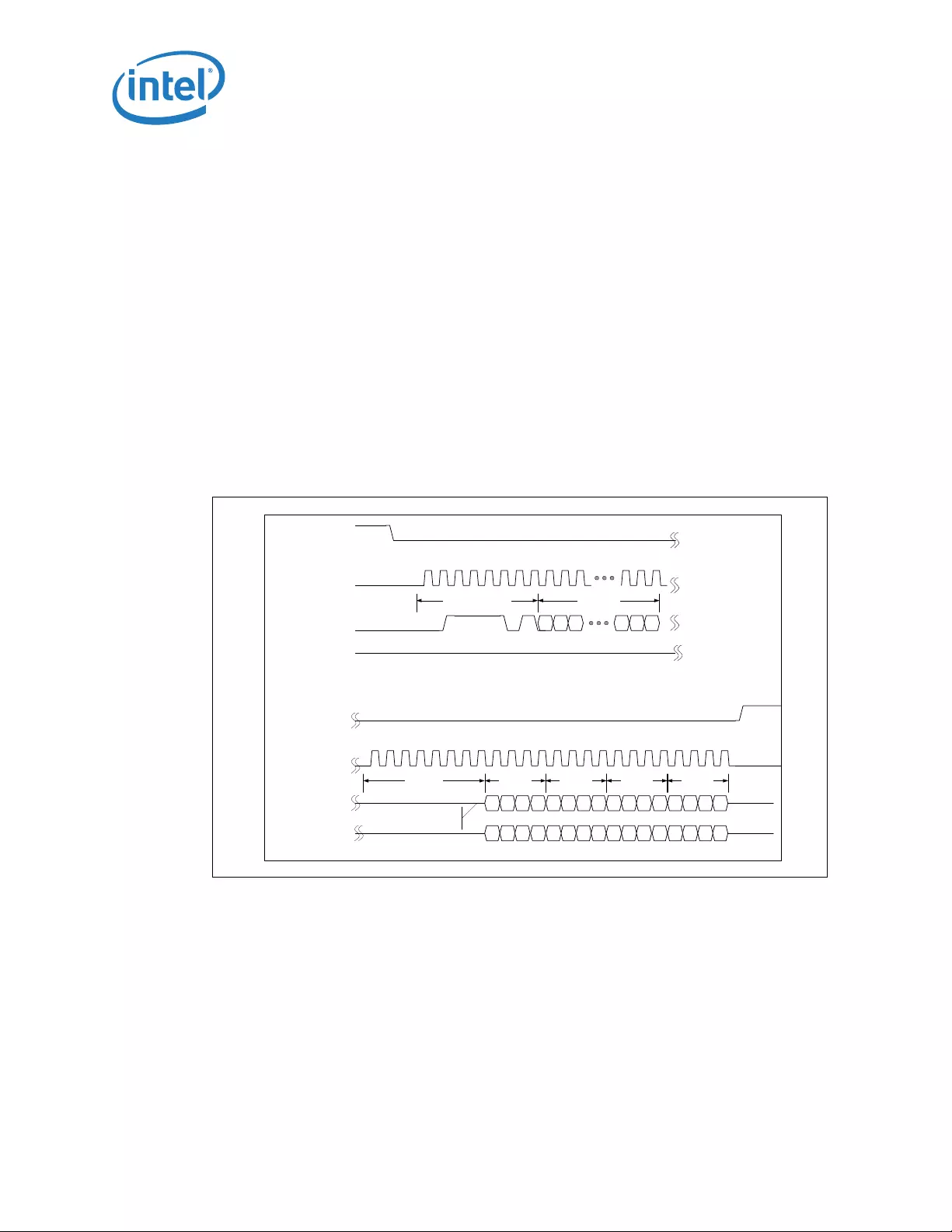
PCU - Serial Peripheral Interface (SPI)
202 Datasheet
Single Input, Dual Output Fast Read
The SPI controller supports the functionality of a single input, dual output fast read:
Opcode 3Bh. This instruction has the same timing (including a dummy byte) and the
same frequencies as the Fast Read instruction, with the difference that the read data
from the Flash is presented on both the MISO and MOSI pins. During a Dual Read
instruction, the odd data bits are on the MISO pin and the even data bits are on the
MOSI pin.
Note: When Dual Output Fast Read Support is enabled the Fast Read Support must be
enabled as well.
Note: Micronix* SPI Flash uses a different opcode for dual fast read, and requires that during
the address phase that the address bits are sent on both MOSI and MISO. The SoC
does not support this implementation of the protocol.
JEDEC ID
Since each serial Flash device may have unique capabilities and commands, the JEDEC
ID is the necessary mechanism for identifying the device so the uniqueness of the
device can be comprehended by the controller (master). The JEDEC ID uses the opcode
9Fh and a specified implementation and usage model. This JEDEC Standard
Manufacturer and Device ID read method is defined in Standard JESD21-C, PRN03-NV.
Figure 35. Dual Output Fast Read Timing
PCU_SPI_CS#
PCU_SPI_MOSI
PCU_SPI_MISO
PCU_SPI_CLK
23 22 21 2 1 0
012345678910 293031
Dual Output Fast Read
Opcode = 3Bh 24-bit address
PCU_SPI_CS#
PCU_SPI_MOSI
PCU_SPI_MISO
PCU_SPI_CLK
6 4 2 4 2 0
32 33 34 35 36 37 38 39
Dummy Byte
40 41 42 43 44 45 46 47
0 6
7 5 3 5 3 11 7
Read Data
Byte 0
Read Data
Byte 1
6 4 2 4 2 00 6
7 5 3 5 3 11 7
Read Data
Byte 2
Read Data
Byte 3
48 49 50 51 52 53 54 55
MOSI switches from
input to output

Datasheet 203
PCU - Serial Peripheral Interface (SPI)
Error Correction and Detection
If the first 8 bits specify an opcode which is not supported the slave will not respond
and wait for the next high to low transition on PCU_SPI_CS[1:0]#. The SPI controller
should automatically discard 8 bit words that were not completely received upon de-
assertion of the signal.
Any other error correction or detection mechanisms must be implemented in firmware
and/or software.
16.2.6 Multiple Page Write Usage Model
The BIOS and Trusted Execution Engine firmware usage models require that the serial
Flash device support multiple writes to a page (minimum of 512 writes) without
requiring a preceding erase command. The BIOS commonly uses capabilities such as
counters that are used for error logging and system boot progress logging. These
counters are typically implemented by using byte-writes to ‘increment’ the bits within a
page that have been designated as the counter. The Trusted Execution Engine firmware
usage model requires the capability for multiple data updates within any given page.
These data updates occur using byte-writes without executing a preceding erase to the
given page. Both the BIOS and Trusted Execution Engine firmware multiple page write
usage models apply to sequential and non-sequential data writes.
This usage model requirement is based on any given bit only being written once from a
‘1’ to a ‘0’without requiring the preceding erase. An erase would be required to change
bits back to the 1 state.
16.2.7 Soft Flash Protection
There are two types of Flash protection that are not defined in the Flash descriptor
supported by the SPI controller:
1. Flash Range Read and Write Protection
2. Global Write Protection
16.2.7.1 Flash Range Read and Write Protection
The SPI controller provides a method for blocking reads and writes to specific ranges in
the Flash when the Protected Ranges are enabled. This is achieved by checking the
read or write cycle type and the address of the requested command against the base
and limit fields of a Read or Write Protected range. Protected range registers are only
applied to Programmed Register accesses and have no effect on Direct Reads.
Note: Once BIOS has locked down the Protected BIOS Range registers, this mechanism
remains in place until the next system reset.
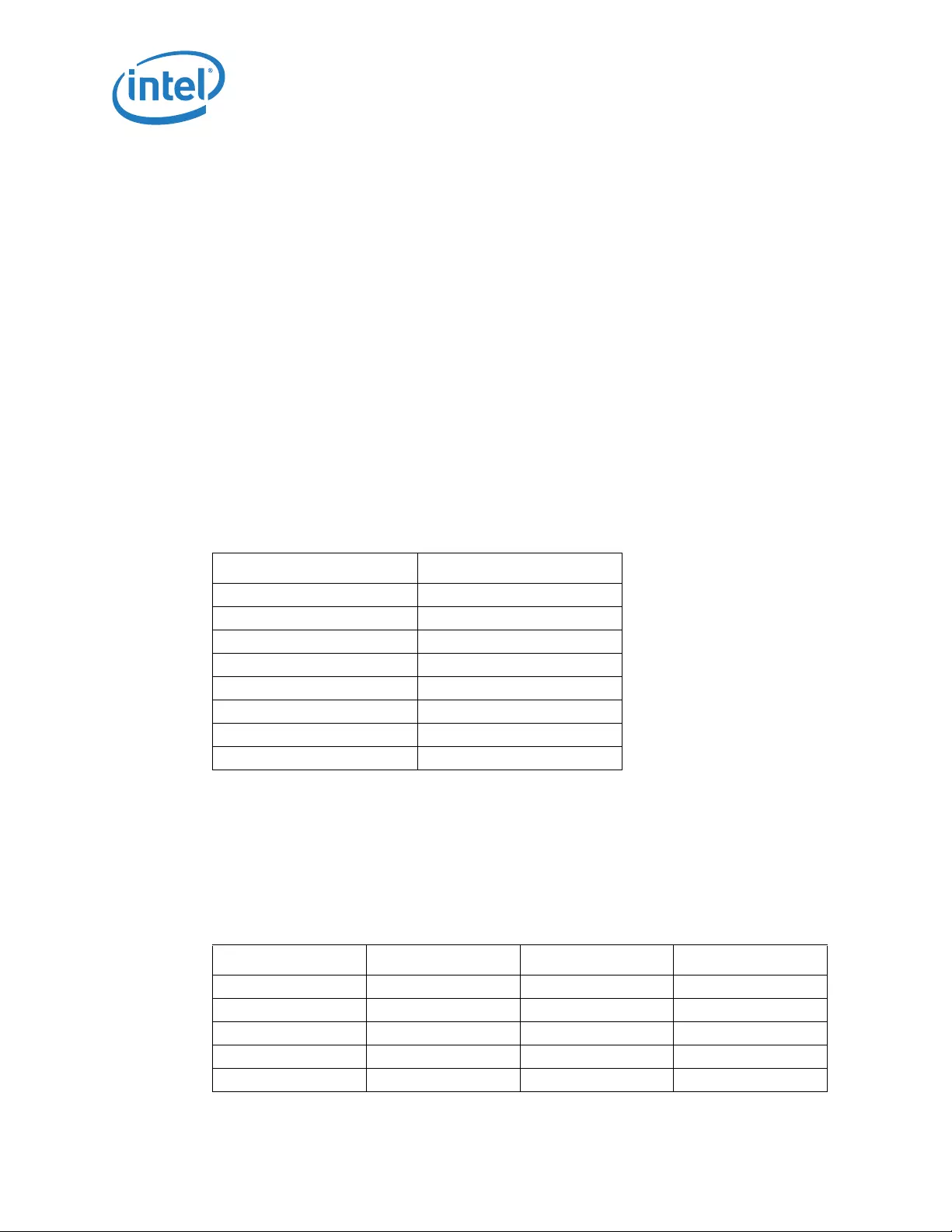
PCU - Serial Peripheral Interface (SPI)
204 Datasheet
16.2.7.2 Global Write Protection
The SPI controller has a Write Protection Disable (BCR.WPD) configuration bit. When
BCR.WPD=0b, BIOS is not able to perform any write or erase commands to the Flash.
When BCR.WPD=1b, protection against BIOS erase and rewrite is disabled. When the
lock enable (BCR.LE) bit is set, the BIOS can disable this protection only during System
Management Mode (SMM) execution.
If BCR.LE=1b, the SPI controller confirms that only SMM code succeeds to set
BCR.WPD=1b. In addition, if BCS.SMIWPEN=1b, the SPI controller should initiate an
SMI when non SMM code tries to set BCR.WPD=1b.
16.2.8 SPI Flash Device Recommended Pinout
This table contains the recommended serial Flash device pin-out for an 8-pin device.
Use of the recommended pin-out on an 8-pin device reduces complexities involved with
designing the serial Flash device onto a motherboard and allows for support of a
common footprint usage model (refer to Section 16.2.9.1).
Although an 8-pin device is preferred over a 16-pin device due to footprint
compatibility, Tab le 9 5 contains the recommended serial Flash device pin-out for a 16-
pin SOIC.
16.2.9 Serial Flash Device Package
Table 94. Recommended Pinout for 8-Pin Serial Flash Device
Pin # Signal
1Chips Select
2Data Output
3 Write Protect
4 Ground
5 Data Input
6 Serial Clock
7Hold / Reset
8 Supply Voltage
Table 95. Recommended Pinout for 16-Pin Serial Flash Device
Pin # Signal Pin # Signal
1 Hold / Reset 9 Write Protect
2 Supply Voltage 10 Ground
3 No Connect 11 No Connect
4 No Connect 12 No Connect
5 No Connect 13 No Connect
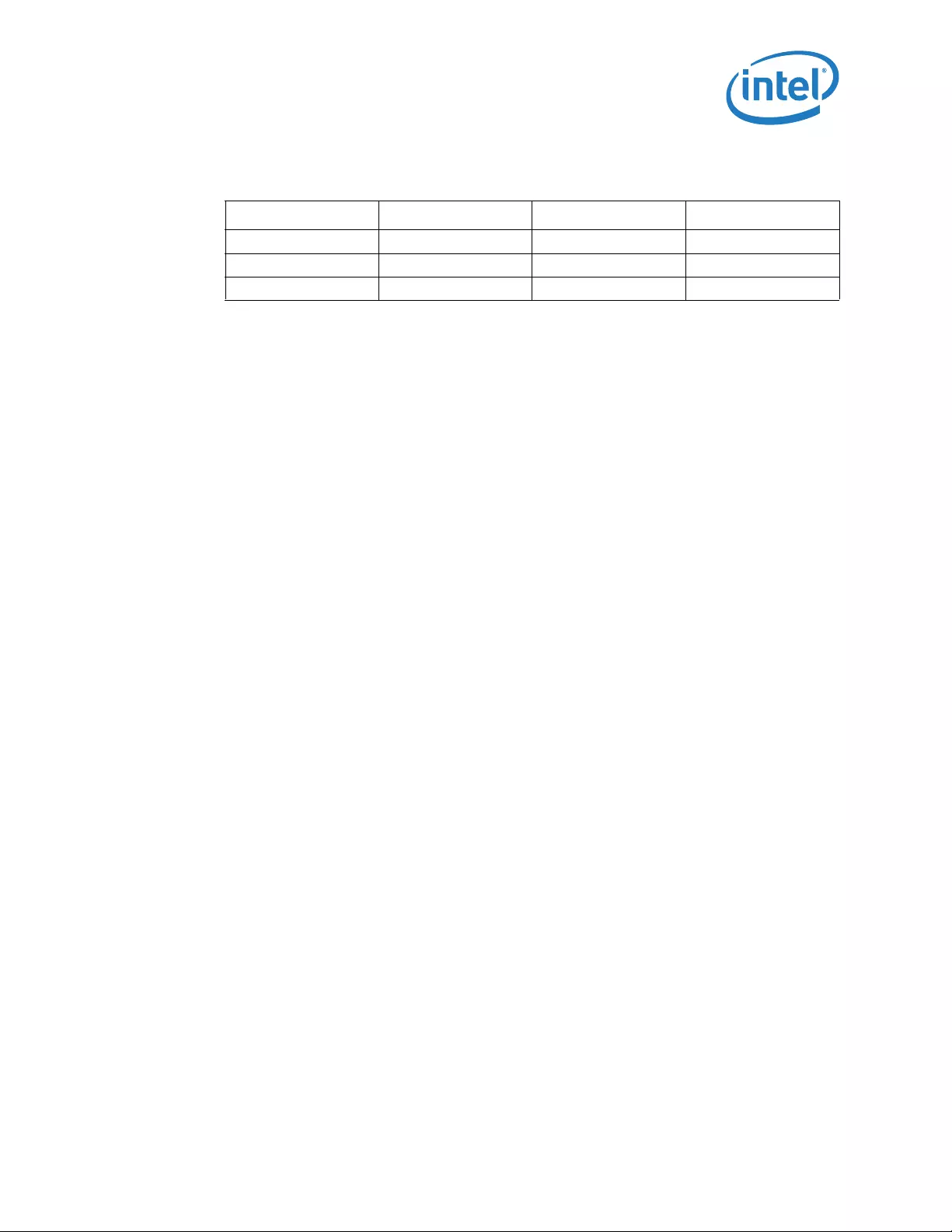
Datasheet 205
PCU - Serial Peripheral Interface (SPI)
16.2.9.1 Common Footprint Usage Model
To minimize platform motherboard redesign and to enable platform Bill of Material
(BOM) selectability, many OEMs design their motherboard with a single common
footprint. This common footprint allows the population of a soldered down device or a
socket that accepts a leadless device. This enables the board manufacturer to support,
using selection of the appropriate BOM, either of these solutions on the same system
without requiring any board redesign.
The common footprint usage model is desirable during system debug and by Flash
content developers since the leadless device can be easily removed and reprogrammed
without damage to device leads. When the board and Flash content is mature for high-
volume production, both the socketed leadless solution and the soldered down leaded
solution are available through BOM selection.
16.2.9.2 Serial Flash Device Package Recommendations
It is highly recommended that the common footprint usage model be supported. An
example of how this can be accomplished is as follows:
•The recommended pinout for 8-pin serial Flash devices is used (refer to Tabl e 9 4 ).
•The 8-pin device is supported in either an 8-contact VDFPN (6x5 mm MLP) package
or an 8-contact WSON (5x6 mm) package. These packages can fit into a socket
that is land pattern compatible with the wide body SO8 package.
•The 8-pin device is supported in the SO8 (150 mil) and in the wide-body SO8 (200
mil) packages.
•The 16-pin device is supported in the SO16 (300 mil) package.
16.3 Use
16.3.1 Hardware vs. Software Sequencing
Hardware and Software sequencing are the two methods the SoC uses to communicate
with the Flash via programming registers for each of the three masters.
16.3.1.1 Hardware Sequencing
Hardware sequencing has a predefined list of opcodes, refer Tab le 9 3 for more details,
with only the erase opcode being programmable. This mode is only available if the
descriptor is present and valid. Security Engine firmware must use HW sequencing, so
6 No Connect 14 No Connect
7 Chip Select 15 Serial Data In
8 Serial Data Out 16 Serial Clock
Table 95. Recommended Pinout for 16-Pin Serial Flash Device
Pin # Signal Pin # Signal

PCU - Serial Peripheral Interface (SPI)
206 Datasheet
BIOS must properly set up the SoC to account for this. The Host VSCC registers and
VSCC Table have to be correctly configured for BIOS and Security Engine have read/
write access to SPI.
16.3.1.2 Software Sequencing
All commands other than the standard (memory) reads must be programmed by the
software in the Software Sequencing Control, Flash Address, Flash Data, and Opcode
configuration registers. Software must issue either Read ID or Read JEDEC ID, or a
combination of the two to determine what Flash component is attached. Based on the
Read ID, software can determine the appropriate Opcode instructions sets to set in the
program registers and at what SPI frequency to run the command.
Software must program the Flash Linear Address for all commands, even for those
commands that don't require address such as the Read ID or Read Status. This is
because the SPI controller uses the address to determine which chip select to use.
The opcode type and data byte count fields determine how many clocks to run before
deasserting the chip enable. The Flash data is always shifted in for the number of bytes
specified and the Flash Data out is always shifted out for the number of data bytes
specified. Note that the hardware restricts the burst lengths that are allowed.
A status bit indicates when the cycle has completed on the SPI port allowing the host to
know when read results can be checked and/or when to initiate a new command.
The controller also provides the “Atomic Cycle Sequence” for performing erases and
writes to the SPI Flash. When this bit is 1 (and the Go bit is written to 1), a sequence of
cycles is performed on the SPI interface without allowing other SPI device to arbitrate
and interleave cycles to the Flash device. In this case, the specified cycle is preceded
by the Prefix Command (8-bit programmable Opcode) and followed by repeated reads
to the Status Register (Opcode 05h) until bit 0 indicates the cycle has completed. The
hardware does not attempt to check that the programmed cycle is a write or erase.
If a Programmed Access is initiated (Cycle Go written to 1) while the SPI controller is
already busy with a Direct Memory Read, then the SPI Host hardware will hold the new
Programmed Access pending until the preceding SPI access completes.
Once the SPI controller has committed to running a programmed access, subsequent
writes to the programmed cycle registers that occur before it has completed will not
modify the original transaction and will result in the assertion of the FCERR bit.
Software should never purposely behave in this way and rely on this behavior. However,
the FCERR bit provides basic error-reporting in this situation. Writes to the following
registers cause the FCERR bit assertion in this situation:
•Software Sequencing Control
•Software Sequencing Address
•SPI Data

Datasheet 207
PCU - Serial Peripheral Interface (SPI)
With the exception of Illegal Opcodes, the SPI controller does not police which opcodes
are valid to be used in SW Sequencing. For example, if SW programs a Dual Output
Fast Read opcode, then the Dual Output Fast Read cycle will be issued, independent of
whether the Dual Output Fast Read enable bit was set in the component descriptor
section.
§
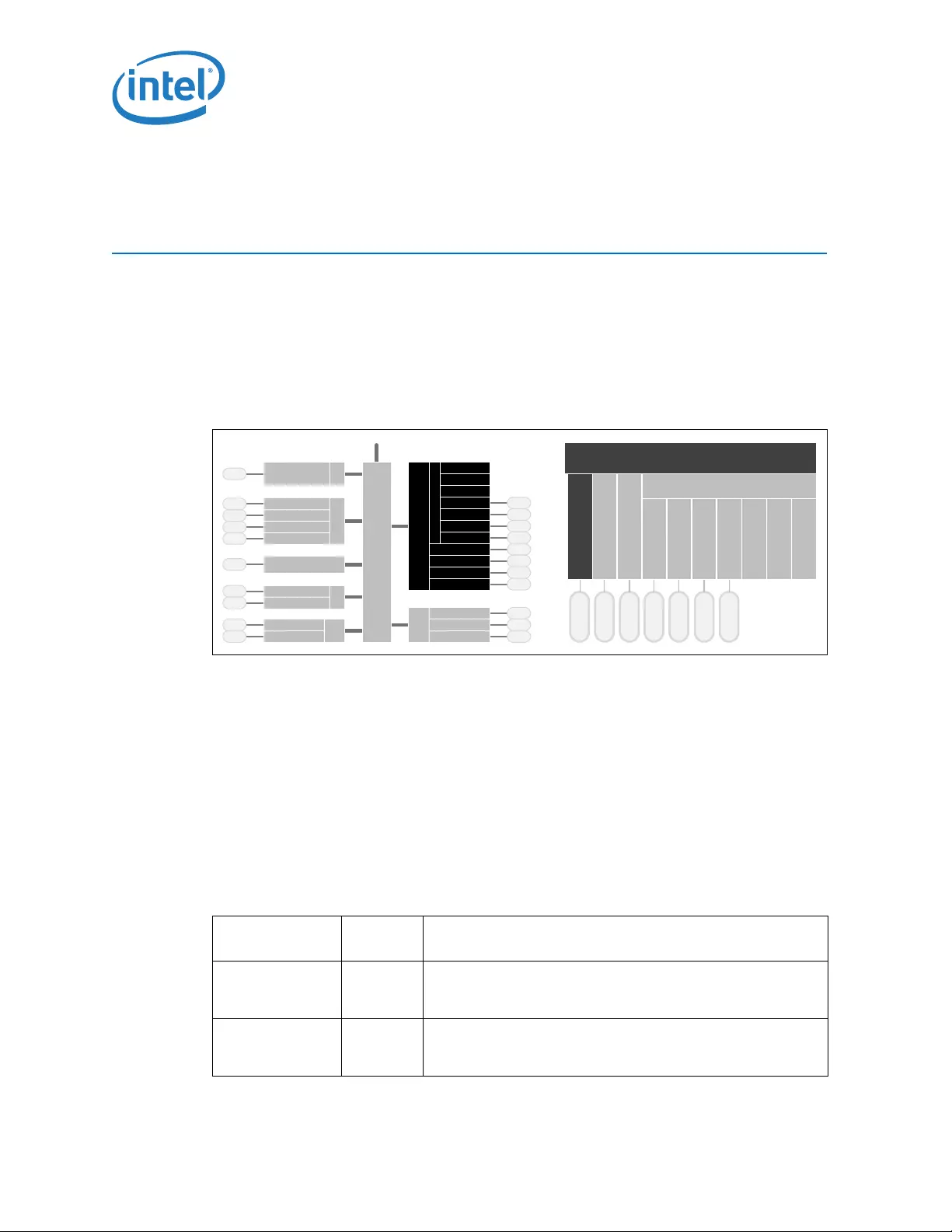
PCU - Universal Asynchronous Receiver/Transmitter (UART)
208 Datasheet
17 PCU - Universal Asynchronous
Receiver/Transmitter (UART)
This section describes the Universal Asynchronous Receiver/Transmitter (UART) serial
port integrated into the PCU. The UART may be controlled through programmed IO.
Note: Only a minimal ball-count, comprising receive & transmit signals, UART port is
implemented. Further, a maximum baud rate of only 115,200 bps is supported. For this
reason, it is recommended that the UART port be used for debug purposes only.
17.1 Signal Descriptions
Refer Chapter 2, “Physical Interfaces” for additional details.
The signal description table has the following headings:
•Signal Name: The name of the signal/pin
•Direction: The buffer direction can be either input, output, or I/O (bidirectional)
•Type: The buffer type found in Chapter 29, “Electrical Specifications”
•Description: A brief explanation of the signal’s function
I
O
I
O
I
O
I
O
I
O
I
OO
Platform Control Unit
UART
iLB
SPI
PMC
Table 96. UART Signals
Signal Name Direction
/Type Description
PCU_UART_RXD ICOM1 Receive: Serial data input from device pin to the
receive port.
This signal is muxed and may be used by other functions.
PCU_UART_TXD OCOM1 Transmit: Serial data output from transmit port to the
device pin.
This signal is muxed and may be used by other functions.

Datasheet 209
PCU - Universal Asynchronous Receiver/Transmitter (UART)
17.2 Features
The serial port consists of a UART which supports a subset of the functions of the 16550
industry standard.
The UART performs serial-to-parallel conversion on data characters received from a
peripheral device and parallel-to-serial conversion on data characters received from the
processor. The processor may read the complete status of the UART at any time during
the functional operation. Available status information includes the type and condition of
the transfer operations being performed by the UART and any error conditions.
The serial port may operate in either FIFO or non-FIFO mode. In FIFO mode, a 16-byte
transmit FIFO holds data from the processor to be transmitted on the serial link and a
16-byte Receive FIFO buffers data from the serial link until read by the processor.
The UART includes a programmable baud rate generator which is capable of generating
a baud rate of between 50 bps and 115,200 bps from a fixed baud clock input of
1.8432 MHz. The baud rate is calculated as follows:
Baud Rate Calculation:
The divisor is defined by the Divisor Latch LSB and Divisor Latch MSB registers. Some
common values are shown in Tab le 9 7 .
The UART has interrupt support and those interrupts may be programmed to the user's
requirements, minimizing the computing required to handle the communications link.
Each UART may operate in a polled or an interrupt driven environment as configured by
software.
BaudRate 1.8432 6
10
16 Divisor
-----------------------
=
Table 97. Baud Rate Examples
Desired Baud Rate Divisor Divisor Latch LSB
Register
Divisor Latch MSB
Register
115,200 1 1h 0h
57,600 2 2h 0h
38,400 3 3h 0h
19,200 6 6h 0h
9,600 12 Ch 0h
4,800 24 18h 0h
2,400 48 30h 0h
1,200 96 60h 0h
300 384 80h 1h
50 2,304 0h 9h

PCU - Universal Asynchronous Receiver/Transmitter (UART)
210 Datasheet
17.2.1 FIFO Operations
17.2.1.1 FIFO Interrupt Mode Operation
Receiver Interrupt
When the Receive FIFO and receiver interrupts are enabled (FIFO Control Register, bit 0
= 1b and Interrupt Enable Register (IIR), bit 0 = 1b), receiver interrupts occur as
follows:
•The receive data available interrupt is invoked when the FIFO has reached its
programmed trigger level. The interrupt is cleared when the FIFO drops below the
programmed trigger level.
•The IIR receive data available indication also occurs when the FIFO trigger level is
reached, and like the interrupt, the bits are cleared when the FIFO drops below the
trigger level.
•The receiver line status interrupt (IIR = C6h), as before, has the highest priority.
The receiver data available interrupt (IIR = C4h) is lower. The line status interrupt
occurs only when the character at the top of the FIFO has errors.
•The COM1_LSR.DR bit is set to 1b as soon as a character is transferred from the
shift register to the Receive FIFO. This bit is reset to 0b when the FIFO is empty.
Character Time Out Interrupt
When the receiver FIFO and receiver time out interrupt are enabled, a character time
out interrupt occurs when all of the following conditions exist:
•At least one character is in the FIFO.
•The last received character was longer than four continuous character times ago (if
2 stop bits are programmed the second one is included in this time delay).
•The most recent processor read of the FIFO was longer than four continuous
character times ago.
•The receiver FIFO trigger level is greater than one.
The maximum time between a received character and a timeout interrupt is 160 ms at
300 baud with a 12-bit receive character (i.e., 1 start, 8 data, 1 parity, and 2 stop bits).
When a time out interrupt occurs, it is cleared and the timer is reset when the
processor reads one character from the receiver FIFO. If a time out interrupt has not
occurred, the time out timer is reset after a new character is received or after the
processor reads the receiver FIFO.
Transmit Interrupt
When the transmitter FIFO and transmitter interrupt are enabled (FIFO Control
Register, bit 0 = 1b and Interrupt Enable Register, bit 0 = 1b), transmit interrupts occur
as follows:

Datasheet 211
PCU - Universal Asynchronous Receiver/Transmitter (UART)
The Transmit Data Request interrupt occurs when the transmit FIFO is half empty or
more than half empty. The interrupt is cleared as soon as the Transmit Holding Register
is written (1 to 16 characters may be written to the transmit FIFO while servicing the
interrupt) or the Interrupt Identification Register is read.
17.2.1.2 FIFO Polled Mode Operation
With the FIFOs enabled (FIFO Control register, bit 0 = 1b), setting Interrupt Enable
register (IER), bits 3:0 = 000b puts the serial port in the FIFO polled mode of
operation. Since the receiver and the transmitter are controlled separately, either one
or both may be in the polled mode of operation. In this mode, software checks receiver
and transmitter status through the Line Status Register (LSR). As stated in the register
description:
•LSR[0] is set as long as there is one byte in the receiver FIFO.
•LSR[1] through LSR[4] specify which error(s) has occurred for the character at the
top of the FIFO. Character error status is handled the same way as interrupt mode.
The Interrupt Identification Register is not affected since IER[2] = 0b.
•LSR[5] indicates when the transmitter FIFO needs data.
•LSR[6] indicates that both the transmitter FIFO and shift register are empty.
•LSR[7] indicates whether there are any errors in the receiver FIFO.
17.3 Use
17.3.1 Base I/O Address
The base I/O address for the COM1 UART is fixed to 3F8h.
17.3.2 Legacy Interrupt
The legacy interrupt assigned to the COM1 UART is fixed to IRQ3.
17.4 UART Enable/Disable
The COM1 UART may be enabled or disabled using the UART_CONT.COM1EN register
bit. By default, the UART is disabled.
Note: It is recommended that the UART be disabled during normal platform operation. An
enabled UART can interfere with platform power management.
§
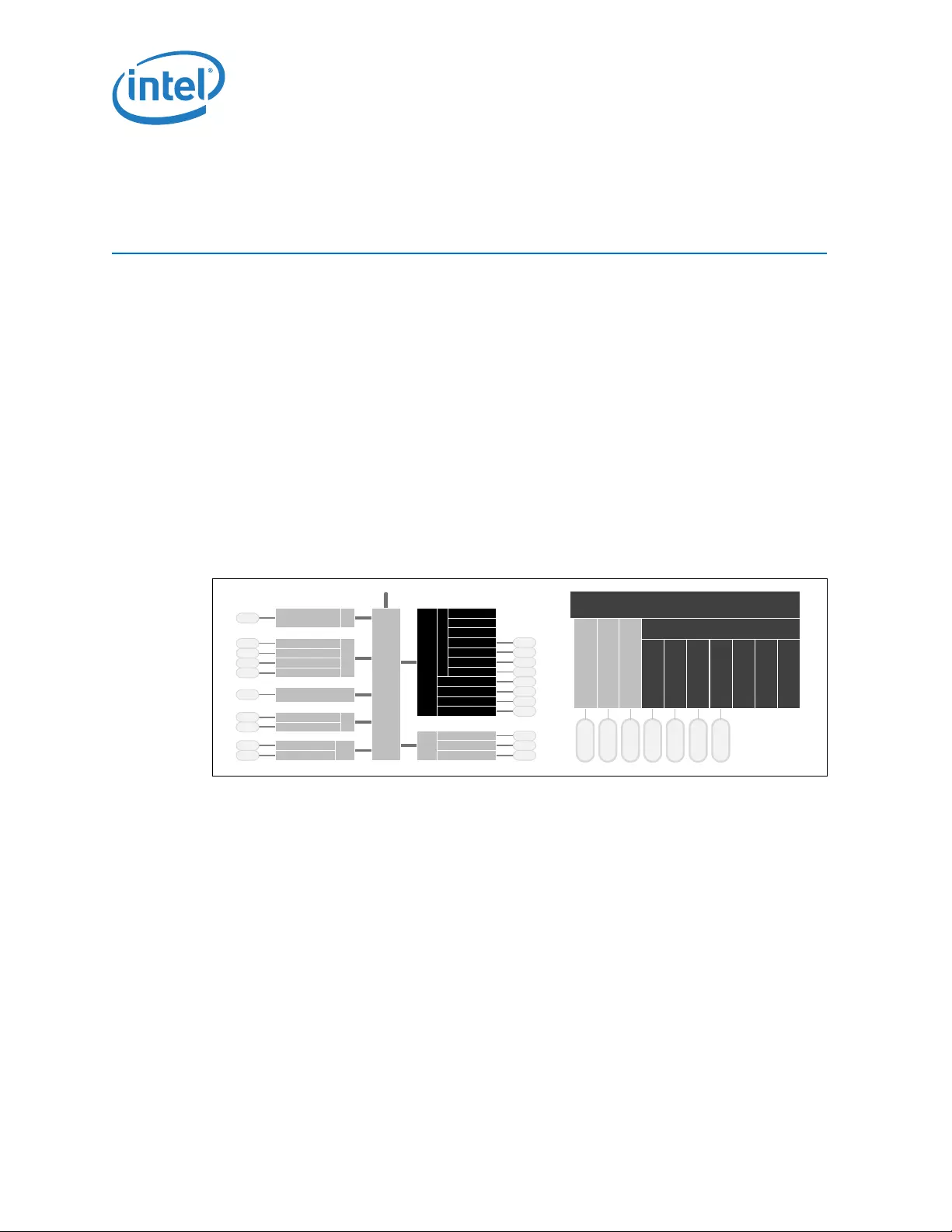
PCU - Intel Legacy Block (iLB) Overview
212 Datasheet
18 PCU - Intel Legacy Block (iLB)
Overview
The Intel Legacy Block (iLB) is a collection of disparate functional blocks that are critical
for implementing the legacy PC platform features. These blocks include:
•PCU - iLB - Low Pin Count (LPC) Bridge
•PCU - iLB - Real Time Clock (RTC)
•PCU - iLB - 8254 Timers
•PCU - iLB - High Precision Event Timer (HPET)
•PCU - iLB - GPIO
•PCU - iLB - IO APIC
•PCU - iLB - 8259 Programmable Interrupt Controllers (PIC)
The iLB also implements a register range for configuration of some of those blocks
along with support for Non-Maskable Interrupts (NMI).
18.1 Signal Descriptions
Refer Chapter 2, “Physical Interfaces” for additional details as well as the subsequent
sections.
The signal description table has the following headings:
•Signal Name: The name of the signal/pin
•Direction: The buffer direction can be either input, output, or I/O (bidirectional)
•Type: The buffer type found in Chapter 29, “Electrical Specifications”
•Description: A brief explanation of the signal’s function
I
O
I
O
I
O
I
O
I
O
I
OO
Platform Control Unit
UART
LPC
GPIO
RTC
HPET
8259
APIC
8254
iLB
SPI
PMC

Datasheet 213
PCU - Intel Legacy Block (iLB) Overview
18.2 Features
18.2.1 Key Features
The key features of various blocks are as follows:
•LPC Interface
— Supports Low Pin Count (LPC) 1.1 Specification
— No support for DMA or bus mastering
— Supports Trusted Platform Module (TPM) 1.2
•General Purpose Input Output
— Legacy control interface for SoC GPIOs
•8259 Programmable Interrupt Controller
— Legacy interrupt support
— 15 total interrupts through two cascaded controllers
•I/O Advanced Programmable Interrupt Controller
— Legacy-free interrupt support
— 87 total interrupts
•8254
— Legacy timer support
— Three timers with fixed uses: System Timer, Refresh Request Signal and
Speaker Tone
•HPET - High Performance Event Timers
— Legacy-free timer support
— Three timers and one counter
•Real-Time Clock (RTC)
— 242 byte RAM backed by battery (aka CMOS RAM)
— Can generate wake/interrupt when time matches programmed value
— I/O and indexed registers
Table 98. iLB Signals
Signal Name Direction
/Type Description
ILB_NMI I Non-Maskable Interrupt: This is an NMI event indication into the
SoC.
This signal is muxed and may be used by other functions.
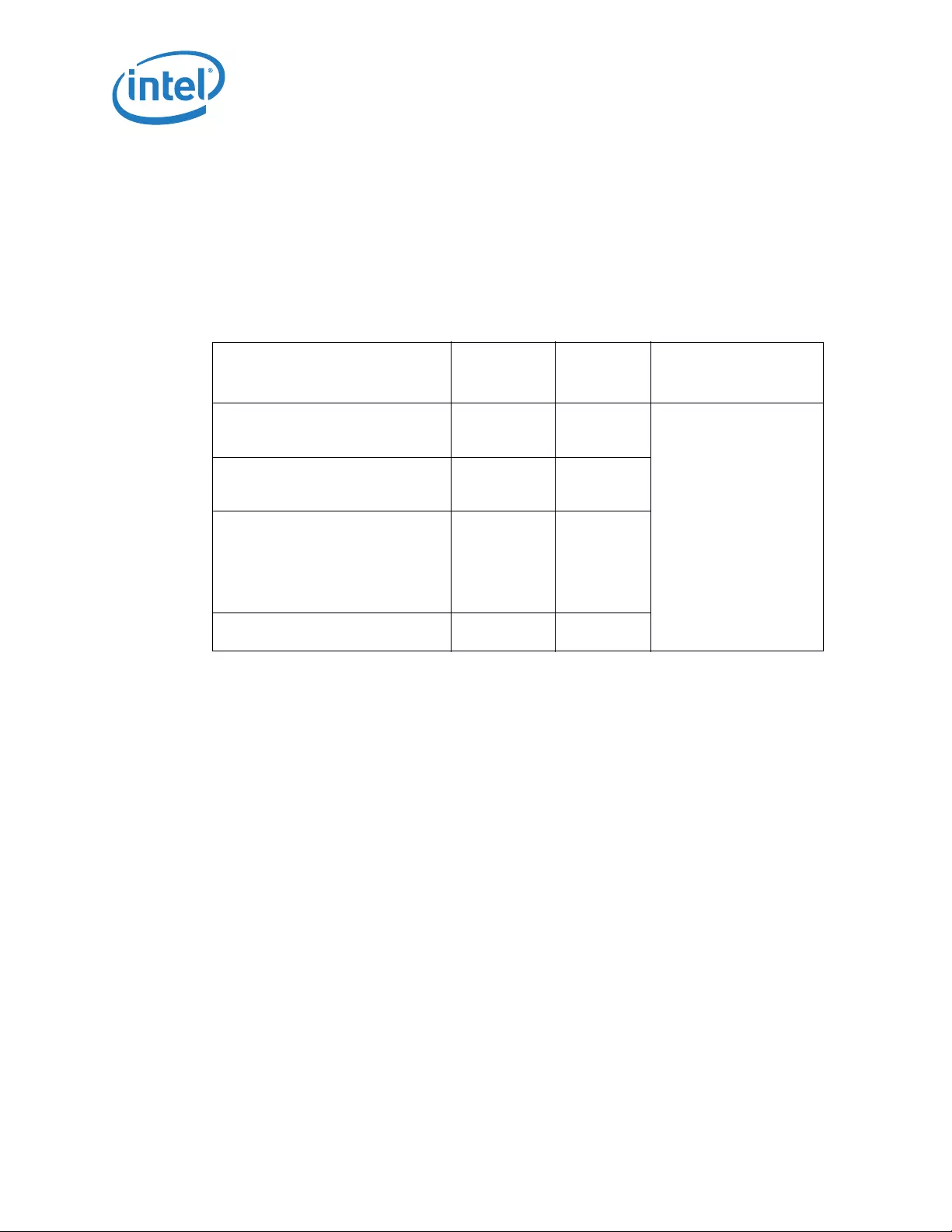
PCU - Intel Legacy Block (iLB) Overview
214 Datasheet
18.2.2 Non-Maskable Interrupt
NMI support is enabled by setting the NMI Enable (NMI_EN) bit, at IO Port 70h, Bit 7,
to 1b.
Non-Maskable Interrupts (NMIs) can be generated by several sources, as described in
Tab l e 99 .
18.2.3 S0ix Support
During S0i1, the iLB is kept running. During S0i2 & S0i3, the iLB is halted.
18.3 Use
18.3.1 S0ix Support
Prior to entry into S0i2 or S0i3 state, the driver/OS must set HPET_GCFG.EN to 0b to
indicate RTD3hot status.
§
Table 99. NMI Sources
NMI Source
NMI Source
Enabler/
Disabler
NMI Source
Status
Alternate
Configuration
SERR# goes active
NOTE: A SERR# is only generated
internally in the SoC)
NSC.SNE NSC.SNS All NMI sources may,
alternatively, generate a
SMI by setting
GNMI.NMI2SMIEN=1b
The SoC uses
GNMI.NMI2SMIST for
observing SMI status
IOCHK# goes active
NOTE: A IOCHK# is only generated
as a SERIRQ# frame
NSC.INE NSC.INS
ILB_NMI goes active
NOTE: Active can be defined as
being on the positive or
negative edge of the signal
using the GNMI.GNMIED
register bit.
GNMI.GNMIED GNMI.GNMIS
Software sets the GNMI.NMIN
register bit
GNMI.NMIN GNMI.NMINS
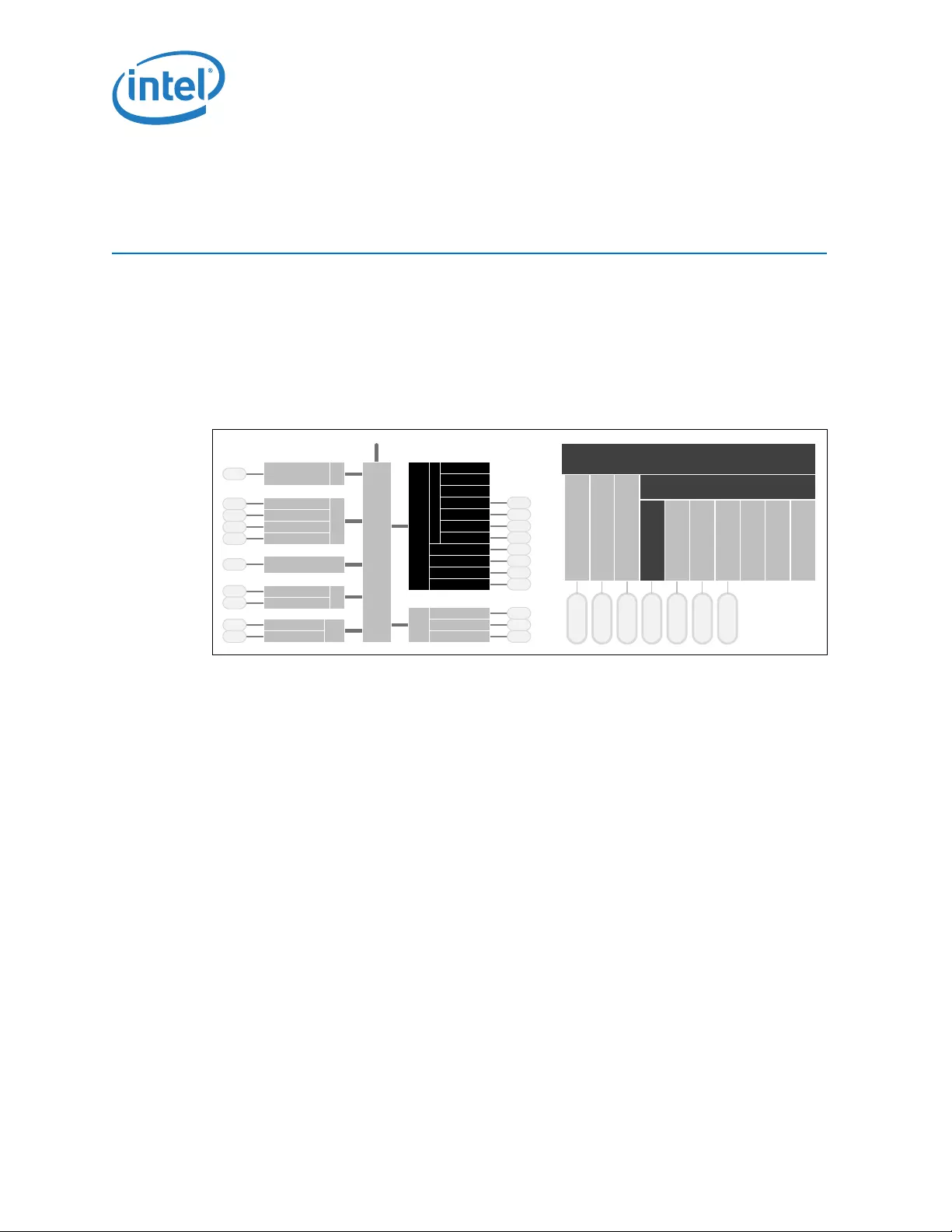
PCU - iLB - Low Pin Count (LPC) Bridge
216 Datasheet
19 PCU - iLB - Low Pin Count (LPC)
Bridge
The SoC implements an LPC Interface as described in the LPC 1.1 Specification. The
Low Pin Count (LPC) bridge function of the SoC resides in PCI Device 31, Function 0.
Note: In addition to the LPC bridge interface function, D31:F0 contains other functional units
including interrupt controllers, timers, power management, system management,
GPIO, and RTC.
19.1 Signal Descriptions
Refer Chapter 2, “Physical Interfaces” for additional details.
The signal description table has the following headings:
•Signal Name: The name of the signal/pin
•Direction: The buffer direction can be either input, output, or I/O (bidirectional)
•Type: The buffer type found in Chapter 29, “Electrical Specifications”
•Description: A brief explanation of the signal’s function
I
O
I
O
I
O
I
O
I
O
I
OO
Platform Control Unit
UART
LPC
GPIO
RTC
HPET
8259
APIC
8254
iLB
SPI
PMC

Datasheet 217
PCU - iLB - Low Pin Count (LPC) Bridge
19.2 Features
The LPC interface to the SoC is shown in Figure 36. Note that the SoC implements all of
the signals that are shown as optional, but peripherals are not required to do so.
Note: The LPC controller does not implement bus mastering cycles or DMA.
Table 100. LPC Signals
Signal Name Direction/
Type Description
ILB_LPC_AD[3:0] I/O
CMOS3.3/
1.8
LPC Multiplexed Command, Address, Data: Internal pull-ups are
provided for these signals.
These signals are muxed and may be used by other functions.
ILB_LPC_CLK[0] O
CMOS3.3/
1.8
LPC Clock [0] Out: 25 MHz PCI-like clock driven to LPC peripherals.
These signals are muxed and may be used by other functions.
ILB_LPC_CLK[1] O or I
CMOS3.3/
1.8
LPC Clock [1] Out: 25 MHz PCI-like clock driven to LPC peripherals. Can
be configured as an input to compensate for board routing delays through
Soft Strap.
These signals are muxed and may be used by other functions.
ILB_LPC_CLKRUN# I/OD
CMOS3.3/
1.8
LPC Clock Run: Input to determine the status of ILB_LPC_CLK and an
open drain output used to request starting or speeding up ILB_LPC_CLK.
This is a sustained tri-state signal used by the central resource to request
permission to stop or slow ILB_LPC_CLK. The central resource is
responsible for maintaining the signal in the asserted state when
ILB_LPC_CLK is running and deasserts the signal to request permission to
stop or slow ILB_LPC_CLK. An internal pull-up is provided for this signal.
This signal is muxed and may be used by other functions.
ILB_LPC_FRAME# O
CMOS3.3/
1.8
LPC Frame: This signal indicates the start of an LPC cycle, or an abort.
This signal is muxed and may be used by other functions.
ILB_LPC_SERIRQ I/O
CMOS1.8
Serial Interrupt Request: This signal implements the serial interrupt
protocol.
This signal is muxed and may be used by other functions.
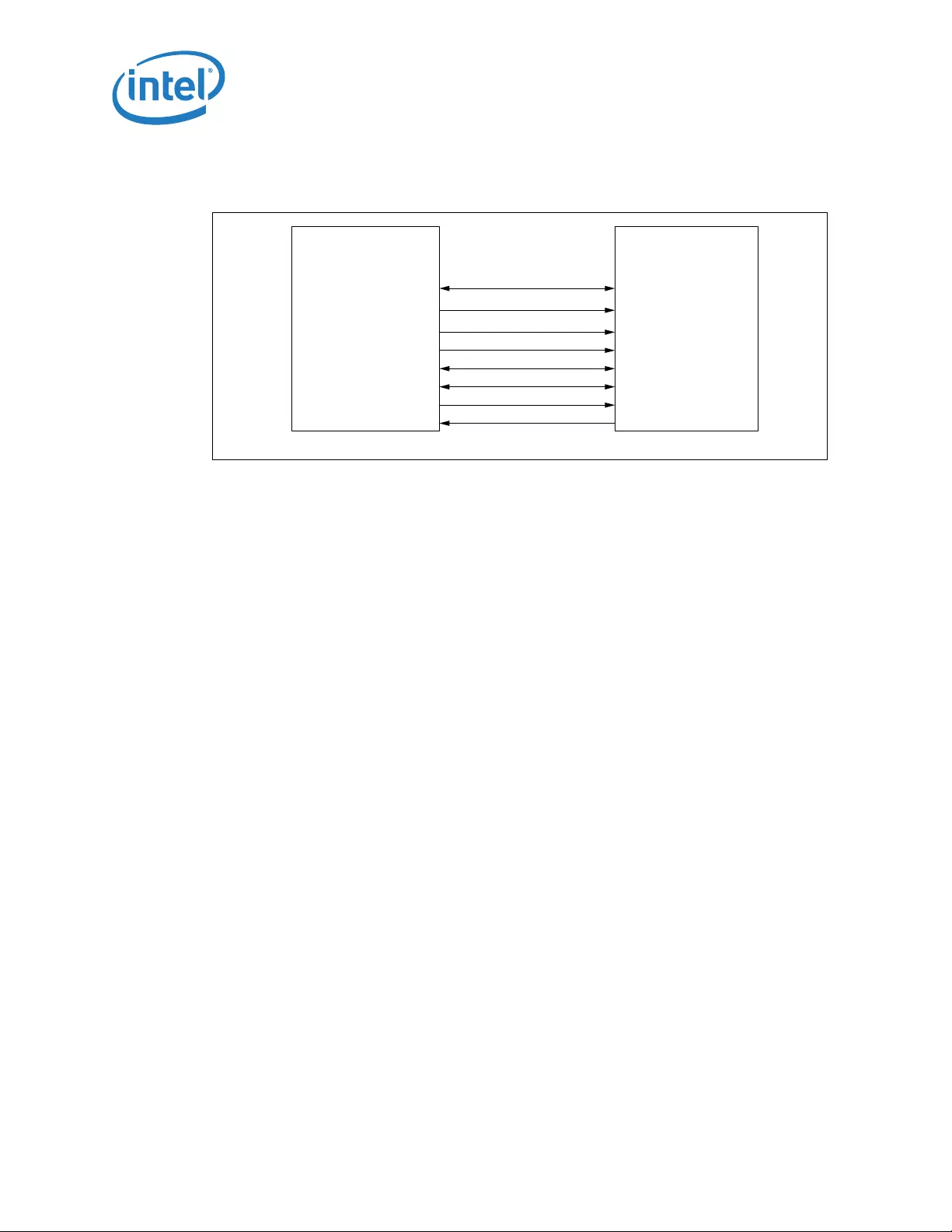
PCU - iLB - Low Pin Count (LPC) Bridge
218 Datasheet
NOTE: The General Purpose Input (GPI) must use a SMI capable GPIO: GPIO_S0_SC[7:0].
19.2.1 Memory Cycle Notes
For cycles below 16M, the LPC Controller will perform standard LPC memory cycles. For
cycles targeting firmware (BIOS/EFI code only), firmware memory cycles are used.
Only 8-bit transfers are performed. If a larger transfer appears, the LPC controller will
break it into multiple 8-bit transfers until the request is satisfied.
If the cycle is not claimed by any peripheral (and subsequently aborted), the LPC
Controller will return a value of all 1’s to the CPU.
19.2.2 Trusted Platform Module (TPM) 1.2 Support
The LPC interface supports accessing Trusted Platform Module (TPM) 1.2 devices via
the LPC TPM START encoding. Memory addresses within the range FED00000h to
FED40FFFh will be accepted by the LPC Bridge and sent on LPC as TPM special cycles.
No additional checking of the memory cycle is performed.
Note: This is different to the FED00000h to FED4BFFFh range implemented on some other
Intel components since no Intel® Trusted Execution Technology (Intel® TXT)
transactions are supported.
19.2.3 FWH Cycle Notes
If the LPC controller receives any SYNC returned from the device other than short
(0101), long wait (0110), or ready (0000) when running a FWH cycle, indeterminate
results may occur. A FWH device is not allowed to assert an Error SYNC.
BIOS/EFI boot from LPC is not supported when Secure Boot is enabled.
Figure 36. LPC Interface Diagram
SOC LPC Device
LCLK
LRESET#
SERIRQ (Optional)
LAD [3:0]
LFRAME#
LPCPD# (Optional)
PMC_SUS_STAT#
LSMI# (Optional)
GPI
1
CLKRUN# (Optional)
ILB_LPC_CLKRUN#
ILB_LPC_SERIRQ
ILB_LPC_CLK
PMC_PLTRST#
ILB_LPC_FRAME#
ILB _L P C _A D [3:0 ]

Datasheet 219
PCU - iLB - Low Pin Count (LPC) Bridge
19.2.4 Other Notes
All cycles that are not decoded internally, and are not targeted for LPC (i.e.,
configuration cycles, IO cycles above 64KB and memory cycles above 16MB), will be
sent to LPC with ILB_LPC_FRAME# not asserted.
19.2.5 POST Code Redirection
Writes to addresses 80h - 8Fh in IO register space will also be passed to the LPC bus.
Note: Reads of these addresses do not result in any LPC transactions.
19.2.6 Power Management
19.2.6.1 LPCPD# Protocol
Same timings as for PMC_SUS_STAT#. After driving PMC_SUS_STAT# active, the SoC
drives ILB_LPC_FRAME# low, and tri-states (or drives low) ILB_LPC_AD[3:0].
Note: The Low Pin Count Interface Specification, Revision 1.1 defines the LPCPD# protocol
where there is at least 30 µs from LPCPD# assertion to LRST# assertion. This
specification explicitly states that this protocol only applies to entry/exit of low power
states which does not include asynchronous reset events. The SoC asserts both
PMC_SUS_STAT# (connects to LPCPD#) and ILB_PLTRST# (connects to LRST#) at the
same time during a global reset. This is not inconsistent with the LPC LPCPD# protocol.
19.2.6.2 Clock Run (CLKRUN)
When there are no pending LPC cycles, and SERIRQ is in quiet mode, the SoC can shut
down the LPC clock. The SoC indicates that the LPC clock is going to shut down by de-
asserting the ILB_LPC_CLKRUN# signal. LPC devices that require the clock to stay
running should drive ILB_LPC_CLKRUN# low within 4 clocks of its de-assertion. If no
device drives the signal low within 4 clocks, the LPC clock will stop. If a device asserts
ILB_LPC_CLKRUN#, the SoC will start the LPC clock and assert ILB_LPC_CLKRUN#.
Note: The CLKRUN protocol is disabled by default. Refer Section 19.3.2.2, “Clock Run Enable”
on page 223 for further details.
19.2.7 Serialized IRQ (SERIRQ)
The interrupt controller supports a serial IRQ scheme. The signal used to transmit this
information is shared between the interrupt controller and all peripherals that support
serial interrupts. The signal line, ILB_LPC_SERIRQ, is synchronous to LPC clock, and
follows the sustained tri-state protocol that is used by LPC signals. The serial IRQ
protocol defines this sustained tri-state signaling in the following fashion:
•S - Sample Phase: Signal driven low
•R - Recovery Phase: Signal driven high

PCU - iLB - Low Pin Count (LPC) Bridge
220 Datasheet
•T - Turn-around Phase: Signal released
The interrupt controller supports 21 serial interrupts. These represent the 15 ISA
interrupts (IRQ0- 1, 3-15), the four PCI interrupts, and the control signals SMI# and
IOCHK#. Serial interrupt information is transferred using three types of frames:
•Start Frame: ILB_LPC_SERIRQ line driven low by the interrupt controller to indicate
the start of IRQ transmission
•Data Frames: IRQ information transmitted by peripherals. The interrupt controller
supports 21 data frames.
•Stop Frame: ILB_LPC_SERIRQ line driven low by the interrupt controller to indicate
end of transmission and next mode of operation.
19.2.7.1 Start Frame
The serial IRQ protocol has two modes of operation which affect the start frame:
•Continuous Mode: The interrupt controller is solely responsible for generating the
start frame
•Quiet Mode: Peripheral initiates the start frame, and the interrupt controller
completes it.
These modes are entered via the length of the stop frame.
Continuous mode must be entered first, to start the first frame. This start frame width
is 8 LPC clocks. This is a polling mode.
In Quiet mode, the ILB_LPC_SERIRQ line remains inactive and pulled up between the
Stop and Start Frame until a peripheral drives ILB_LPC_SERIRQ low. The interrupt
controller senses the line low and drives it low for the remainder of the Start Frame.
Since the first LPC clock of the start frame was driven by the peripheral, the interrupt
controller drives ILB_LPC_SERIRQ low for 1 LPC clock less than in continuous mode.
This mode of operation allows for lower power operation.
19.2.7.2 Data Frames
Once the Start frame has been initiated, the ILB_LPC_SERIRQ peripherals start
counting frames based on the rising edge of ILB_LPC_SERIRQ. Each of the IRQ/DATA
frames has exactly 3 phases of 1 clock each:
•Sample Phase: During this phase, a device drives ILB_LPC_SERIRQ low if its
corresponding interrupt signal is low. If its corresponding interrupt is high, then the
ILB_LPC_SERIRQ devices tri-state ILB_LPC_SERIRQ. ILB_LPC_SERIRQ remains
high due to pull-up resistors.
•Recovery Phase: During this phase, a device drives ILB_LPC_SERIRQ high if it
was driven low during the Sample Phase. If it was not driven during the sample
phase, it remains tri-stated in this phase.
•Turn-around Phase: The device tri-states ILB_LPC_SERIRQ.
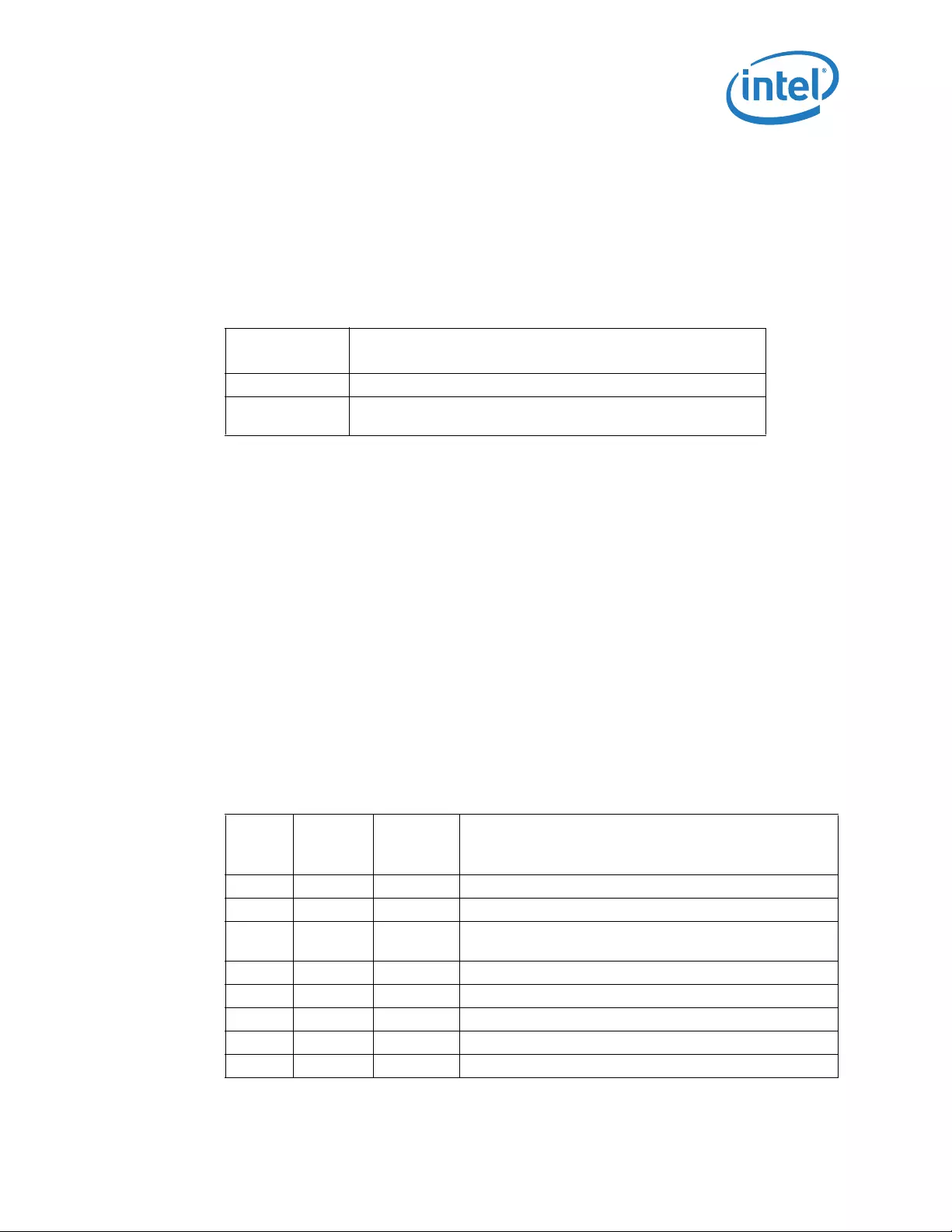
Datasheet 221
PCU - iLB - Low Pin Count (LPC) Bridge
19.2.7.3 Stop Frame
After the data frames, a Stop Frame will be driven by the interrupt controller.
ILB_LPC_SERIRQ will be driven low for two or three LPC clocks. The number of clocks is
determined by the SCNT.MD register bit. The number of clocks determines the next
mode, as indicated in Tabl e 1 0 1.
19.2.7.4 Serial Interrupts Not Supported
There are four interrupts on the serial stream which are not supported by the interrupt
controller. These interrupts are:
•IRQ0: Heartbeat interrupt generated off of the internal 8254 counter 0.
•IRQ8: RTC interrupt can only be generated internally.
•IRQ13: This interrupt (floating point error) is not supported.
The interrupt controller will ignore the state of these interrupts in the stream.
19.2.7.5 Data Frame Format and Issues
Table below shows the format of the data frames.
The other interrupts decoded via SERIRQ are also ANDed with the corresponding
internal interrupts. For example, if IRQ10 is set to be used as the SCI, then it is ANDed
with the decoded value for IRQ10 from the SERIRQ stream.
Table 101. SERIRQ, Stop Frame Width to Operation Mode Mapping
Stop Frame
Width Next Mode
Two LPC clocks Quiet Mode: Any SERIRQ device initiates a Start Frame
Three LPC clocks Continuous Mode: Only the interrupt controller initiates a Start
Frame
Table 102. SERIRQ Interrupt Mapping
Data
Frame
#
Interrupt
Clocks
Past Start
Frame
Comment
1 IRQ0 2 Ignored. Can only be generated via the internal 8524
2 IRQ1 5 Before port 60h latch
3 SMI# 8 Causes SMI# if low. Sets SMI_STS.ILB_SMI_STS register
bit.
4IRQ3 11
5IRQ4 14
6IRQ5 17
7IRQ6 20
8IRQ7 23
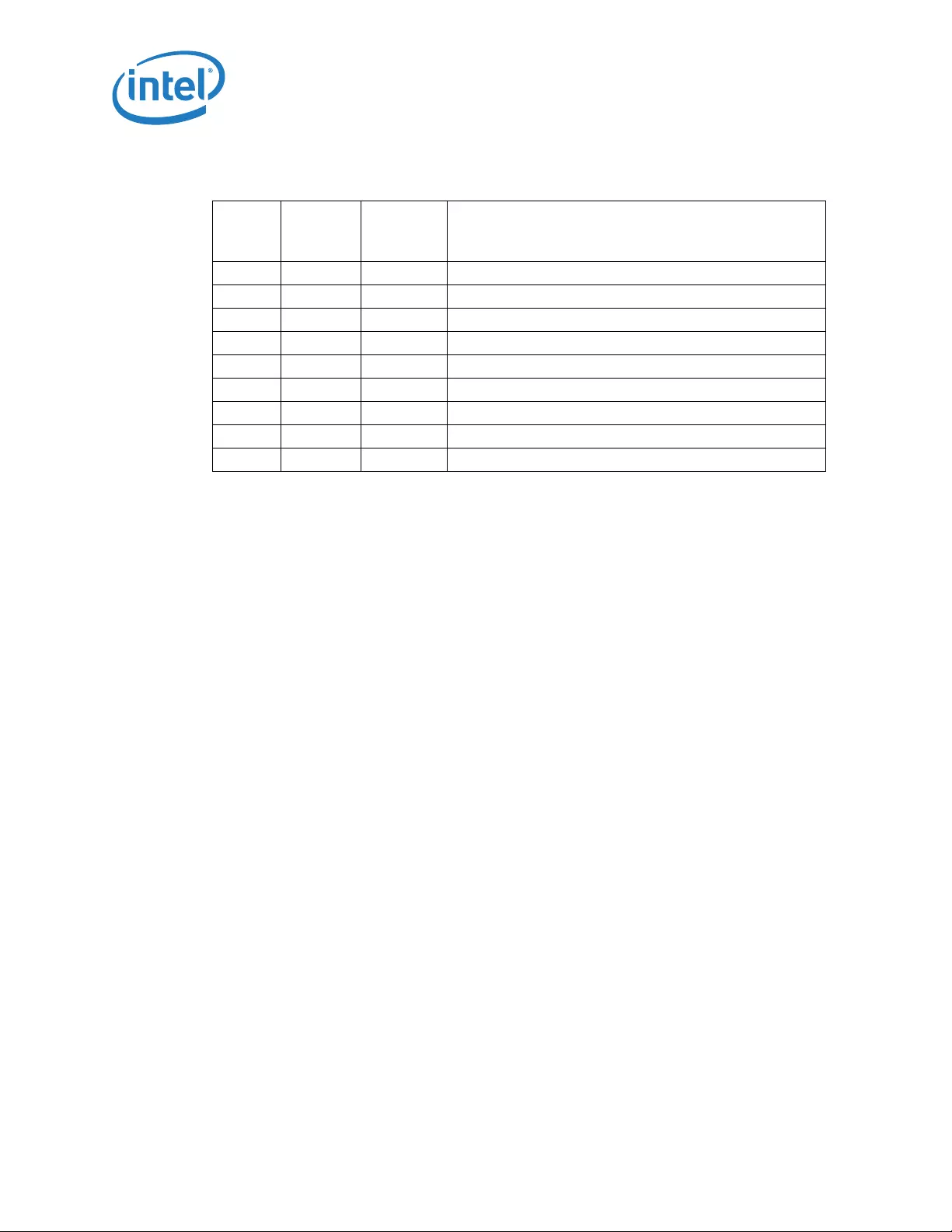
PCU - iLB - Low Pin Count (LPC) Bridge
222 Datasheet
19.2.7.6 S0ix Support
During S0i2 and S0i3, the LPC and SERIRQ interfaces are disabled.
19.3 Use
19.3.1 LPC Clock Delay Compensation
In order to meet LPC interface AC timing requirements, a LPC clock loop back is
required. The operation of this loop back can be configured in two ways:
1. On the SOC: In this configuration, ILB_LPC_CLK[0] is looped back on itself on the
SOC pad.
a. Benefit:
ILB_LPC_CLK[0] and ILB_LPC_CLK[1] are both available for system clocking
b. Drawback:
Clock delay compensation is less effective at compensating for mainboard delay
c. Soft Strap & Register Requirements:
Soft Strap LPCCLK_SLC = 0b
Configuration is reflected by register bit LPCC.LPCCLK_SLC=0b
Soft Strap LPCCLK1_ENB = 0b (ILB_LPC_CLK[1] disabled) or 1b (ILB_LPC_CLK[1]
enabled)
2. Configuration is reflected by register bit LPCC.LPCCLK1EN=0b (ILB_LPC_CLK[1]
disabled) or 1b (ILB_LPC_CLK[1] enabled)
3. On the main board: In this configuration, ILB_LPC_CLK[0] is looped back to
ILB_LPC_CLK[1] on the main board.
a. Benefit:
9 IRQ8 26 Ignored. IRQ8# can only be generated internally
10 IRQ9 29
11 IRQ10 32
12 IRQ11 35
13 IRQ12 38 Before port 60h latch
14 IRQ13 41 Ignored.
15 IRQ14 44 Ignored
16 IRQ15 47
17 IOCHCK# 50 Same as ISA IOCHCK# going active.
Table 102. SERIRQ Interrupt Mapping
Data
Frame
#
Interrupt
Clocks
Past Start
Frame
Comment

Datasheet 223
PCU - iLB - Low Pin Count (LPC) Bridge
Clock delay compensating in more effective at compensating for main board delay
b. Drawback:
Only ILB_LPC_CLK[0] is available for system clocking. ILB_LPC_CLK[1] must be
disabled.
c. Soft Strap & Register Requirements:
Soft Strap LPCCLK_SLC = 1b
Configuration is reflected by register bit LPCC.LPCCLK_SLC=1b
Soft Strap LPCCLK1_ENB = 0b (ILB_LPC_CLK[1] disabled)
Configuration is reflected by register bit LPCC.LPCCLK1EN=0b
19.3.2 LPC Power Management
19.3.2.1 Clock Enabling
The LPC clocks can be enabled or disabled by setting or clearing, respectively, the
LPCC.LPCCLK[1:0]EN bits.
19.3.2.2 Clock Run Enable
The Clock Run protocol is disabled by default and should only be enabled during
operating system run-time, once all LPC devices have been initialized. The Clock Run
protocol is enabled by setting the LPCC.CLKRUN_EN register bit.
19.3.3 SERIRQ Disable
Serialized IRQ support may be disabled by setting the OIC.SIRQEN bit to 0b.
19.4 References
•Low Pin Count Interface Specification, Revision 1.1 (LPC): http://www.intel.com/
design/chipsets/industry/lpc.htm
•Serialized IRQ Support for PCI Systems, Revision 6.0: http://www.smsc.com/
media/Downloads_Public/papers/serirq60.doc
•Implementing Industry Standard Architecture (ISA) with Intel® Express Chipsets
(318244): http://www.intel.com/assets/pdf/whitepaper/318244.pdf
§
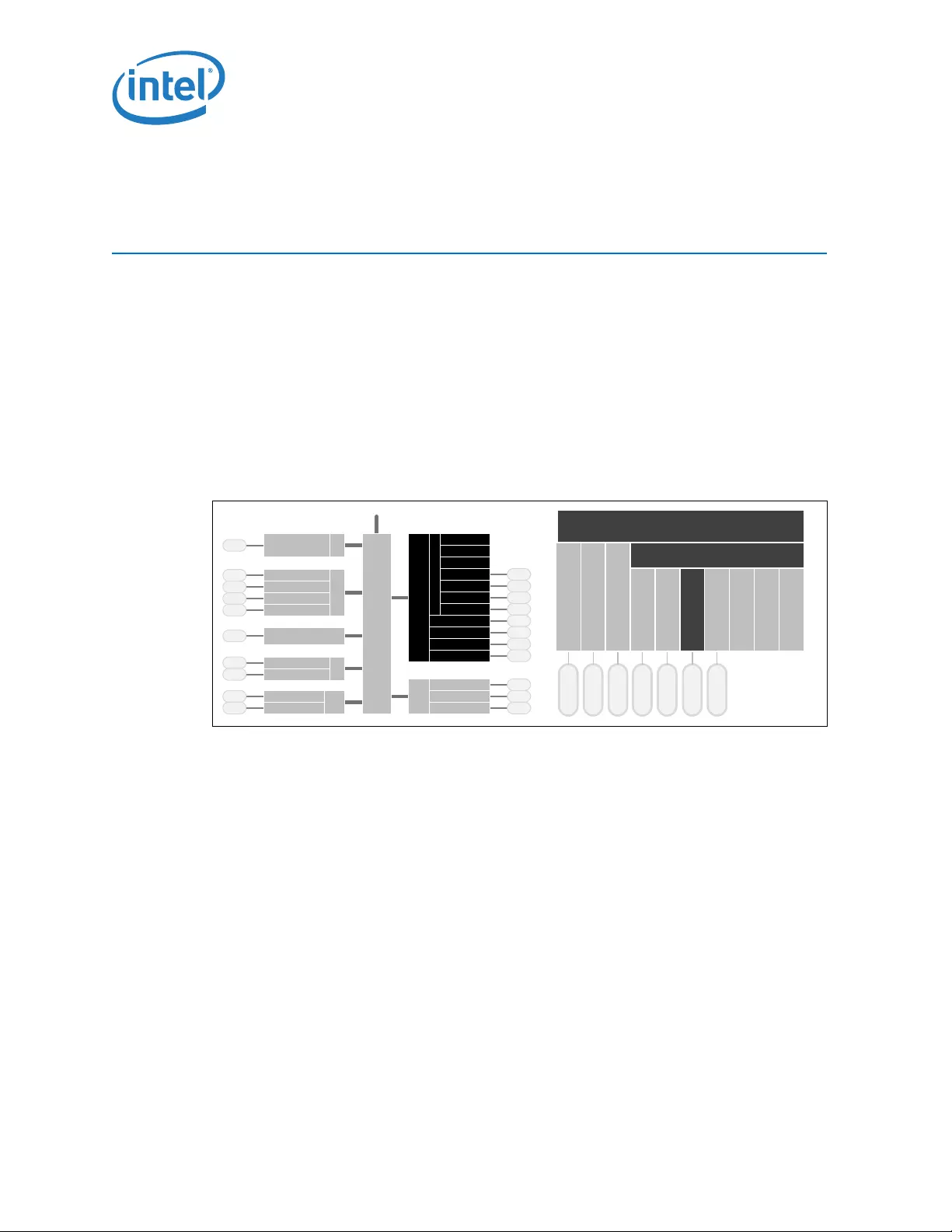
PCU - iLB - Real Time Clock (RTC)
224 Datasheet
20 PCU - iLB - Real Time Clock
(RTC)
The SoC contains a Motorola MC146818B-compatible real-time clock with 242 bytes of
battery-backed RAM. The real-time clock performs twos key functions—keeping track of
the time of day and storing system data, even when the system is powered down. The
RTC operates on a 32.768 kHz crystal and a 3.3 V battery.
The RTC supports two lockable memory ranges. By setting bits in the configuration
space, two 8-byte ranges can be locked to read and write accesses. This prevents
unauthorized reading of passwords or other system security information.
The RTC supports a date alarm that allows for scheduling a wake up event up to 30
days in advance.
20.1 Signal Descriptions
Refer Chapter 2, “Physical Interfaces” for additional details.
The signal description table has the following headings:
•Signal Name: The name of the signal/pin
•Direction: The buffer direction can be either input, output, or I/O (bidirectional)
•Type: The buffer type found in Chapter 29, “Electrical Specifications”
•Description: A brief explanation of the signal’s function
I
O
I
O
I
O
I
O
I
O
I
OO
Platform Control Unit
UART
LPC
GPIO
RTC
HPET
8259
APIC
8254
iLB
SPI
PMC

Datasheet 225
PCU - iLB - Real Time Clock (RTC)
20.2 Features
The Real Time Clock (RTC) module provides a battery backed-up date and time keeping
device. Three interrupt features are available: time of day alarm with once a second to
once a month range, periodic rates of 122 ms to 500 ms, and end of update cycle
notification. Seconds, minutes, hours, days, day of week, month, and year are counted.
The hour is represented in twelve or twenty-four hour format, and data can be
represented in BCD or binary format. The design is meant to be functionally compatible
with the Motorola MS146818B. The time keeping comes from a 32.768 kHz oscillating
source, which is divided to achieve an update every second. The lower 14 bytes on the
Table 103. RTC Signals
Signal Name Direction
/Type Description
ILB_RTC_X1 I
Analog
Crystal Input 1: This signal is connected to the 32.768 kHz
crystal. If no external crystal is used, the signal can be driven
with the desired clock rate.
ILB_RTC_X2 I
Analog
Crystal Input 2: This signal is connected to the 32.768 kHz
crystal. If no external crystal is used, the signal should be left
floating.
ILB_RTC_RST# IRTC Reset: An external RC circuit creates a time delay for
the signal such that it will go high (de-assert) sometime after
the battery voltage is valid. The RC time delay should be in
the 10-20 ms range.
When asserted, this signal resets all register bits in the RTC
well except for GEN_PMCON1.RPS.
NOTE: Unless registers are being cleared (only to be done in
the G3 power state), the signal input must always be
high when all other RTC power planes are on.
NOTE: In the case where the RTC battery is dead or missing
on the platform, the signal should be deasserted
before the PMC_RSMRST# signal is deasserted.
ILB_RTC_TEST# IRTC Battery Test: An external RC circuit creates a time
delay for the signal such that it will go high (de-assert)
sometime after the battery voltage is valid. The RC time
delay should be in the 10-20 ms range. If the battery is
missing/weak, this signal appears low (de-asserted) at boot
just after the suspend power rail (V3P3A) is up since it will
not have time to meet Vih when V3P3A is high. The weak/
missing battery condition is reported in the
GEN_PMCON1.RPS (RTC Power Status) register. When
asserted, BIOS may clear the RTC CMOS RAM.
NOTE: Unless CMOS is being cleared (only to be done in the
G3 power state) or the battery is low, the signal input
must always be high when all other RTC power planes
are on.
NOTE: This signal may also be used for debug purposes, as
part of a XDP port.
ILB_RTC_EXTPAD IExternal capacitor connection

PCU - iLB - Real Time Clock (RTC)
226 Datasheet
lower RAM block have very specific functions. The first ten are for time and date
information. The next four (0Ah to 0Dh) are registers, which configure and report RTC
functions. A host-initiated write takes precedence over a hardware update in the event
of a collision.
20.2.1 Update Cycles
An update cycle occurs once a second, if the B.SET bit is not asserted and the divide
chain is properly configured. During this procedure, the stored time and date are
incremented, overflow checked, a matching alarm condition is checked, and the time
and date are rewritten to the RAM locations. The update cycle starts at least 488 ms
after A.UIP is asserted, and the entire cycle does not take more than 1984 ms to
complete. The time and date RAM locations (00h to 09h) are disconnected from the
external bus during this time.
20.3 Interrupts
The real-time clock interrupt is internally routed within the SoC both to the I/O APIC
and the 8259. It is mapped to interrupt vector 8. This interrupt does not leave the SoC,
nor is it shared with any other interrupt. IRQ8# from the ILB_LPC_SERIRQ stream is
ignored. However, the High Performance Event Timers can also be mapped to IRQ8#;
in this case, the RTC interrupt is blocked.
20.3.1 Lockable RAM Ranges
The RTC battery-backed RAM supports two 8-byte ranges that can be locked: the RC.UL
and RC.LL register bits. When the locking bits are set, the corresponding range in the
RAM is not readable or writable. A write cycle to those locations will have no effect. A
read cycle to those locations will not return the location’s actual value (resultant value
is undefined).
Once a range is locked, the range can be unlocked only by a hard reset, which will
invoke the BIOS and allow it to re-lock the RAM range.
20.3.2 Clearing Battery-Backed RTC CMOS RAM
Clearing CMOS RAM in an SoC-based platform can be done by using a jumper on
ILB_RTC_TEST# or a GPI. Implementations should not attempt to clear CMOS by using
a jumper to pull RTC_VCC low.
Note: The entire Extended Bank and bytes 0Eh-7Fh of the Standard Bank will be cleared.
20.3.2.1 Using ILB_RTC_TEST# to Clear the RTC CMOS RAM
A jumper on ILB_RTC_TEST# can be used to clear CMOS values. When
ILB_RTC_TEST# is low, the GEN_PMCON1.RPS register bit will be set. BIOS can
monitor the state of this bit, and manually clear the RTC CMOS array once the system
is booted. The normal position will cause ILB_RTC_TEST# to be pulled up through a
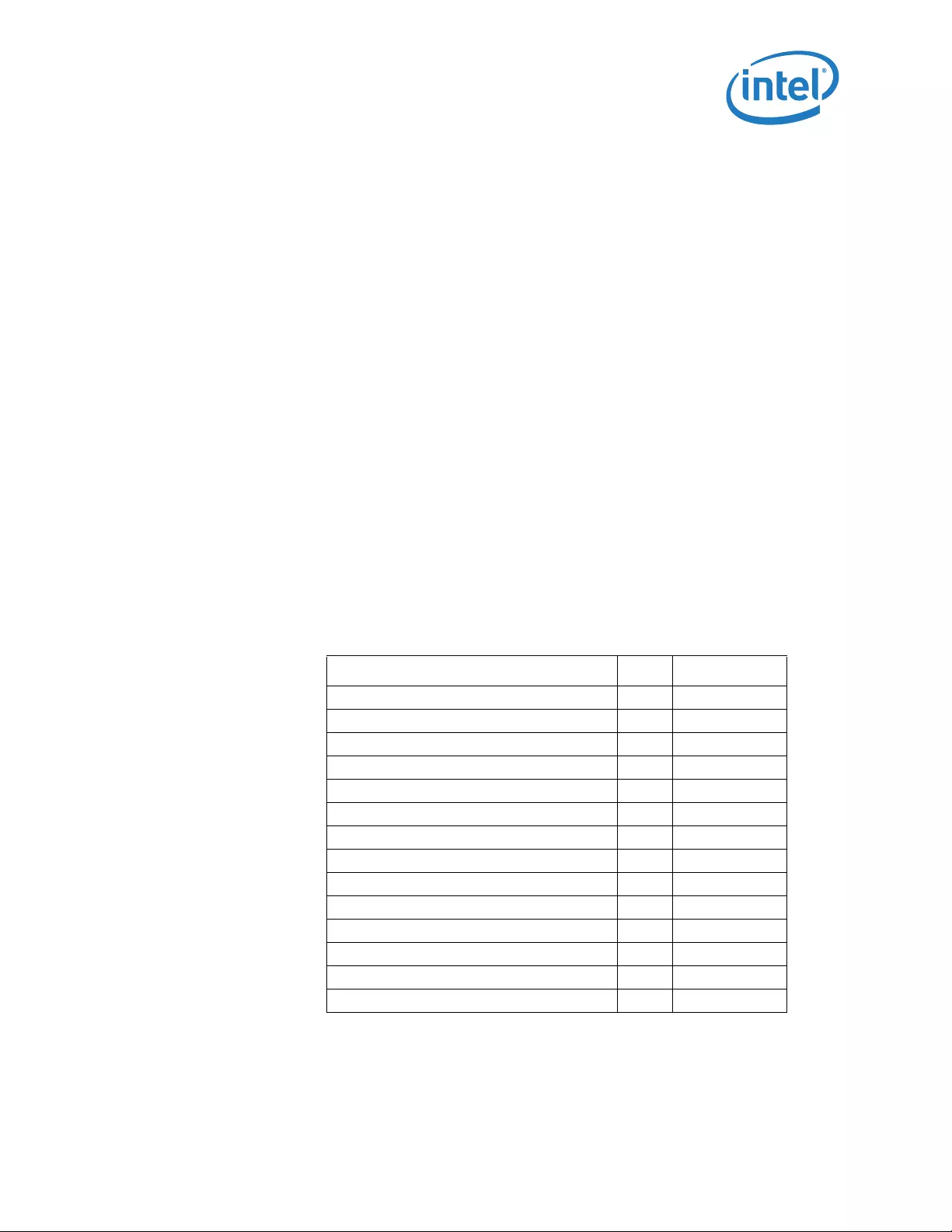
Datasheet 227
PCU - iLB - Real Time Clock (RTC)
weak pull-up resistor. This ILB_RTC_TEST# jumper technique allows the jumper to be
moved and then replaced—all while the system is powered off. Then, once booted, the
GEN_PMCON1.RPS bit can be detected in the set state.
20.3.3 Using GPI to Clear CMOS
A jumper on a GPI can also be used to clear CMOS values. BIOS should detect the
setting of this GPI on system boot-up, and manually clear the CMOS array.
Note: The GPI strap technique to clear CMOS requires multiple steps to implement. The
system is booted with the jumper in new position, then powered back down. The
jumper is replaced back to the normal position, then the system is rebooted again.
Warning: Do not implement a jumper on RTC_VCC to clear CMOS.
20.3.4 Clearing Battery Backed RTC Registers
Clearing Battery Backed RTC Registers in an SoC based platform can be done by using
a jumper on ILB_RTC_RST#. Implementations should not attempt to clear the registers
by using a jumper to pull RTC_VCC low. A jumper on ILB_RTC_RST# pulled to ground
can be used to reset the state of those Battery Backed RTC Register configurations bit
that reside in the RTC power well to their default state. Ta b l e 1 0 4 shows which bits are
set to their default state when ILB_RTC_RST# is asserted low.
20.3.5 S0ix Support
During S0i3, the RTC interface is active.
Table 104. Register Bits Reset by ILB_RTC_RST# Assertion
Register Bit Bit(s) Default State
RCRB_GENERAL_CONTROL.TS 1 xb
GEN_PMCON1.PME_B0_S5_DIS 15 0b
GEN_PMCON1.WOL_EN_OVRD 13 0b
GEN_PMCON1.DIS_SLP_X_STRCH_SUS_UP 12 0b
GEN_PMCON1.RTC Reserved 8 0b
GEN_PMCON1.SWSMI_RATESEL 7:6 00b
GEN_PMCON1.S4MAW 5:4 00b
GEN_PMCON1.S4ASE 3 0b
GEN_PMCON1.AG3E 0 0b
PM1_STS_EN.RTC_EN 26 0b
PM1_STS_EN.PWRBTNOR_STS 11 0b
PM1_CNT.SLP_TYP 12:10 0b
GPE0a_EN.PME_B0_EN 13 0b
GPE0a_EN.BATLOW_EN 10 0b
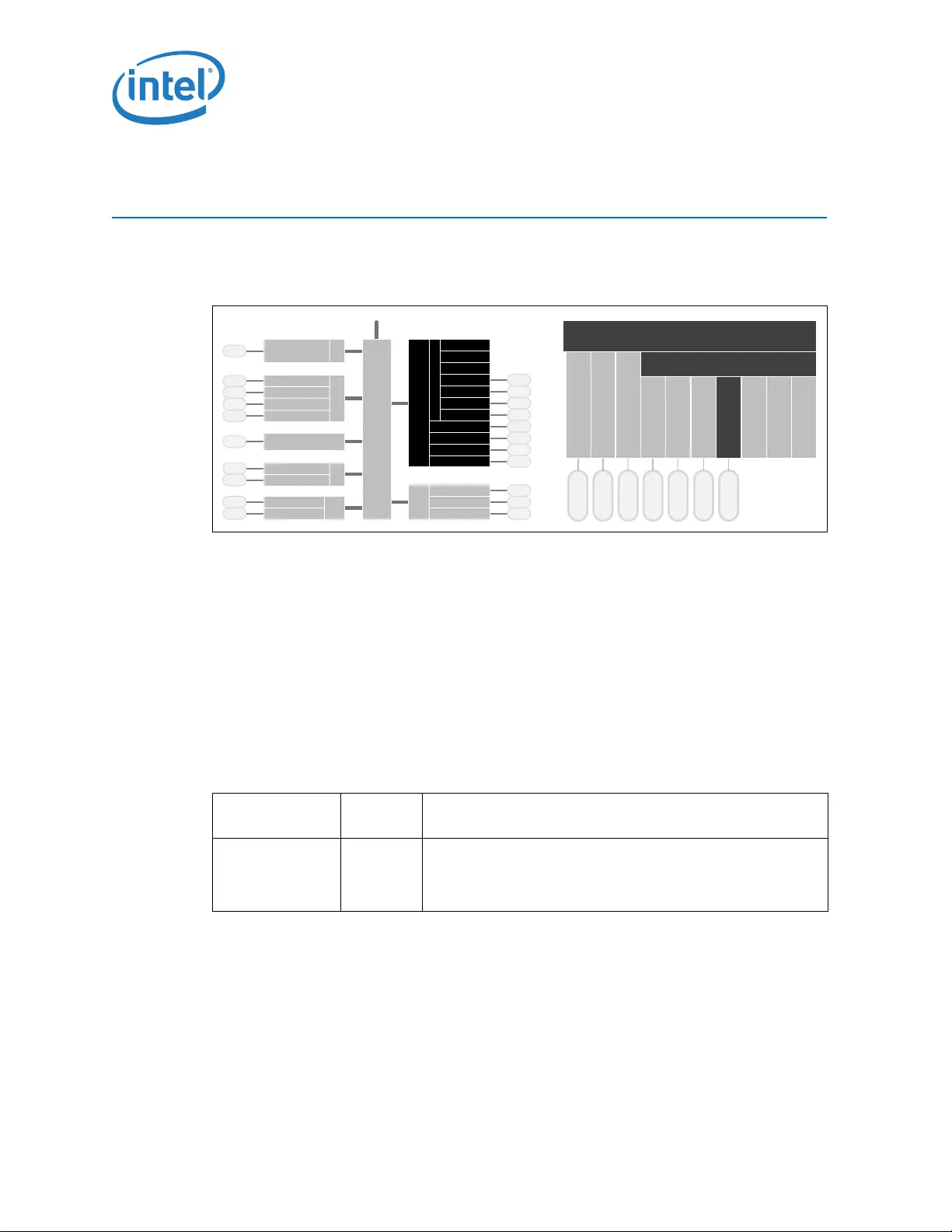
PCU - iLB - 8254 Timers
230 Datasheet
21 PCU - iLB - 8254 Timers
The 8254 contains three counters which have fixed uses including system timer and
speaker tone. All registers are clocked by a 14.31818 MHz clock.
21.1 Signal Descriptions
Refer Chapter 2, “Physical Interfaces” for additional details.
The signal description table has the following headings:
•Signal Name: The name of the signal/pin
•Direction: The buffer direction can be either input, output, or I/O (bidirectional)
•Type: The buffer type found in Chapter 29, “Electrical Specifications”
•Description: A brief explanation of the signal’s function
21.2 Features
21.2.1 Counter 0, System Timer
This counter functions as the system timer by controlling the state of IRQ0 and is
programmed for Mode 3 operation. The counter produces a square wave with a period
equal to the product of the counter period (838 ns) and the initial count value. The
I
O
I
O
I
O
I
O
I
O
I
OO
Platform Control Unit
UART
LPC
GPIO
RTC
HPET
8259
APIC
8254
iLB
SPI
PMC
Table 105. 8254 Signals
Signal Name Direction
/Type Description
ILB_8254_SPKR OSpeaker: The signal drives an external speaker driver device,
which in turn drives the system speaker. Upon PMC_PLTRST#,
its output state is 0.
This signal is muxed and may be used by other functions.

Datasheet 231
PCU - iLB - 8254 Timers
counter loads the initial count value one counter period after software writes the count
value to the counter I/O address. The counter initially asserts IRQ0 and decrements the
count value by two each counter period. The counter negates IRQ0 when the count
value reaches 0. It then reloads the initial count value and again decrements the initial
count value by two each counter period. The counter then asserts IRQ0 when the count
value reaches 0, reloads the initial count value, and repeats the cycle, alternately
asserting and negating IRQ0.
21.2.2 Counter 1, Refresh Request Signal
This counter is programmed for Mode 2 operation and impacts the period of the
NSC.RTS register bit. Programming the counter to anything other than Mode 2 results
in undefined behavior.
21.2.3 Counter 2, Speaker Tone
This counter provides the speaker tone and is typically programmed for Mode 3
operation. The counter provides a speaker frequency equal to the counter clock
frequency (1.193 MHz) divided by the initial count value. The speaker must be enabled
by a write to the NSC.SDE register bit.
21.2.4 S0ix Support
During S0i2 & S0i3, the 8254 timer is halted. A platform that requires the 8254 timer
to be always active, should disable S0i2/3 using the S0ix_Enable register.
21.3 Use
21.3.1 Timer Programming
The counter/timers are programmed in the following fashion:
1. Write a control word to select a counter.
2. Write an initial count for that counter.
3. Load the least and/or most significant bytes (as required by Control Word Bits 5, 4)
of the 16-bit counter.
4. Repeat with other counters.
Only two conventions need to be observed when programming the counters. First, for
each counter, the control word must be written before the initial count is written.
Second, the initial count must follow the count format specified in the control word
(least significant byte only, most significant byte only, or least significant byte and then
most significant byte).

PCU - iLB - 8254 Timers
232 Datasheet
A new initial count may be written to a counter at any time without affecting the
counter's programmed mode. Counting is affected as described in the mode definitions.
The new count must follow the programmed count format.
If a counter is programmed to read/write two-byte counts, the following precaution
applies: A program must not transfer control between writing the first and second byte
to another routine which also writes into that same counter. Otherwise, the counter will
be loaded with an incorrect count.
The Control Word Register at port 43h controls the operation of all three counters.
Several commands are available:
•Control Word Command. Specifies which counter to read or write, the operating
mode, and the count format (binary or BCD).
•Counter Latch Command. Latches the current count so that it can be read by the
system. The countdown process continues.
•Read Back Command. Reads the count value, programmed mode, the current
state of the OUT pins, and the state of the Null Count Flag of the selected counter.
Tab l e 10 6 lists the six operating modes for the interval counters.
21.3.2 Reading from Interval Timer
It is often desirable to read the value of a counter without disturbing the count in
progress. There are three methods for reading the counters: a simple read operation,
counter Latch command, and the Read-Back command. Each is explained below.
With the simple read and counter latch command methods, the count must be read
according to the programmed format; specifically, if the counter is programmed for two
byte counts, two bytes must be read. The two bytes do not have to be read one right
after the other. Read, write, or programming operations for other counters may be
inserted between them.
Table 106. Counter Operating Modes
Mode Function Description
0 Out signal on end of count (=0) Output is 0. When count goes to 0, output goes to 1
and stays at 1 until counter is reprogrammed.
1 Hardware re-triggerable one-
shot
Output is 0. When count goes to 0, output goes to 1
for one clock time.
2 Rate generator (divide by n
counter)
Output is 1. Output goes to 0 for one clock time, then
back to 1 and counter is reloaded.
3 Square wave output Output is 1. Output goes to 0 when counter rolls over,
and counter is reloaded. Output goes to 1 when
counter rolls over, and counter is reloaded, etc.
4 Software triggered strobe Output is 1. Output goes to 0 when count expires for
one clock time.
5 Hardware triggered strobe Output is 1. Output goes to 0 when count expires for
one clock time.

Datasheet 233
PCU - iLB - 8254 Timers
21.3.2.1 Simple Read
The first method is to perform a simple read operation. The counter is selected through
Port 40h (Counter 0), 41h (Counter 1), or 42h (Counter 2).
Note: Performing a direct read from the counter does not return a determinate value,
because the counting process is asynchronous to read operations. However, in the case
of Counter 2, the count can be stopped by writing 0b to the NSC.TC2E register bit.
21.3.2.2 Counter Latch Command
The Counter Latch command, written to Port 43h, latches the count of a specific
counter at the time the command is received. This command is used to ensure that the
count read from the counter is accurate, particularly when reading a two-byte count.
The count value is then read from each counter’s Count register as was programmed by
the Control register.
The count is held in the latch until it is read or the counter is reprogrammed. The count
is then unlatched. This allows reading the contents of the counters on the fly without
affecting counting in progress. Multiple Counter Latch Commands may be used to latch
more than one counter. Counter Latch commands do not affect the programmed mode
of the counter in any way.
If a counter is latched and then, some time later, latched again before the count is
read, the second Counter Latch command is ignored. The count read is the count at the
time the first Counter Latch command was issued.
21.3.2.3 Read Back Command
The Read Back command, written to Port 43h, latches the count value, programmed
mode, and current states of the OUT pin and Null Count flag of the selected counter or
counters. The value of the counter and its status may then be read by I/O access to the
counter address.
The Read Back command may be used to latch multiple counter outputs at one time.
This single command is functionally equivalent to several counter latch commands, one
for each counter latched. Each counter's latched count is held until it is read or
reprogrammed. Once read, a counter is unlatched. The other counters remain latched
until they are read. If multiple count Read Back commands are issued to the same
counter without reading the count, all but the first are ignored.
The Read Back command may additionally be used to latch status information of
selected counters. The status of a counter is accessed by a read from that counter's I/
O port address. If multiple counter status latch operations are performed without
reading the status, all but the first are ignored.
Both count and status of the selected counters may be latched simultaneously. This is
functionally the same as issuing two consecutive, separate Read Back commands. If
multiple count and/or status Read Back commands are issued to the same counters
without any intervening reads, all but the first are ignored.

PCU - iLB - 8254 Timers
234 Datasheet
If both count and status of a counter are latched, the first read operation from that
counter returns the latched status, regardless of which was latched first. The next one
or two reads, depending on whether the counter is programmed for one or two type
counts, returns the latched count. Subsequent reads return unlatched count.
§
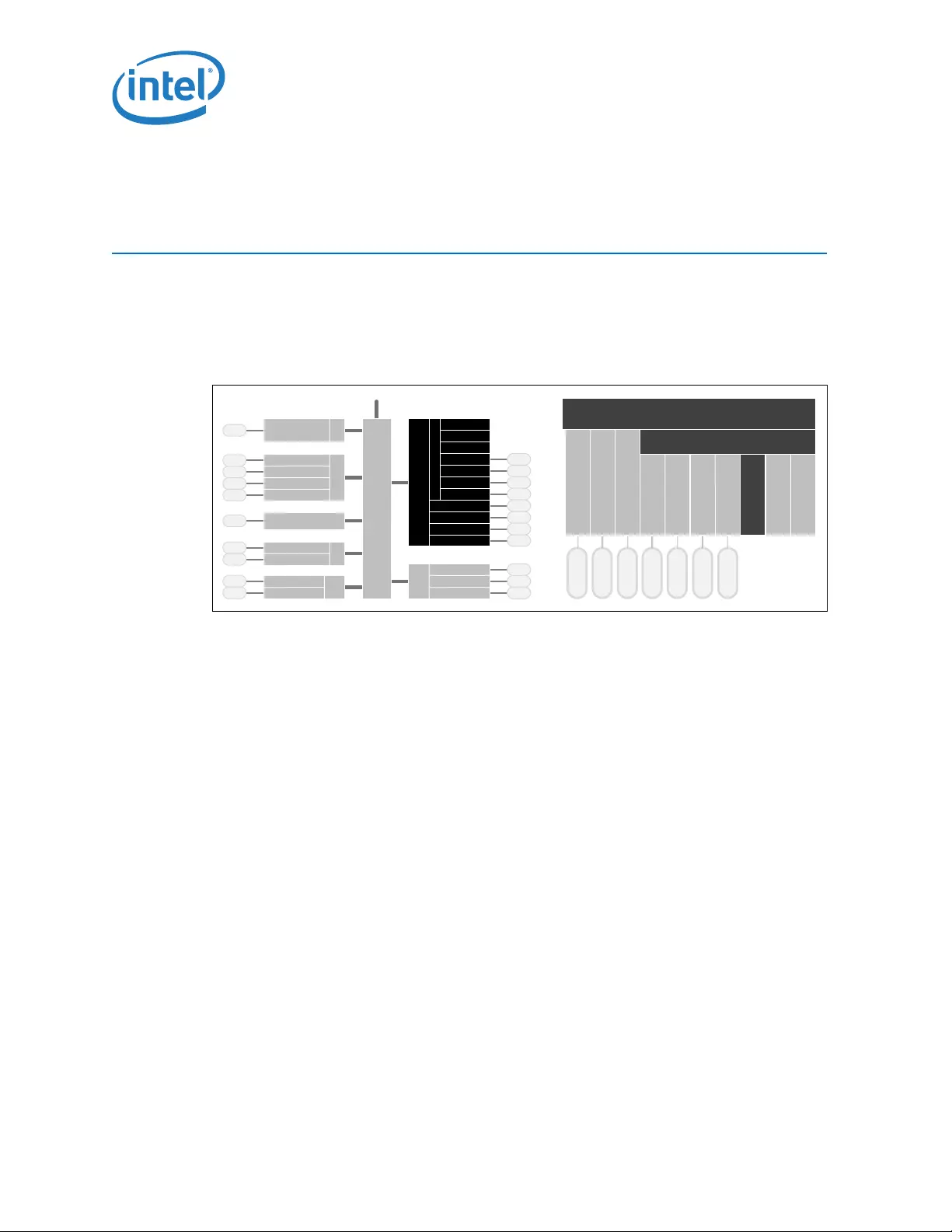
PCU - iLB - High Precision Event Timer (HPET)
236 Datasheet
22 PCU - iLB - High Precision Event
Timer (HPET)
This function provides a set of timers that to be used by the operating system for
timing events. One timer block is implemented, containing one counter and three
timers.
22.1 Features
22.1.1 Non-Periodic Mode - All Timers
This mode can be thought of as creating a one-shot. When a timer is set up for non-
periodic mode, it generates an interrupt when the value in the main counter matches
the value in the timer's comparator register. As timers 1 and 2 are 32-bit, they will
generate another interrupt when the main counter wraps.
T0CV cannot be programmed reliably by a single 64-bit write in a 32-bit environment
unless only the periodic rate is being changed. If T0CV needs to be re-initialized, the
following algorithm is performed:
1. Set T0C.TVS
2. Set T0CV[31:0]
3. Set T0C.TVS
4. Set T0CV[63:32]
Every timer is required to support the non-periodic mode of operation.
I
O
I
O
I
O
I
O
I
O
I
OO
Platform Control Unit
UART
LPC
GPIO
RTC
HPET
8259
APIC
8254
iLB
SPI
PMC

Datasheet 237
PCU - iLB - High Precision Event Timer (HPET)
22.1.2 Periodic Mode - Timer 0 only
When set up for periodic mode, when the main counter value matches the value in
T0CV, an interrupt is generated (if enabled). Hardware then increases T0CV by the last
value written to T0CV. During run-time, T0CV can be read to find out when the next
periodic interrupt will be generated. Software is expected to remember the last value
written to T0CV.
Example: if the value written to T0CV is 00000123h, then
•An interrupt will be generated when the main counter reaches 00000123h.
•T0CV will then be adjusted to 00000246h.
•Another interrupt will be generated when the main counter reaches 00000246h.
•T0CV will then be adjusted to 00000369h.
When the incremented value is greater than the maximum value possible for T0CV, the
value will wrap around through 0. For example, if the current value in a 32-bit timer is
FFFF0000h and the last value written to this register is 20000, then after the next
interrupt the value will change to 00010000h.
If software wants to change the periodic rate, it writes a new value to T0CV. When the
timer's comparator matches, the new value is added to derive the next matching point.
If software resets the main counter, the value in the comparator's value register must
also be reset by setting T0C.TVS. To avoid race conditions, this should be done with the
main counter halted. The following usage model is expected:
1. Software clears GCFG.EN to prevent any interrupts.
2. Software clears the main counter by writing a value of 00h to it.
3. Software sets T0C.TVS.
4. Software writes the new value in T0CV.
5. Software sets GCFG.EN to enable interrupts.
22.1.2.1 Interrupts
If each timer has a unique interrupt and the timer has been configured for edge-
triggered mode, then there are no specific steps required. If configured to level-
triggered mode, then its interrupt must be cleared by software by writing a '1' back to
the bit position for the interrupt to be cleared.
Interrupts associated with the various timers have several interrupt mapping options.
Software should mask GCFG.LRE when reprogramming HPET interrupt routing to avoid
spurious interrupts.
22.1.2.2 Mapping Option #1: Legacy Option (GCFG.LRE set)
This forces the following mapping:
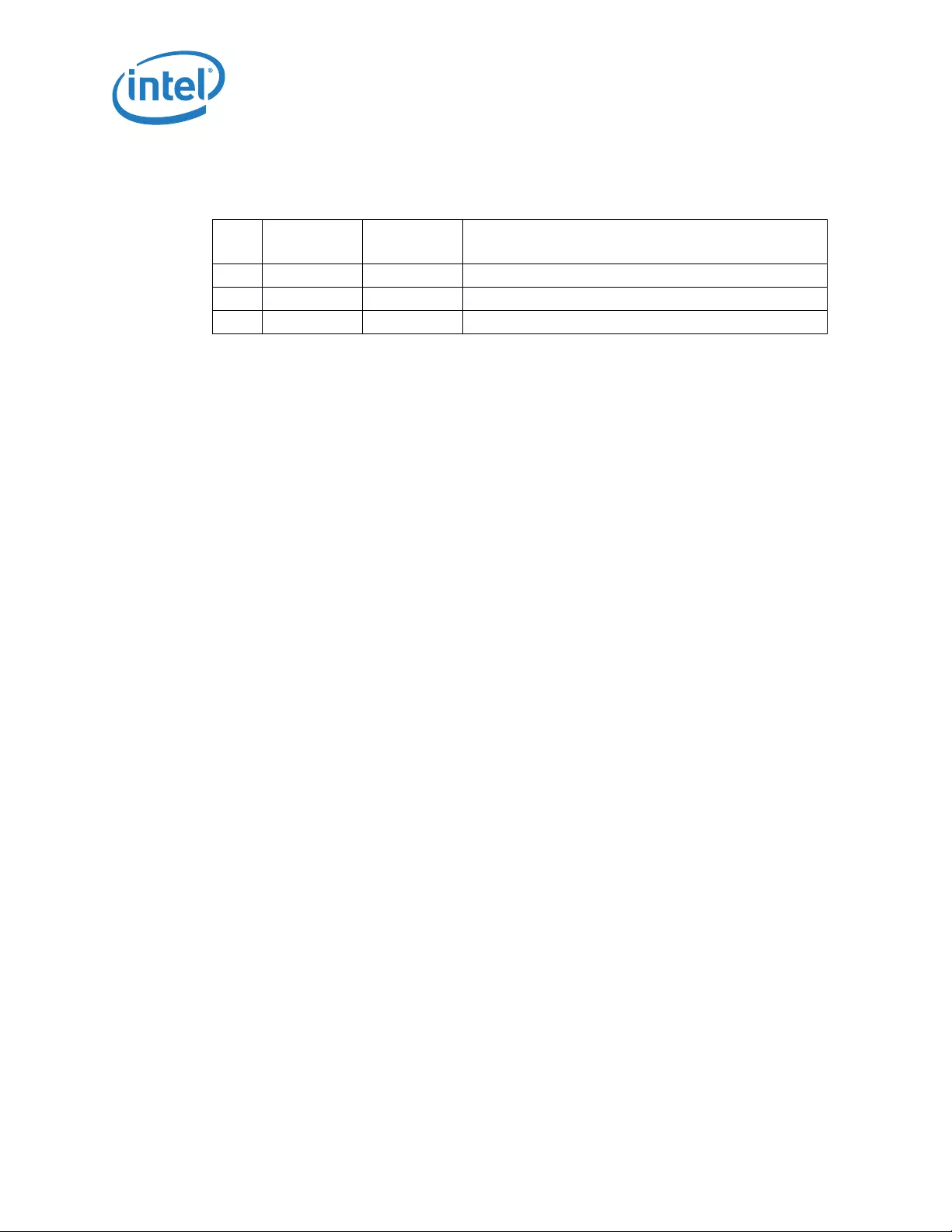
PCU - iLB - High Precision Event Timer (HPET)
238 Datasheet
22.1.2.3 Mapping Option #2: Standard Option (GCFG.LRE cleared)
Each timer has its own routing control. The interrupts can be routed to various
interrupts in the I/O APIC. T[2:0]C.IRC indicates which interrupts are valid options for
routing. If a timer is set for edge-triggered mode, the timers should not be shared with
any other interrupts.
22.1.3 S0ix Support
During S0i1, the HPET is kept running. During S0i2 and S0i3, the HPET is halted.
Prior to entry into S0i2 or S0i3 state, the driver/OS must set HPET_GCFG.EN to 0b to
indicate RTD3hot status.
22.2 References
IA-PC HPET (High Precision Event Timers) Specification, Revision 1.0a: http://
www.intel.com/hardware design/hpetspec_1.pdf
§
Table 107. 8254 Interrupt Mapping
Time
r
8259
Mapping
APIC
Mapping Comment
0 IRQ0 IRQ2 The 8254 timer will not cause any interrupts
1 IRQ8 IRQ8 RTC will not cause any interrupts.
2 T2C.IR T2C.IRC
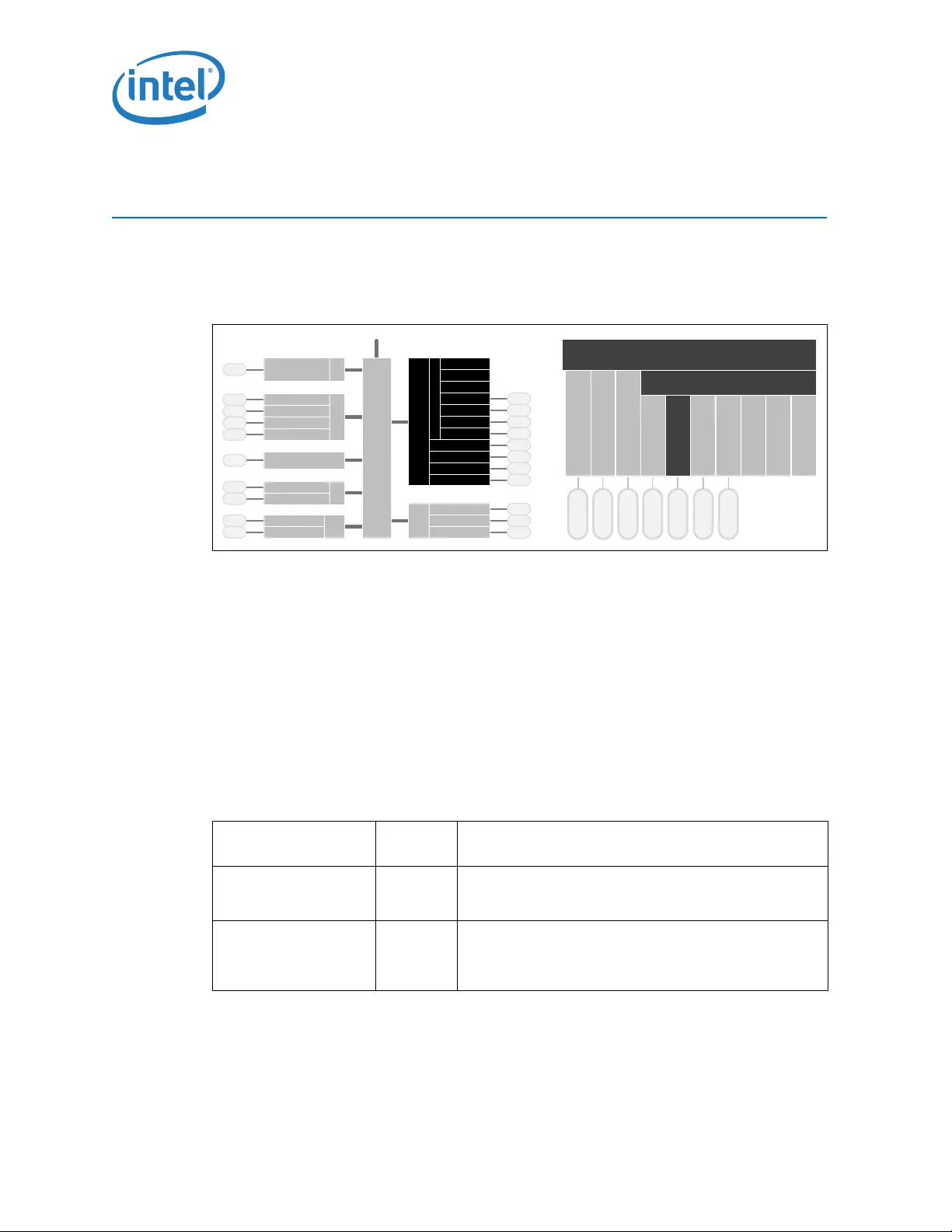
PCU - iLB - GPIO
240 Datasheet
23 PCU - iLB - GPIO
102 GPIOs are available for use during the S0 ACPI state, and 44 are available for use
from S5 to S0 (SUS). Most of these GPIOs can be used as legacy GPIOs through IO
registers. This section describes their use as legacy GPIOs.
23.1 Signal Descriptions
Refer Chapter 2, “Physical Interfaces” for additional details.
The signal description table has the following headings:
•Signal Name: The name of the signal/pin
•Direction: The buffer direction can be either input, output, or I/O (bidirectional)
•Type: The buffer type found in Chapter 29, “Electrical Specifications”
•Description: A brief explanation of the signal’s function
23.2 Features
GPIOs can generate general purpose events (GPEs) on rising and/or falling edges.
I
O
I
O
I
O
I
O
I
O
I
OO
Platform Control Unit
UART
LPC
GPIO
RTC
HPET
8259
APIC
8254
iLB
SPI
PMC
Table 108. GPIO Signals
Signal Name Direction
/Type Description
GPIO_S0_SC[101:0] I/O
Varies
These GPIO pins are powered and active in S0 only. Many
of these are multiplexed with other functions and may
have different default pin names.
GPIO_S5[43:0] I/O
Varies
These GPIO pins are powered and active in S5-S0 (SUS).
Many of these are multiplexed with other functions and
may have different default pin names. Some are used as
straps.

Datasheet 241
PCU - iLB - GPIO
23.3 Use
Each GPIO has six registers that control how it is used, or report its status:
•Use Select
•I/O Select
•GPIO Level
•Trigger Positive Edge
•Trigger Negative Edge
•Trigger Status
The Use Select register selects a GPIO pin as a GPIO, or leaves it as its programmed
function. This register must be set for all other registers to affect the GPIO.
The I/O Select register determines the direction of the GPIO.
The Trigger Positive Edge and Trigger Negative Edge registers enable general purpose
events on a rising and falling edge respectively. This only applies to GPIOs set as input.
The Trigger Status register is used by software to determine if the GPIO triggered a
GPE. This only applies to GPIOs set as input and with one or both of the Trigger modes
enabled.
Additionally, there is one additional register for each S5 GPIO:
•Wake Enable
This register allows S5 GPIOs to trigger a wake event based on the Trigger registers’
settings.

PCU - iLB - GPIO
242 Datasheet
23.4 GPIO Registers
Registers are broken into two groups: memory mapped and legacy IO registers.
Memory mapped registers are used by BIOS and firmware to select the configurable
function of the GPIO and setup analog states needed for that function’s operation. They
are named based on the pin/ball name. Legacy IO registers are the more traditional
GPIO control/status type, and are used when the function selected is a traditional GPIO
(direction, level, use registers). They are numbered based on the GPIO number.
Each group is further broken down into SCORE (internal partition naming) and SSUS.
SCORE are for the GPIO’s named GPIO_S0_SC[xxx], while SSUS are for the GPIO’s
named GPIO_S5[xx].
Note: All GPIO registers must be accessed as double words. Unpredictable results will occur
otherwise.
Note: All memory mapped GPIO *_PAD_VAL’s must set Ienenb = 0 in order to read the
pad_val of the GPIO. This applies to RO GPIO’s as well.
vGPIO’s are virtual GPIO’s for use by software to generate interrupts. They are not tied
to physical pins.
§
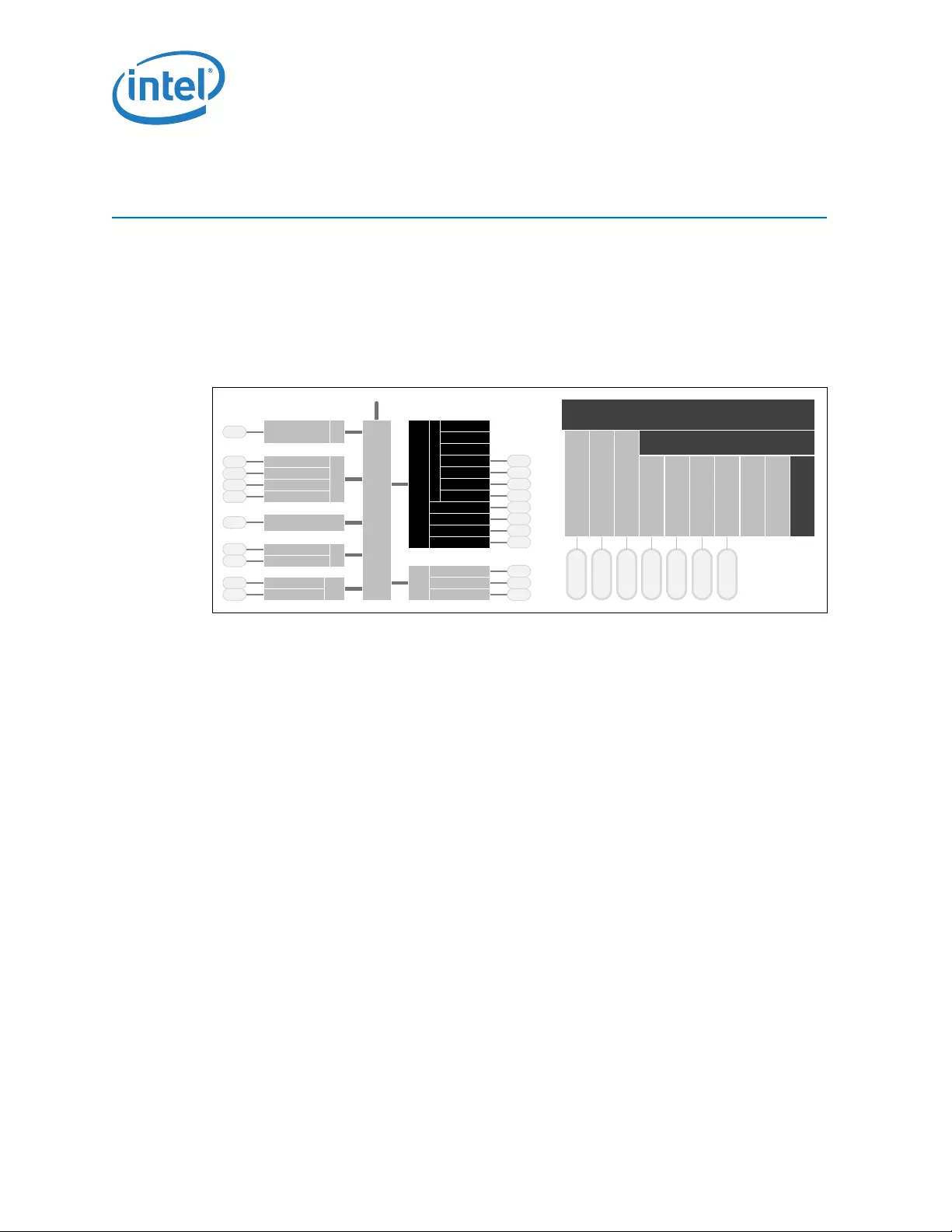
PCU - iLB - IO APIC
244 Datasheet
24 PCU - iLB - IO APIC
The IO Advanced Programmable Interrupt Controller (APIC) is used to support line
interrupts more flexibly than the 8259 PIC. Line interrupts are routed to it from
multiple sources, including legacy devices, via the interrupt decoder and serial IRQs, or
they are routed to it from the interrupt router in the iLB. These line based interrupts
are then used to generate interrupt messages targeting the local APIC in the processor.
24.1 Features
•87 interrupt lines
— IRQ0-86
•Edge or level trigger mode per interrupt
•Active low or high polarity per interrupt
•Works with local APIC in processor via MSIs
•MSIs can target specific processor core
•Established APIC programming model
I
O
I
O
I
O
I
O
I
O
I
OO
Platform Control Unit
UART
LPC
GPIO
RTC
HPET
8259
APIC
8254
iLB
SPI
PMC

Datasheet 245
PCU - iLB - IO APIC
MSIs generated by the I/O APIC are sent as 32-bit memory writes to the Local APIC.
The address and data of the write transaction are used as follows.
Figure 37. Detailed Block Diagram
I/O APIC
INT[86:0]
INT2
INT3
INT4
INT5
INT7
INT6
INT0
INT1
INT10
INT11
INT12
INT13
INT15
INT14
INT8
INT9
INT18
INT19
INT86
INT85
INT16
INT17
INT[86]
...
RTE[86]
INT[0] RTE[0] 0
To/From System Bus
...
MSI Machine
MSI’s
ID VS
IDX
WDW
EOI
FEC0 0000h
FEC0 0010h
FEC0 0040h
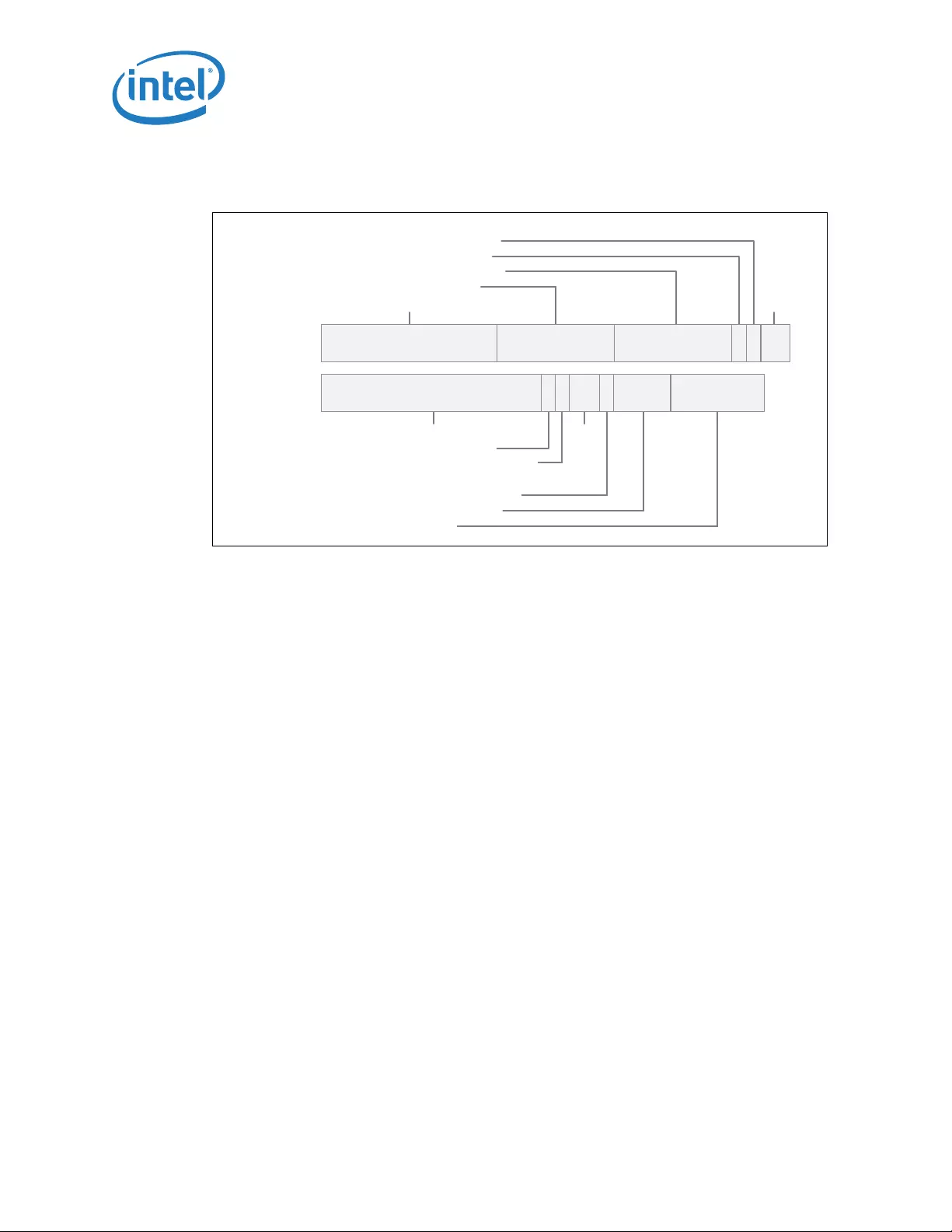
PCU - iLB - IO APIC
246 Datasheet
Destination ID (DID) and Extended Destination ID (EDID) are used to target a specific
processor core’s local APIC.
24.2 Use
The I/O APIC contains indirectly accessed I/O APIC registers and normal memory
mapped registers. There are three memory mapped registers:
•Index Register (IDX)
•Window Register (WDW)
•End Of Interrupt Register (EOI)
The Index register selects an indirect I/O APIC register (ID/VS/RTE[n]) to appear in the
Window register.
The Window register is used to read or write the indirect register selected by the Index
register.
The EOI register is written to by the Local APIC in the processor. The I/O APIC
compares the lower eight bits written to the EOI register to the Vector set for each
interrupt (RTE.VCT). All interrupts that match this vector will have their RTE.RIRR
register cleared. All other EOI register bits are ignored.
Figure 38. MSI Address and Data
31:16 7:010:8151413:1211
0000h 00b
RTE[n].DLM
RTE[n].VCT
RTE[n].DSM
00b
FEEh
RTE[n].DID
RTE[n].EDID
Set if RTE[n].DLM = 001b
RTE[n].DSM
MSI
Address
MSI
Data
Trigger Mode
Delivery Status (1b)
Delivery Mode
Vector
RTE[n].TM
Destination Mode
Destination ID
Extended Dest. ID
Redirection Hint
Destination Mode
31 : 20 19 : 12 11 : 4 3 2 1 : 0

Datasheet 247
PCU - iLB - IO APIC
24.3 Indirect I/O APIC Registers
These registers are selected with the IDX register, and read/written through the WDW
register. Accessing these registers must be done as DW requests, otherwise unspecified
behavior will result. Software should not attempt to write to reserved registers.
Reserved registers may return non-zero values when read.
Note: There is one pair of redirection (RTE) registers per interrupt line. Each pair forms a 64-
bit RTE register.
Note: Specified offsets should be placed in IDX, not added to IDX.
§
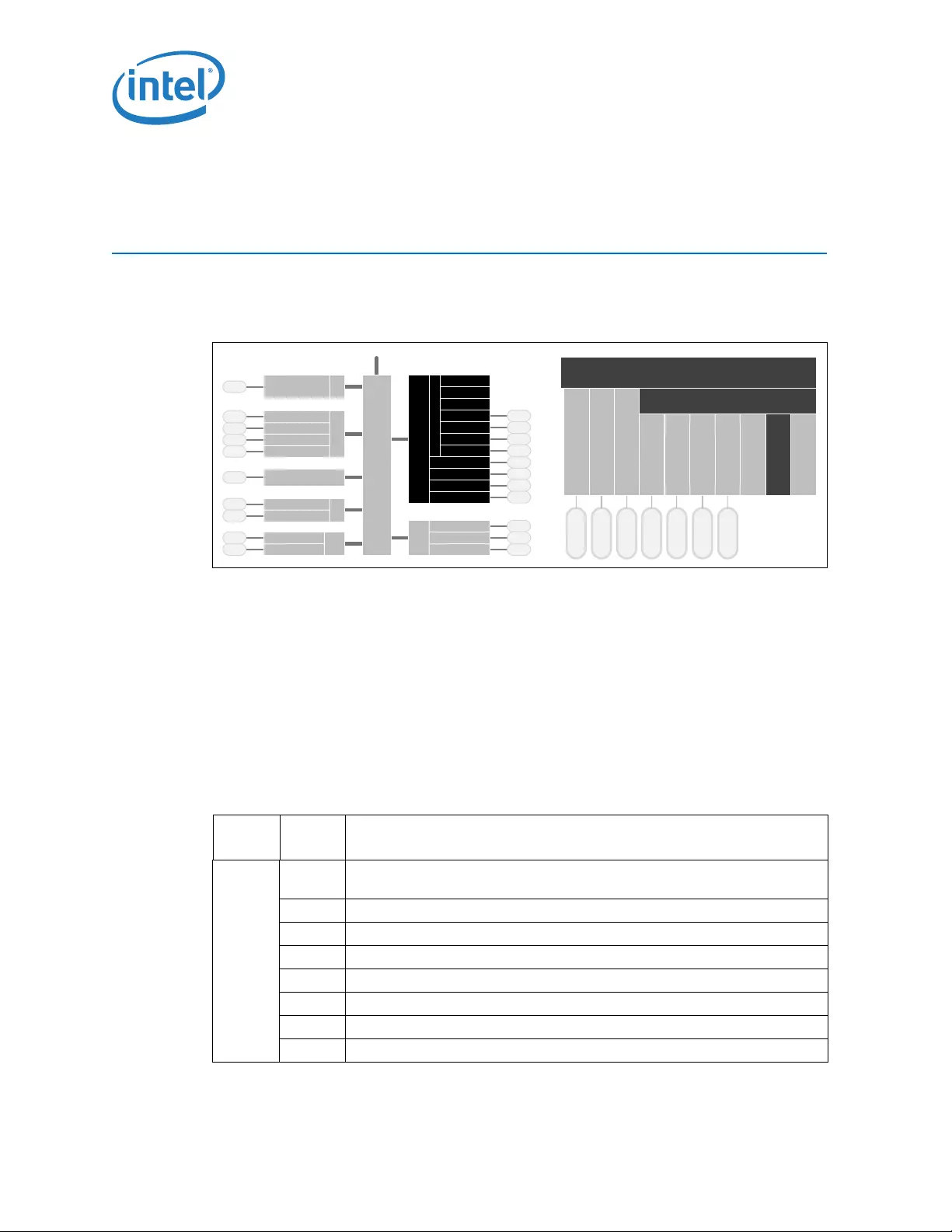
PCU - iLB - 8259 Programmable Interrupt Controllers (PIC)
248 Datasheet
25 PCU - iLB - 8259 Programmable
Interrupt Controllers (PIC)
The SoC provides an ISA-compatible programmable interrupt controller (PIC) that
incorporates the functionality of two, cascaded 8259 interrupt controllers.
25.1 Features
In addition to providing support for ISA compatible interrupts, this interrupt controller
can also support PCI based interrupts (PIRQs) by mapping the PCI interrupt onto a
compatible ISA interrupt line. Each 8259 controller supports eight interrupts, numbered
0–7. Ta bl e 1 0 9 shows how the controllers are connected.
Note: The SoC does not implement any external PIRQ# signals. The PIRQs referred to in this
section originate from the interrupt routing unit.
I
O
I
O
I
O
I
O
I
O
I
OO
Platform Control Unit
UART
LPC
GPIO
RTC
HPET
8259
APIC
8254
iLB
SPI
PMC
Table 109. Interrupt Controller Connections (Sheet 1 of 2)
8259 8259
Input Connected Pin / Function
Master 0 Internal Timer / Counter 0 output or HPET #0; determined by GCFG.LRE
register bit
1 IRQ1 using SERIRQ, Keyboard Emulation
2 Slave controller INTR output
3 IRQ3 via SERIRQ, PIRQx or PCU UART 1
4 IRQ4 via SERIRQ or PIRQx
5 IRQ5 via SERIRQ or PIRQx
6 IRQ6 via SERIRQ or PIRQx
7 IRQ7 via SERIRQ or PIRQx
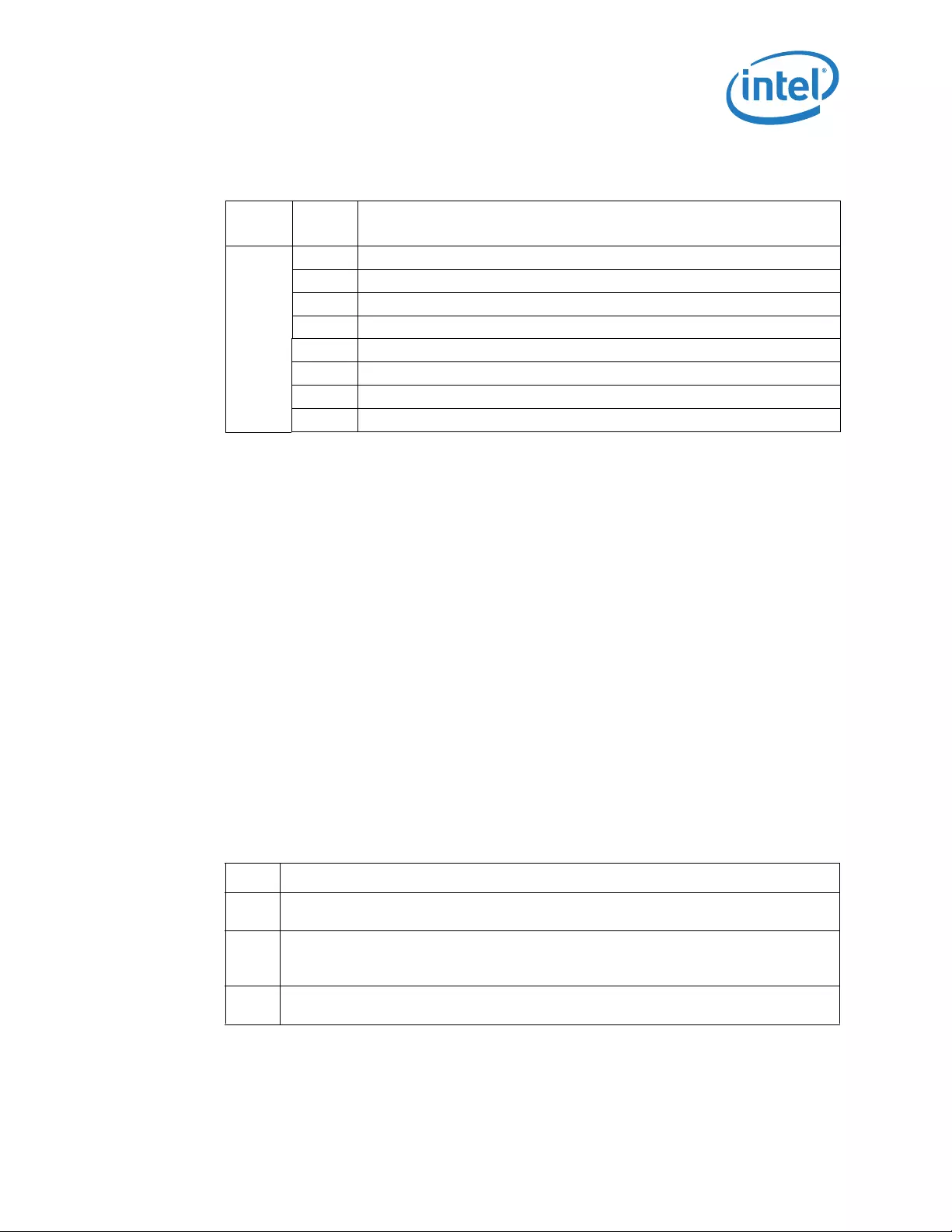
Datasheet 249
PCU - iLB - 8259 Programmable Interrupt Controllers (PIC)
The SoC cascades the slave controller onto the master controller through master
controller interrupt input 2. This means there are only 15 possible interrupts for the
SoC PIC.
Interrupts can be programmed individually to be edge or level, except for IRQ0, IRQ2
and IRQ8#.
Note: Active-low interrupt sources (such as a PIRQ#) are inverted inside the SoC. In the
following descriptions of the 8259s, the interrupt levels are in reference to the signals
at the internal interface of the 8259s, after the required inversions have occurred.
Therefore, the term “high” indicates “active,” which means “low” on an originating
PIRQ#.
25.1.1 Interrupt Handling
25.1.1.1 Generating Interrupts
The PIC interrupt sequence involves three bits, from the IRR, ISR, and IMR, for each
interrupt level. These bits are used to determine the interrupt vector returned, and
status of any other pending interrupts. Table 110 defines the IRR, ISR, and IMR.
Slave 0 Inverted IRQ8# from internal RTC or HPET
1 IRQ9 via SERIRQ, SCI or PIRQx
2 IRQ10 via SERIRQ, SCI or PIRQx
3 IRQ11 via SERIRQ, SCI, HPET or PIRQx
4 IRQ12 via SERIRQ, PIRQx or mouse emulation
5None
6PIRQx
7 IRQ15 via SERIRQ or PIRQx o
Table 109. Interrupt Controller Connections (Sheet 2 of 2)
8259 8259
Input Connected Pin / Function
Table 110. Interrupt Status Registers
Bit Description
IRR Interrupt Request Register. This bit is set on a low to high transition of the interrupt
line in edge mode, and by an active high level in level mode.
ISR Interrupt Service Register. This bit is set, and the corresponding IRR bit cleared,
when an interrupt acknowledge cycle is seen, and the vector returned is for that
interrupt.
IMR Interrupt Mask Register. This bit determines whether an interrupt is masked.
Masked interrupts will not generate INTR.
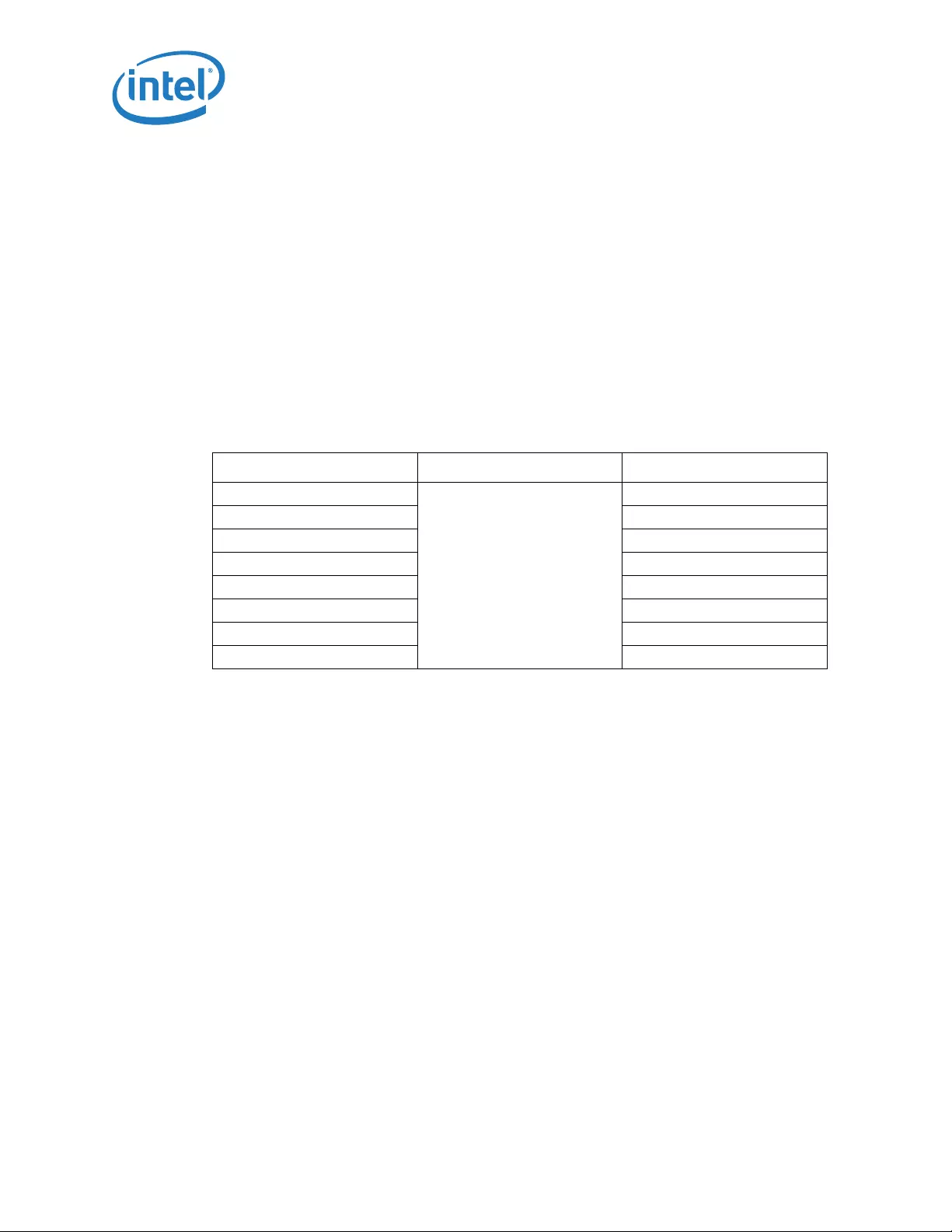
PCU - iLB - 8259 Programmable Interrupt Controllers (PIC)
250 Datasheet
25.1.1.2 Acknowledging Interrupts
The processor generates an interrupt acknowledge cycle that is translated into a
Interrupt Acknowledge Cycle to the SoC. The PIC translates this command into two
internal INTA# pulses expected by the 8259 controllers. The PIC uses the first internal
INTA# pulse to freeze the state of the interrupts for priority resolution. On the second
INTA# pulse, the master or slave sends the interrupt vector to the processor with the
acknowledged interrupt code. This code is based upon the ICW2.IVBA bits, combined
with the ICW2.IRL bits representing the interrupt within that controller.
Note: References to ICWx and OCWx registers are relevant to both the master and slave
8259 controllers.
25.1.1.3 Hardware/Software Interrupt Sequence
1. One or more of the Interrupt Request lines (IRQ) are raised high in edge mode, or
seen high in level mode, setting the corresponding IRR bit.
2. The PIC sends INTR active to the processor if an asserted interrupt is not masked.
3. The processor acknowledges the INTR and responds with an interrupt acknowledge
cycle.
4. Upon observing the special cycle, the SoC converts it into the two cycles that the
internal 8259 pair can respond to. Each cycle appears as an interrupt acknowledge
pulse on the internal INTA# pin of the cascaded interrupt controllers.
5. Upon receiving the first internally generated INTA# pulse, the highest priority ISR
bit is set and the corresponding IRR bit is reset. On the trailing edge of the first
pulse, a slave identification code is broadcast by the master to the slave on a
private, internal three bit wide bus. The slave controller uses these bits to
determine if it must respond with an interrupt vector during the second INTA#
pulse.
6. Upon receiving the second internally generated INTA# pulse, the PIC returns the
interrupt vector. If no interrupt request is present because the request was too
short in duration, the PIC returns vector 7 from the master controller.
Table 111. Content of Interrupt Vector Byte
Master, Slave Interrupt Bits [7:3] Bits [2:0]
IRQ7,15
ICW2.IVBA
111
IRQ6,14 110
IRQ5,13 101
IRQ4,12 100
IRQ3,11 011
IRQ2,10 010
IRQ1,9 001
IRQ0,8 000

Datasheet 251
PCU - iLB - 8259 Programmable Interrupt Controllers (PIC)
7. This completes the interrupt cycle. In AEOI mode the ISR bit is reset at the end of
the second INTA# pulse. Otherwise, the ISR bit remains set until an appropriate
EOI command is issued at the end of the interrupt subroutine.
25.1.2 Initialization Command Words (ICWx)
Before operation can begin, each 8259 must be initialized. In the SoC, this is a four
byte sequence. The four initialization command words are referred to by their
acronyms: ICW1, ICW2, ICW3, and ICW4.
The base address for each 8259 initialization command word is a fixed location in the I/
O memory space: 20h for the master controller, and A0h for the slave controller.
25.1.2.1 ICW1
A write to the master or slave controller base address with data bit 4 equal to 1 is
interpreted as a write to ICW1. Upon sensing this write, the PIC expects three more
byte writes to 21h for the master controller, or A1h for the slave controller, to complete
the ICW sequence.
A write to ICW1 starts the initialization sequence during which the following
automatically occur:
1. Following initialization, an interrupt request (IRQ) input must make a low-to-high
transition to generate an interrupt.
2. The Interrupt Mask Register is cleared.
3. IRQ7 input is assigned priority 7.
4. The slave mode address is set to 7.
5. Special mask mode is cleared and Status Read is set to IRR.
25.1.2.2 ICW2
The second write in the sequence (ICW2) is programmed to provide bits [7:3] of the
interrupt vector that will be released during an interrupt acknowledge. A different base
is selected for each interrupt controller.
25.1.2.3 ICW3
The third write in the sequence (ICW3) has a different meaning for each controller.
•For the master controller, ICW3 is used to indicate which IRQ input line is used to
cascade the slave controller. Within the SoC, IRQ2 is used. Therefore, MICW3.CCC
is set to a 1, and the other bits are set to 0s.
•For the slave controller, ICW3 is the slave identification code used during an
interrupt acknowledge cycle. On interrupt acknowledge cycles, the master
controller broadcasts a code to the slave controller if the cascaded interrupt won
arbitration on the master controller. The slave controller compares this

PCU - iLB - 8259 Programmable Interrupt Controllers (PIC)
252 Datasheet
identification code to the value stored in its ICW3, and if it matches, the slave
controller assumes responsibility for broadcasting the interrupt vector.
25.1.2.4 ICW4
The final write in the sequence (ICW4) must be programmed for both controllers. At
the very least, ICW4.MM must be set to a 1 to indicate that the controllers are
operating in an Intel Architecture-based system.
25.1.3 Operation Command Words (OCW)
These command words reprogram the Interrupt controller to operate in various
interrupt modes.
•OCW1 masks and unmasks interrupt lines.
•OCW2 controls the rotation of interrupt priorities when in rotating priority mode,
and controls the EOI function.
•OCW3 sets up ISR/IRR reads, enables/disables the special mask mode (SMM), and
enables/disables polled interrupt mode.
25.1.4 Modes of Operation
25.1.4.1 Fully Nested Mode
In this mode, interrupt requests are ordered in priority from 0 through 7, with 0 being
the highest. When an interrupt is acknowledged, the highest priority request is
determined and its vector placed on the bus. Additionally, the ISR for the interrupt is
set. This ISR bit remains set until: the processor issues an EOI command immediately
before returning from the service routine; or if in AEOI mode, on the trailing edge of
the second INTA#. While the ISR bit is set, all further interrupts of the same or lower
priority are inhibited, while higher levels generate another interrupt.
Interrupt priorities can be changed in the rotating priority mode.
25.1.4.2 Special Fully-Nested Mode
This mode is used in the case of a system where cascading is used, and the priority has
to be conserved within each slave. In this case, the special fully-nested mode is
programmed to the master controller. This mode is similar to the fully-nested mode
with the following exceptions:
•When an interrupt request from a certain slave is in service, this slave is not locked
out from the master's priority logic and further interrupt requests from higher
priority interrupts within the slave are recognized by the master and initiate
interrupts to the processor. In the normal-nested mode, a slave is masked out
when its request is in service.
•When exiting the Interrupt Service routine, software has to check whether the
interrupt serviced was the only one from that slave. This is done by sending a Non-

Datasheet 253
PCU - iLB - 8259 Programmable Interrupt Controllers (PIC)
Specific EOI command to the slave and then reading its ISR. If it is 0, a non-specific
EOI can also be sent to the master.
25.1.4.3 Automatic Rotation Mode (Equal Priority Devices)
In some applications, there are a number of interrupting devices of equal priority.
Automatic rotation mode provides for a sequential 8-way rotation. In this mode, a
device receives the lowest priority after being serviced. In the worst case, a device
requesting an interrupt has to wait until each of seven other devices are serviced at
most once.
There are two ways to accomplish automatic rotation using OCW2.REOI; the Rotation
on Non-Specific EOI Command (OCW2.REOI=101b) and the rotate in automatic EOI
mode which is set by (OCW2.REOI=100b).
25.1.4.4 Specific Rotation Mode (Specific Priority)
Software can change interrupt priorities by programming the bottom priority. For
example, if IRQ5 is programmed as the bottom priority device, then IRQ6 is the highest
priority device. The Set Priority Command is issued in OCW2 to accomplish this, where:
OCW2.REOI=11xb, and OCW2.ILS is the binary priority level code of the bottom
priority device.
In this mode, internal status is updated by software control during OCW2. However, it
is independent of the EOI command. Priority changes can be executed during an EOI
command by using the Rotate on Specific EOI Command in OCW2 (OCW2.REOI=111b)
and OCW2.ILS=IRQ level to receive bottom priority.
25.1.4.5 Poll Mode
Poll mode can be used to conserve space in the interrupt vector table. Multiple
interrupts that can be serviced by one interrupt service routine do not need separate
vectors if the service routine uses the poll command. Poll mode can also be used to
expand the number of interrupts. The polling interrupt service routine can call the
appropriate service routine, instead of providing the interrupt vectors in the vector
table. In this mode, the INTR output is not used and the microprocessor internal
Interrupt Enable flip-flop is reset, disabling its interrupt input. Service to devices is
achieved by software using a Poll command.
The Poll command is issued by setting OCW3.PMC. The PIC treats its next I/O read as
an interrupt acknowledge, sets the appropriate ISR bit if there is a request, and reads
the priority level. Interrupts are frozen from the OCW3 write to the I/O read. The byte
returned during the I/O read contains a 1 in Bit 7 if there is an interrupt, and the binary
code of the highest priority level in Bits 2:0.

PCU - iLB - 8259 Programmable Interrupt Controllers (PIC)
254 Datasheet
25.1.4.6 Edge and Level Triggered Mode
In ISA systems this mode is programmed using ICW1.LTIM, which sets level or edge for
the entire controller. In the SoC, this bit is disabled and a register for edge and level
triggered mode selection, per interrupt input, is included. This is the Edge/Level control
Registers ELCR1 and ELCR2.
If an ELCR bit is 0, an interrupt request will be recognized by a low-to-high transition
on the corresponding IRQ input. The IRQ input can remain high without generating
another interrupt. If an ELCR bit is 1, an interrupt request will be recognized by a high
level on the corresponding IRQ input and there is no need for an edge detection. The
interrupt request must be removed before the EOI command is issued to prevent a
second interrupt from occurring.
In both the edge and level triggered modes, the IRQ inputs must remain active until
after the falling edge of the first internal INTA#. If the IRQ input goes inactive before
this time, a default IRQ7 vector is returned.
25.1.5 End of Interrupt (EOI) Operations
An EOI can occur in one of two fashions: by a command word write issued to the PIC
before returning from a service routine, the EOI command; or automatically when the
ICW4.AEOI bit is set to 1.
25.1.5.1 Normal End of Interrupt
In normal EOI, software writes an EOI command before leaving the interrupt service
routine to mark the interrupt as completed. There are two forms of EOI commands:
Specific and Non-Specific. When a Non-Specific EOI command is issued, the PIC clears
the highest ISR bit of those that are set to 1. Non-Specific EOI is the normal mode of
operation of the PIC within the SoC, as the interrupt being serviced currently is the
interrupt entered with the interrupt acknowledge. When the PIC is operated in modes
that preserve the fully nested structure, software can determine which ISR bit to clear
by issuing a Specific EOI.
An ISR bit that is masked is not cleared by a Non-Specific EOI if the PIC is in the special
mask mode. An EOI command must be issued for both the master and slave controller.
25.1.5.2 Automatic End of Interrupt Mode
In this mode, the PIC automatically performs a Non-Specific EOI operation at the
trailing edge of the last interrupt acknowledge pulse. From a system standpoint, this
mode should be used only when a nested multi-level interrupt structure is not required
within a single PIC. The AEOI mode can only be used in the master controller and not
the slave controller.
Note: Both the master and slave PICs have an AEOI bit: MICW4.AEOI and SICW4.AEOI
respectively. Only the MICW4.AEOI bit should be set by software. The SICW4.AEOI bit
should not be set by software.

Datasheet 255
PCU - iLB - 8259 Programmable Interrupt Controllers (PIC)
25.1.6 Masking Interrupts
25.1.6.1 Masking on an Individual Interrupt Request
Each interrupt request can be masked individually by the Interrupt Mask Register
(IMR). This register is programmed through OCW1. Each bit in the IMR masks one
interrupt channel. Masking IRQ2 on the master controller masks all requests for service
from the slave controller.
25.1.6.2 Special Mask Mode
Some applications may require an interrupt service routine to dynamically alter the
system priority structure during its execution under software control. For example, the
routine may wish to inhibit lower priority requests for a portion of its execution but
enable some of them for another portion.
The special mask mode enables all interrupts not masked by a bit set in the Mask
register. Normally, when an interrupt service routine acknowledges an interrupt without
issuing an EOI to clear the ISR bit, the interrupt controller inhibits all lower priority
requests. In the special mask mode, any interrupts may be selectively enabled by
loading the Mask Register with the appropriate pattern.
The special mask mode is set by OCW3.ESMM=1b & OCW3.SMM=1b, and cleared
where OCW3.ESMM=1b & OCW3.SMM=0b.
25.1.7 S0ix Support
During S0i2 & S0i3, the 8259 PICs are disabled. A platform that requires the 8259 PICs
to be always active, should disable S0i2/3 using the S0ix_Enable register.
§

PCU - iLB - Interrupt Decoding and Routing
256 Datasheet
26 PCU - iLB - Interrupt Decoding
and Routing
The interrupt decoder is responsible for receiving interrupt messages from other
devices in the SoC and decoding them for consumption by the interrupt router, the PCU
- iLB - 8259 Programmable Interrupt Controllers (PIC) and/or the PCU - iLB - IO APIC.
The interrupt router is responsible for mapping each incoming interrupt to the
appropriate PIRQx, for consumption by the PCU - iLB - 8259 Programmable Interrupt
Controllers (PIC) and/or PCU - iLB - IO APIC.
26.1 Features
26.1.1 Interrupt Decoder
The interrupt decoder receives interrupt messages from devices in the SoC. These
interrupts can be split into two primary groups:
•For consumption by the interrupt router
•For consumption by the 8259 PIC
26.1.1.1 For Consumption by the Interrupt Router
When a PCI-mapped device in the SoC asserts or de-asserts an INT[A:D] interrupt, an
interrupt message is sent to the decoder. This message is decoded to indicate to the
interrupt router which specific interrupt is asserted or de-asserted and which device the
INT[A:D] interrupt originated from.
26.1.1.2 For Consumption by the 8259 PIC
When a device in the SoC asserts or de-asserts a legacy interrupt (IRQ), an interrupt
message is sent to the decoder. This message is decoded to indicate to the 8259 PIC,
which specific interrupt (IRQ[3, 4, 14 or 15]) was asserted or de-asserted.
26.1.2 Interrupt Router
The interrupt router aggregates the INT[A:D] interrupts for each PCI-mapped device in
the SoC, received from the interrupt decoder, and the INT[A:D] interrupts direct from
the Serialized IRQ controller. It then maps these aggregated interrupts to 8 PCI based
interrupts: PIRQ[A:H]. This mapping is configured using the IR[31:0] registers.
PCI based interrupts PIRQ[A:H] are then available for consumption by either the 8259
PICs or the IO-APIC, depending on the configuration of the 8 PIRQx Routing Control
Registers: PIRQA, PIQRB, PIRQC, PIRQD, PIRQE, PIRQF, PIRQG, PIRQH.

Datasheet 257
PCU - iLB - Interrupt Decoding and Routing
26.1.2.1 Routing PCI Based Interrupts to 8259 PIC
The interrupt router can be programmed to allow PIRQA-PIRQH to be routed internally
to the 8259 as ISA compatible interrupts IRQ 3–7, 9–12 & 14–15. The assignment is
programmable through the 8 PIRQx Routing Control Registers: PIRQA, PIQRB, PIRQC,
PIRQD, PIRQE, PIRQF, PIRQG, PIRQH. One or more PIRQs can be routed to the same
IRQ input. If ISA Compatible Interrupts are not required, the Route registers can be
programmed to disable steering.
The PIRQx# lines are defined as active low, level sensitive. When a PIRQx# is routed to
specified IRQ line, software must change the IRQ's corresponding ELCR bit to level
sensitive mode. The SoC internally inverts the PIRQx# line to send an active high level
to the PIC. When a PCI interrupt is routed onto the PIC, the selected IRQ can no longer
be used by an active high device (through SERIRQ). However, active low interrupts can
share their interrupt with PCI interrupts.
§

Power Management
258 Datasheet
27 Power Management
This section provides information on the following power management topics:
•ACPI States
•Processor Core
•Integrated Graphics Controller
27.1 Power Management Features
•ACPI System States support (S0, S0i1, S0i2, S0i3, S4, S5)
•Processor Core/Package States support (C0 – C7)
•SoC Graphics Adapter States support D0 – D3.
•Supports CPU and GFx Burst
•Dynamic I/O power reductions (disabling sense amps on input buffers, tri-stating
output buffers)
•Active power down of Display links
27.2 Power Management States Supported
The Power Management states supported by the processor are described in this
section.
27.2.1 S-State Definition
27.2.1.1 S0 - Full On
This is the normal operating state of the processor. In S0, the core processor will
transition in and out of the various processor C-States and P-States.
27.2.1.2 S0i1 - Low Latency Standby State
The micro-architectural state of processor and DRAM content are preserved.
27.2.1.3 S0i2 - Lower Latency Standby State
The S0i2 states extends S0i1 with the additional power saving of “parking” the SoC
clock distribution. The DRAM content is preserved. The PMC_SLP_S0iX# signal is
asserted by the SoC.
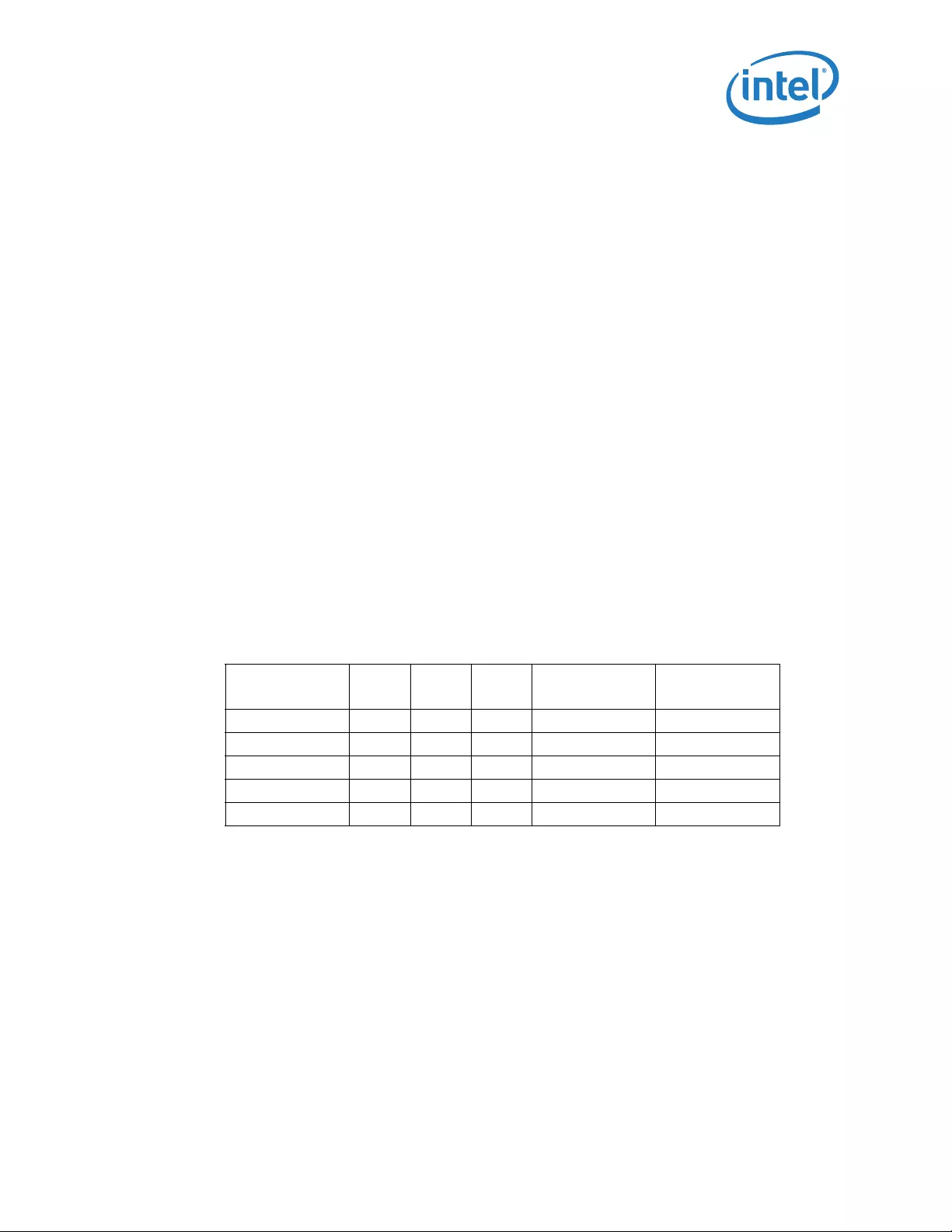
Datasheet 259
Power Management
27.2.1.4 S0i3 - Longer Latency Standby State
S0i3 state extends on the S0i2 state by completely stopping the SoC XOSC. The micro
architectural state of processor and the DRAM content is preserved. The
PMC_SLP_S0iX# signal continues to be asserted by the SoC.
27.2.1.5 S4 - Suspend to Disk (Hibernate)
S4 is a suspend state in which most power planes of the processor are turned off,
except for the suspend and RTC well. In this ACPI state, system context is saved to the
hard disk.
Key features:
•No activity is allowed.
•All power wells are disabled, except for the suspend and RTC well.
27.2.1.6 S5 - Soft Off
From a hardware perspective the S5 state is identical to the S4 state. The difference is
purely software; software does not write system context to hard disk when entering
S5.
The following table shows the differences in the sleeping states with regards to the
processor’s output signals.
NOTE: The processor treats S4 and S5 requests the same. The processor does not have
PMC_SLP_S5#. PMC_SUS_STAT# is required to drive low (asserted) even if core well is left
on because PMC_SUS_STAT# also warns of upcoming reset.
Table 112. SoC Sx-States to SLP_S*#
State S0S4S5 Reset w/o
Power Cycle
Reset w/
Power Cycle
CPU Executing In C0 OFF OFF No OFF
PMC_SLP_S4# HIGH LOW LOW HIGH LOW
S0 Power Rails ON OFF OFF ON OFF
PMC_PLTRST#011 1 1
PMC_SUS_STAT# HIGH LOW LOW HIGH LOW

Power Management
260 Datasheet
27.2.2 System States
Tab l e 11 5 shows the transitions rules among the various states. Note that transitions
among the various states may appear to temporarily transition through intermediate
states. These intermediate transitions and states are not listed in the table.
Table 114. General Power States for System
States/Sub-
states Legacy Name / Description
G0/S0/C0 FULL ON: CPU operating. Individual devices may be shut down to save
power. The different CPU operating levels are defined by Cx states.
G0/S0/Cx Cx State: CPU manages C-state itself.
G0/S0i1 S0i1 State: Low power platform active state. All DRAM and IOSF traffic are
halted. PLL are configured to be off. This state allows MP3 playing using LPE
engine
G0/S0i2 S0i2 State: The SoC clocks and oscillators are parked
G0/S0i3 S0i3 State: All SoC clocks and oscillators are turned off
G1/S4 Suspend-To-Disk (STD): The context of the system is maintained on the
disk. All of the power is shut down except power for the logic to resume.
The S4 and S5 states are treated the same.
G2/S5 Soft-Off: System context is not maintained. All of the power is shut down
except power for the logic to restart. A full boot is required to restart. A full
boot is required when waking.
The S4 and S5 states are treated the same.
G3 Mechanical OFF. System content is not maintained. All power shutdown
except for the RTC. No “Wake” events are possible, because the system
does not have any power. This state occurs if the user removes the
batteries, turns off a mechanical switch, or if the system power supply is at
a level that is insufficient to power the “waking” logic. When system power
returns, transition will depend on the state just prior to the entry to G3.
Table 115. ACPI PM State Transition Rules (Sheet 1 of 2)
Present
State Transition Trigger Next State
G0/S0/C0 IA Code MWAIT or LVL Rd C0/S0/Cx
PM1_CNT.SLP_EN bit set G1/Sx or G2/S5 state (specified by
PM1_CNT.SLP_TYP)
Power Button Override G2/S5
Mechanical Off/Power Failure G3
G0/S0/Cx Cx break events which include: CPU
snoop, MSI, Legacy Interrupt, AONT
timer
G0/S0/C0
Power Button Override G2/S5
System Power Failure G3

Datasheet 261
Power Management
27.2.3 Processor States
27.2.4 Integrated Graphics Display States
G1/S4 Any Enabled Wake Event G0/S0/C0
Power button Override G2/S5
Resume Well Power Failure G3
G2/S5 Any Enabled Wake Event G0/S0/C0
Resume Well Power Failure G3
G3 Power Returns Option to go to S0/C0 (reboot) or G2/S5
(stay off until power button pressed or
other enabled wake event) or G1/S4 (if
system state was S4 prior to the power
failure). Some wake events are
preserved through a power failure.
Table 116. Processor Core/ States Support
State Description
C0 Active mode, processor executing code
C1 AutoHALT state
C1E AutoHALT State with lowest frequency and voltage operating point.
C6 Deep Power Down. Prior to entering the Deep Power Down
Technology (code named C6) State, The core process will flush its
cache and save its core context to a special on die SRAM on a
different power plane. Once Deep Power Down Technology (code
named C6) sequence has completed. The core processor’s voltage
is completely shut off.
C7 Execution cores in this state behave similarly to the C6 state.
Voltage is removed from the system agent domain
Table 117. SoC Graphics Adapter State Control
State Description
D0 Full on, Display active
D3 Power off display
Table 115. ACPI PM State Transition Rules (Sheet 2 of 2)
Present
State Transition Trigger Next State
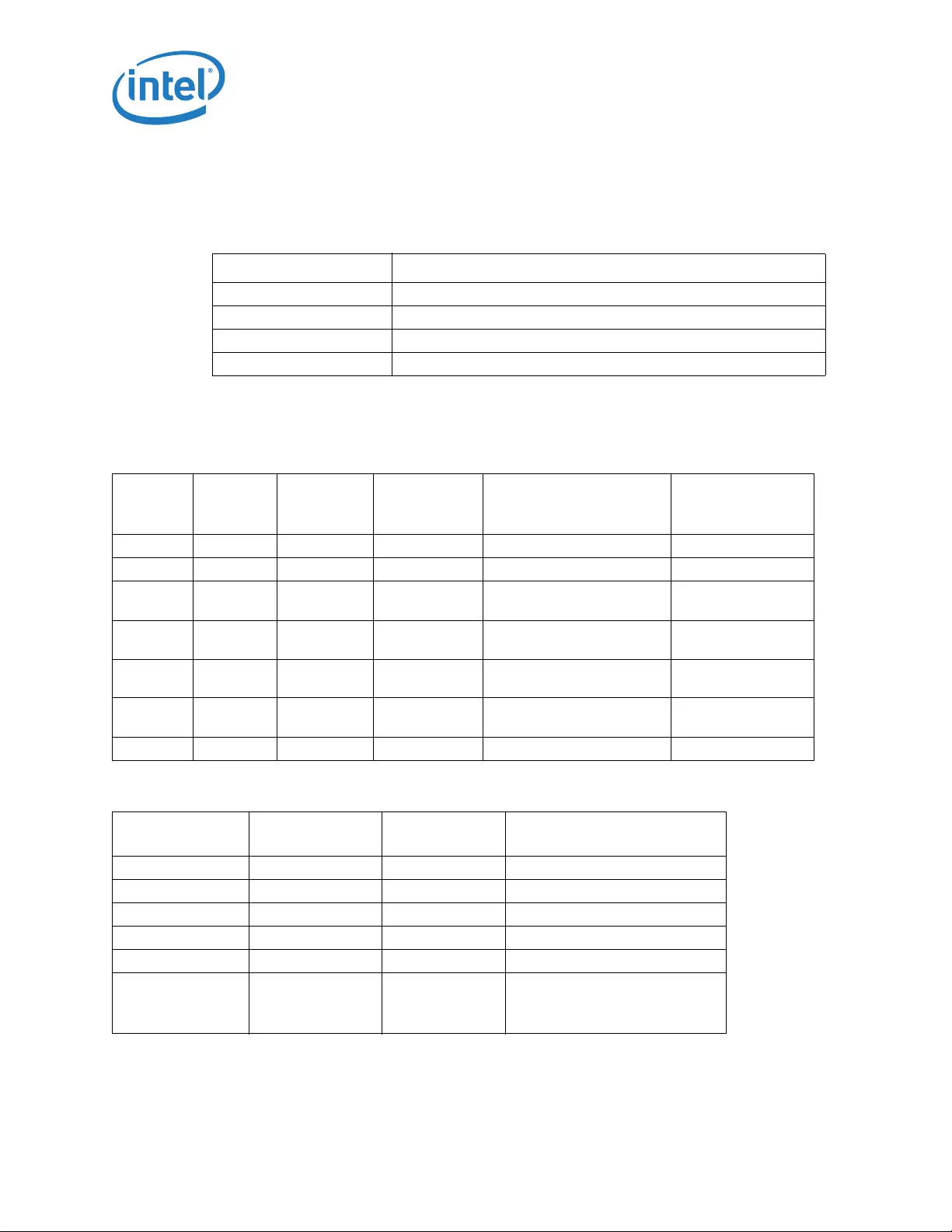
Power Management
262 Datasheet
27.2.5 Integrated Memory Controller States
27.2.6 Interface State Combinations
Table 118. Main Memory States
States Description
Powerup CKE asserted. Active mode.
Precharge Powerdown CKE de-asserted (not self-refresh) with all banks closed.
Active Powerdown CKE de-asserted (not self-refresh) with at least one bank active.
Self-Refresh CKE de-asserted using device self-refresh
Table 119. G, S and C State Combinations
Global
(G) State
Sleep
(S) State
Processor
Core
(C) State
Processor
State System Clocks Description
G0 S0 C0 Full On On Full On
G0 S0 C1/C1E Auto-Halt On Auto-Halt
G0 S0 C6 Deep Power
Down
On Deep Power Down
G0 S0ix C7 Deep Power
Down
On Deep Power Down
G1 S4 Power off Off except RTC & internal
ring OSC
Suspend to Disk
G2 S5 Power off Off except RTC & internal
ring OSC
Soft Off
G3 NA Power Off Power off Hard Off
Table 120. D, S and C State Combinations
Graphics Adapter
(D) State Sleep (S) State (C) State Description
D0 S0 C0 Full On, Displaying
D0 S0 C1 Auto-Halt, Displaying
D0 S0 C6 Deep Sleep, Display Off
D0 S0ix C7 Deep Sleep, Display Off
D3 S0/S0ix Any Not Displaying
D3 S4 Not Displaying
Suspend to disk
Core power off

Datasheet 263
Power Management
27.3 Processor Core Power Management
While executing code, Enhanced Intel SpeedStep® Technology optimizes the
processor’s frequency and core voltage based on workload. Each frequency and voltage
operating point is defined by ACPI as a P-state. When the processor is not executing
code, it is idle. A low-power idle state is defined by ACPI as a C-state. In general, lower
power C-states have longer entry and exit latencies.
27.3.1 Enhanced Intel SpeedStep® Technology
The following are the key features of Enhanced Intel SpeedStep® Tech nolo gy:
•Applicable to Processor Core Voltage and Graphic Core Voltage
•Multiple frequency and voltage points for optimal performance and power
efficiency. These operating points are known as P-states.
•Frequency selection is software controlled by writing to processor MSRs. The
voltage is optimized based on the selected frequency:
— If the target frequency is higher than the current frequency, Core_VCC_S0ix is
ramped up slowly to an optimized voltage. This voltage is signaled by the SVID
signals to the voltage regulator. Once the voltage is established, the PLL locks
on to the target frequency.
— If the target frequency is lower than the current frequency, the PLL locks to the
target frequency, then transitions to a lower voltage by signaling the target
voltage on the SVID signals.
•The processor controls voltage ramp rates by requesting appropriate ramp rates
from an external SVID controller.
•Because there is low transition latency between P-states, a significant number of
transitions per second are possible.
•Thermal Monitor mode.
— Refer to Chapter 28, “Thermal Management”
27.3.2 Dynamic Cache Sizing
Dynamic Cache Sizing allows the processor to flush and disable a programmable
number of L2 cache ways upon each Deeper Sleep entry under the following condition:
•The C0 timer that tracks continuous residency in the Normal state, has not expired.
This timer is cleared during the first entry into Deeper Sleep to allow consecutive
Deeper Sleep entries to shrink the L2 cache as needed.
•The predefined L2 shrink threshold is triggered.
The number of L2 cache ways disabled upon each Deeper Sleep entry is configured in
the BBL_CR_CTL3 MSR. The C0 timer is referenced through the
CLOCK_CORE_CST_CONTROL_STT MSR. The shrink threshold under which the L2

Power Management
264 Datasheet
cache size is reduced is configured in the PMG_CST_CONFIG_CONTROL MSR. If the
ratio is zero, then the ratio will not be taken into account for Dynamic Cache Sizing
decisions.
27.3.3 Low-Power Idle States
When the processor core is idle, low-power idle states (C-states) are used to save
power. More power savings actions are taken for numerically higher C-state. However,
higher C-states have longer exit and entry latencies. Resolution of C-state occur at the
thread, processor core, and processor core level.
27.3.3.1 Clock Control and Low-Power States
The processor core supports low power states at core level. The central power
management logic ensures the entire processor core enters the new common processor
core power state. For processor core power states higher than C1, this would be done
by initiating a P_LVLx (P_LVL4 & P_LVL6) I/O read to all of the cores. States that
require external intervention and typically map back to processor core power states.
States for processor core include Normal (C0, C1).
The processor core implements two software interfaces for requesting low power
states: MWAIT instruction extensions with sub-state specifies and P_LVLx reads to the
ACPI P_BLK register block mapped in the processor core’s I/O address space. The
P_LVLx I/O reads are converted to equivalent MWAIT C-state requests inside the
processor core and do not directly result in I/O reads on the processor core bus. The
monitor address does not need to be setup before using the P_LVLx I/O read interface.
The sub-state specifications used for each P_LVLx read can be configured in a software
programmable MSR by BIOS.
The Cx state ends due to a break event. Based on the break event, the processor
returns the system to C0. The following are examples of such break events:
•Any unmasked interrupt goes active
•Any internal event that will cause an NMI or SMI_B
•CPU Pending Break Event (PBE_B)
•MSI
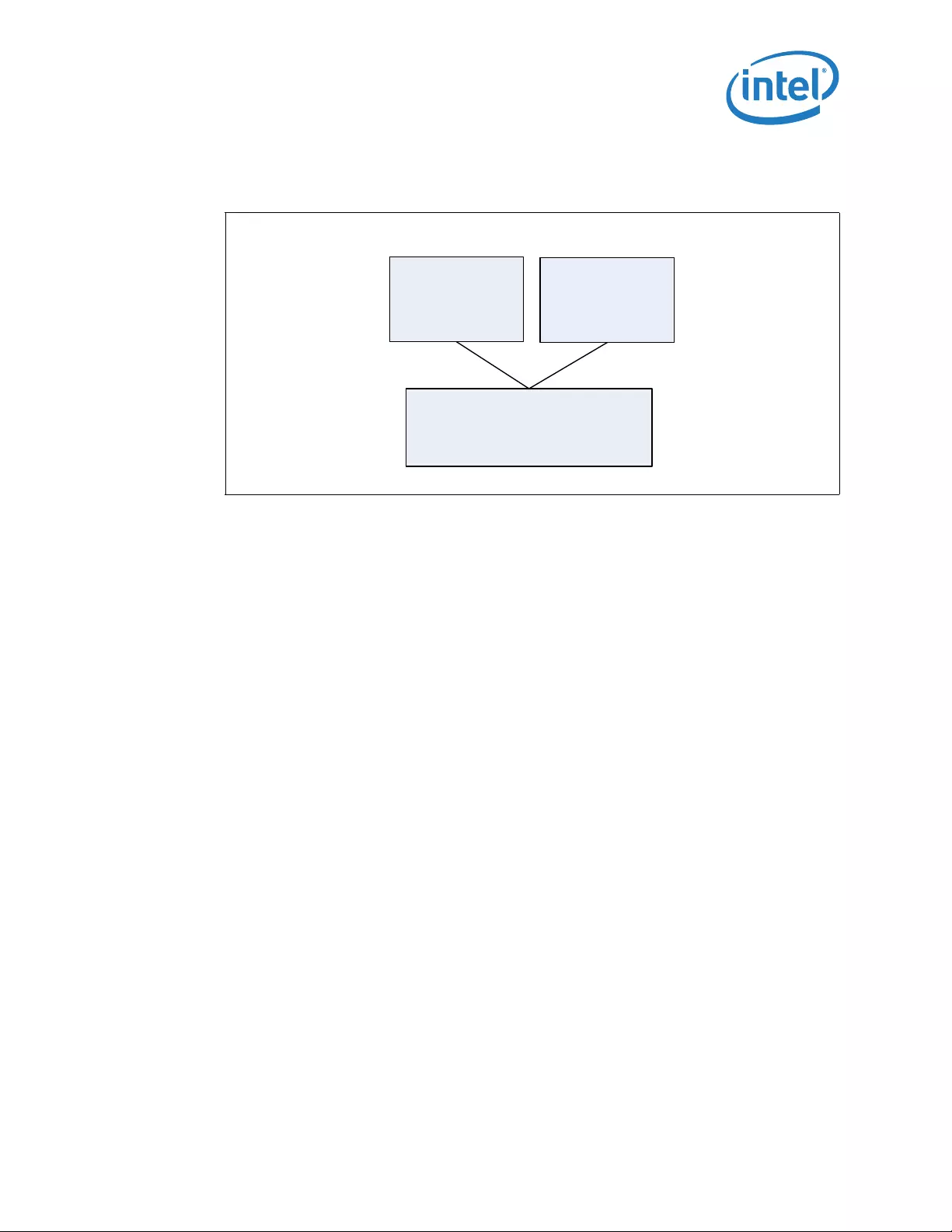
Datasheet 265
Power Management
27.3.4 Processor Core C-States Description
The following state descriptions assume that both threads are in common low power
state.
27.3.4.1 Core C0 State
The normal operating state of a core where code is being executed.
27.3.4.2 Core C1/C1E State
C1/C1E is a low power state entered when a core execute a HLT or MWAIT(C1/C1E)
instruction.
A System Management Interrupt (SMI) handler returns execution to either Normal
state or the C1/C1E state.
While a core is in C1/C1E state, it processes bus snoops and snoops from other
threads. For more information on C1E, see “Package C1/C1E”.
27.3.4.3 Core C6 State
Individual core can enter the C6 state by initiating a P_LVL3 I/O read or an MWAIT(C6)
instruction. Before entering core C6, the core will save its architectural state to a
dedicated SRAM. Once complete, a core will have its voltage reduced to zero volts.
During exit, the core is powered on and its architectural state is restored.
There are various types of C-state:
•C6NS implies only the core should be powergated, but the L2 cache contents
should be retained.
Figure 39. Idle Power Management Breakdown of the Processor Cores
Processor Package State
Core 1 State
Core 0 State

Power Management
266 Datasheet
•C6IS implies the core should be powergated, and the L2 cache can be incrementally
flushed to get some additional power savings.
•C6FS implies the core should be powergates, and the L2 cache can be fully flushed
to get even more power savings.
27.3.4.4 Core C7 State
Individual core can enter the C7 state by initiating a P_LVL7 I/O read or an MWAIT(C7)
instruction. The core C7 state exhibits the same behavior as core C6 state, but in
addition gives permission to the internal Power Management logic to enter a package
S0ix state if possible.
27.3.5 Package C-States
The processor supports C0, C1/C1E, C6 and C7 power states. The following is a
summary of the general rules for package C-state entry. These apply to all package C-
states unless specified otherwise:
•Package C-state request is determined by the lowest numerical core C-state
amongst all cores.
•A package C-state is automatically resolved by the processor depending on the
core idle power states and the status of the platform components.
•Each core can be at a lower idle power state than the package if the platform does
not grant the processor permission to enter a requested package C-state.
•The platform may allow additional power savings to be realized in the processor.
•For package C-states, the processor is not required to enter C0 before entering any
other C-state.
•Entry in to a package C-state may be subject to auto-demotion - that is the
processor may keep the package in a shallower package C-state then requested by
the OS if the processor determines via heuristics that the shallower C-state results
in better power/performance.
The processor exits a package C-state when a break event is detected. Depending on
the type of break event, the processor does the following:
•If a core break event is received, the target core is activated and the break event
message is forwarded to the target core.
— If the break event is not masked, the target core enters the core C0 state and
the processor enters package C0.
— If the break event is masked, the processor attempts to re-enter its previous
package state.
•If the break event was due to a memory access or snoop request.
— But the platform did not request to keep the processor in a higher package C-
state, the package returns to its previous C-state.
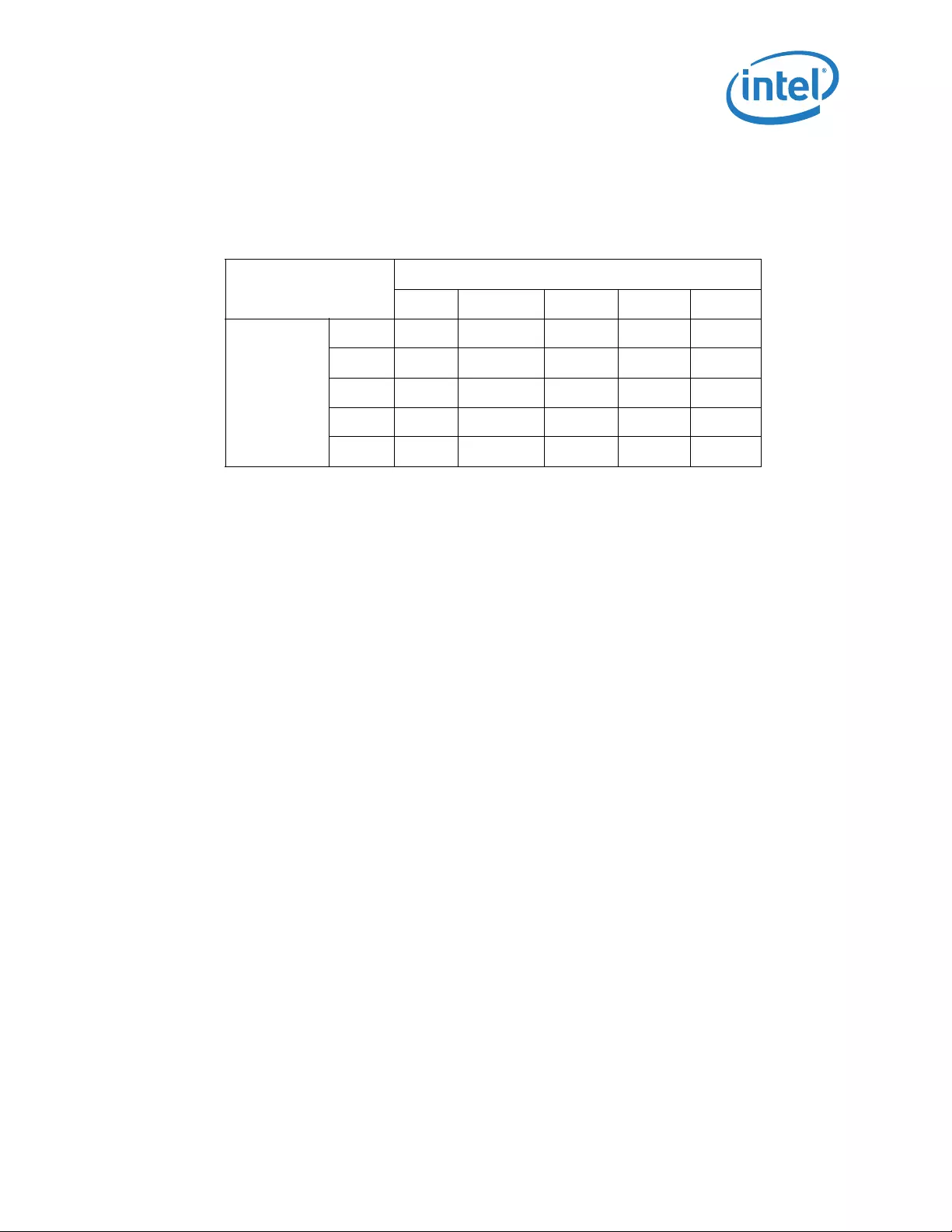
Datasheet 267
Power Management
— And the platform requests a higher power C-state, the memory access or snoop
request is serviced and the package remains in the higher power C-state.
NOTES:
1. If enabled, the package C-state will be C1E if all actives cores have resolved a core C1 state or
higher.
2. C6C is C6-Conditional where the L2 cache is still powered.
3. 2 Cores of the SoC will make up one module.
4. C7 not supported.
27.3.5.1 Package C0
The normal operating state for the processor. The processor remains in the normal
state when at least one of its cores is in the C0 state or when the platform has not
granted permission to the processor to go into a low power state. Individual cores may
be in lower power idle states while the package is in C0.
27.3.5.2 Package C1/C1E
No additional power reduction actions are taken in the package C1 state. However, if
the C1E sub-state is enabled, the processor automatically transitions to the lowest
supported core clock frequency, followed by a reduction in voltage.
The package enters the C1 low power state when:
•At least one core is in the C1 state.
•The other cores are in a C1 or lower power state.
The package enters the C1E state when:
•All cores have directly requested C1E via MWAIT(C1) with a C1E sub-state hint.
•All cores are in a power state lower that C1/C1E but the package low power state is
limited to C1/C1E via the PMG_CST_CONFIG_CONTROL MSR.
•All cores have requested C1 using HLT or MWAIT(C1) and C1E auto-promotion is
enabled in IA32_MISC_ENABLES.
No notification to the system occurs upon entry to C1/C1E.
Table 121. Coordination of Core/Module Power States at the Package Level
Package C-State
Core/Module 1
C0 C1 C6NS C6FS C7
Core/Module 0
C0 C0 C11C0 C0 C0
C1 C0 C11C11C11C11
C6NS C0 C11C6C C6C C6C
C6FS C0 C11C6C C6 C6
C7 C0 C11C6C C6 C7

Power Management
268 Datasheet
27.3.5.3 Package C6 State
A processor enters the package C6 low power state when:
•At least one core is in the C6 state.
•The other cores are in a C6 or lower power state, and the processor has been
granted permission by the platform.
•The platform has not granted a request to a package C7 state but has allowed a
package C6 state.
In package C6 state, all cores have saved their architectural state and have had their
core voltages reduced to zero volts.
27.3.5.4 Package C7 State
A processor enters the package C7 low power state when all cores are in the C7 state.
In package C7, the processor will take action to remove power from portions of the
system agent.
Core break events are handled the same way as in package C6.
27.3.6 Graphics Power Management
27.3.6.1 Graphics and video decoder C-State
GFX C-State (GC6) and VED C-state (VC6) are designed to optimize the average power
to the graphics and video decoder engines during times of idleness. GFX C-state is
entered when the graphics engine, has no workload being currently worked on and no
outstanding graphics memory transactions. VED S-state is entered when the video
decoder engine has no workload being currently worked on and no outstanding video
memory transactions. When the idleness condition is met, the processor will power
gate the Graphics and video decoder engines.
27.3.6.2 Intel® Display Power Saving Technology (Intel® DPST)
The Intel DPST technique achieves backlight power savings while maintaining visual
experience. This is accomplished by adaptively enhancing the displayed image while
decreasing the backlight brightness simultaneously. The goal of this technique is to
provide equivalent end-user image quality at a decreased backlight power level.
1. The original (input) image produced by the operating system or application is
analyzed by the Intel DPST subsystem. An interrupt to Intel® DPST software is
generated whenever a meaningful change in the image attributes is detected. (A
meaningful change is when the Intel DPST software algorithm determines that
enough brightness, contrast, or color change has occurred to the displaying images
that the image enhancement and backlight control needs to be altered.)
2. Intel DPST subsystem applies an image-specific enhancement to increase image
contrast, brightness, and other attributes.

Datasheet 269
Power Management
3. A corresponding decrease to the backlight brightness is applied simultaneously to
produce an image with similar user-perceived quality (such as brightness) as the
original image. Intel DPST 5.0 has improved the software algorithms and has minor
hardware changes to better handle backlight phase-in and ensures the documented
and validated method to interrupt hardware phase-in.
27.3.6.3 Intel® Automatic Display Brightness
The Intel Automatic Display Brightness feature dynamically adjusts the backlight
brightness based upon the current ambient light environment. This feature requires an
additional sensor to be on the panel front. The sensor receives the changing ambient
light conditions and sends the interrupts to the Intel Graphics driver. As per the change
in Lux, (current ambient light illuminance), the new backlight setting can be adjusted
through BLC. The converse applies for a brightly lit environment. Intel Automatic
Display Brightness increases the back light setting.
27.3.6.4 Intel® Seamless Display Refresh Rate Switching Technology (Intel®
SDRRS Technology)
When a Local Flat Panel (LFP) supports multiple refresh rates, the Intel® Display
Refresh Rate Switching power conservation feature can be enabled. The higher refresh
rate will be used when on plugged in power or when the end user has not selected/
enabled this feature. The graphics software will automatically switch to a lower refresh
rate for maximum battery life when the design application is on battery power and
when the user has selected/enabled this feature.
There are two distinct implementations of Intel SDRRS—static and seamless. The static
Intel SDRRS method uses a mode change to assign the new refresh rate. The seamless
Intel SDRRS method is able to accomplish the refresh rate assignment without a mode
change and therefore does not experience some of the visual artifacts associated with
the mode change (SetMode) method.
27.4 Memory Controller Power Management
The main memory is power managed during normal operation and in low-power ACPI
Cx states.
27.4.1 Disabling Unused System Memory Outputs
Any system memory (SM) interface signal that goes to a memory module connector in
which it is not connected to any actual memory devices (such as DIMM connector is
unpopulated, or is single-sided) is tri-stated. The benefits of disabling unused SM
signals are:
•Reduced power consumption.
•Reduced possible overshoot/undershoot signal quality issues seen by the processor
I/O buffer receivers caused by reflections from potentially un-terminated
transmission lines.

Power Management
270 Datasheet
When a given rank is not populated, the corresponding chip select and CKE signals are
not driven.
At reset, all rows must be assumed to be populated, until it can be proven that they are
not populated. This is due to the fact that when CKE is tristated with an SO-DIMM
present, the DIMM is not guaranteed to maintain data integrity.
SCKE tri-state should be enabled by BIOS where appropriate, since at reset all rows
must be assumed to be populated.
27.4.2 DRAM Power Management and Initialization
The processor implements extensive support for power management on the SDRAM
interface. There are four SDRAM operations associated with the Clock Enable (CKE)
signals, which the SDRAM controller supports. The processor drives four CKE pins to
perform these operations.
27.4.2.1 Initialization Role of CKE
During power-up, CKE is the only input to the SDRAM that is recognized (other than the
DDR3 reset pin) once power is applied. It must be driven LOW by the DDR controller to
make sure the SDRAM components float DQ and DQS during power- up.
CKE signals remain LOW (while any reset is active) until the BIOS writes to a
configuration register. Using this method, CKE is guaranteed to remain inactive for
much longer than the specified 200 micro-seconds after power and clocks to SDRAM
devices are stable.
27.4.2.2 Conditional Self-Refresh
Intel Rapid Memory Power Management (Intel RMPM) conditionally places memory into
self-refresh in the package C3 and C6 low-power states. RMPM functionality depends on
graphics/display state (relevant only when internal graphics is being used), as well as
memory traffic patterns generated by other connected I/O devices.
When entering the Suspend-to-RAM (STR) state, the processor core flushes pending
cycles and then places all SDRAM ranks into self refresh. In STR, the CKE signals
remain LOW so the SDRAM devices perform self-refresh.
The target behavior is to enter self-refresh for the package C3 and C6 states as long as
there are no memory requests to service.
27.4.2.3 Dynamic Power Down Operation
Dynamic power-down of memory is employed during normal operation. Based on idle
conditions, a given memory rank may be powered down. The IMC implements
aggressive CKE control to dynamically put the DRAM devices in a power down state.The
processor core controller can be configured to put the devices in active power down
(CKE deassertion with open pages) or precharge power down (CKE deassertion with all

Datasheet 271
Power Management
pages closed). Precharge power down provides greater power savings but has a bigger
performance impact, since all pages will first be closed before putting the devices in
power down mode.
If dynamic power-down is enabled, all ranks are powered up before doing a refresh
cycle and all ranks are powered down at the end of refresh.
27.4.2.4 DRAM I/O Power Management
Unused signals should be disabled to save power and reduce electromagnetic
interference. This includes all signals associated with an unused memory channel.
Clocks can be controlled on a per SO-DIMM basis. Exceptions are made for per SO-
DIMM control signals such as CS#, CKE, and ODT for unpopulated SO-DIMM slots.
The I/O buffer for an unused signal should be tri-stated (output driver disabled), the
input receiver (differential sense-amp) should be disabled, and any DLL circuitry
related ONLY to unused signals should be disabled. The input path must be gated to
prevent spurious results due to noise on the unused signals (typically handled
automatically when input receiver is disabled).
§

Thermal Management
272 Datasheet
28 Thermal Management
The SoC’s thermal management system helps in managing the overall thermal profile
of the system to prevent overheating and system breakdown. The architecture
implements various proven methods of maintaining maximum performance while
remaining within the thermal spec. Throttling mechanisms are used to reduce power
consumption when thermal limits of the device are exceeded and the system is notified
of critical conditions via interrupts or thermal signalling pins. SoC thermal management
differs from legacy implementations primarily by replacing dedicated thermal
management hardware with firmware.
The thermal management features are:
•Five digital thermal sensors (DTS)
•Supports a hardware trip point and four programmable trip points based on the
temperature indicated by thermal sensors.
•Supports different thermal throttling mechanisms.
28.1 Thermal Design Power (TDP)
The processor TDP is the maximum sustained power that should be used for design of
the processor thermal solution. TDP represents an expected maximum sustained power
from realistic applications. TDP may be exceeded for short periods of time or if running
a “power virus” workload. The processor integrates multiple processing and graphics
cores. This may result in differences in the power distribution across the die and must
be considered when designing the thermal solution.
Intel Graphics Dynamic Frequency Technology has the ability of the processor graphics
cores to opportunistically increase frequency and/or voltage above the guaranteed
graphics frequency for the given part. It is invoked opportunistically and automatically
as long as the processor is conforming to its temperature, power delivery, and current
specification limits. When Intel Graphics Dynamic Frequency Technology is enabled:
•Applications are expected to run closer to TDP more often as the processor will
attempt to maximize performance by taking advantage of available TDP headroom
in the processor package.
•The processor may exceed the TDP for short durations to utilize any available
thermal capacitance within the thermal solution. The duration and time of such
operation can be limited by platform runtime configurable registers within the
processor.
•Thermal solutions and platform cooling that are designed to less than thermal
design guidance may experience thermal and performance issues since more
applications will tend to run at or near TDP for significant periods of time.
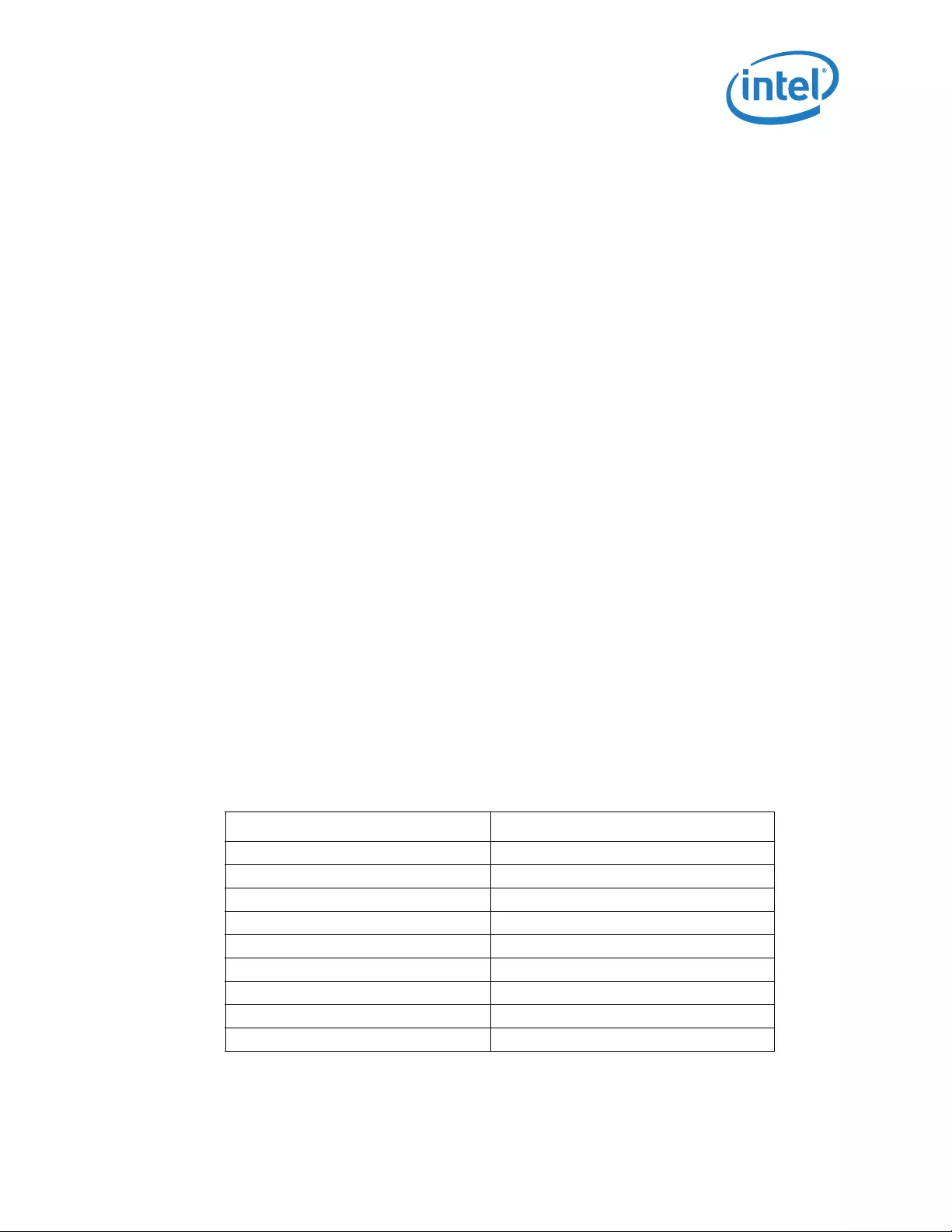
Datasheet 273
Thermal Management
28.2 Scenario Design Power (SDP)
Scenario Design Power (SDP) is a usage-based design specification, and provides
additional guidance for power constrained platforms. SDP is defined at a specific
scenario workload, temperature and frequency.
SDP in SoC can either be set statically or dynamically by changing the POWER_LIMIT
(PL1), it is required that the system cooling capability sustainable such power level.
While the SDP specification is characterized at Tj of 90 °C, the functional limit for the
product reSoCmains at TjMAX. Customers may choose to have the processor invoke TCC
Activation Throttling at 90 °C, but is not required. The processors that have SDP
specified can still exceed SDP under certain workloads such as TDP workloads. TDP
power dissipation is still possible with the intended usage models, and protection
mechanisms to handle levels beyond cooling capabilities are recommended. Intel
recommends using such thermal control mechanisms to manage situations where
power may exceed the thermal design capability.
Note: Although SDP is defined at 90 °C, the thermal throttling set point will default to 100 °C,
and may be changed by the BIOS to 90 °C.
28.3 Thermal Sensors
SoC provides thermal sensors that use ring oscillator based DTS (Digital Thermal
Sensor) to provide more accurate measure of system thermals.
The SoC instantiates multiple digital thermal sensors (one DTS for each processor core,
one for each BIU-Bus Interface Unit, and two for non-core SoC) and sensor grouping
configurations are provided to optionally select the maximum of all sensors for thermal
readout and interrupt generation.
DTS output are adjusted for silicon variations. For a given temperature the output from
DTS is always the same irrespective of silicon.
Table 122. Temperature Reading Based on DTS (If TJ-MAX =90C)
DTS Counter Value Temperature Reading
127 90C
137 80C
147 70C
157 60C
167 50C
177 40C
187 30C
197 20C
207 10C

Thermal Management
274 Datasheet
Note: DTS encoding of 127 always represents TJ-MAX.If TJ-MAX is at 100oC instead of 90oC
then the encoding 127 from DTS indicates 100OC, 137 indicates 90OC and so forth.
Thermal trip points are of two types:
•Hard Trip: The Catastrophic trip points generated by DTS’s based on predefined
temperature setting defined in fuses.
•Programmable Trips: four programmable trip settings (Hot, Aux2, Aux1, Aux0)
that can be set by firmware/software. Default value for Hot Trip is from Fuses.
28.4 Hardware Trips
28.4.1 Catastrophic Trip (THERMTRIP)
Catastrophic trip is generated by DTS whenever the ambient temperature around it
reaches (or extends) beyond the max value (indicated by a fuse). Catastrophic trip will
not trip unless enabled (DTS are enabled only after HFPLL is locked). Within each DTS
Catastrophic trips are flopped to prevent any glitches on Catastrophic signals from
affecting the SoC behavior. Catastrophic trips are reset, once set, during power cycles.
Catastrophic trip signals from all DTS in the SoC are combined to generate THERMTRIP
function which will in turn shut off all the PLL’s and power rails to prevent SoC
breakdown. To prevent glitches from triggering shutdown events, Catastrophic trip’s
from DTS’s are registered before being sent out.
28.5 SoC Programmable Trips
Programmable trips can be programmed to cause different actions when triggered to
reduce temperature of the die.
28.5.1 Aux3 Trip
By default, the Aux 3 (Hot Trip) point is set by fuses but the software/firmware has an
option to set these to a different value.
This trip point is enabled by firmware to monitor and control the system temperature
while the rest of the system is being set up.
28.5.2 Aux2, Aux1, Aux0 Trip
These are fully programmable trip points for general hardware protection mechanisms.
The programmable trips are only active after software/firmware enables the trip.
Note: Unlike Aux3, the Aux[2:0] trip registers are defaulted to zero. To prevent spurious
results, software/firmware should program the trip values prior to enabling the trip
point.

Datasheet 275
Thermal Management
28.6 Platform Trips
28.6.1 PROCHOT#
The platform components use the signal PROCHOT# to indicate thermal events to SoC.
The processor core HOT trip as well as the processor AUX 3 trip are individually sent to
firmware, which internally combines them and drives the appropriate PROCHOT back.
Assertion of the PROCHOT# input will trigger Thermal Monitor 1 or Thermal Monitor 2
throttling mechanisms if they are enabled.
28.7 Thermal Throttling Mechanisms
Thermal throttling mechanisms are implemented to try to reduce temperature by
reducing power consumption in response to a HOT condition. Actions taken as a result
of Thermal Trip indication can be as simple as throttling bandwidth and frequency to as
drastic as shutting down the PLL’s and the entire system. Actions are primarily taken in
to prevent system breakdown and are dependent on the severity of the trips.
28.8 Thermal Status
The firmware captures Thermal Trip events (other than THERMTRIP) in status registers
to trigger thermal actions. Associated with each event is a set of programmable
actions.
§

Electrical Specifications
276 Datasheet
29 Electrical Specifications
This section is categorized into the following sections:
•“Absolute Maximum and Minimum Specifications”
•“Thermal Specifications”
•“Storage Conditions”
•“Voltage and Current Specifications”
•“Crystal Specifications”
•“DC Specifications”
29.1 Absolute Maximum and Minimum Specifications
The absolute maximum and minimum specifications are used to specify conditions
allowable outside of the functional limits of the SoC, but with possible reduced life
expectancy once returned to function limits.
At conditions exceeding absolute specifications, neither functionality nor long term
reliability can be expected. Parts may not function at all once returned to functional
limits.
Although the processor contains protective circuitry to resist damage from Electrostatic
discharge (ESD), precautions should always be taken to avoid high static voltages or
electric fields.
29.2 Thermal Specifications
These specifications define the operating thermal limits of the SoC. Thermal solutions
not designed to provide the following level of thermal capability may affect the long-
term reliability of the processor and system, but more likely result in performance
throttling to ensure silicon junction temperatures within spec.
This section specifies the thermal specifications for all SKUs. Some definitions are
needed, however. “Tj Max” defines the maximum operating silicon junction
temperature. Unless otherwise specified, all specifications in this document assume Tj
Max as the worse case junction temperature. This is the temperature needed to ensure
TDP specifications when running at guaranteed CPU and graphics frequencies. “TDP”
defines the thermal dissipated power for a worse case estimated real world thermal
scenario. “SDP”, or scenario dissipated power, defines the thermal dissipated power
under a lighter workload specific to a user scenario and at a lower thermal junction
temperature than Tj Max.
Note: Turbo frequencies are opportunistically selected when thermal headroom exists.
Automatic throttling along with a proper thermal solution ensure Tj Max will not be
exceeded.
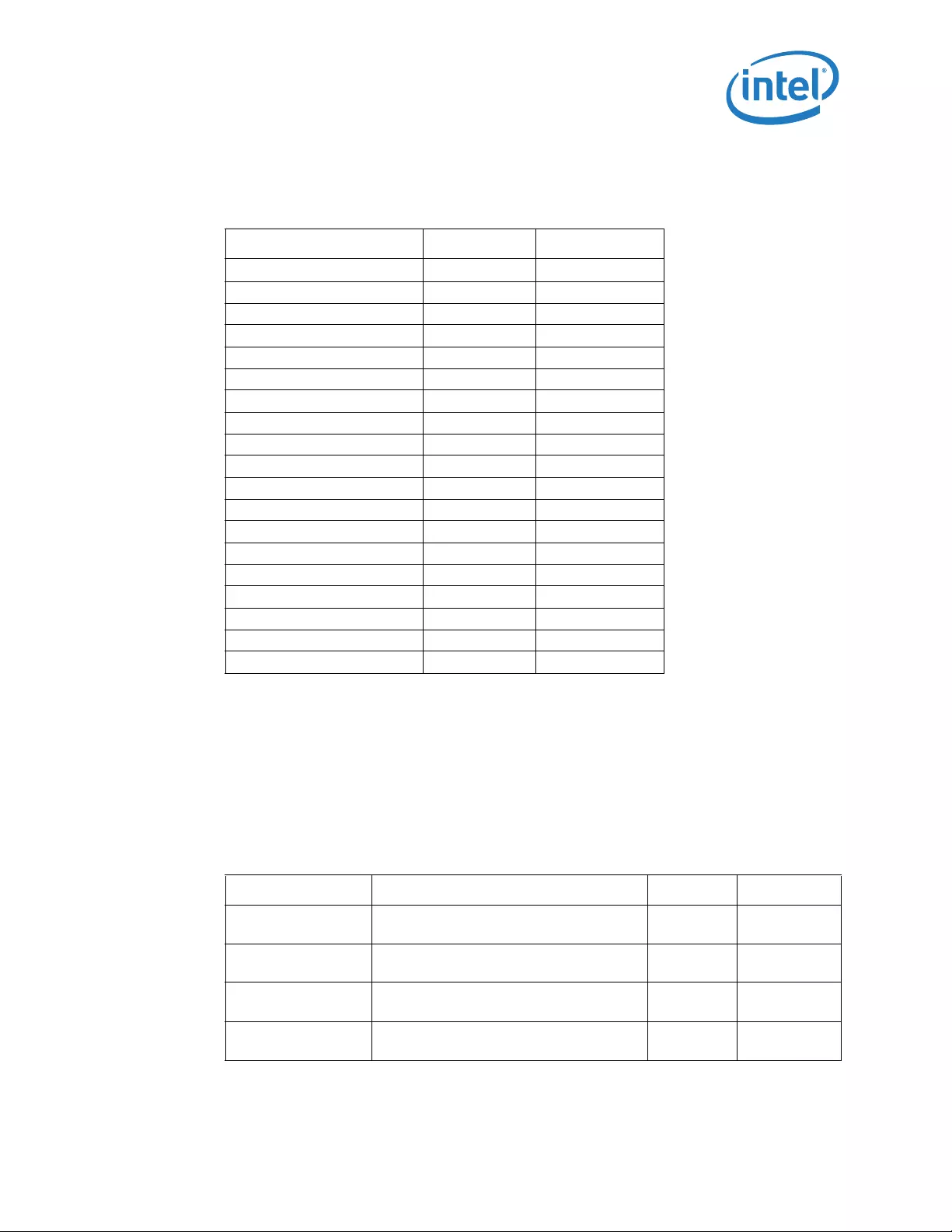
Datasheet 277
Electrical Specifications
29.3 Storage Conditions
This section specifies absolute maximum and minimum storage temperature and
humidity limits for given time durations. Failure to adhere to the specified limits could
result in physical damage to the component. If this is suspected, Intel recommends a
visual inspection to determine possible physical damage to the silicon or surface
components.
Table 123. SoC Thermal Specifications
SKU Tj Max SDP
Z3770 90 °C 2.0W @ 70 °C
Z3740 90 °C 2.0W @ 70 °C
Z3770D 90 °C 2.2W @ 70 °C
Z3740D 90 °C 2.2W @ 70 °C
Z3770 90 °C 2.0W @ 70 °C
Z3740 90 °C 2.0W @ 70 °C
Z3770D 90 °C 2.2W @ 70 °C
Z3740D 90 °C 2.2W @ 70 °C
Z3680 90 °C 2.0W @ 70 °C
Z3680D 90 °C 2.2W @ 70 °C
Z3745 105 °C 2.0W @ 70 °C
Z3745D 105 °C 2.2W @ 70 °C
Z3795 105 °C 2.0W @ 70 °C
Z3775 105 °C 2.0W @ 70 °C
Z3775D 105 °C 2.2W @ 70 °C
Z3735D2105 °C 2.2W @ 70 °C
Z3735E2105 °C 2.2W @ 70 °C
Z3735F3105 °C 2.2W @ 70 °C
Z3735G3105 °C 2.2W @ 70 °C
Table 124. Storage Conditions Prior to Board Attach
Symbol Parameter Min Max
Tabsolute storage Device storage temperature when
exceeded for any length of time.
-25 °C 125 °C
Tshort term storage The ambient storage temperature and
time for up to 72 hours.
-25 °C 85 °C
Tsustained storage The ambient storage temperature and
time for up to 30 months.
-5 °C 40 °C
RHsustained storage The maximum device storage relative
humidity for up to 30 months.
60% @ 24 °C

Electrical Specifications
278 Datasheet
NOTES:
•Specified temperatures are not to exceed values based on data collected.
Exceptions for surface mount re-flow are specified by the applicable JEDEC
standard. Non-adherence may affect processor reliability.
•Component product device storage temperature qualification methods may follow
JESD22-A119 (low temperature) and JESD22-A103 (high temperature) standards
when applicable for volatile memory.
•Component stress testing is conducted in conformance with JESD22-A104.
•The JEDEC J-JSTD-020 moisture level rating and associated handling practices
apply to all moisture sensitive devices removed from the moisture barrier bag.
29.3.1 Post Board-Attach
The storage condition limits for the component once attached to the application board
are not specified. Intel does not conduct component-level certification assessments
post board-attach given the multitude of attach methods, socket types, and board
types used by customers.
Provided as general guidance only, board-level Intel-branded products are specified
and certified to meet the following temperature and humidity limits:
•Non-Operating Temperature Limit: -40 °C to 70 °C
•Humidity: 50% to 90%, non-condensing with a maximum wet-bulb of 28 °C
29.4 Voltage and Current Specifications
The I/O buffer supply voltages are specified at the SoC package balls. The tolerances
shown in Tab le 1 3 6 are inclusive of all noise from DC up to 20 MHz. The voltage rails
should be measured with a bandwidth limited oscilloscope with a roll-off of 3 dB/decade
above 20 MHz under all operating conditions. Tab l e 1 44 indicates which supplies are
connected directly to a voltage regulator or to a filtered voltage rail. For voltage rails
that are connected to a filter, they should be measured at the input of the filter. If the
recommended platform decoupling guidelines cannot be met, the system designer will
have to make trade-offs between the voltage regulator out DC tolerance and the
decoupling performances of the capacitor network to stay within the voltage tolerances
listed below.
Note: The SoC is a pre-launch product. Voltage and current specifications are subject to
change.

Datasheet 279
Electrical Specifications
Table 125. Intel® Atom™ Processor Z3600/Z3700 Series Type 4 SoC Power Rail DC Specs
and Max Current
Platform Rail Voltage
Tolerances Max Icc
V1P0A
- UNCORE_V1P0_G3
- USB3_V1P0_G3
1.0 V
DC: ±2%
AC: ±3%
225 mA
V1P2A
- USB_HSIC_V1P24_G3
(Can connect to V1P0A when USB HSIC isn’t
used)
1.20 V
DC: ±3%
AC: ±2%
35 mA
V1P8A
- PCU_V1P8_G3
- PMC_V1P8_G3
- UNCORE_V1P8_G3
- USB_V1P8_G3
- USB_ULPI_V1P8_G3
1.8 V
DC: ±3%
AC: ±2%
70 mA
V3P3A
- PCU_V3P3_G3
3.3 V
DC: ±2%
AC: ±3%
45 mA
V1P0Sx
- DRAM_V1P0_S0iX
- DDI_V1P0_S0iX
- UNCORE_V1P0_S0iX
1.0 V
DC: ±2%
AC: ±3%
900 mA
V1P24Sx (VSFR)
- DRAM_V1P24_S0ix_F1
- UNCORE_V1P24_S0ix_F[6:1]
1.24 V
DC: ±3%
AC: ±2%
225 mA
V1P0S
- UNCORE_V1P0_S4
- USB_V1P0_S4
- USB3DEV_V1P0_S4
- GPIO_V1P0_S4
- SVID_V1P0_S4
1.0 V
DC: ±2%
AC: ±3%
175 mA
V1P05S
- CORE_V1P05_S4
1.05 V
DC: ±2%
AC: ±3%
600 mA
V1P24S
- MIPI_V1P24_S4 (may be grounded if CSI &
DSI not used)
- ICLK_V1P24_S4_F[2:1]
1.24 V
DC: ±2%
AC: ±3%
45 mA
V1Pxxx 1.35 V
DC: ±3%
AC: ±2%
400 mA

Electrical Specifications
280 Datasheet
Note: RTC_VCC average current draw (G3) is specified at 27°C under battery conditions.
V1P8S
- LPE_V1P8_S4
- MIPI_V1P8_S4
- UNCORE_V1P8_S4
- SIO_V1P8_S4
1.8 V
DC: ±3%
AC: ±2%
10 mA
V1P8V3P3S (VSDIO,VLPC)
- SD3_V1P8V3P3_S4
- LPC_V1P8V3P3_S4
1.8 V/3.3 V
DC: ±2%
AC: ±3%
5 mA
V3P3S
- USB_V3P3_S0iX(?)
3.3 V
DC: ±2%
AC: ±3%
25 mA
VCC
- CORE_VCC_S4 Refer Table 127 6.5 A
VNN
- UNCORE_VNN_S4 Refer Table 127 5 A
VDD
- DRAM_VDD_S4
1.24 V
DC: ±2%
AC: ±3%
600 mA
VRTC
- RTC_VCC
G3: 2-3 V at battery
Otherwise V3P3A (pre diode
drop)
100 uA
(6 uA Avg.)
(see note)
Table 125. Intel® Atom™ Processor Z3600/Z3700 Series Type 4 SoC Power Rail DC Specs
and Max Current
Platform Rail Voltage
Tolerances Max Icc
Table 126. Intel® Atom™ Processor Z3700 Series Type 3 SoC Power Rail DC Specs and
Max Current
Platform Rail Voltage
Tolerances Max Icc
V1P0A
- UNCORE_V1P0_G3
1.0 V
DC: ±2%
AC: ±6%
225 mA
V1P8A
- PCU_V1P8_G3
- PMC_V1P8_G3
- UNCORE_V1P8_G3
1.8 V
DC: ±2%
AC: ±6%
70 mA
V3P3A
- PCU_V3P3_G3
3.3 V
DC: ±2%
AC: ±6%
45 mA

Datasheet 281
Electrical Specifications
V1P0Sx
- DRAM_V1P0_S0iX
- DDI_V1P0_S0iX
- UNCORE_V1P0_S0iX
1.0 V
DC: ±2%
AC: ±6%
900 mA
V1P24Sx (VSFR)
- DRAM_V1P24_S0ix_F1
- UNCORE_V1P24_S0ix_F[1,4,5]
1.24 V
DC: ±2.5%
AC: ±6%
225 mA
V1P0S
- UNCORE_V1P0_S4
- USB_V1P0_S4
- GPIO_V1P0_S4
1.0 V
DC: ±2%
AC: ±6%
175 mA
V1P05S
- CORE_V1P05_S4
1.0 V
DC: ±2%
AC: ±6%
600 mA
V1P24S
- ICLK_V1P24_S4_F[2:1]
1.24 V
DC: ±2%
AC: ±6%
45 mA
V1Pxxx 1.35 V
DC: ±2%
AC: ±6%
400 mA
V1P8S
- LPE_V1P8_S4
- MIPI_V1P8_S4
- UNCORE_V1P8_S4
1.8 V
DC: ±2%
AC: ±6%
10 mA
V1P8V3P3S (VSDIO,VLPC)
- SD3_V1P8V3P3_S4
- LPC_V1P8V3P3_S4
1.8 V/3.3 V
DC: ±2%
AC: ±6%
5 mA
V3P3S
- USB_V3P3_S0iX
3.3 V
DC: ±2%
AC: ±6%
25 mA
VCC
- CORE_VCC_S0iX
Refer Ta bl e 1 2 7 3 A
Table 126. Intel® Atom™ Processor Z3700 Series Type 3 SoC Power Rail DC Specs and
Max Current
Platform Rail Voltage
Tolerances Max Icc
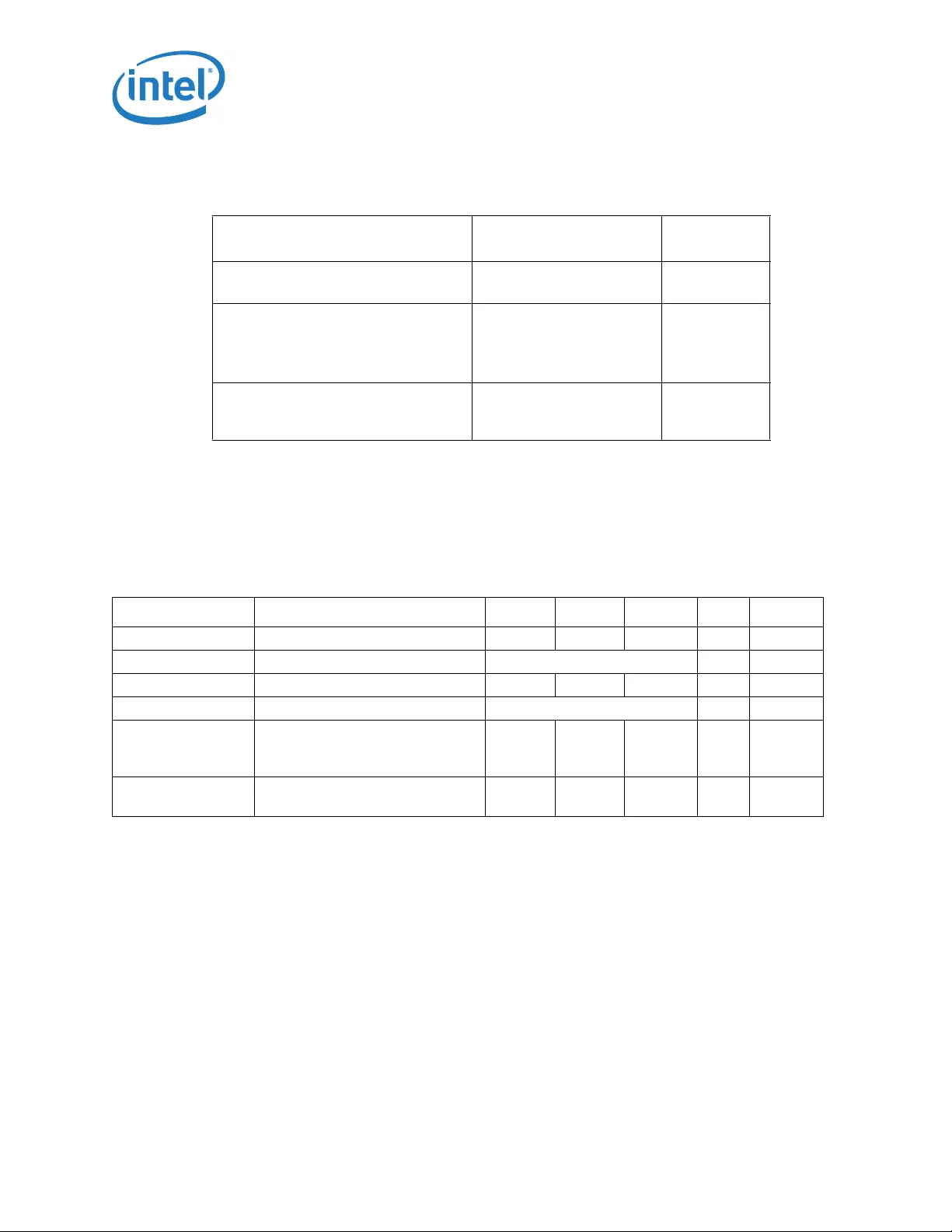
Electrical Specifications
282 Datasheet
29.4.1 VCC and VNN Voltage Specifications
Tab l e 12 7 and Tab l e 1 36 list the DC specifications for the SoC power rails. They are
valid only while meeting specifications for junction temperature, clock frequency, and
input voltages. Care should be taken to read all notes associated with each parameter.
NOTES:
1. Unless otherwise noted, all specifications in this table are based on estimates and simulations or
empirical data. These specifications will be updated with characterized data from silicon measurements
at a later date.
2. Each SoC is programmed with voltage identification value (VID), which is set at manufacturing and
cannot be altered. Individual VID values are calibrated during manufacturing such that two SoCs at the
same frequency may have different settings within the VID range. Note this differs from the VID
employed by the SoC during a power management event.
3. These are pre-silicon estimates and are subject to change.
4. Refer the VR12/IMVP7 Pulse Width Modulation specification for additional details. Either value is ok.
29.4.2 Voltage Identification (VID)
The VID specifications for the SoC CORE_VCC_S0iX and UNCORE_VNN_S4 are defined
by the IMVP7 Pulse Width Modulation (PWM) Specification. Tab le 1 2 8 specifies the
voltage level corresponding to the eight bit VID value transmitted over serial VID
VNN
- UNCORE_VNN_S4
Refer Table 127 5 A
VDD
- DRAM_VDD_S4
1.24 V
DC: ±2%
AC: ±6%
600 mA
VRTC
- RTC_VCC
G3: 2-3 V at battery
Otherwise V3P3A (pre diode
drop)
100 uA
(6 uA Avg.)
Table 126. Intel® Atom™ Processor Z3700 Series Type 3 SoC Power Rail DC Specs and
Max Current
Platform Rail Voltage
Tolerances Max Icc
Table 127. VCC and VNN DC Voltage Specifications
Symbol Parameter Min Typ Max Unit Note
CORE_VCC VID Core VID Target Range 0.40 1.14 V
CORE_VCC_S0iX VCC for SoC Core Refer VCC VID V 2, 3
UNCORE_VNN VID Uncore VID Target Range 0.50 1.05 V
UNCORE_VNN_S4 VNN for SoC Uncore Refer VNN VID V 2, 3
CORE_VCC/
UNCORE_VNN
VBOOT
Default target VCC/VNN voltage for
initial power up.
1.0 or
1.1
V4
VCC/VNN Tolerance Tolerance of VCC/VNN voltage at
VID target.
-5 5 %

Datasheet 283
Electrical Specifications
(SVID) interface per IMVP7 specification. A ‘1’ in this table refers to a high voltage level
and a ‘0’ refers to a low voltage level. If the voltage regulation circuit cannot supply the
voltage that is requested, the voltage regulator must disable itself. The SVID signals
are CMOS push/pull drivers. Refer to Table 153 for the DC specifications for these
signals. The VID codes will change due to performance, temperature and/or current
load changes in order to minimize the power of the part. A voltage range is provided in
Ta b l e 1 2 7 . The specifications are set so that one voltage regulator can operate with all
supported frequencies.
Individual SoC VID values may be set during manufacturing so that two devices at the
same core frequency may have different default VID settings. This is shown in the VID
range values in Tabl e 1 2 7. The SoC provides the ability to operate while transitioning to
an adjacent VID and its associated voltage. This will represent a DC shift in the
loadline.
Note: Table below lists all voltages possible per IMVP7 specification. Not all voltages are valid
on actual SKUs.
Table 128. IMVP7.0 Voltage Identification Reference (Sheet 1 of 8)
VID7 VID6 VID5 VID4 VID3 VID2 VID1 VID0 Hex
bit 1
Hex
bit 0 VCC (V)
0 0 0 0 0 0 0 0 0 0 0.00000
0 0 0 0 0 0 0 1 0 1 0.25000
0 0 0 0 0 0 1 0 0 2 0.25500
0 0 0 0 0 0 1 1 0 3 0.26000
0 0 0 0 0 1 0 0 0 4 0.26500
0 0 0 0 0 1 0 1 0 5 0.27000
0 0 0 0 0 1 1 0 0 6 0.27500
0 0 0 0 0 1 1 1 0 7 0.28000
0 0 0 0 1 0 0 0 0 8 0.28500
0 0 0 0 1 0 0 1 0 9 0.29000
0 0 0 0 1 0 1 0 0 A 0.29500
0 0 0 0 1 0 1 1 0 B 0.30000
0 0 0 0 1 1 0 0 0 C 0.30500
0 0 0 0 1 1 0 1 0 D 0.31000
0 0 0 0 1 1 1 0 0 E 0.31500
0 0 0 0 1 1 1 1 0 F 0.32000
0 0 0 1 0 0 0 0 1 0 0.32500
0 0 0 1 0 0 0 1 1 1 0.33000
0 0 0 1 0 0 1 0 1 2 0.33500
0 0 0 1 0 0 1 1 1 3 0.34000
0 0 0 1 0 1 0 0 1 4 0.34500

Electrical Specifications
284 Datasheet
0 0 0 1 0 1 0 1 1 5 0.35000
0 0 0 1 0 1 1 0 1 6 0.35500
0 0 0 1 0 1 1 1 1 7 0.36000
0 0 0 1 1 0 0 0 1 8 0.36500
0 0 0 1 1 0 0 1 1 9 0.37000
0 0 0 1 1 0 1 0 1 A 0.37500
0 0 0 1 1 0 1 1 1 B 0.38000
0 0 0 1 1 1 0 0 1 C 0.38500
0 0 0 1 1 1 0 1 1 D 0.39000
0 0 0 1 1 1 1 0 1 E 0.39500
0 0 0 1 1 1 1 1 1 F 0.40000
0 0 1 0 0 0 0 0 2 0 0.40500
0 0 1 0 0 0 0 1 2 1 0.41000
0 0 1 0 0 0 1 0 2 2 0.41500
0 0 1 0 0 0 1 1 2 3 0.42000
0 0 1 0 0 1 0 0 2 4 0.42500
0 0 1 0 0 1 0 1 2 5 0.43000
0 0 1 0 0 1 1 0 2 6 0.43500
0 0 1 0 0 1 1 1 2 7 0.44000
0 0 1 0 1 0 0 0 2 8 0.44500
0 0 1 0 1 0 0 1 2 9 0.45000
0 0 1 0 1 0 1 0 2 A 0.45500
0 0 1 0 1 0 1 1 2 B 0.46000
0 0 1 0 1 1 0 0 2 C 0.46500
0 0 1 0 1 1 0 1 2 D 0.47000
0 0 1 0 1 1 1 0 2 E 0.47500
0 0 1 0 1 1 1 1 2 F 0.48000
0 0 1 1 0 0 0 0 3 0 0.48500
0 0 1 1 0 0 0 1 3 1 0.49000
0 0 1 1 0 0 1 0 3 2 0.49500
0 0 1 1 0 0 1 1 3 3 0.50000
0 0 1 1 0 1 0 0 3 4 0.50500
0 0 1 1 0 1 0 1 3 5 0.51000
0 0 1 1 0 1 1 0 3 6 0.51500
0 0 1 1 0 1 1 1 3 7 0.52000
0 0 1 1 1 0 0 0 3 8 0.52500
Table 128. IMVP7.0 Voltage Identification Reference (Sheet 2 of 8)
VID7 VID6 VID5 VID4 VID3 VID2 VID1 VID0 Hex
bit 1
Hex
bit 0 VCC (V)

Datasheet 285
Electrical Specifications
0 0 1 1 1 0 0 1 3 9 0.53000
0 0 1 1 1 0 1 0 3 A 0.53500
0 0 1 1 1 0 1 1 3 B 0.54000
0 0 1 1 1 1 0 0 3 C 0.54500
0 0 1 1 1 1 0 1 3 D 0.55000
0 0 1 1 1 1 1 0 3 E 0.55500
0 0 1 1 1 1 1 1 3 F 0.56000
0 1 0 0 0 0 0 0 4 0 0.56500
0 1 0 0 0 0 0 1 4 1 0.57000
0 1 0 0 0 0 1 0 4 2 0.57500
0 1 0 0 0 0 1 1 4 3 0.58000
0 1 0 0 0 1 0 0 4 4 0.58500
0 1 0 0 0 1 0 1 4 5 0.59000
0 1 0 0 0 1 1 0 4 6 0.59500
0 1 0 0 0 1 1 1 4 7 0.60000
0 1 0 0 1 0 0 0 4 8 0.60500
0 1 0 0 1 0 0 1 4 9 0.61000
0 1 0 0 1 0 1 0 4 A 0.61500
0 1 0 0 1 0 1 1 4 B 0.62000
0 1 0 0 1 1 0 0 4 C 0.62500
0 1 0 0 1 1 0 1 4 D 0.63000
0 1 0 0 1 1 1 0 4 E 0.63500
0 1 0 0 1 1 1 1 4 F 0.64000
0 1 0 1 0 0 0 0 5 0 0.64500
0 1 0 1 0 0 0 1 5 1 0.65000
0 1 0 1 0 0 1 0 5 2 0.65500
0 1 0 1 0 0 1 1 5 3 0.66000
0 1 0 1 0 1 0 0 5 4 0.66500
0 1 0 1 0 1 0 1 5 5 0.67000
0 1 0 1 0 1 1 0 5 6 0.67500
0 1 0 1 0 1 1 1 5 7 0.68000
0 1 0 1 1 0 0 0 5 8 0.68500
0 1 0 1 1 0 0 1 5 9 0.69000
0 1 0 1 1 0 1 0 5 A 0.69500
0 1 0 1 1 0 1 1 5 B 0.70000
0 1 0 1 1 1 0 0 5 C 0.70500
Table 128. IMVP7.0 Voltage Identification Reference (Sheet 3 of 8)
VID7 VID6 VID5 VID4 VID3 VID2 VID1 VID0 Hex
bit 1
Hex
bit 0 VCC (V)

Electrical Specifications
286 Datasheet
0 1 0 1 1 1 0 1 5 D 0.71000
0 1 0 1 1 1 1 0 5 E 0.71500
0 1 0 1 1 1 1 1 5 F 0.72000
0 1 1 0 0 0 0 0 6 0 0.72500
0 1 1 0 0 0 0 1 6 1 0.73000
0 1 1 0 0 0 1 0 6 2 0.73500
0 1 1 0 0 0 1 1 6 3 0.74000
0 1 1 0 0 1 0 0 6 4 0.74500
0 1 1 0 0 1 0 1 6 5 0.75000
0 1 1 0 0 1 1 0 6 6 0.75500
0 1 1 0 0 1 1 1 6 7 0.76000
0 1 1 0 1 0 0 0 6 8 0.76500
0 1 1 0 1 0 0 1 6 9 0.77000
0 1 1 0 1 0 1 0 6 A 0.77500
0 1 1 0 1 0 1 1 6 B 0.78000
0 1 1 0 1 1 0 0 6 C 0.78500
0 1 1 0 1 1 0 1 6 D 0.79000
0 1 1 0 1 1 1 0 6 E 0.79500
0 1 1 0 1 1 1 1 6 F 0.80000
0 1 1 1 0 0 0 0 7 0 0.80500
0 1 1 1 0 0 0 1 7 1 0.81000
0 1 1 1 0 0 1 0 7 2 0.81500
0 1 1 1 0 0 1 1 7 3 0.82000
0 1 1 1 0 1 0 0 7 4 0.82500
0 1 1 1 0 1 0 1 7 5 0.83000
0 1 1 1 0 1 1 0 7 6 0.83500
0 1 1 1 0 1 1 1 7 7 0.84000
0 1 1 1 1 0 0 0 7 8 0.84500
0 1 1 1 1 0 0 1 7 9 0.85000
0 1 1 1 1 0 1 0 7 A 0.85500
0 1 1 1 1 0 1 1 7 B 0.86000
0 1 1 1 1 1 0 0 7 C 0.86500
0 1 1 1 1 1 0 1 7 D 0.87000
0 1 1 1 1 1 1 0 7 E 0.87500
0 1 1 1 1 1 1 1 7 F 0.88000
1 0 0 1 0 0 0 0 8 0 0.88500
Table 128. IMVP7.0 Voltage Identification Reference (Sheet 4 of 8)
VID7 VID6 VID5 VID4 VID3 VID2 VID1 VID0 Hex
bit 1
Hex
bit 0 VCC (V)

Datasheet 287
Electrical Specifications
1 0 0 1 0 0 0 1 8 1 0.89000
1 0 0 1 0 0 1 0 8 2 0.89500
1 0 0 0 0 0 1 1 8 3 0.90000
1 0 0 0 0 1 0 0 8 4 0.90500
1 0 0 0 0 1 0 1 8 5 0.91000
1 0 0 0 0 1 1 0 8 6 0.91500
1 0 0 0 0 1 1 1 8 7 0.92000
1 0 0 0 1 0 0 0 8 8 0.92500
1 0 0 0 1 0 0 1 8 9 0.93000
1 0 0 0 1 0 1 0 8 A 0.93500
1 0 0 0 1 0 1 1 8 B 0.94000
1 0 0 0 1 1 0 0 8 C 0.94500
1 0 0 0 1 1 0 1 8 D 0.95000
1 0 0 0 1 1 1 0 8 E 0.95500
1 0 0 0 1 1 1 1 8 F 0.96000
1 0 0 0 0 0 0 0 9 0 0.96500
1 0 0 0 0 0 0 1 9 1 0.97000
1 0 0 0 0 0 1 0 9 2 0.97500
1 0 0 1 0 0 1 1 9 3 0.98000
1 0 0 1 0 1 0 0 9 4 0.98500
1 0 0 1 0 1 0 1 9 5 0.99000
1 0 0 1 0 1 1 0 9 6 0.99500
1 0 0 1 0 1 1 1 9 7 1.00000
1 0 0 1 1 0 0 0 9 8 1.00500
1 0 0 1 1 0 0 1 9 9 1.01000
1 0 0 1 1 0 1 0 9 A 1.01500
1 0 0 1 1 0 1 1 9 B 1.02000
1 0 0 1 1 1 0 0 9 C 1.02500
1 0 0 1 1 1 0 1 9 D 1.03000
1 0 0 1 1 1 1 0 9 E 1.03500
1 0 0 1 1 1 1 1 9 F 1.04000
1 0 1 1 0 0 0 0 A 0 1.04500
1 0 1 1 0 0 0 1 A 1 1.05000
1 0 1 1 0 0 1 0 A 2 1.05500
1 0 1 0 0 0 1 1 A 3 1.06000
1 0 1 0 0 1 0 0 A 4 1.06500
Table 128. IMVP7.0 Voltage Identification Reference (Sheet 5 of 8)
VID7 VID6 VID5 VID4 VID3 VID2 VID1 VID0 Hex
bit 1
Hex
bit 0 VCC (V)

Electrical Specifications
288 Datasheet
1 0 1 0 0 1 0 1 A 5 1.07000
1 0 1 0 0 1 1 0 A 6 1.07500
1 0 1 0 0 1 1 1 A 7 1.08000
1 0 1 0 1 0 0 0 A 8 1.08500
1 0 1 0 1 0 0 1 A 9 1.09000
1 0 1 0 1 0 1 0 A A 1.09500
1 0 1 0 1 0 1 1 A B 1.10000
1 0 1 0 1 1 0 0 A C 1.10500
1 0 1 0 1 1 0 1 A D 1.11000
1 0 1 0 1 1 1 0 A E 1.11500
1 0 1 0 1 1 1 1 A F 1.12000
1 0 1 0 0 0 0 0 B 0 1.12500
1 0 1 0 0 0 0 1 B 1 1.13000
1 0 1 0 0 0 1 0 B 2 1.13500
1 0 1 1 0 0 1 1 B 3 1.14000
1 0 1 1 0 1 0 0 B 4 1.14500
1 0 1 1 0 1 0 1 B 5 1.15000
1 0 1 1 0 1 1 0 B 6 1.15500
1 0 1 1 0 1 1 1 B 7 1.16000
1 0 1 1 1 0 0 0 B 8 1.16500
1 0 1 1 1 0 0 1 B 9 1.17000
1 0 1 1 1 0 1 0 B A 1.17500
1 0 1 1 1 0 1 1 B B 1.18000
1 0 1 1 1 1 0 0 B C 1.18500
1 0 1 1 1 1 0 1 B D 1.19000
1 0 1 1 1 1 1 0 B E 1.19500
1 0 1 1 1 1 1 1 B F 1.20000
1 1 0 0 0 0 0 0 C 0 1.20500
1 1 0 0 0 0 0 1 C 1 1.21000
1 1 0 0 0 0 1 0 C 2 1.21500
1 1 0 0 0 0 1 1 C 3 1.22000
1 1 0 0 0 1 0 0 C 4 1.22500
1 1 0 0 0 1 0 1 C 5 1.23000
1 1 0 0 0 1 1 0 C 6 1.23500
1 1 0 0 0 1 1 1 C 7 1.24000
1 1 0 0 1 1 0 0 C 8 1.24500
Table 128. IMVP7.0 Voltage Identification Reference (Sheet 6 of 8)
VID7 VID6 VID5 VID4 VID3 VID2 VID1 VID0 Hex
bit 1
Hex
bit 0 VCC (V)

Datasheet 289
Electrical Specifications
1 1 0 0 1 0 0 1 C 9 1.25000
1 1 0 0 1 0 1 0 C A 1.25500
1 1 0 0 1 0 1 1 C B 1.26000
1 1 0 0 1 0 0 0 C C 1.26500
1 1 0 0 1 1 0 1 C D 1.27000
1 1 0 0 1 1 1 0 C E 1.27500
1 1 0 0 1 1 1 1 C F 1.28000
1 1 0 1 0 1 0 0 D 0 1.28500
1 1 0 1 0 1 0 1 D 1 1.29000
1 1 0 1 0 0 1 0 D 2 1.29500
1 1 0 1 0 0 1 1 D 3 1.30000
1 1 0 1 0 1 0 0 D 4 1.30500
1 1 0 1 0 1 0 1 D 5 1.31000
1 1 0 1 0 1 1 0 D 6 1.31500
1 1 0 1 0 1 1 1 D 7 1.32000
1 1 0 1 1 0 0 0 D 8 1.32500
1 1 0 1 1 0 0 1 D 9 1.33000
1 1 0 1 1 0 1 0 D A 1.33500
1 1 0 1 1 0 1 1 D B 1.34000
1 1 0 1 1 1 0 0 D C 1.34500
1 1 0 1 1 1 0 1 D D 1.35000
1 1 0 1 1 1 1 0 D E 1.35500
1 1 0 1 1 1 1 1 D F 1.36000
1 1 1 0 0 0 0 0 E 0 1.36500
1 1 1 0 0 0 0 1 E 1 1.37000
1 1 1 0 0 0 1 0 E 2 1.37500
1 1 1 0 0 0 1 1 E 3 1.38000
1 1 1 0 0 1 0 0 E 4 1.38500
1 1 1 0 0 1 0 1 E 5 1.39000
1 1 1 0 0 1 1 0 E 6 1.39500
1 1 1 0 0 1 1 1 E 7 1.40000
1 1 1 0 1 0 0 0 E 8 1.40500
1 1 1 0 1 0 0 1 E 9 1.41000
1 1 1 0 1 0 1 0 E A 1.41500
1 1 1 0 1 0 1 1 E B 1.42000
1 1 1 0 1 1 0 0 E C 1.42500
Table 128. IMVP7.0 Voltage Identification Reference (Sheet 7 of 8)
VID7 VID6 VID5 VID4 VID3 VID2 VID1 VID0 Hex
bit 1
Hex
bit 0 VCC (V)
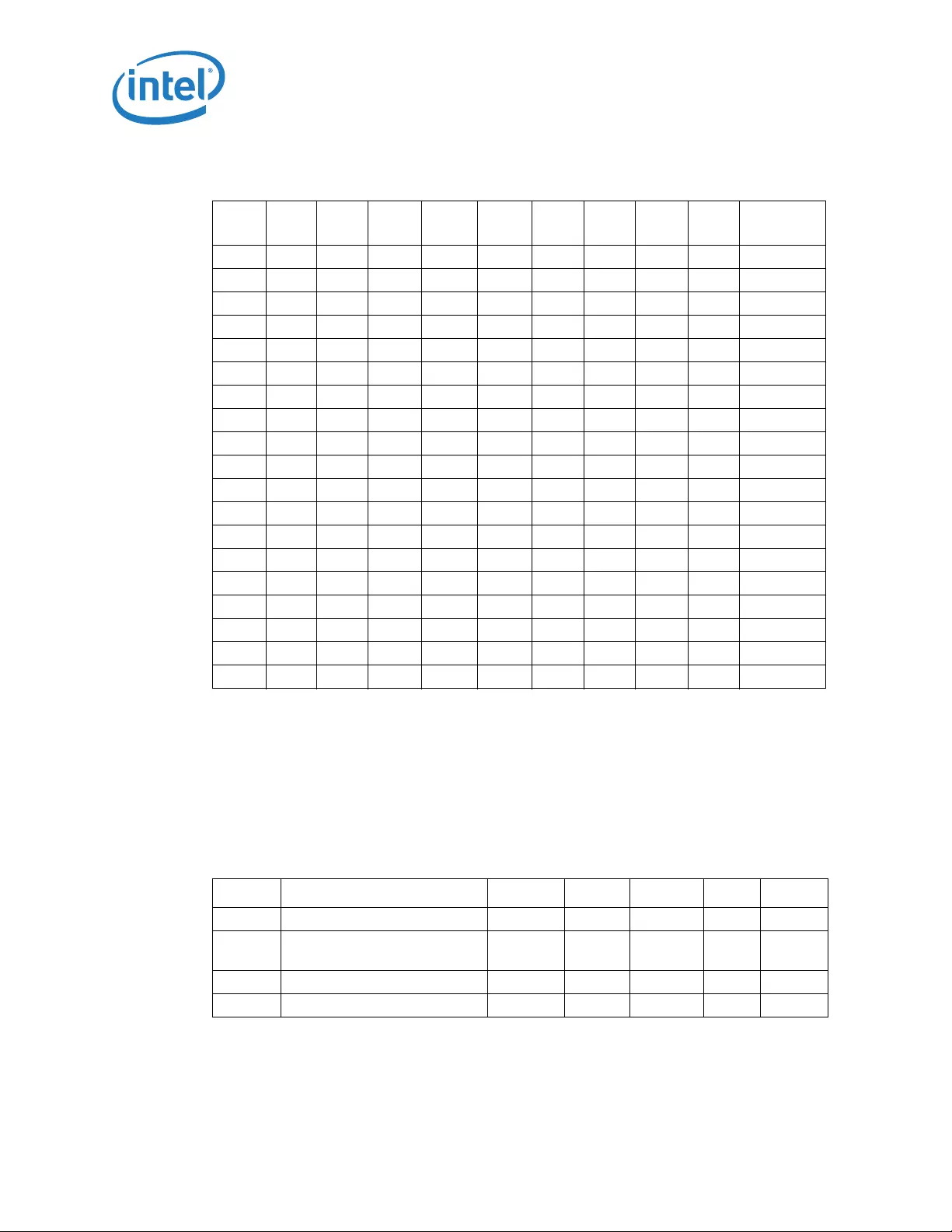
Electrical Specifications
290 Datasheet
29.5 Crystal Specifications
There are two crystal oscillators. One for RTC which maintains time and provides initial
timing reference for power sequencing. The other is for the Integrated Clock, which
covers clocking for the entire SoC.
NOTES:
1. These are the specifications needed to select a crystal oscillator for the RTC circuit.
1 1 1 0 1 1 0 1 E D 1.43000
1 1 1 0 1 1 1 0 E E 1.43500
1 1 1 0 1 1 1 1 E F 1.44000
1 1 1 1 0 0 0 0 F 0 1.44500
1 1 1 1 0 0 0 1 F 1 1.45000
1 1 1 1 0 0 1 0 F 2 1.45500
1 1 1 1 0 0 1 1 F 3 1.46000
1 1 1 1 0 1 0 0 F 4 1.46500
1 1 1 1 0 1 0 1 F 5 1.47000
1 1 1 1 0 1 1 0 F 6 1.47500
1 1 1 1 0 1 1 1 F 7 1.48000
1 1 1 1 1 0 0 0 F 8 1.48500
1 1 1 1 1 0 0 1 F 9 1.49000
1 1 1 1 1 0 1 0 F A 1.49500
1 1 1 1 1 0 1 1 F B 1.50000
1 1 1 1 1 1 0 0 F C 1.49500
1 1 1 1 1 1 0 1 F D 1.50000
1 1 1 1 1 1 1 0 F E 1.49500
1 1 1 1 1 1 1 1 F F 1.50000
Table 128. IMVP7.0 Voltage Identification Reference (Sheet 8 of 8)
VID7 VID6 VID5 VID4 VID3 VID2 VID1 VID0 Hex
bit 1
Hex
bit 0 VCC (V)
Table 129. ILB RTC Crystal Specification
Symbol Parameter Min Typ Max Units Notes
FRTC Frequency - 32.768 - kHz 1
TPPM Crystal frequency tolerance
(see notes)
- - +/-50 ppm 1
RESR ESR - - 50 kOhm 1
CX1,2 Capacitance of X1, X2 pins pF 1
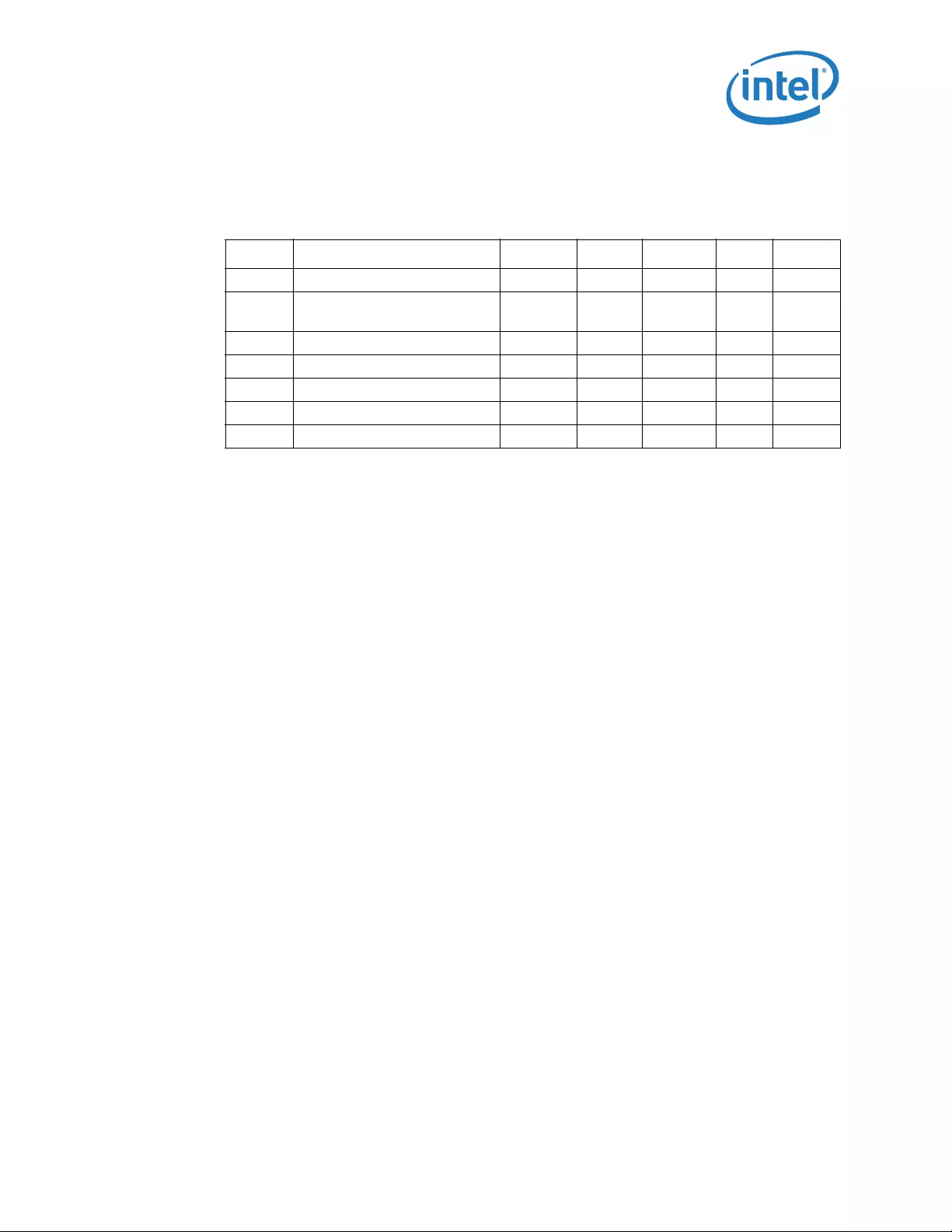
Datasheet 291
Electrical Specifications
2. Crystal tolerance impacts RTC time. A 10 ppm crystal is recommended for 1.7 s tolerance per day, RTC
circuit itself contributes addition 10 ppm for a total of 20 ppm in this example.
NOTE: These are the specifications needed to select a crystal oscillator for the Integrated Clock
circuit. Crystal must be AT cut, fundamental, parallel resonance.
29.6 DC Specifications
Platform reference voltages are specified at DC only. VREF measurements should be
made with respect to the supply voltages specified in “Voltage and Current
Specifications”.
Note: The SoC is a pre-launch product. DC specifications are subject to change.
Refer the following DC Specifications in this section:
•“Display DC Specification”
•“MIPI-Camera Serial Interface (CSI) DC Specification”
•“SCC - SDIO DC Specification”
•“SCC - SD Card DC Specification”
•“SCC - eMMC 4.41 DC Specification”
•“SCC - eMMC 4.51 DC Specification”
•“JTAG (TAP) DC Specification”
•“DDR3L-RS Memory Controller DC Specification”
•“LPDDR3 Memory Controller DC Specification”
•“USB 2.0 Host DC Specification”
•“USB 3.0 DC Specification”
•“PCU - iLB - LPC DC Specification”
•“PCU - SPI (Platform Control Unit) DC Specification”
•“PCU - Power Management/Thermal (PMC) and iLB RTC DC Specification”
•“SVID DC Specification”
Table 130. Integrated Clock Crystal Specification
Symbol Parameter Min Typ Max Units Notes
FICLK Frequency - 25 - MHz 1
TPPM Crystal frequency tolerance &
stability
- - +/-30 ppm 1
PDRIVE Crystal drive load - - 100 uW 1
RESR ESR - - 100 Ohm 1
CLOAD Crystal load capacitance 18 pF
CSHUNT Crystal shunt capacitance - - 6 pF 1
CIN/OUT Capacitance of oscillator pins pF 1
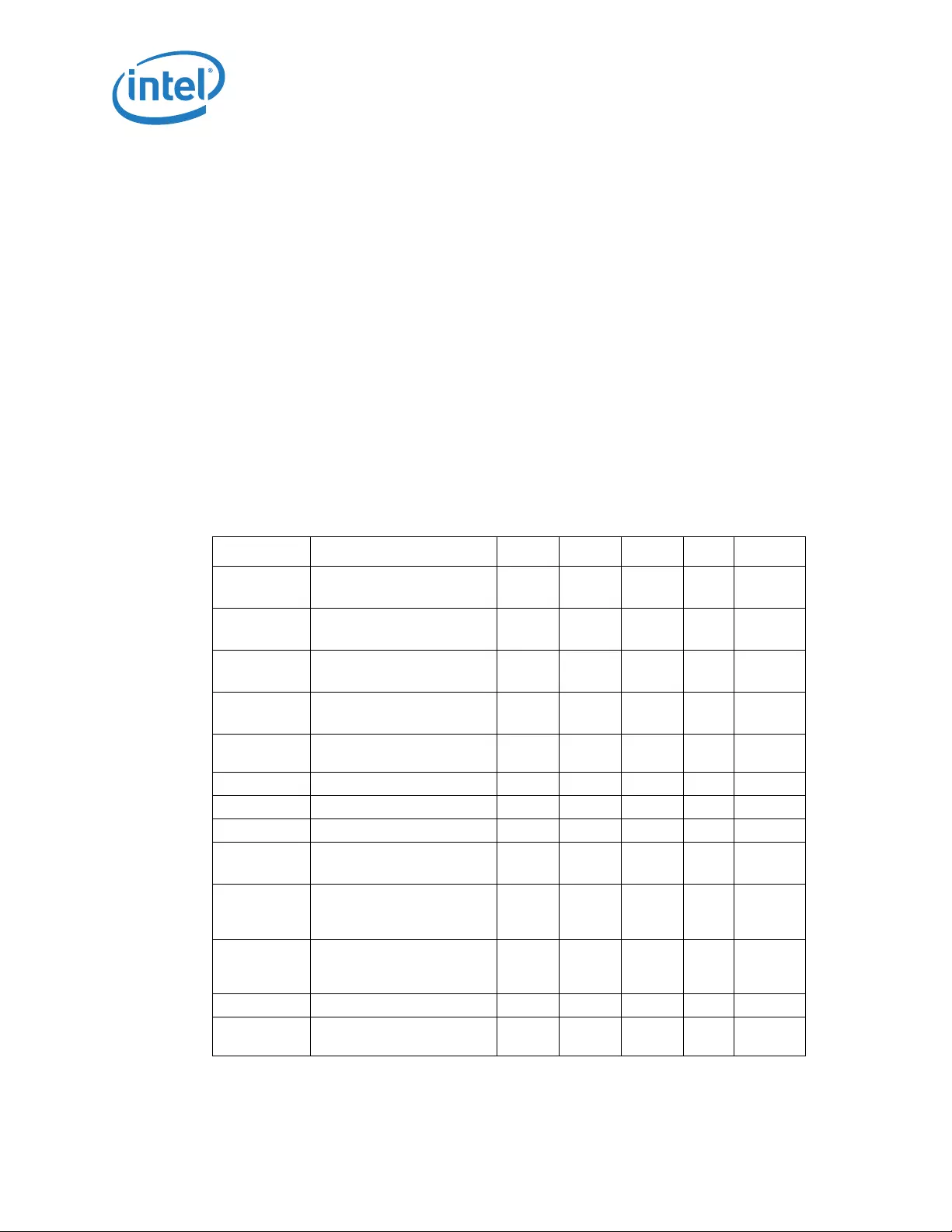
Electrical Specifications
292 Datasheet
•“GPIO DC Specification”
•“SIO - I2C DC Specification”
•“SIO - UART DC Specification”
•“I2S (Audio) DC Specification”
Note: Care should be taken to read all notes associated with each parameter.
29.6.1 Display DC Specification
DC specifications for display interfaces:
•“Digital Display Interface (DDI) Signals DC Specification”
•“MIPI DSI DC Specification”
29.6.1.1 Digital Display Interface (DDI) Signals DC Specification
Table 131. DDI Main Transmitter DC specification
Symbol Parameter Min Typ Max Units Notes
VTX-DIFFp-p-
Level0
Differential Peak-to-peak
Output Voltage Level 0
0.34 0.4 0.46 V 1
VTX-DIFFp-p-
Level1
Differential Peak-to-peak
Output Voltage Level 1
0.51 0.6 0.68 V 1
VTX-DIFFp-p-
Level2
Differential Peak-to-peak
Output Voltage Level 2
0.69 0.8 0.92 V 1
VTX-DIFFp-p-
Level3
Differential Peak-to-peak
Output Voltage Level 3
0.85 1.2 1.38 V 1
VTX-PREEMP-
RATIO
No Pre-emphasis 0.0 0.0 0.0 dB 1
3.5 dB Pre-emphasis 2.8 3.5 4.2 dB 1
6.0 dB Pre-emphasis 4.8 6.0 7.2 dB 1
9.5 dB Pre-emphasis 7.5 9.5 11.4 dB 1
VTX-DC-CM Tx DC Common Mode
Voltage
02.0V1
RLTX-DIFF Differential Return Loss at
0.675GHz at Tx Package
pins
12 dB 4
Differential Return Loss at
1.35 GHz at Tx Package
pins
9dB4
CTX AC Coupling Capacitor 75 200 nF 5
Voff Single Ended Standby (off),
output voltage
-10 10 mV 6 @ AVcc
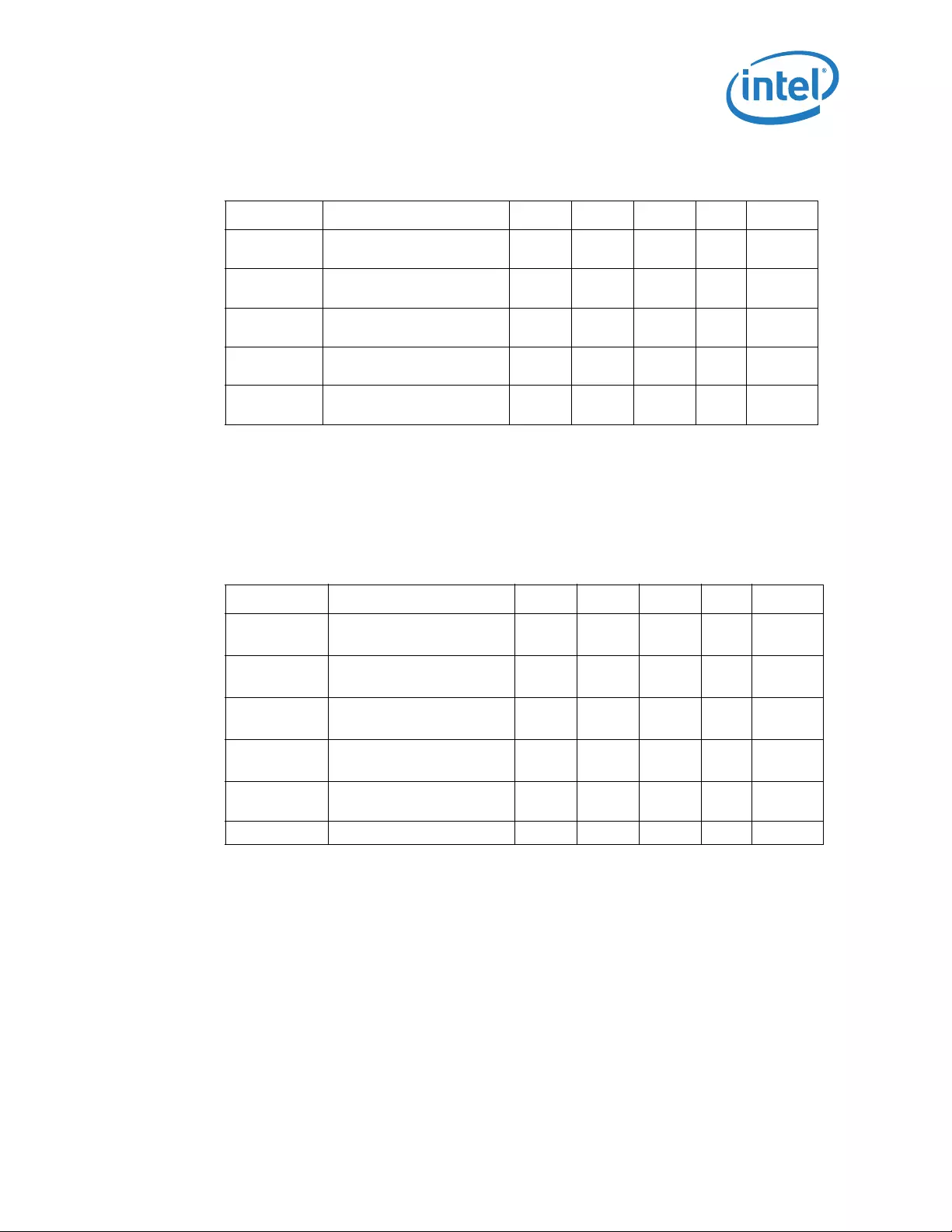
Datasheet 293
Electrical Specifications
NOTES:
1. For embedded connection, support of programmable voltage swing levels is optional.
2. Total drive current of the transmitter when it is shorted to its ground.
3. Common mode voltage is equal to Vbias_Tx voltage shown in Figure 40.
4. Straight loss line between 0.675 GHz and 1.35 GHz.
5. All DisplayPort Main Link lanes as well as AUX CH must be AC coupled. AC coupling capacitors must be
placed on the transmitter side. Placement of AC coupling capacitors on the receiver side is optional.
6. AVcc =Analog Voltage level
NOTES:
1. VAUX-DIFFp-p= 2*|VAUXP – VAUXM|
2. Common mode voltage is equal to Vbias_Tx (or Vbias_Rx) voltage.
3. Steady state common mode voltage shift between transmit and receive modes of operation.
4. Total drive current of the transmitter when it is shorted to its ground.
5. All DisplayPort Main Link lanes as well as AUX CH must be AC coupled. AC coupling capacitors must be
placed on the transmitter side. Placement of AC coupling capacitors on the receiver side is optional.
Vswing Single Ended output swing
voltage
400 600 mV
VOH (<=165
MHz)
Single Ended high level,
output voltage
-10 10 mv 6 @ AVcc
VOH(>165
MHz)
Single Ended high level,
output voltage
-200 10 mV 6 @ AVcc
VOL(<=165
MHz)
Single Ended low level,
output voltage
-600 -400 mV 6 @ AVcc
VOL(>165MH
z)
Single Ended low level,
output voltage
-700 -400 mV 6 @ AVcc
Table 131. DDI Main Transmitter DC specification
Symbol Parameter Min Typ Max Units Notes
Table 132. DDI AUX Channel DC Specification
Symbol Parameter Min Typ Max Units Notes
VAUX-DIFFp-p AUX Peak-to-peak Voltage
at a transmitting Device
0.29 1.38 V 1
VAUX-_TERM_R AUX CH termination DC
resistance
100
VAUX-DC-CM AUX DC Common Mode
Voltage
02.0V2
VAUX-TURN-CM AUX turn around common
mode voltage
0.3 V 3
IAUX_SHORT AUX Short Circuit Current
Limit
90 mA 4
CAUX AC Coupling Capacitor 75 200 nF 5
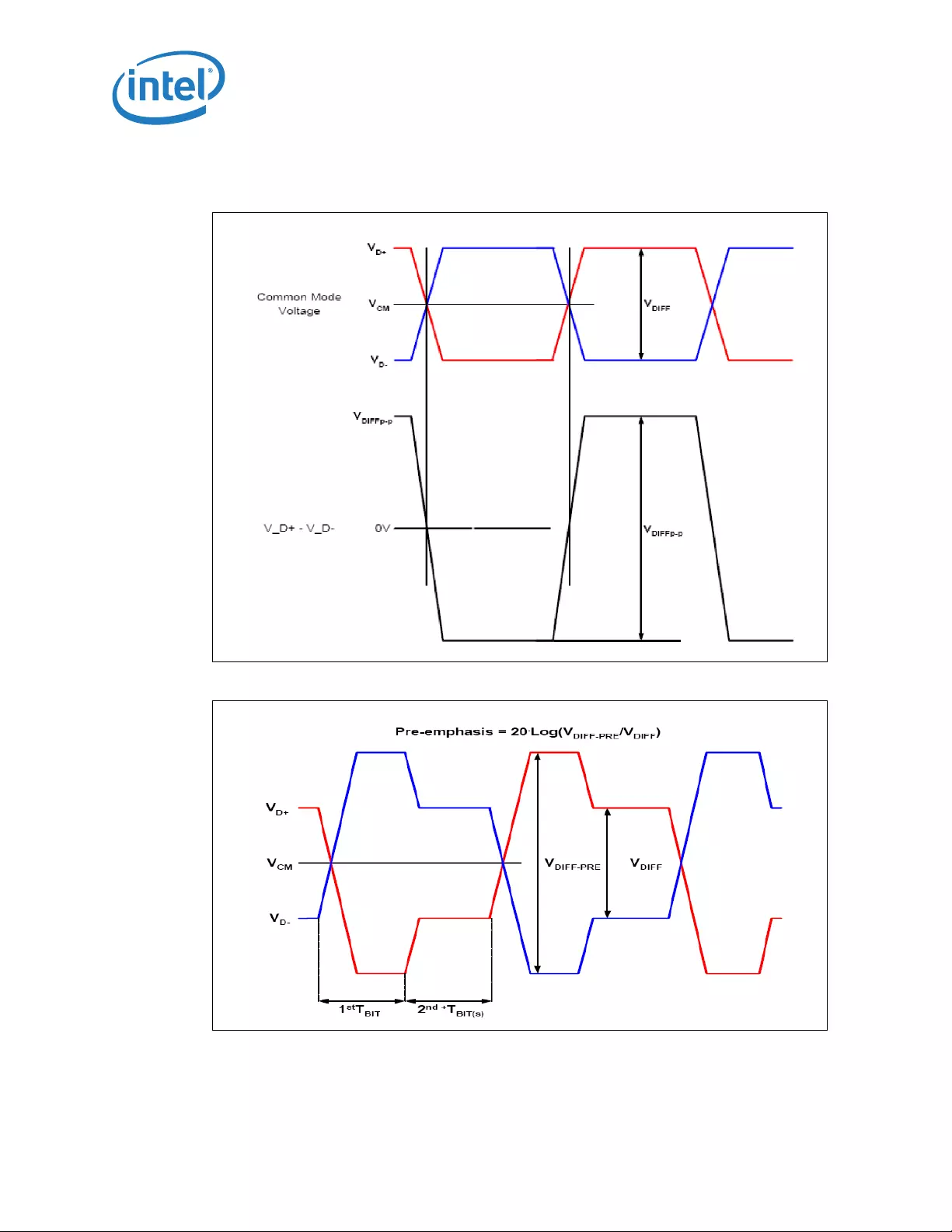
Electrical Specifications
294 Datasheet
Figure 40. Definition of Differential Voltage and Differential Voltage Peak-to-Peak
Figure 41. Definition of Pre-emphasis

Datasheet 295
Electrical Specifications
29.6.1.2 MIPI DSI DC Specification
NOTE:
1. Deviates from MIPI D-PHY specification Rev 1.0, which has minimum ZOLP of 110 Ω.
Table 133. MIPI DSI DC Specification
Symbol Parameter Min. Nom. Max. Unit Notes
ILEAK Pin Leakage current -10 – 10 µA
MIPI DSI HS-TX Mode
VCMTX HS transmit static
common-mode voltage
150 200 250 mV
|VCMTX(1,0)|V
CMTX mismatch when
output is differential-1 or
differential-0
––5mV
|VOD| HS transmit differential
voltage
140 200 270 mV
|ΔVOD|V
OD mismatch when output
is Differential-1 or
Differential-0
––10mV
VOHHS HS output high voltage – – 360 mV
ZOS Single-ended output
impedance
40 50 62.5 Ω
ΔZOS Single-ended output
impedance mismatch
––10%
MIPI DSI LP-TX Mode
VOH Thevenin output high level 1.1 1.2 1.3 V
VOL Thevenin output low level -50 – 50 mV
ZOLP Output impedance of LP
transmitter
50 – – Ω1
MIPI DSI LP-RX Mode
VIH Logic 1 input voltage 880 – – mV
VIL Logic 0 input voltage, not in
ULP state
––550mV
VHYST Input hysteresis 25 – – mV
VIHCD Logic 1 Contention
threshold
450 – – mV
VILCD Logic 0 Contention
threshold
––200mV
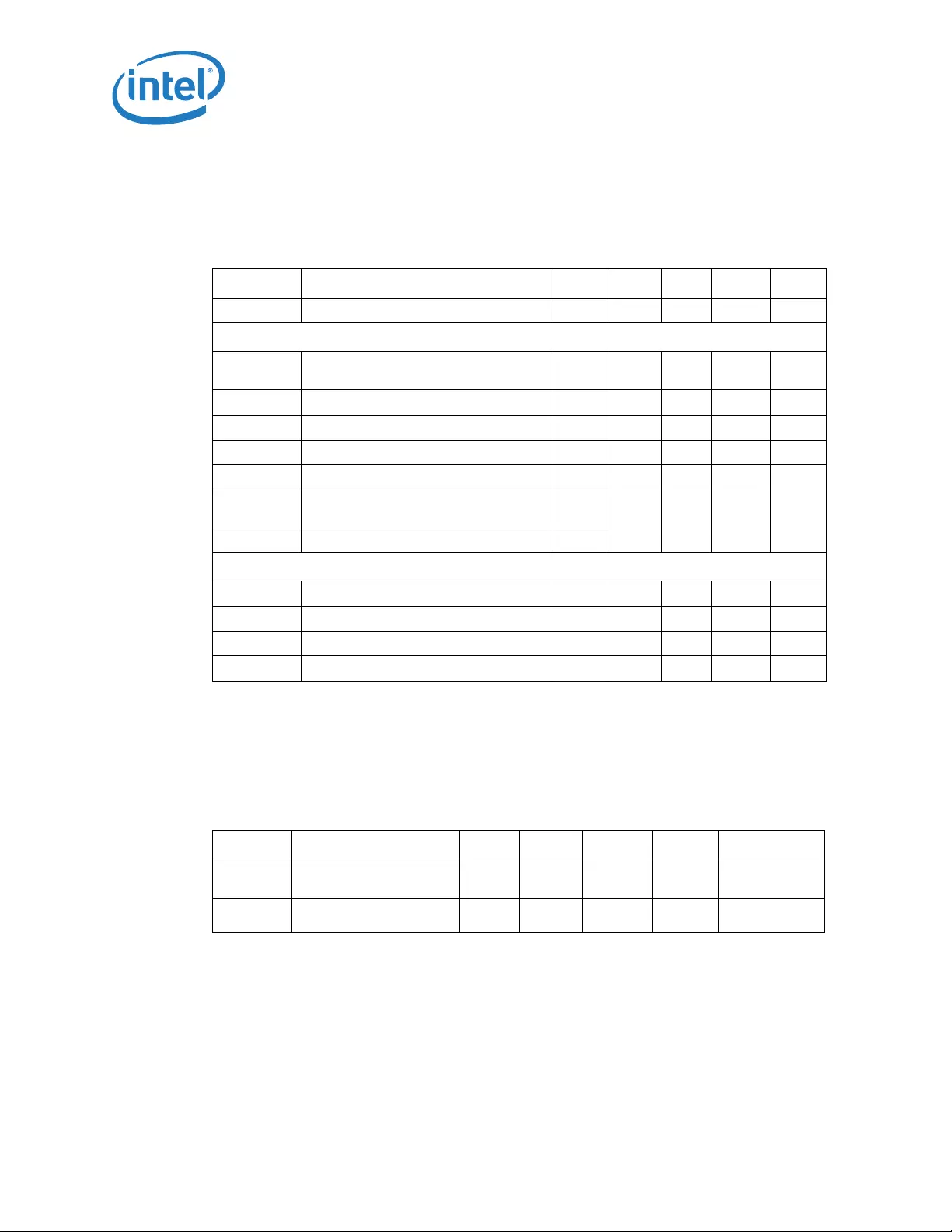
Electrical Specifications
296 Datasheet
29.6.2 MIPI-Camera Serial Interface (CSI) DC Specification
29.6.3 SCC - SDIO DC Specification
Tab l e 13 5 provides the SDIO DC Specification, for all other DC Specifications not listed
in Tab l e 1 35 , refer to Table 154, “GPIO 1.8V Core Well Signal Group DC Specification
(GPIO_S0_SC[101:0]).
29.6.4 SCC - SD Card DC Specification
Tab l e 13 6 provides the SD Card DC Specification, for all other DC Specifications not
listed in Tab l e 13 6 , refer to Table 154, “GPIO 1.8V Core Well Signal Group DC
Specification (GPIO_S0_SC[101:0]).
Table 134. MIPI HS-RX/MIPI LP-RX Minimum, Nominal, and Maximum Voltage
Parameters
Symbol Parameter Min. Typ. Max. Unit Notes
ILEAK Pin Leakage current -10 – 10 µA
MIPI-CSI HS-RX Mode
VCMRX(DC) Common-mode voltage HS receive
mode
70 –330 mV
VIDTH Differential input high threshold ––
70 mV
VIDTL Differential input low threshold -70 ––
mV
VIHHS Single-ended input high voltage ––
460 mV
VILHS Single-ended input low voltage -40 ––
mV
VTERM-EN Single-ended threshold for HS
termination enable
––
450 mV
ZID Differential input impedance 80 100 125
MIPI-CSI LP-RX Mode
VIH Logic 1 input voltage 880 ––
mV
VIL Logic 0 input voltage, not in ULP state ––
550 mV
VIL-ULPS Logic 0 input voltage, ULP state ––
300 mV
VHYST Input hysteresis 25 ––
mV
Table 135. SDIO DC Specification
Symbol Parameter Min. Typ. Max. Unit Notes
VOH Output High Voltage 1.4 ––VMeasured at
IOH maximum.
IOH/IOL Current at VoL/Voh -2 – – mA

Datasheet 297
Electrical Specifications
29.6.5 SCC - eMMC 4.41 DC Specification
Table 136. SD Card DC Specification
Symbol Parameter Min. Max. Unit
VREF I/O Voltage SD3_V1P8V3P3_S4
VOH Output High Voltage 0.75*VREF –V
VOL Output Low Voltage - 0.125*VREF V
VIH (3.3)
Input High Voltage
(3.3 V) 0.625*VREF -V
VIL (3.3)
Input Low Voltage
(3.3 V) - 0.25*VREF V
VPEAK (3.3)
Peak Voltage on All
lines -0.3 VREF+0.3 V
VIH (1.8)
Input High Voltage
(1.8 V) 1.28 - V
VIL (1.8)
Input Low Voltage
(1.8 V) -0.58V
VPEAK (1.8)
Peak Voltage on All
lines -0.3 VREF+0.3 V
IOH/IOL Current at VoL/Voh -45 40 µA
Vhysteresis Input Hysteresis None V
CLOAD Input Load Capacitance 49
pF
Table 137. eMMC 4.41 Signal DC Electrical Specifications
Symbol Parameter Min Max Units
VREF I/O Voltage UNCORE_V1P8_S4
VOH Output HIGH voltage VREF-0.45 - V
VOl Output LOW voltage - 0.45 V
VIH Input HIGH voltage 0.65*VREF -V
VIL Input LOW voltage 0.35*VREF V
CPAD Input PAD Capacitance 2 5 pF
ILI Input Leakage Current -5 5 µA
IL0 Output Leakage Current -5 5 µA
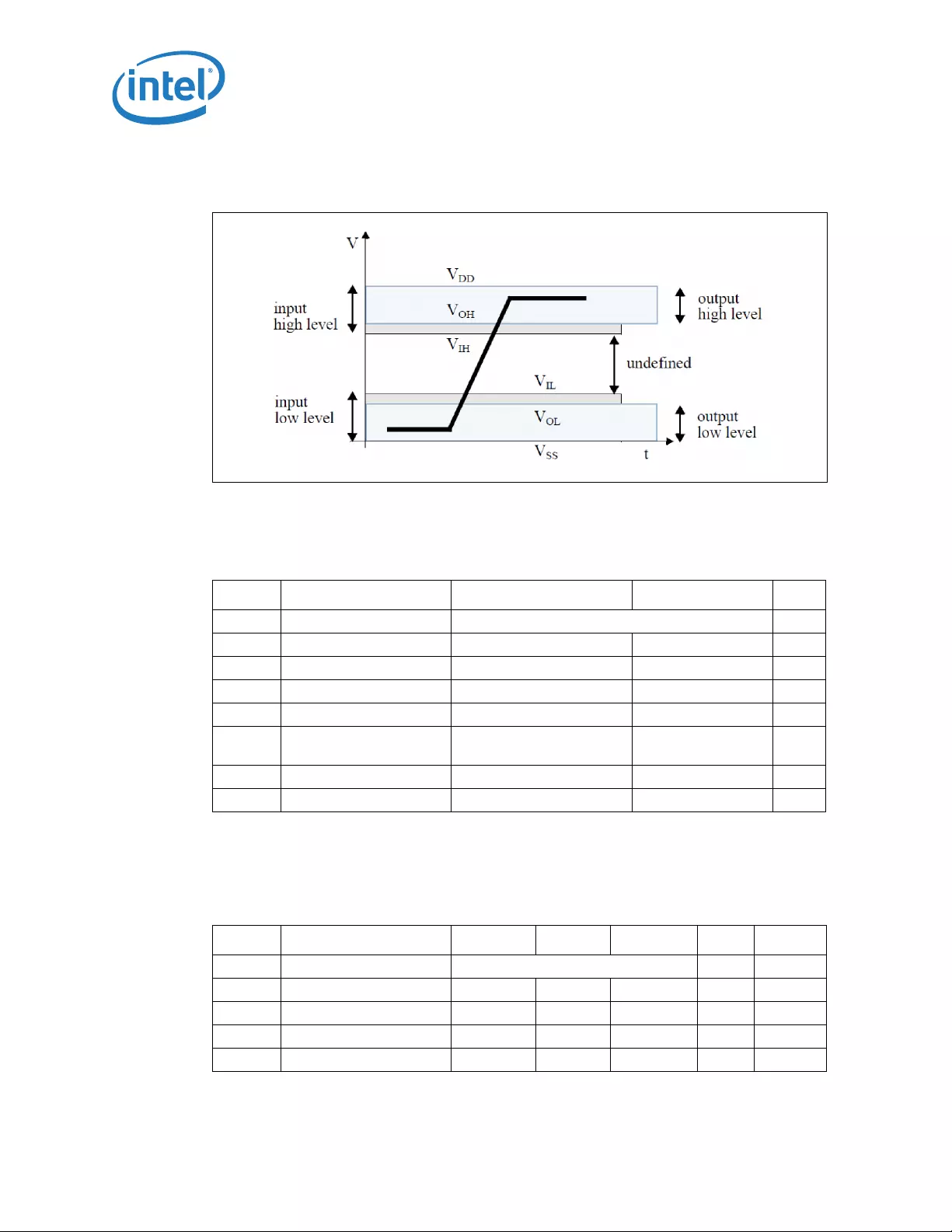
Electrical Specifications
298 Datasheet
29.6.6 SCC - eMMC 4.51 DC Specification
29.6.7 JTAG (TAP) DC Specification
Figure 42. eMMC DC Bus signal level
Table 138. eMMC 4.51 Signal DC Electrical Specifications
Symbol Parameter Min Max Units
VREF I/O Voltage UNCORE_V1P8_S4
VOH Output HIGH voltage VREF - 0.45 - V
VOl Output LOW voltage - 0.45 V
VIH Input HIGH voltage 0.65 * VREF VREF + 0.3 V
VIL Input LOW voltage -0.3 0.35 * VREF V
CLBus Signal Line
capacitance
-30pF
ILI Input Leakage Current -2 2 µA
IL0 Output Leakage Current -2 2 µA
Table 139. TAP Signal Group DC Specification (TAP_TCK, TAP_TRSRT#, TAP_TMS,
TAP_TDI) (Sheet 1 of 2)
Symbol Parameter Min Typ Max Units Notes
VREF I/O Voltage PMC_V1P8_G3
VIH Input High Voltage 0.8*VREF V1
VIL Input Low Voltage 0.4*VREF V2
Zpu Pull up Impedance 60 3
Zpd Pull down Impedance 60 3
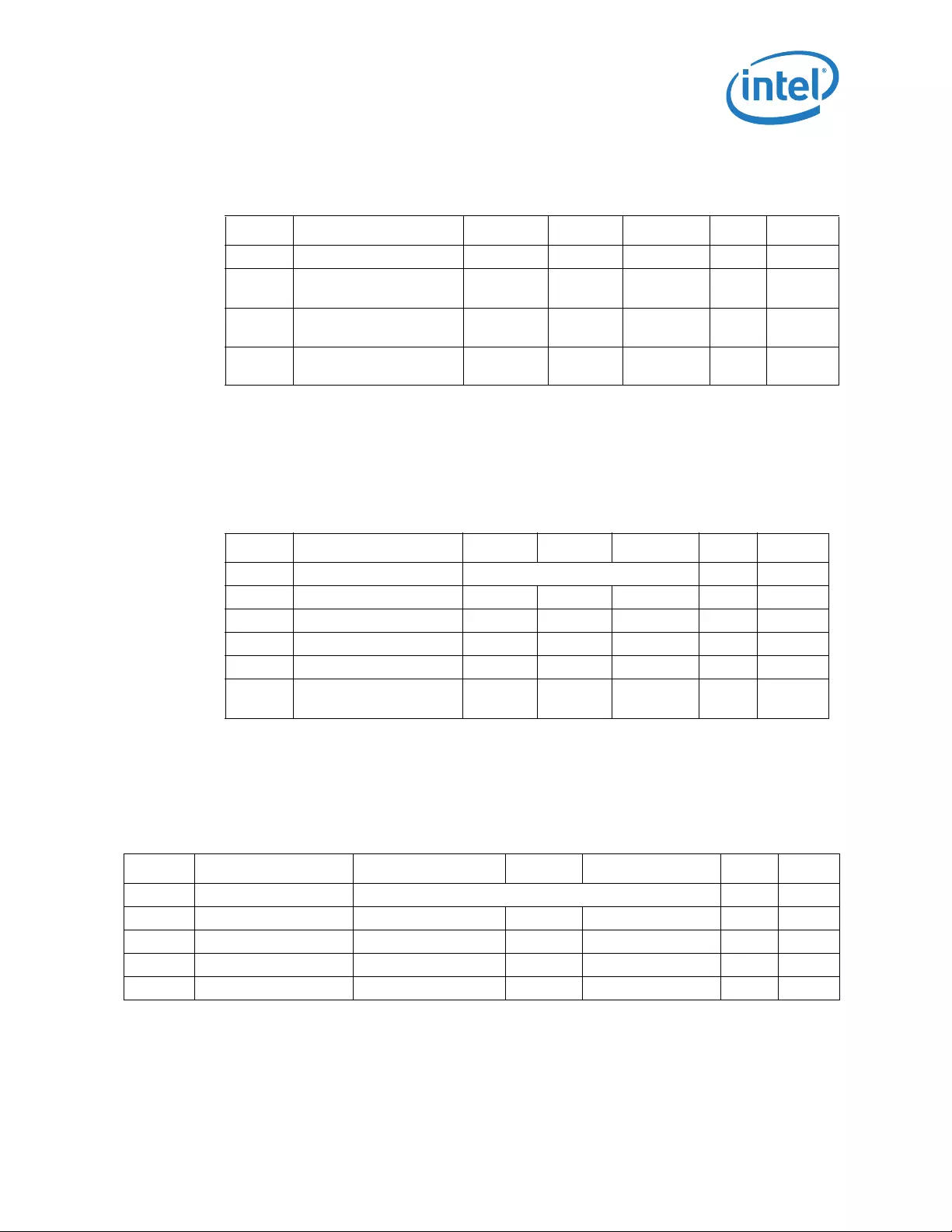
Datasheet 299
Electrical Specifications
NOTES:
1. VIH is defined as the minimum voltage level at a receiving agent that will be interpreted as a logical high
value
2. VIL is defined as the minimum voltage level at a receiving agent that will be interpreted as a logical low
value.
3. Measured at PMC_V1P8_G3/2.
4. Rwpu_40k and Rwpd_40k are only used for TAP_TRST#
NOTES:
1. VIH is defined as the minimum voltage level at a receiving agent that will be interpreted as a logical high
value
2. VIL is defined as the minimum voltage level at a receiving agent that will be interpreted as a logical low
value.
3. Measured at PMC_V1P8_G3/2.
NOTES:
1. VIH is defined as the minimum voltage level at a receiving agent that will be interpreted as a logical high value
2. VIL is defined as the minimum voltage level at a receiving agent that will be interpreted as a logical low value.
3. Measured at PMC_V1P8_G3/2.
Rwpu Weak Pull Impedance 1 4 k3
Rwpd Weak Pull Down
Impedance
14k3
Rwpu-40K Weak Pull Up Impedance
40K
20 70 k4
Rwpd-40K Weak Pull Down
Impedance 40K
20 70 k4
Table 139. TAP Signal Group DC Specification (TAP_TCK, TAP_TRSRT#, TAP_TMS,
TAP_TDI) (Sheet 2 of 2)
Symbol Parameter Min Typ Max Units Notes
Table 140. TAP Signal Group DC Specification (TAP_TDO)
Symbol Parameter Min Typ Max Units Notes
VREF I/O Voltage PMC_V1P8_G3
VIH Input High Voltage 0.8*VREF V1
VIL Input Low Voltage 0.5*VREF V2
Zpd Pull down Impedance 30 3
Rwpu Weak Pull Impedance 1 4 k3
Rwpd Weak Pull Down
Impedance
14k3
Table 141. TAP Signal Group DC Specification (TAP_PRDY#, TAP_PREQ#)
Symbol Parameter Min Typ Max Units Notes
VREF I/O Voltage PMC_V1P8_G3
VIH Input High Voltage 0.64*VREF V1
VIL Input Low Voltage 0.4*VREF V2
Zpd Pull down Impedance 30 3
Rwpu Weak Pull Impedance 1 4 k3

Electrical Specifications
300 Datasheet
29.6.8 DDR3L-RS Memory Controller DC Specification
NOTES:
1. VIL is defined as the maximum voltage level at a DRAM input buffer that will be received as a logical low value.
DRAM_VREF is normally DRAM_VDD_S4/2
2. VIH is defined as the minimum voltage level at a DRAM input buffer that will be received as a logical high value.
DRAM_VREF is normally DRAM_VDD_S4/2
3. VIH and VOH may experience excursions above DRAM_VDD_S4. However, input signal drivers must comply with the signal
quality specifications.
4. RON is DRAM driver resistance whereas RTT_TERM is DRAM ODT resistance which is controlled by DRAM.
5. DDR3L-1333 CLK buffer Ron is 26ohm and SR target is 4V/ns; DQ-DQS buffer Ron is 30ohms and SR target is 4V/ns;
CMD/CTL buffer Ron is 20ohms and SR target is 1.8V/ns.
29.6.9 LPDDR3 Memory Controller DC Specification
Table 142. DDR3L-RS Signal Group DC Specifications
Symbol Parameter Min Typ Max Units Notes
VIL Input Low
Voltage
DRAM_VREF
- 200mV
V1, 3
VIH Input High
Voltage
DRAM_VREF
+ 200mV
V2, 3
VOL Output Low
Voltage
(DRAM_VDD_S4 / 2)* (RON /
(RON+RVTT_TERM))
3,4
VOH Output High
Voltage
DRAM_VDD_S4 -
((DRAM_VDD_S4 /2)*
(RON/(RON+RVTT_TERM))
V3,4
IIL Input Leakage
Current
5 µA For all
DRAM
Signals
RON DDR3L-RS
Clock Buffer
strength
26 5
CIO DQ/DQS/DQS#
DDR3L-RS IO
Pin Capacitance
3.0 pF
Table 143. LPDDR3 Signal Group DC Specifications (Sheet 1 of 2)
Symbol Parameter Min Typ Max Uni
ts
Not
es
DRAM_VDD_S4 I/O Supply Voltage 1.14 1.24 1.26 V
DRAM_VREF Reference Voltage 0.49 *
DRAM_VDD_S4
0.50 *
DRAM_VDD
_S4
0.51 *
DRAM_VDD_S4
VIL Input Low Voltage DRAM_VREF
- 200 mV
V
VIH Input High Voltage DRAM_VREF
+ 200 mV
V
VOL Output Low Voltage - 0.260 - V 1,2
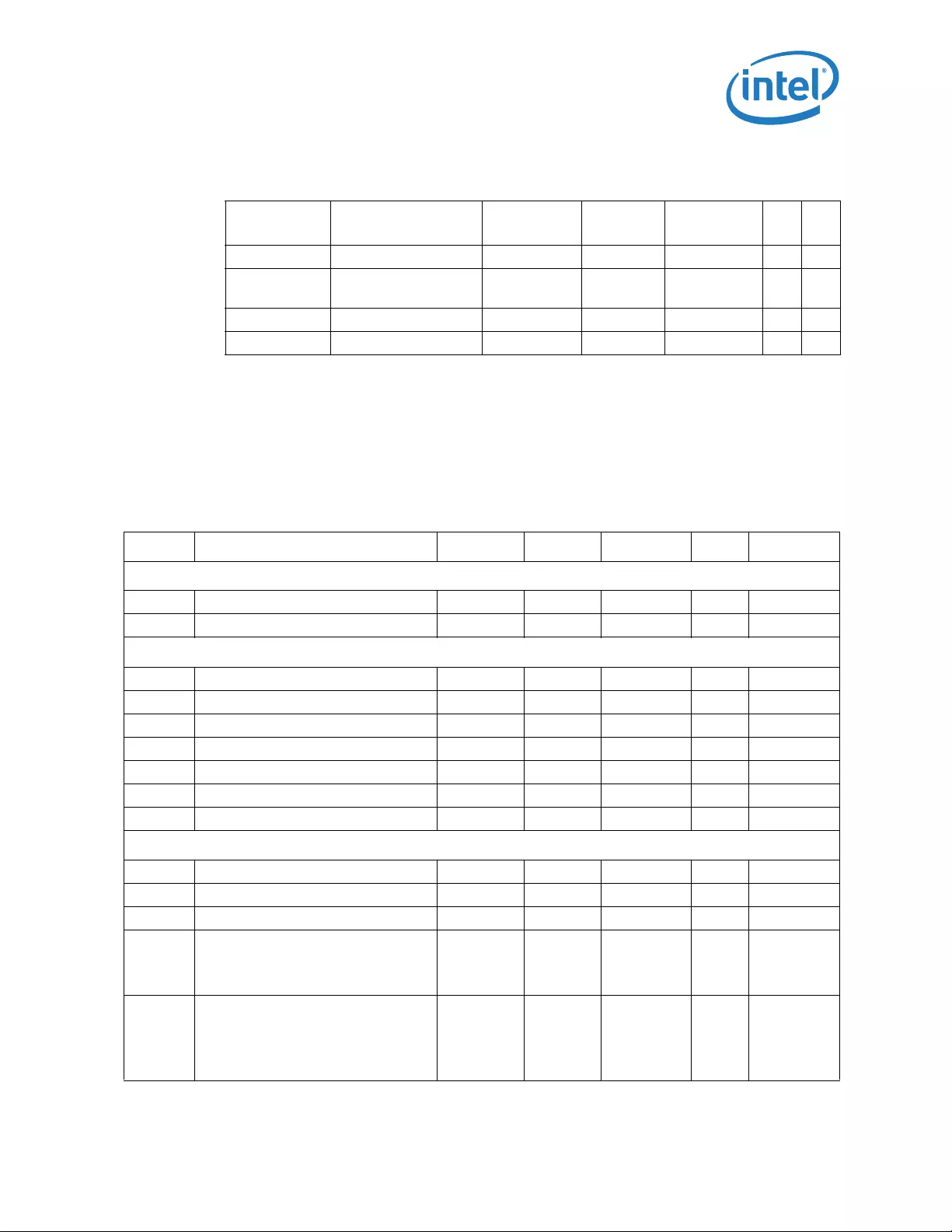
Datasheet 301
Electrical Specifications
NOTES:
1. Vol & Voh is determined with 40ohm buffer strength setting into a 60ohm to 0.5x V1p5_ddr test load.
2. LPDDR3-1066 CLK buffer Ron is 35ohm and SR target is 2.5V/ns; DQ-DQS buffer Ron is 40ohms and SR
target is 2V/ns; CMD/CTL buffer Ron is 30ohms and SR target is 1.5V/ns.
3. Applies to the pin to VCC or VSS leakage current.
4. Applies to the pin to pin leakage current.
29.6.10 USB 2.0 Host DC Specification
VOH Output High Voltage - 0.960 - V 1,2
IIL Input Leakage
Current
-5-µA3,4
RON Clock Buffer strength 26 40
CIO IO Pin Capacitance 3.0 pF
Table 143. LPDDR3 Signal Group DC Specifications (Sheet 2 of 2)
Symbol Parameter Min Typ Max Uni
ts
Not
es
Symbol Parameter Min Typ Max Units Notes
Supply Voltage:
VBUS High-power Port 4.75 5.25 V 2
VBUS Low-power Port
Supply Current:
ICCPRT High-power Hub Port (out) 500 mA
ICCUPT Low-power Hub Port (out) 100 mA
ICCHPF High-power Function (in) 500 mA
ICCLPF Low-power Function (in) 100 mA
ICCINIT Unconfigured Function/Hub (in) 100 mA
ICCSH Suspended High-power Device 2.5 mA 15
ICCSL Suspended Low-power Device 500 µA
Input Levels for Low-/full-speed:
VIH High (driven) 2.0 V 4
VIHZ High (floating) 2.7 3.6 V 4
VIL Low 0.8 V 4
VDI Differential Input Sensitivity 0.2 V
|(D+)-(D-
)|;Figure;
Note 4
VCM Differential Common Mode Range 0.8 2.5 V
Includes
VDI range;
Figure; Note
4

Electrical Specifications
302 Datasheet
Input Levels for High-speed:
VHSSQ High-speed squelch detection
threshold (differential signal
amplitude)
100 150 mV
VHSDSC High speed disconnect detection
threshold (differential signal
amplitude)
525 625 mV
High-speed differential input
signaling levels
VHSCM High-speed data signaling common
mode voltage range (guideline for
receiver)
-50 500 mV
Output Levels for Low-/full-speed:
VOL Low 0.0 0.3 V 4,5
VOH High (Driven) 2.8 3.6 V 4,6
VOSE1 SE1 0.8 V
VCRS Output Signal Crossover
Voltage
1.3 2.0 V 10
Output Levels for High-speed:
VHSOI High-speed idle level -10 10 mV
VHSOH High-speed data signaling high 360 440 mV
VHSOL High-speed data signaling low -10 10 mV
VCHIRPJ Chirp J level (differential voltage) 700 1100 mV
VCHIRPK Chirp K level (differential voltage) -900 -500 mV
Decoupling Capacitance:
CHPB Downstream Facing Port Bypass
Capacitance (per hub)
120 µF
CRPB Upstream Facing Port Bypass
Capacitance
1.0 10.0 µF 9
Input Capacitance for Low-/full-speed:
CIND Downstream Facing Port 150 pF 2
CINUB Upstream Facing Port (w/o cable) 100 pF 3
CEDGE Transceiver edge rate control
capacitance
75 pF
Input Impedance for High-speed:
TDR spec for high-speed termination
Terminations:
Symbol Parameter Min Typ Max Units Notes
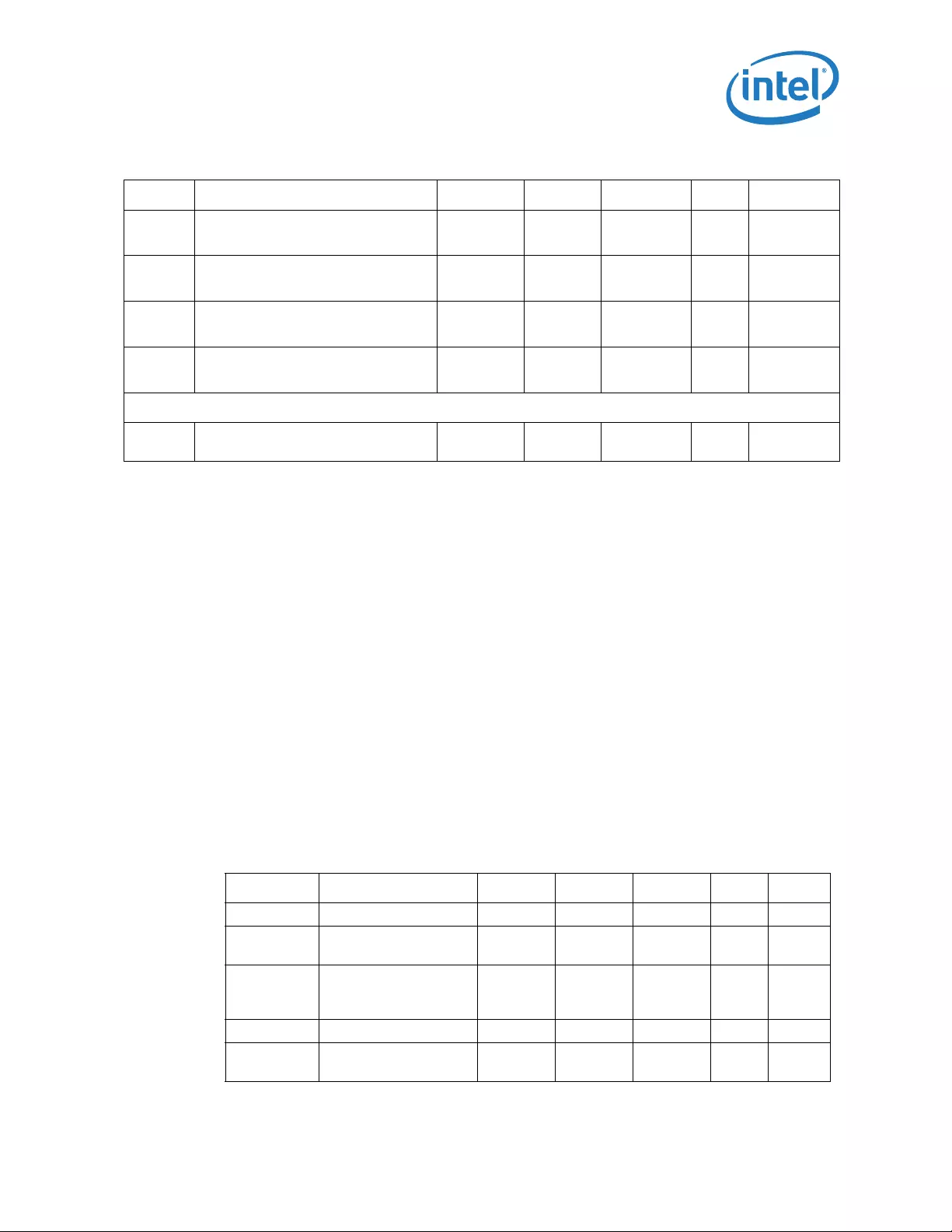
Datasheet 303
Electrical Specifications
NOTES:
1. Measured at A plug.
2. Measured at A receptacle.
3. Measured at B receptacle.
4. Measured at A or B connector.
5. Measured with RL of 1.425 kΩ to 3.6 V.
6. Measured with RL of 14.25 kΩ to GND.
7. Timing difference between the differential data signals.
8. Measured at crossover point of differential data signals.
9. The maximum load specification is the maximum effective capacitive load allowed that meets
the target VBUS drop of 330 mV.
10.Excluding the first transition from the Idle state.
11.The two transitions should be a (nominal) bit time apart.
12.For both transitions of differential signaling.
13.Must accept as valid EOP.
14.Single-ended capacitance of D+ or D- is the capacitance of D+/D- to all other conductors and,
if present, shield in the cable. That is, to measure the single-ended capacitance of D+, short
D-, VBUS, GND, and the shield line together and measure the capacitance of D+ to the other
conductors.
15.For high power devices (non-hubs) when enabled for remote wakeup.
29.6.11 USB 3.0 DC Specification
RPU Bus Pull-up Resistor on Upstream
Facing Port
1.425 1.575 kΩ1.5 kΩ ±5%
RPD Bus Pull-down Resistor on
Downstream Facing Port
14.25 15.75 kΩ1.5 kΩ ±5%
ZINP Input impedance exclusive of pull-
up/pull-down (for low-/full speed)
300 kΩ
VTERM Termination voltage for upstream
facing port pull-up (RPU)
3.0 3.6 V
Terminations in High-speed:
VHSTER
M
Termination voltage in high speed -10 10 mV
Symbol Parameter Min Typ Max Units Notes
Symbol Parameter Min Typ Max Units Notes
UI Unit Interval 199.94 200.06 ps 1
VTX-DIFF-PP Differential peak-peak
Tx voltage swing 0.9 11.05 V
VTX-DIFF-PP-
LOW
Low-Power Differential
peak-peak Tx voltage
swing
0.4 1.2 V 2
VTX-DE-RATIO Tx De-Emphasis 3.45 3.5 3.65 dB
RTX-DIFF-DC DC differential
impedance
88 92 Ω
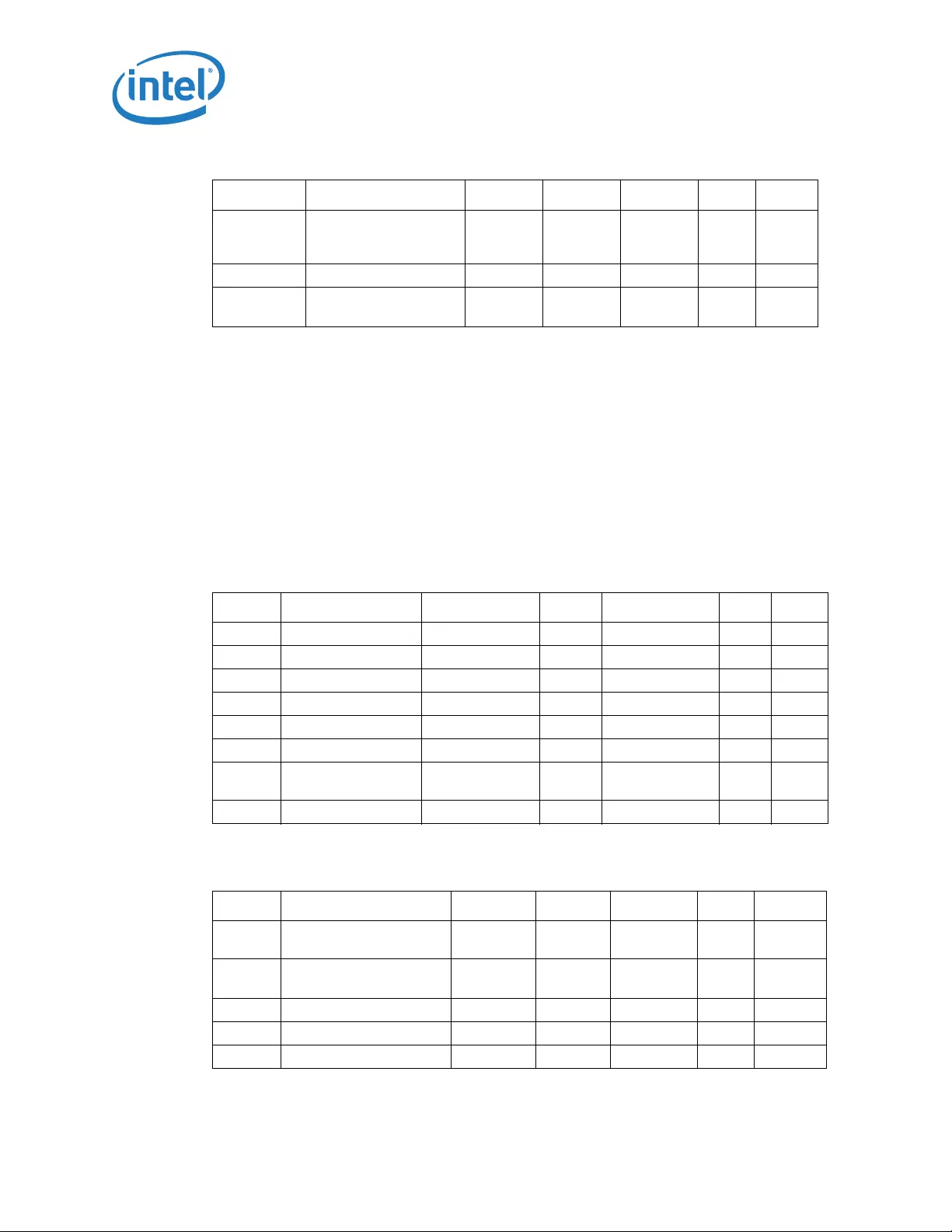
Electrical Specifications
304 Datasheet
NOTES:
1. The specified UI is equivalent to a tolerance of 300ppm for each device. Period does not account for SSC
induced variations.
2. There is no de-emphasis requirement in this mode. De-emphasis is implementation specific for this
mode.
3. Detect voltage transition should be an increase in voltage on the pin looking at the detect signal to avoid
a high impedance requirement when an “off” receiver's input goes below output.
4. All transmitters shall be AC coupled. The AC coupling is required either within the media or within the
transmitting component itself.
29.6.12 PCU - iLB - LPC DC Specification
VTX-RCV-
DETECT
The amount of voltage
change allowed during
Receiver Detection
0.6 V 3
CAC-COUPLING AC Coupling Capacitor 75 200 nF 4
tCDR_SLEW_M
AX
Maximum slew rate 10 ms/s
Symbol Parameter Min Typ Max Units Notes
Table 144. LPC Signal Group DC Specification (LPC_V1P8V3P3_S4 = 1.8V
(ILB_LPC_AD][3:0], ILB_LPC_FRAME#, ILB_LPC_SERIRQ,
ILB_LPC_CLKRUN#))
Symbol Parameter Min Typ Max Units Notes
VIH Input High Voltage 1.27 1.8 1.8 +0.1 V
VIL Input Low Voltage -0.1 0 0.58 V
VOH Output High Voltage 0.9 x 1.8 V
VOL Output Low Voltage 0.1 x 1.8 V
IOH Output High Current 1.5 mA
IOL Output Low Current -0.5 mA
ILEAK Input Leakage
Current
30 µA
CIN Input Capacitance 1 9 pF
Table 145. LPC Signal Group DC Specification LPC_V1P8V3P3_S4 = 3.3V
(ILB_LPC_AD[3:0], ILB_LPC_FRAME#, ILB_LPC_CLKRUN#) (Sheet 1 of 2)
Symbol Parameter Min Typ Max Units Notes
VIH Input High Voltage 0.5 x 3.3+
0.7
3.3 3.3 +0.1 V 1
VIL Input Low Voltage -0.1 0 0.5 x 3.3 -
0.7
V2
VOH Output High Voltage 0.9 x 3.3 V 3
VOL Output Low Voltage 0.1 x 3.3 V 3
IOH Output High Current 1.5 mA 3
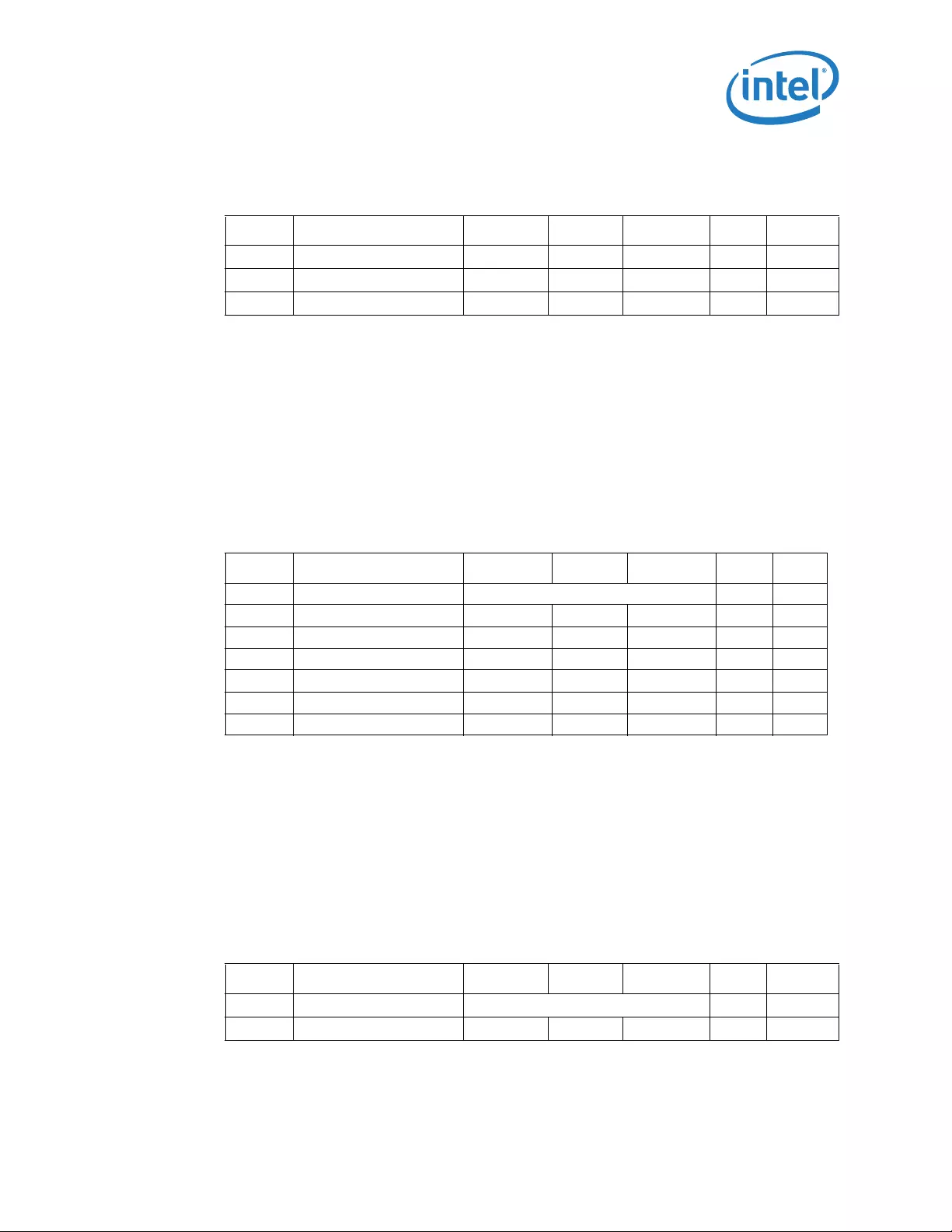
Datasheet 305
Electrical Specifications
NOTES:
1. VIH is defined as the minimum voltage level at a receiving agent that will be interpreted as a logical high
value, Applies to ILB_LPC_AD[3:0], ILB_LPC_CLKRUN#
2. VIL is defined as the minimum voltage level at a receiving agent that will be interpreted as a logical low
value. Applies to ILB_LPC_AD[3:0], ILB_LPC_CLKRUN#
3. VOH is tested with Iout=500uA, VOL is tested with Iout=1500uA
4. Applies to ILB_LPC_AD[3:0],ILB_LPC_CLKRUN# and ILB_LPC_FRAME#
5. ILB_LPC_SERIRQ is always a 1.8V I/O irrespective of the value of LPC_V1P8V3P3_S4.
29.6.13 PCU - SPI (Platform Control Unit) DC Specification
NOTES:
1. Applies to PCU_SPI_CS[1:0], PCU_SPI_CLK, PCU_SPI_MOSI
2. Applies to PCU_SPI_MISO and PCU_SPI_MOSI
3. The I/O buffer supply voltage is measured at the SoC package pins. The tolerances shown are inclusive
of all noise from DC up to 20 MHz. In testing, the voltage rails should be measured with a bandwidth
limited oscilloscope that has a rolloff of 3 dB/decade above 20 MHz.
29.6.14 PCU - Power Management/Thermal (PMC) and iLB RTC DC
Specification
IOL Output Low Current -0.5 mA 3
ILEAK Input Leakage Current 30 µA
CIN Input Capacitance 1 9 pF
Table 145. LPC Signal Group DC Specification LPC_V1P8V3P3_S4 = 3.3V
(ILB_LPC_AD[3:0], ILB_LPC_FRAME#, ILB_LPC_CLKRUN#) (Sheet 2 of 2)
Symbol Parameter Min Typ Max Units Notes
Table 146. SPI Signal Group DC Specification (PCU_SPI_MISO, PCU_SPI_CS[1:0]#,
PCU_SPI_MOSI, PCU_SPI_CLK)
Symbol Parameter Min Typ Max Units Notes
VREF I/O Voltage PCU_1P8_G3 V 3
VIH Input High Voltage 0.5 *VREF VREF + 0.5 V 2
VIL Input Low Voltage -0.5 0.3 * VREF V2
VOH Output High Voltage 0.9 * VREF 1.8V V 1
VOL Output Low Voltage 0.1 * VREF V1
IOH Output High Current 1.5 mA 1
IOL Output Low Current -0.5 mA 1
Table 147. Power Management 1.8V Suspend Well Signal Group DC Specification
Symbol Parameter Min Typ Max Units Notes
VREF I/O Voltage PCU_1P8_G3 V
VIH Input High Voltage 0.8*VREF V1

Electrical Specifications
306 Datasheet
NOTES:
1. The data in this table apply to signals - PMC_ACPRESENT, PMC_BATLOW#, PMC_PLTRST#,
PMC_PWRBTN#, PMC_SLP_S4#, PMC_SUS_STAT#, PMC_SUSCLK[3:0], PMC_SUSPWRDNACK
2. VIH is defined as the minimum voltage level at a receiving agent that will be interpreted as a
logical high value
3. VIL is defined as the minimum voltage level at a receiving agent that will be interpreted as a
logical low value.
NOTES:
1. VIH is defined as the minimum voltage level at a receiving agent that will be interpreted as a
logical high value
2. VIL is defined as the minimum voltage level at a receiving agent that will be interpreted as a
logical low value.
NOTES:
1. VIH is defined as the minimum voltage level at a receiving agent that will be interpreted as a
logical high value
2. VIL is defined as the minimum voltage level at a receiving agent that will be interpreted as a
logical low value.
VIL Input Low Voltage 0.5*VREF V2
VOH Output High Voltage 0.9*VREF VREF V1
VOL Output Low Voltage 0.1*VREF V1
Table 147. Power Management 1.8V Suspend Well Signal Group DC Specification
Symbol Parameter Min Typ Max Units Notes
Table 148. PMC_RSTBTN# 1.8V Core Well Signal Group DC Specification
Symbol Parameter Min Typ Max Units Notes
VREF I/O Voltage UNCORE_V1P8_S4 V
VIH Input High Voltage 0.8* VREF V1
VIL Input Low Voltage 0.5* VREF V2
Table 149. Power Management & RTC Well Signal Group DC Specification
(PMC_RSMRST#, PMC_CORE_PWROK, ILB_RTC_RST#)
Symbol Parameter Min Typ Max Units Notes
VREF I/O Voltage RTC_VCC
VIH Input High Voltage 2.0 - - V 1
VIL Input Low Voltage - - 0.78 V 2
Table 150. iLB RTC Well DC Specification (ILB_RTC_TEST#)
Symbol Parameter Min Typ Max Units Notes
VIH Input High Voltage 2.3 - - V 1
VIL Input Low Voltage - - 0.78 V 1
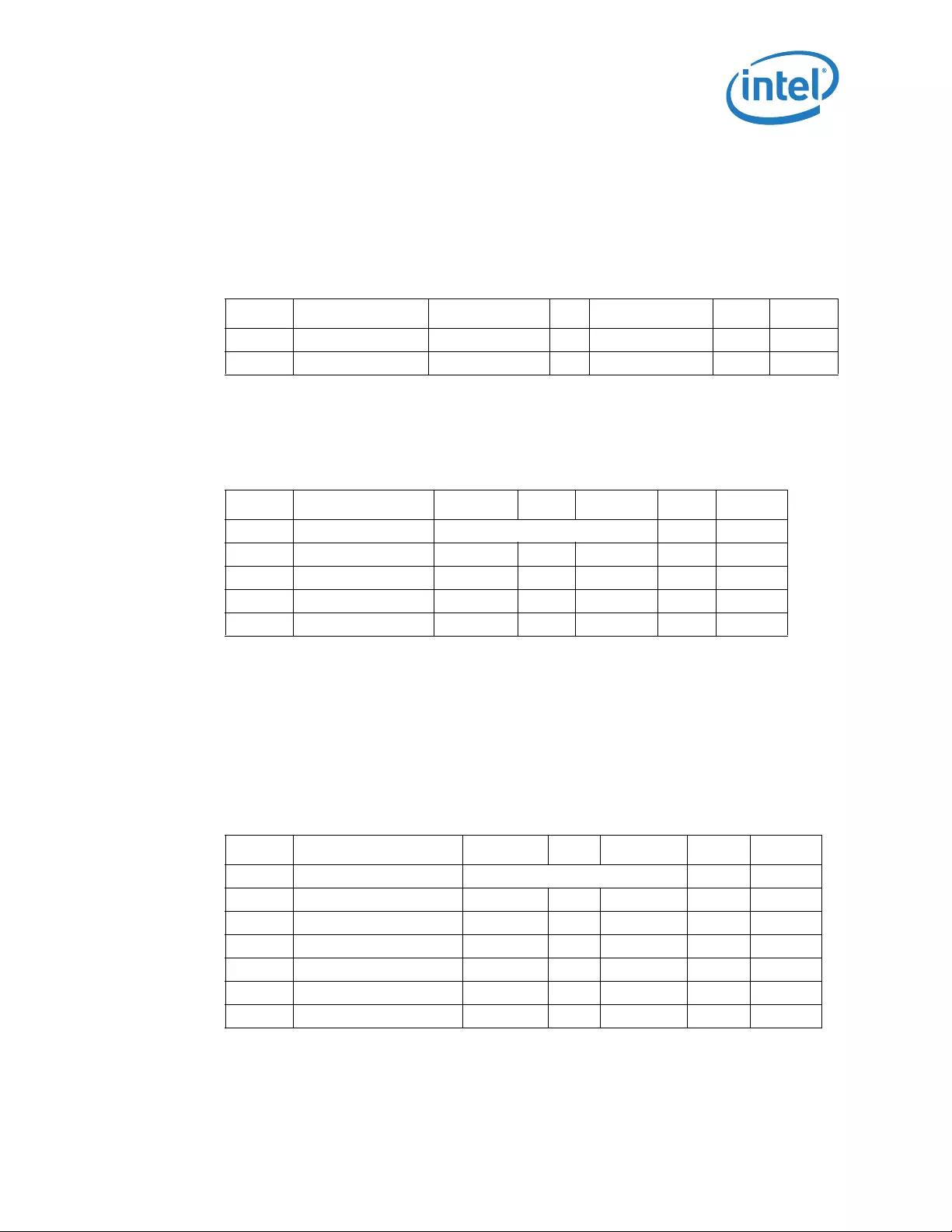
Datasheet 307
Electrical Specifications
NOTES:
1. VIH is defined as the minimum voltage level at a receiving agent that will be interpreted as a
logical high value
2. VIL is defined as the minimum voltage level at a receiving agent that will be interpreted as a
logical low value.
NOTE:
1. ILB_RTC_X1 DC specification is only used for applications with an active external clock source
instead of a crystal. When a crystal is used (typical case) between ILB_RTC_X2 and
ILB_RTC_X1, this spec is not used.
NOTES:
1. VIH is defined as the minimum voltage level at a receiving agent that will be interpreted as a
logical high value
2. VIL is defined as the minimum voltage level at a receiving agent that will be interpreted as a
logical low value.
29.6.15 SVID DC Specification
Table 151. ILB RTC Oscillator Optional DC Specification (ILB_RTC_X1)
Symbol Parameter Min Typ Max Units Notes
VIH Input High Voltage 0.65 0.8 1.2 V 1
VIL Input Low Voltage 0.25 V 1
Table 152. PROCHOT# Signal Group DC Specification
Symbol Parameter Min Typ Max Units Notes
VREF I/O Voltage CORE_V1P0_S4
VIH Input High Voltage 0.8*VREF VREF V1
VIL Input Low Voltage 0.4*VREF V2
VOH Output High Voltage 0.9*VREF VREF V
VOL Output Low Voltage 0.1*VREF V
Table 153. SVID Signal Group DC Specification (SVID_DATA, SVID_CLK, SVID_ALERT#)
Symbol Parameter Min Typ Max Units Notes
VREF I/O Voltage SVID_V1P0_S4
VIH Input High Voltage 0.65*VREF V1
VIL Input Low Voltage 0.44*VREF V1
VOH Output High Voltage V 1
VOL Output Low Voltage 0.1*VREF V 4
VHYS Hysteresis Voltage 0.05 V
RON BUffer on Resistance 10 20 2
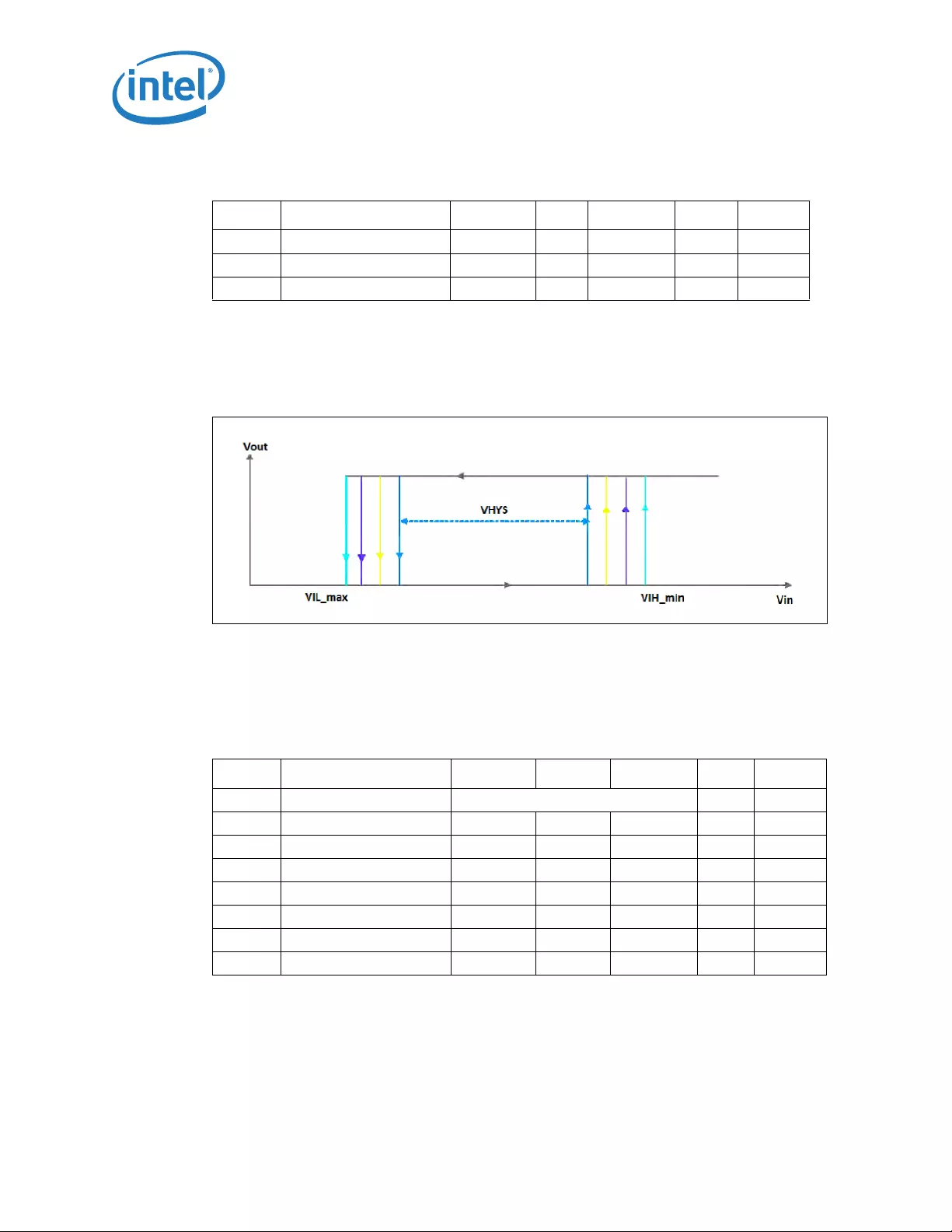
Electrical Specifications
308 Datasheet
NOTES:
1. SVID_V1P0_S4 refers to instantaneous voltage VSS_SENSE
2. Measured at 0.31 * SVID_V1P0_S4
3. VIN between 0V and SVID_V1P0_S4
4. CPAD includes die capacitance only. No package parasitic included.
29.6.16 GPIO DC Specification
GPIO Buffer is used across various interfaces on the SoC such as, GPIOs, I2C, I2S, SPI,
SDIO, SVID, UART, JTAG and ULPI.
ILLeakage Current -100 100 µA 3
CPAD Pad Capacitance 4.0 pF 4
VPIN Pin Capacitance 5.0 pF
Table 153. SVID Signal Group DC Specification (SVID_DATA, SVID_CLK, SVID_ALERT#)
Symbol Parameter Min Typ Max Units Notes
Figure 43. VHYS
Table 154. GPIO 1.8V Core Well Signal Group DC Specification (GPIO_S0_SC[101:0])
Symbol Parameter Min Typ Max Units Notes
VREF I/O Voltage UNCORE_V1P8_S4
VIH Input High Voltage 0.65*VREF V
VIL Input Low Voltage 0.35 * VREF V
VOH Output High Voltage VREF - 0.45 V
VOL Output Low Voltage 0.45 V
VHys Input Hysteresis 0.1 V
ILLeakage Current 5 µA
CLOAD Load Capacitance 2 75 pF
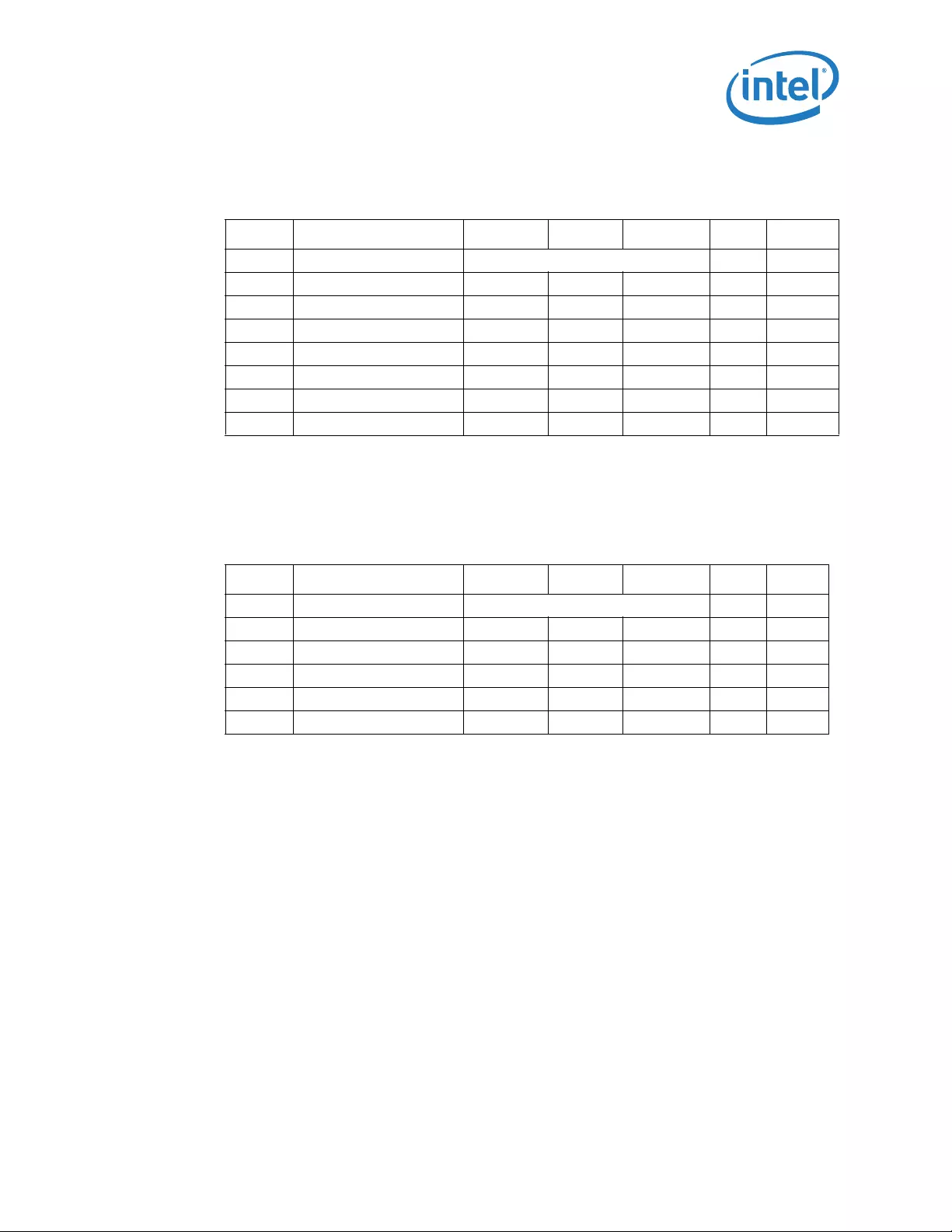
Datasheet 309
Electrical Specifications
29.6.17 SIO - I2C DC Specification
29.6.18 SIO - UART DC Specification
Refer to GPIO Buffer (1.8V) DC Specification, mentioned Section 29.6.16, “GPIO DC
Specification” on page 308
29.6.19 I2S (Audio) DC Specification
Refer to GPIO Buffer (1.8V) DC Specification, mentioned Section 29.6.16, “GPIO DC
Specification” on page 308
§
Table 155. GPIO 1.8V Suspend Well Signal Group DC Specification (GPIO_S5[43:0])
Symbol Parameter Min Typ Max Units Notes
VREF I/O Voltage PMC_V1P8_G3 V
VIH Input High Voltage 0.65*VREF V
VIL Input Low Voltage 0.35*VREF V
VOH Output High Voltage VREF - 0.45 V
VOL Output Low Voltage 0.45 V
VHys Input Hysteresis 0.1 V
ILLeakage Current 5 µA
CLOAD Load Capacitance 2 75 pF
Table 156. I2C Signal Electrical Specifications
Symbol Parameter Min Typ Max Units Notes
VREF I/O Voltage SIO_V1P8_S4 V
VIH Input High Voltage 0.7 * VREF V
VIL Input Low Voltage 0.3 * VREF V
VOL Output Low Voltage 0.2 * VREF V
VHys Input Hysteresis 0.1 V
CPIN Pin Capacitance 2 5 pF
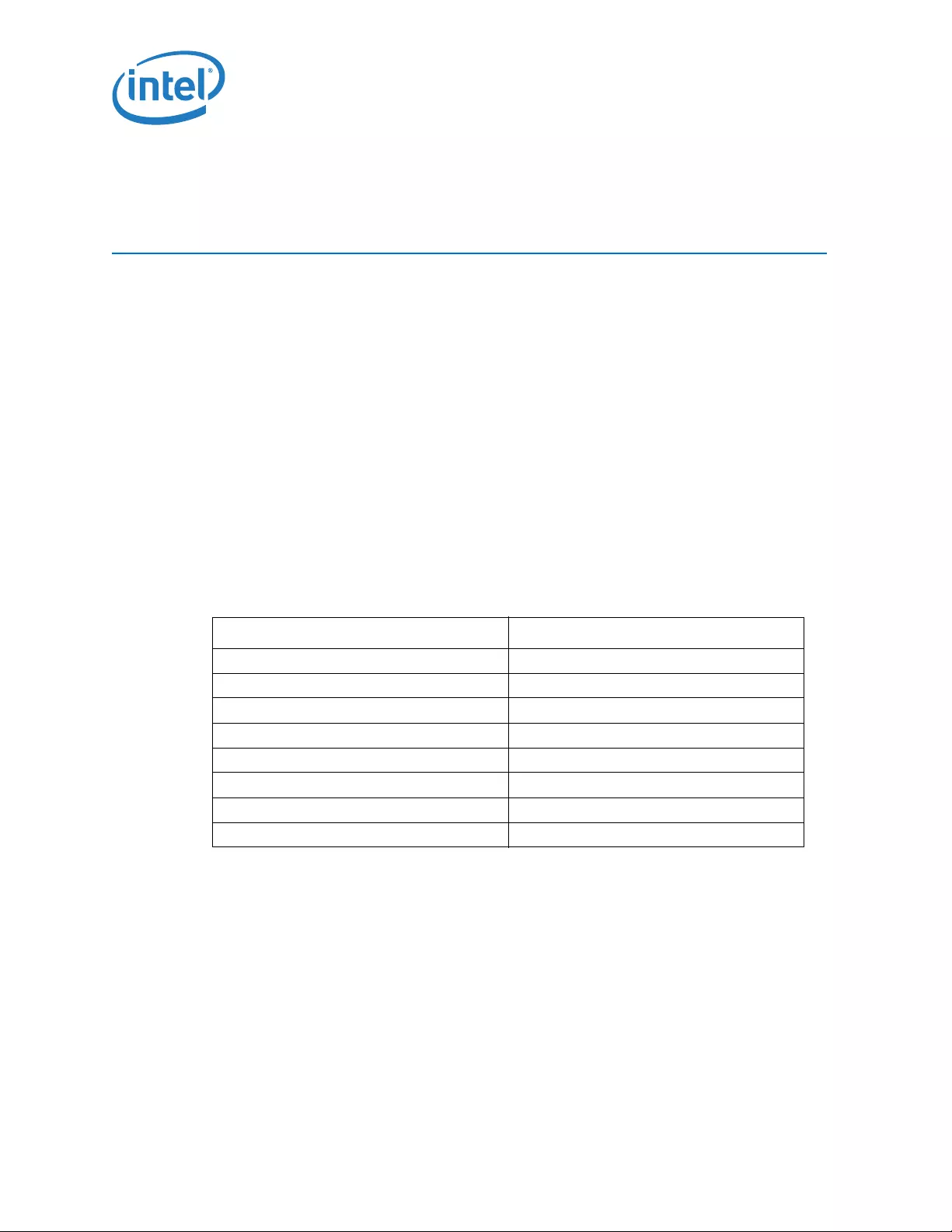
Ballout and Package Information
310 Datasheet
30 Ballout and Package
Information
30.1 Type 4 SoC
The SoC comes in a 17mm x 17 mm Flip-Chip Ball Grid Array (FCBGA) package and
consists of a silicon die mounted face down on an organic substrate populated with
1380 solder balls on the bottom side. Capacitors may be placed in the area surrounding
the die. Because the die-side capacitors are electrically conductive, and only slightly
shorter than the die height, care should be taken to avoid contacting the capacitors
with electrically conductive materials. Doing so may short the capacitors and possibly
damage the device or render it inactive.
The use of an insulating material between the capacitors and any thermal solution
should be considered to prevent capacitor shorting. An exclusion, or keep out zone,
surrounds the die and capacitors, and identifies the contact area for the package. Care
should be taken to avoid contact with the package inside this area.
30.1.1 SoC Attributes
Attribute SoC
X-Y dimensions (mm) 17mm X 17mm
CPU Core Process (nm) 22
Pre - SMT Height (mm) 0.774
Post - SMT Height (mm) 0.8
Minimum BGA Ball Pitch (mm) 0.4
Die Thickness (um) 370
Total Pin Count 1380
Package Type FCBGA13
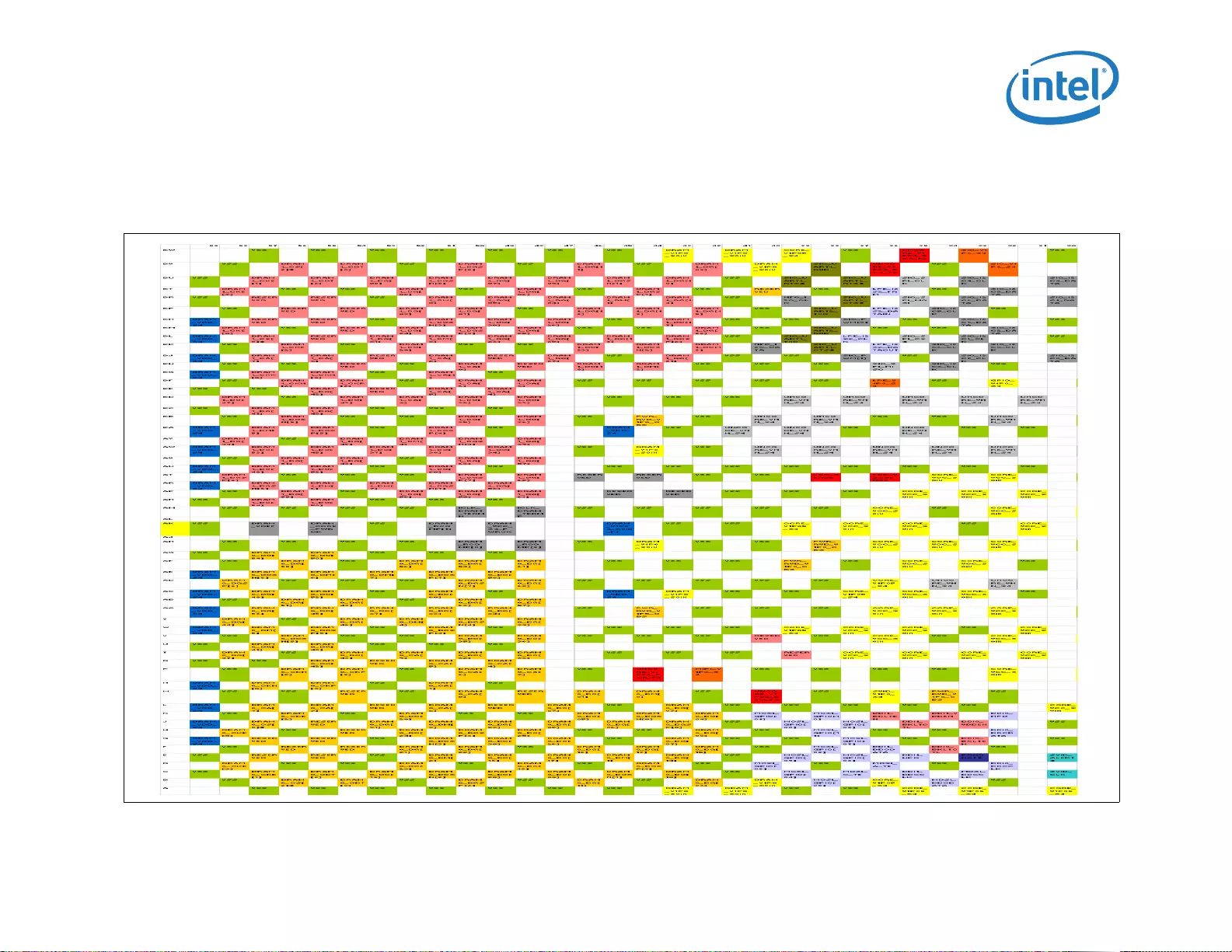
Ballout and Package Information
311 Datasheet
30.1.2 Ballout
Figure 44. Type 4 Pin Location (Top View, Center) - Part A
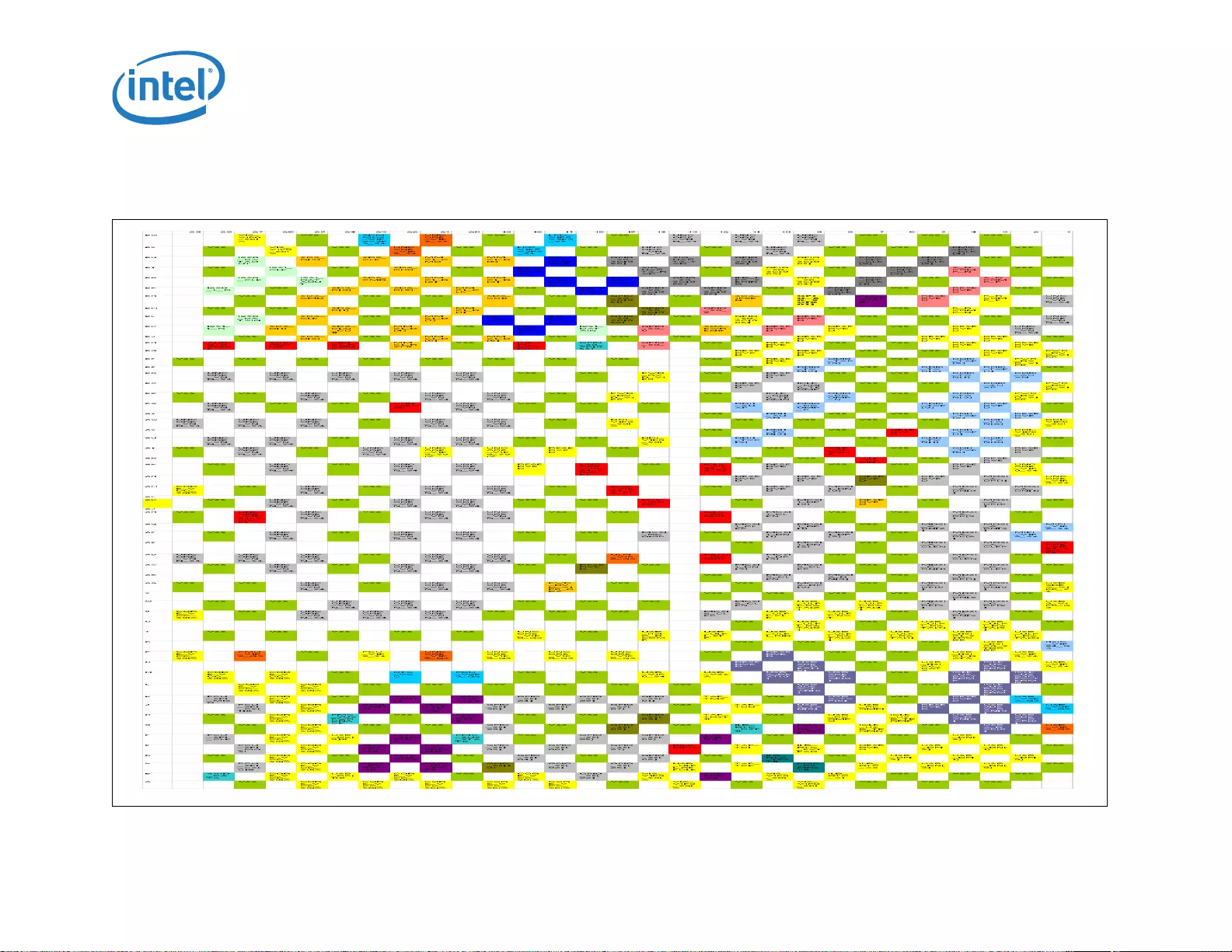
Ballout and Package Information
Datasheet 312
Figure 45. Type 4 Pin Location (Top View, Center) - Part B
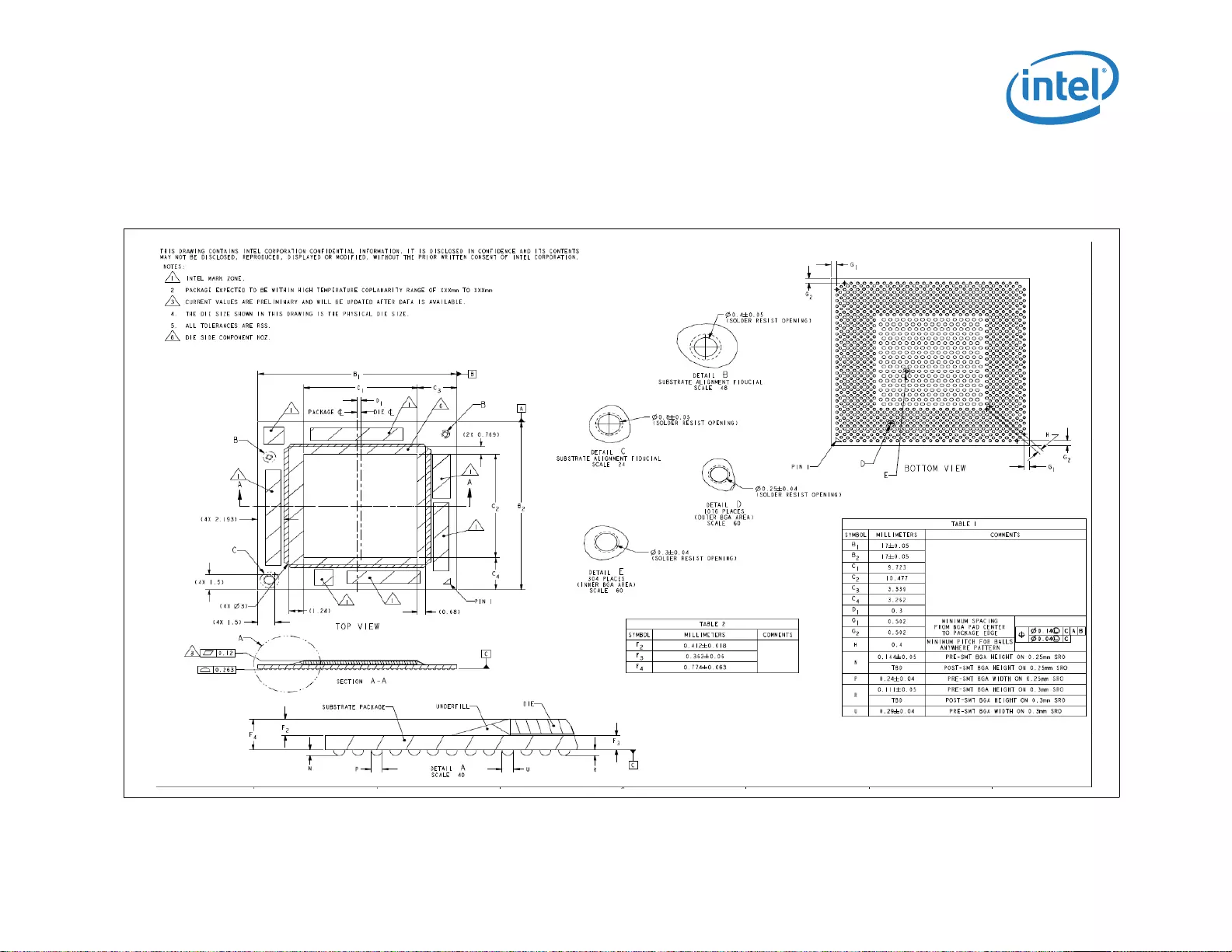
Ballout and Package Information
313 Datasheet
30.1.3 Package Diagrams
Figure 46. Type 4 Package Mechanical Drawing
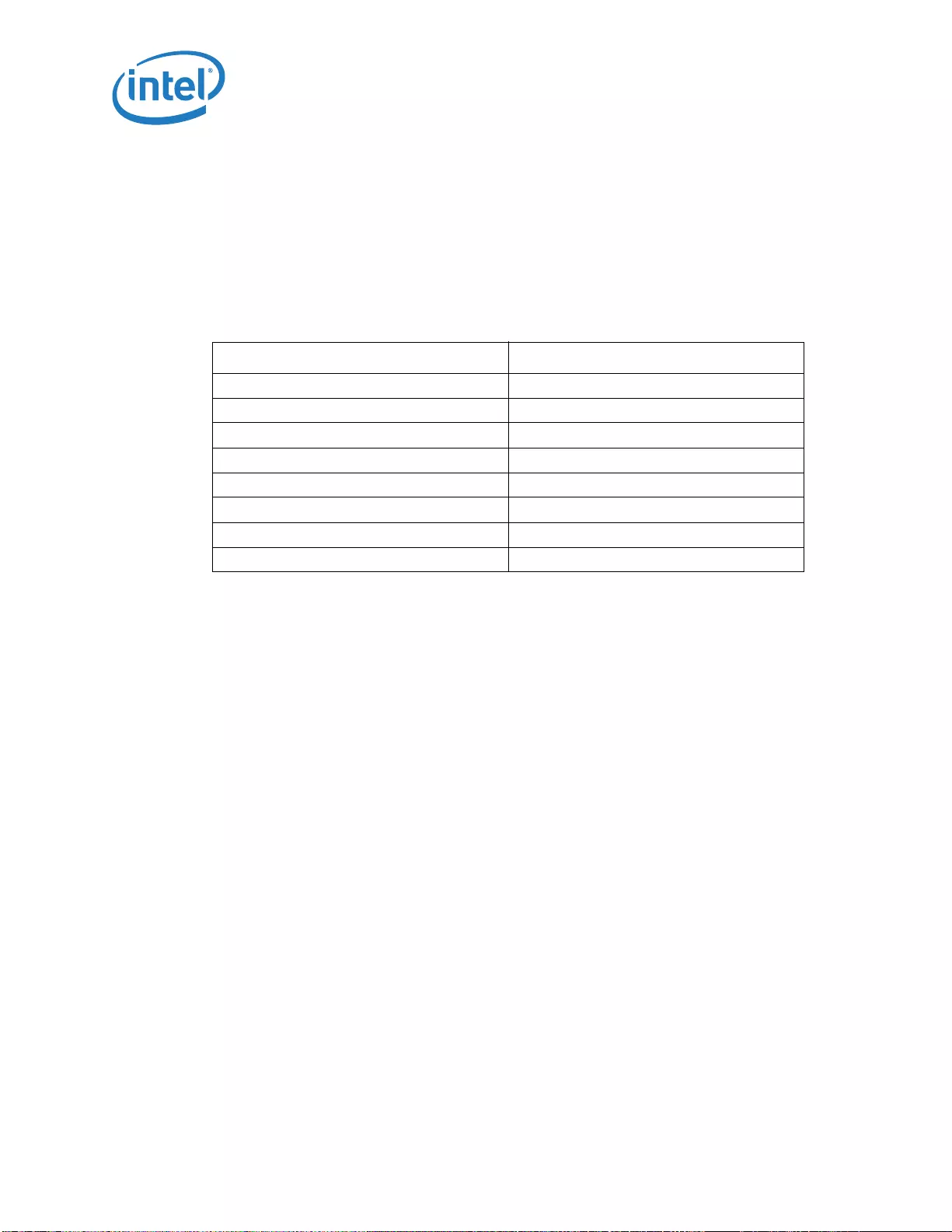
Ballout and Package Information
314 Datasheet
30.2 Type 3 SoC
The SoC comes in a 17 mm x 17 mm Flip-Chip Ball Grid Array (FCBGA) package and
consists of a silicon die mounted face down on an organic substrate populated with 592
solder balls on the bottom side.
30.2.1 SoC Attributes
Attribute SoC
X-Y dimensions (mm) 17mm X 17mm
SoC Core Process (nm) 22
Pre - SMT Height (mm) 0.774
Post - SMT Height (mm) 0.8
Minimum BGA Ball Pitch (mm) 0.65
Die Thickness (um) 370
Total Pin Count 592
Package Type FCBGA UTC
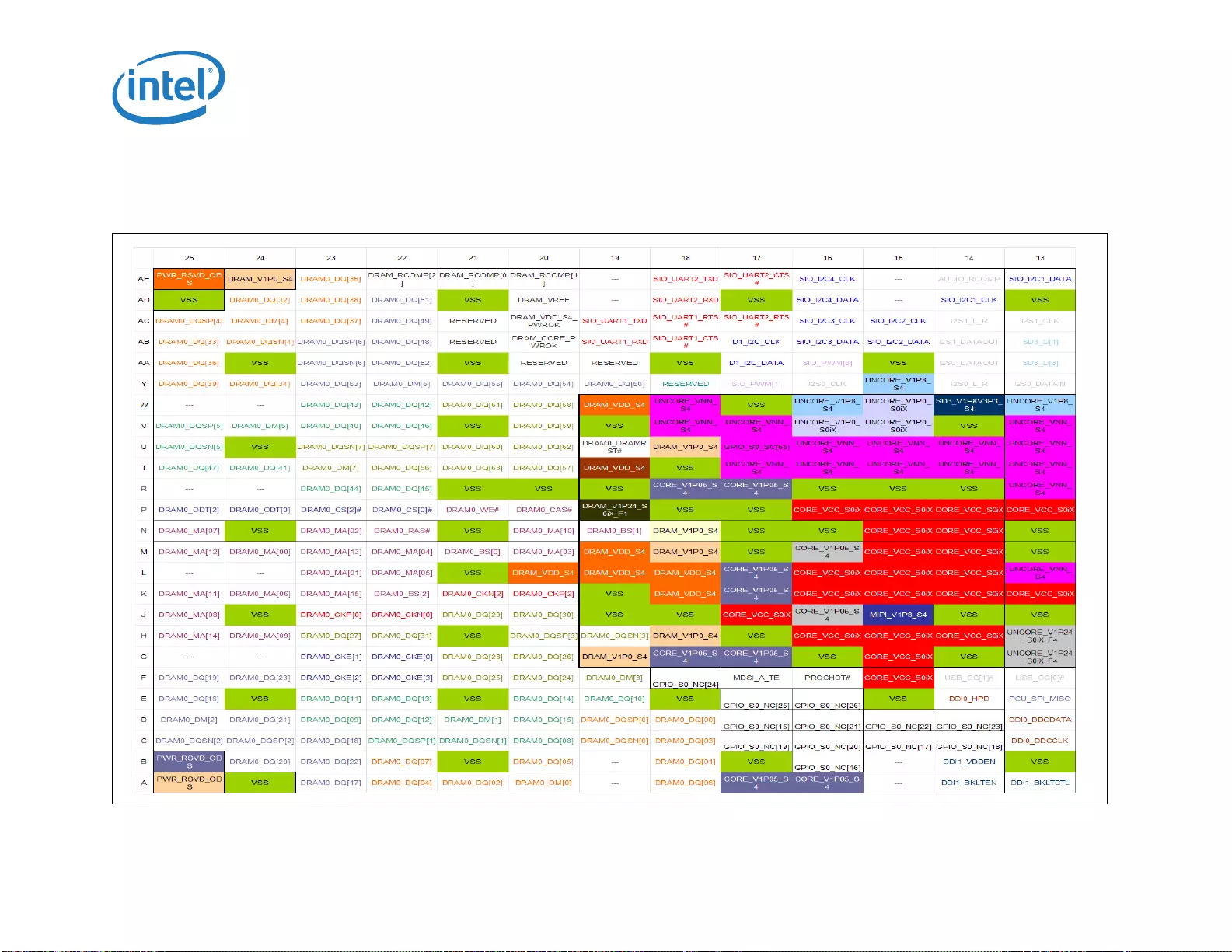
Ballout and Package Information
Datasheet 315
30.2.2 Ballout
Figure 47. Type 3 Pin Location (Top View, Center) - Part A
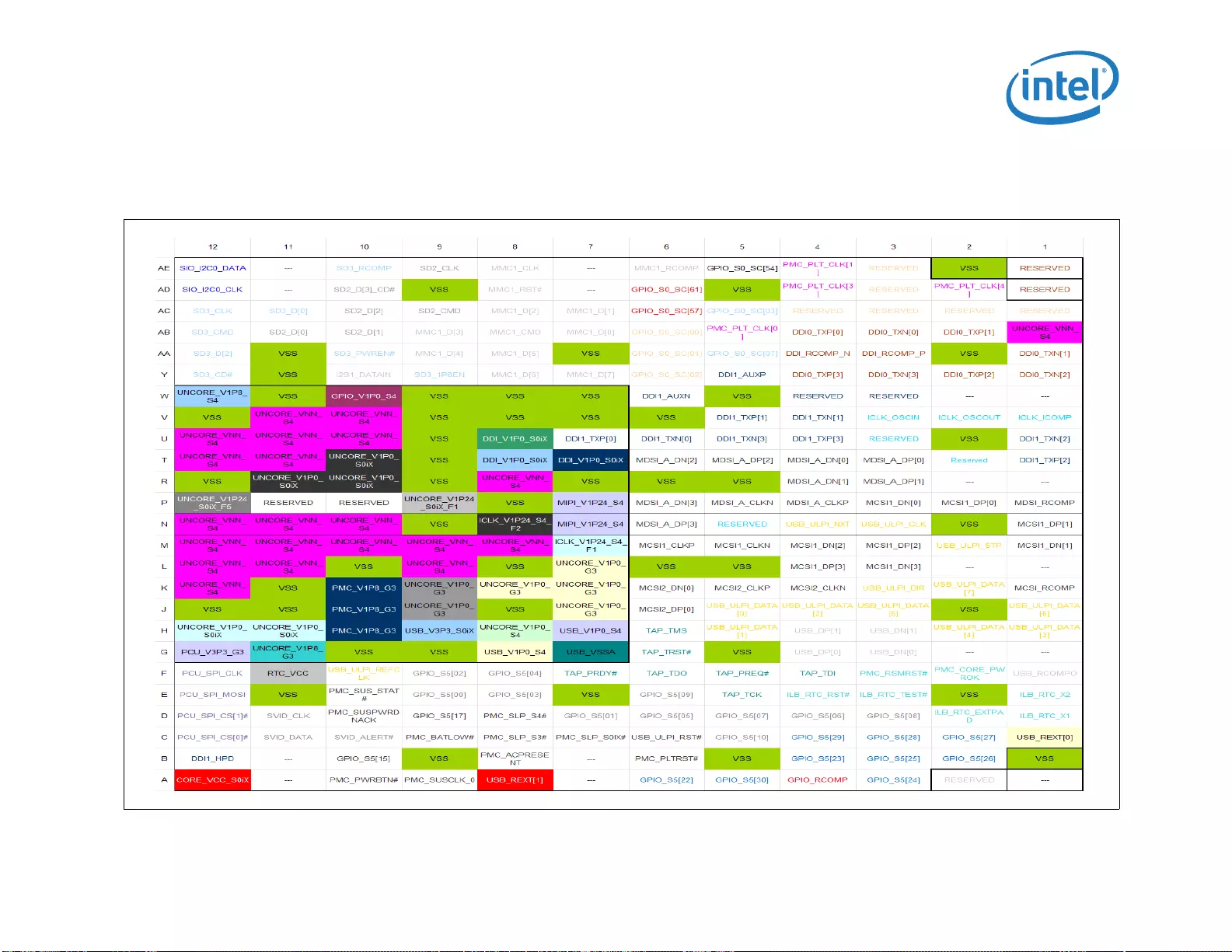
Ballout and Package Information
316 Datasheet
Figure 48. Type 3 Pin Location (Top View, Center) - Part B
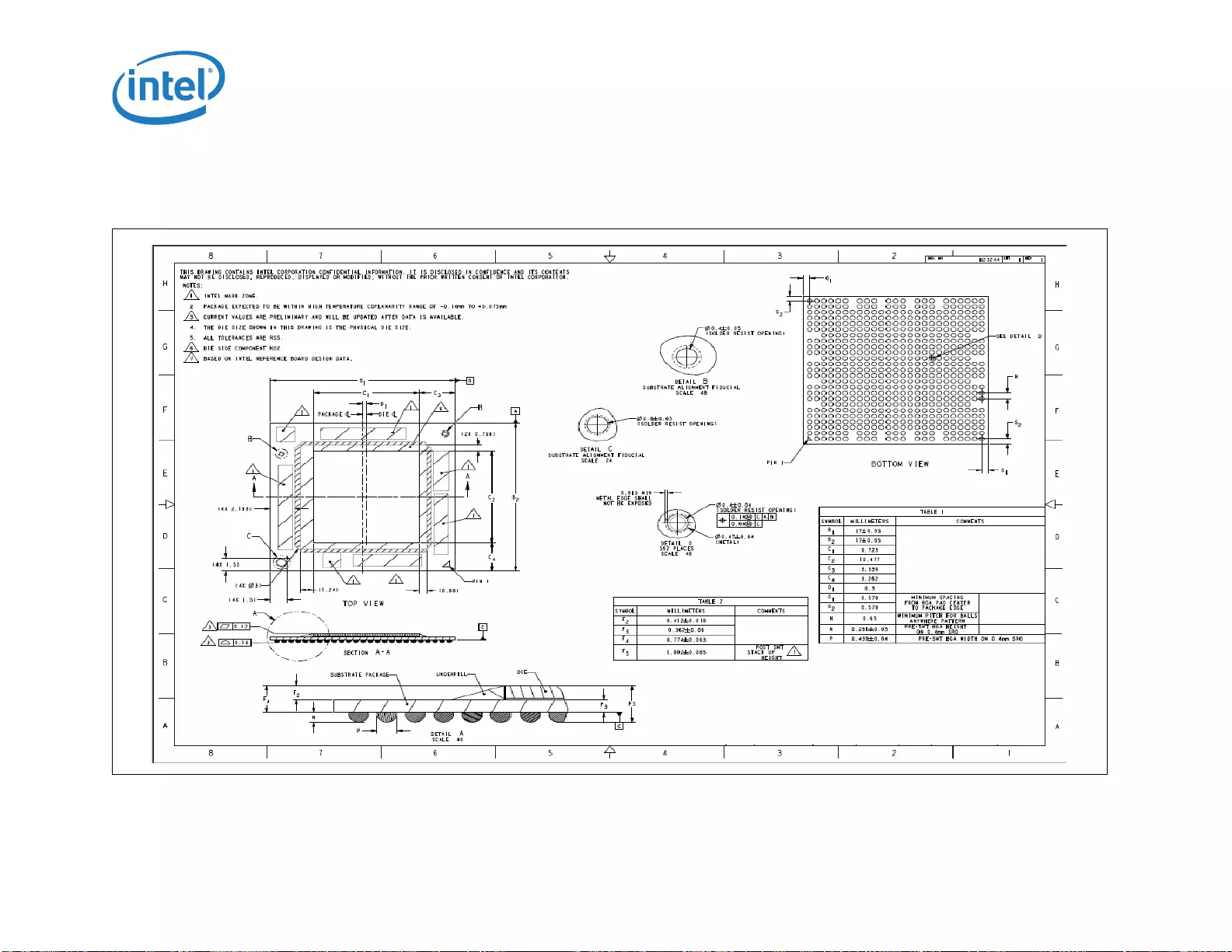
Ballout and Package Information
Datasheet 317
30.2.3 Package Diagrams
Figure 49. Type 3 Package Mechanical Drawing
§
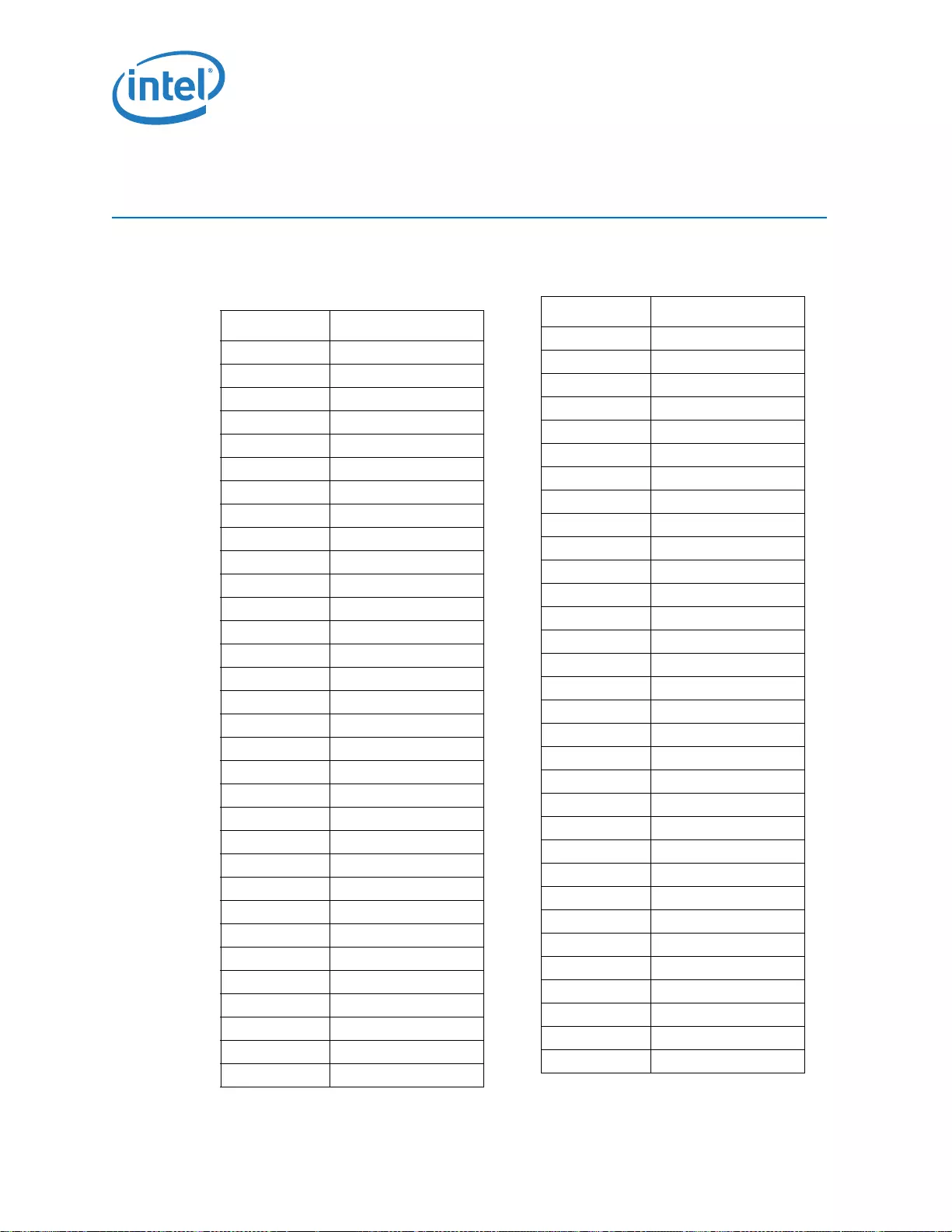
SoC Pin Location
318 Datasheet
31 SoC Pin Location
31.1 Type 4 SoC - Pin List Location
Ball # Customer Name
A11 VSS
A13 VIS_V1P0_S0iX
A15 VSS
A17 CORE_VCC_S0iX
A19 CORE_VCC_S0iX
A21 CORE_VCC_S0iX
A23 CORE_VCC_S0iX
A25 CORE_VCC_S0iX
A27 VSS
A3 VSS
A30 CORE_V1P05_S4
A33 CORE_V1P05_S4
A35 CORE_V1P05_S4
A37 VSS
A39 VSS
A41 DRAM_V1P0_S0iX
A43 DRAM_V1P0_S0iX
A45 VSS
A47 VSS
A49 VSS
A5 VSS
A51 VSS
A53 VSS
A55 VSS
A57 VSS
A7 VSS
A9 VIS_V1P0_S0iX
AA1 USB3DEV_V1P0_S4
AA11 VSS
AA15 VSS
AA17 PWR_RVD_V1P0_OBS
AA19 UNCORE_VNN_S4
AA21 UNCORE_VNN_S4
AA23 VSS
AA25 UNCORE_VNN_S4
AA27 VSS
AA29 VSS
AA3 MDSI_C_DN[0]
AA32 CORE_VCC_S0iX
AA34 CORE_VCC_S0iX
AA36 CORE_VCC_S0iX
AA38 VSS
AA40 VSS
AA42 VSS
AA44 PWR_RVD_V1P5_OBS
AA46 VSS
AA49 DRAM0_DQ[34]
AA5 MDSI_C_DP[0]
AA51 DRAM0_DQ[38]
AA53 DRAM0_DQ[37]
AA55 DRAM0_DQ[45]
AA57 DRAM0_DQ[53]
AA59 DRAM_VDD_S4
AA7 VSS
AA9 MCSI2_DP[0]
AB10 MCSI3_CLKN
AB12 VSS
AB2 VSS
AB4 MDSI_C_DP[1]
AB48 DRAM0_DQ[57]
AB50 DRAM0_DQ[63]
AB52 VSS
AB54 DRAM0_DQ[48]
AB56 DRAM0_DQ[51]
Ball # Customer Name
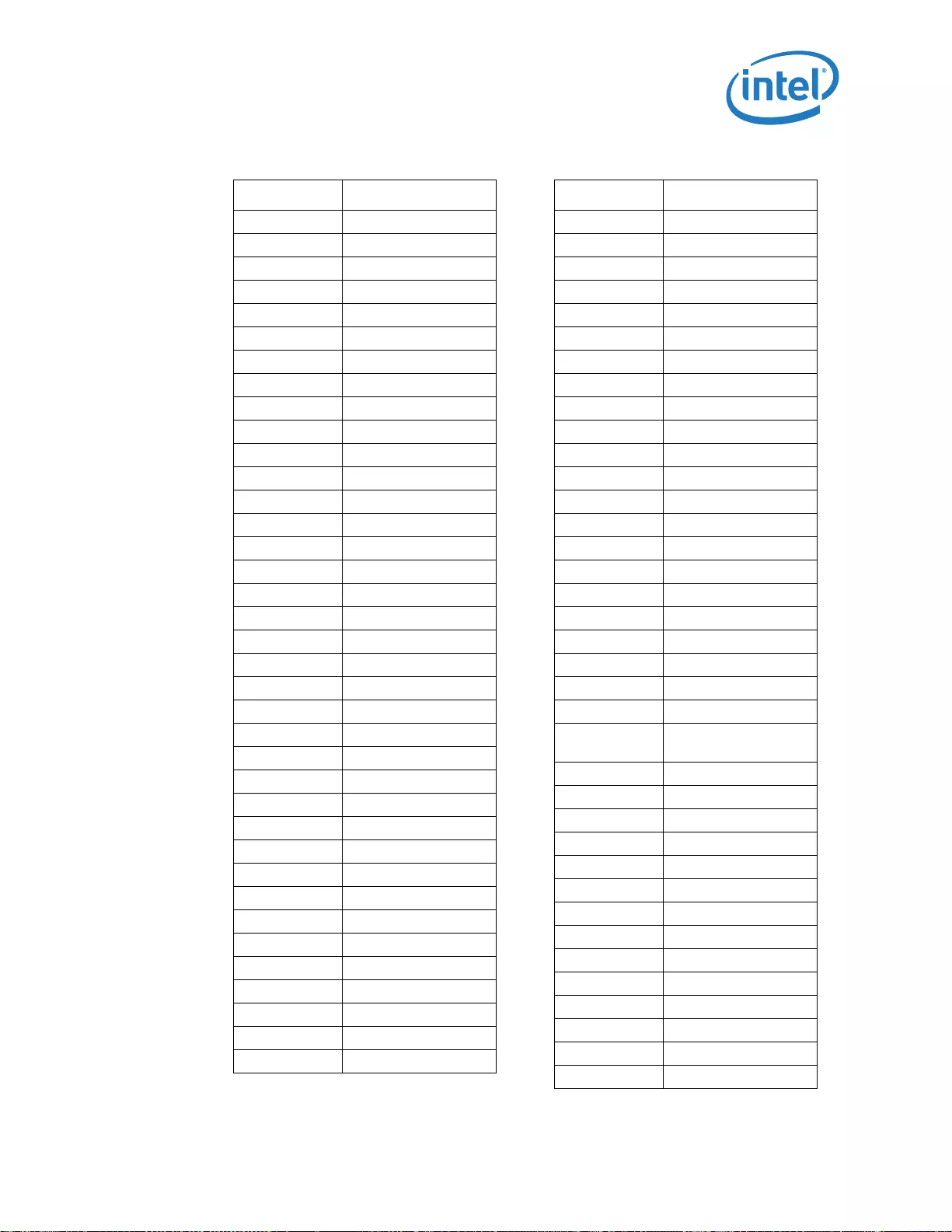
Datasheet 319
SoC Pin Location
AB58 VSS
AB6 VSS
AB8 MCSI2_DN[0]
AC1 VSS
AC11 MCSI1_DN[3]
AC14 VSS
AC16 RESERVED
AC18 VSS
AC20 UNCORE_VNN_S4
AC22 UNCORE_VNN_S4
AC24 VSS
AC26 UNCORE_VNN_S4
AC28 VSS
AC3 MDSI_C_CLKP
AC31 VSS
AC33 CORE_VCC_S0iX
AC35 CORE_VCC_S0iX
AC37 CORE_V1P05_S4
AC39 VSS
AC41 VSS
AC43 DRAM_V1P0_S0iX
AC45 DRAM_VDD_S4
AC49 VSS
AC5 MDSI_C_DN[1]
AC51 DRAM0_DQ[60]
AC53 VSS
AC55 DRAM0_DQ[52]
AC57 DRAM0_DQ[49]
AC59 DRAM_VDD_S4
AC7 VSS
AC9 MCSI3_CLKP
AD10 MCSI1_DP[3]
AD12 MDSI_RCOMP
AD15 ULPI_V1P8_G3
AD17 VSS
AD19 UNCORE_VNN_S4
AD2 VSS
Ball # Customer Name
AD21 UNCORE_VNN_S4
AD23 VSS
AD25 UNCORE_VNN_S4
AD27 UNCORE_VNN_S4
AD29 UNCORE_VNN_S4
AD32 UNCORE_VNN_S4
AD34 UNCORE_VNN_S4
AD36 CORE_V1P05_S4
AD38 VSS
AD4 MDSI_C_CLKN
AD40 VSS
AD42 VSS
AD44 VSS
AD46 VSS
AD48 DRAM0_DQ[62]
AD50 DRAM0_DQSN[7]
AD52 VSS
AD54 VSS
AD56 VSS
AD58 DRAM0_DQSP[6]
AD6 VSS
AD8 VSS
AE1 UNCORE_V1P24_S0iX
_F6
AE11 VSS
AE3 MDSI_A_CLKP
AE49 DRAM0_DQ[58]
AE5 MDSI_A_CLKN
AE51 DRAM0_DQSP[7]
AE53 DRAM0_DM[7]
AE55 DRAM0_DM[6]
AE57 DRAM0_DQSN[6]
AE59 DRAM_VDD_S4
AE7 VSS
AE9 MCSI1_DN[2]
AF10 MCSI1_DN[1]
AF12 VSS
AF14 MCSI_RCOMP
Ball # Customer Name
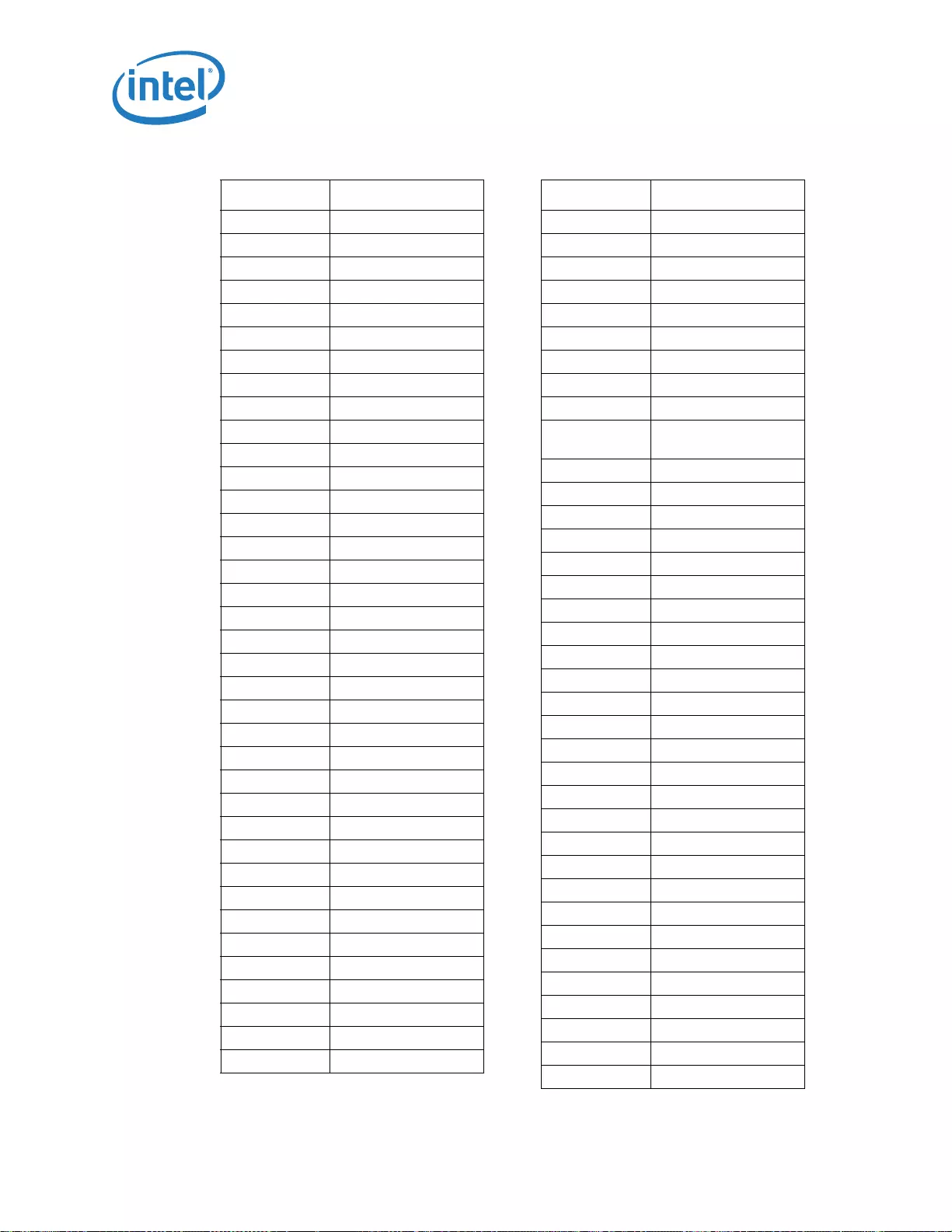
SoC Pin Location
320 Datasheet
AF16 VSS
AF18 VSS
AF2 MIPI_V1P2_S4
AF20 UNCORE_VNN_S4
AF22 UNCORE_VNN_S4
AF24 VSS
AF26 UNCORE_VNN_S4
AF28 VSS
AF31 VSS
AF33 CORE_VCC_S0iX
AF35 CORE_VCC_S0iX
AF37 VSS
AF39 PWR_RVD_V1P0_OBS
AF4 MDSI_A_DP[2]
AF41 VSS
AF43 VSS
AF45 VSS
AF48 DRAM0_DQ[61]
AF50 DRAM0_DQ[59]
AF52 DRAM0_DQ[56]
AF54 VSS
AF56 DRAM0_DQ[55]
AF58 VSS
AF6 VSS
AF8 MCSI1_DP[2]
AG1 MIPI_V1P2_S4
AG11 MCSI1_CLKP
AG3 MDSI_A_DN[3]
AG49 VSS
AG5 MDSI_A_DN[2]
AG51 VSS
AG53 VSS
AG55 DRAM0_DQ[50]
AG57 DRAM0_DQ[54]
AG59 VSS
AG7 VSS
AG9 MCSI1_DP[1]
Ball # Customer Name
AH10 MCSI1_CLKN
AH12 ICLK_RCOMP
AH15 VSS
AH17 VSS
AH19 UNCORE_VNN_S4
AH2 VSS
AH21 UNCORE_VNN_S4
AH23 VSS
AH25 UNCORE_VNN_S4
AH27 UNCORE_V1P24_S0iX
_F5
AH29 VSS
AH32 CORE_VCC_S0iX
AH34 CORE_VCC_S0iX
AH36 CORE_VCC_S0iX
AH38 PWR_RVD_V1P0_OBS
AH4 MDSI_A_DP[3]
AH40 VSS
AH42 VSS
AH44 DRAM_V1P0_S0iX
AH46 VSS
AH48 DRAM_RCOMP[2]
AH50 DRAM_RCOMP[0]
AH52 VSS
AH54 VSS
AH56 VSS
AH58 VSS
AH6 VSS
AH8 VSS
AK1 VSS
AK11 VSS
AK14 ICLK_ICOMP
AK16 VSS
AK18 VSS
AK20 UNCORE_VNN_S4
AK22 UNCORE_VNN_S4
AK24 VSS
AK26 UNCORE_VNN_S4
Ball # Customer Name
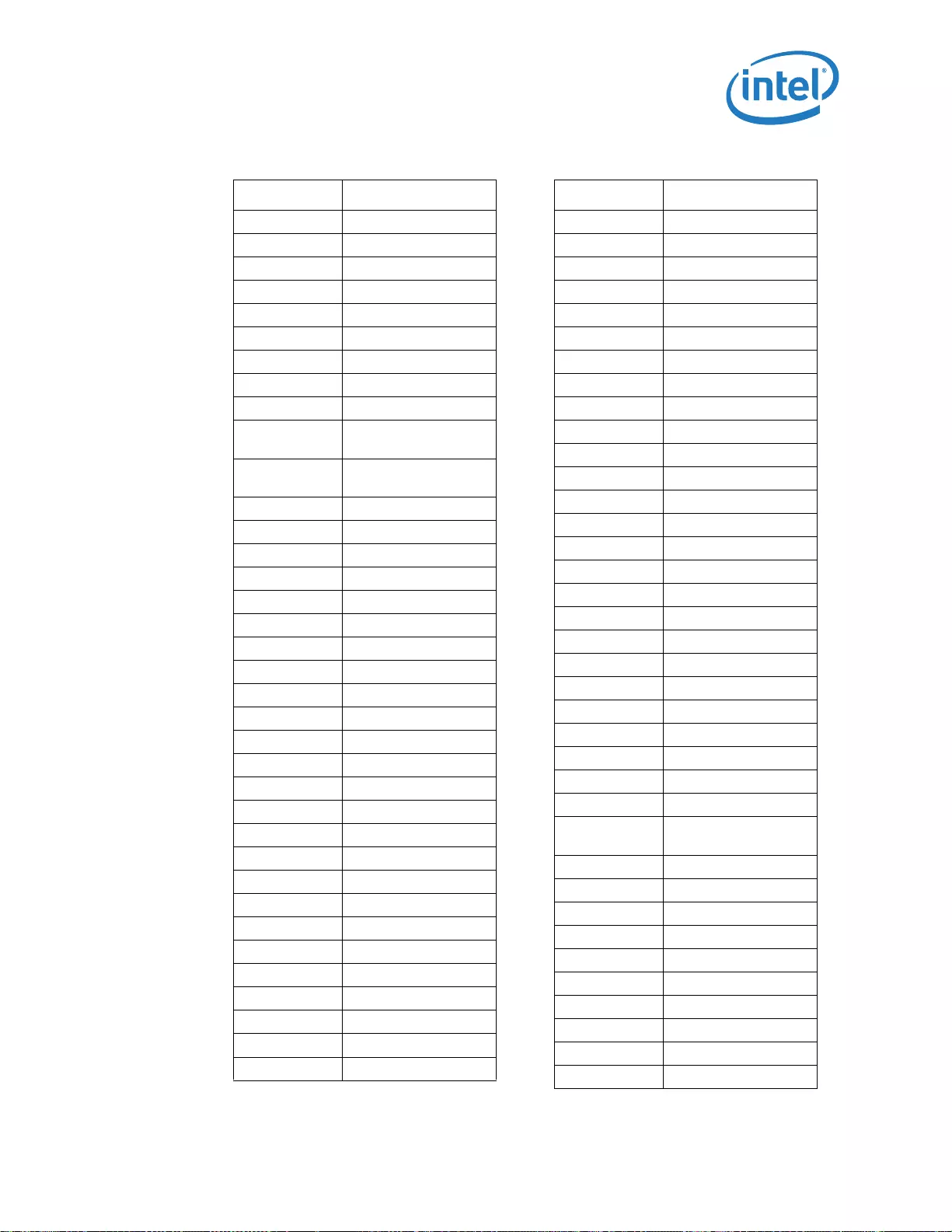
Datasheet 321
SoC Pin Location
AK28 VSS
AK3 MDSI_A_DP[0]
AK31 CORE_VCC_S0iX
AK33 VSS
AK35 CORE_VCC_S0iX
AK37 CORE_VCC_S0iX
AK39 CORE_V1P05_S4
AK41 VSS
AK43 VSS
AK45 DRAM_V1P24_S0IX_F
1
AK49 DRAM_VCC_S4_PWRO
K
AK5 VSS
AK51 DRAM_RCOMP[1]
AK53 VSS
AK55 DRAM_CORE_PWROK
AK57 DRAM_VREF
AK59 VSS
AK7 RESERVED
AK9 MCSI1_DP[0]
AM10 RESERVED
AM12 VSS
AM15 ICLK_V1P24_S4_F1
AM17 VSS
AM19 UNCORE_VNN_S4
AM2 MDSI_A_DN[1]
AM21 UNCORE_VNN_S4
AM23 VSS
AM25 UNCORE_VNN_S4
AM27 VSS
AM29 CORE_VCC_S0iX
AM32 CORE_VCC_S0iX
AM34 VSS
AM36 CORE_VCC_S0iX
AM38 VSS
AM4 MDSI_A_DN[0]
AM40 VSS
Ball # Customer Name
AM42 VSS
AM44 VSS
AM46 VSS
AM48 ICLK_DRAM_TERMP
AM50 ICLK_DRAM_TERMN
AM52 VSS
AM54 VSS
AM56 VSS
AM58 VSS
AM6 VSS
AM8 MCSI1_DN[0]
AN1 UNCORE_V1P0_S4
AN11 RESERVED
AN3 MDSI_A_DP[1]
AN49 VSS
AN5 RESERVED
AN51 VSS
AN53 VSS
AN55 DRAM1_DQ[50]
AN57 DRAM1_DQ[54]
AN59 VSS
AN7 RESERVED
AN9 RESERVED
AP10 RESERVED
AP12 ICLK_V1P24_S4_F2
AP14 VSS
AP16 UNCORE_V1P24_S0iX
_F1
AP18 RESERVED
AP2 UNCORE_V1P0_S4
AP20 UNCORE_VNN_S4
AP22 UNCORE_VNN_S4
AP24 VSS
AP26 UNCORE_VNN_S4
AP28 VSS
AP31 CORE_VCC_S0iX
AP33 CORE_VCC_S0iX
AP35 CORE_VCC_S0iX
Ball # Customer Name
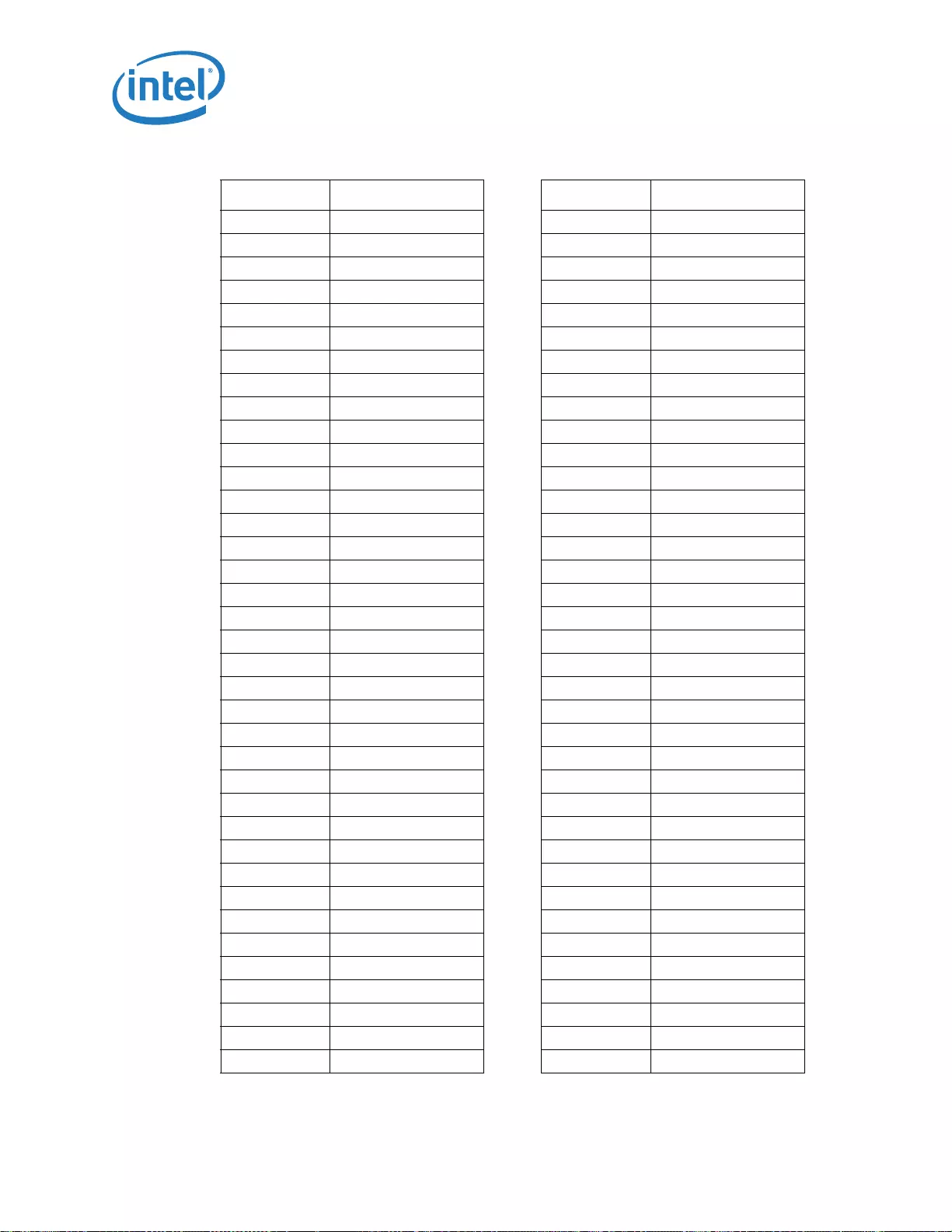
SoC Pin Location
322 Datasheet
AP37 VSS
AP39 VSS
AP4 RESERVED
AP41 VSS
AP43 RESERVED
AP45 RESERVED
AP48 DRAM1_DQ[61]
AP50 DRAM1_DQ[59]
AP52 DRAM1_DQ[56]
AP54 VSS
AP56 DRAM1_DQ[55]
AP58 VSS
AP6 VSS
AP8 VSS
AR1 VSS
AR11 VSS
AR3 RESERVED
AR49 DRAM1_DQ[58]
AR5 VSS
AR51 DRAM1_DQSN[7]
AR53 DRAM1_DM[7]
AR55 DRAM1_DM[6]
AR57 DRAM1_DQSN[6]
AR59 DRAM_VDD_S4
AR7 ICLK_OSCIN
AR9 VSS
AT10 VSS
AT12 VSS
AT15 VSS
AT17 RESERVED
AT19 UNCORE_V1P0_S0iX
AT2 RESERVED
AT21 UNCORE_V1P0_S0iX
AT23 UNCORE_VNN_S4
AT25 VSS
AT27 UNCORE_VNN_S4
AT29 VSS
Ball # Customer Name
AT32 CORE_VCC_S0iX
AT34 CORE_VCC_S0iX
AT36 VCC_VSSSENSE
AT38 VCC_SENSE
AT4 DDI1_TXP[0]
AT40 VSS
AT42 VSS
AT44 RESERVED
AT46 RESERVED
AT48 DRAM1_DQ[62]
AT50 DRAM1_DQSP[7]
AT52 VSS
AT54 VSS
AT56 VSS
AT58 DRAM1_DQSP[6]
AT6 VSS
AT8 ICLK_OSCOUT
AU1 VSS
AU11 DDI1_TXP[3]
AU14 DDI_V1P0_S0iX
AU16 VSS
AU18 VSS
AU20 UNCORE_VNN_S4
AU22 UNCORE_VNN_S4
AU24 VSS
AU26 UNCORE_VNN_S4
AU28 UNCORE_VNN_S4
AU3 DDI1_TXN[0]
AU31 VSS
AU33 VSS
AU35 VSS
AU37 VSS
AU39 VSS
AU41 VSS
AU43 VSS
AU45 VSS
AU49 VSS
Ball # Customer Name

Datasheet 323
SoC Pin Location
AU5 DDI1_TXN[1]
AU51 DRAM1_DQ[60]
AU53 VSS
AU55 DRAM1_DQ[52]
AU57 DRAM1_DQ[49]
AU59 DRAM_VDD_S4
AU7 VSS
AU9 VSS
AV10 DDI1_TXN[3]
AV12 VSS
AV2 DDI_V1P0_S0iX
AV4 DDI1_TXP[1]
AV48 DRAM1_DQ[57]
AV50 DRAM1_DQ[63]
AV52 VSS
AV54 DRAM1_DQ[48]
AV56 DRAM1_DQ[51]
AV58 VSS
AV6 RESERVED
AV8 VSS
AW1 DDI_V1P0_S0iX
AW11 VSS
AW15 DDI_V1P0_S0iX
AW17 VSS
AW19 UNCORE_VNN_S4
AW21 UNCORE_VNN_S4
AW23 VSS
AW25 UNCORE_VNN_S4
AW27 UNCORE_VNN_S4
AW29 UNCORE_VNN_S4
AW3 DDI1_TXN[2]
AW32 UNCORE_VNN_S4
AW34 UNCORE_VNN_S4
AW36 UNCORE_VNN_S4
AW38 UNCORE_VNN_S4
AW40 UNCORE_VNN_S4
AW42 VSS
Ball # Customer Name
AW44 DRAM_V1P0_S0iX
AW46 VSS
AW49 DRAM1_DQ[34]
AW5 VSS
AW51 DRAM1_DQ[38]
AW53 DRAM1_DQ[37]
AW55 DRAM1_DQ[45]
AW57 DRAM1_DQ[53]
AW59 DRAM_VDD_S4
AW7 VSS
AW9 VSS
AY10 DDI1_AUXN
AY12 VSS
AY2 RESERVED
AY4 DDI1_TXP[2]
AY48 DRAM1_DQ[39]
AY50 DRAM1_DQSN[4]
AY52 DRAM1_DM[4]
AY54 DRAM1_DQ[46]
AY56 VSS
AY58 DRAM1_DQ[44]
AY6 VSS
AY8 VSS
B10 VIS_V1P0_S0iX
B12 TAP_PRDY#
B14 VIS_V1P0_S0iX
B16 GPIO_S5[22]
B18 CORE_VCC_S0iX
B2 VSS
B20 VSS
B22 CORE_VCC_S0iX
B24 USB_OC[1]#
B26 CORE_VCC_S0iX
B28 SVID_DATA
B32 VSS
B34 MDSI_DDCDATA
B36 CORE_V1P05_S4
Ball # Customer Name
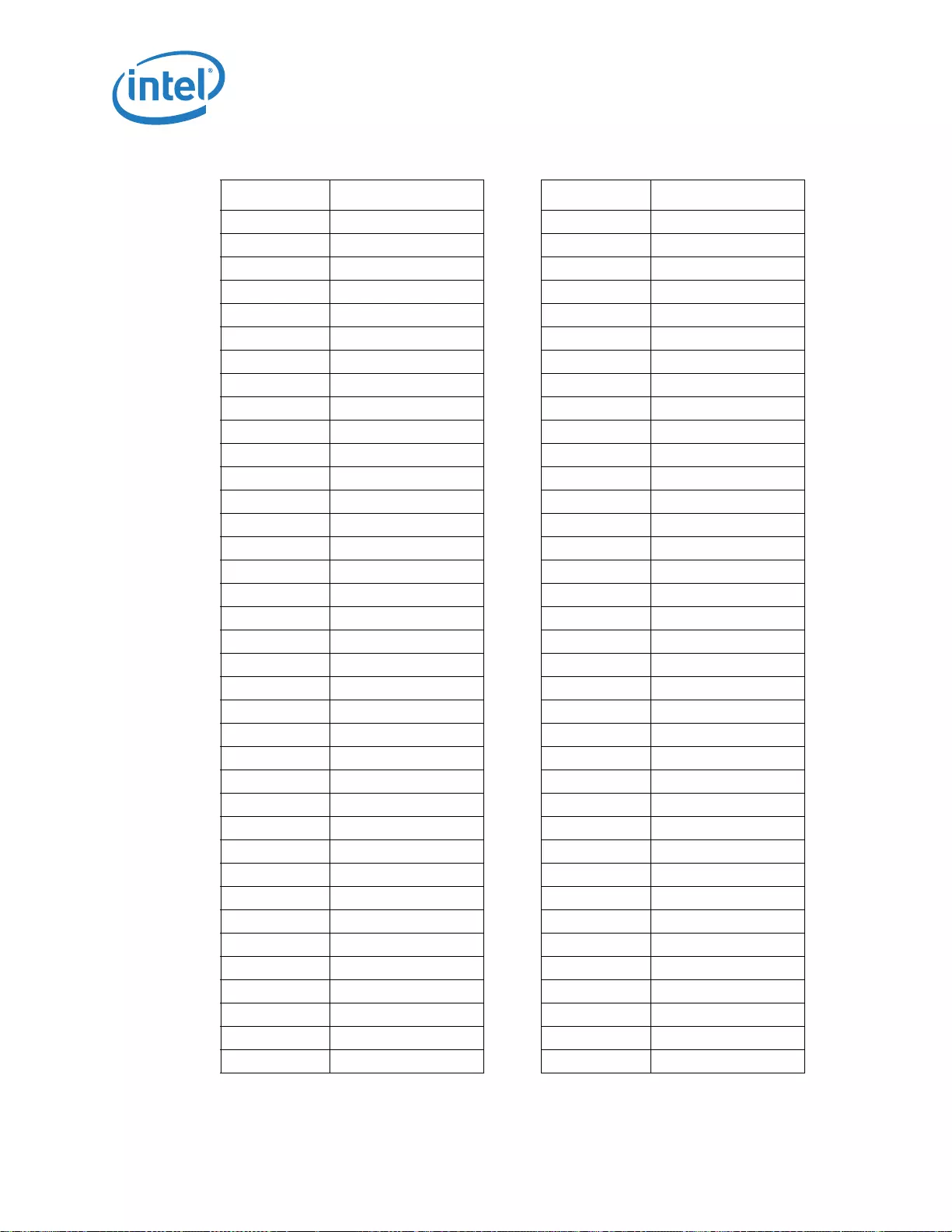
SoC Pin Location
324 Datasheet
B38 MCSI_GPIO[05]
B4 VSS
B40 DRAM_V1P0_S0iX
B42 DRAM0_DQ[08]
B44 VSS
B46 DRAM0_DQ[11]
B48 VSS
B50 DRAM0_DQSP[2]
B52 VSS
B54 DRAM0_ODT[0]
B56 DRAM0_CS[2]#
B58 VSS
B6 VSS
B8 ILB_RTC_X1
BA1 VSS
BA11 DDI1_AUXP
BA14 VSS
BA16 VSS
BA18 VSS
BA20 UNCORE_VNN_S4
BA22 VNN_SENSE
BA24 VSS
BA26 VSS
BA28 UNCORE_VNN_S4
BA3 RESERVED
BA31 VSS
BA33 VSS
BA35 UNCORE_VNN_S4
BA37 VSS
BA39 UNCORE_VNN_S4
BA41 UNCORE_VNN_S4
BA43 VSS
BA45 DRAM_VDD_S4
BA49 VSS
BA5 DDI0_TXP[3]
BA51 DRAM1_DQSP[4]
BA53 VSS
Ball # Customer Name
BA55 DRAM1_DQSP[5]
BA57 DRAM1_DM[5]
BA59 DRAM_VDD_S4
BA7 VSS
BA9 DDI0_RCOMP_P
BB10 ICLK_DDI0_TERMN
BB12 VSS
BB15 PWR_RVD_V1P0
BB17 VSS
BB19 UNCORE_VNN_S4
BB2 PWR_RVD_V1P0
BB21 UNCORE_VNN_S4
BB23 VSS
BB25 UNCORE_VNN_S4
BB27 VSS
BB29 VSS
BB32 UNCORE_VNN_S4
BB34 VSS
BB36 VSS
BB38 UNCORE_VNN_S4
BB4 DDI0_TXN[3]
BB40 UNCORE_VNN_S4
BB42 VSS
BB44 PWR_RVD_V1P0_OBS
BB46 VSS
BB48 DRAM1_DQ[36]
BB50 DRAM1_DQ[35]
BB52 VSS
BB54 VSS
BB56 DRAM1_DQSN[5]
BB58 VSS
BB6 VSS
BB8 DDI0_RCOMP_N
BC1 PWR_RVD_V1P0
BC11 RESERVED
BC3 DDI0_AUXP
BC49 VSS
Ball # Customer Name
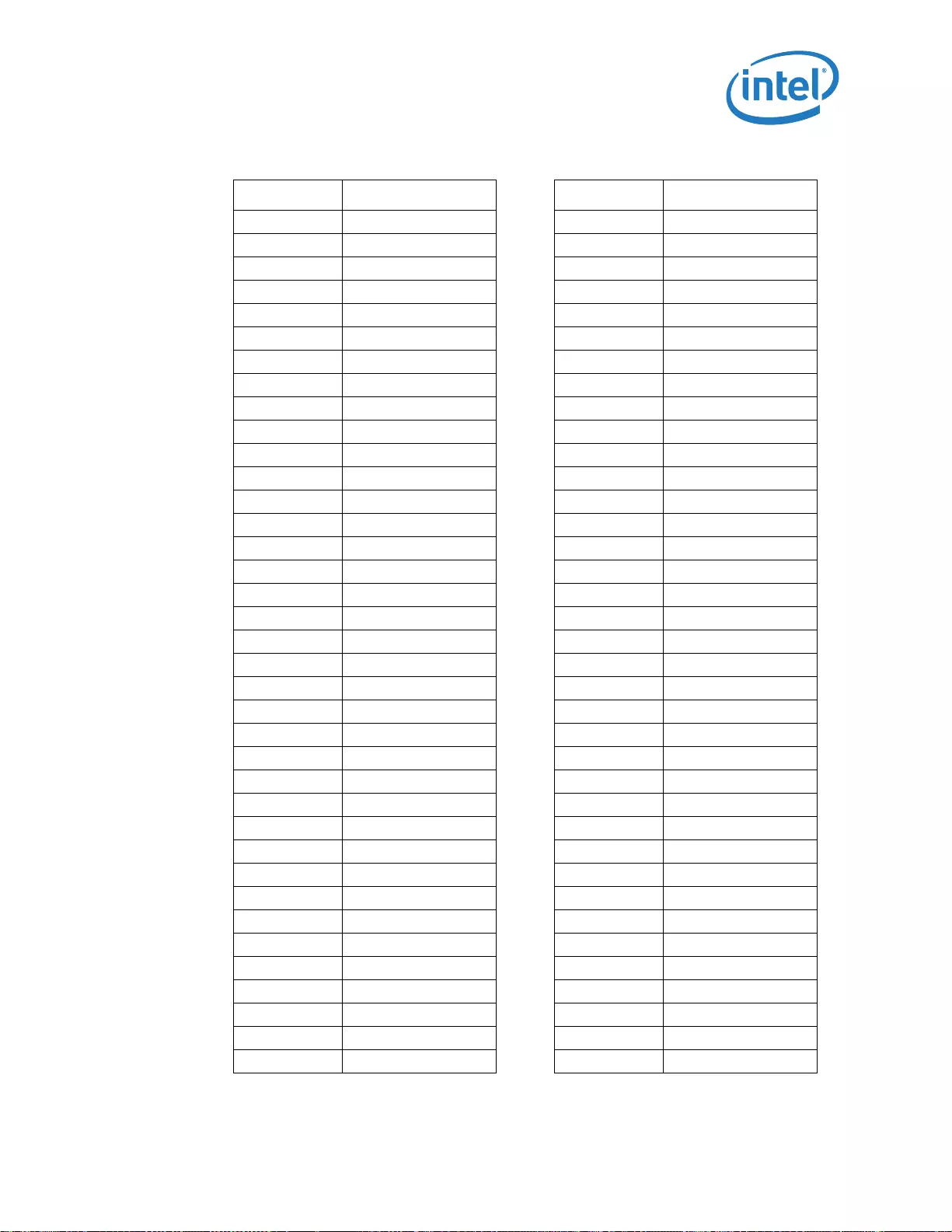
Datasheet 325
SoC Pin Location
BC5 VSS
BC51 VSS
BC53 VSS
BC55 DRAM1_DQ[40]
BC57 DRAM1_DQ[41]
BC59 VSS
BC7 VSS
BC9 ICLK_DDI0_TERMP
BD10 RESERVED
BD12 VSS
BD14 PWR_RVD_V1P0
BD16 VSS
BD18 VSS
BD2 DDI0_AUXN
BD20 UNCORE_VNN_S4
BD22 UNCORE_VNN_S4
BD24 UNCORE_VNN_S4
BD26 UNCORE_VNN_S4
BD28 UNCORE_VNN_S4
BD31 UNCORE_VNN_S4
BD33 UNCORE_VNN_S4
BD35 UNCORE_VNN_S4
BD37 UNCORE_VNN_S4
BD39 UNCORE_VNN_S4
BD4 DDI0_TXN[1]
BD41 VSS
BD43 VSS
BD45 VSS
BD48 DRAM1_DQ[33]
BD50 DRAM1_DQ[32]
BD52 DRAM1_CA[9]
BD54 DRAM1_DQ[43]
BD56 VSS
BD58 DRAM1_DQ[47]
BD6 VSS
BD8 VSS
BE1 VSS
Ball # Customer Name
BE11 VSS
BE3 DDI0_TXP[1]
BE49 DRAM1_CA[4]
BE5 DDI0_TXN[2]
BE51 DRAM1_CA[5]
BE53 RESERVED
BE55 DRAM1_DQ[42]
BE57 VSS
BE59 VSS
BE7 VSS
BE9 DDI0_TXN[0]
BF10 RESERVED
BF12 VSS
BF15 VSS
BF17 VSS
BF19 VSS
BF2 PWR_RVD_V1P0
BF21 VSS
BF23 VSS
BF25 VSS
BF27 VSS
BF29 VSS
BF32 GPIO_V1P0_S4
BF34 VSS
BF36 LPE_V1P8_S4
BF38 VSS
BF4 DDI0_TXP[2]
BF40 VSS
BF42 VSS
BF44 VSS
BF46 VSS
BF48 DRAM1_CA[8]
BF50 DRAM1_CA[6]
BF52 VSS
BF54 DRAM1_CKP[2]
BF56 DRAM1_CKN[2]
BF58 VSS
Ball # Customer Name

SoC Pin Location
326 Datasheet
BF6 VSS
BF8 DDI0_TXP[0]
BG1 PWR_RVD_V1P0
BG11 RESERVED
BG3 RESERVED
BG49 VSS
BG5 VSS
BG51 DRAM1_CA[1]
BG53 VSS
BG55 DRAM1_CKN[0]
BG57 DRAM1_CKP[0]
BG59 DRAM_VDD_S4
BG7 VSS
BG9 RESERVED
BH10 RESERVED
BH12 VSS
BH14 GPIO_S0_1
BH16 GPIO_S0_SC[054]
BH18 ILB_LPC_RCOMP
BH2 RESERVED
BH20 VSS
BH22 MMC1_RST#
BH24 MMC1_RCOMP
BH26 SD3_RCOMP
BH28 AUDIO_RCOMP
BH32 VSS
BH34 SIO_I2C3_CLK
BH36 SIO_SPI_MISO
BH38 VSS
BH4 RESERVED
BH40 VSS
BH42 VSS
BH44 DRAM1_DM[2]
BH46 DRAM1_DQ[19]
BH48 RESERVED
BH50 DRAM1_CA[0]
BH52 VSS
Ball # Customer Name
BH54 RESERVED
BH56 VSS
BH58 VSS
BH6 VSS
BH8 VSS
BJ1 VSS
BJ11 VSS
BJ13 VSS
BJ15 VSS
BJ17 VSS
BJ19 MMC1_D[6]
BJ21 MMC1_D[0]
BJ23 VSS
BJ25 SD3_D[2]
BJ27 VSS
BJ3 RESERVED
BJ30 SIO_I2C0_DATA
BJ33 SIO_I2C2_CLK
BJ35 VSS
BJ37 SIO_PWM[1]
BJ39 VSS
BJ41 VSS
BJ43 DRAM1_DQ[21]
BJ45 VSS
BJ47 DRAM1_DQ[27]
BJ49 RESERVED
BJ5 RESERVED
BJ51 DRAM1_CA[2]
BJ53 RESERVED
BJ55 DRAM1_CA[3]
BJ57 DRAM1_CA[7]
BJ59 DRAM_VDD_S4
BJ7 VSS
BJ9 RESERVED
BK10 RESERVED
BK12 SD3_PWREN#
BK14 GPIO_S0_0
Ball # Customer Name
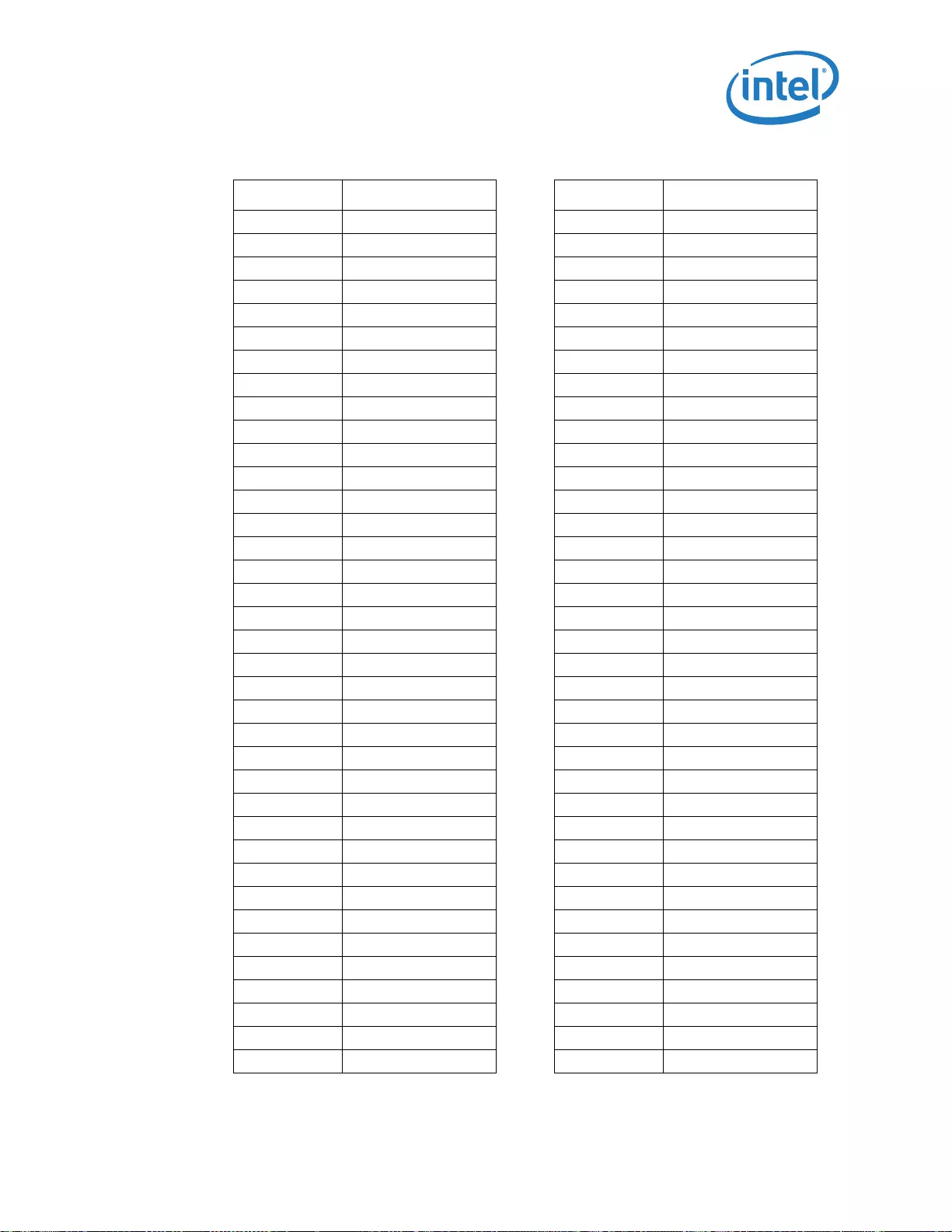
Datasheet 327
SoC Pin Location
BK16 I2S1_DATAIN
BK18 ILB_LPC_AD[0]
BK2 UNCORE_VNN_S4
BK20 VSS
BK22 MMC1_D[4]
BK24 SD2_D[3]_CD#
BK26 SD3_D[1]
BK28 I2S1_L_R
BK32 SIO_I2C0_CLK
BK34 SIO_I2C6_CLK
BK36 LPE_I2S2_DATAOUT
BK38 SIO_UART1_CTS#
BK4 RESERVED
BK40 NFC_I2C_DATA
BK42 DRAM1_DQ[16]
BK44 DRAM1_DQSN[2]
BK46 DRAM1_DQ[23]
BK48 VSS
BK50 VSS
BK52 DRAM1_DQ[29]
BK54 VSS
BK56 DRAM1_CKE[2]
BK58 VSS
BK6 VSS
BK8 RESERVED
BL1 UNCORE_VNN_S4
BL11 GPIO_S0_SC[006]
BL13 VSS
BL15 GPIO_S0_SC[052]
BL17 ILB_LPC_CLK[1]
BL19 ILB_LPC_AD[1]
BL21 MMC1_D[7]
BL23 VSS
BL25 SD3_CLK
BL27 I2S0_DATAIN
BL3 VSS
BL30 VSS
Ball # Customer Name
BL33 SIO_I2C1_CLK
BL35 SIO_SPI_CS#
BL37 LPE_I2S2_CLK
BL39 SIO_UART1_TXD
BL41 VSS
BL43 DRAM1_DQSP[2]
BL45 DRAM1_DQ[18]
BL47 DRAM1_DQ[20]
BL49 DRAM1_DQ[28]
BL5 VSS
BL51 DRAM1_DM[3]
BL53 DRAM1_DQ[31]
BL55 RESERVED
BL57 DRAM1_CS[0]#
BL59 DRAM_VDD_S4
BL7 VSS
BL9 RESERVED
BM10 VSS
BM12 GPIO_S0_2
BM14 GPIO_S0_SC[053]
BM16 VSS
BM18 VSS
BM2 VSS
BM20 MMC1_D[1]
BM22 VSS
BM24 SD2_D[1]
BM26 VSS
BM28 VSS
BM32 SIO_I2C2_DATA
BM34 VSS
BM36 VSS
BM38 SIO_UART2_RXD
BM4 P_RCOMP_N
BM40 VSS
BM42 DRAM1_DQ[22]
BM44 VSS
BM46 VSS
Ball # Customer Name

SoC Pin Location
328 Datasheet
BM48 DRAM1_DQ[25]
BM50 DRAM1_DQSP[3]
BM52 DRAM1_DQ[24]
BM54 RESERVED
BM56 VSS
BM58 DRAM1_CKE[0]
BM6 VSS
BM8 VSS
BN1 UNCORE_VNN_S4
BN11 SD3_1P8EN
BN13 VSS
BN15 GPIO_S0_SC[051]
BN17 VSS
BN19 SD3_CD#
BN21 VSS
BN23 VSS
BN25 SD3_CMD
BN27 VSS
BN3 P_RCOMP_P
BN30 VSS
BN33 SIO_I2C3_DATA
BN35 VSS
BN37 SIO_PWM[0]
BN39 VSS
BN41 VSS
BN43 DRAM1_DQ[17]
BN45 VSS
BN47 DRAM1_DQ[26]
BN49 DRAM1_DQ[30]
BN5 RESERVED
BN51 DRAM1_DQSN[3]
BN53 VSS
BN55 RESERVED
BN57 RESERVED
BN59 DRAM_VDD_S4
BN7 PMC_RSTBTN#
BN9 GPIO_S0_SC[007]
Ball # Customer Name
BP10 VSS
BP12 GPIO_S0_SC[055]
BP14 GPIO_S0_SC[059]
BP16 ILB_LPC_AD[3]
BP18 VSS
BP2 VSS
BP20 MMC1_CLK
BP22 SD2_D[2]
BP24 SD3_D[0]
BP26 VSS
BP28 I2S0_L_R
BP32 VSS
BP34 SIO_I2C5_CLK
BP36 LPE_I2S2_DATAIN
BP38 SIO_UART2_TXD
BP4 RESERVED
BP40 VSS
BP42 DRAM1_DQ[15]
BP44 DRAM1_DQ[13]
BP46 DRAM1_DQ[12]
BP48 VSS
BP50 DRAM1_DQ[01]
BP52 DRAM1_DQ[03]
BP54 RESERVED
BP56 RESERVED
BP58 VSS
BP6 VSS
BP8 PMC_PLT_CLK[0]
BR1 VSS
BR11 ILB_LPC_SERIRQ
BR13 GPIO_S0_SC[058]
BR15 ILB_LPC_AD[2]
BR17 ILB_LPC_CLK[0]
BR19 MMC1_D[3]
BR21 MMC1_D[2]
BR23 SD2_CMD
BR25 I2S1_DATAOUT
Ball # Customer Name
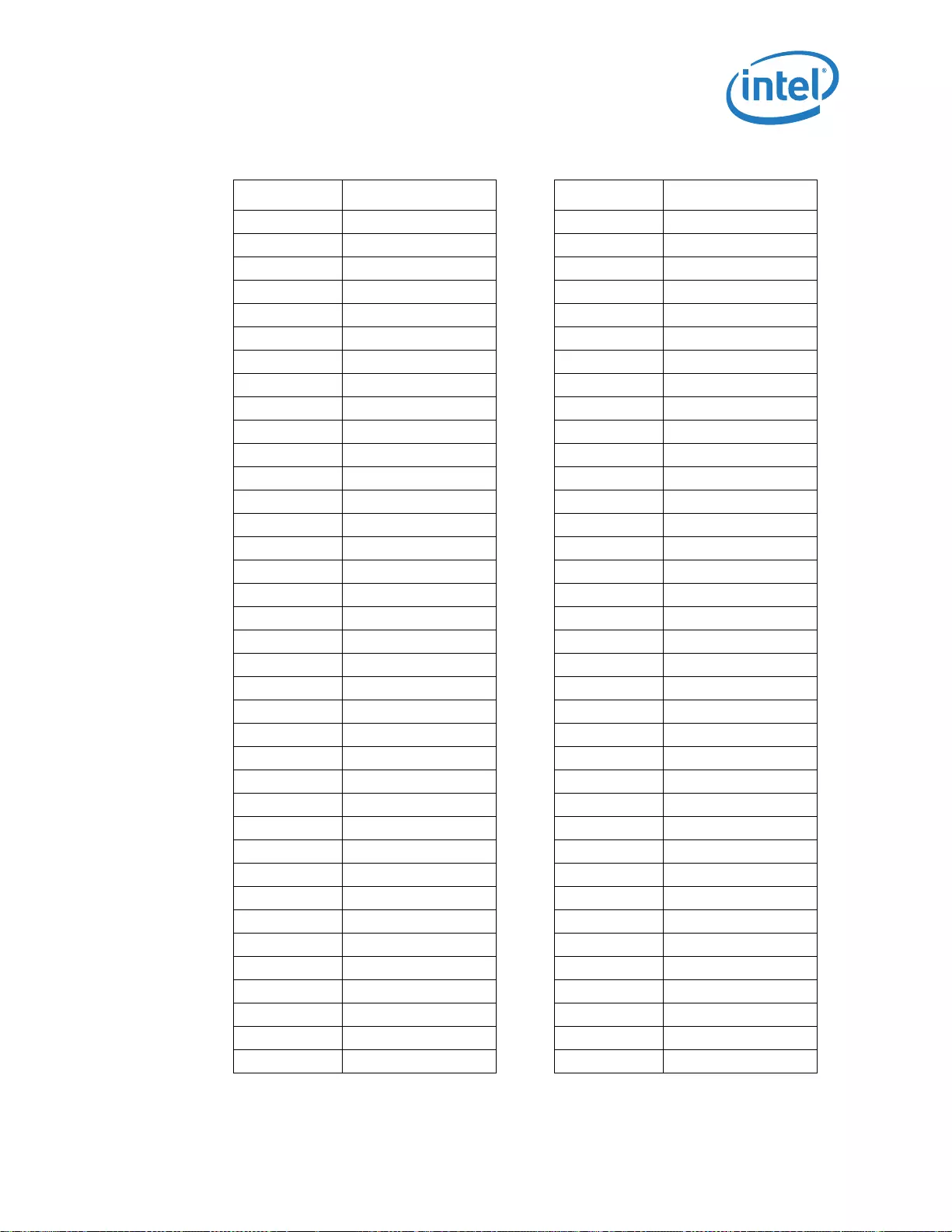
Datasheet 329
SoC Pin Location
BR27 I2S0_CLK
BR3 S_RCOMP_P
BR30 SIO_I2C1_DATA
BR33 SIO_I2C6_DATA
BR35 SIO_SPI_MOSI
BR37 SIO_UART2_CTS#
BR39 NFC_I2C_CLK
BR41 VSS
BR43 DRAM1_DQ[14]
BR45 DRAM1_DM[1]
BR47 DRAM1_DQ[04]
BR49 DRAM1_DQ[05]
BR5 VSS
BR51 DRAM1_DM[0]
BR53 VSS
BR55 RESERVED
BR57 RESERVED
BR59 VSS
BR7 PMC_PLT_CLK[1]
BR9 GPIO_S0_SC[004]
BT10 GPIO_S0_SC[003]
BT12 VSS
BT14 SIO_UART3_RXD
BT16 VSS
BT18 ILB_LPC_FRAME#
BT2 VSS
BT20 VSS
BT22 SD2_D[0]
BT24 VSS
BT26 I2S1_CLK
BT28 VSS
BT32 SIO_I2C5_DATA
BT34 VSS
BT36 LPE_I2S2_FRM
BT38 VSS
BT4 S_RCOMP_N
BT40 RESERVED
Ball # Customer Name
BT42 VSS
BT44 DRAM1_DQSP[1]
BT46 VSS
BT48 DRAM1_DQ[06]
BT50 VSS
BT52 DRAM1_DQ[02]
BT54 VSS
BT56 VSS
BT58 DRAM1_CKE[3]
BT6 PMC_PLT_CLK[3]
BT8 VSS
BU1 VSS
BU11 GPIO_S0_SC[056]
BU13 SIO_UART3_TXD
BU15 GPIO_S0_SC[060]
BU17 ILB_LPC_CLKRUN#
BU19 MMC1_D[5]
BU21 MMC1_CMD
BU23 SD2_CLK
BU25 SD3_D[3]
BU27 I2S0_DATAOUT
BU3 VSS
BU30 SIO_I2C4_DATA
BU33 SIO_I2C4_CLK
BU35 SIO_SPI_CLK
BU37 SIO_UART2_RTS#
BU39 SIO_UART1_RTS#
BU41 VSS
BU43 DRAM1_DQ[10]
BU45 DRAM1_DQSN[1]
BU47 DRAM1_DQ[09]
BU49 DRAM1_DQ[07]
BU5 PMC_PLT_CLK[5]
BU51 DRAM1_DQSN[0]
BU53 DRAM1_DQ[00]
BU55 DRAM1_ODT[2]
BU57 DRAM1_CKE[1]
Ball # Customer Name
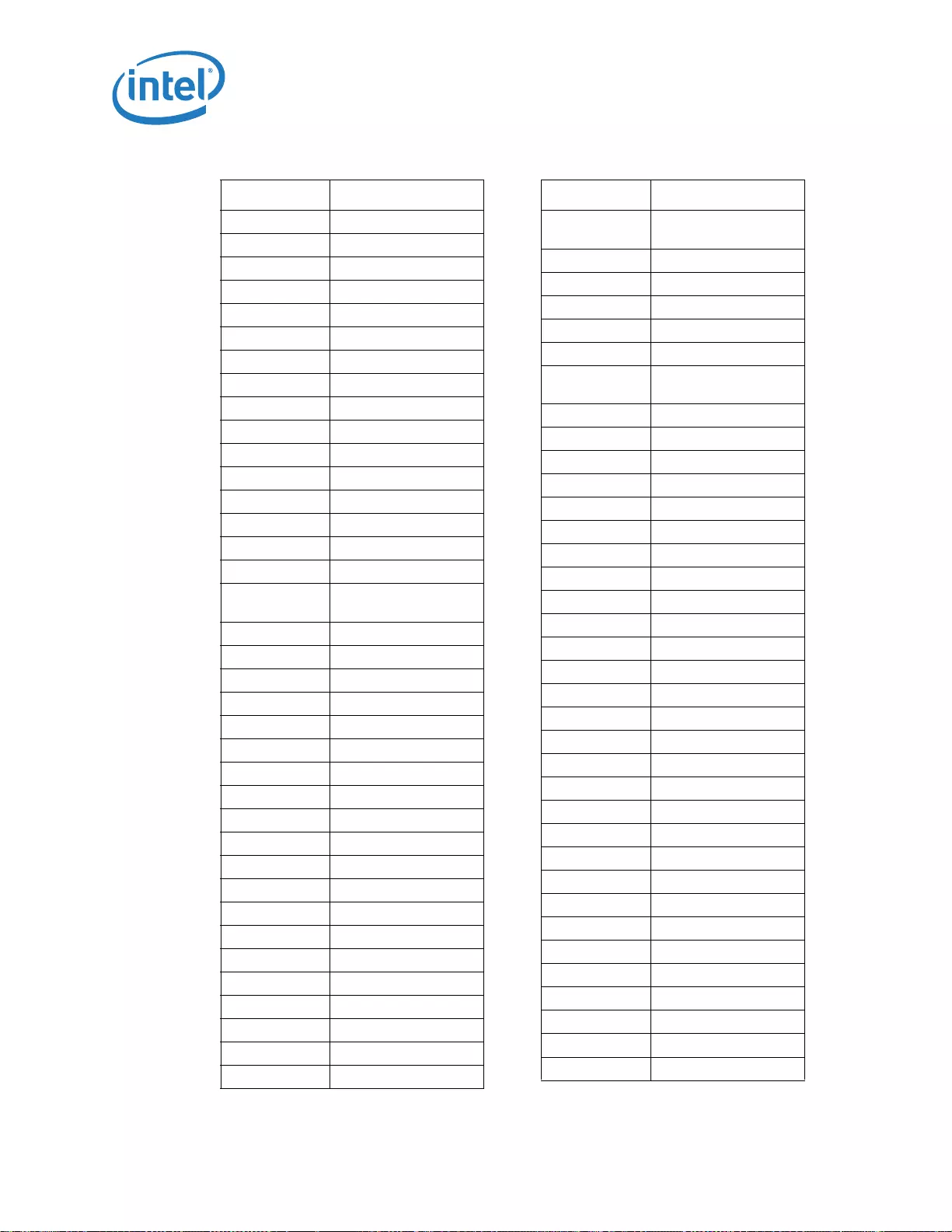
SoC Pin Location
330 Datasheet
BU59 VSS
BU7 PMC_PLT_CLK[2]
BU9 GPIO_S0_SC[005]
BV10 UNCORE_VNN_S4
BV12 VSS
BV14 UNCORE_VNN_S4
BV16 VSS
BV18 LPC_V1P8V3P3_S4
BV2 VSS
BV20 VSS
BV22 UNCORE_V1P8_S4
BV24 VSS
BV26 VIS_V1P0_S0iX
BV28 VSS
BV32 SIO_V1P8_S4
BV34 VSS
BV36 UNCORE_V1P24_S0iX
_F2
BV38 SIO_UART1_RXD
BV4 PMC_PLT_CLK[4]
BV40 DRAM_V1P0_S0iX
BV42 DRAM1_DQ[08]
BV44 VSS
BV46 DRAM1_DQ[11]
BV48 VSS
BV50 DRAM1_DQSP[0]
BV52 VSS
BV54 DRAM1_ODT[0]
BV56 DRAM1_CS[2]#
BV58 VSS
BV6 VSS
BV8 VSS
BW11 UNCORE_VNN_S4
BW13 UNCORE_VNN_S4
BW15 VSS
BW17 LPC_V1P8V3P3_S4
BW19 VSS
BW21 UNCORE_V1P8_S4
Ball # Customer Name
BW23 SDMMC3_V1P8V3P3_
S4
BW25 VSS
BW27 VIS_V1P0_S0iX
BW3 VSS
BW30 VSS
BW33 SIO_V1P8_S4
BW35 UNCORE_V1P24_S0iX
_F2
BW37 VSS
BW39 CORE_V1P05_S4
BW41 DRAM_V1P0_S0iX
BW43 DRAM_V1P0_S0iX
BW45 VSS
BW47 VSS
BW49 VSS
BW5 VSS
BW51 VSS
BW53 VSS
BW55 VSS
BW57 VSS
BW7 VSS
BW9 UNCORE_VNN_S4
C1 VSS
C11 TAP_TCK
C13 USB_ULPI_REFCLK
C15 GPIO_S5[26]
C17 GPIO_S5[02]
C19 GPIO_S5[10]
C21 USB_ULPI_RST#
C23 PMC_PWRBTN#
C25 CORE_VCC_S0iX
C27 PCU_SPI_CS[0]#
C3 USB_DN[0]
C30 SVID_CLK
C33 MDSI_DDCCLK
C35 DDI1_DDCCLK
C37 MDSI_C_TE
Ball # Customer Name
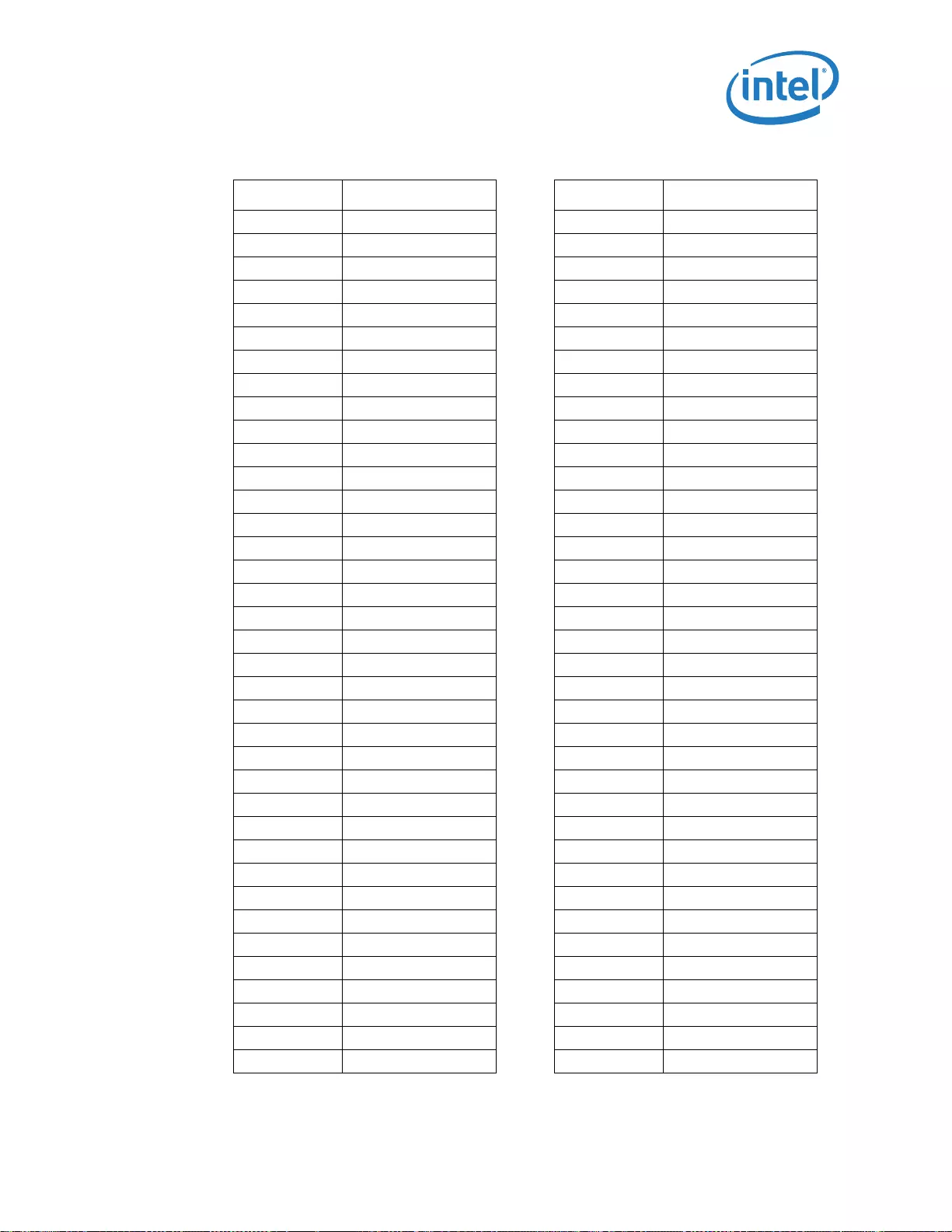
Datasheet 331
SoC Pin Location
C39 MCSI_GPIO[04]
C41 VSS
C43 DRAM0_DQ[10]
C45 DRAM0_DQSN[1]
C47 DRAM0_DQ[09]
C49 DRAM0_DQ[20]
C5 USB_DN[3]
C51 DRAM0_DQSN[2]
C53 DRAM0_DQ[19]
C55 DRAM0_ODT[2]
C57 DRAM0_CKE[1]
C59 VSS
C7 ILB_RTC_X2
C9 PMC_RSMRST#
D10 ILB_RTC_TEST#
D12 VSS
D14 GPIO_S5[06]
D16 VSS
D18 GPIO_S5[04]
D2 USB_DP[0]
D20 VSS
D22 PMC_SLP_S3#
D24 VSS
D26 CORE_VCC_S0iX
D28 VSS
D32 DDI0_DDCCLK
D34 VSS
D36 MDSI_A_TE
D38 VSS
D4 USB_DP[1]
D40 MCSI_GPIO[06]
D42 VSS
D44 DRAM0_DQSP[1]
D46 VSS
D48 DRAM0_DQ[18]
D50 VSS
D52 DRAM0_DQ[23]
Ball # Customer Name
D54 VSS
D56 VSS
D58 DRAM0_CKE[3]
D6 USB_DP[3]
D8 VSS
E1 VSS
E11 TAP_TDI
E13 RCOMP18
E15 GPIO_S5[27]
E17 GPIO_S5[00]
E19 GPIO_S5[03]
E21 PMC_ACPRESENT
E23 PMC_BATLOW#
E25 CORE_VCC_S0iX
E27 PCU_SPI_MOSI
E3 USB_DN[1]
E30 SVID_ALERT#
E33 PROCHOT#
E35 DDI1_HPD
E37 MCSI_GPIO[03]
E39 MCSI_GPIO[09]
E41 VSS
E43 DRAM0_DQ[14]
E45 DRAM0_DM[1]
E47 DRAM0_DQ[17]
E49 DRAM0_DQ[16]
E5 USB_DP[2]
E51 DRAM0_DM[2]
E53 VSS
E55 RESERVED
E57 RESERVED
E59 VSS
E7 RESERVED
E9 ILB_RTC_EXTPAD
F10 VSS
F12 TAP_PREQ#
F14 GPIO_S5[05]
Ball # Customer Name
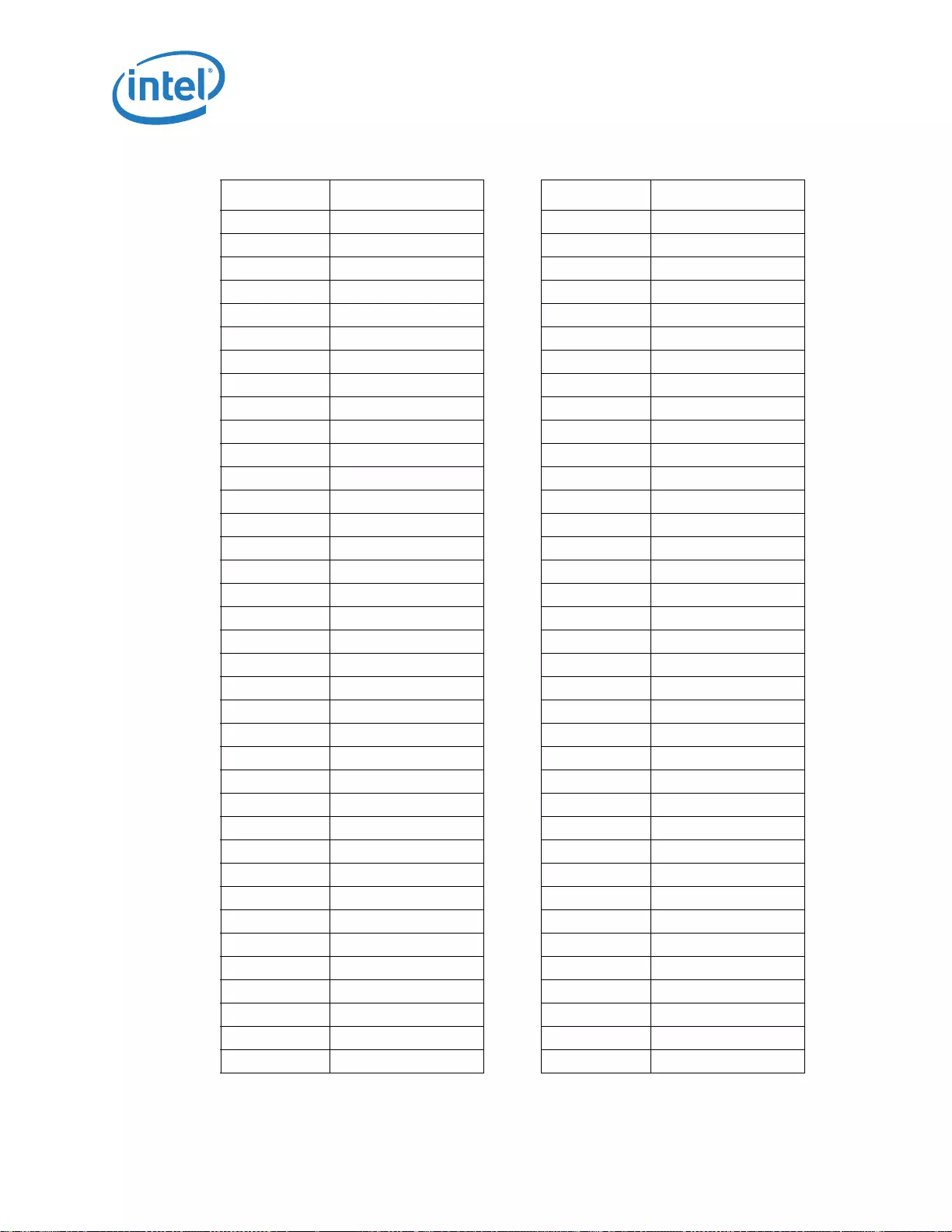
SoC Pin Location
332 Datasheet
F16 GPIO_S5[25]
F18 VSS
F2 VSS
F20 PMC_SUS_STAT#
F22 PMC_SUSCLK_0
F24 USB_OC[0]#
F26 CORE_VCC_S0iX
F28 PCU_SPI_CLK
F32 VSS
F34 DDI0_BKLTCTL
F36 DDI1_DDCDATA
F38 MCSI_GPIO[02]
F4 USB_DN[2]
F40 VSS
F42 DRAM0_DQ[15]
F44 DRAM0_DQ[13]
F46 DRAM0_DQ[12]
F48 VSS
F50 DRAM0_DQ[22]
F52 DRAM0_DQ[21]
F54 RESERVED
F56 RESERVED
F58 VSS
F6 VSS
F8 VSS
G1 USB_V1P8_G3
G11 ILB_RTC_RST#
G13 VSS
G15 GPIO_S5[08]
G17 VSS
G19 GPIO_S5[29]
G21 VSS
G23 VSS
G25 CORE_VCC_S0iX
G27 VSS
G3 USB3_RXP[0]
G30 VSS
Ball # Customer Name
G33 DDI0_BKLTEN
G35 VSS
G37 MCSI_GPIO[07]
G39 VSS
G41 VSS
G43 DRAM0_DQ[07]
G45 VSS
G47 DRAM0_DQ[26]
G49 DRAM0_DQ[30]
G5 VSS
G51 DRAM0_DQSN[3]
G53 VSS
G55 RESERVED
G57 RESERVED
G59 DRAM_VDD_S4
G7 ICLK_USB_TERMN
G9 PMC_CORE_PWROK
H10 VSS
H12 TAP_TRST#
H14 GPIO_S5[09]
H16 VSS
H18 VSS
H2 USB3DEV_RXP[0]
H20 PMC_PLTRST#
H22 VSS
H24 PMC_SUSPWRDNACK
H26 CORE_VCC_S0iX
H28 VSS
H32 DDI0_DDCDATA
H34 VSS
H36 VSS
H38 MCSI_GPIO[11]
H4 USB3_RXN[0]
H40 VSS
H42 DRAM0_DQ[00]
H44 VSS
H46 VSS
Ball # Customer Name
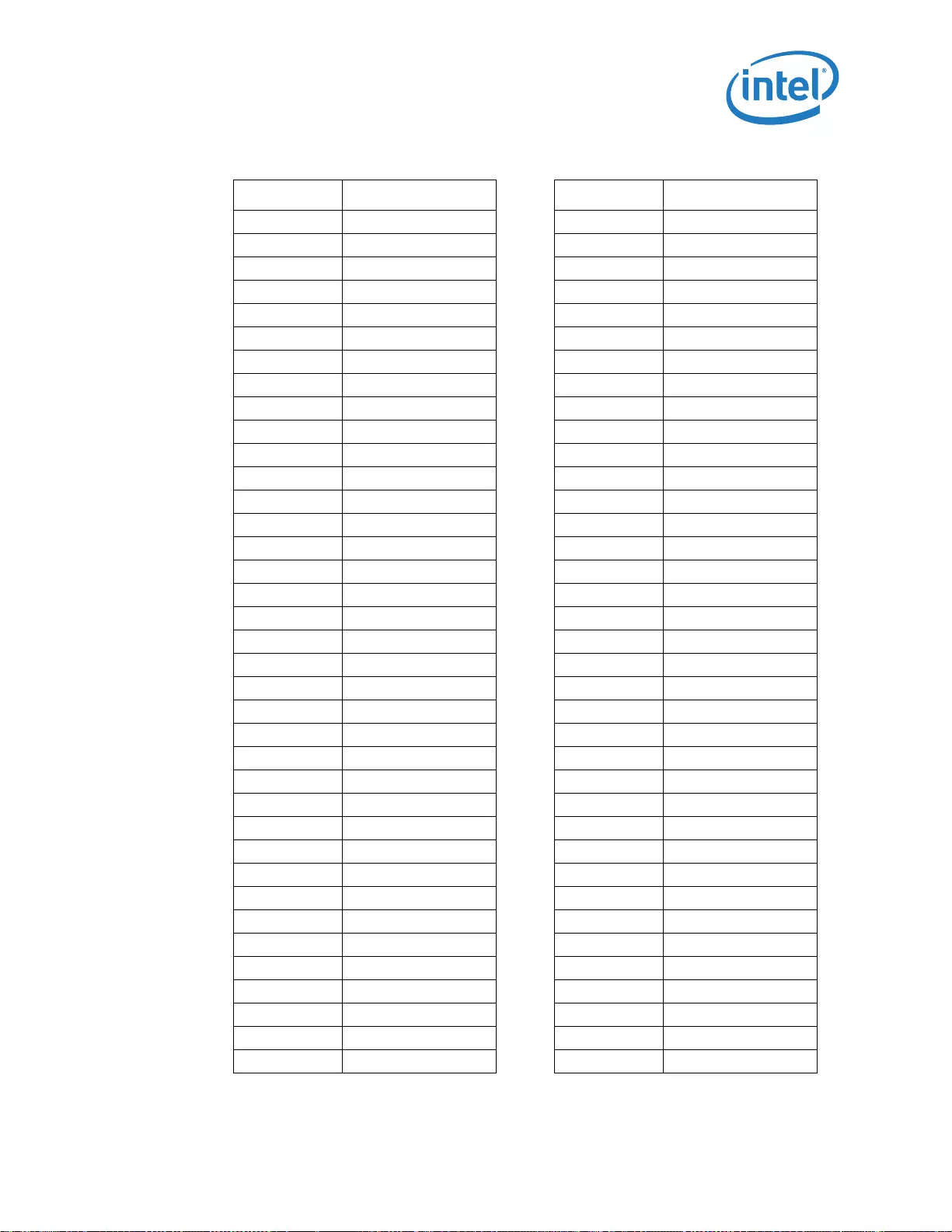
Datasheet 333
SoC Pin Location
H48 DRAM0_DQ[25]
H50 DRAM0_DQSP[3]
H52 DRAM0_DQ[24]
H54 RESERVED
H56 VSS
H58 DRAM0_CKE[0]
H6 ICLK_USB_TERMP
H8 USB_RCOMPO
J1 USB_V3P3_G3
J11 TAP_TDO
J13 VSS
J15 GPIO_S5[07]
J17 GPIO_S5[23]
J19 GPIO_S5[30]
J21 PMC_SLP_S0IX#
J23 GPIO_S5[17]
J25 CORE_VCC_S0iX
J27 PCU_SPI_CS[1]#
J3 USB3DEV_RXN[0]
J30 VSS
J33 DDI0_VDDEN
J35 DDI1_BKLTCTL
J37 MCSI_GPIO[08]
J39 MCSI_GPIO[00]
J41 VSS
J43 DRAM0_DQSP[0]
J45 DRAM0_DQ[06]
J47 DRAM0_DQ[02]
J49 DRAM0_DQ[28]
J5 RESERVED
J51 DRAM0_DM[3]
J53 DRAM0_DQ[31]
J55 RESERVED
J57 DRAM0_CS[0]#
J59 DRAM_VDD_S4
J7 USB_RCOMPI
J9 USB3_TXN[0]
Ball # Customer Name
K10 VSS
K12 TAP_TMS
K14 GPIO_S5[01]
K16 GPIO_S5[28]
K18 GPIO_S5[24]
K2 USB_V3P3_G3
K20 PMC_SLP_S4#
K22 GPIO_S5[15]
K24 VSS
K26 CORE_VCC_S0iX
K28 PCU_SPI_MISO
K32 DDI0_HPD
K34 DDI1_VDDEN
K36 DDI1_BKLTEN
K38 MCSI_GPIO[10]
K4 RESERVED
K40 MCSI_GPIO[01]
K42 DRAM0_DQ[04]
K44 DRAM0_DQSN[0]
K46 DRAM0_DQ[05]
K48 VSS
K50 VSS
K52 DRAM0_DQ[29]
K54 VSS
K56 DRAM0_CKE[2]
K58 VSS
K6 VSS
K8 USB3_TXP[0]
L1 VSS
L11 VSS
L13 VSS
L15 VSS
L17 VSS
L19 VSS
L21 VSS
L23 VSS
L25 CORE_VCC_S0iX
Ball # Customer Name

SoC Pin Location
334 Datasheet
L27 CORE_VCC_S0iX
L3 ICLK_USB3DEV_TERM
P
L30 CORE_VCC_S0iX
L33 VSS
L35 VSS
L37 VSS
L39 VSS
L41 VSS
L43 DRAM0_DQ[03]
L45 VSS
L47 DRAM0_DQ[27]
L49 RESERVED
L5 VSS
L51 DRAM0_CA[2]
L53 RESERVED
L55 DRAM0_CA[3]
L57 DRAM0_CA[7]
L59 DRAM_VDD_S4
L7 VSS
L9 USB3DEV_TXN[0]
M10 USB3_REXT[0]
M12 USB_VSSA
M14 USB_V1P0_S4
M16 VSS
M18 VSS
M2 ICLK_USB3DEV_TERM
N
M20 PCU_V3P3_G3
M22 RTC_VCC
M24 VSS
M26 CORE_VCC_S0iX
M28 CORE_VCC_S0iX
M32 VSS
M34 PWR_RVD_V1P0_OBS
M36 SVID_V1P0_S4
M38 VSS
M4 ICLK_USB3_TERMP
Ball # Customer Name
M40 UNCORE_V1P24_S0iX
_F3
M42 VSS
M44 DRAM0_DM[0]
M46 DRAM0_DQ[01]
M48 RESERVED
M50 DRAM0_CA[0]
M52 VSS
M54 RESERVED
M56 VSS
M58 VSS
M6 VSS
M8 USB3DEV_TXP[0]
N1 USB_V1P0_S4
N11 RESERVED
N3 ICLK_USB3_TERMN
N49 VSS
N5 USB_HSIC0_DATA
N51 DRAM0_CA[1]
N53 VSS
N55 DRAM0_CKP[0]
N57 DRAM0_CKN[0]
N59 DRAM_VDD_S4
N7 VSS
N9 USB3DEV_REXT[0]
P10 RESERVED
P12 VSS
P15 UNCORE_V1P0_G3
P17 UNCORE_V1P0_G3
P19 UNCORE_V1P0_G3
P2 USB_V1P0_S4
P21 UNCORE_V1P8_G3
P23 PCU_V1P8_S4
P25 VSS
P27 PMU_V1P8_G3
P29 CORE_VCC_S0iX
P32 CORE_VCC_S0iX
P34 VSS
Ball # Customer Name
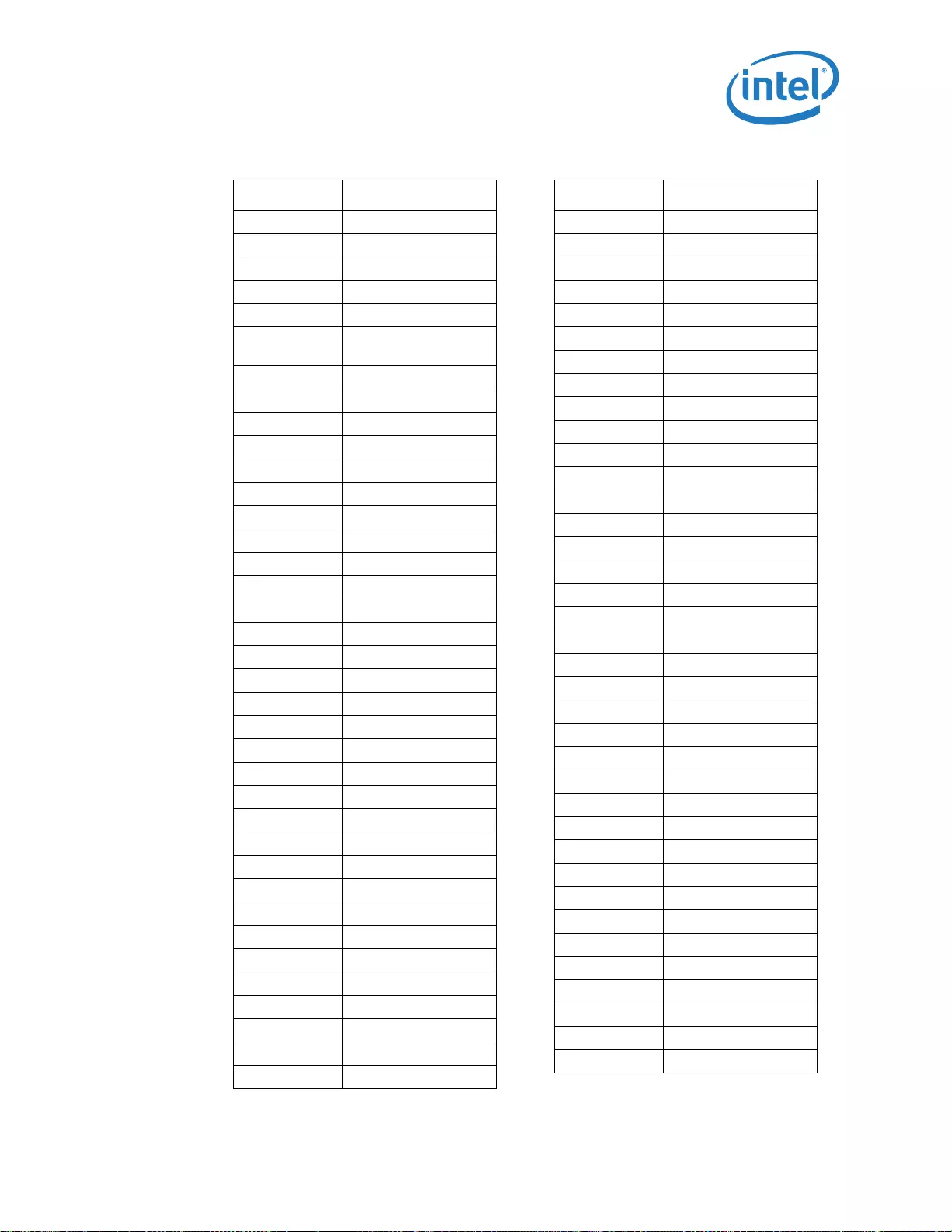
Datasheet 335
SoC Pin Location
P36 VSS
P38 VSS
P4 USB_HSIC1_DATA
P40 VSS
P42 MIPI_V1P8_S4
P44 UNCORE_V1P24_S0iX
_F4
P46 VSS
P48 DRAM0_CA[8]
P50 DRAM0_CA[6]
P52 VSS
P54 DRAM0_CKP[2]
P56 DRAM0_CKN[2]
P58 VSS
P6 VSS
P8 VSS
R1 HSIC_V1P24_G3
R11 VSS
R3 USB_HSIC0_STROBE
R49 DRAM0_CA[4]
R5 VSS
R51 DRAM0_CA[5]
R53 RESERVED
R55 DRAM0_DQ[42]
R57 VSS
R59 VSS
R7 VSS
R9 VSS
T10 USB_ULPI_DIR
T12 USB_ULPI_STP
T14 USB_HSIC_RCOMP
T16 VSS
T18 UNCORE_V1P0_G3
T2 USB_ULPI_DATA[5]
T20 VSS
T22 VSS
T24 VSS
T26 VSS
Ball # Customer Name
T28 VSS
T31 CORE_VCC_S0iX
T33 CORE_VCC_S0iX
T35 CORE_VCC_S0iX
T37 CORE_VCC_S0iX
T39 RESERVED
T4 USB_HSIC1_STROBE
T41 VSS
T43 VSS
T45 VSS
T48 DRAM0_DQ[33]
T50 DRAM0_DQ[32]
T52 DRAM0_CA[9]
T54 DRAM0_DQ[43]
T56 VSS
T58 DRAM0_DQ[47]
T6 USB_ULPI_DATA[1]
T8 USB_ULPI_DATA[3]
U1 VSS
U11 VSS
U3 USB_ULPI_DATA[6]
U49 VSS
U5 USB_ULPI_DATA[7]
U51 VSS
U53 VSS
U55 DRAM0_DQ[40]
U57 DRAM0_DQ[41]
U59 VSS
U7 VSS
U9 USB_ULPI_DATA[0]
V10 USB_ULPI_CLK
V12 MCSI2_CLKP
V15 VSS
V17 VSS
V19 VSS
V2 VSS
V21 UNCORE_VNN_S4
Ball # Customer Name
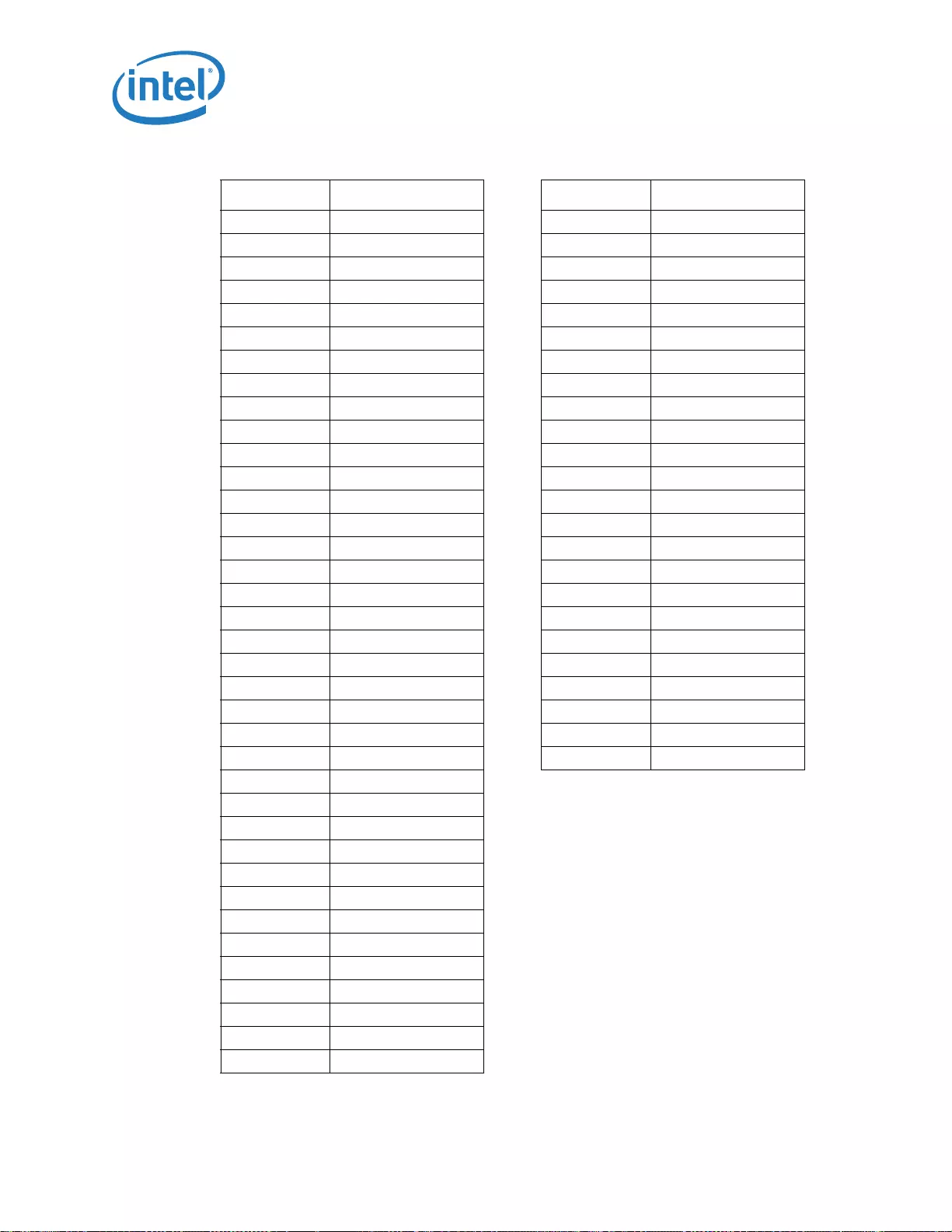
SoC Pin Location
336 Datasheet
V23 UNCORE_VNN_S4
V25 UNCORE_VNN_S4
V27 VSS
V29 CORE_VCC_S0iX
V32 CORE_VCC_S0iX
V34 VSS
V36 CORE_VCC_S0iX
V38 VSS
V4 MDSI_C_DN[3]
V40 RESERVED
V42 VSS
V44 VSS
V46 VSS
V48 DRAM0_DQ[36]
V50 DRAM0_DQ[35]
V52 VSS
V54 VSS
V56 DRAM0_DQSN[5]
V58 VSS
V6 VSS
V8 USB_ULPI_NXT
W1 USB3_V1P0_G3
W11 MCSI2_CLKN
W14 VSS
W16 VSS
W18 VSS
W20 UNCORE_VNN_S4
W22 UNCORE_VNN_S4
W24 UNCORE_VNN_S4
W26 VSS
W28 VSS
W3 MDSI_C_DP[2]
W31 CORE_VCC_S0iX
W33 VSS
W35 CORE_VCC_S0iX
W37 CORE_VCC_S0iX
W39 CORE_V1P05_S4
Ball # Customer Name
W41 VSS
W43 VSS
W45 VSS
W49 VSS
W5 MDSI_C_DP[3]
W51 DRAM0_DQSP[4]
W53 VSS
W55 DRAM0_DQSP[5]
W57 DRAM0_DM[5]
W59 DRAM_VDD_S4
W7 USB_ULPI_DATA[4]
W9 USB_ULPI_DATA[2]
Y10 VSS
Y12 VSS
Y2 VSS
Y4 MDSI_C_DN[2]
Y48 DRAM0_DQ[39]
Y50 DRAM0_DQSN[4]
Y52 DRAM0_DM[4]
Y54 DRAM0_DQ[46]
Y56 VSS
Y58 DRAM0_DQ[44]
Y6 VSS
Y8 VSS
Ball # Customer Name
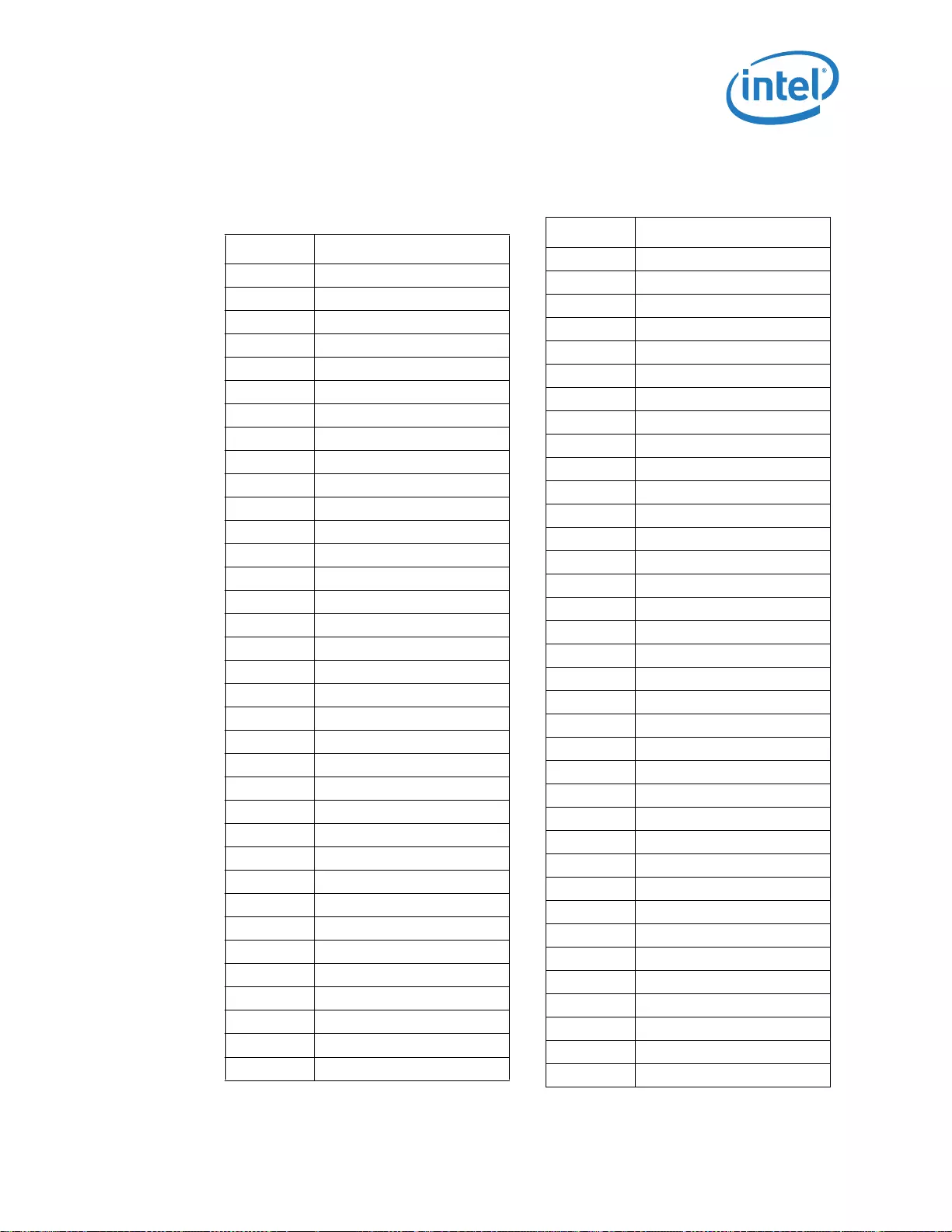
Datasheet 337
SoC Pin Location
31.2 Type 3 SoC - Pin List Location
Ball # Customer Name
D1 ILB_RTC_X1
E1 ILB_RTC_X2
D2 ILB_RTC_EXTPAD
T2 Reserved
F2 PMC_CORE_PWROK
F7 TAP_PRDY#
F5 TAP_PREQ#
AA4 DDI_RCOMP_N
AA3 DDI_RCOMP_P
AB3 DDI0_TXN[0]
AA1 DDI0_TXN[1]
Y1 DDI0_TXN[2]
Y3 DDI0_TXN[3]
AB4 DDI0_TXP[0]
AB2 DDI0_TXP[1]
Y2 DDI0_TXP[2]
Y4 DDI0_TXP[3]
W6 DDI1_AUXN
Y5 DDI1_AUXP
U6 DDI1_TXN[0]
V4 DDI1_TXN[1]
U1 DDI1_TXN[2]
U5 DDI1_TXN[3]
U7 DDI1_TXP[0]
V5 DDI1_TXP[1]
T1 DDI1_TXP[2]
U4 DDI1_TXP[3]
AE21 DRAM_RCOMP[0]
AE20 DRAM_RCOMP[1]
AC20 DRAM_VDD_S4_PWROK
M21 DRAM0_BS[0]
N19 DRAM0_BS[1]
K22 DRAM0_BS[2]
P20 DRAM0_CAS#
J23 DRAM0_CKP[0]
K20 DRAM0_CKP[2]
J22 DRAM0_CKN[0]
K21 DRAM0_CKN[2]
G22 DRAM0_CKE[0]
G23 DRAM0_CKE[1]
F23 DRAM0_CKE[2]
F22 DRAM0_CKE[3]
P22 DRAM0_CS[0]#
P23 DRAM0_CS[2]#
A20 DRAM0_DM[0]
D21 DRAM0_DM[1]
D25 DRAM0_DM[2]
F19 DRAM0_DM[3]
AC24 DRAM0_DM[4]
V24 DRAM0_DM[5]
Y22 DRAM0_DM[6]
T23 DRAM0_DM[7]
D18 DRAM0_DQ[00]
B18 DRAM0_DQ[01]
E19 DRAM0_DQ[10]
E23 DRAM0_DQ[11]
D22 DRAM0_DQ[12]
E22 DRAM0_DQ[13]
E20 DRAM0_DQ[14]
D20 DRAM0_DQ[15]
E25 DRAM0_DQ[16]
A23 DRAM0_DQ[17]
C23 DRAM0_DQ[18]
F25 DRAM0_DQ[19]
A21 DRAM0_DQ[02]
B24 DRAM0_DQ[20]
D24 DRAM0_DQ[21]
B23 DRAM0_DQ[22]
F24 DRAM0_DQ[23]
F20 DRAM0_DQ[24]
F21 DRAM0_DQ[25]
Ball # Customer Name
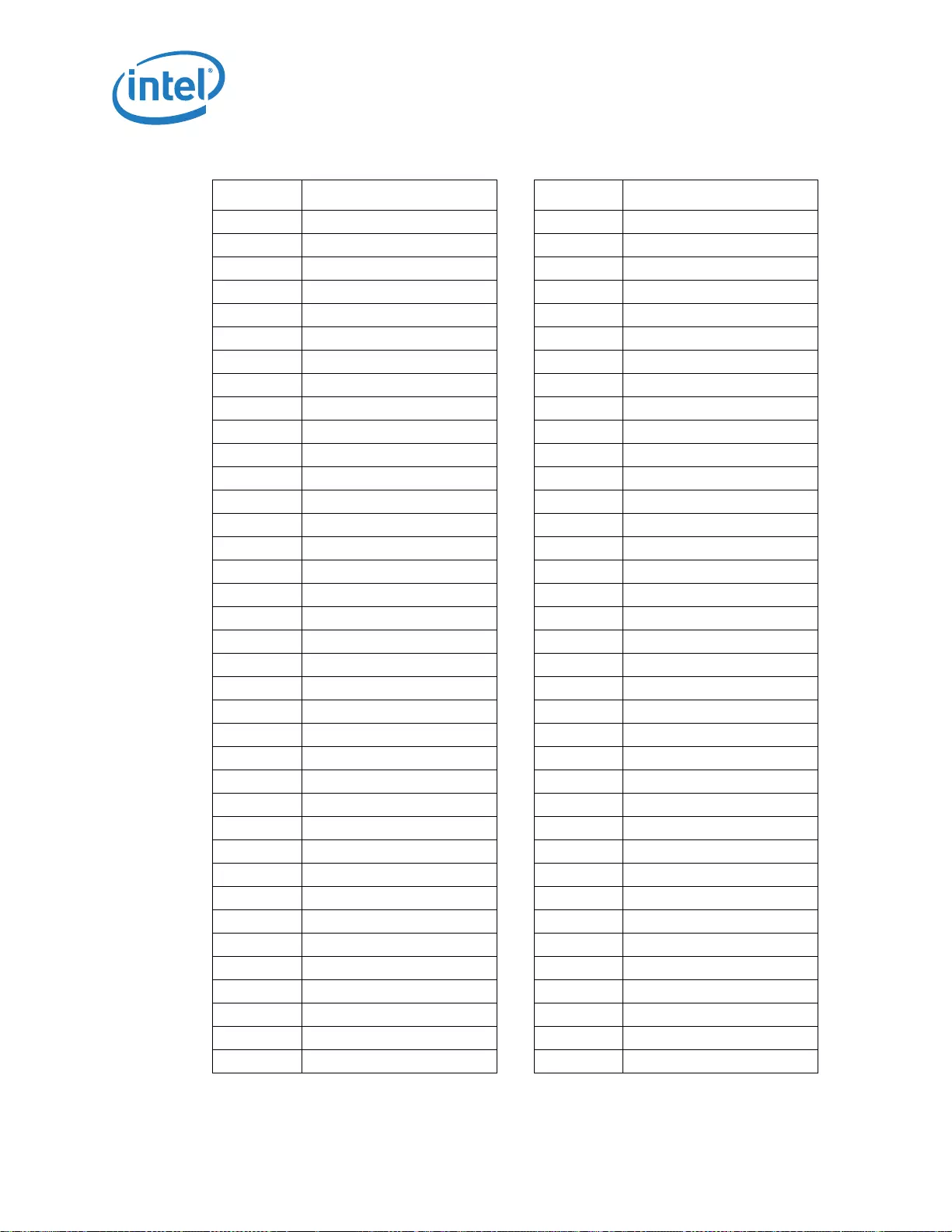
SoC Pin Location
338 Datasheet
G20 DRAM0_DQ[26]
H23 DRAM0_DQ[27]
G21 DRAM0_DQ[28]
J21 DRAM0_DQ[29]
C18 DRAM0_DQ[03]
J20 DRAM0_DQ[30]
H22 DRAM0_DQ[31]
AD24 DRAM0_DQ[32]
AB25 DRAM0_DQ[33]
Y24 DRAM0_DQ[34]
AE23 DRAM0_DQ[35]
AA25 DRAM0_DQ[36]
AC23 DRAM0_DQ[37]
AD23 DRAM0_DQ[38]
Y25 DRAM0_DQ[39]
A22 DRAM0_DQ[04]
V23 DRAM0_DQ[40]
T24 DRAM0_DQ[41]
W22 DRAM0_DQ[42]
W23 DRAM0_DQ[43]
R23 DRAM0_DQ[44]
R22 DRAM0_DQ[45]
V22 DRAM0_DQ[46]
T25 DRAM0_DQ[47]
AB22 DRAM0_DQ[48]
AC22 DRAM0_DQ[49]
B20 DRAM0_DQ[05]
Y19 DRAM0_DQ[50]
AD22 DRAM0_DQ[51]
AA22 DRAM0_DQ[52]
Y23 DRAM0_DQ[53]
Y20 DRAM0_DQ[54]
Y21 DRAM0_DQ[55]
T22 DRAM0_DQ[56]
T20 DRAM0_DQ[57]
W20 DRAM0_DQ[58]
V20 DRAM0_DQ[59]
Ball # Customer Name
A18 DRAM0_DQ[06]
U21 DRAM0_DQ[60]
W21 DRAM0_DQ[61]
U20 DRAM0_DQ[62]
T21 DRAM0_DQ[63]
B22 DRAM0_DQ[07]
C20 DRAM0_DQ[08]
D23 DRAM0_DQ[09]
D19 DRAM0_DQSP[0]
C22 DRAM0_DQSP[1]
C24 DRAM0_DQSP[2]
H20 DRAM0_DQSP[3]
AC25 DRAM0_DQSP[4]
V25 DRAM0_DQSP[5]
AB23 DRAM0_DQSP[6]
U22 DRAM0_DQSP[7]
C19 DRAM0_DQSN[0]
C21 DRAM0_DQSN[1]
C25 DRAM0_DQSN[2]
H19 DRAM0_DQSN[3]
AB24 DRAM0_DQSN[4]
U25 DRAM0_DQSN[5]
AA23 DRAM0_DQSN[6]
U23 DRAM0_DQSN[7]
U19 DRAM0_DRAMRST#
M24 DRAM0_MA[00]
L23 DRAM0_MA[01]
N20 DRAM0_MA[10]
K25 DRAM0_MA[11]
M25 DRAM0_MA[12]
M23 DRAM0_MA[13]
H25 DRAM0_MA[14]
K23 DRAM0_MA[15]
N23 DRAM0_MA[02]
M20 DRAM0_MA[03]
M22 DRAM0_MA[04]
L22 DRAM0_MA[05]
Ball # Customer Name
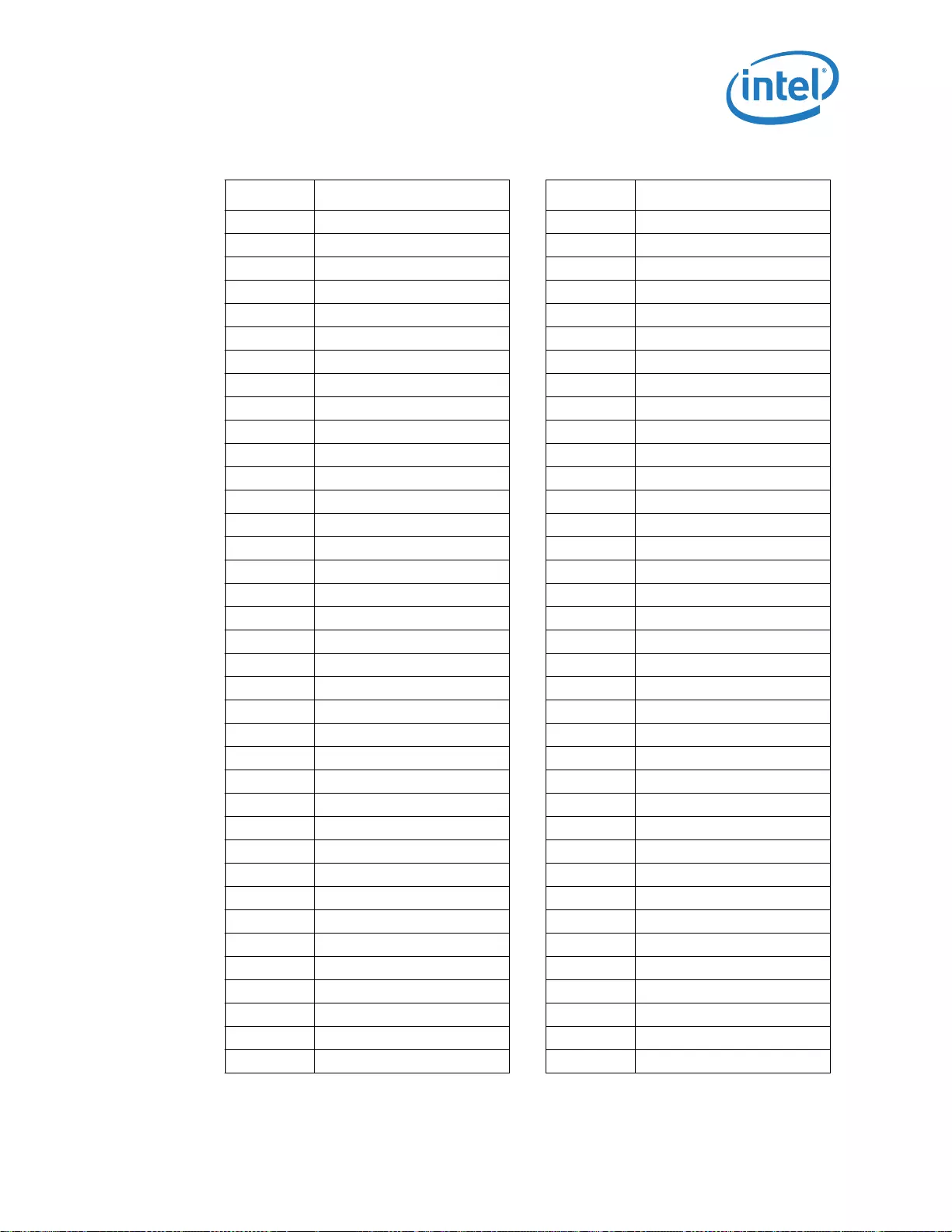
Datasheet 339
SoC Pin Location
K24 DRAM0_MA[06]
N25 DRAM0_MA[07]
J25 DRAM0_MA[08]
H24 DRAM0_MA[09]
P24 DRAM0_ODT[0]
P25 DRAM0_ODT[2]
N22 DRAM0_RAS#
P21 DRAM0_WE#
AA20 RESERVED
AA19 RESERVED
AB21 RESERVED
AC21 RESERVED
AE22 DRAM_RCOMP[2]
AB20 DRAM_CORE_PWROK
AD20 DRAM_VREF
AE1 RESERVED
AD1 RESERVED
W3 RESERVED
W4 RESERVED
Y18 RESERVED
D17 GPIO_S0_NC[15]
B16 GPIO_S0_NC[16]
C15 GPIO_S0_NC[17]
C14 GPIO_S0_NC[18]
C17 GPIO_S0_NC[19]
C16 GPIO_S0_NC[20]
D16 GPIO_S0_NC[21]
D15 GPIO_S0_NC[22]
D14 GPIO_S0_NC[23]
F18 GPIO_S0_NC[24]
E17 GPIO_S0_NC[25]
E16 GPIO_S0_NC[26]
F17 MDSI_A_TE
A6 GPIO_S5[22]
B4 GPIO_S5[23]
A3 GPIO_S5[24]
B3 GPIO_S5[25]
Ball # Customer Name
B2 GPIO_S5[26]
C2 GPIO_S5[27]
C3 GPIO_S5[28]
C4 GPIO_S5[29]
A5 GPIO_S5[30]
A4 GPIO_RCOMP
E9 GPIO_S5[00]
D7 GPIO_S5[01]
F9 GPIO_S5[02]
E8 GPIO_S5[03]
F8 GPIO_S5[04]
D6 GPIO_S5[05]
D4 GPIO_S5[06]
D5 GPIO_S5[07]
AA14 I2S0_DATAOUT
Y10 I2S1_DATAIN
AB14 I2S1_DATAOUT
AE14 AUDIO_RCOMP
Y16 I2S0_CLK
AC13 I2S1_CLK
AC14 I2S1_L_R
Y13 I2S0_DATAIN
Y14 I2S0_L_R
N5 RESERVED
C13 DDI0_DDCCLK
D13 DDI0_DDCDATA
E14 DDI0_HPD
B12 DDI1_HPD
AB17 D1_I2C_CLK
AA17 D1_I2C_DATA
AD12 SIO_I2C0_CLK
AE12 SIO_I2C0_DATA
AD14 SIO_I2C1_CLK
AE13 SIO_I2C1_DATA
AC15 SIO_I2C2_CLK
AB15 SIO_I2C2_DATA
AC16 SIO_I2C3_CLK
Ball # Customer Name
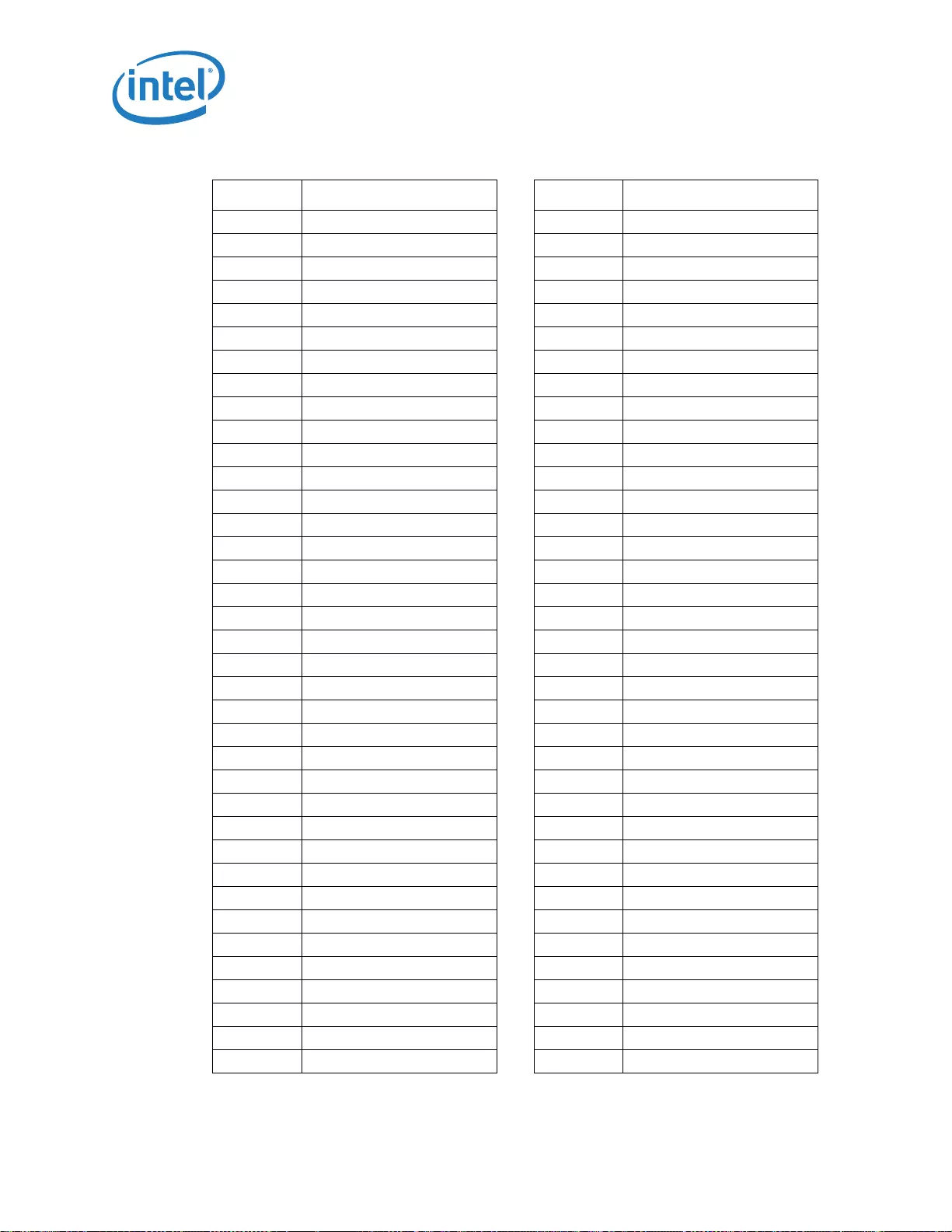
SoC Pin Location
340 Datasheet
AB16 SIO_I2C3_DATA
AE16 SIO_I2C4_CLK
AD16 SIO_I2C4_DATA
V1 ICLK_ICOMP
M5 MCSI1_CLKN
M6 MCSI1_CLKP
P3 MCSI1_DN[0]
M1 MCSI1_DN[1]
M4 MCSI1_DN[2]
L3 MCSI1_DN[3]
P2 MCSI1_DP[0]
N1 MCSI1_DP[1]
M3 MCSI1_DP[2]
L4 MCSI1_DP[3]
K4 MCSI2_CLKN
K5 MCSI2_CLKP
K6 MCSI2_DN[0]
J6 MCSI2_DP[0]
K1 MCSI_RCOMP
P5 MDSI_A_CLKN
P4 MDSI_A_CLKP
T4 MDSI_A_DN[0]
R4 MDSI_A_DN[1]
T6 MDSI_A_DN[2]
P6 MDSI_A_DN[3]
T3 MDSI_A_DP[0]
R3 MDSI_A_DP[1]
T5 MDSI_A_DP[2]
N6 MDSI_A_DP[3]
P1 MDSI_RCOMP
AC6 GPIO_S0_SC[57]
AD6 GPIO_S0_SC[61]
AA9 MMC1_D[4]
AA8 MMC1_D[5]
Y8 MMC1_D[6]
Y7 MMC1_D[7]
AD8 MMC1_RST#
Ball # Customer Name
V3 ICLK_OSCIN
V2 ICLK_OSCOUT
A13 DDI1_BKLTCTL
A14 DDI1_BKLTEN
B14 DDI1_VDDEN
AC5 GPIO_S0_SC[03]
AA5 GPIO_S0_SC[07]
AB5 PMC_PLT_CLK[0]
AE4 PMC_PLT_CLK[1]
AD4 PMC_PLT_CLK[3]
AD2 PMC_PLT_CLK[4]
B8 PMC_ACPRESENT
C9 PMC_BATLOW#
B6 PMC_PLTRST#
A10 PMC_PWRBTN#
C6 USB_ULPI_RST#
C7 PMC_SLP_S0IX#
C8 PMC_SLP_S3#
D8 PMC_SLP_S4#
A9 PMC_SUSCLK_0
B10 GPIO_S5[15]
D9 GPIO_S5[17]
F16 PROCHOT#
AA16 SIO_PWM[0]
Y17 SIO_PWM[1]
AE6 MMC1_RCOMP
F3 PMC_RSMRST#
E3 ILB_RTC_TEST#
AB6 GPIO_S0_SC[00]
AA6 GPIO_S0_SC[01]
Y6 GPIO_S0_SC[02]
AC4 RESERVED
AC3 RESERVED
AC1 RESERVED
AC2 RESERVED
AD3 RESERVED
AE3 RESERVED
Ball # Customer Name
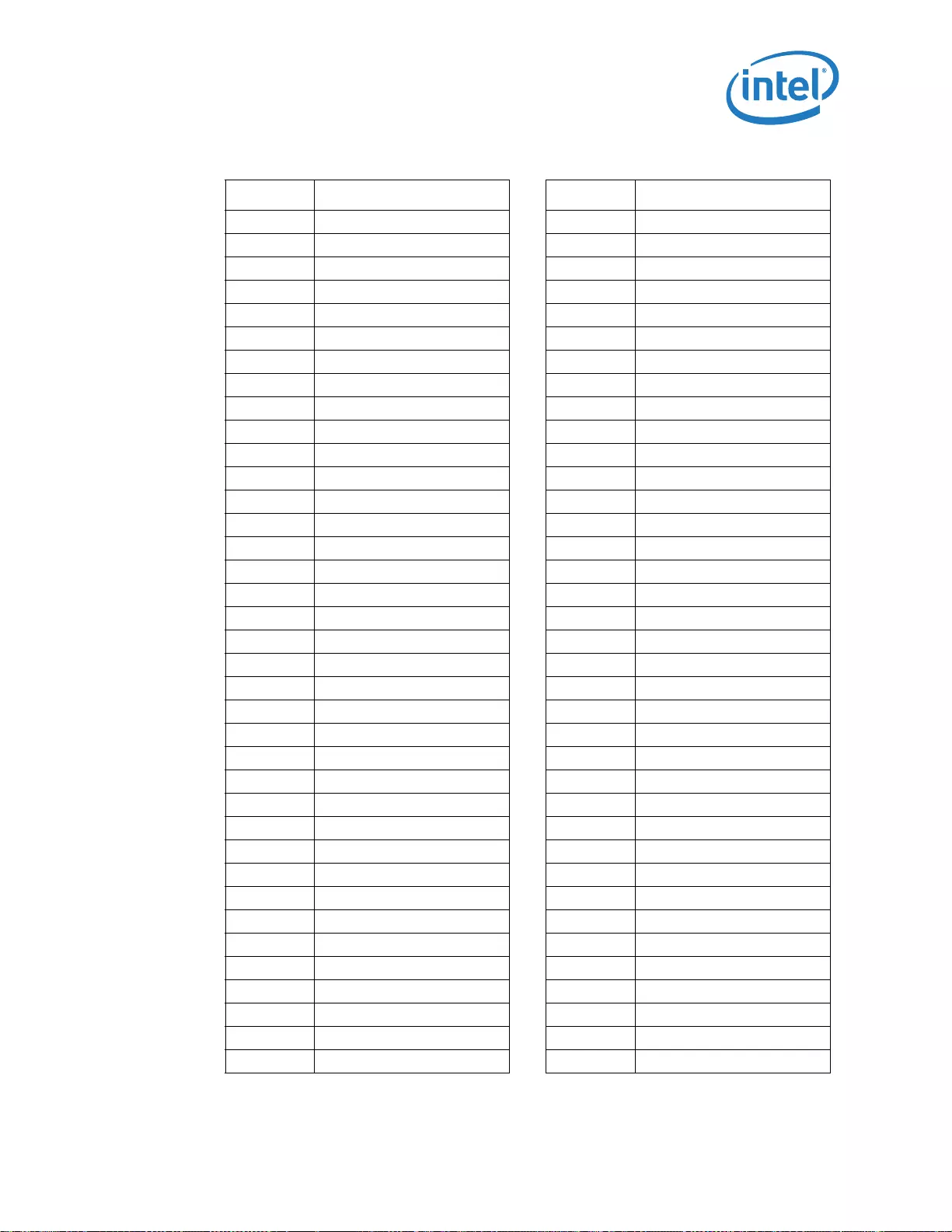
Datasheet 341
SoC Pin Location
AE8 MMC1_CLK
AB8 MMC1_CMD
AB7 MMC1_D[0]
AC7 MMC1_D[1]
AC8 MMC1_D[2]
AB9 MMC1_D[3]
AE9 SD2_CLK
AC9 SD2_CMD
AB11 SD2_D[0]
AB10 SD2_D[1]
AC10 SD2_D[2]
AD10 SD2_D[3]_CD#
Y9 SD3_1P8EN
Y12 SD3_CD#
AC12 SD3_CLK
AB12 SD3_CMD
AC11 SD3_D[0]
AB13 SD3_D[1]
AA12 SD3_D[2]
AA13 SD3_D[3]
AA10 SD3_PWREN#
AE10 SD3_RCOMP
C5 GPIO_S5[10]
D3 GPIO_S5[08]
E6 GPIO_S5[09]
U3 RESERVED
F12 PCU_SPI_CLK
C12 PCU_SPI_CS[0]#
D12 PCU_SPI_CS[1]#
E13 PCU_SPI_MISO
E12 PCU_SPI_MOSI
AE5 GPIO_S0_SC[54]
E4 ILB_RTC_RST#
E10 PMC_SUS_STAT#
D10 PMC_SUSPWRDNACK
C10 SVID_ALERT#
D11 SVID_CLK
Ball # Customer Name
C11 SVID_DATA
E5 TAP_TCK
F4 TAP_TDI
F6 TAP_TDO
P10 RESERVED
P11 RESERVED
H6 TAP_TMS
G6 TAP_TRST#
AB18 SIO_UART1_CTS#
AC18 SIO_UART1_RTS#
AB19 SIO_UART1_RXD
AC19 SIO_UART1_TXD
AE17 SIO_UART2_CTS#
AC17 SIO_UART2_RTS#
AD18 SIO_UART2_RXD
AE18 SIO_UART2_TXD
G3 USB_DN[0]
H3 USB_DN[1]
G4 USB_DP[0]
H4 USB_DP[1]
A2 RESERVED
F13 USB_OC[0]#
F14 USB_OC[1]#
F1 USB_RCOMPO
N3 USB_ULPI_CLK
J5 USB_ULPI_DATA[0]
H5 USB_ULPI_DATA[1]
J4 USB_ULPI_DATA[2]
H1 USB_ULPI_DATA[3]
H2 USB_ULPI_DATA[4]
J3 USB_ULPI_DATA[5]
J1 USB_ULPI_DATA[6]
K2 USB_ULPI_DATA[7]
K3 USB_ULPI_DIR
N4 USB_ULPI_NXT
F10 USB_ULPI_REFCLK
M2 USB_ULPI_STP
Ball # Customer Name
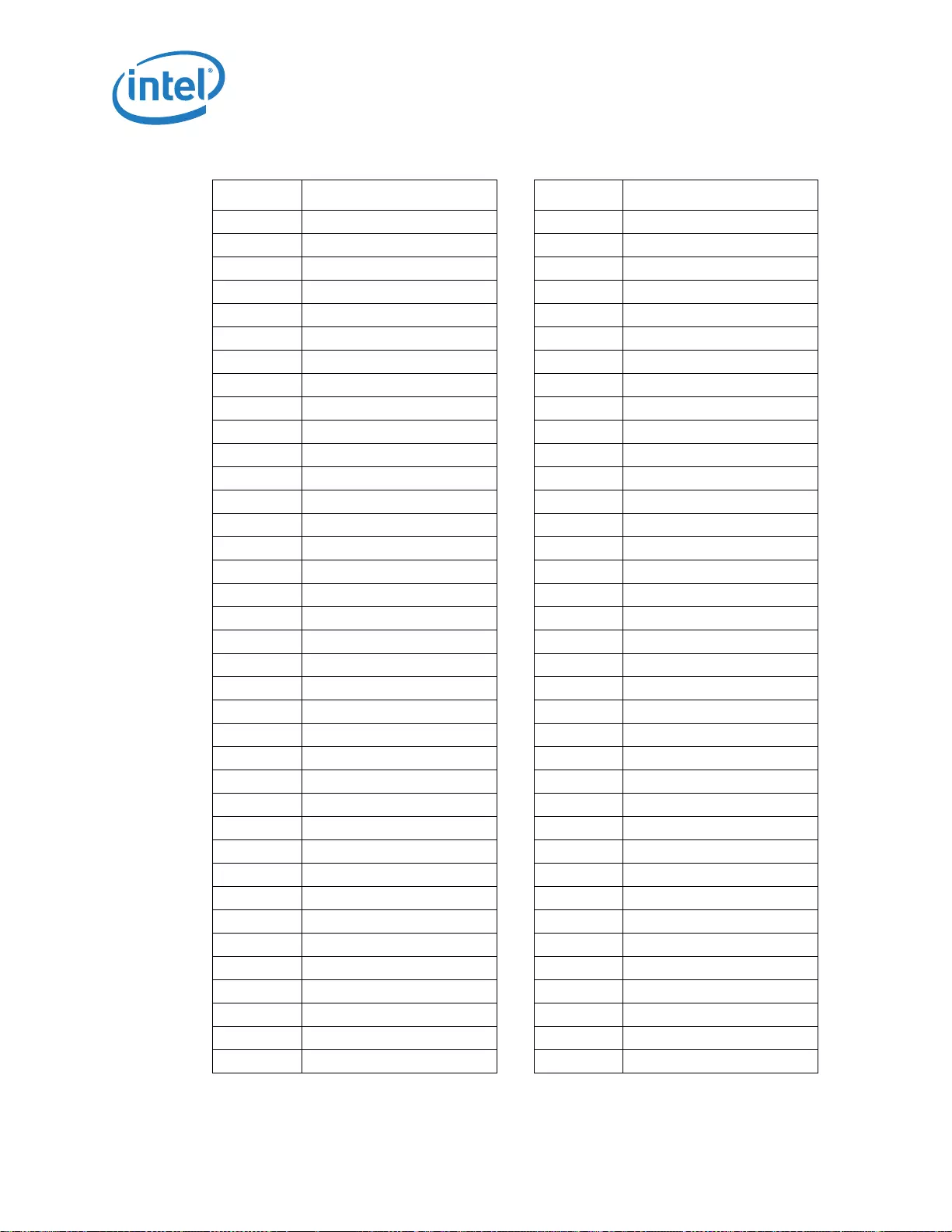
SoC Pin Location
342 Datasheet
A12 CORE_VCC_S0iX
A8 USB_REXT[1]
F15 CORE_VCC_S0iX
G15 CORE_VCC_S0iX
H14 CORE_VCC_S0iX
H15 CORE_VCC_S0iX
H16 CORE_VCC_S0iX
J17 CORE_VCC_S0iX
K13 CORE_VCC_S0iX
K14 CORE_VCC_S0iX
K15 CORE_VCC_S0iX
K16 CORE_VCC_S0iX
L14 CORE_VCC_S0iX
L15 CORE_VCC_S0iX
L16 CORE_VCC_S0iX
M14 CORE_VCC_S0iX
M15 CORE_VCC_S0iX
N14 CORE_VCC_S0iX
N15 CORE_VCC_S0iX
P13 CORE_VCC_S0iX
P14 CORE_VCC_S0iX
P15 CORE_VCC_S0iX
P16 CORE_VCC_S0iX
T19 DRAM_VDD_S4
P19 DRAM_V1P24_S0iX_F1
K18 DRAM_VDD_S4
L18 DRAM_VDD_S4
L19 DRAM_VDD_S4
L20 DRAM_VDD_S4
M19 DRAM_VDD_S4
W19 DRAM_VDD_S4
AE25 PWR_RSVD_OBS
M18 DRAM_V1P0_S4
N18 DRAM_V1P0_S4
AE24 DRAM_V1P0_S4
G19 DRAM_V1P0_S4
H18 DRAM_V1P0_S4
Ball # Customer Name
U18 DRAM_V1P0_S4
A25 PWR_RSVD_OBS
T8 DDI_V1P0_S0iX
U8 DDI_V1P0_S0iX
T7 DDI_V1P0_S0iX
J9 UNCORE_V1P0_G3
K9 UNCORE_V1P0_G3
V15 UNCORE_V1P0_S0iX
V16 UNCORE_V1P0_S0iX
W15 UNCORE_V1P0_S0iX
H8 UNCORE_V1P0_S4
W7 VSS
V7 VSS
V8 VSS
W8 VSS
A16 CORE_V1P05_S4
A17 CORE_V1P05_S4
G17 CORE_V1P05_S4
G18 CORE_V1P05_S4
K17 CORE_V1P05_S4
L17 CORE_V1P05_S4
R17 CORE_V1P05_S4
R18 CORE_V1P05_S4
B25 PWR_RSVD_OBS
R10 UNCORE_V1P0_S0iX
R11 UNCORE_V1P0_S0iX
T10 UNCORE_V1P0_S0iX
H11 UNCORE_V1P0_S0iX
H12 UNCORE_V1P0_S0iX
H7 USB_V1P0_S4
C1 USB_REXT[0]
G8 USB_V1P0_S4
W10 GPIO_V1P0_S4
J7 UNCORE_V1P0_G3
K7 UNCORE_V1P0_G3
K8 UNCORE_V1P0_G3
L7 UNCORE_V1P0_G3
Ball # Customer Name
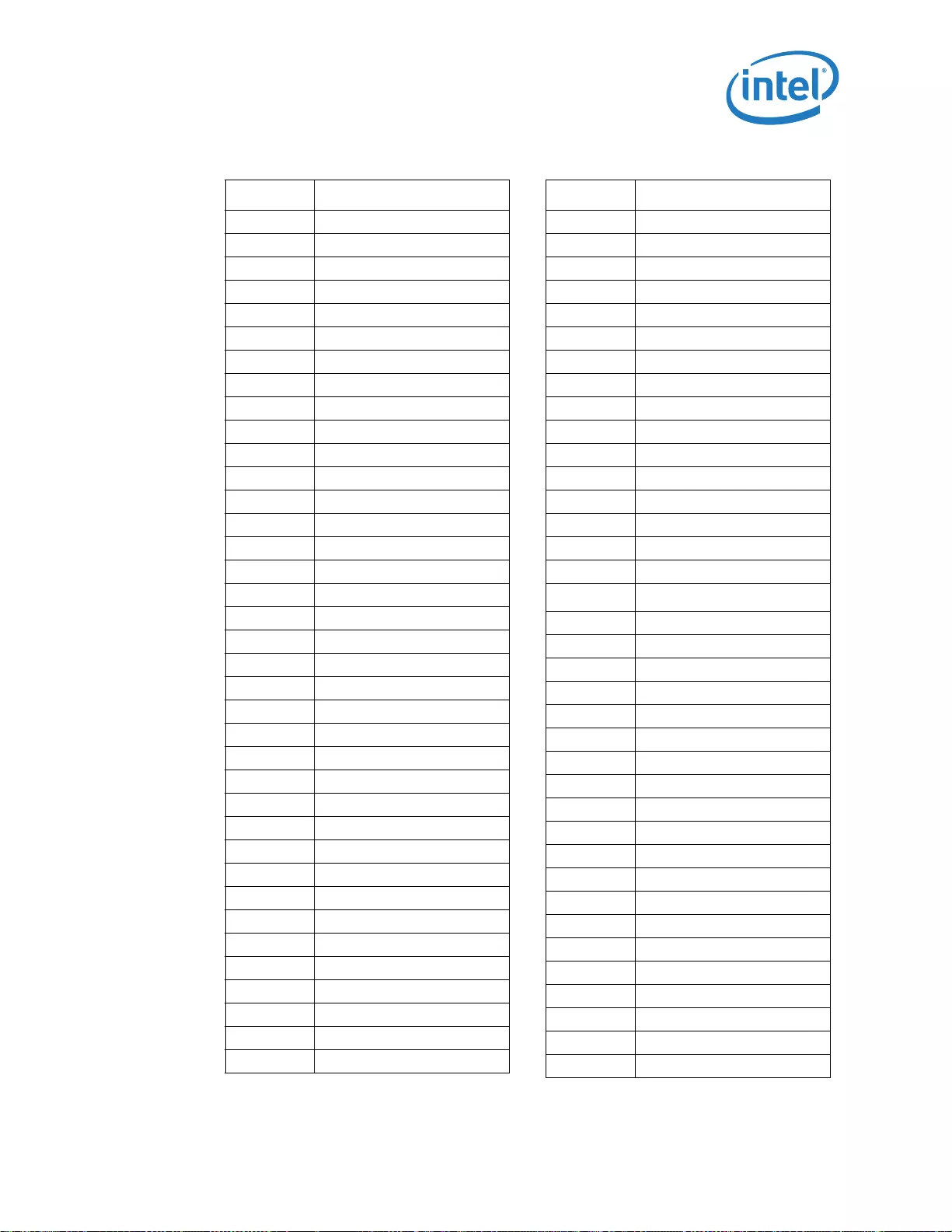
Datasheet 343
SoC Pin Location
M16 CORE_V1P05_S4
J16 CORE_V1P05_S4
W12 UNCORE_V1P8_S4
W13 UNCORE_V1P8_S4
W16 UNCORE_V1P8_S4
Y15 UNCORE_V1P8_S4
G11 UNCORE_V1P8_G3
H9 USB_V3P3_S0iX
J15 MIPI_V1P8_S4
G12 PCU_V3P3_G3
W14 SD3_V1P8V3P3_S4
N7 MIPI_V1P24_S4
P7 MIPI_V1P24_S4
F11 RTC_VCC
H10 PMC_V1P8_G3
J10 PMC_V1P8_G3
K10 PMC_V1P8_G3
N8 ICLK_V1P24_S4_F2
P12 UNCORE_V1P24_S0iX_F5
G13 UNCORE_V1P24_S0iX_F4
H13 UNCORE_V1P24_S0iX_F4
P9 UNCORE_V1P24_S0iX_F1
M7 ICLK_V1P24_S4_F1
AB1 UNCORE_VNN_S4
K12 UNCORE_VNN_S4
L11 UNCORE_VNN_S4
L12 UNCORE_VNN_S4
L13 UNCORE_VNN_S4
L9 UNCORE_VNN_S4
M10 UNCORE_VNN_S4
M11 UNCORE_VNN_S4
M12 UNCORE_VNN_S4
M8 UNCORE_VNN_S4
M9 UNCORE_VNN_S4
N10 UNCORE_VNN_S4
N11 UNCORE_VNN_S4
N12 UNCORE_VNN_S4
Ball # Customer Name
R13 UNCORE_VNN_S4
R8 UNCORE_VNN_S4
T11 UNCORE_VNN_S4
T12 UNCORE_VNN_S4
T13 UNCORE_VNN_S4
T14 UNCORE_VNN_S4
T15 UNCORE_VNN_S4
T16 UNCORE_VNN_S4
T17 UNCORE_VNN_S4
U10 UNCORE_VNN_S4
U11 UNCORE_VNN_S4
U12 UNCORE_VNN_S4
U13 UNCORE_VNN_S4
U14 UNCORE_VNN_S4
U15 UNCORE_VNN_S4
U16 UNCORE_VNN_S4
U17 GPIO_S0_SC[65]
V10 UNCORE_VNN_S4
V11 UNCORE_VNN_S4
V13 UNCORE_VNN_S4
V17 UNCORE_VNN_S4
V18 UNCORE_VNN_S4
W18 UNCORE_VNN_S4
A24 VSS
AA11 VSS
AA15 VSS
AA18 VSS
AA2 VSS
AA21 VSS
AA24 VSS
AA7 VSS
AD13 VSS
AD17 VSS
AD21 VSS
AD25 VSS
AD5 VSS
AD9 VSS
Ball # Customer Name
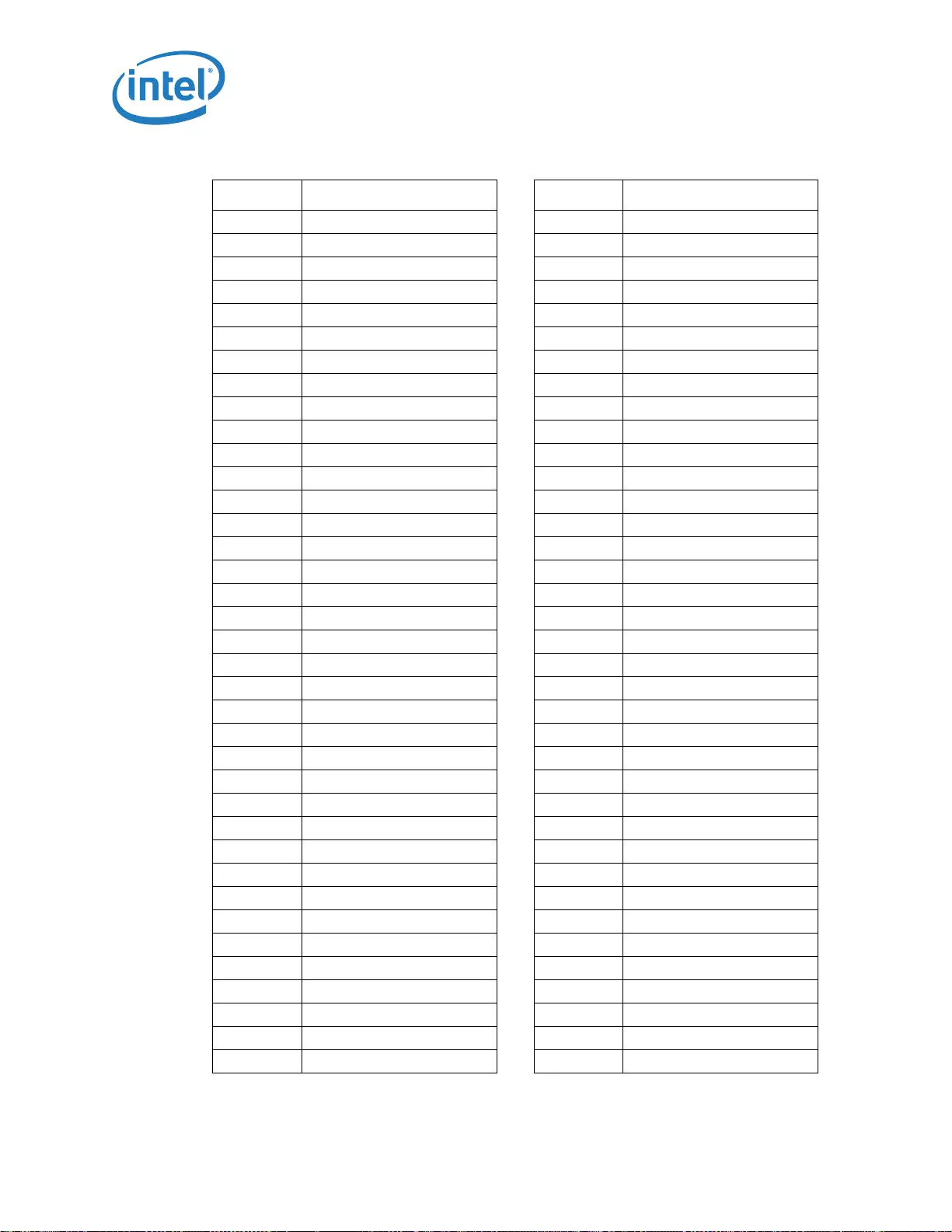
SoC Pin Location
344 Datasheet
AE2 VSS
B1 VSS
B13 VSS
B17 VSS
B21 VSS
B5 VSS
B9 VSS
E11 VSS
E15 VSS
E18 VSS
E2 VSS
E21 VSS
E24 VSS
E7 VSS
G10 VSS
G14 VSS
G16 VSS
G5 VSS
G9 VSS
H17 VSS
H21 VSS
J11 VSS
J12 VSS
J13 VSS
J14 VSS
J18 VSS
J19 VSS
J2 VSS
J24 VSS
J8 VSS
K11 VSS
K19 VSS
L10 VSS
L21 VSS
L5 VSS
L6 VSS
L8 VSS
Ball # Customer Name
M13 VSS
M17 VSS
N13 VSS
N16 VSS
N17 VSS
N2 VSS
N21 VSS
N24 VSS
N9 VSS
P17 VSS
P18 VSS
P8 VSS
R12 VSS
R14 VSS
R15 VSS
R16 VSS
R19 VSS
R20 VSS
R21 VSS
R5 VSS
R6 VSS
R7 VSS
R9 VSS
T18 VSS
T9 VSS
U2 VSS
U24 VSS
U9 VSS
V12 VSS
V14 VSS
V19 VSS
V21 VSS
V6 VSS
V9 VSS
W11 VSS
W17 VSS
W5 VSS
Ball # Customer Name

Datasheet 345
SoC Pin Location
§
W9 VSS
Y11 VSS
G7 USB_VSSA
Ball # Customer Name
